

Tokyo Itinerary: The Best 7-Day Guide for a Fantastic Trip
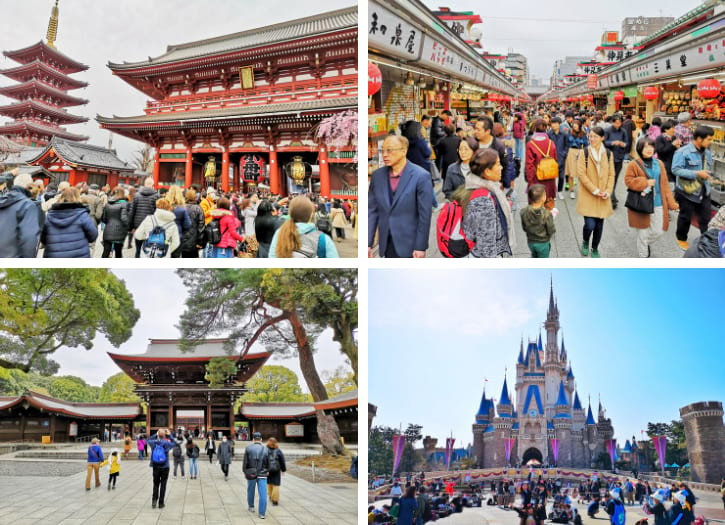
This Tokyo itinerary for 7 days will guide you to a smooth and unforgettable trip in the city .
I’ll show you the best route to visit Tokyo’s most popular attractions , so you can spend more time enjoying the sights and less time traveling.
Trust me, the itinerary I’m showing you for 7 days in Tokyo will save you lots of planning time and make sure your trip to this amazing city is fantastic . 😊
Plus, I’ll point out where to enjoy the city’s delicious and budget-friendly sushi, ramen, yakitori, and tempura. Ready for this adventure? Let’s go!
See the Best of Tokyo with Our Very Clear Travel Itinerary Below
Day 1: warner bros. studio tour tokyo and shinjuku, day 2: meiji shrine, harajuku and shibuya, day 3: tokyo disneyland, day 4: ueno, ameya yokocho, asakusa, and tokyo skytree, day 5: take a day trip to mt fuji from tokyo, day 6: disneysea, day 7: tokyo metropolitan government building and odaiba, tokyo itinerary 7 days map, the most efficient way to travel around tokyo, where to stay in tokyo, japan sim card and pocket wifi, related posts.
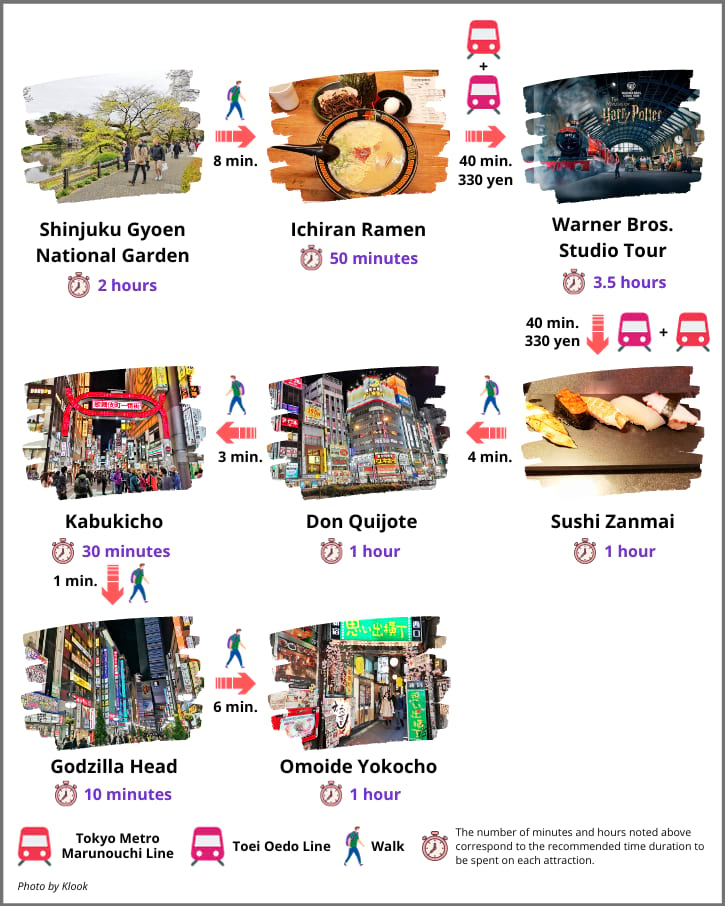
Tokyo itinerary day 1 timetable:
- 10:00 AM: Shinjuku Gyoen National Garden
- 12:00 PM: Ichiran Ramen (Lunch)
- 1:30 PM: Warner Bros. Studio Tour Tokyo
- 5:40 PM: Sushi Zanmai Shinjuku Higashiguchi (Dinner)
- 6:40 PM: Don Quijote
- 7:40 PM: Kabukicho
- 8:10 PM: Godzilla Head
- 8:20 PM: Omoide Yokocho
If you’re interested in learning more about Shinjuku, feel free to read my article on the best things to do in Shinjuku . You can also access all my Tokyo travel guides here .
For those visiting Osaka, don’t miss out on my comprehensive Osaka travel guides , which include a detailed 3-day itinerary to help you make the most of your trip.
1. Shinjuku Gyoen National Garden – 2 hours (10:00 AM to 12:00 PM)
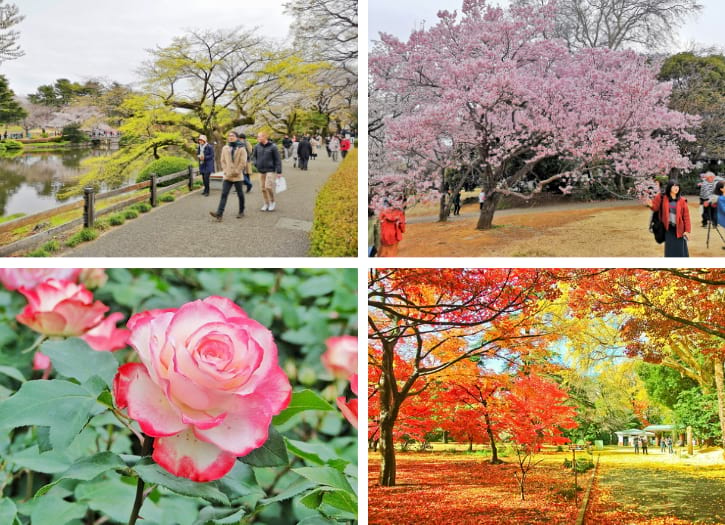
Shinjuku Gyoen National Garden in Tokyo is a must-visit spot . It’s a big, beautiful park perfect for relaxing .
When you go, don’t miss the Japanese and France Formal gardens – each one is different and special.
You’ll be captivated by the stunning scenery that changes with the seasons. In summer, the garden bursts with colorful flowers.
Spring is famous for its breathtaking cherry blossoms , and in autumn , the golden hues of maple trees are a sight to behold .
Even in winter , from December to February , the snow-covered trees create a magical landscape .
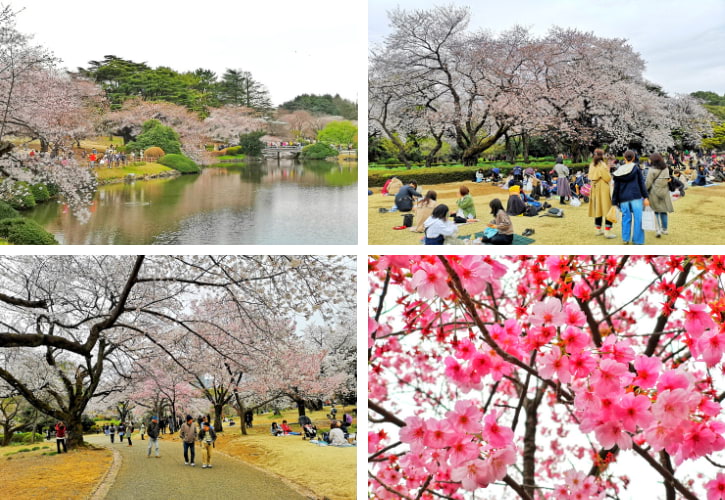
Whether you’re up for a peaceful walk, a picnic, or just some time to sit back and embrace nature, this park is ideal.
And don’t forget your camera – the garden’s beauty is absolutely photo-worthy .
To help you easily navigate the garden, simply download the Shinjuku Gyoen National Garden map here.

2. Ichiran Ramen – 50 minutes (12:00 PM – 12:50 PM)
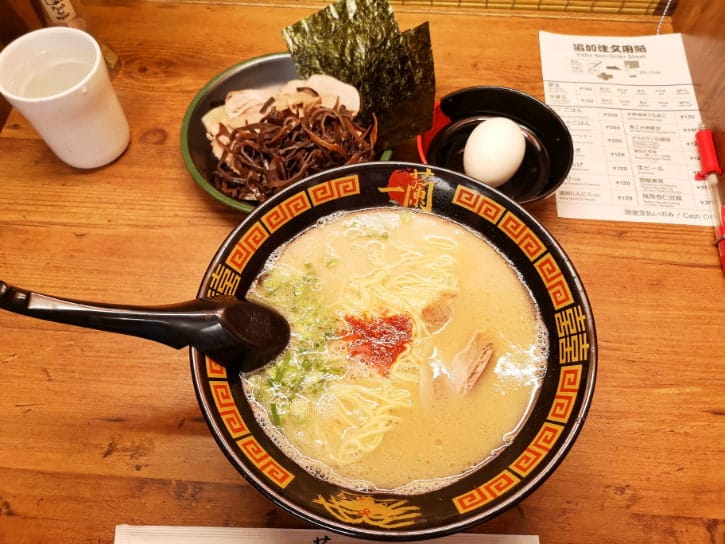
When visiting Tokyo, be sure to add Ichiran Ramen to your itinerary ; you won’t regret it.
This ramen shop is really good at making tonkotsu ramen. It’s a special pork soup you’d want to taste , and it only costs 980 yen .
If you feel like treating yourself, pay a little extra for additional toppings like extra pork slices, egg, dried seaweed, and more. It’s a small price to pay for such a satisfying meal!

3. Warner Bros. Studio Tour Tokyo – 3.5 hours (1:30 PM – 5:00 PM)
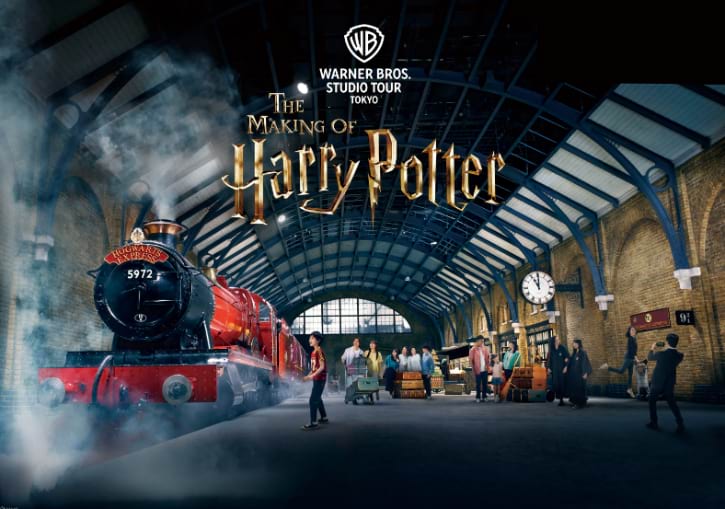
I highly recommend including Warner Bros. Studio Tour Tokyo when doing your own itinerary because it’s an incredible experience , especially for movie enthusiasts.
You get to see how movies are made, from special effects to set designs . There are also props and costumes from famous movies.
For Harry Potter fans, the behind-the-scenes insights are a real treat. Plus, the photo opportunities are fantastic – you’ll have memories to cherish .
Trust me, it’s a unique experience that adds something special to your Tokyo trip!
Important Tip: Purchase your Warner Bros. Studio tickets online here before arriving, as there’s no on-site counter for ticket purchases, and tickets sell out very fast.

4. Sushi Zanmai Shinjuku Higashiguchi – 1 hour (5:40 PM – 6:40 PM)
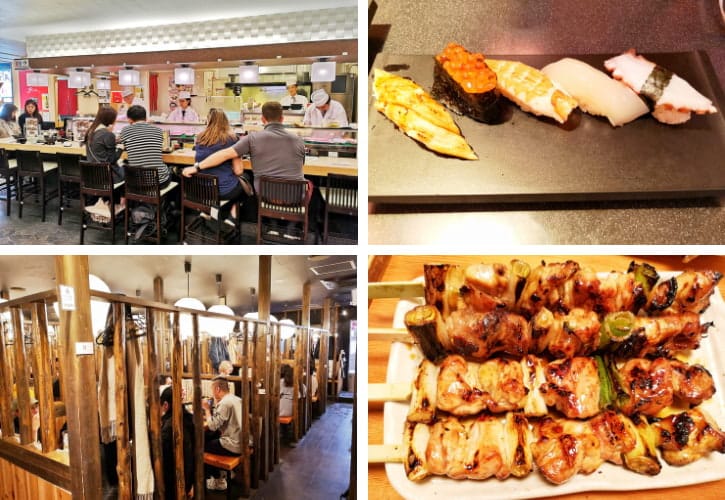
On your first night in Tokyo , you have 3 delightful dinner options to choose from . Pick the one that best suits your taste from the list below.
- Sushi Zanmai Shinjuku Higashiguchi: This popular sushi spot offers a wide range of sushi and traditional desserts. Expect to spend about 2,000 yen per person.
- Torikizoku: A great place for affordable yakitori (chicken skewers) and other dishes like meatballs, with each order costing 360 yen for 2 skewers.
- Hakata Tenjin Ramen: For more ramen, head here. Prices range from 600 to 1,100 yen. Their top dish, with roasted pork fillet, seaweed, and spring onion ramen, is 1,100 yen.

5. Don Quijote – 1 hour (6:40 PM to 7:40 PM)
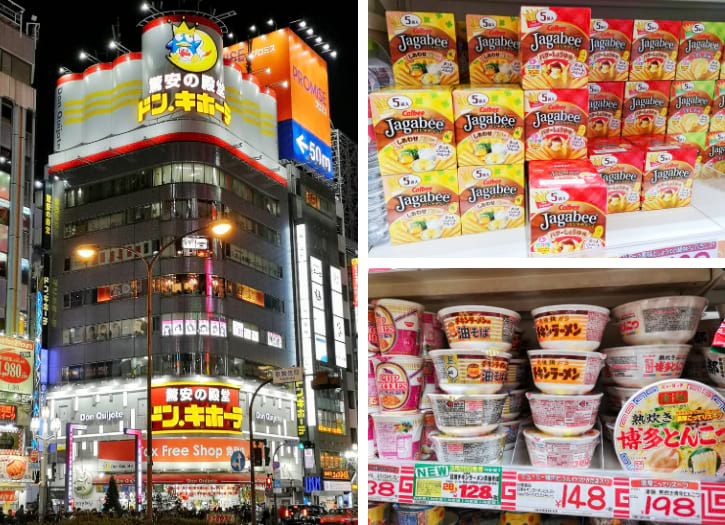
After dinner, visit Don Quijote , a 24-hour discount store . It’s the top spot in Tokyo for snacks, drinks, instant noodles, and souvenirs .
Plus, it’s tax-free , so you can save money on Japanese treats . Make sure to add it to your list.

6. Kabukicho – 30 minutes (7:40 PM to 8:10 PM)
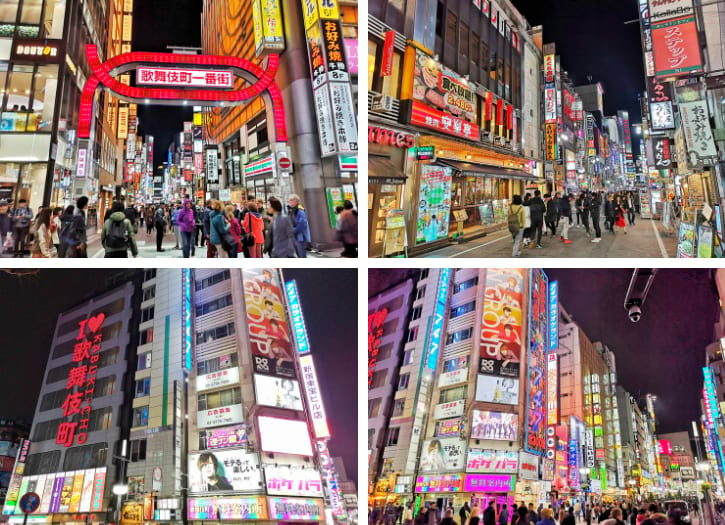
Once you’re done with shopping, Kabukicho is a great spot to have on your evening itinerary .
This renowned red-light district offers a night full of vibrant entertainment . However, it’s best to simply stroll around and soak in the sparkling ambiance .
Be cautious of accepting offers from locals to visit bars and nightclubs, as they can come with high costs and potential hidden fees.

7. Godzilla Head – 10 minutes (8:10 PM to 8:20 PM)
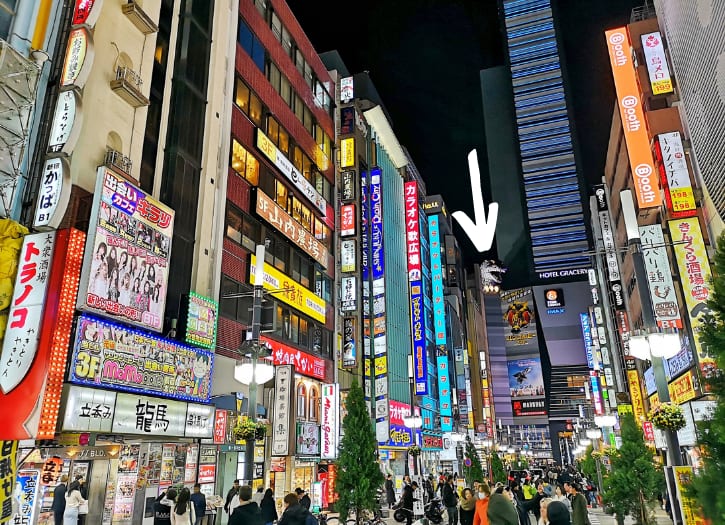
While exploring Tokyo, make sure not to miss the iconic Godzilla Head situated in Kabukicho .
Here, you can snap a selfie of the iconic character and listen to his intense roar. At times, this giant also emits smoke and laser lights.

8. Omoide Yokocho – 1 hour (8:20 PM to 9:20 PM)
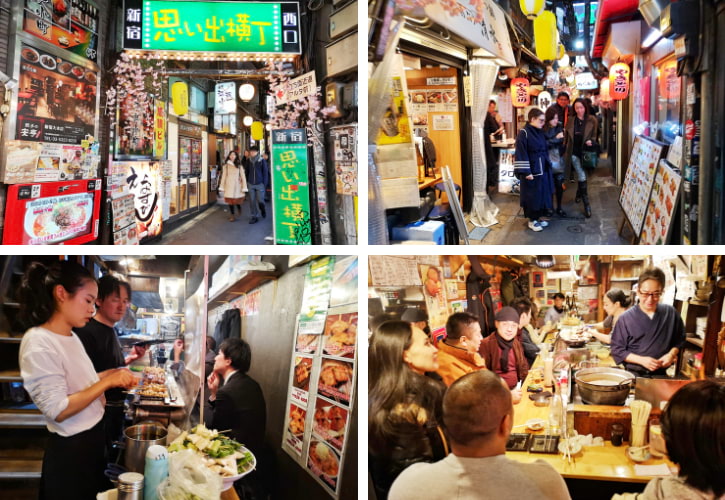
Walking down Omoide Yokocho is a must for a fun night. This alley has a cool, old-school feel and is famous for its yummy yakitori chicken .
And when you’re there, you should definitely try the grilled chicken at one of the small eateries. It’s delicious!
Plus, there are lots of tiny bars around with different kinds of drinks .
Don’t worry if you don’t speak Japanese – most stalls have menus in English . It’s a great way to experience local Tokyo life!

The Tokyo itinerary planned for day 2 covers the areas listed below:
- 9:00 AM: Meiji Shrine
- 11:00 AM: Harajuku’s Takeshita Street
- 1:00 PM: Shibuya
1. Meiji Shrine – 2 hours (9:00 AM to 11:00 AM)
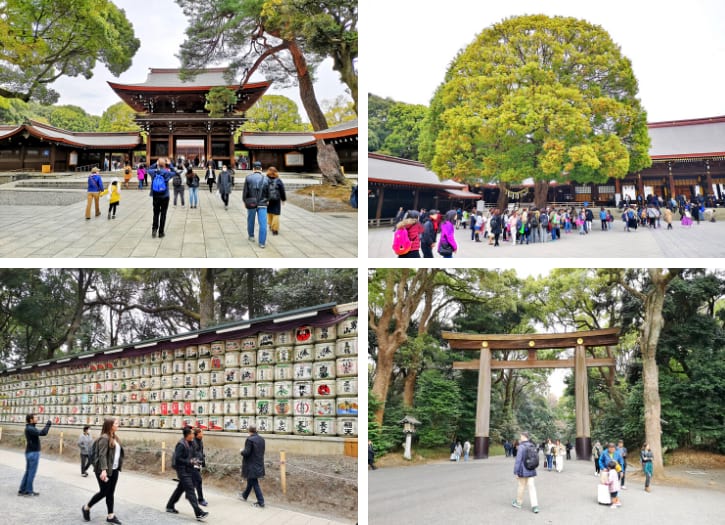
Kick off your Tokyo morning adventure at Meiji Shrine which is located right in the middle of a pretty forest .
As you visit, you’ll pass through grand torii gates and tree-lined paths, all surrounded by the beauty of nature .
Once at the shrine, explore its traditional architecture and witness Shinto rituals. If you’re lucky, you might even see a traditional wedding there.
This serene spot in the bustling city is perfect for relaxation and learning about Japanese culture .

2. Harajuku’s Takeshita Street – 2 hours (11:00 AM to 1:00 PM)

A quick overview of the itinerary for visiting Takeshita Street, one of Tokyo’s most popular and busiest streets:
- 11:00 AM: Stroll Around the Street
- 11:15 AM: Paris Kid’s
- 11:45 AM: Daiso
- 12:15 PM: Totti Candy Factory
- 12:25 PM: Marion Crepes
- 12:35 PM: McDonald’s/ Yoshinoya (Lunch)

a) Stroll Around the Street – 15 minutes (11:00 AM to 11:15 AM)

Put Takeshita Street on the list for your Tokyo sightseeing trip. It’s a great place for shopping and trying new foods .
This lively street is packed with cool shops selling trendy clothes, unique accessories, and fun souvenirs .
Don’t forget to try the street food here – the crepes and cotton candy are amazing !
There are also lots of cafes where you can relax and watch the bustling street.
b) Paris Kid’s – 30 minutes (11:15 AM to 11:45 AM)
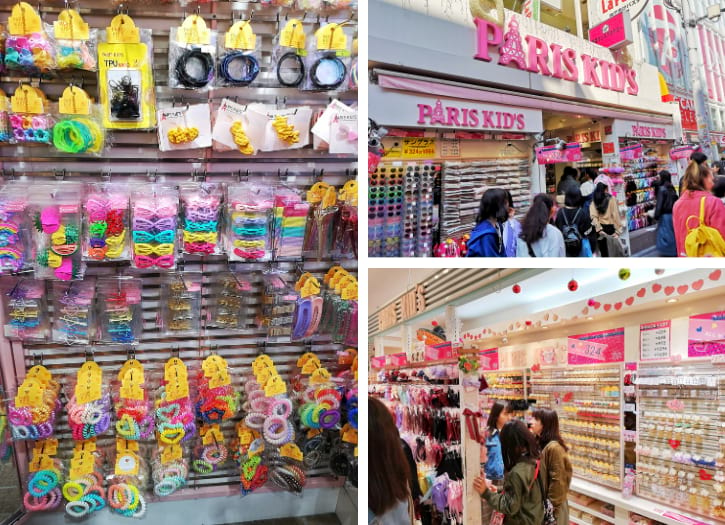
If you’re looking for stylish yet inexpensive accessories , head to Paris Kid’s . This store has all kinds of cute stuff for your kids, from hair clips to bow ties to flower crowns .
On top of that, they have sunglasses, key chains, jewelry, and character goods . So, shop all you want and bring home your wished list.
c) Daiso – 30 minutes (11:45 AM to 12:15 PM)
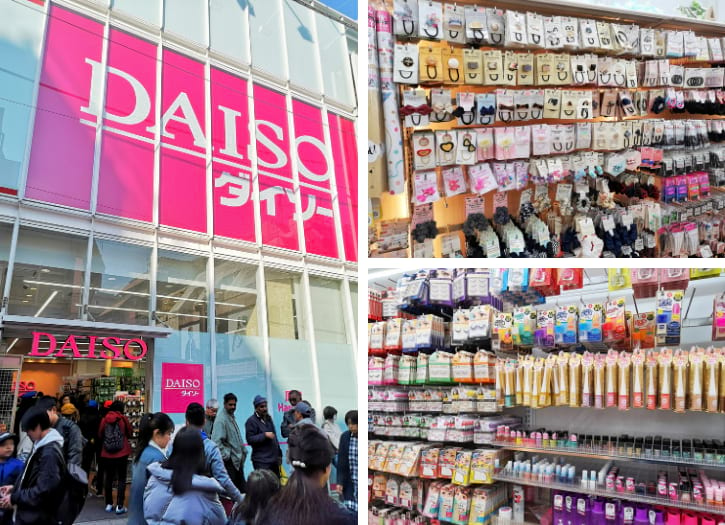
Don’t miss the chance to visit Daiso . This popular 100-yen store is a crowd favourite, known for its budget-friendly shopping .
It’s packed with a wide range of items, from quirky Japanese stationery and adorable kitchen gadgets to cute home decorations .
Whether you’re on the hunt for unique souvenirs or just eager to immerse yourself in the local shopping scene, Daiso is an essential stop on your Tokyo adventure.
d) Totti Candy Factory – 10 minutes (12:15 PM to 12:25 PM)
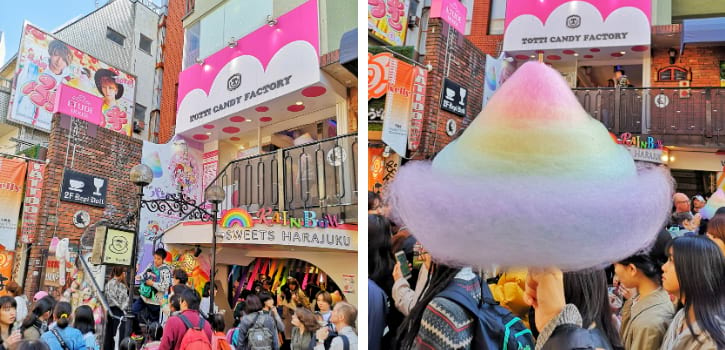
When exploring Takeshita Street in Tokyo, make sure the Totti Candy Factory is in your travel list . This candy wonderland is seriously a dream destination for the sweet tooth .
Inside this adorable store are different arrays of sugary treats. They have lollipops, cake pops, marshmallows, sour candies, and gummies.
And of course, don’t dare miss their best-seller, the giant rainbow cotton candy !
e) Marion Crepes – 10 minutes (12:25 PM to 12:35 PM)
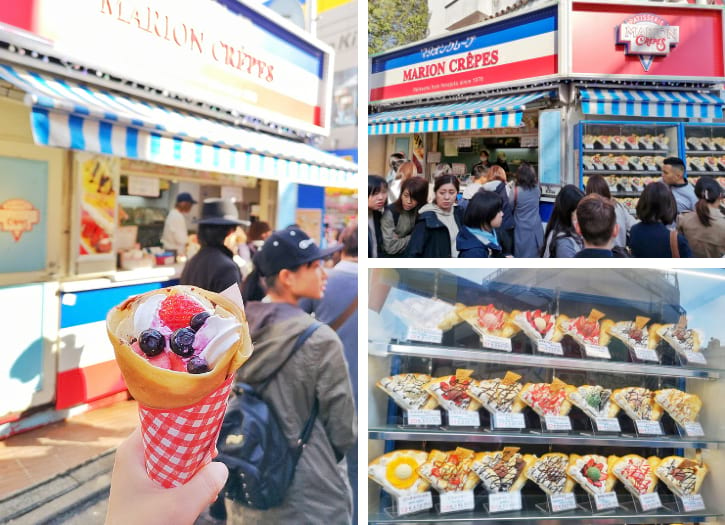
While in this street, you’ll also come across another top-rated food spot , the Marion Crepes .
Their crepes are tasty, and you can enjoy them while walking around.
There’s a variety to choose from, like strawberry ice cream with whipped cream and fruit , or even unique ones like tuna, cheese, and curry fillings .
f) McDonald’s or Yoshinoya – 25 minutes (12:35 PM to 1:00 PM)
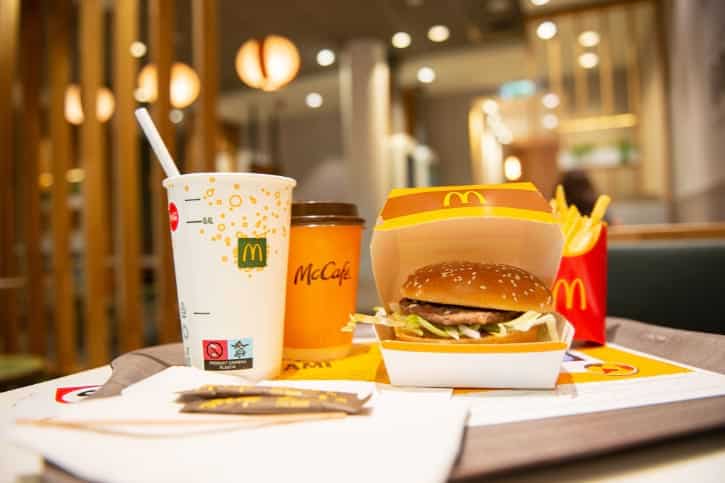
If you’re hungry, you can have your lunch at one of the restaurants listed below, all of which are located on Takeshita Street.
- McDonald’s: If you’re craving chickens or burgers, head to this famous fast-food chain. This is a great option for those who want to save money. The chicken burger costs 200 yen, while the beef burger is priced at 220 yen.
- Yoshinoya: For tasty Japanese foods at an affordable price, you can take your lunch here. They have bento meals, beef bowls, and other Japanese treats to choose from. All priced at around 700 yen each.

4. Shibuya – 8 hours (1:00 PM to 9:00 PM)

The attractions that will be visited in Shibuya during the afternoon are:
- 1:00 PM: Hachiko Statue
- 1:15 PM: Shibuya Crossing
- 1:30 PM: Disney Store
- 2:00 PM: Nintendo Tokyo
- 3:00 PM: Shibuya Center-gai
- 4:00 PM: Mega Don Quijote
- 5:00 PM: Shibuya 109
- 6:30 PM: Uobei Shibuya Dogenzaka (Dinner)
- 7:00 PM: Shibuya Sky at Shibuya Scramble Square

a) Hachiko Statue – 15 minutes (1:00 PM to 1:15 PM)
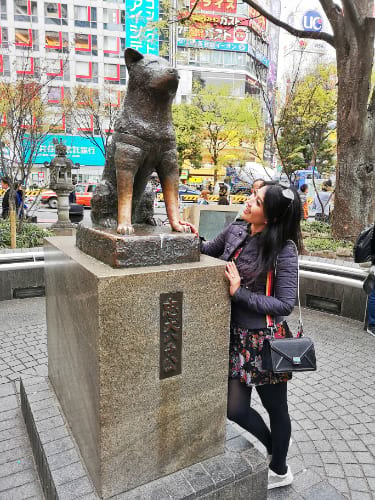
Start your Shibuya exploration at the Hachiko Statue. It’s right outside Shibuya Station and is a famous meeting spot .
Hachiko was a loyal dog, and his statue is a symbol of loyalty and friendship. It’s a great place to take photos.
b) Shibuya Crossing – 15 minutes (1:15 PM to 1:30 PM)
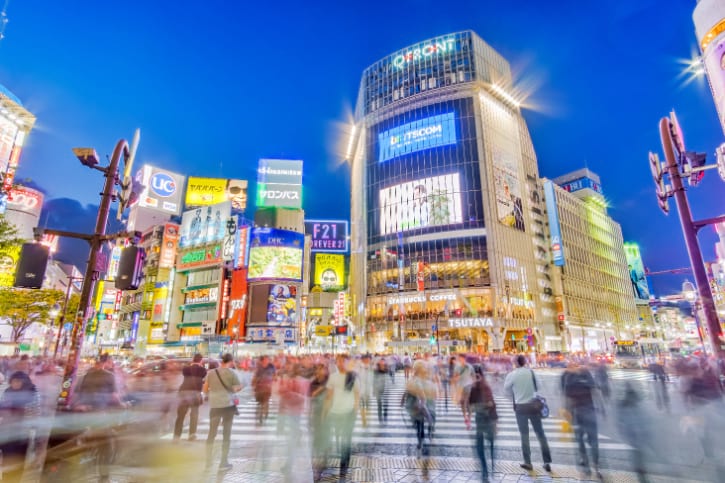
Shibuya Crossing is an amazing sight you shouldn’t miss. It’s known as one of the busiest pedestrian crossings in the world .
When you’re there, take a moment to just watch the wave of people crossing from all directions – it’s really something special .
Make sure to cross it yourself too; it’s an experience! There are lots of shops and restaurants around, so after crossing, you can explore or grab a bite to eat.
c) Disney Store – 30 minutes (1:30 PM to 2:00 PM)
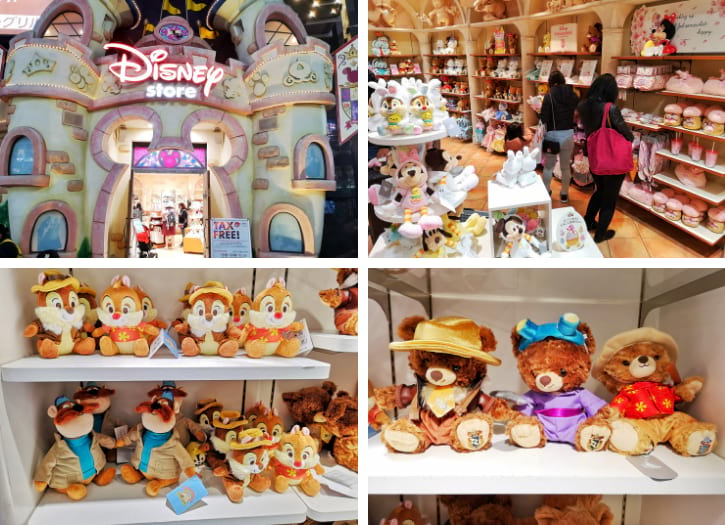
Other than Tokyo Disneyland and DisneySea, Disney Store is another great site to buy Disney items .
Check out the extensive assortment of cute plush toys of your favourite Disney characters.
This famous Disney retail store also offers different collectibles and character clothes .
Besides the great goodies, the shop’s design is notable. Take some snaps of the castle-like features while shopping around.
d) Nintendo Tokyo – 1 hour (2:00 PM to 3:00 PM)

Nintendo TOKYO is on the 6th floor of Shibuya PARCO and it’s a haven for gamers.
Here, you’ll find exclusive items like one-of-a-kind Mario plushies and special Link figures that are hard to come by elsewhere.
Don’t forget to get a photo with the big Mario statues , too. It’s a cool spot to capture memories.
For anyone who loves Nintendo, this is your spot in Shibuya. Don’t miss out on the fun!
e) Shibuya Center-gai – 1 hour (3:00 PM to 4:00 PM)
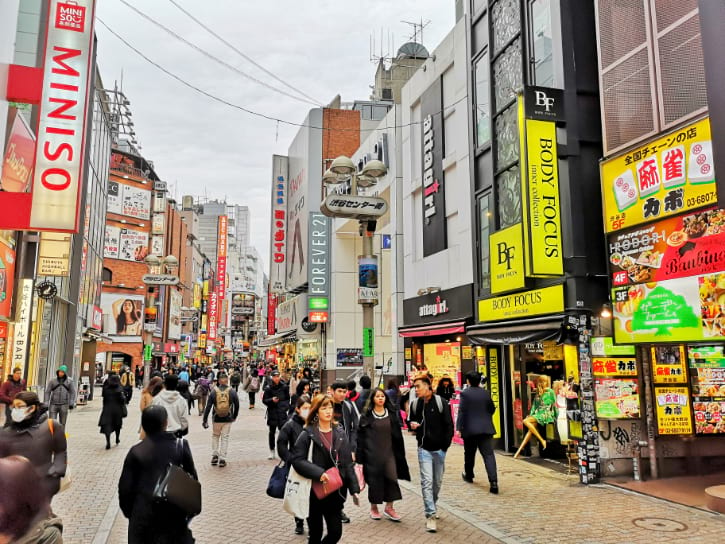
Go hunting for some fashion items at Shibuya Center-gai. This area is known for its many famous fashion brands like H&M, GU Shibuya, UNIQLO, ZARA, and even Prada .
On top of that, you’ll also find popular chain stores like Mega Don Quijote and Miniso.
Take a walk along this bustling street, and you’ll discover more treasures like upscale boutiques, local restaurants, and cozy bars.
It’s a must-visit for shopping and experiencing Tokyo’s vibrant street culture. Enjoy your time exploring!
f) Mega Don Quijote – 1 hour (4:00 PM to 5:00 PM)
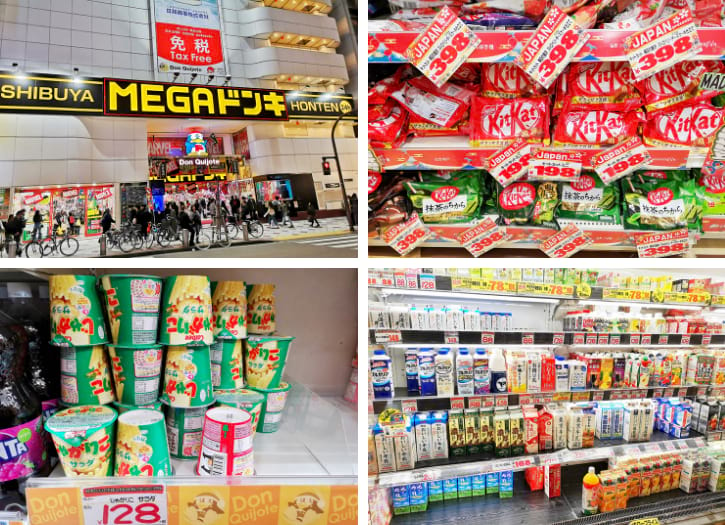
Proceed to Mega Don Quijote for another round of shopping.
This renowned chain store offers various Japanese snacks like Calbee, Sennarido Wasabi Pistachios, Kororo, and Umaibo.
For the chocolates, see their selection of Kit Kat, Macadamia Chocolates, Meiji Almond Chocolate, and Pocky.
You’ll also find a lot of Japanese instant noodles , including Nissin Mouko Tanmen, Maruchan Seimen Tonkotsu, Ippudo, and Maruchan Menzukuri Miso.
g) Shibuya 109 – 1.5 hours (5:00 PM to 6:30 PM)
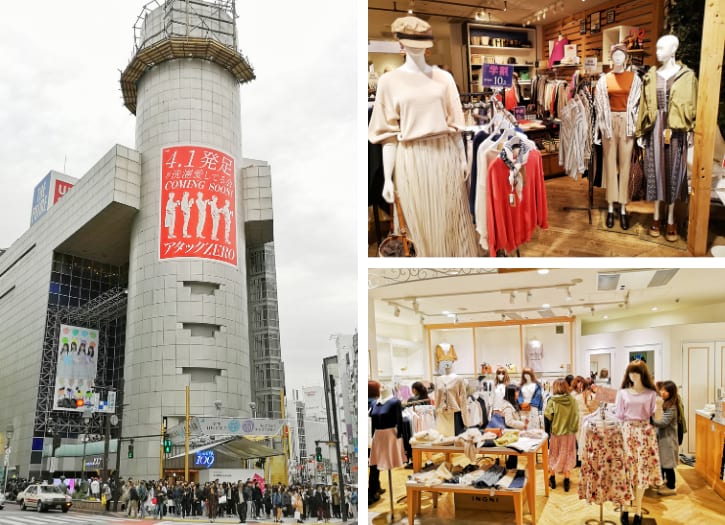
The next stop is Shibuya 109 , which is also a prominent store for the latest fashion trends .
This is a great site for trendsetters and fashionistas looking for reasonably priced items .
Look into the stylish collection of dresses, shirts, pants, skirts, and all kinds of apparel .
They also have a range of shoes, bags, and accessories for your fashion needs.
h) Uobei Shibuya Dogenzaka – 30 minutes (6:30 PM to 7:00 PM)
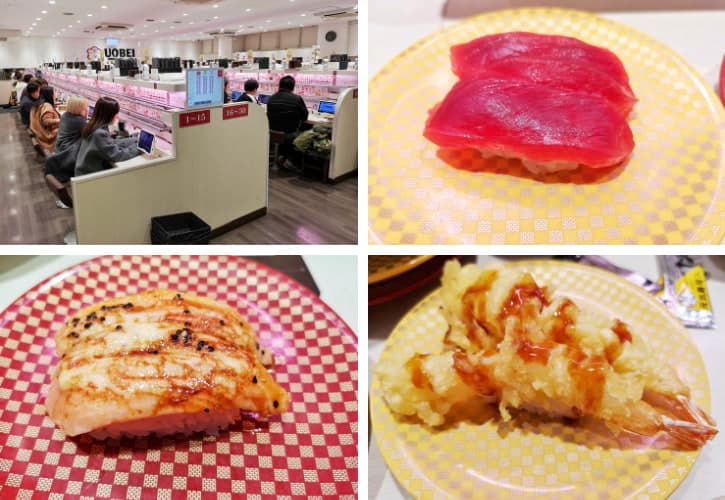
Uobei Shibuya Dogenzaka is one of the famous conveyor belt sushi restaurants in Tokyo .
Here, you get the freshest sushi variations at an affordable price .
Since this is a rotating sushi diner, it’s much easier to order your favourites using the built-in tablet. Most of the sushi here costs between 110 yen and 130 yen per plate .
i) Shibuya Sky at Shibuya Scramble Square – 2 hours (7:00 PM to 9:00 PM)
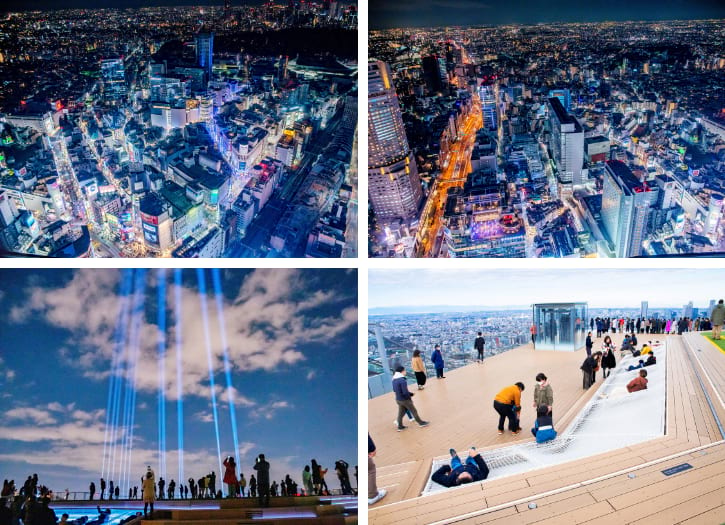
At night, head to the popular attraction in Tokyo, Shibuya Sky . From here, you’ll enjoy a panoramic view of the cityscape .
And if you go here during night-time, then you’ll be surrounded by glittering buildings and city lights.
The view here is truly breathtaking, and this place is a must-visit.
Take Note: Tickets for Shibuya Sky are very popular. It is recommended that you buy the entry tickets here in advance to avoid being sold out on the day of your visit.
SHIBUYA SKY consists of 3 zones:
- SKY GATE: It’s located on the 14th floor, where you can purchase entry tickets. From here, take the elevator up to the 45th floor. And then, ride the escalator to reach the Sky Stage and Sky Gallery on the 46th floor.
- SKY STAGE: This outdoor observation deck offers breathtaking views of the city. Here, you can capture the spectacular skyline dotted with gigantic buildings. This is also a nice location to see some Tokyo landmarks like the Tokyo Tower, Roppongi, Mount Fuji, and Tokyo Bay.
- SKY GALLERY: Another great spot to catch the panoramic Tokyo cityscape is this indoor observation deck. Additionally, this area comes with unique features like a viewing gallery, a cafe, and a bar lounge.

All travelers should ensure their itinerary has Tokyo Disneyland on it. This magical place is truly a dream destination for both kids and adults .
Just imagine walking into a world filled with Disney magic. You’ll find everything from classic attractions like “It’s a Small World” to exciting rides like “Splash Mountain”.
But there’s more than just rides. You can watch amazing parades with dazzling floats and characters dancing in the streets .
And, of course, you’ve got to snap a photo with Mickey and Minnie .
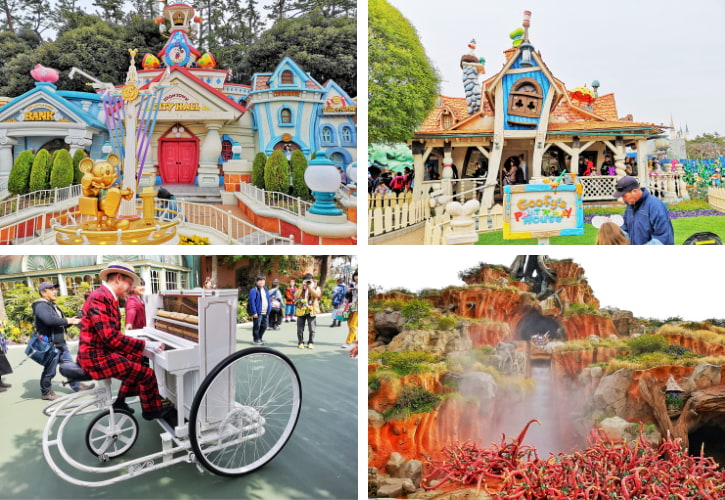
I took a lot of beautiful photos of the rides and shows during my trip. All these are included in my other article, so try to read my guide to the best Tokyo Disneyland rides for more details.
Tokyo Disneyland doesn’t sell tickets at the park. You need to buy them online . Don’t wait too long to get your tickets. It’s a really popular place, and tickets can go fast .
Plan ahead and click here to book your Disneyland tickets early , so you don’t miss out.

You can refer to my article on how to get to Tokyo Disneyland if you’d like more details about reaching the park.
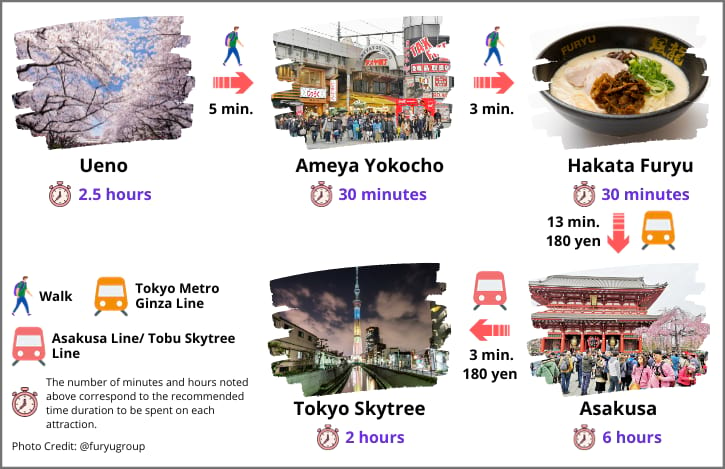
The places to go in Tokyo on the fourth day of the itinerary:
- 9:00 AM: Ueno
- 11:30 AM: Ameya Yokocho
- 12:00 PM: Hakata Furyu (Lunch)
- 12:30 PM: Asakusa
- 6:30 PM: Tokyo Skytree
1. Ueno – 2.5 hours (9:00 AM to 11:30 AM)
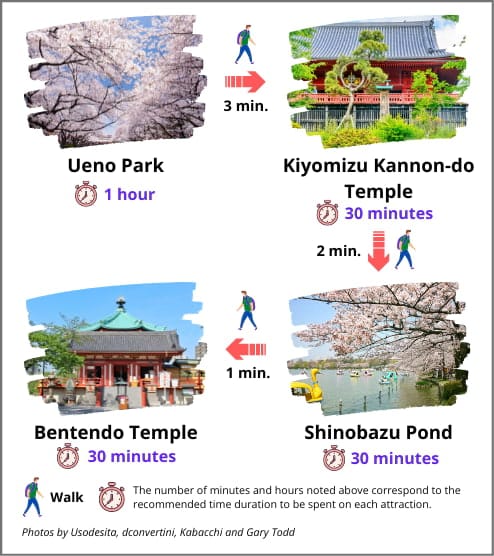
Make your morning memorable by exploring Ueno . Surrounded by beautiful natural views, this garden allows you to fully immerse yourself in nature. Here are the main highlights of what to explore in this area.
- 9:00 AM: Ueno Park
- 10:00 AM: Kiyomizu Kannon-do Temple
- 10:30 AM: Shinobazu Pond
- 11:00 AM: Bentendo Temple

a) Ueno Park – 1 hour (9:00 AM to 10:00 AM)
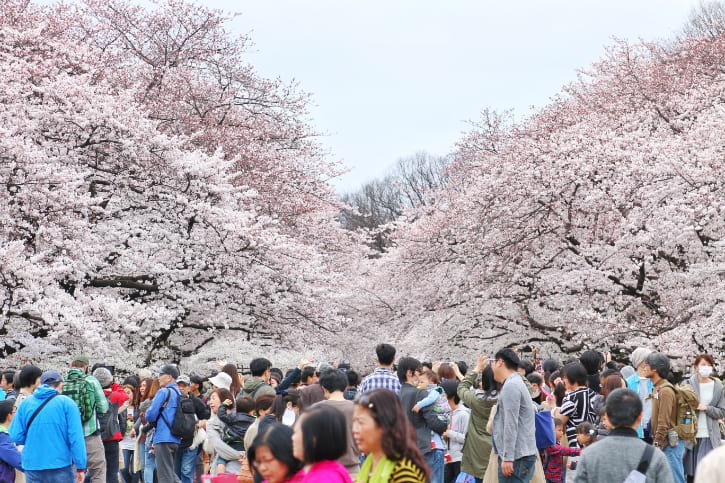
Get started with your day by checking out Ueno Park . This large and beautiful public park in Ueno neighbourhood , Tokyo is such a beautiful place to stroll around .
You will be encircled by stunning views to help you relax and enjoy your trip . While navigating the park, take some pictures and appreciate the natural scenery .
And if you visit during springtime , you’ll be welcomed by the spectacular cherry blossom all over the pathways .
b) Kiyomizu Kannon-do Temple – 30 minutes (10:00 AM to 10:30 AM)
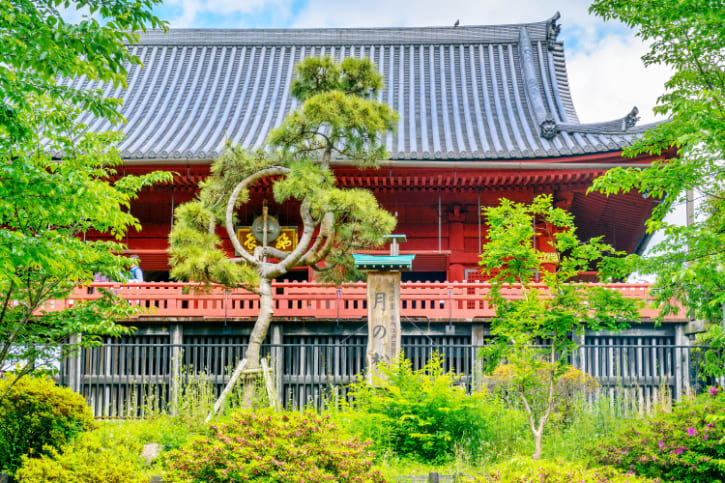
After wandering around, head to the Kiyomizu Kannon-do Temple and pay your respects to the thousand-armed goddess of mercy.
This shrine is frequented by women who wish to conceive and pray for their children’s protection and good health.
The temple itself is a work of art. Look closely into the architecture, which follows the unique Koyomizudera temple design in Kyoto.
c) Shinobazu Pond – 30 minutes (10:30 AM to 11:00 AM)
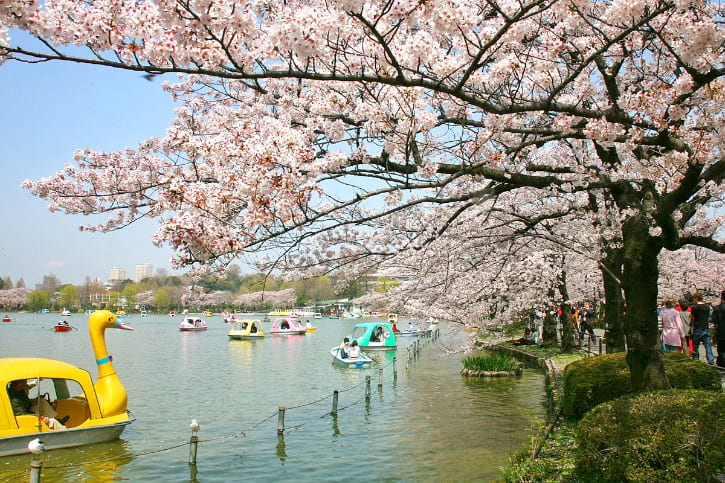
Another favourite spot is the Shinobazu Pond . This spacious area is actually divided into three sections .
The first one is the lotus pond , which is filled with beautiful lotus flowers .
The second one is the duck pond , which shelters ducks and other freshwater birds .
The last area is none other than the boat pond . Rent a boat, paddle around, and enjoy the water surrounded by greenery .
d) Bentendo Temple – 30 minutes (11:00 AM to 11:30 AM)
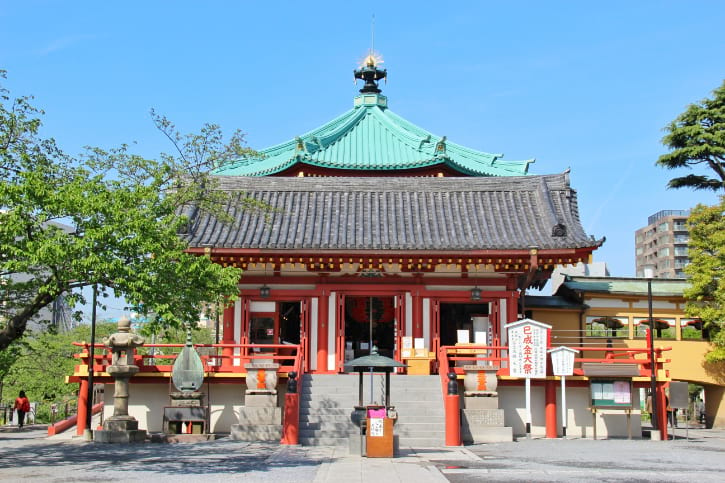
Spot the Bentendo Temple, a hexagonal structure sitting in the heart of Shinobazu Pond.
This religious tower is dedicated to the goddess, Benzaiten , for the peace and prosperity of the locals . It is also known that praying here grants you good fortune .
So during your visit, pay homage to the goddess and call upon your personal intentions, whether it’s for academics, finances, or health.
2. Ameya Yokocho – 30 minutes (11:30 AM to 12:00 PM)
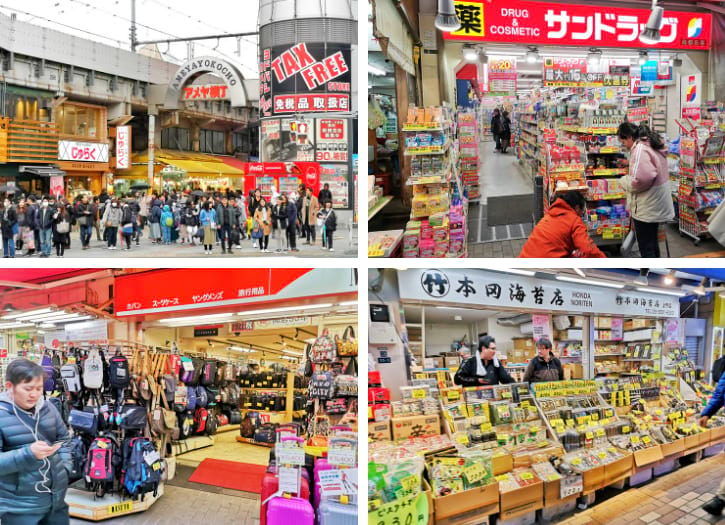
After your Ueno exploration, it’s time to set off to Ameya Yokocho , which actually means candy store alley .
Stroll along the passageway and you’ll find plenty of local stores selling all kinds of products, from clothes to bags and cosmetics .
And of course, you can’t miss the dried food, fresh produce, and spices .
While roaming around, you will also come across a lot of fruit vendors . Grab some of these fresh treats on a stick and enjoy.

3. Hakata Furyu – 30 minutes (12:00 PM to 12:30 PM)
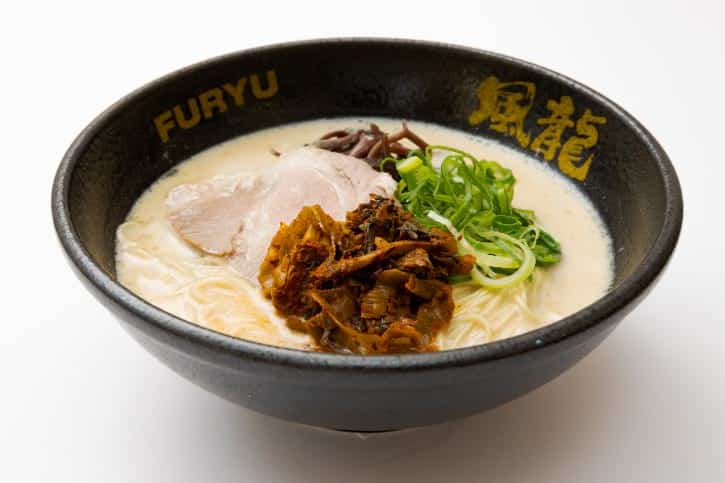
You have 3 lunch options here. Personally, I would recommend Hakata Furyu .
- Hakata Furyu: Try a Tonkotsu ramen that comes in different noodle textures. This shop allows you to choose the hardness of the noodle―soft, medium, hard, and very hard options. The price is 1,020 yen.
- Menya Musashi Bukotsu Soden: This shop serves Tsukemen, a unique ramen wherein the noodles are consumed after dipping it in the soup. They also provide three taste options―white, black, and red.
- Matsuya: Savour a bowl of beef rice in this famous restaurant. Aside from serving tasty food, this is a great spot if you want to save money.

4. Asakusa – 6 hours (12:30 PM to 6:30 PM)

Itinerary details for afternoon in Asakusa :
- 12:30 PM: Dress Kimono
- 1:30 PM: Nakamise Shopping Street
- 2:30 PM: Sensoji Temple (The Most Beautiful Temple in Tokyo)
- 3:00 PM: Suzukien Asakusa
- 3:30 PM: Asakusa Denboin-Dori
- 4:00 PM: Shin-Nakamise Shopping Street
- 5:00 PM: Return Kimono
- 5:30 PM: Asakusa Culture Tourist Information Center
- 6:00 PM: Tendon Tenya/ Unatoto (Dinner)

a) Dress Kimono – 1 hour (12:30 PM to 1:30 PM)

Experience how it feels like to be a local by wearing a kimono. This traditional attire exudes the uniqueness and sophistication of Japanese culture.
And if you want to try one, you can check out this famous shop that offers excellent kimono rental service .
On top of that, they also provide hairstyling for women . Just make sure to make a reservation in advance online because they are often fully booked.
b) Nakamise Shopping Street – 1 hour (1:30 PM to 2:30 PM)
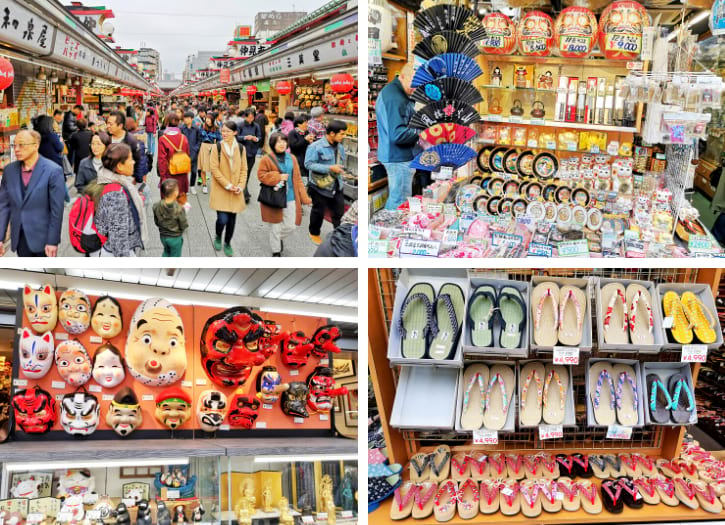
When you visit Nakamise Shopping Street , you’re in for a real treat. This bustling street leads to Senso-ji Temple and is full of life.
It’s lined with small shops selling everything from traditional Japanese souvenirs like fans and lantern magnets to tasty local snacks.
I recommend trying some of the street food here – Kaminari Okoshi , which are crispy, puffed rice crackers, and Kibi Dango , mochi-like snacks that are renowned Japanese sweets.
It’s also a great place to pick up unique gifts . The atmosphere is lively, and there’s always something interesting to see.
c) Sensoji Temple – 30 minutes (2:30 PM to 3:00 PM)
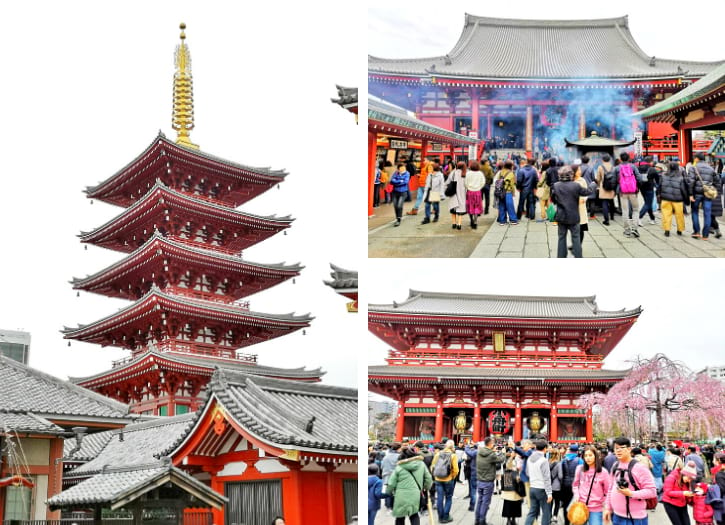
When in Asakusa, you should pay a visit to Sensoji Temple , which is considered Tokyo’s oldest temple .
Before entering the temple complex, you’ll see a famous red lantern hanging at the entrance gate called Kaminarimon . Be sure to snap a photo there .
Then, proceed to explore the unique architectural design of the main shrine . Just beside the temple is the 5-storey pagoda , which is also worth checking out .
d) Suzukien Asakusa – 30 minutes (3:00 PM to 3:30 PM)
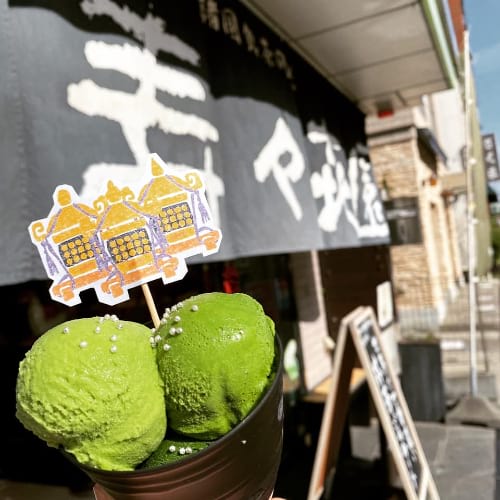
During your exploration, don’t miss the famous ice cream of Suzukien Asakusa . Choose from their variety of green tea flavours.
They have seven matcha intensity levels, with the richest as the most bitter one .
So, if you’re a matcha fanatic, you’d definitely fall in love with their amazing selection of matcha flavoured gelato .
e) Asakusa Denboin-Dori – 30 minutes (3:30 PM to 4:00 PM)

Don’t forget to check out the Asakusa Denboin-Dori. This charming street, located right next to the famous Senso-ji Temple , is like a step back in time.
Here, you’ll feel like you’ve stepped back in time. The street is lined with shops and stalls that sell traditional Japanese crafts, snacks, and souvenirs .
It’s perfect for finding unique gifts or just enjoying the old-time atmosphere.
And remember to bring your camera – the traditional architecture and bustling street life make for great photos .
Asakusa Denboin-Dori is more than just shopping; it’s a slice of old Tokyo you’ll love to explore.
f) Shin-Nakamise Shopping Street – 1 hour (4:00 PM to 5:00 PM)
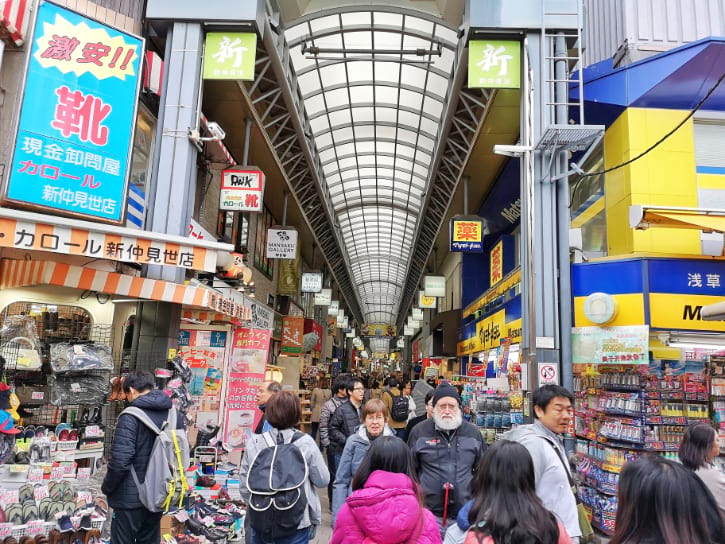
Walking through Shin-Nakamise Shopping Street , you’ll be impressed by the array of local items on display.
This street is filled with shops offering clothes, accessories, and traditional Japanese items .
It’s less crowded than the main Nakamise street , so you can shop at a more relaxed pace .
g) Return Your Rental Kimono – 30 minutes (5:00 PM to 5:30 PM)
Next, return your rented kimono, and then proceed to the next spot mentioned below.
h) Asakusa Culture Tourist Information Center – 30 minutes (5:30 PM to 6:00 PM)
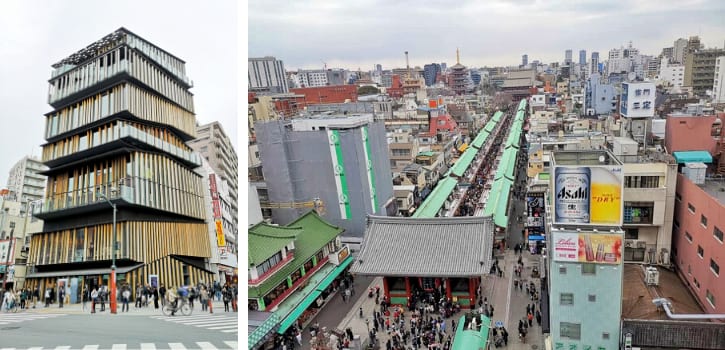
The Asakusa Culture Tourist Information Center is a stunning sight , even from afar.
Its architecture, resembling stacked boxes, is truly unique and catches the eye.
This building is a favorite among photographers for its striking appearance.
Don’t forget to visit the 8th floor for breathtaking views of Sensoji Temple, Nakamise Street, and Tokyo Skytree .
i) Tendon Tenya – 30 minutes (6:00 PM to 6:30 PM)
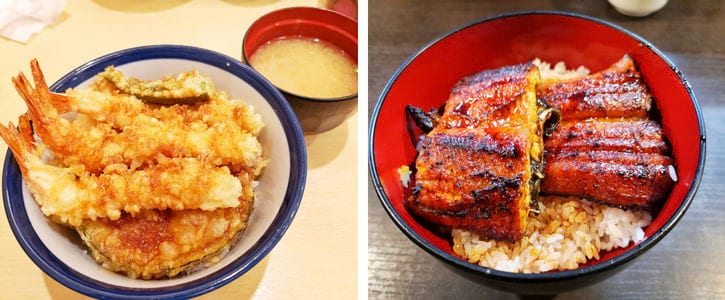
There are two popular restaurants in Asakusa where you can enjoy your dinner.
- Tendon Tenya: Try some of Tokyo’s best tendon at Tendon Tenya. They have a great menu with different tendon and Teishoku dishes. The top choice is the “All-Star Tendon” for 720 yen.
- Unatoto: This famous unagi place offers delicious, affordable eel dishes. You can pick from various eel bowls and sets. Their classic grilled eel rice bowl costs 590 yen.

5. Tokyo Skytree – 2 hours (6:30 PM to 8:30 PM)
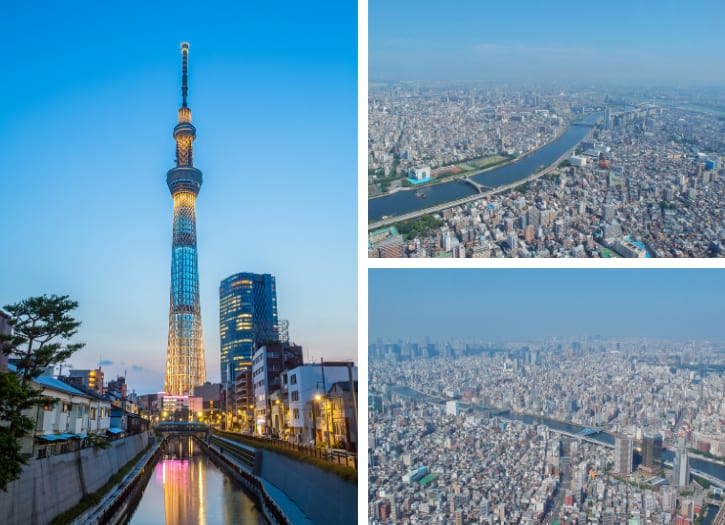
In the evening, spend some time at the Tokyo Skytree . It’s more than just a tower – it’s the tallest in Japan and offers incredible views of the city .
The Tembo Deck and Tembo Galleria are the main attractions of the building. From these observation decks, you’ll see various Tokyo landmarks illuminated by the city lights.
My tip: go in the evening to see Tokyo light up at night. It’s an experience you won’t forget.
Remember to buy your Tokyo Skytree tickets online , as they are in high demand and go fast , especially during peak season. Another advantage of booking online is that you can get an extra 15% discount .

Our day 5 itinerary involves taking a day trip from Tokyo to Mt. Fuji . I encourage you to visit this place because the landscapes here are incredibly beautiful.
Some of the things you can do there include exploring Lake Kawaguchiko and Oshino Hakkai . These two are very popular spots in the area.
You can also ride the Kachi Kachi Ropeway to easily capture the beautiful Mount Fuji as your background .
Try to check out my post on Tokyo to Mount Fuji day trip here to learn the best ways to reach the area. This also guides you in discovering all the must-visit attractions.
Transportation Guide:
For a stress-free trip to Mount Fuji from central Tokyo , you can check out the popular Bus Tour 1 / Bus Tour 2 / Bus Tour 3 here.
These buses take you directly to Mount Fuji and its surrounding attractions. Super convenient!
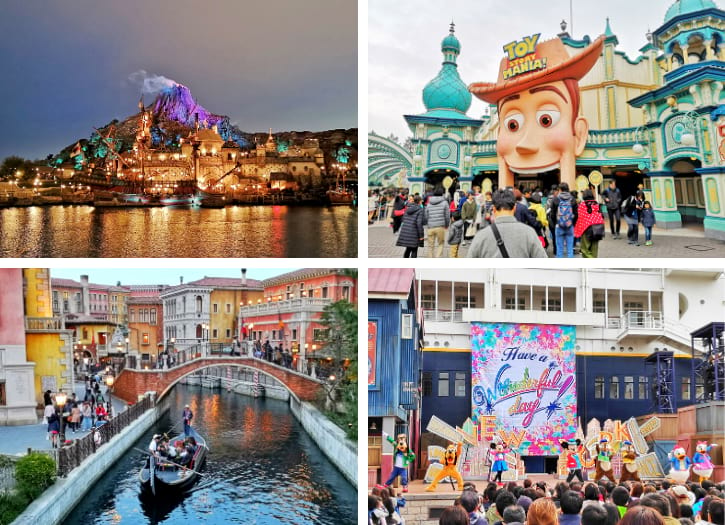
If you’re heading to Tokyo DisneySea , you’re in for an exciting day! The park focuses on ocean stories and offers a variety of thrilling and family-friendly rides .
Start at Mediterranean Harbor , which looks just like an Italian port and has cool water shows .
Don’t miss Mysterious Island with its volcano and awesome rides like “Journey to the Center of the Earth” .
Be sure to check out Toy Story Mania! in the American Waterfront area, a super fun 4D interactive ride based on the Toy Story movies.
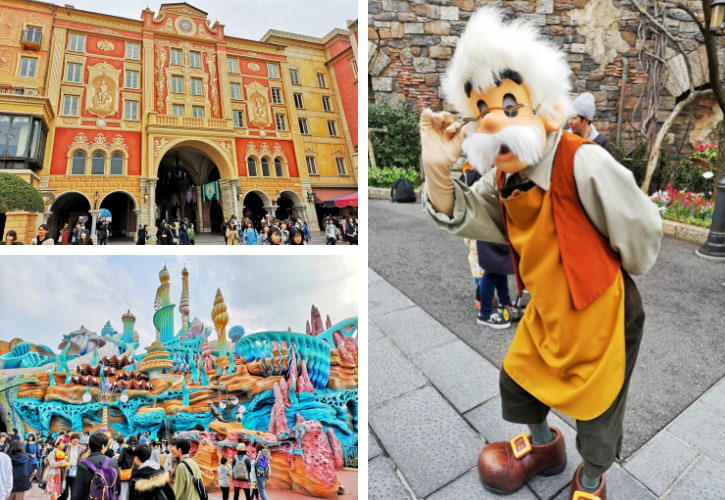
And that’s not all – you’ll get the chance to meet beloved Disney characters like Mickey Mouse, Donald Duck, and even Geppetto . These character meet-ups are great for memorable photos and interactions.
Each area has its own special rides, shows, and food. Also, the night shows over the water are a must-see.
Recommendation: Buy your DisneySea tickets online here before your trip. Tickets are not available for purchase on-site. Book them early, as they often sell out quickly.

On day 7 of this Tokyo itinerary, you will be going the following spots:
- 9:00 AM: Tokyo Metropolitan Government Building
- 11:30 AM: Odaiba
1. Tokyo Metropolitan Government Building – 1.5 hours (9:00 AM to 10:30 AM)
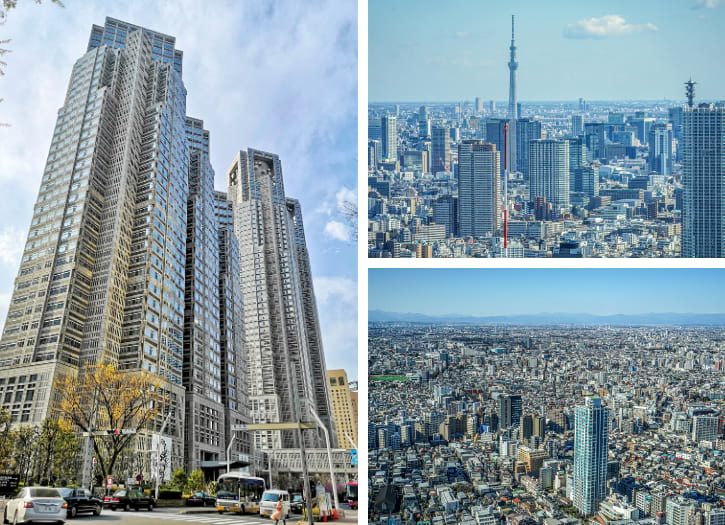
On the first stop of your last day trip , you’ll visit the Tokyo Metropolitan Government Building .
This building houses two observation decks : the North Tower and South Tower .
Conveniently, both decks are free to access . From these observation points, you can catch a glimpse of iconic sights like the Tokyo Skytree and Tokyo Tower .
And on a clear day , it’s easy to spot the famous landmark in Japan, Mount Fuji . For the best views , pick the North Observatory .

2. Odaiba – 8.5 hours (11:30 AM to 8:00 PM)

Itinerary breakdown for touring Odaiba :
- 11:30 AM: teamLab Planets TOKYO
- 1:30 PM: Food Court at DiverCity Tokyo Plaza (Lunch)
- 2:30 PM: Unicorn Gundam Statue
- 2:35 PM: Fuji Television Building
- 3:35 PM: Odaiba Statue of Liberty
- 3:40 PM: Odaiba Takoyaki Museum
- 4:10 PM: Tokyo Joypolis
- 6:10 PM: Odaiba Seaside Park
- 7:10 PM: Eggs ‘n Things (Dinner)

a) teamLab Planets TOKYO – 2 hours (11:30 AM to 1:30 PM)

You really can’t skip teamLab Planets TOKYO when you’re in Tokyo.
This amazing art museum is all about interactive, digital art.
You’ll walk through rooms with beautiful light displays and sounds that create an immersive world . The exhibits change around you, making you feel like you’re part of the art .
It’s a special experience that’s really unforgettable. You’re going to have a great time there!
A little suggestion: Book your teamLab Planets tickets in advance , as they tend to sell out quickly.

b) Food Court at DiverCity Tokyo Plaza – 1 hour (1:30 PM to 2:30 PM)

Head to the 2nd-floor Food Court at DiverCity Tokyo Plaza for lunch. It’s a great place to eat with a variety of options.
Try the Japanese ramen for a taste of local flavors or opt for tempura for a satisfying meal.
And if you’re in the mood for a classic favorite, you can grab a burger . It’s convenient and has something for everyone . Enjoy your meal!
c) Unicorn Gundam Statue – 5 minutes (2:30 PM to 2:35 PM)
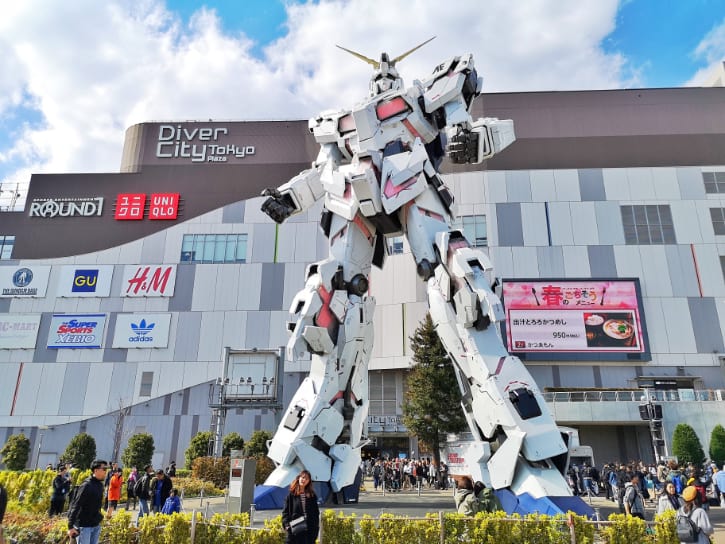
The towering Unicorn Gundam Statue is certainly hard to ignore. Catch a glimpse of this incredible structure that is positioned in front of DiverCity Tokyo Plaza .
And just along the area, you’ll see a landscape of flowers.
d) Fuji Television Building – 1 hour (2:35 PM to 3:35 PM)
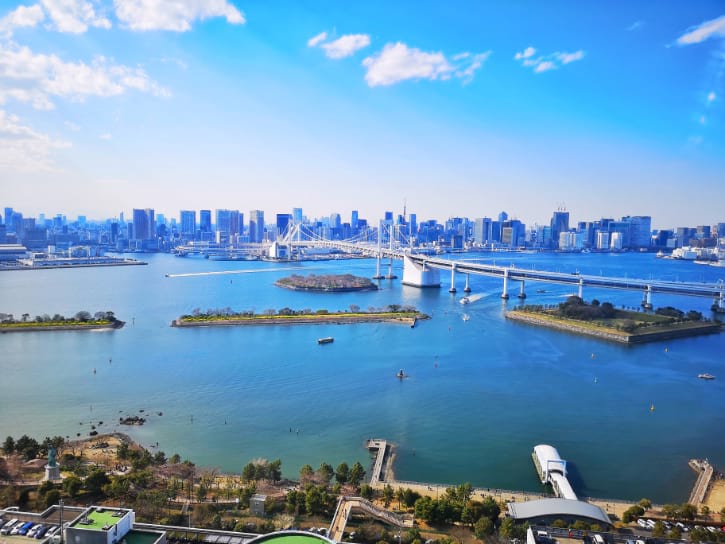
Check out the Fuji Television Building in Odaiba . It’s not just a TV station; it’s an attraction itself.
The building has a unique, futuristic design . You can go up to the observation deck for an amazing view of Tokyo Bay and the Rainbow Bridge .
They also have exhibits about popular TV shows and a shop where you can buy cool souvenirs. It’s a fun place to learn about Japanese TV and enjoy great views. Don’t miss it!
e) Odaiba Statue of Liberty – 5 minutes (3:35 PM to 3:40 PM)
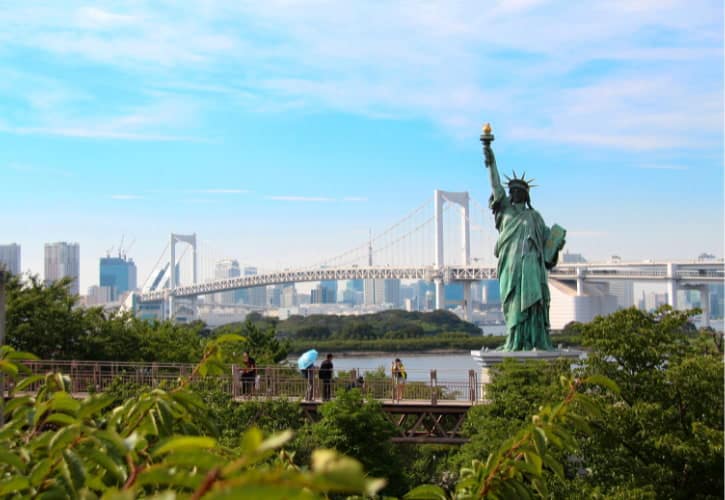
But of course, the Odaiba Statue of Liberty is a distinctive landmark in the area . So be sure to drop by the location and see its wonderful glory.
When taking a photo of the statue, don’t miss to include the Rainbow Bridge for a more panoramic capture.
f) Odaiba Takoyaki Museum – 30 minutes (3:40 PM to 4:10 PM)
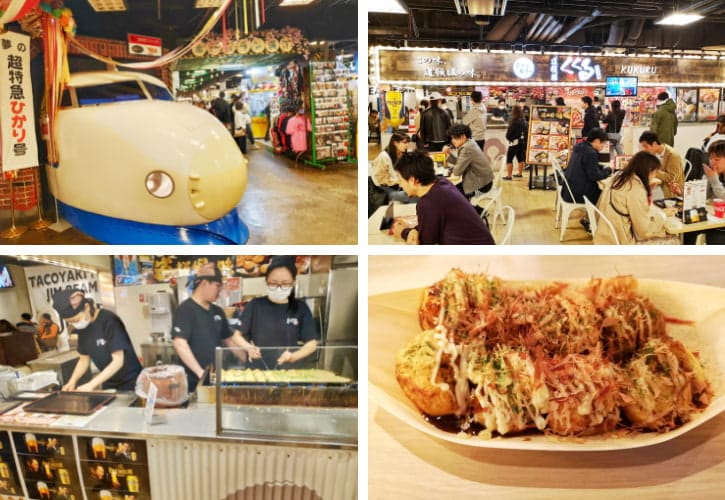
From the name itself, Odaiba Takoyaki Museum welcomes you to a place fully dedicated to Takoyaki lovers !
There are several stalls selling all kinds of Takoyaki flavors , so be sure to check them out.
Aside from that, there are lots of souvenirs available!
Plus, the unique Takoyaki designs all over the place are truly magical. So, take your time exploring this famous food theme spot and capture as many photos as you want.
g) Tokyo Joypolis – 2 hours (4:10 PM to 6:10 PM)
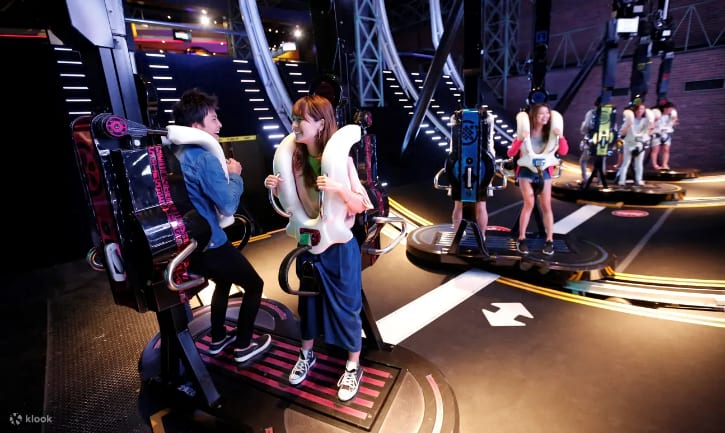
Have fun at Tokyo Joypolis with your family and friends. It’s a huge indoor amusement park, packed with thrilling rides and virtual reality games .
You’ll find roller coasters , arcade games , and a variety of VR experiences that are super fun .
Don’t miss out on the half-pipe ride and the VR zombie game. It’s the perfect place to spend a few hours, especially if you love gaming and rides. You’re sure to have a blast!
And if you decide to visit the place, you may purchase your Tokyo Joypolis tickets online and enjoy up to 20% OFF!
h) Odaiba Seaside Park – 1 hour (6:10 PM to 7:10 PM)
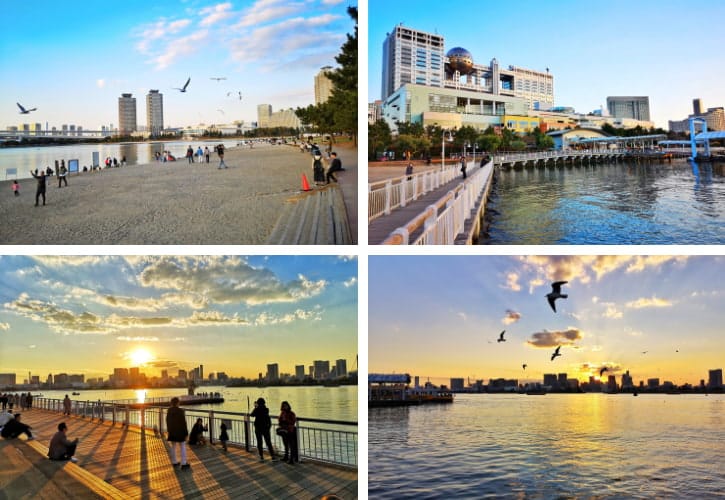
If you want to simply relax, include Odaiba Seaside Park in your schedule. This coastal green space is surrounded by blue vistas and green nature views.
And from afar, you can see the cityscape and some iconic landmarks.
Catch sight of the Rainbow Bridge and the Fuji Television Building.
Or you may just wander around the vast area and enjoy the scenery . Afterward, you can explore the eateries and shops nearby.
i) Eggs ‘n Things – 50 minutes (7:10 PM to 8:00 PM)
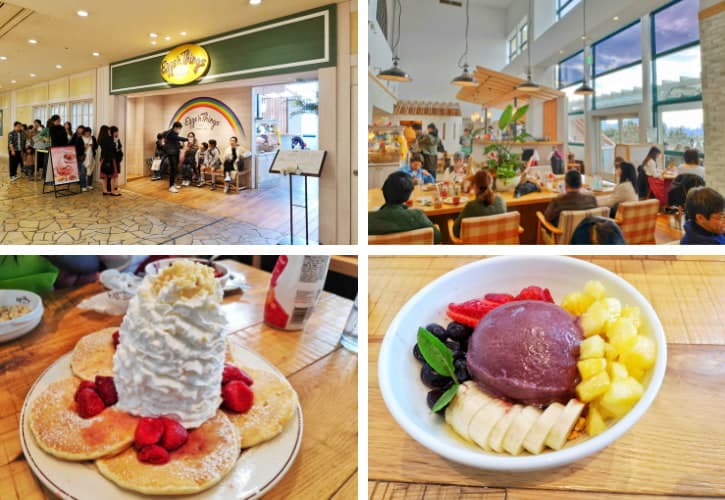
After a fun-filled day, head to Eggs ‘n Things and have a hearty dinner.
Although this restaurant is known for its breakfast options, they have lots of savory meals.
Go over their menu of tasty dishes, including spam & eggs , grilled potatoes , and chicken burger .
Complete your meal with their classic waffles or crepes. And for your drinks, choose from their selection of juice, coffee, lemonade, and soda.
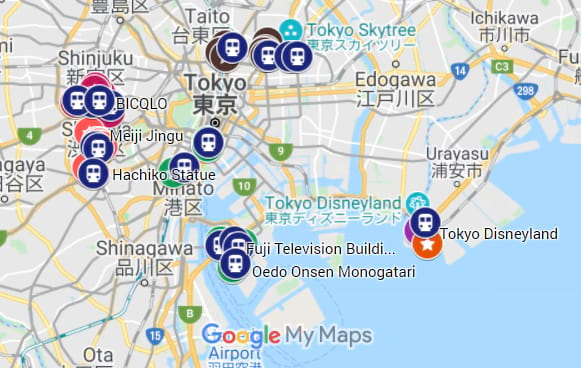
To help you easily visualize this travel plan in Tokyo from day 1 to day 7, you can refer to the map above.
The easiest way to get around Tokyo is by using subways and trains , which can take you to most tourist spots.
You can use Google Maps to help find routes and estimate travel times.
I recommend obtaining a Welcome Suica card for efficient and affordable travel in the city. This card helps save both time and money.
Why use the Welcome Suica Card
- Save time when commuting around Tokyo via train. Using your card, you simply tap it at the ticket gate and you can hop aboard the train with ease.
- There’s no need to queue up for buying individual tickets at ticket vending machines every time you board a train.
- It is very convenient and reliable. Plus, it allows you to ride the JR trains, metros, buses, and even taxis in Tokyo with ease.
- You can also use the card when buying items from convenience stores like 7-eleven, Lawson, and Family Mart.
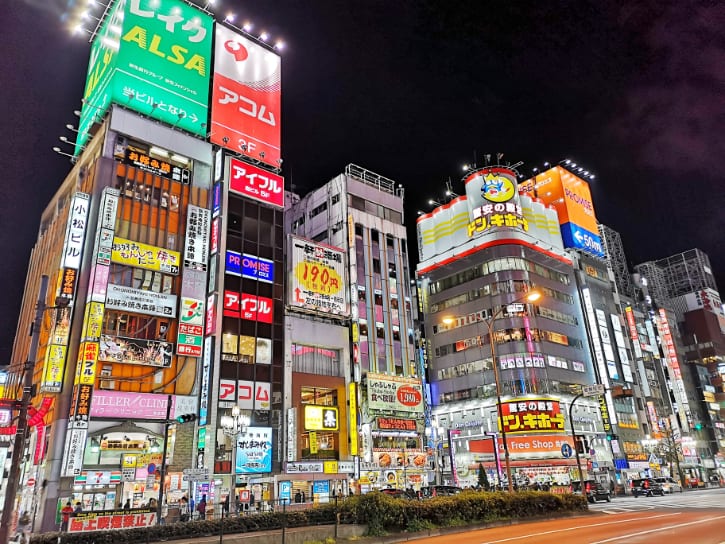
The best place to stay in Tokyo for travellers is Shinjuku . And if you want to stay in this area, make sure to book your hotel in advance .
Most hotels in the area sold out faster because of its convenient location ; hence, many travellers prefer to stay here when travelling to Tokyo.
Recommended Hotels in Shinjuku
- Citadines Central : Close to the JR train station with a Lawson store at the entrance and a 7-Eleven nearby. Don Quijote, Matsumoto Kiyoshi, and Kabukicho are just a 5-minute walk away.
- JR Kyushu Hotel Blossom Shinjuku : Only a minute away from both Lawson and 7-Eleven, and a 2-minute walk to Shinjuku Station.
- Tokyu Stay Shinjuku : Near Shinjuku-sanchome Station and a 5-minute walk to well-known Tokyo restaurants like Sushi Zanmai and Ichiran.
- Hotel Sunroute Plaza : Offers airport limousine service to Narita and Haneda. FamilyMart and Lawson are around the corner, and it’s a 4-minute walk to the train station.
6 Main Reasons Why Shinjuku is the Best Area to Stay in Tokyo for Tourists
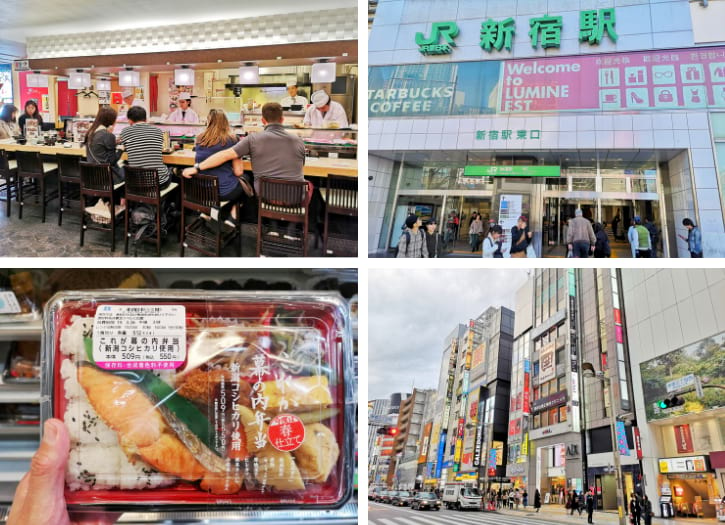
- Delicious Foods at Affordable Prices: This area is surrounded by many budget-friendly restaurants like Tendon Tenya, Hakata Tenjin, and Matsuya, as well as mid-range restaurants such as Ichiran and Sushi Zanmai.
- Convenient Train Access: Easily accessible JR and Tokyo Metro Stations provide quick links to major tourist spots.
- Plenty of 24-Hour Convenience Stores: FamilyMart, 7-Eleven, and Lawson are all nearby, offering snacks, meal boxes, and essentials.
- Great Shopping Options: For fashion, head to Bicqlo and Uniqlo; for beauty products, Matsumoto Kiyoshi and Daikoku Drug are close by. Don Quijote is perfect for Japanese snacks.
- Easy Bus Ride to Haneda Airport: For easy transportation from Haneda Airport to Shinjuku , take the limousine bus transfer for 1,250 yen. The travel time is around 30 minutes.
- Quick Access to Narita Airport: There is also a direct limousine bus from Narita Airport to Shinjuku , taking about 105 minutes. For a faster option, the Narita Express train takes 85 minutes and costs 3,250 yen.
For easy travel in Tokyo, get a Japan SIM card or rent a pocket WiFi . This helps with route searches and navigation on Google Maps. You can book them online and pick up at Haneda or Narita Airport.
My Tokyo guide for 7 days is now complete. I hope this itinerary helps you make the most of your visit to this vibrant city!
Travelling to Seoul? Take a look my Seoul itinerary here.

20 Best Tokyo Disneyland Rides You Shouldn’t Skip for All

17 Best Tokyo DisneySea Rides You Can’t Miss Now

17 Top Things to Do in Shibuya with My Ideal Itinerary
7 thoughts on “tokyo itinerary: the best 7-day guide for a fantastic trip”.
hello, I’m henokh wiranegara from Indonesia, thank you very much for making a blog about Tokyo, complete with itinerary photos, location photos. it really makes it easier for me to enjoy Tokyo. I have never found a blog as interesting as this one. Thank you very much for helping me on my holiday in Tokyo with my family. Thank you very much.
Thank you so much for this! I can see how much work you put into this. I like that there’s a suggested hours per spot and you’ve provided an infographic of the itinerary. I am glad came across your blog.
Thank you for your kind words, Maeriz! It took me many days to create this itinerary, and I hope it will make planning a trip to Tokyo easier for others and save them time on research. I’m glad to hear that you found the suggested hours and the infographic helpful. I wish you a wonderful journey to Tokyo!
I had been stuck for weeks trying to create an itinerary for my trip and your blog made everything much easier. Thank you so much!!
Thank you so much, Josh. So much work you put into this is amazing. I will use it for my upcoming trip with my family from Australia. I’m glad I came across your blog. I have added your page to my favorites. Thanks again for a very informative post. Truly helpful.
Hello, thank you so much for this detailed and well presented tokyo trip guide this is very helpful for us 1st timers in Japan. I would just like to ask which hotel to go while on the said location since I have 2 kids with me. Thank you!
Hey Joy, sorry for getting back to you late! I’d suggest choosing either the Hotel Sunroute Plaza or the JR Kyushu Hotel Blossom Shinjuku. These two hotels are really close to the Shinjuku train station, which could be super convenient for you, especially with two kids in tow.
Leave a Comment Cancel reply
Send me an email when the author replied my comment. (Please take note your comment only will show on this blog post after approved by me to prevent spam comments.)
Tokyo Itinerary 7 Days: the Ultimate Guide!
This post may contain compensated links. Find more info in our disclosure policy
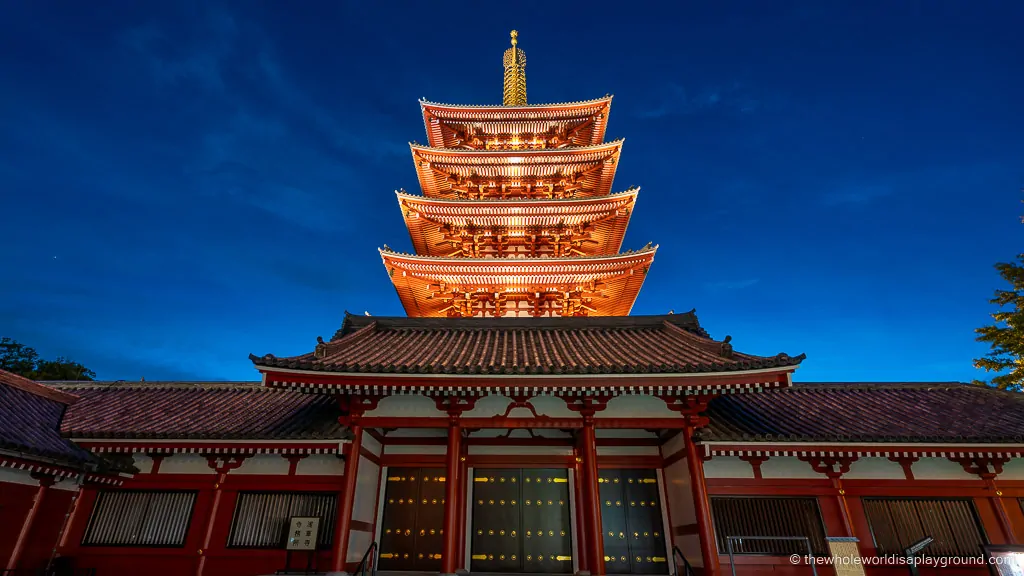
Having spent a month exploring Tokyo we’ve put together our recommended 7 day Tokyo itinerary for those with a week to spend in the city. From the iconic Shibuya Crossing to the neon lights of Akihabara, the historic Asakusa and the incredible food and drinks, Tokyo is one of the best cities in the world to visit. For those of you planning your own 7 day Tokyo itinerary, we wanted to share our guide to Tokyo including the best things to do and what to see. Enjoy!
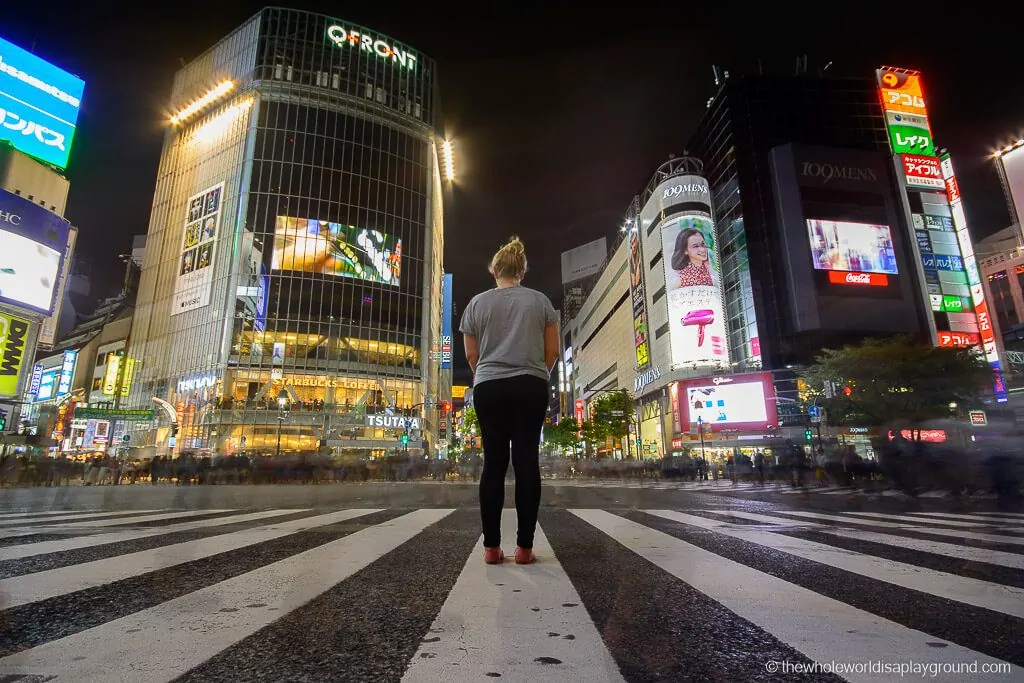
Tokyo Itinerary Essentials
From transport to internet, these are our Tokyo itinerary essentials!
How long to spend in Tokyo
Depending on how long you have to spend in Japan, we recommend allowing at least 5 nights in Tokyo. We’ve included a detailed itinerary for 7 days of sightseeing – just pick and choose days based on your interests and length of visit.
Tokyo itinerary tip: this 7 day Tokyo itinerary is based on the highlights and unmissable experiences from the months we’ve spent exploring Tokyo and its best sights.
Tokyo Transport
Tokyo is best explored through a mix of trains and walking.
From Narita airport take either:
- Tokyo Skyliner: train to downtown Tokyo in 41 minutes – check prices here
- Airport Bus: bus to Downtown Tokyo from Narita or Haneda Airport- check prices here!
Getting around Tokyo
Depending on the duration of your stay, a 24, 48 or 72 hour subway pass is invaluable for navigating Tokyo. We saved so much money using our 3 day subway pass. The passes can be picked up at one of the designated arrival airports in Japan and work for unlimited rides on Tokyo Metro and Toei Subway lines – check prices now!
Click here to order your Tokyo subway pass
After we’d used our unlimited passes we switched to a rehargeable Suica or a Pasmo card. The cards are swiped at the ticket barriers to pay for the train fare instead of buying individual tickets for each train ride. We found them much quicker and more convenient than individual journey tickets – check prices now!
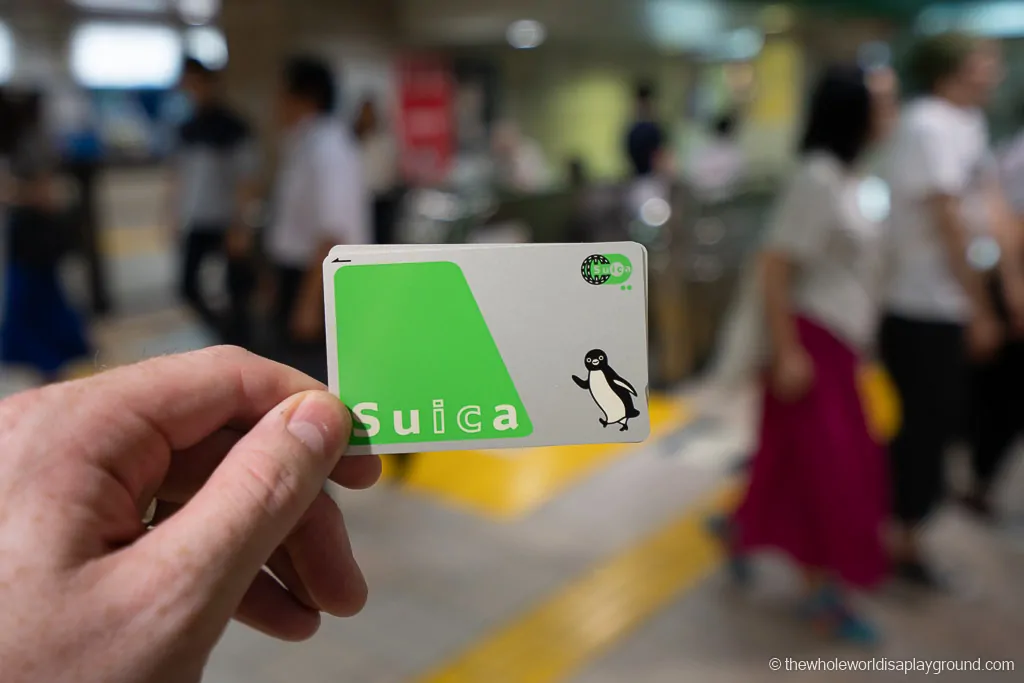
Tokyo itinerary tip: We’ve included How to get there info for each day of our itinerary. However, the easiest way to navigate Tokyo is to purchase a Sim card and use Google Maps for real time train options and walking directions. We found having a Sim invaluable – check prices now!
Where to stay in Tokyo
Tokyo is best explored by a combination of trains and walking so we recommend choosing a hotel within a short walking distance of a subway station, the Yamanote Line or one of the major train stations such as Tokyo Station.
- Mitsui Garden Hotel Koyobashi: close to both Tokyo Station and the Koyobashi Metro Station, the Mitsui Garden Hotel is a great base for exploring the city. Standard rooms are a reasonable size ad there is coin-operated laundry – check prices here!
- Shibuya Excel Hotel, Tokyu : close to Shibuya Station the hotel’s 25th-floor restaurant level offers the best views of Shibuya and the location is excellent for exploring the city – check prices here!
- Keio Plaza Hotel: a 5 minute walk from Shinjuku Station, Keio Plaza has comfortable rooms and awesome views of Shinjuku – check prices here!
Click here for the best Tokyo hotel prices
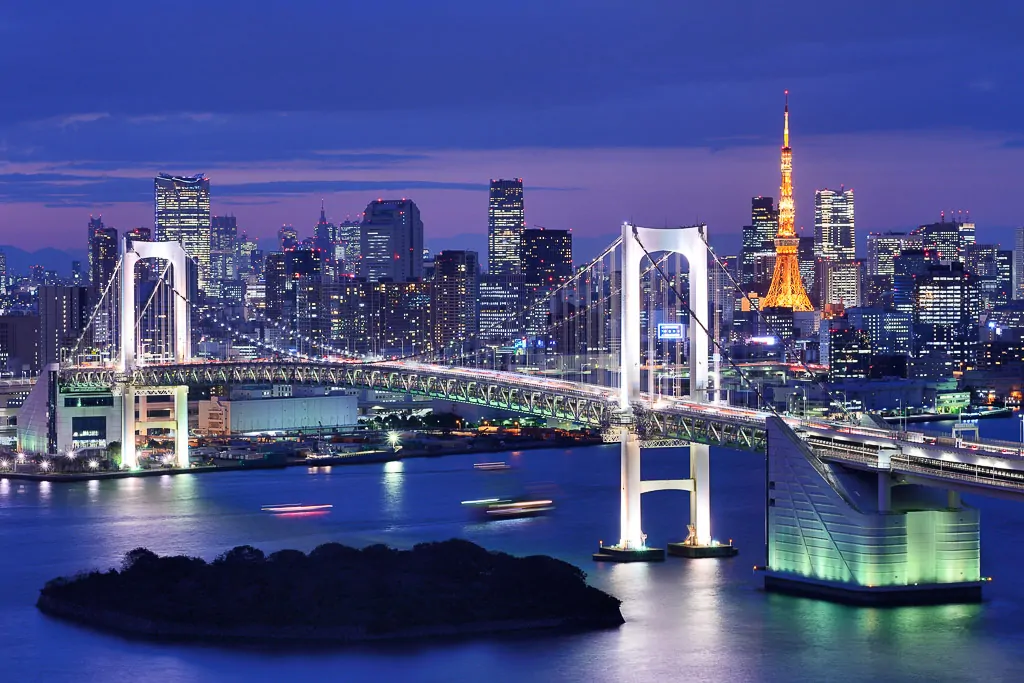
One of the best investments for a Japan trip is to obtain a sim card or 4G hotspot for internet access while on the go. A sim card is perfect if you just have your phone while 4G hotspots are great if you have multiple devices or if you’re travelling in a group.
We used the Klook app to order our sim cards. The app is great as you can order in advance, pick up on arrival or from various departure cities and the price is usually discounted.
- The best 4G hotspot on offer is provided by URoaming with unlimited data – check prices now!
- The best sim card is from Docomo – check prices now!
Click here to order your SIM Card
Daily Tokyo itinerary
Below you’ll find 7 days of Tokyo itinerary fun! We’ve planned our recommended itinerary based on the best things to do in Tokyo and ordered them so as to minimize the traveling between sights.
Day 1: Odaiba and Shinjuku
A man made island in Tokyo Bay, Odaiba is a shopping and entertainment mecca which is best known for its incredible Digital Art Museum, TeamLab borderless. Shinjuku is Tokyo’s hub for eating, drinking, entertainment and shopping and is home to towering skyscrapers and neon lights.
TeamLab Borderless in Odaiba
Start the day with one of the most incredible things to do in Odaiba and in Tokyo, the TeamLab Borderless Digital Art Museum.
How to get there: the closest station to TeamLab Borderless is Aomi Station. The fastest way to go is to take Yurikamome Monorail from Shimbashi Terminal. After disembarking at Aomi Station, it’s a short walk to TeamLab Borderless.
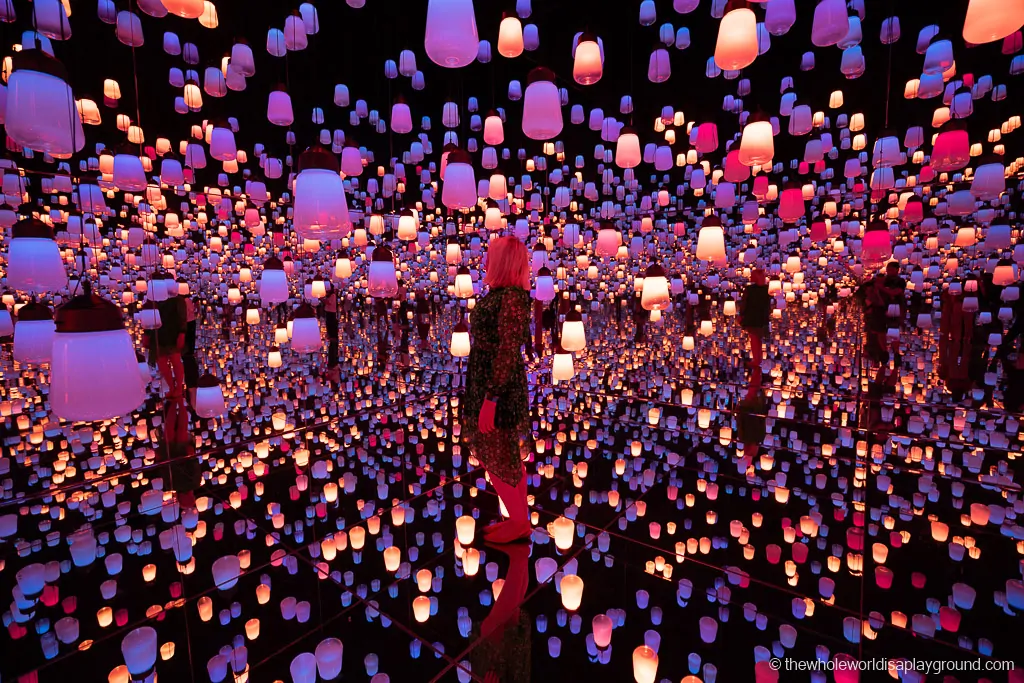
TeamLab Borderless is a magical world of colour, light and sound. It is divided into 5 distinct sections: Borderless World, Athletics Forest, Future Park, Forest of Resonating Lamps, and EN Tea House. The Forest of Resonating Lamps, with coloured lanterns which seem to stretch forever, was our highlight. Crystal World, a mirrored room of LED ropes which create a crystal effect, is also incredible.
TeamLab Borderless sells out almost every day so it’s essential to reserve tickets in advance. Entrance is only by official ticket and you can reserve your tickets in advance on Klook – check prices here!
Click here to order TeamLab Borderless tickets
Tickets are reserved for a specific day but there are no assigned entry times – ticket holders can visit at any time during the museum opening hours.
Tokyo itinerary tip: we highly recommend visiting TeamLab Borderless on a weekday, either first thing in the morning or late afternoon, as it can get uncomfortably busy at peak times.
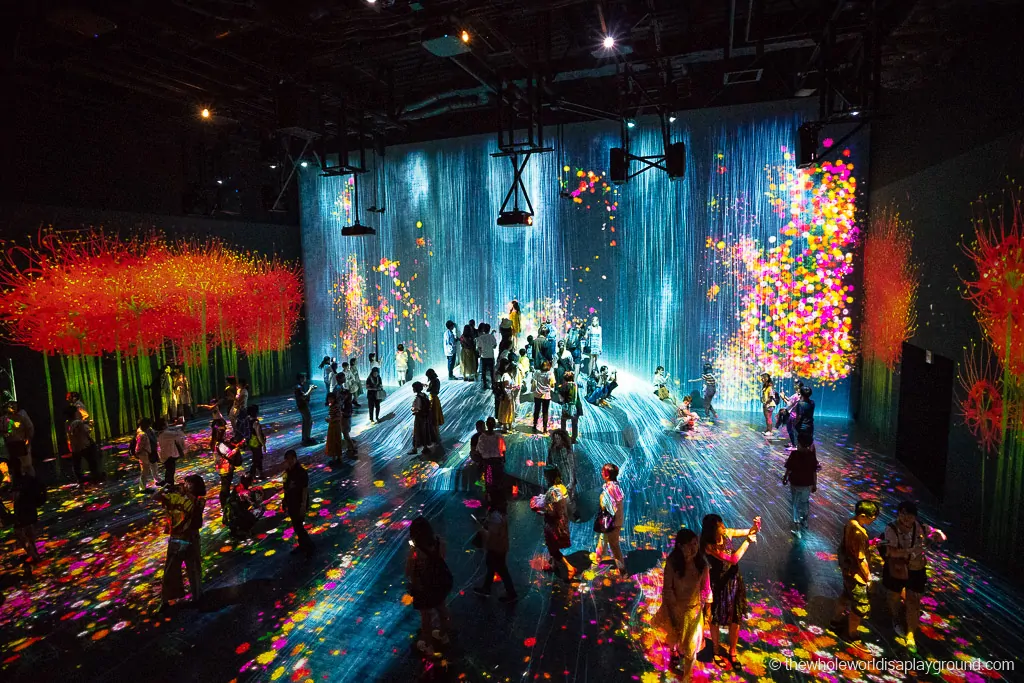
Shinjuku is one of Tokyo’s most fascinating neighbourhoods and we recommend setting aside the rest of the day to explore.
How to get there: Take the Rinkai Line from Tokyo Teleport Station (a 10 minute walk from TeamLab Borderless) to Shinjuku Station. The Rinkai line transfers to the Saikyo Line during the journey but you don’t need to change train.
As you disembark at Shinjuku Station take a moment to look around and absorb the energy. Over 3.5 million passengers use the station every day and it is incredible to observe the organized chaos of the world’s busiest train station.
After leaving the train station, take a stroll through the tranquil Shinjuku Gyoen Park. With picturesque ponds and English, French and Japanese gardens, the park is a beautiful contrast to the surrounding skyscrapers and chaotic streets of Shinjuku.
Tokyo itinerary tip: if you visit during cherry blossom season, the sakura trees make Shinjuku Gyoen one of Tokyo’s most popular spots.
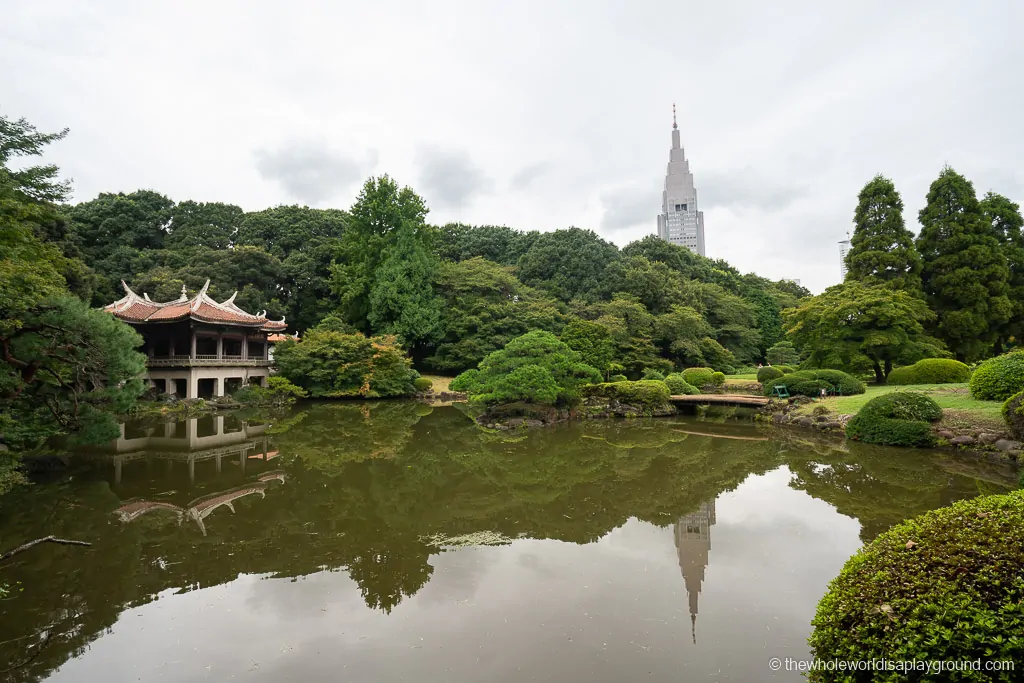
Tokyo boasts the world’s only Michelin Star ramen restaurants and Shinjuku is home to the latest Michelin Star Ramen joint, Soba House Konjiki Hototogisu. If you are lucky, you might pass on a day when the queues are short and you grab a spot relatively quickly.
Tokyo itinerary tip: as with the three Tokyo ramen restaurants with Michelin Star status, a bowl of ramen comes in at around $10.
The Tokyo Metropolitan Government Building is a short walk from Shinjuku Gyoen and offers a free observation deck on the 45 th floors of its North and South towers. The views of the city are incredible and, on a clear day, it is possible to catch a glimpse of the iconic Mount Fuji.
Tokyo itinerary tip: due to renovations, only the South Observatory is currently open.
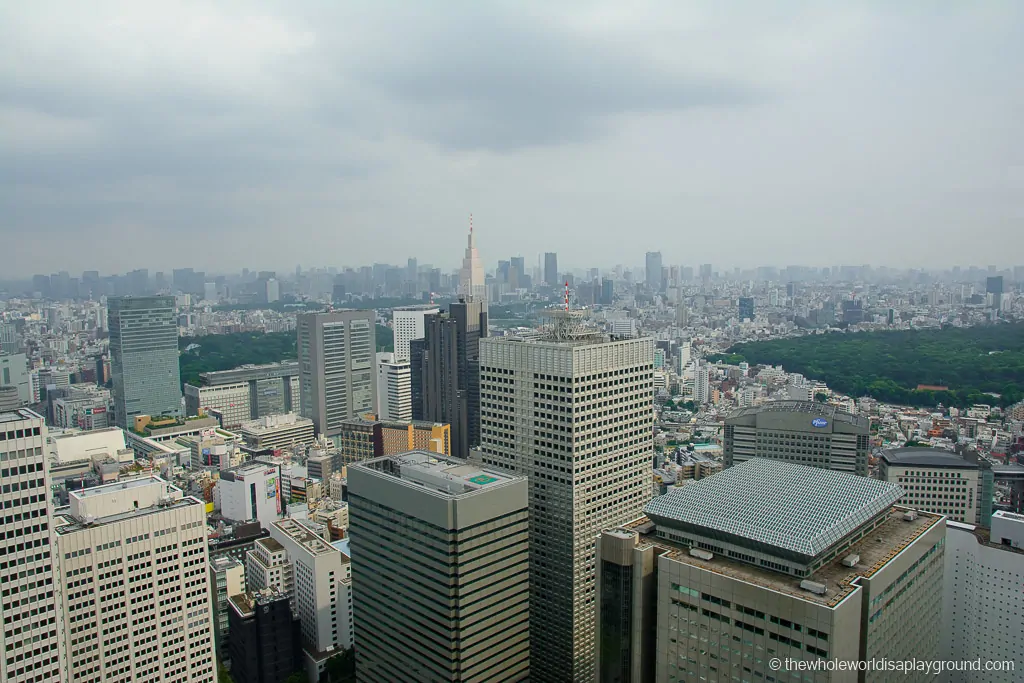
If you are a Van Gogh fan, Sunflowers by Van Gogh is one of the most famous pieces in the nearby Seiji Togo Memorial Sompo Japan Nippon Koa Museum of Art. The 42 nd floor panoramic views are a bonus!
Tokyo itinerary tip: the museum is closed until March 2020 so do check it has reopened before visiting.
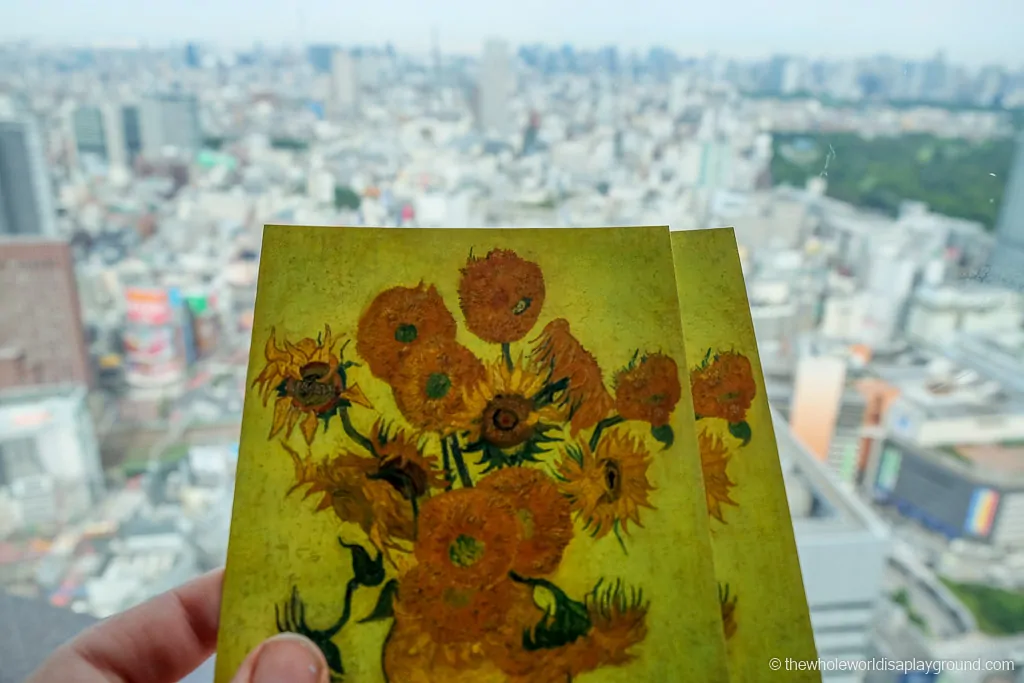
The next stop is one of our absolutely favourite things to do in Shinjuku , grabbing a spot at one of the tiny yakatori bars on Omoide Yokocho, or Memory Lane as it is known in English. The gritty alley was once an illegal drinking quarter that is now home to a collection of tiny yakitori bars serving drinks and freshly cooked skewers. Red lanterns light up the alley and yakitori smoke fills the air making for an amazing Tokyo atmosphere.
Tokyo itinerary tip: an abundance of beer and the absence of toilets in its heyday resulted in its commonly used nickname, Piss Alley!
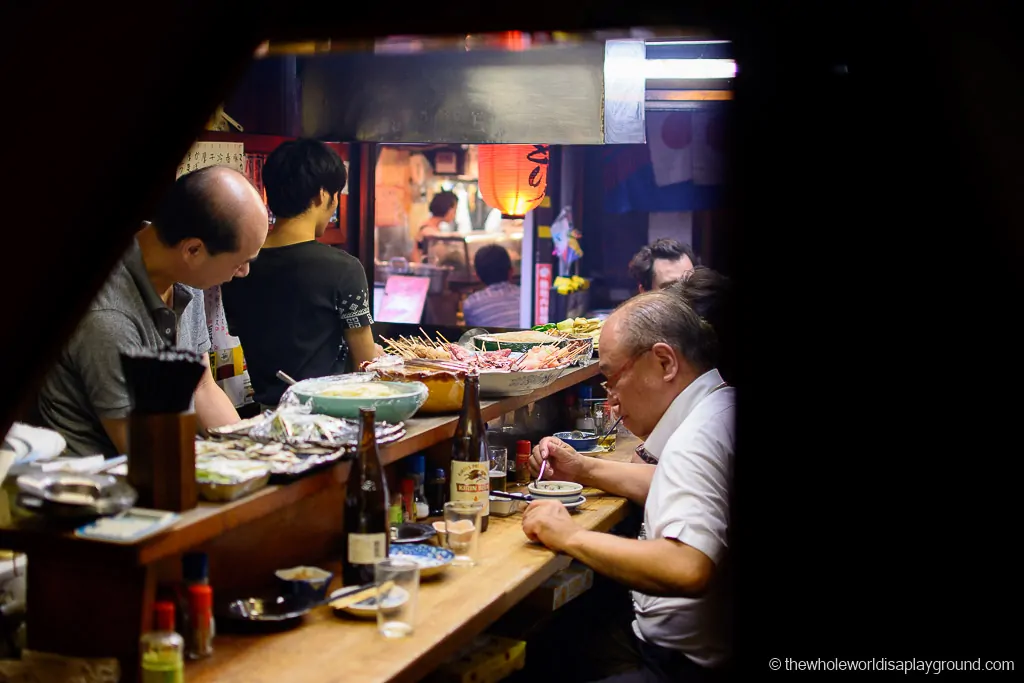
Have a browse at the Shinjuku branch of Don Quijote , a Japanese discount store, where there is an eclectic range of products ranging from the luxurious to the ridiculous!
If you are interested in Japanese history and conflict, Shinjuku’s Samurai Museum has over 70 samurai displays with armor, helmets, guns and swords. Capture some photos while dressed in replica armor of Japanese warriors or holding a Samurai sword – click here to book your spot at the Samurai Museum!
As darkness falls, it’s time for a wander through Kabukicho, Tokyo’s Red Light district . The area is a heady mix of neon lights, bars, nightclubs, love hotels and themed restaurants and is fascinating to visit after dark.
Reserve a table at Shinjuku’s Robot Restaurant . With its neon lights, laser beams, techno music and crazy performances, Robot Restaurant is a tourist rite of passage in Tokyo! It’s weird, whacky, colourful, loud and super touristy but a quintessential Japan experience all the same!
Klook sells discounted tickets which we used to save some yen on the admission fee – click here to book your spot at the Robot Restaurant!
Click here for discounted Robot Restaurant tickets
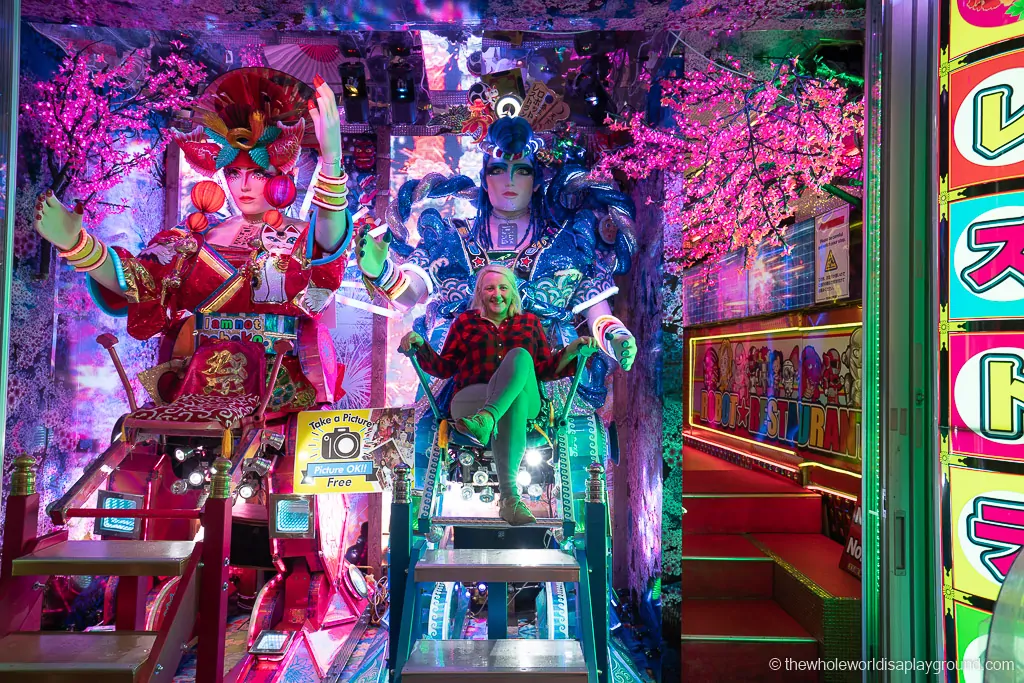
Finish up the day with a bar hop through Golden Gai, six tiny alleys among a maze of passageways. The area is home to over 200 tiny bars, clubs and restaurants. Pull up a seat and order at drink at whichever one captures your imagination.
Tokyo itinerary tip: Golden Gai is still popular with Tokyo locals. Some bars even have signs stating no tourists or regulars only.
The New York Bar at the Park Hyatt Hotel is another great option for an evening cocktail in Shinjuku. It was in this 52 nd floor bar where Bob and Charlotte (Bill Murray and Scarlett Johansson) met in the movie Lost and Translation. The views, ambiance and cocktails are all incredible!
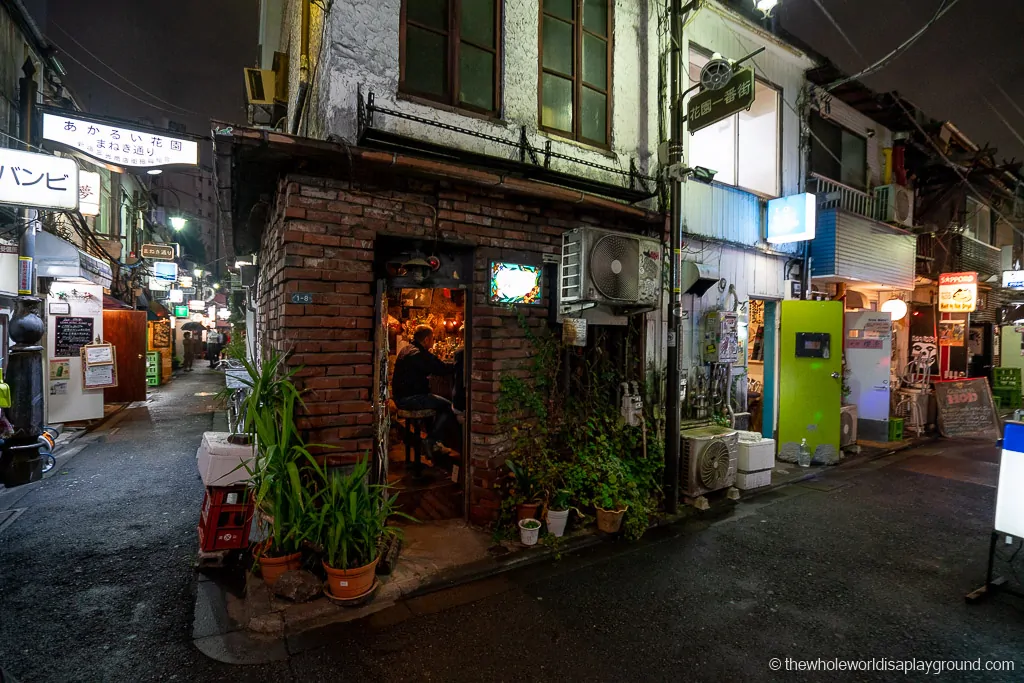
Day 2: Harajuku
Harajuku is one of the quirkiest and most colourful of Tokyo’s neighbourhoods and is the kawaii and fashion capital of Japan.
Meiji Shrine and Yoyogi Park
The first stop in Harajuku is the tranquil Meiji Shrine which is dedicated to the Emperor Meiji, the first Emperor of Modern Japan. There are two huge torii gates guarding the entrance to the shrine and a huge display of sake barrels which signify a gift to the gods.
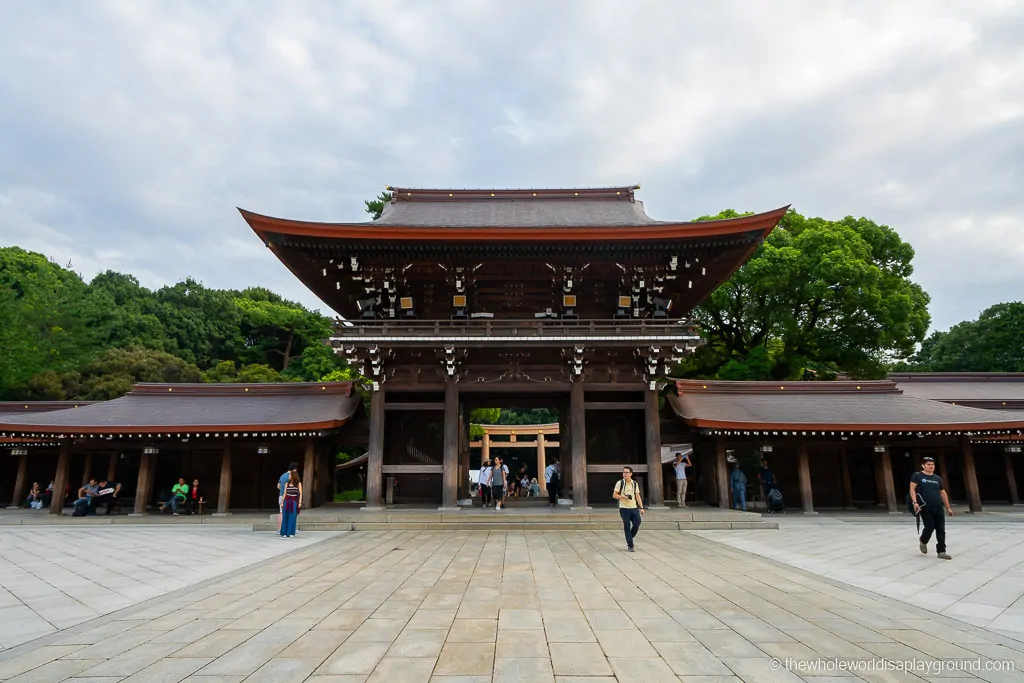
How to get there: Harajuku is on the Yamanote Line, a circular train line which connects many of Tokyo’s popular tourist spots including Shibuya, Shinjuku, Harajuku and Tokyo Station.
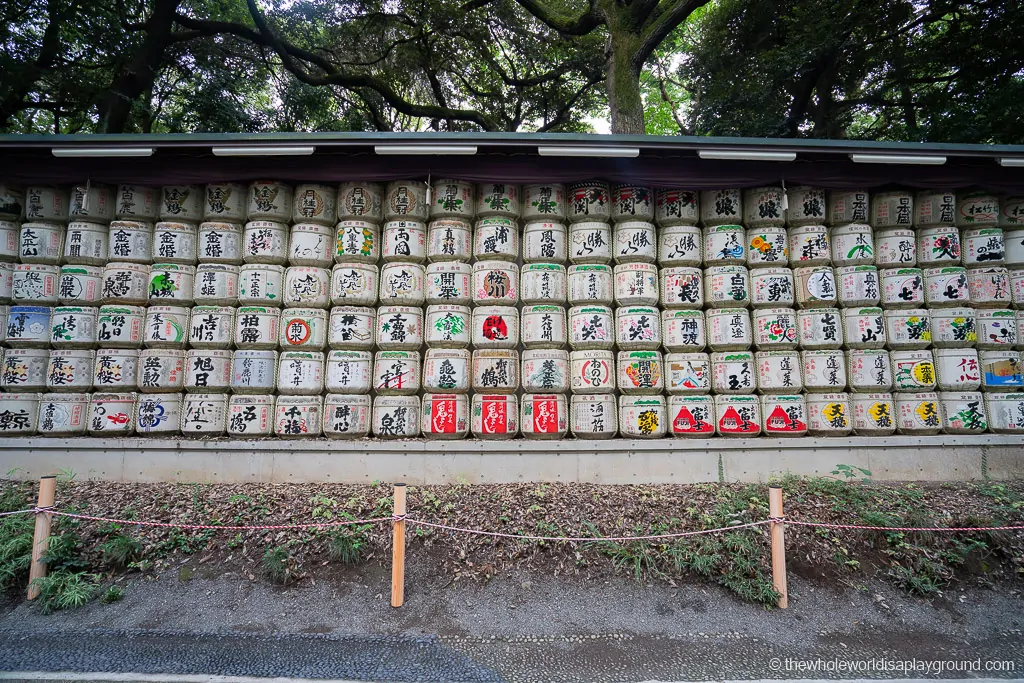
Adjacent to the Meiji Shrine, Yoyogi Park is a hangout for locals and visitors alike and a great place for a stroll.
Tokyo itinerary tip: on Sunday’s the Rockabilly dancers often perform at the Harajuku entrance of Yoyogi Park and it’s a great time to visit.
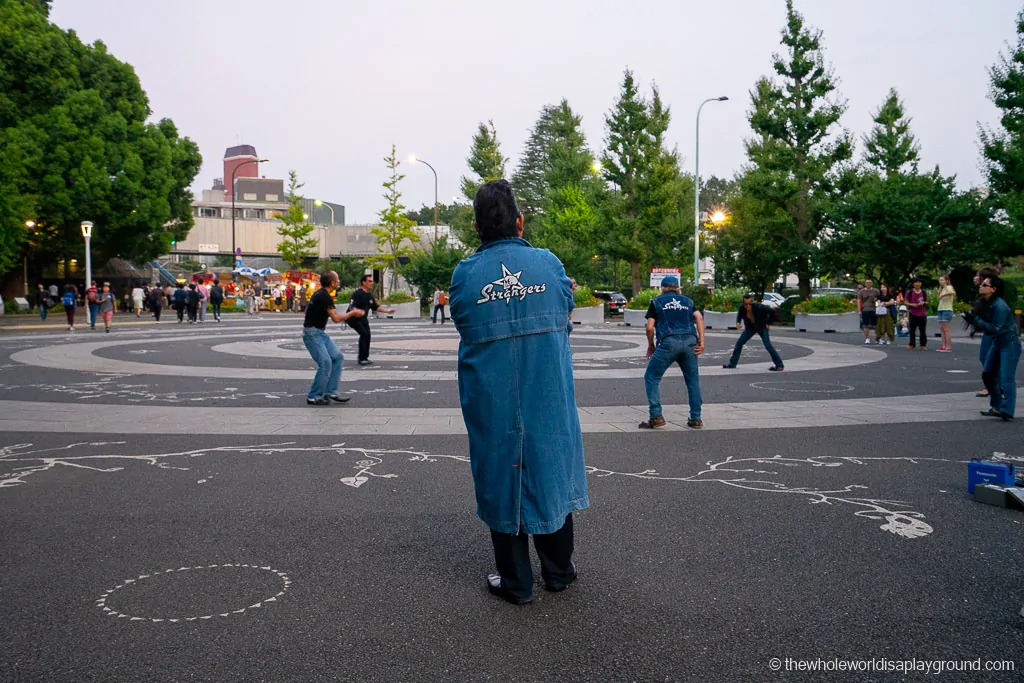
Lunch in Harajuku
If you’ve worked up an appetite there are endless quirky and delicious food options in Harajuku.
Pop into Le Shiner in Harajuku and order one of its famous rainbow grilled cheese sandwiches.
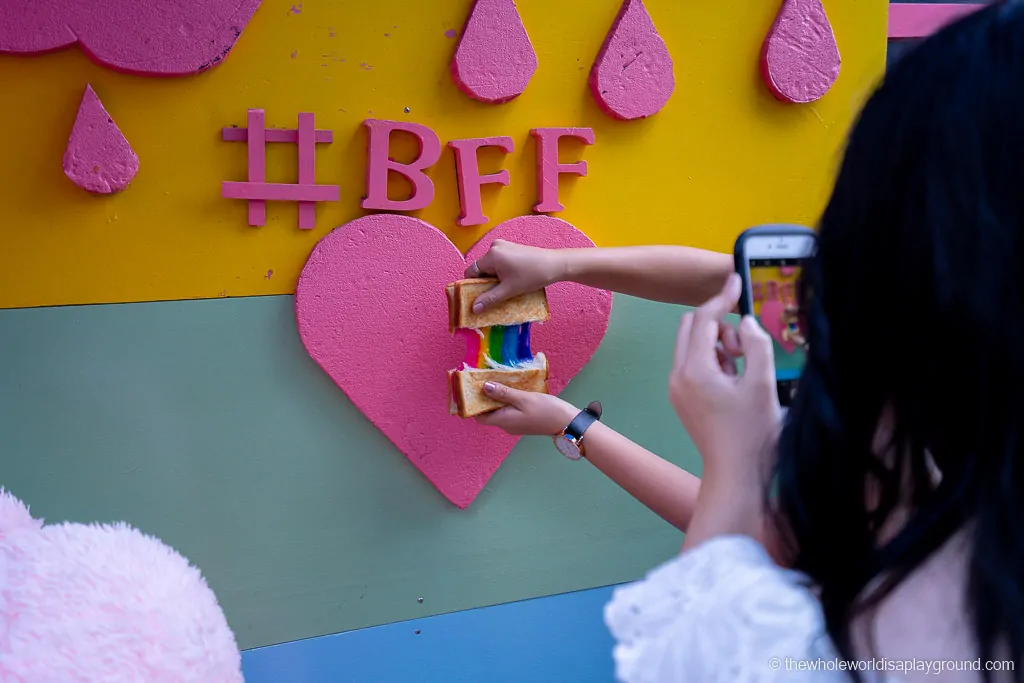
Other great options include the circus-inspired candy floss at Totti Candy .
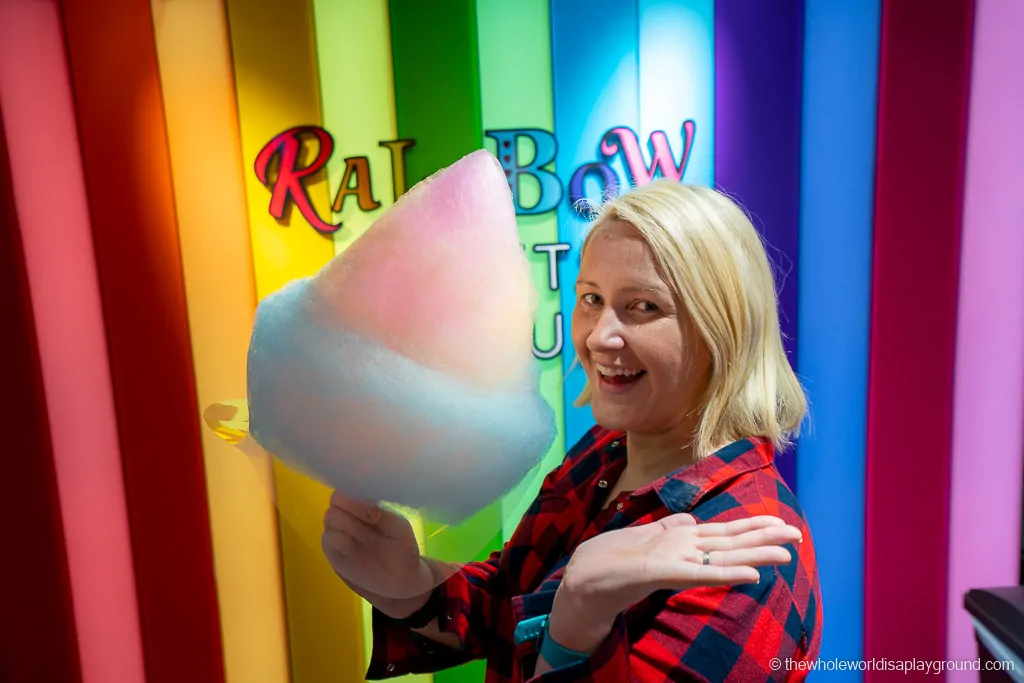
If the wait time is short, indulge at the donut and croissant delight known as a cronut at the Dominque Ansel Bakery . We also loved the amazing gyoza at Harajuku Gyoza-ro, together with the amazing lobster at Luke’s Lobster Roll .
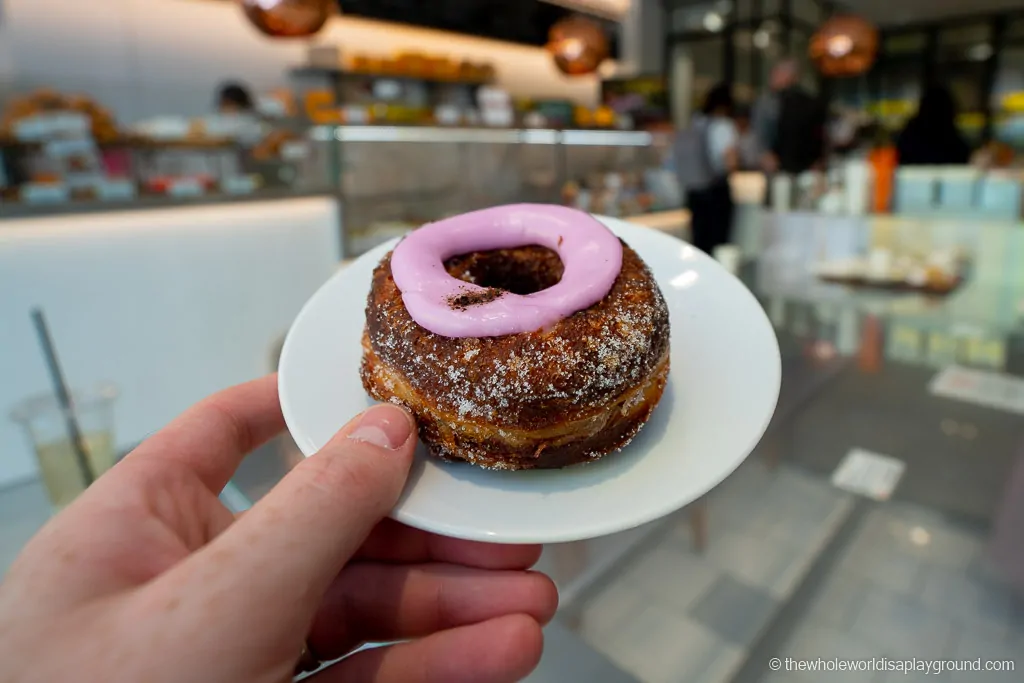
There are also endless cute ice cream offerings in Harajuku and our favorites were Cosiof, Milk and Roll Ice Cream Factory. The shaved ice desserts at Ice Monster are another awesome treat.
Tokyo itinerary tip: we spent a lot of time eating in the neighbourhood and these were our favourite!
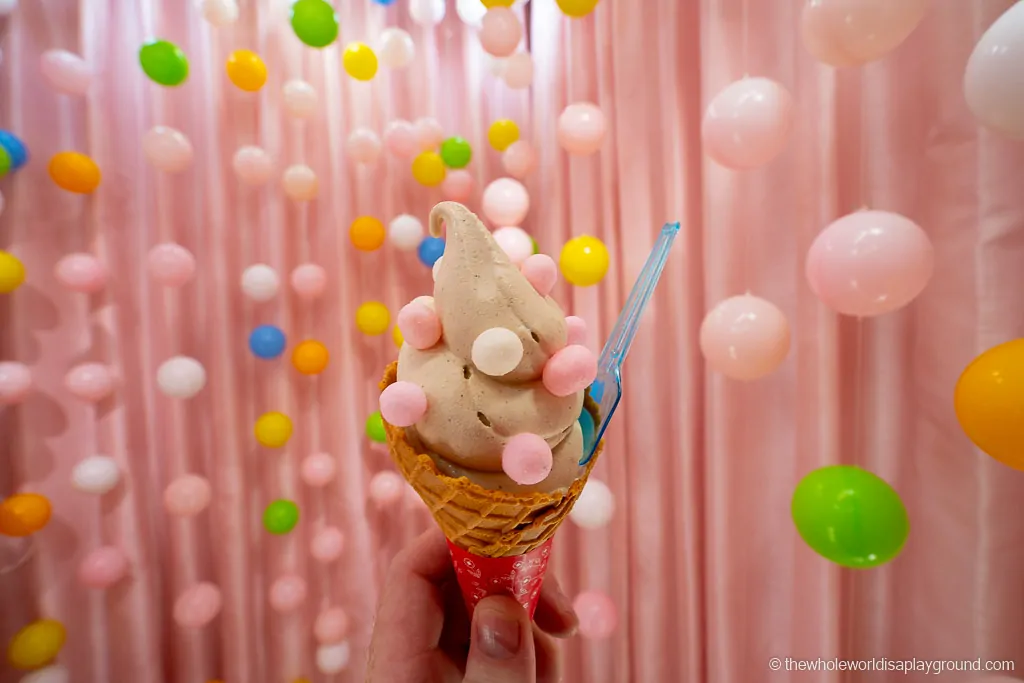
Explore Harajuku
Take a stroll down Takeshita Street . Harjauku’s main thoroughfare is lined with shops selling everything from crepes to vintage clothes to candy floss. It’s often possible to spot the incredible kawaii inspired fashion looks that Harajuku is famous for.
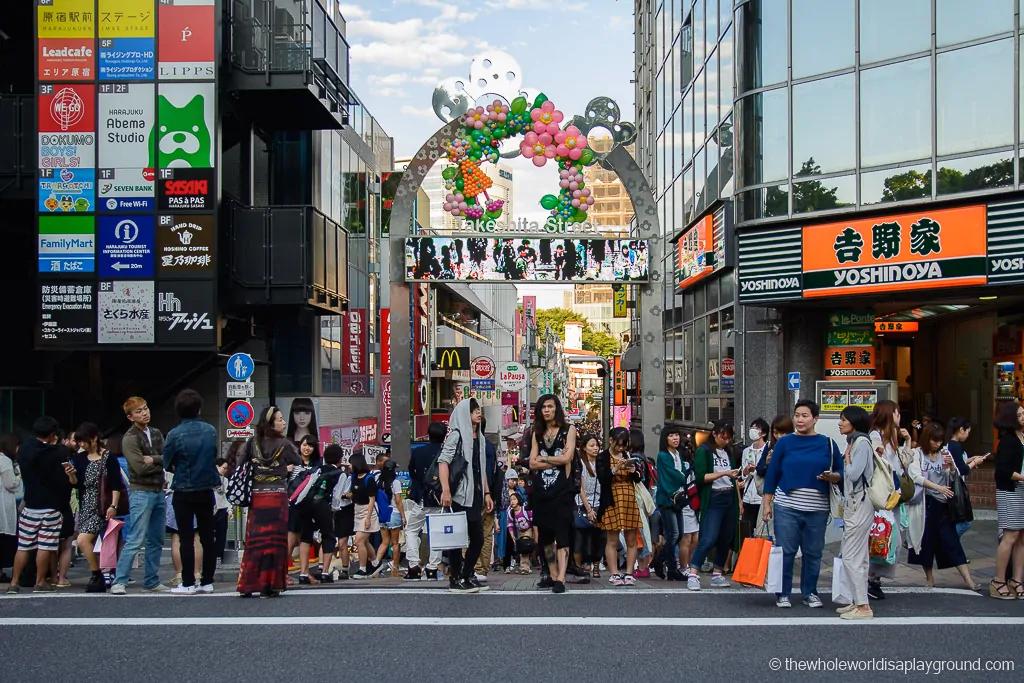
Capture some fun memories with a quick photo booth session at a purikura store on Takeshita Street . The themed photo booths and crazy edits are a great souvenir of Japan.
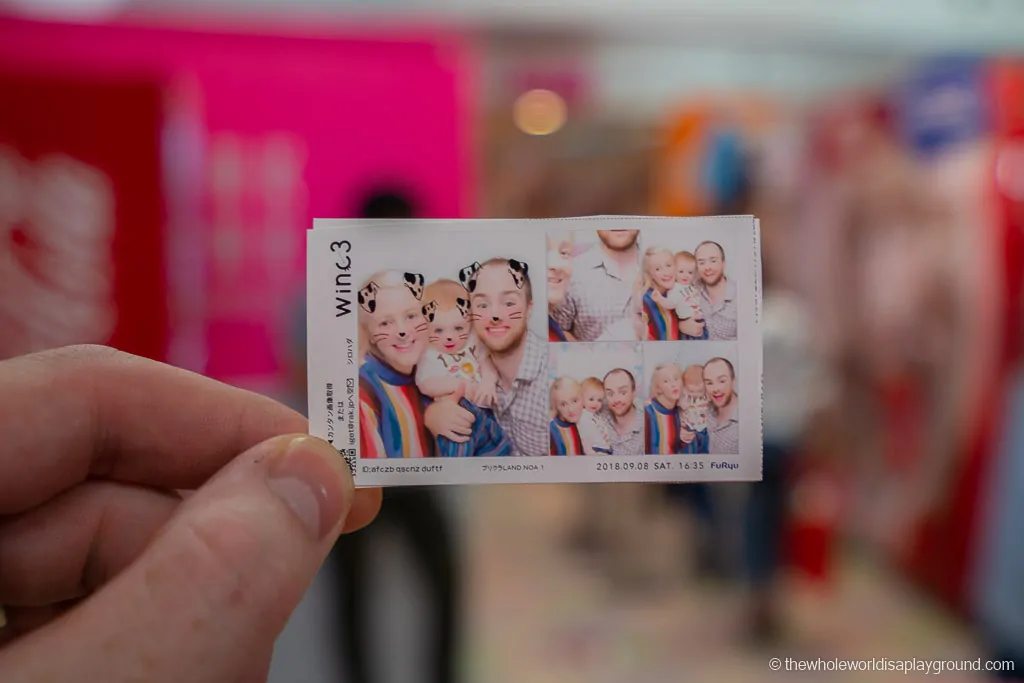
Another Takeshita Street stop, Daiso is a Japanese discount store stocking a fun range of products for 100 yen or less.
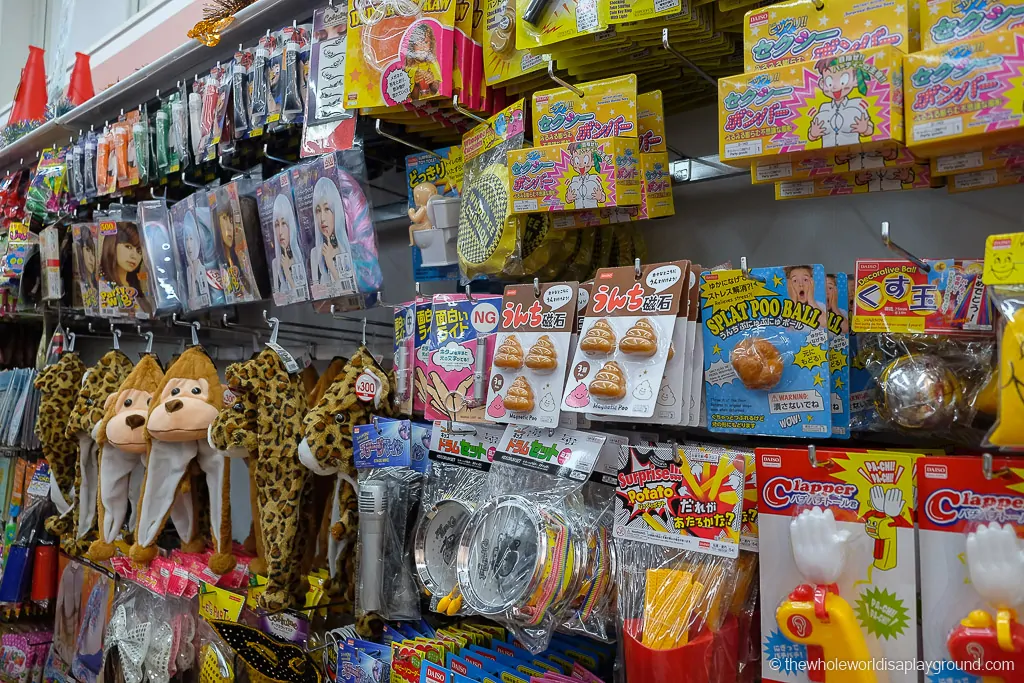
If you wish to indulge in some retail therapy, Omotesando is a fantastic mix of luxury stores, vintage stores and quirky boutiques. While there, pop into the Tokyu Plaza Omotesando Harajuku shopping center. The entrance is an intriguing kaleidoscope of mirrors where you can check out your reflection from every angle imaginable!
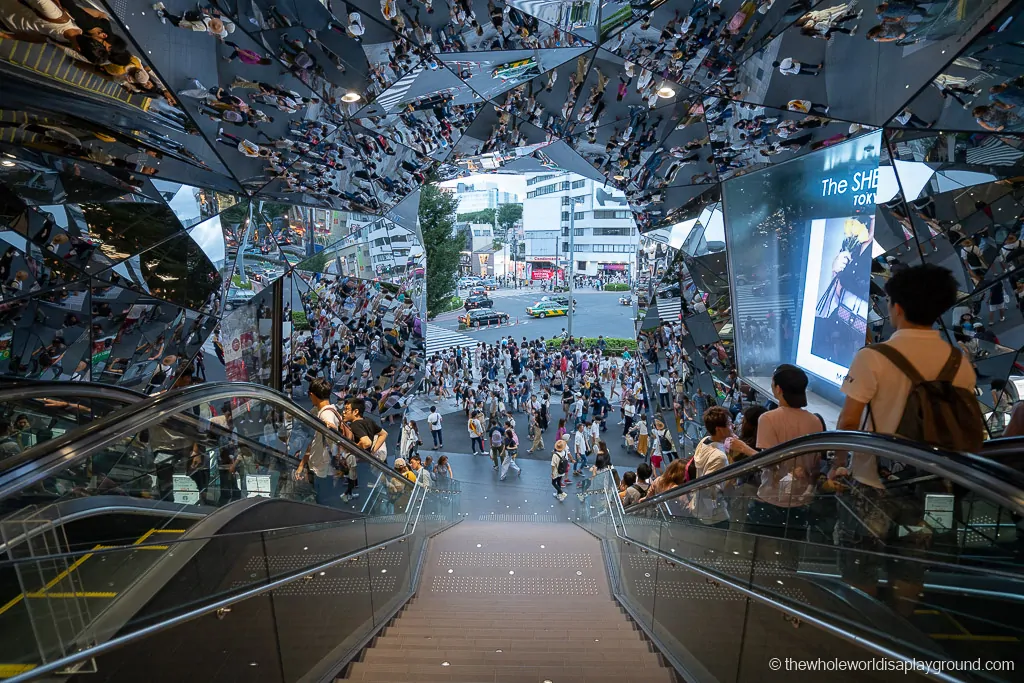
Dinner at Monster Café
For a unique Tokyo experience, we loved the psychedelic decor and cuteness overload at the Kawaii Monster Café. With its giant cake themed merry go round, incredible staff outfits and the colourful food, the Kawaii Monster Café is one of our favourite things to do in Harajuku.
Advance tickets to Monster Cafe are only sold via Voyagin , their official partner, or, if available, walk-in tickets can be purchased on arrival. You can book your package (entrance only, food and drink or themed and premium packages) and time slot via and have tickets sent via email. We used them and it was super easy and reliable – click here to book now!
Click here for Monster Cafe tickets
Tokyo itinerary tip: there are day and evening shows at Monster Café. The burlesque and drag evenings are adults only.
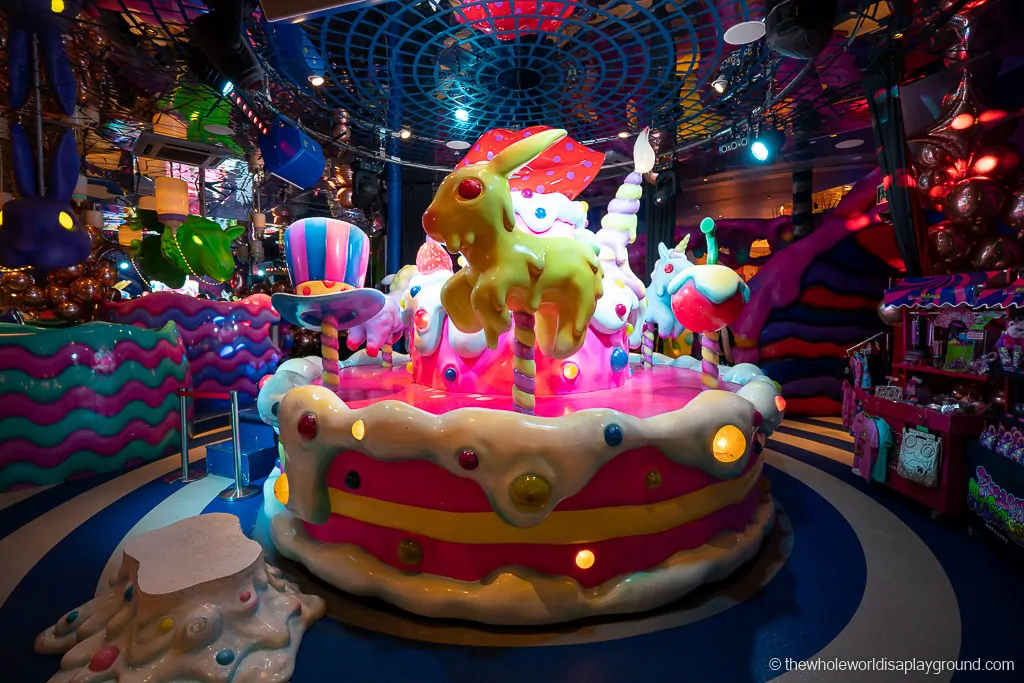
Day 3: Asakusa, Ueno Park, Akihabara and Tokyo Tower
Day 3 is a busy day but takes in the traditional Asakusa and the Senso-ji Temple, the green spaces of Ueno Park, the instantly recognizable Tokyo Tower and the bright lights of Akihabara. If you love ramen, there are two great inexpensive Michelin Star to choose between in today’s itinerary.
The ancient Senso-Ji Temple is the oldest Buddhist temple in Tokyo and draws millions of tourists to Asakusa. Pass through the Kaminarimon Gate, a symbol of the city, explore the colourful temple and its five story pagoda and have your fortune told in the temple.
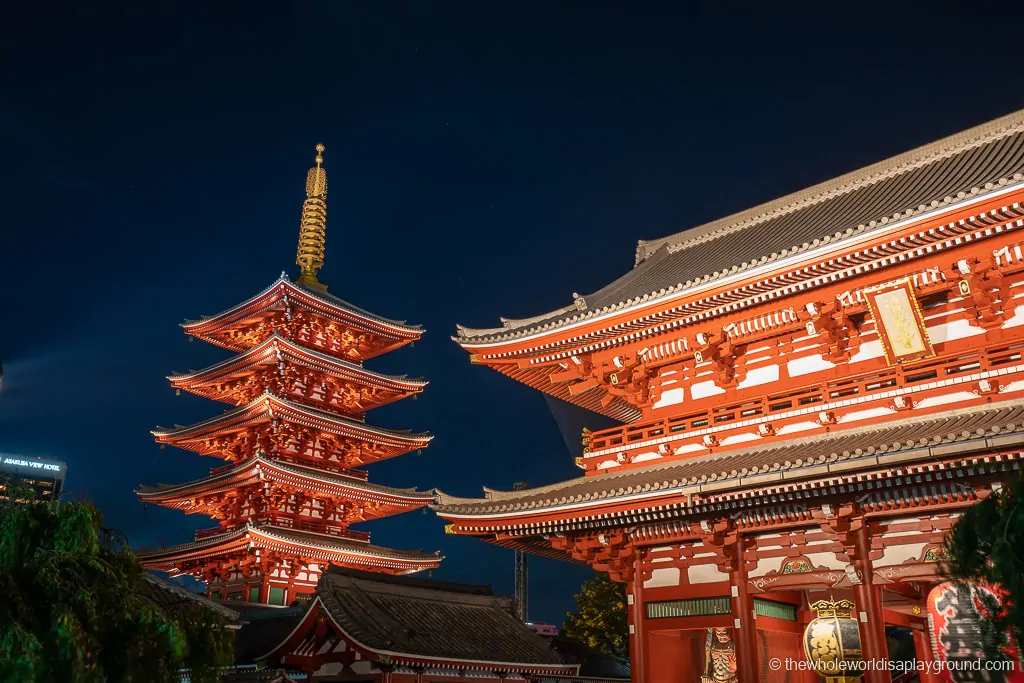
Walk through the historical Nakamise shopping street , in the temple grounds. The wares include souvenirs, snacks, arts and crafts, folding fans and plastic foods replicas!
Tokyo itinerary tip: exploring Asakusa by rickshaw is an awesome way to travel around the iconic sights of the neighborhood while experiencing a rickshaw ride – click here to book a Rickshaw tour!
Click here for to book a Rickshaw tour
Japan’s tallest structure, the Tokyo Skytree is within walking distance of Asakusa . The Skytree is a television broadcasting tower and houses a shopping complex, an aquarium and two observation decks – click here for tickets!
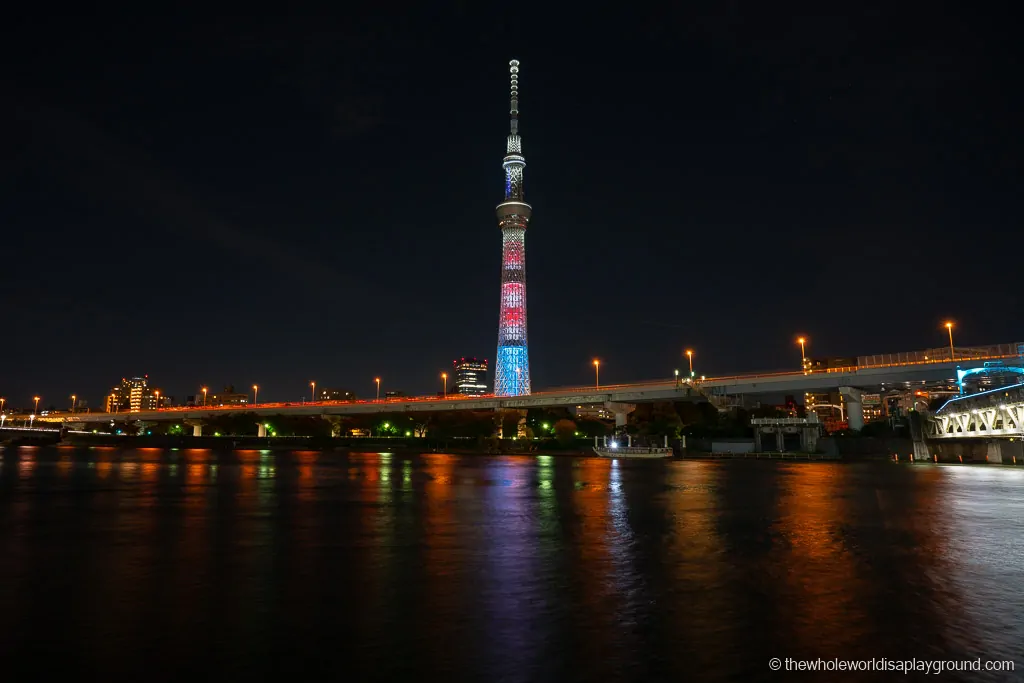
If you’re craving open space, make a stop at Ueno Park It’s Japan’s first public park and house temples, museums and a zoo.
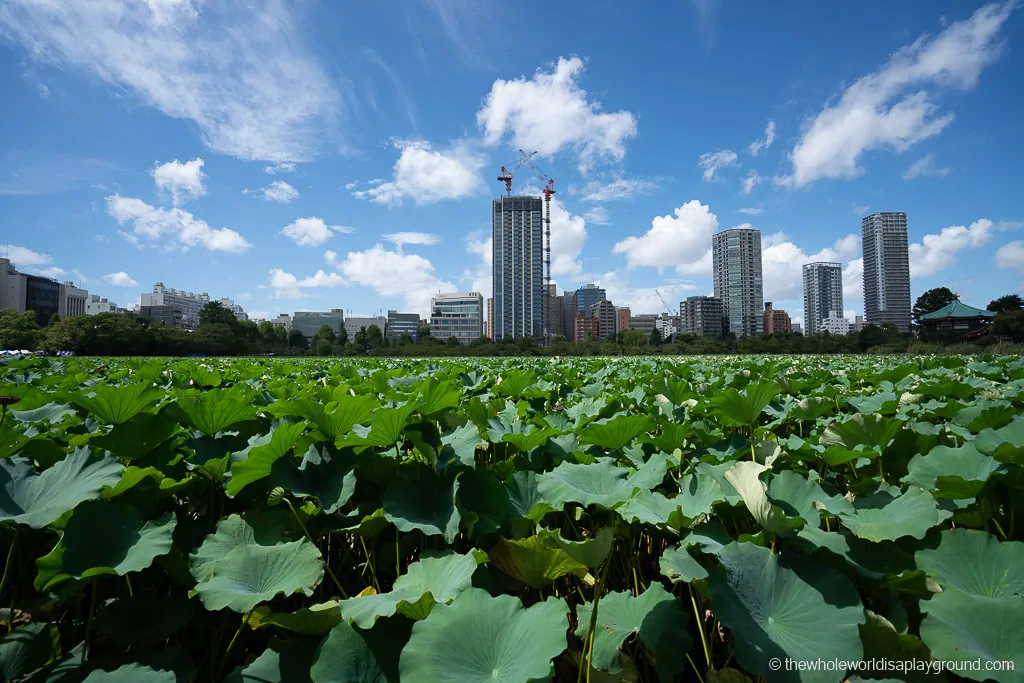
With its stairway of red torii gates, Tokyo’s Nezu Shrine is reminiscent of Kyoto’s iconic Fushimi Inari albeit on a smaller scale. It’s rarely crowded and is such a tranquil place to visi t.
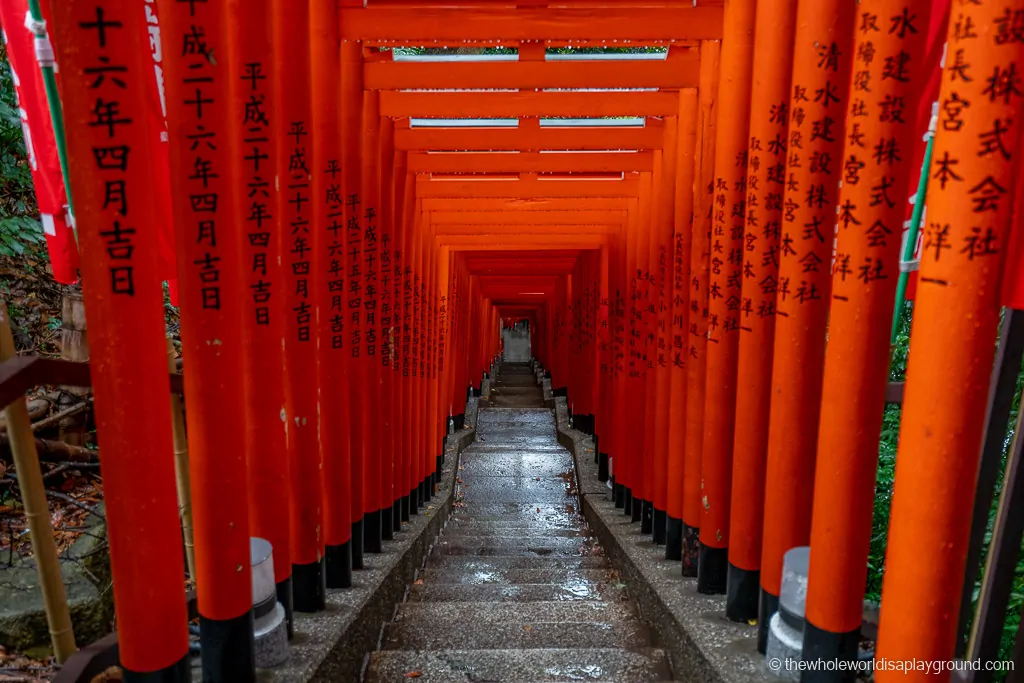
Michelin Star Ramen
Tokyo boast 3 ramen restaurants which have been awarded a Michelin Star and today’s itinerary is a great opportunity to indulge in some Michelin Star dining at a really reasonable price.
There are two Michelin Star ramen restaurants close to Nezu Shrine, Tsuta and Nakiryu, and we’ve visited and loved both.
- Tsuta requires an early morning visit to pick up a ticket and then return at your allocated time to eat.
- Nakiryu operates on a queuing system where you queue and then dine.
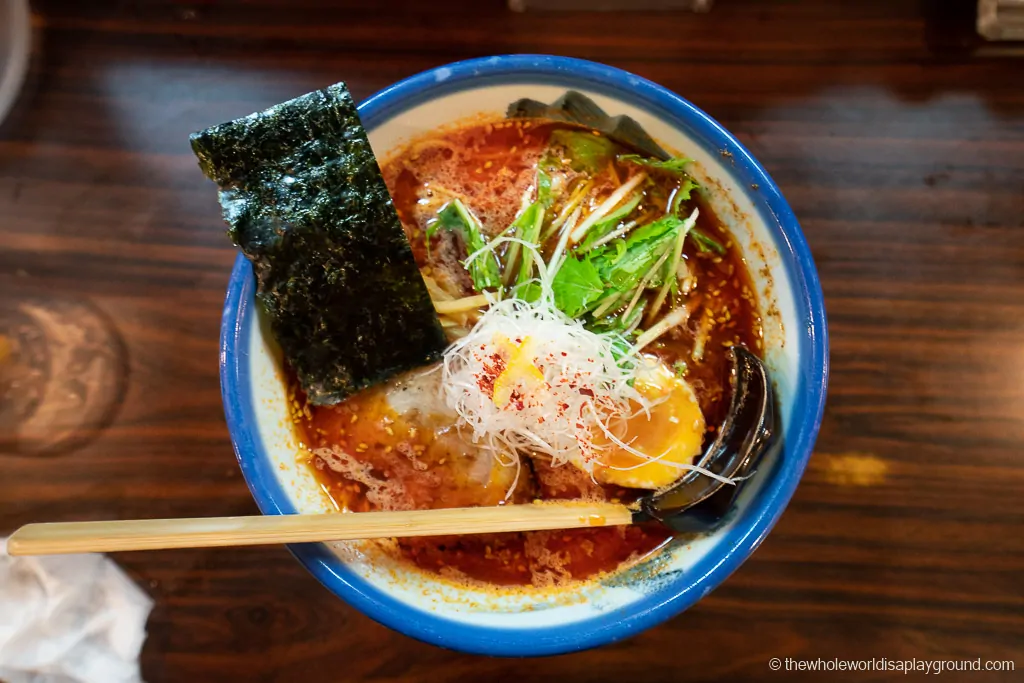
Spend the evening the neon lit streets of Akihabara , Tokyo’s Electric Town. Akihabara is crammed full of shops and stalls selling every electronic device and accessory imaginable! BIC Camera is one of the most popular electronic stores in Akihabara – make sure to order a free discount coupon for the store on Klook – order your free discount coupon for BIC Camera here
Akihabara is also the center of anime, the animation culture and Otaku, the hardcore geek movement which are both hugely popular in Japan. It is also home to many of Tokyo’s famous maid cafes. Manga cafes, which offer a mix of comics and internet access, are also popular.
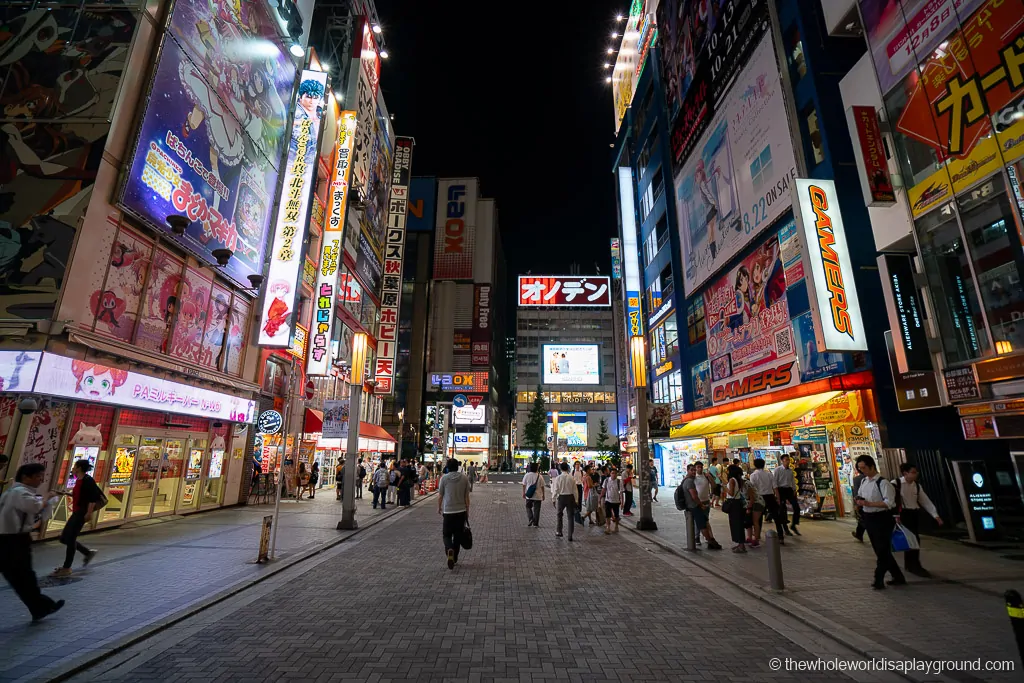
Go Kart through the streets of Akihabara
One of the most fun and unique things to do in Tokyo is driving a go kart through the neon lit streets of Akihabara . We opted for a two hour tour which took in Akihabara, Ueno Park, Asakusa and the Tokyo Sky Tree. Zipping around the Tokyo streets in a go kart while dressed in bright cosplay costumes is unforgettable experience – check prices here!
Click here for to book Akihabara go-karting
Tokyo itinerary tip: you must present an International Driving Permit to take part in the Akihabara Go Karting activity . An International Driving Permit is just a standard translation of your countries driving licence. It’s quick and easy to get an International Driving Permit but you must obtain it before you travel.
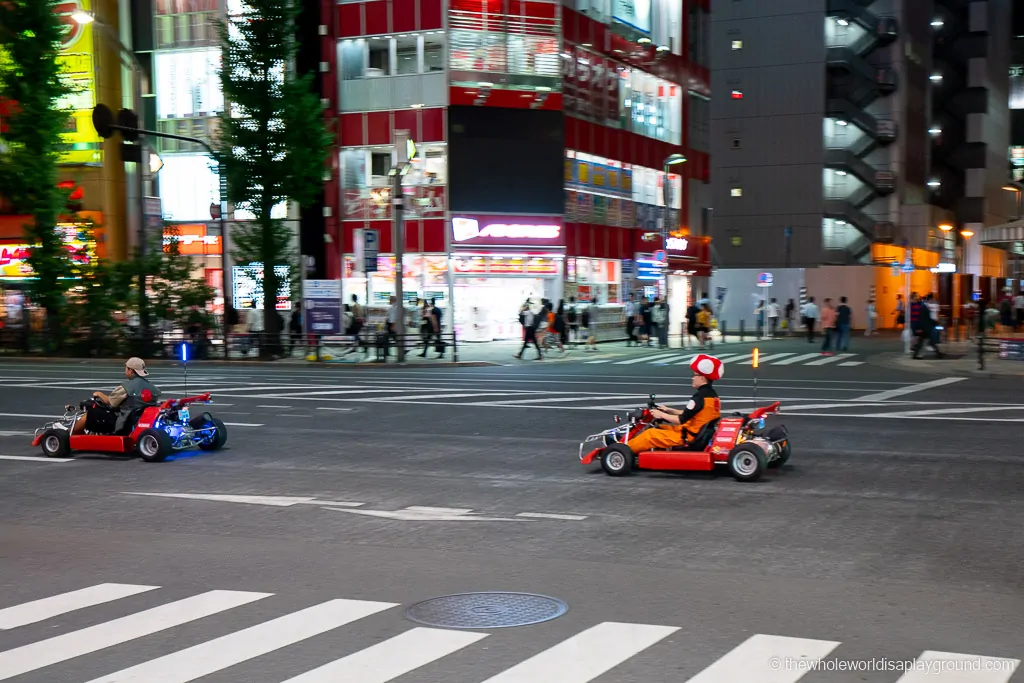
Finish up the day with a trip to Tokyo Tower and the nearby Zojoji Temple.
Standing under the shadow of Tokyo Tower, Zojoji Temple is one of the largest and most important Buddhist temples in all of Japan.
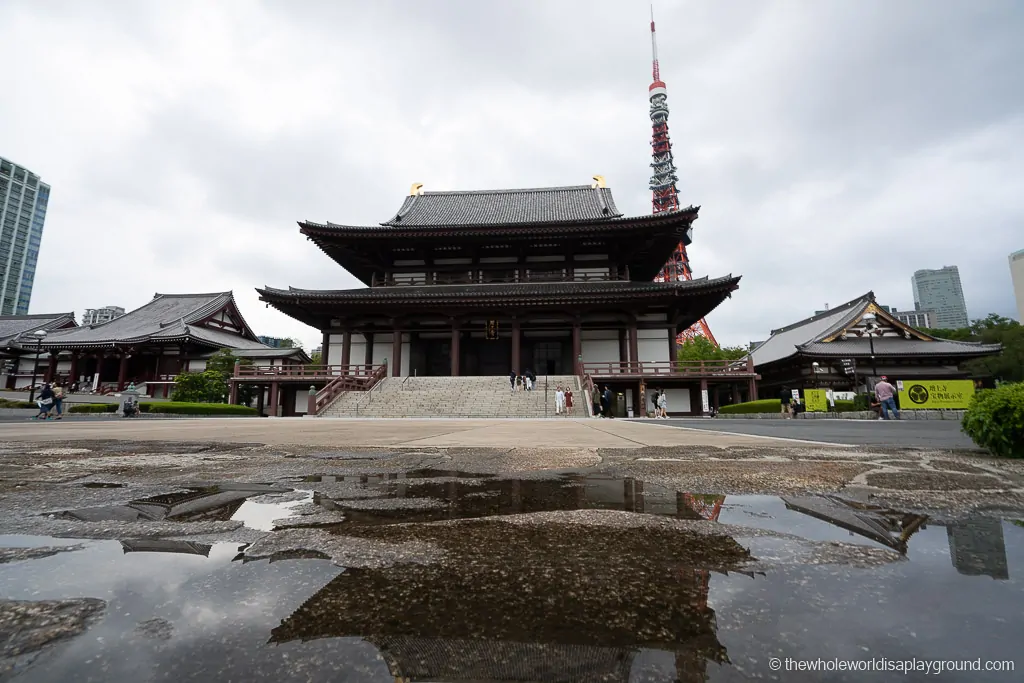
In the temple grounds there is a garden filled with Jizo statues who are care guardian deities of children. They are dedicated to the safe growth of our children and grandchildren together with the babies who passed. It’s a beautiful and moving tribute.
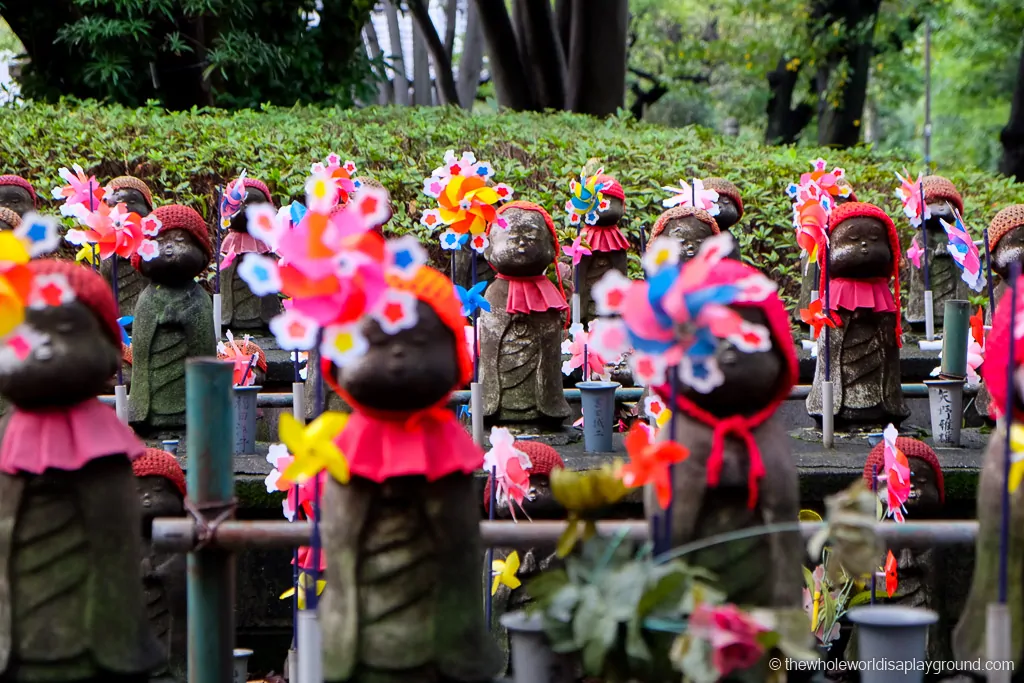
The nearby Eiffel Tower inspired red and white Tokyo Tower is one of the most recognizable landmarks in Tokyo. The communications tower is one of the tallest structures in Japan and houses two observation decks. The Main Deck is 150meters high and the Top Deck is staggering 250meters into the sky! The views are spectacular and it is spectacular to see Tokyo at night. We visited the top and main decks and both are amazing – check prices here!
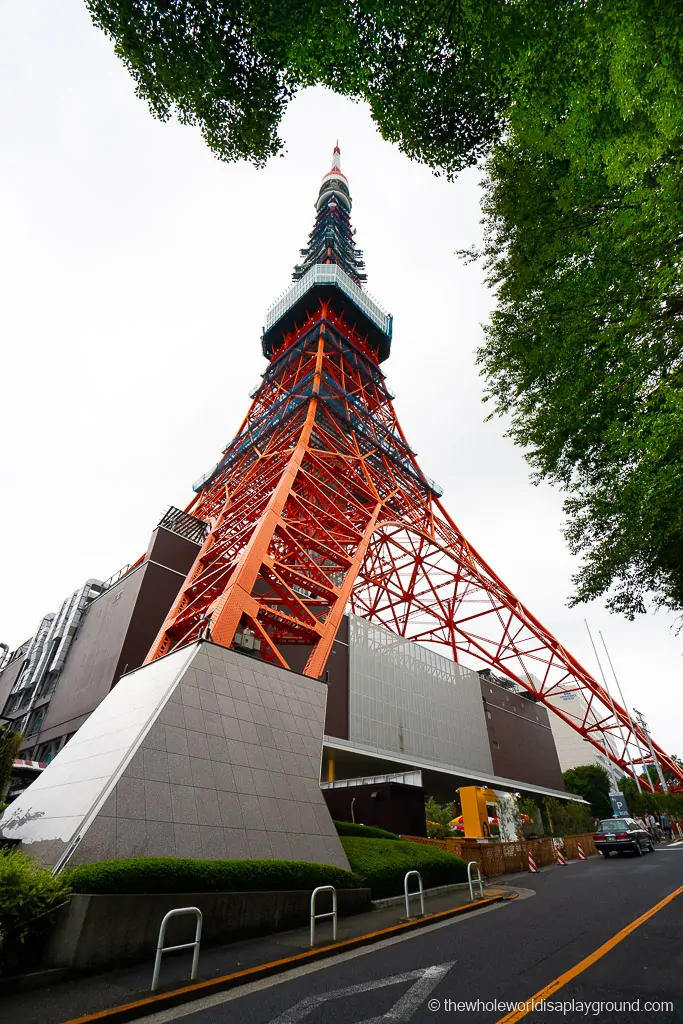
Day 4: Shibuya and Roppongi
The chaotic Shibuya, its iconic crossing and endless food, drink and entertainment options while the Roppongi district is Tokyo’s expat hub and is popular for nightlife, entertainment and art together with its awesome observation deck.
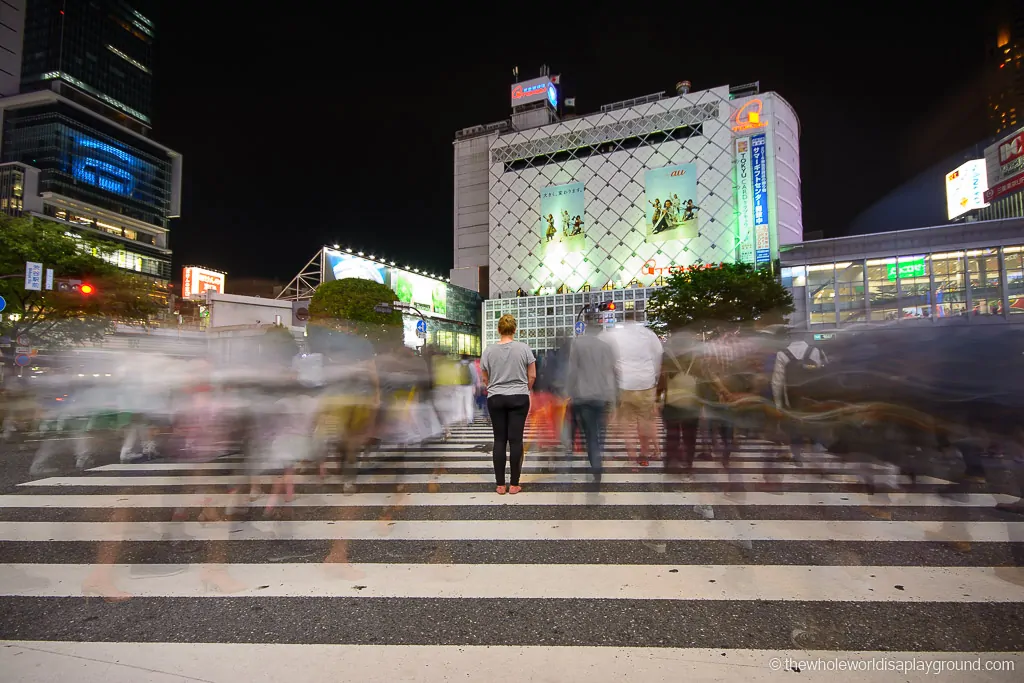
Shibuya is home to the neon lights and crowded streets that Tokyo is famous. As you leave Shibuya Station, stop to pay tribute to Hachikō , a loyal dog who waited at the train station for 9 years for his owner, who had passed away at work, to return. It’s one of the most beautiful stories we’ve come across on our travels and Hachikō is a Japanese treasure.
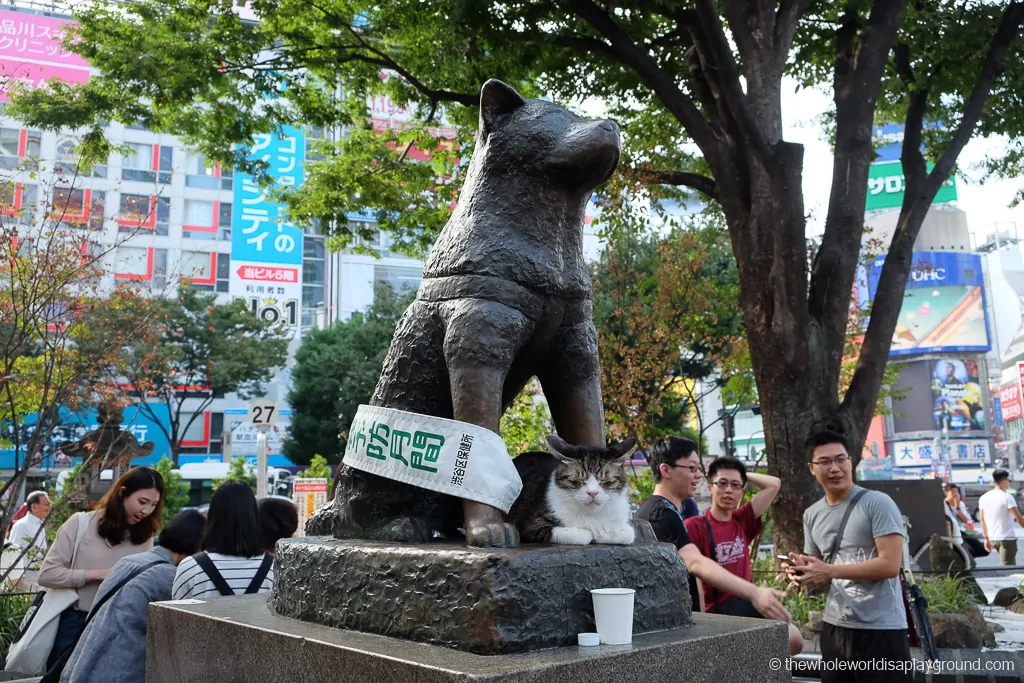
The iconic Shibuya Crossing is located a few steps away. 3,000 people cross the intersection at peak times and the junction is an incredible maze of pedestrian crossings.
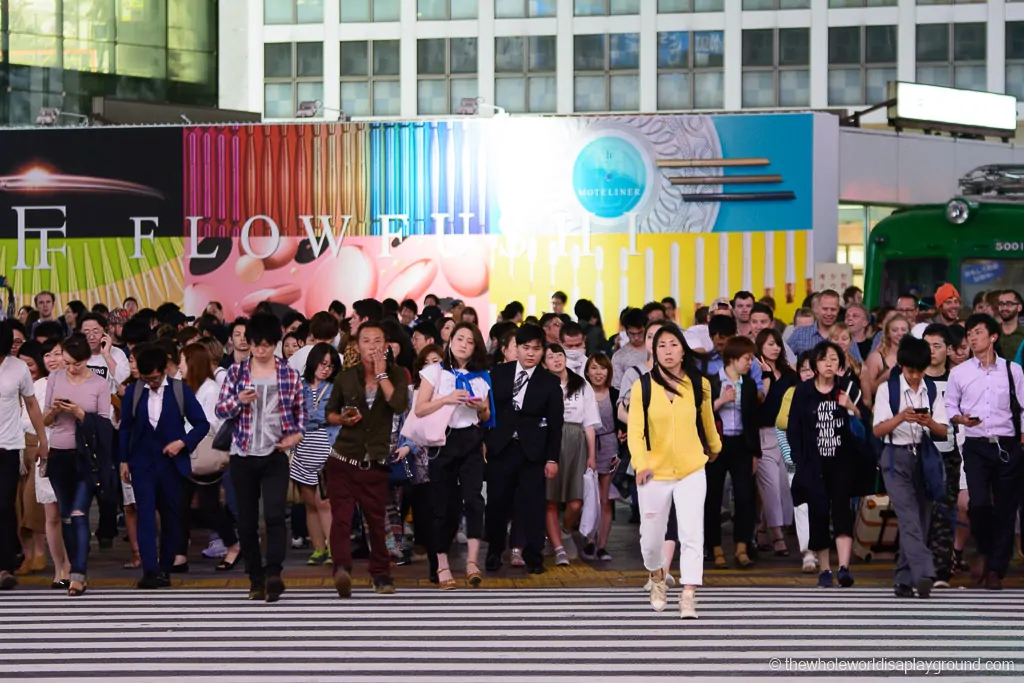
As well as zigzagging across the intersection it’s amazing to watch the crowds from above. A window seat at the Starbucks Shibuya Tsutaya is our favourite place for a birds eye view of the action.
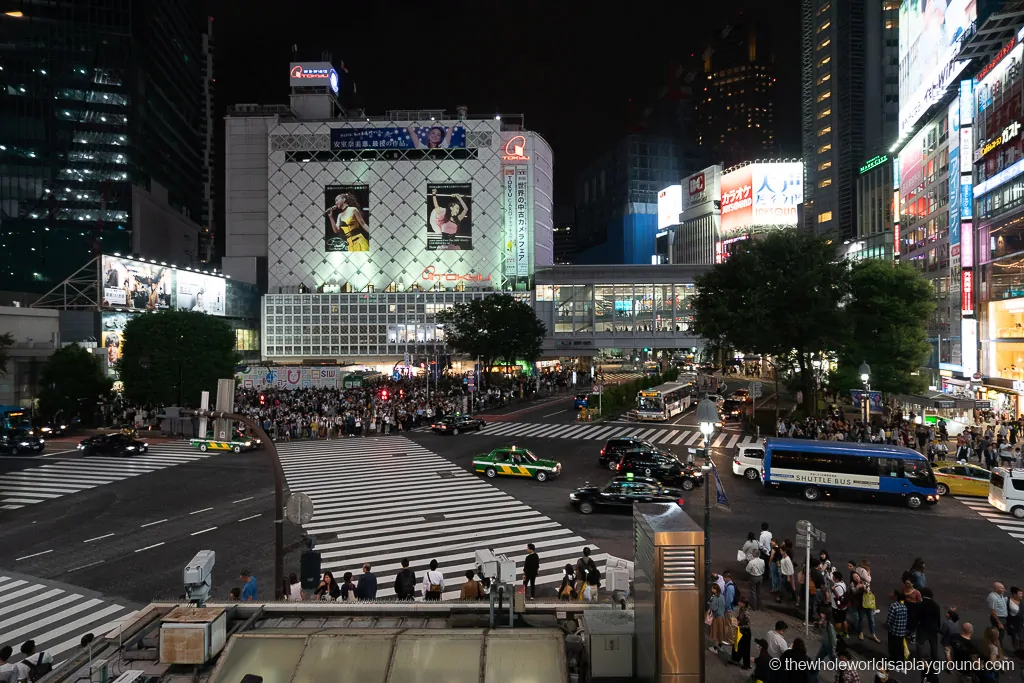
Bring some of the quirky and bizarre into your afternoon with a visit to Maidreamin Maid Café. Maids, dressed in frilly maid costumes, sing, dance and draw quirky characters in the food and drinks. Chances are, like us, you’ll leave just as baffled as when you arrived! – check prices now!
Click here for Maid Cafe tickets
Shibuya is renowned for shopping with everything from the biggest high street names to small, unassuming stores. We love exploring the unique Tokyo shopping offerings – Tokyo Hands, with its huge collection of stock ranging from useful to quirky to cute, is our favourite!
Early dinner at Zauo
Zauo Fish Restaurant is a quirky dinner option in Shibuya. Guests sit in a giant boat and fish for sea bram, flounders and lobster in the surrounding moat. A drum beats when a fish is caught and it is then served as sushi, tempura, fried or in soup. It’s so much fun! – click here to book now!
Tokyo itinerary tip: Zauo is super touristy and really popular. Make sure to reserve in advance and request a boat seat so you can fish directly from your table!
After dinner, stop by Nonbei Yokocho . Similar to Shinjuku’s Piss Alley, Shibuya’s Drunkards’ Alley is a tiny lane of bars popular with Japanese salarymen. Grab a seat, order a drink and enjoy the dark and moody atmosphere and the lingering smells of beer and yakitori smoke that fill the air.
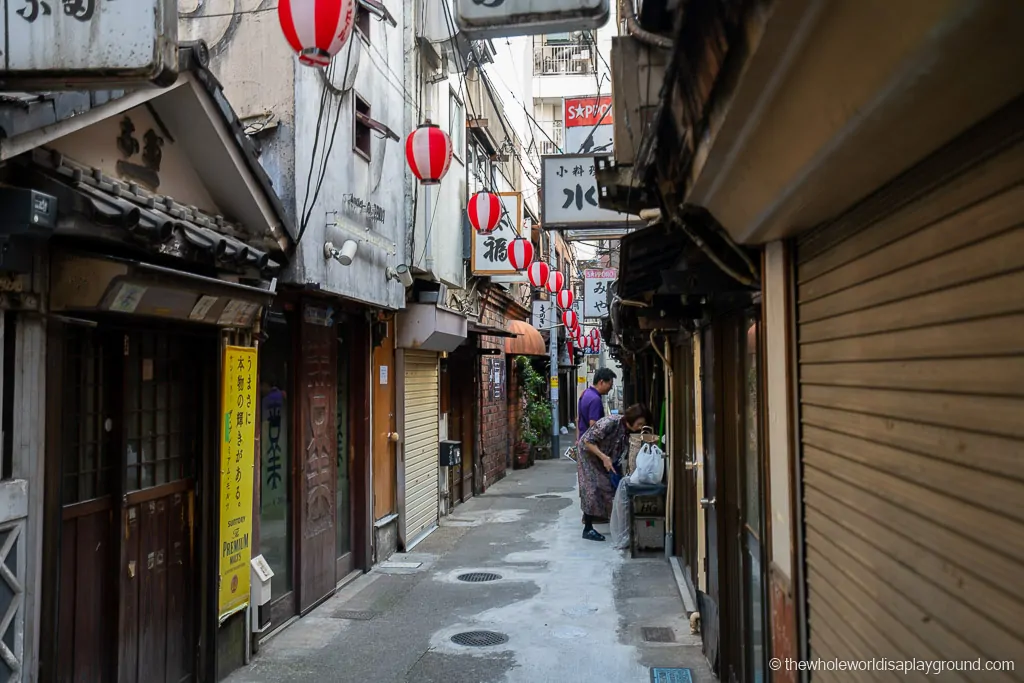
Finish up the day’s sightseeing with a short jaunt to Roppongi to check out the views at the Roppongi Hills Tokyo City View Observatory . The observation deck is located in the Mori Tower, one of the tallest buildings in Tokyo. The views are incredible from both the 52 nd floor indoor observation deck and the Sky Deck, an outdoor observation deck 270 metres high – click here for tickets!
Click here for Roppongi Hills Observatory Tickets
Tokyo itinerary tip: the late opening hours make Roppongi Hills a great choice for late evening sightseeing. The indoor observation deck closes at 11pm (last entry 30 minutes prior) and at 1am on Friday and Saturday (last entry 60 minutes prior). The outdoor Sky Deck closes at 8pm daily (last admission 30 minutes prior) and during private events and adverse weather.
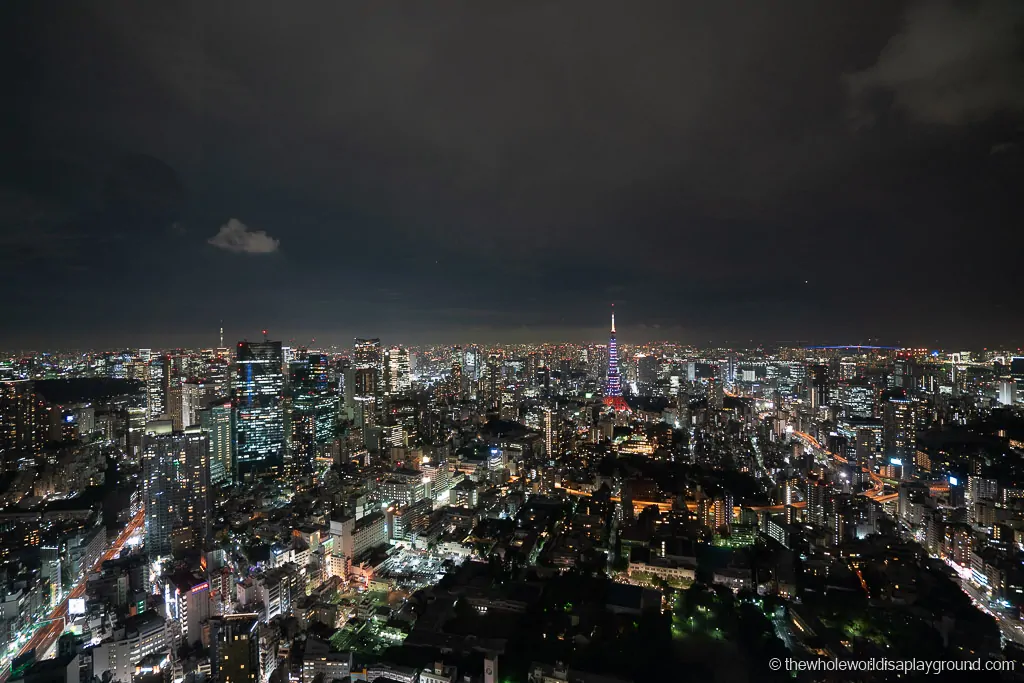
Day 5: Toyosu and Tokyo Station
Toyosu shot to fame as the new location of the Tokyo fish market. It is also home to Kidzania, one of the best things to do in Tokyo with kids . You’re likely to pass through Tokyo Station during your travels and Ramen Street, the Marunouchi building and the Imperial Palace are all worth a visit.
Toyosu Fish market
The new Toyosu Fish market is the home of the recently migrated Tsukiji Fish Market and famous tuna auction.
Tokyo itinerary tip: after multiple delays the Tsukiji Fish Market relocated to Toyosu in late 2018. We were lucky enough to visit and eat at Tsukiji many times before the move and even attended the tuna auction there.
Tuna auction
Tokyo hosts a world famous tuna auction. For a unique experience try and secure free tickets for the tuna auction observation deck. The auction takes place from 5:45am most weekdays and Saturday’s throughout the year.
Auction tickets allow access to the closest viewing area and only 120 people are granted access each day. Make sure to apply during the month before your time in Tokyo and you will be notified by email if you are successful – the Toysu lottery website is here
Tokyo itinerary tip: If you are unsuccessful in the lottery, it’s still possible to view the tuna auctions from the windows of the building. However, you won’t be able to hear the auction.
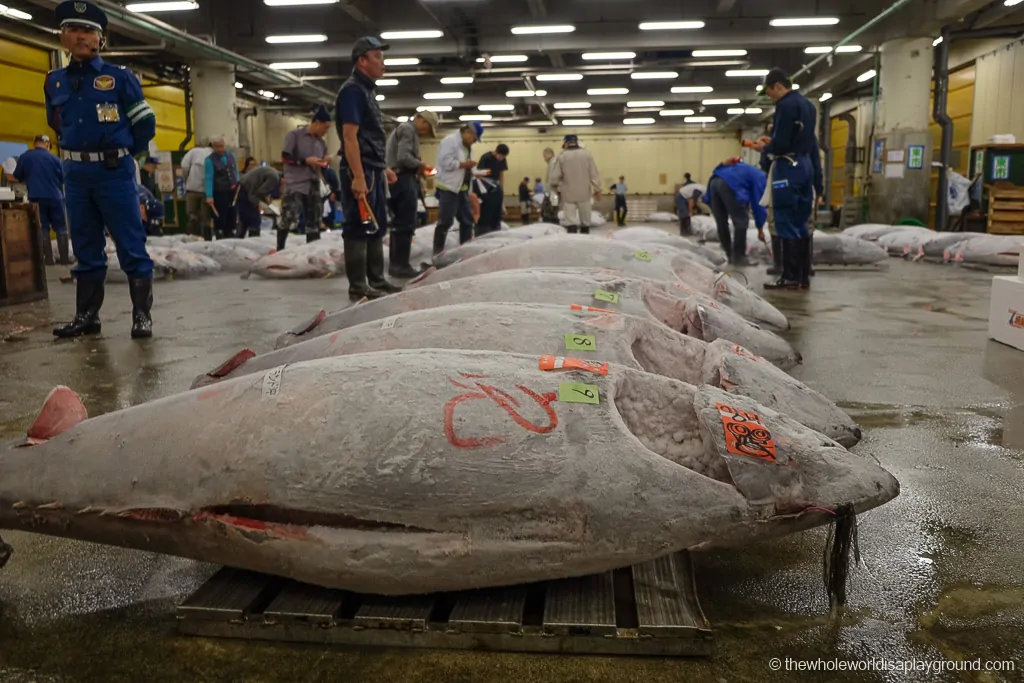
The Fish Market
There’s a Wholesale Fish Market which is closed to the public an an Intermediate Fish Market which is home to the renowned Sushi Dai – we ate in the original Sushi Dai in Tsukiji and had an amazing experience. The Fruit and Vegetable Market building is where you’ll find Daiwa Sushi, another incredible option. There are some great tours which take in all the best food options at both Toysu and Tsukiji – check prices here!
It’s a short walk from the fish market to the TeamLab Planets digital art exhibition. Delivered by the same team as TeamLab Borderless, this is another spectacular display of digital art.
Again, it’s best to book tickets in advance and arrive early for the best experience – check ticket prices here!
Tokyo itinerary tip: if you are travelling with kids, Kidzania is a great option. It is a mini-city where kids can try out adult jobs and get paid for their work! Check out our Tokyo with kids itinerary for more family friendly suggestions.
Tokyo Station
Stop by the aptly named Ramen Street deep inside the station. It houses a collection of rmouth watering ramen restaurants that will satisfy any ramen cravings! Outside of the station, check out the architecture of the red brick Marunouchi Building. It was designed by Kingo Tatsuno, a key figure in modern architecture in Japan.
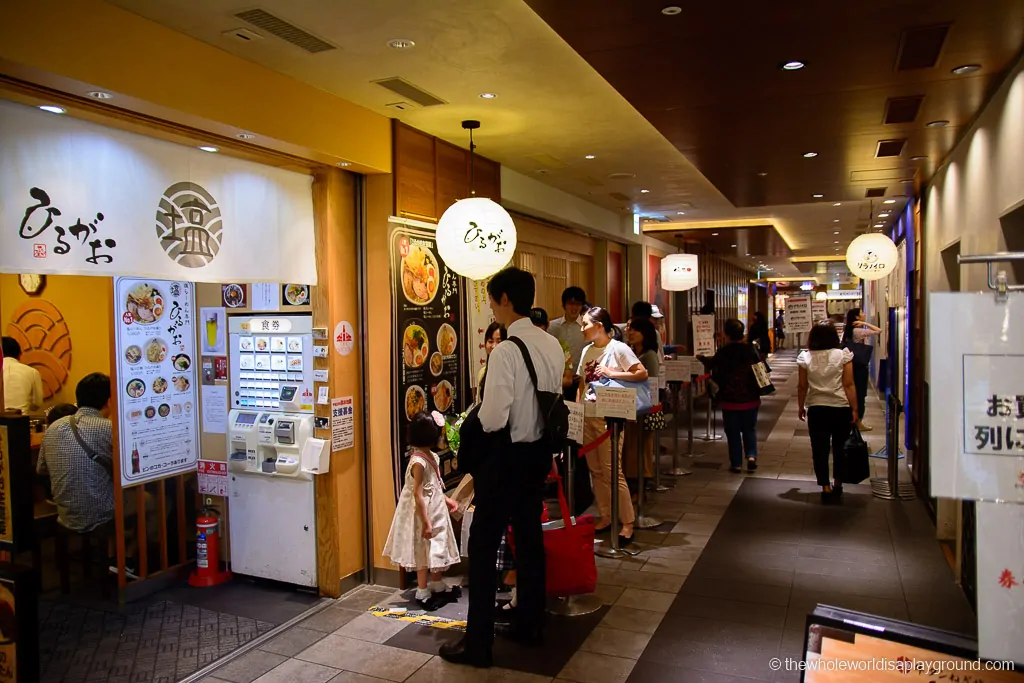
Make the short walk to the historic Imperial Palace which has been used by the Imperial family since 1868.
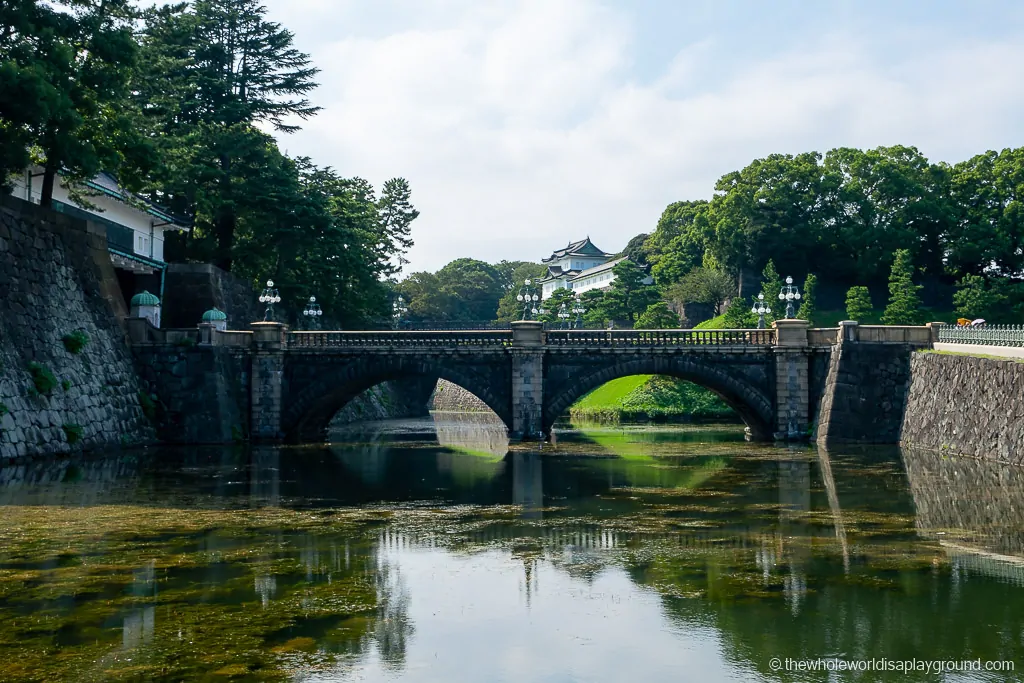
How to get there: take the Yurakucho Line from Toyosu Station to Yurakucho Station. From there, it’s a 5 minute walk to Tokyo Station.
Day 6: Hakone
Hakone is a popular day trip from Tokyo and is easily accessed by train from Shinjuku. Famous for its hot springs, outstanding natural beauty and stunning Mount Fuji backdrop, there are lots of fun and adventurous things to do in Hakone.
How to get there: an Express train operates between Shinjuku and Hakone-Yumoto. It’s easiest to purchase a Hakone Free Pass. The pass covers the return train journey from Shinjuku together with transport in Hakone. It allows for free travel on the bus, the Hakone Ropeway, the Hakone Tozan train and the pirate ship on Lake Ashi. There are also discounts on entry to many Hakone attractions – purchase a Hakone Free Pass here!
Click here to purchase a Hakone Free Pass
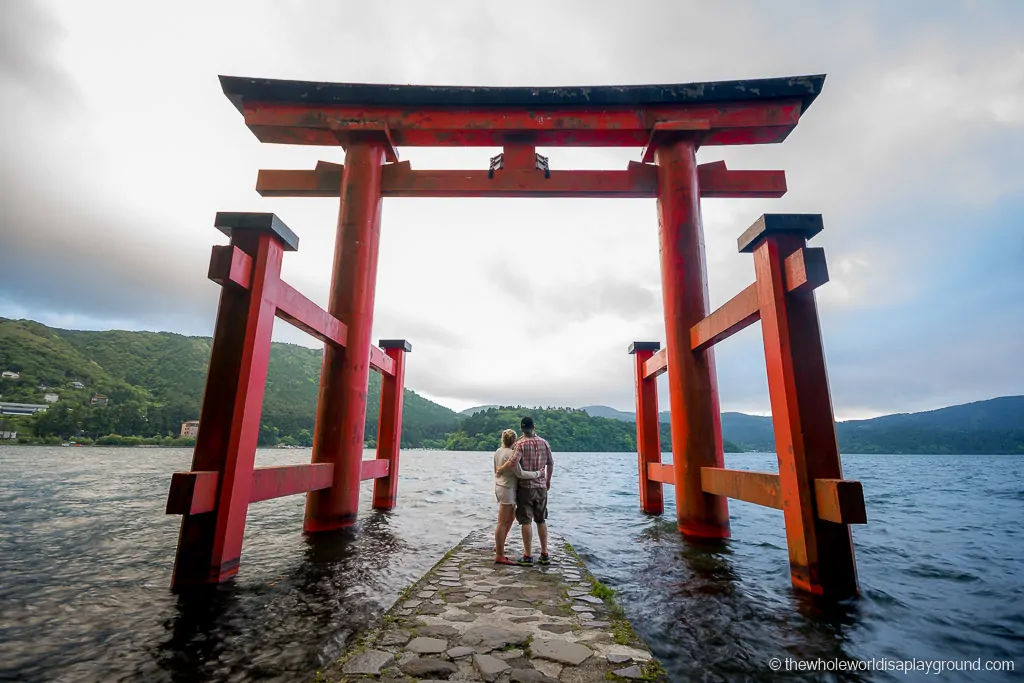
Ride the Hakone Ropeway over the volcanic Owakudani Valley and gaze upon the majestic Mount Fuji from the observation deck. Make sure to sample the regions famous black eggs which are touted as adding 7 years to the life of those who consume.
Visit the Hakone Open Air Museum with works by Henry Moore and Joan Miro as well as a permanent exhibition hall with over 300 Picasso pieces. There’s also Hakone Kowakien Yunessun , a novelty onsen park with a wine bath, a green tea bath, a sake bath and a coffee bath – check prices here!
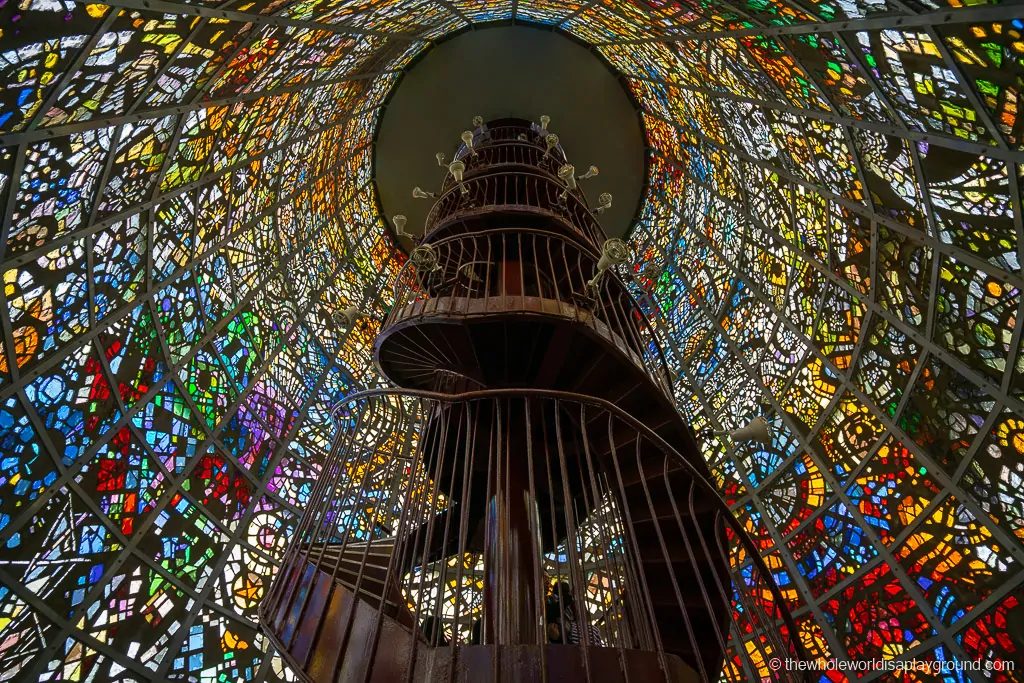
Day 7: Tokyo Disneyland/ Tokyo DisneySea
Tokyo’s Disney Resort is made up of two theme parks, Tokyo Disneyland and Tokyo DisneySea . You will need to allow two days if you wish to visit both.
Tokyo Disneyland
Modelled on Disneyland California and Magic Kingdom in Florida, Tokyo Disneyland is one of the best Disney parks in the world. The most popular rides include Pooh’s Honey Hunt, Space Mountain, Big Thunder Mountain, the Haunted Mansion and Monster’s Inc Ride and Go Seek.
How to get there: At Tokyo Station, switch to JR Keiyo Line or JR Musashino Line and go to Maihama Station. If you have a JR Pass, this journey is covered with your pass.
Tokyo Disneyland attracts big crowds so plan to arrive as early as possible and make the most of your time in the park.
If you’ve visited Disney in the US and want to focus on Tokyo’s unique rides then check out:
- Pooh’s Honey Hunt: the honeypots travel seamlessly through a trackless system making for a unique and surreal experience.
- Monster’s Inc Ride and Go Seek: riders are given a flashlight weapon to search for monsters, scoring points on a sighting. The level of detail is mesmerising.
- Parades: Dreaming up and Dreamlights.
- Space Mountain: the single rider queues are usually a breeze in Tokyo Disneyland. On the day we visited the wait time was less than 15 minutes for a single rider.
Make sure to buy tickets in advance as Tokyo Disneyland can sell out – check prices here!
Click here to buy Tokyo Disneyland tickets
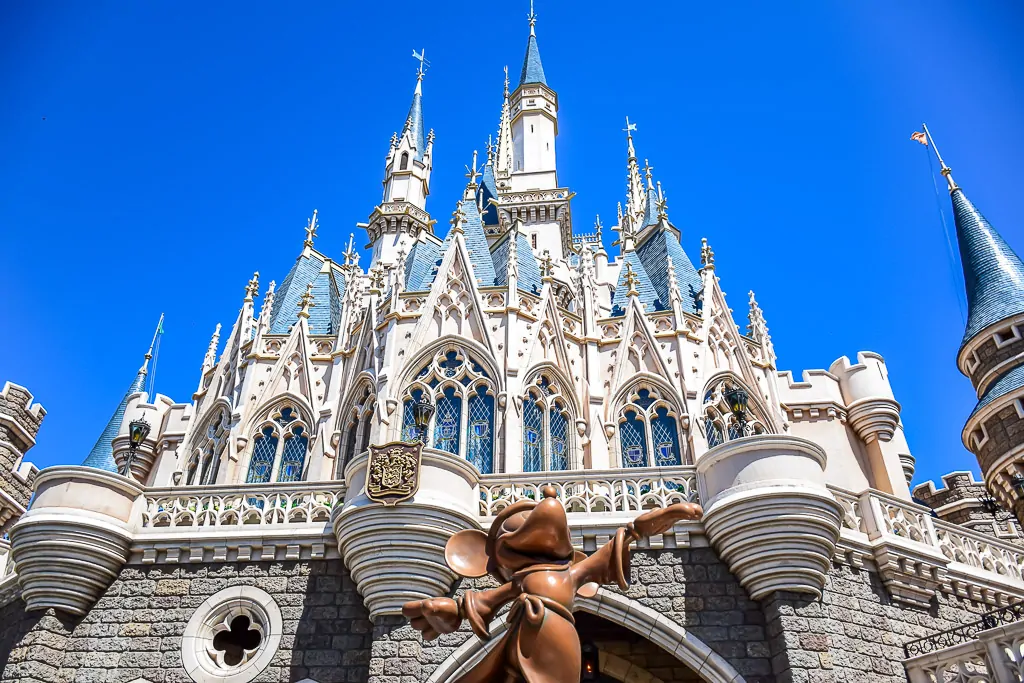
Tokyo DisneySea
Located next to Tokyo Disneyland, Tokyo DisneySea is a unique Disney park based around the tales and legends of the sea. The park is split into 7 ports and the park is famous for the shows that take place at the Mediterranean Harbor.
The best rides include 20,000 Leagues Under the Sea, Sinbad’s Storybook Voyage and Journey to the Center of the Earth. For younger guests, the Mermaid Lagoon has a great selection of kid friendly rides – check prices here!
Click here to buy Tokyo Disneysea tickets
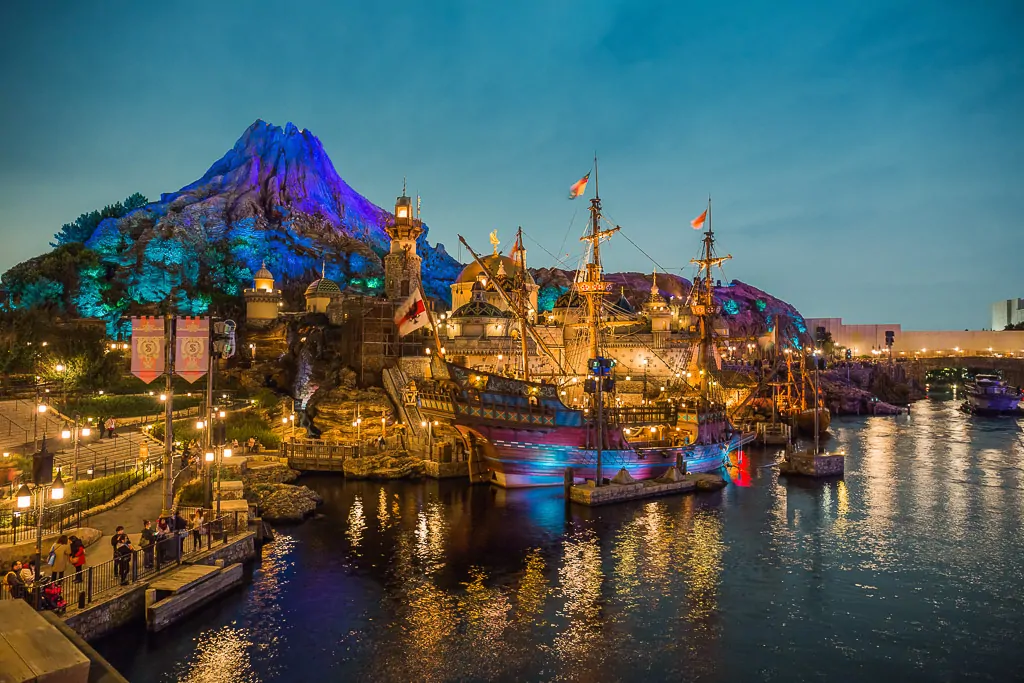
1 thought on “Tokyo Itinerary 7 Days: the Ultimate Guide!”
Great and informative site, love your photos… thank you so much!
Leave a Comment Cancel reply
Save my name, email, and website in this browser for the next time I comment.
Disclaimer: As an Amazon Associate I earn from qualifying purchases.

A Fun 7 Day Tokyo Itinerary: Complete 1 Week in Tokyo Guide
Without a doubt, Tokyo is one of my favourite cities I’ve ever visited. The unique blend of ultra-modern and traditional, the exhilarating experiences and of course, the incredible food are just some of the reasons I keep coming back to Tokyo again and again.
After my recent fifth visit to Tokyo, I can truly attest that there is no shortage of remarkable things to do, see and eat in Tokyo. Packing it all into a Tokyo 1 week itinerary is still a challenge, as each visit I find something new and fun to do every time!
Whether it’s your first time in Tokyo or a return visit, this comprehensive 7 days itinerary in Tokyo offers a perfect blend of iconic sights, lesser-known gems and amazing food experiences to ensure a memorable one week in Tokyo.
Table of Contents
Quick Overview: Itinerary for Tokyo 7 Days
Tokyo is a sprawling metropolis that covers over 2,000 square kilometres. This itinerary has been designed to cover specific sections of the city and groups attractions on each day to reduce travel time and backtracking.
Here’s a summary breakdown of this Tokyo Itinerary:
- Day 1: Harajuku and Shibuya
Day 2: Gotokuji Temple, Shimokitazawa and Shinjuku
Day 3: asakusa & akihabara.
- Day 4: Tsukiji Market, TeamLab Planets & Ginza
- Day 5: Hie Shrine, Imperial Palace, Tokyo Station & Ikebukuro
- Day 6: Disneyland or DisneySea
Day 7: Day Trip to Mount Fuji
Useful resources & tips for first timers.
Before getting into the details of this Tokyo 7 days itinerary, here are a few quick tips and useful things to know for first-timers in Tokyo.
- Cash: Japan is a very cash-reliant society. On my most recent trip in April 2023, we were pleased to see that many more places accept cards (most likely a result of COVID-19 accelerating change for businesses). However, there are still many small bars, restaurants and even shops that might only take cash. We use the 7/11 ATMs to withdraw cash, as there is no international ATM fee and they accept most foreign cards. Plus, they are super accessible as there are 7/11’s everywhere!
- Suica: Make sure to grab a Suica (prepaid transport card) for use on the subways, trains and buses across Tokyo. It saves you so much time not having to purchase paper tickets as you’ll be relying on the subway system a lot! (more of this soon).
Note: Due to a chip shortage, physical cards are no longer being issued. You have two options for alternatives. Firstly, Apple users can easily add a free Suica to Apple iPhones (unfortunately this doesn’t work for foreign Android devices just yet). Here are the instructions for doing this for Apple users. Tourists can still purchase the Welcome Suica card upon arrival at either of Tokyo’s airports. More information on Welcome Suica here . Alternatively, you can purchase an unlimited-use metro card (more information on this below in the Getting Around Tokyo section).
- eSims: I recommend getting phone data while in Japan as you will be relying on Google Maps a LOT! Pocket wifi rental used to be a popular option for getting phone data in Japan. I’ve tried pocket wifi , purchasing a tourist prepaid sim that you collect at the airport and on my most recent trip, an eSim that I set up at home before I even leave. Of the three options, using an eSim is my preferred option for convenience and was very easy to set up on my iPhone. Check out eSIM plans & pricing for Japan here .
- Airports: Tokyo has two international airports, Haneda and Narita. If you have a choice, try to fly into Haneda as it is a lot closer to downtown Tokyo. However, the majority of flights do fly into Narita, which is still very accessible to get to/from with public transport – it just takes longer and is more expensive.
- Queues: Queuing is very much a part of culture in Japan – you know a restaurant is good when there is a queue! Especially for ramen restaurants, the queues move quickly so don’t despair if you see a giant line.
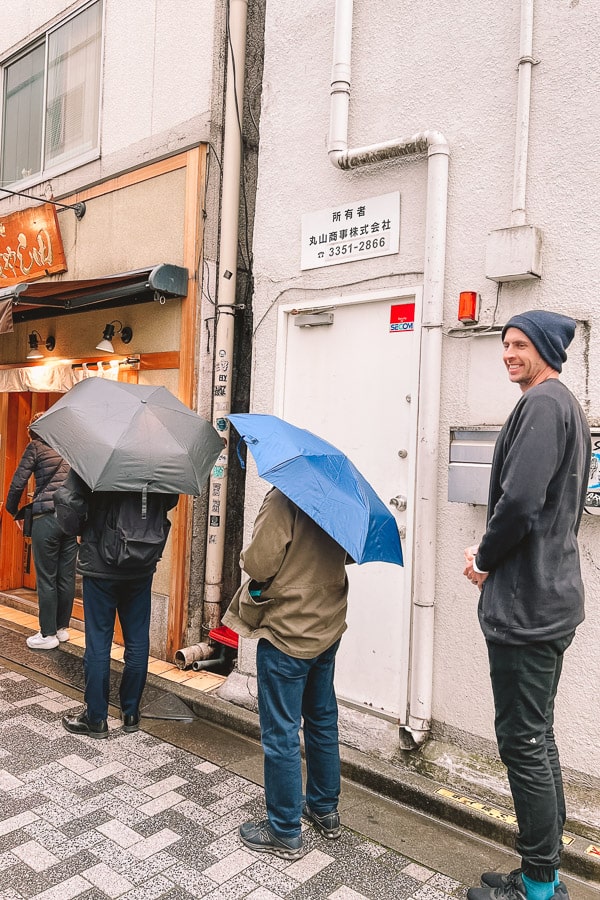
- Convenience Stores: one of my favourite things about Japanese culture is the convenience stores (konbini). You’ll see a 7/11, Lawsons or Family Mart on just above every corner, and these well-stocked shops sell fantastic ready-to-eat meals. We’ve had many onigiri (rice triangle sandwiches) for breakfast from the konbini, as well as great takeaway dinners on those days when we are just too exhausted to go out after exploring the city all day. The quality and range are excellent, and trying random new Japanese snacks from the local konbini is a personal tradition of mine!
- Book tickets in advance: For many popular tourist attractions, such as TeamLab Planets, Disneyland and ShibuyaSky, you need to purchase tickets in advance. In my 1 week Tokyo itinerary below, I include links to these to help make booking tickets in advance a breeze. For many of the attractions, it is easiest to book through a 3rd party like Klook or GetYourGuide . If you aren’t familiar with Klook, they are a large tour company with a strong Asian presence (and Japan in particular). Because of their size, they often offer discounted tickets to many of the popular experiences in Tokyo, so I recommend using them for most of your tickets and tours in Japan.
- JR Pass: You do NOT need a JR Pass to get around Tokyo – it would be a terrible waste of money if you did! Consider getting a JR Pass for long-distance Shinkansen rides, although with the 2023 price increase, JR Passes no longer offer as much value to tourists as they used to.
- Google Translate: I highly recommend downloading Google Translate on your phone. Many restaurants do not have an English menu, so we found ourselves using Google Translate almost daily – you can take a photo of a menu or sign in Japanese and it quickly translates it to English.
How to Get Around Tokyo
Tokyo’s vast metro and public transportation system can be pretty overwhelming and confusing. Luckily, Google Maps makes getting around in Tokyo (and Japan in general) a breeze.
All the schedules are synced with Google Maps, telling you real-time information on train times, prices, connections and transfers and even the best carriage to board to be closest to your planned station exit!
This is why I highly recommend getting an eSim, or at the very least pocket WiFi to help make getting around Tokyo easy.
The Suica card is a useful tool to save time on buying paper tickets, however, recent chip shortages have made getting these a bit trickier.
Apple iPhone users can easily add digital cards to their phones, but Android users for the meantime will need to purchase a WelcomeSuica card at the airport upon arrival or consider getting a subway pass.
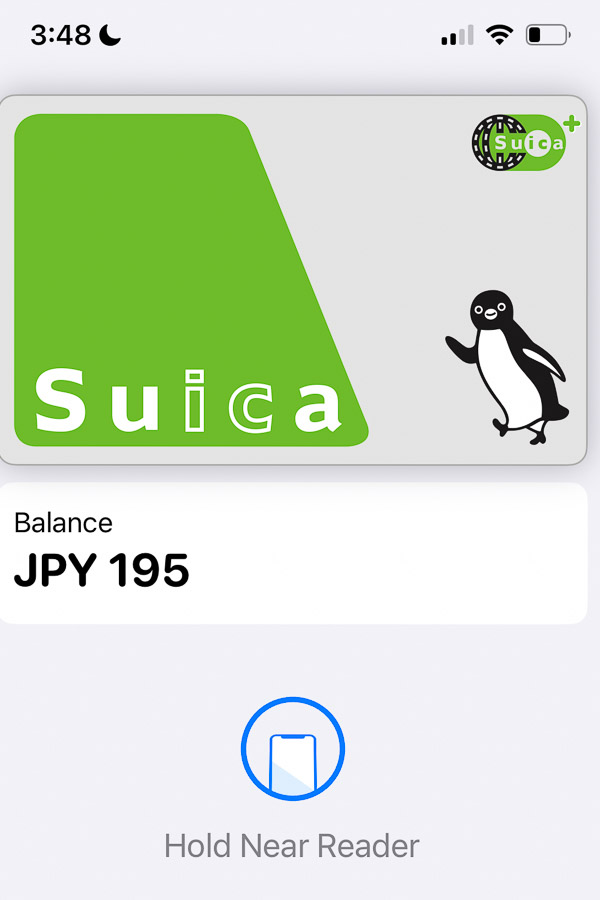
Even if you have a Suica, the subway pass can still be good value if you are making lots of trips on the subway in a certain period. Travel conveniently around Tokyo through Tokyo Metro and Toei Subway lines for 1-3 days with this Unlimited Pass .
While I recommend using the subway to get around Tokyo, if you’d prefer to keep things simple, Hop-On Hop-Off buses are plentiful around the main attractions in Tokyo.
Where to Stay in Tokyo
Generally, I recommend staying in or near Shinjuku (west side of Tokyo), or in the central area of Tokyo Station. However, as long as you are within walking distance of one or two subway stations/lines you will be fine!
I’ve suggested a few accommodation options below for different budgets in these areas.
Accommodation in or near Shinjuku (West Tokyo):
- Budget – Kimi Ryokan : I almost don’t want to share this in case it gets too popular, but Kimi Ryokan in Ikebukuro is my go-to budget accommodation in Tokyo. With traditional tatami mat bedding, this guesthouse is extremely clean, has shared bathrooms and lovely common areas.
- Mid-Range – Hotel Sunroute Plaza Shinjuku : You can’t beat the location of this centrally located hotel a short walk from Shinjuku Station. I prefer this hotel to similar-priced hotels in the busier Kabukicho nightlife area.
- Luxury – Park Hyatt Tokyo : We had a splurge night here to celebrate my husband’s birthday – the hotel’s New York Grill and Bar on the 52nd floor was featured in the movie Lost in Translation
Accommodation in or near Central Tokyo:
- Budget – the b ochanomizu : We stayed in this basic but clean hotel in Kanda, which was within walking distance to Akihabara and close to the subway. The rooms are small but modern and functional.
- Mid-Range – Via Inn Prime Nihonbashi Ningyocho : I was pleasantly surprised by the size of the rooms in this new, modern hotel. The location was within walking distance of two different subway lines.
- Luxury – The Gate Hotel : This trendy hotel is in the heart of Ginza, within walking distance to Tokyo Station and the Imperial Palace.
Explore all accommodation options in Tokyo
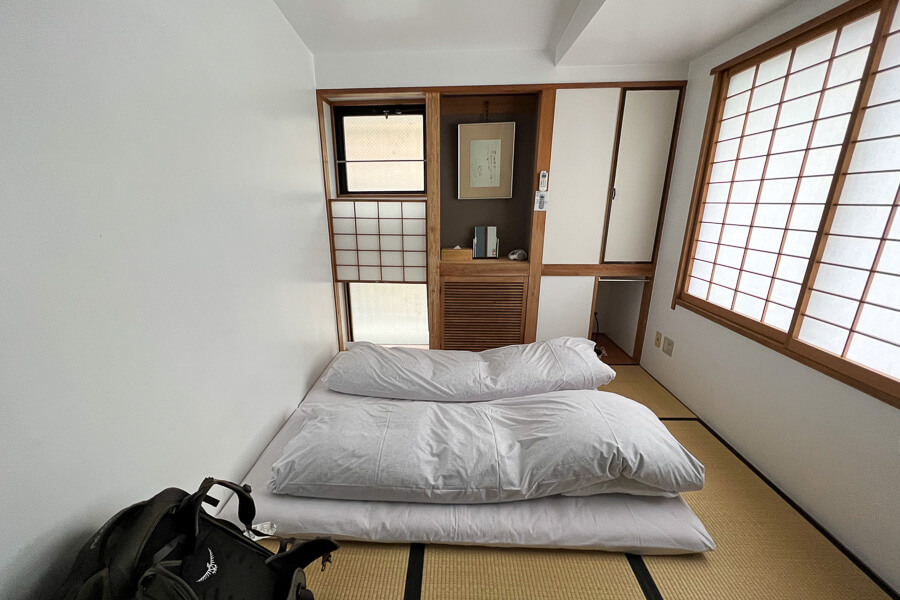
Tokyo Itinerary 7 Days
One week in tokyo itinerary map.
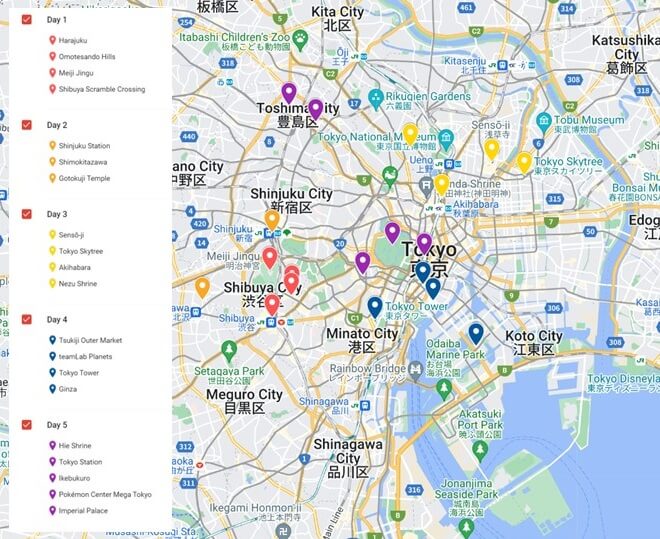
Day 1: Harajuku and Shibuya
Welcome to Tokyo! Begin your Tokyo 7 Day itinerary by immersing yourself in the vibrant, colourful and quirky streets of the Harajuku district.
Conveniently located on the Yamanote line, when you get off the subway at Harajuku Station you’ll find yourself at the top of the main street of Harajuku, Takeshita Street .
This bustling street is lined with hip fashion boutiques, crepe stands, food shops, themed cafes and more. You’ll likely see young people dressed in quirky and unique street fashion, including some very kawaii (cute) outfits or punk hip-hop styles.
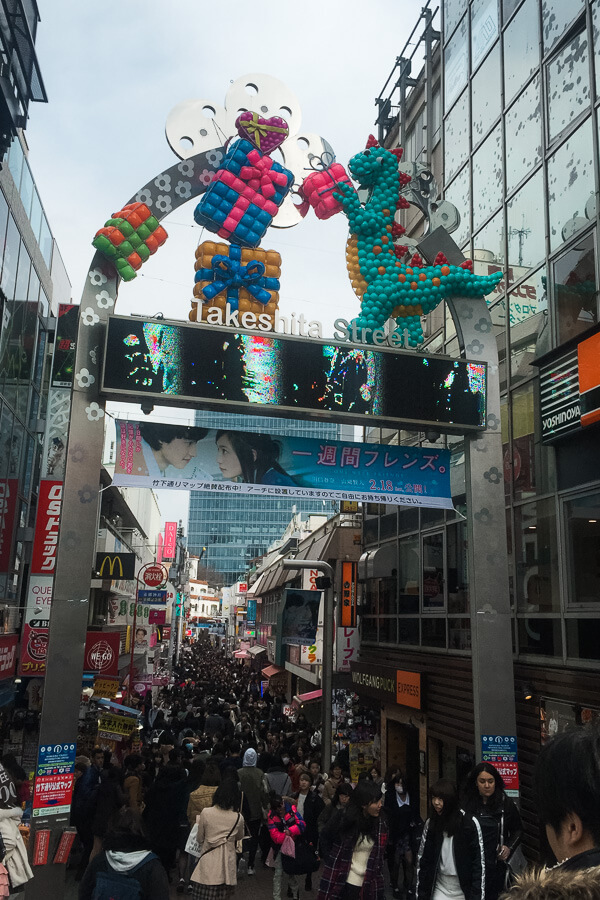
It can be overwhelming, particularly if you visit on the weekend!
My recommendation is to walk down Takeshita Street first before it gets too crowded, and then head to the quieter Omotesando Hills area. The Omotesando Hills consists of manicured streets with trendy boutiques and hip cafes, and is likened to the “Beverley Hills of Tokyo.”
Walk to Tokyu Plaza Omotesando, and make sure to check out the mirror entrance for a cool photo spot! You’ll also pass by Kinji Used Clothing, a massive second-hand clothing store that is a favourite of mine for high-quality, affordable used clothing.
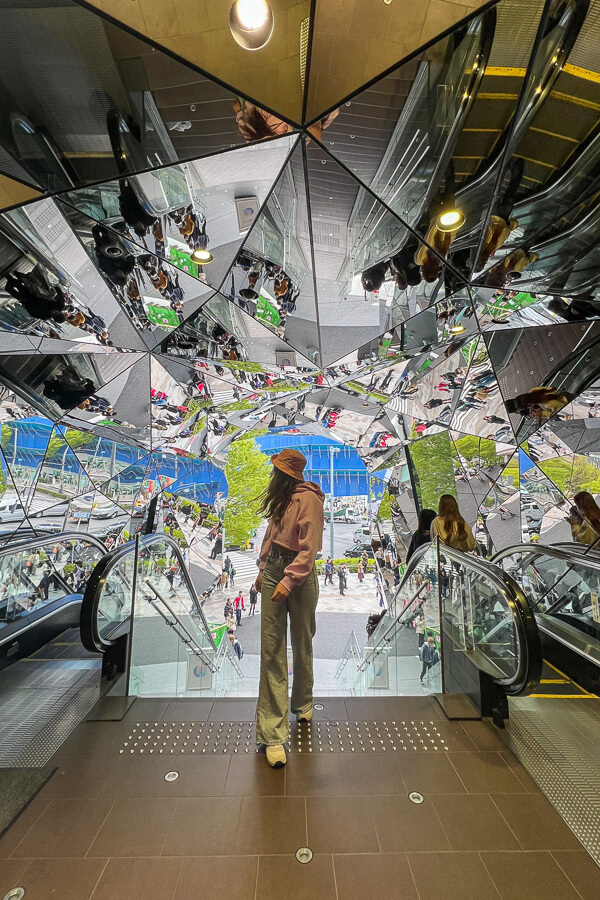
Continue exploring the trendy shopping streets – Cat Street is relatively quiet when compared to Takeshita Street, and you’ll find many trendy clothing stores and cute cafes.
If you need a snack stop or lunch, around the corner you’ll find Harajuku Gyozaro , a popular restaurant that specialises in dumplings. You’ll often see a line out the front (not an uncommon sight in Japan), but it moves quickly and is worth it!
Cross over the Jingumae Pedestrian Bridge .
In these picturesque streets, you’ll find Koffee Mameya, a cult specialty coffee store as well as the popular Tonkatsu Maisen Aoyama – one of the best-regarded tonkatsu (breaded pork cutlet) restaurants in the city.
We once got here before it opened for the chance to try their “Tokyo X” black pig pork katsu which is so exclusive it is only served to 5 customers a day! While it was delicious, I’m not sure we noticed enough of a difference to be worth the extra price.
If you need a coffee stop, another of our favourites in the area is Streamer Coffee Company . They have two coffee locations, but the one north of Omotesando is unique in its design with its multi-storied, narrow building made out of shipping containers.
Meiji Jingu Shrine
Cross the train line and meander towards the Meiji Jingu Shrine .
Open every day of the year, entrance to Meiji Jingu is free. You’ll pass the wall of sake barrels before passing under a large torii gate and entering the shrine. Nestled amongst nature, a visit to this 100-year-old shrine is a peaceful and tranquil experience compared to the hustle and bustle of the streets of Harajuku.
Open: Daily (times vary, check here ) Entrance: Free
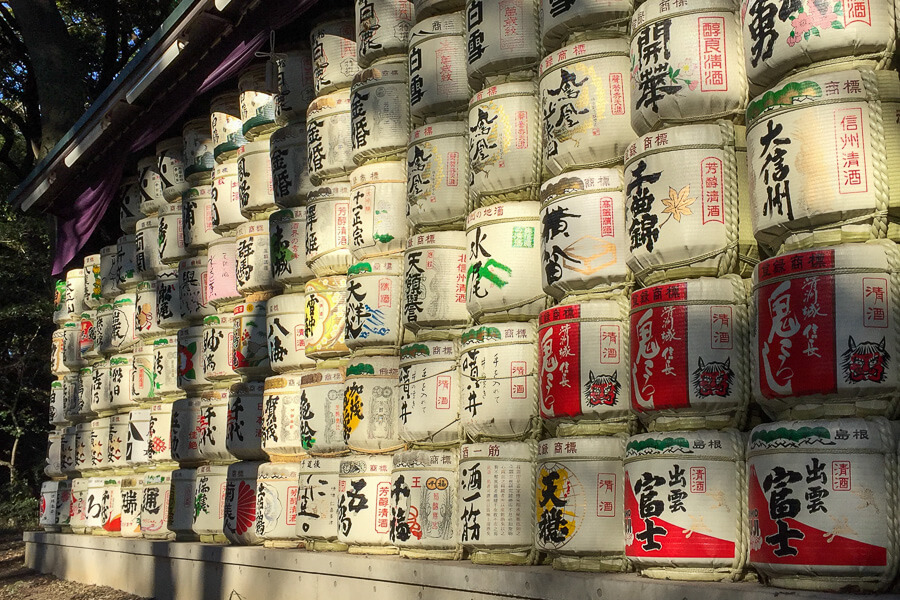
Shibuya
Walk or catch the subway one stop to Shibuya Station, spending the rest of your afternoon and evening exploring this iconic hub of Tokyo.
Near the station, make sure to stop by the Hachiko statue , the heartwarming memorial of the loyal dog who waited for his owner by the station each day – even after his death. These days, it’s used as a meeting point for groups of friends before exploring or dining in Shibuya.
Right next to the station and the Hachiko statue is the world-famous Shibuya Scramble Crossing, which is considered the world’s busiest pedestrian crossing – an estimated over 2.4 million people cross Shibuya every day ! An estimated 2,500 – 3,000 people are crossing this particular spot at a time.
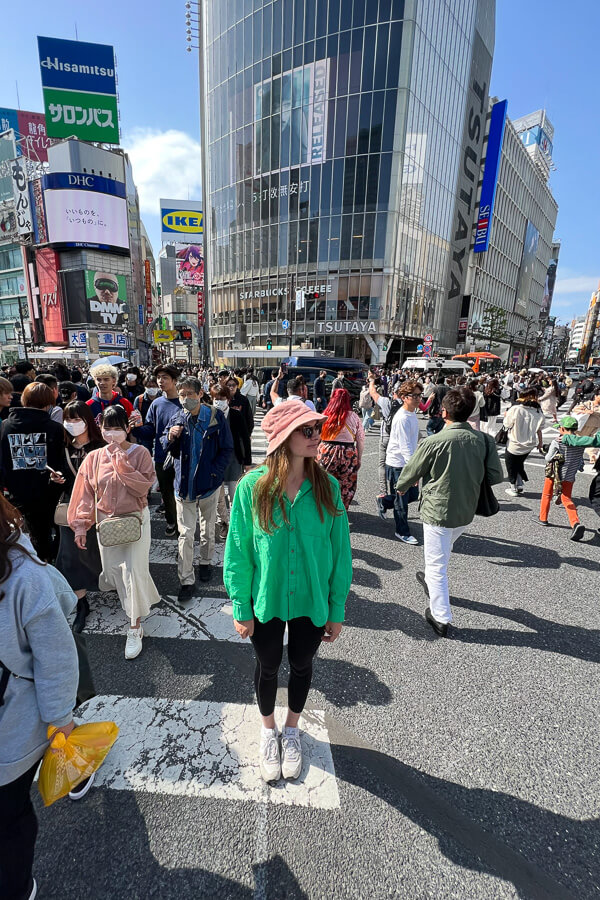
The crossing is best viewed from above – on our first visit, we headed to the Starbucks across the road and sipped on lattes while watching the thousands cross below.
On our most recent visit, we bought tickets to the new Shibuya Sky attraction. This popular spot offers insane 360-degree views of Shibuya and the endless sprawl metropolitan sprawl of Tokyo from an open-air observation deck on the rooftop of the Shibuya Scramble Square (47 floors high!).
Tickets are available 4 weeks in advance, and sunset sessions book out very quickly. So make sure to book your ticket ahead of time here.
Open: Daily 10am – 10.30pm Entrance: ¥2200 – purchase online tickets easily with Klook (bookings available 4 weeks in advance)
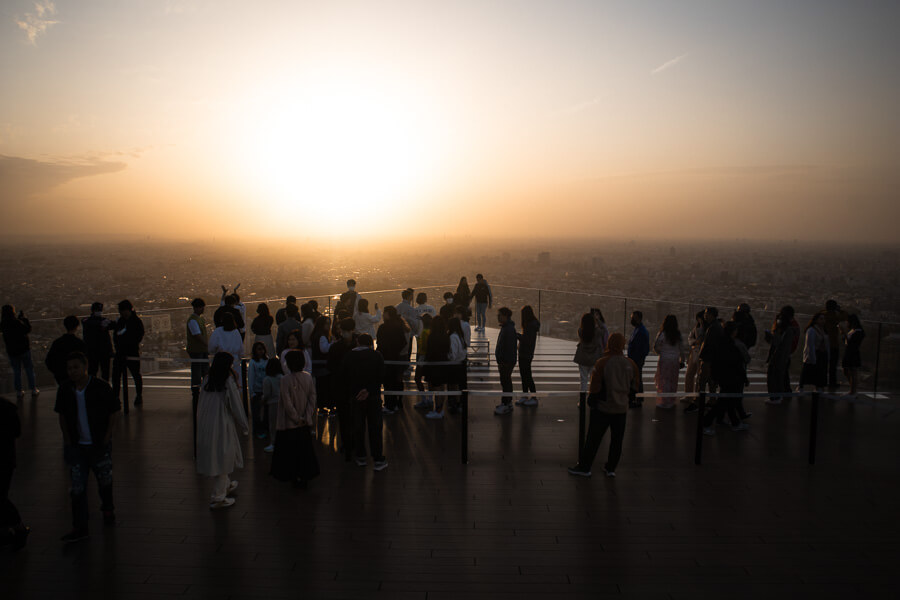
For food, we wandered the Dogenzaka-dori and found a small izakaya in a basement. You’ll find lots of spots like this, or head to the ever-popular Ichiran ramen restaurant chain for a must-try bowl of noodles.
For a local perspective, explore Shibuya with a local guide – you’ll visit some lesser-known spots while learning about the history, sights and local recommendations from your guide.
Gotokuji Temple
Start your second day in Tokyo by catching the Odakyu Line to Gotokuji Station. From here, it is a 15-minute walk through the local neighbourhood to Gotokuji Temple, otherwise known as the Lucky Cat Shrine .
Open: Daily 6am-5pm Entrance: Free
This Buddhist temple doesn’t appear to be anything unique until you get to a small section in the back corner which is filled with hundreds (if not thousands) of Maneki Neko lucky cat figurines. As cat lovers and big Japanese culture fans, this was a must-visit attraction for us!
This is definitely an underrated and lesser touristed attraction in Tokyo, we loved walking through the temple grounds, admiring all the maneki neko statues and taking photos around the temple and grounds.
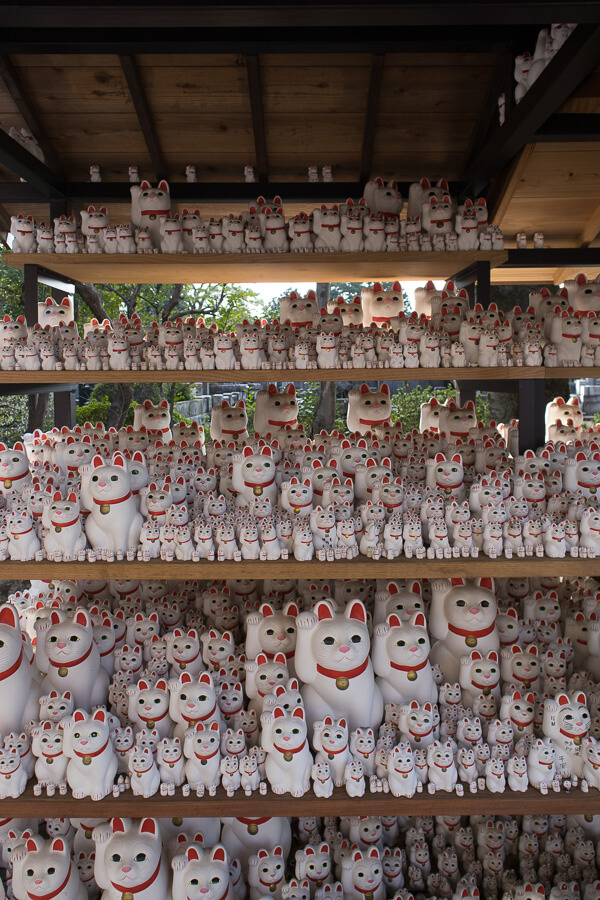
Shimokitazawa
After a visit to the Gotokuji Temple, it was easy to jump back on the Odakyu Line at Gotokuji Station and travel one stop to Shimo-Kitazawa Station.
Shimokitazawa is a trendy neighbourhood best known for its large range of vintage and second-hand clothing boutiques. The stores are generally more upmarket and include vintage designer items and one-of-a-kind items.
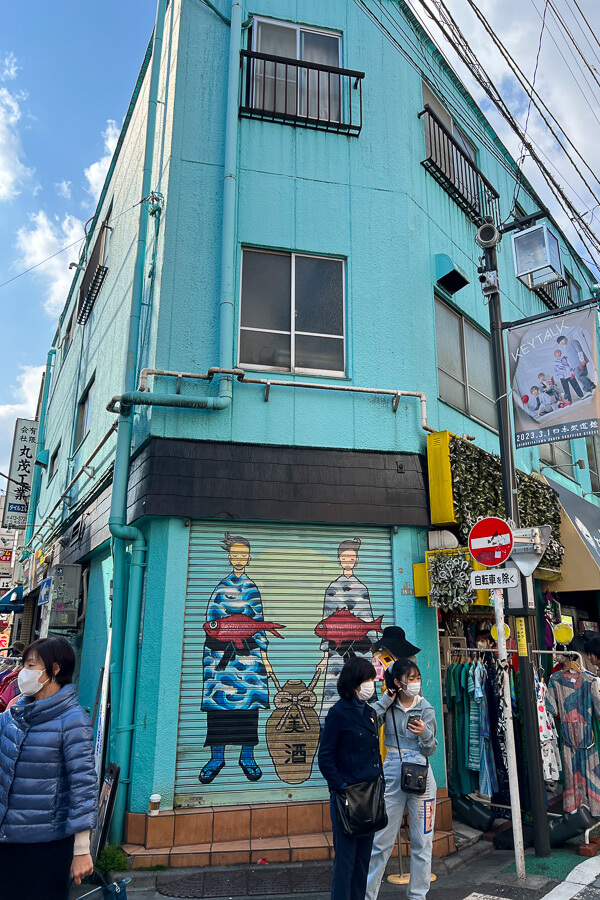
There are also many cosy, hip cafes, and many specialty coffee stores (perfect for the coffee-lovers like us!). We enjoyed a unique coffee experience at the trendy, minimalistic-designed Ogawa Coffee Laboratory .
You choose your beans at the counter from a large list based on your flavour and roast preferences, before watching your coffee be prepared in front of you. We also tried their house specialty, square scones.
You’ll find the largest concentration of vintage stores in the area north of the station, whereas east of the station is more boutiques and quirky stores. You’ll find you can easily spend a few hours wandering the streets and browsing the boutiques.
Spend the rest of your afternoon and evening exploring the bright lights of Shinjuku.
If you need a break from the fast-paced city vibes, Shinjuku Gyoen National Garden is stunning, especially when we visited during cherry blossom season .
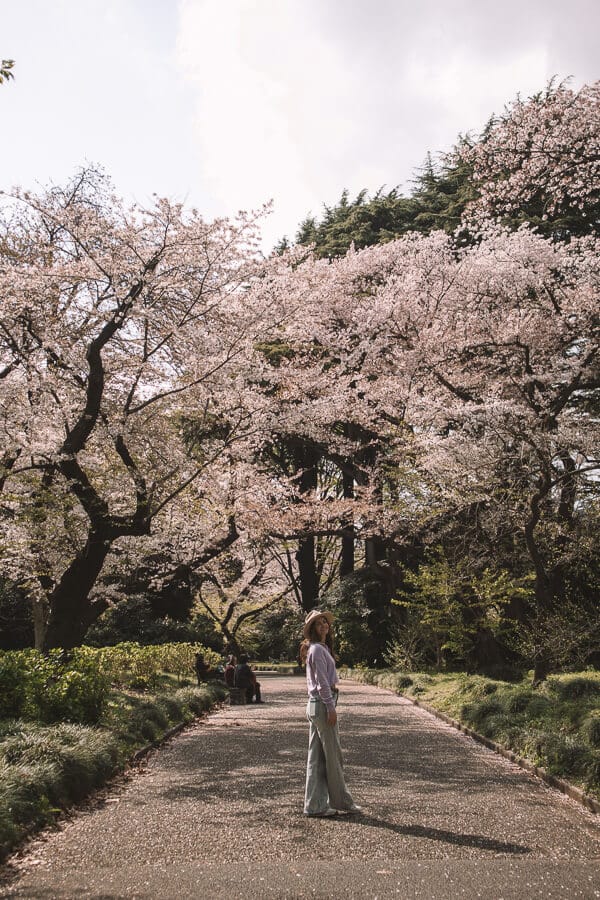
With over 144-acres of expansive grassed areas, serene lakes, tranquil greenhouses and landscaped Japanese gardens. Great to visit in spring (cherry blossoms) or autumn (autumn colours).
Open: Daily except for Mondays. Special opening times apply in April and November Entrance: ¥500
Shinjuku is another shopping haven – we went to our first Don Quijote here in Shinjuku.
Don Quijote is an overwhelming and somewhat chaotic shopping experience, but also a haven for tourists wanting to get unique Japanese snacks, gifts or nick-nacks. I also love the affordable Japanese skincare here!
If you need a coffee break and rest stop, the pudding at All Seasons Coffee blew our mind!
My favourite things to do in Shinjuku at night include eating, drinking and visiting the massive game arcades. A favourite dinner spot for tourists and locals alike is the Standing Sushi Bar to the west of Shinjuku at Uogashi Nihon-ichi. We come here every time we visit Tokyo and it never disappoints!
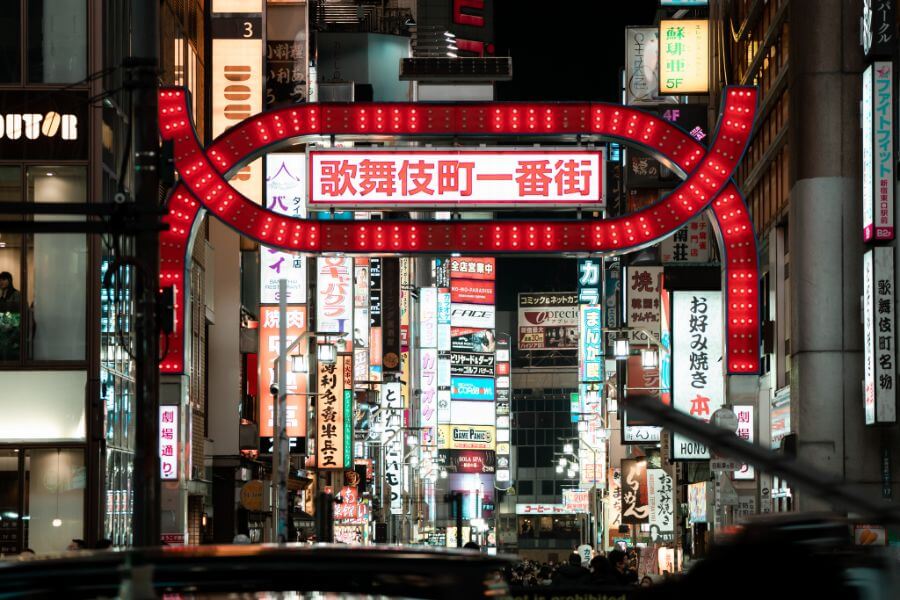
You’ll find a large SEGA game arcade around the corner, making it a great spot for some after-dinner entertainment.
On our most recent Tokyo trip in 2023, I discovered an amazing sake bar in Shinjuku hidden away on the upper floor of a nondescript building. We learnt so much about the different styles of sake at Yata Yata while taking in the bright lights of Shinjuku for the window on the 10th floor – highly recommend!
Shinjuku is also home to a few sake markets . At these popular bars, you pay a fixed price for all-you-can-drink sake that you serve yourself. You can buy a few snacks from the bar, or bring your own food from the local convenience store. This is our favourite way to try new and different sake styles!
Reserve your sake market experience in advance here .
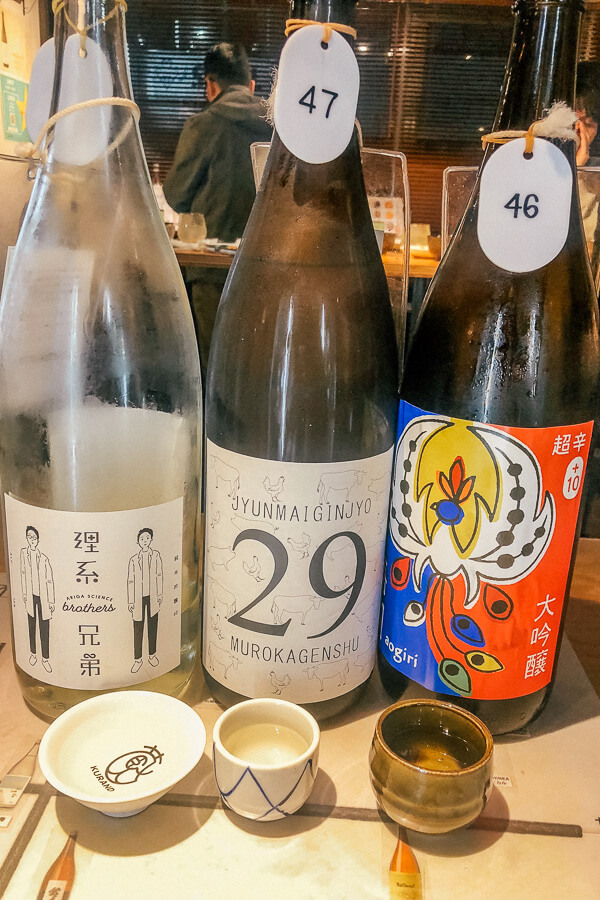
It’s also worth strolling the Kabukicho red-light district – you’ll know you are in the right place when you see the giant Godzilla head peeking over the top of Toho Cinema and Hotel Gracery!
We came here on our very first visit to Japan in 2013 to visit the famous Robot Restaurant, which unfortunately closed during COVID.
Nearby you’ll discover the Shinjuku Golden Gai , a maze-like area of small alleyways with little bars and local izakayas scattered around.
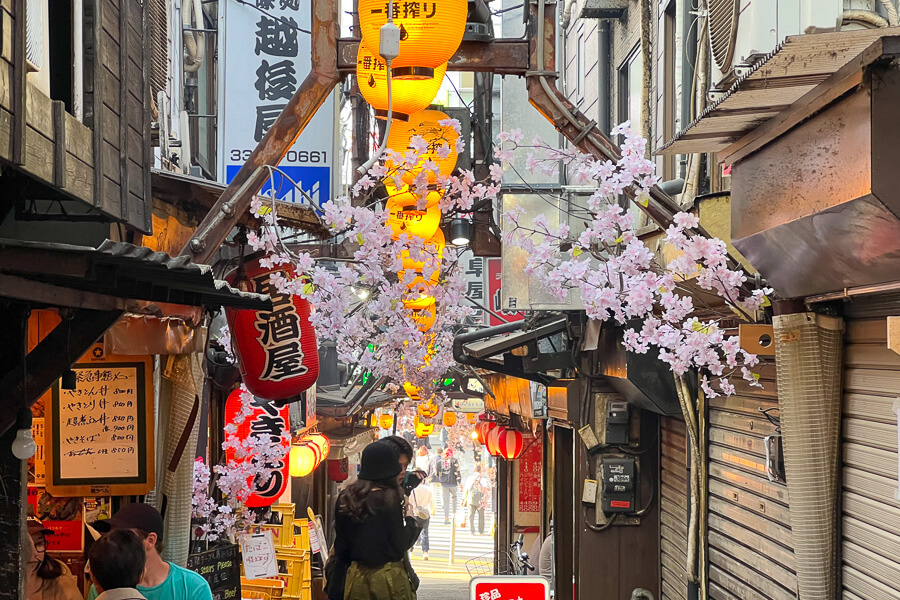
Another popular izakaya street is found near the train tracks at Omoide Yokocho – or Piss Alley as it is affectionately known! This small alleyway comprises local eateries where you sit shoulder to shoulder with Japanese businessmen, eating grilled skewers of meat and drinking beer.
Lastly, don’t miss the famous Shinjuku 3D cat billboard ! I stood here for at least 15 minutes watching the lifelike animated cat on the giant billboard above. You’ll find it around the corner from Omoide Yokocho here .
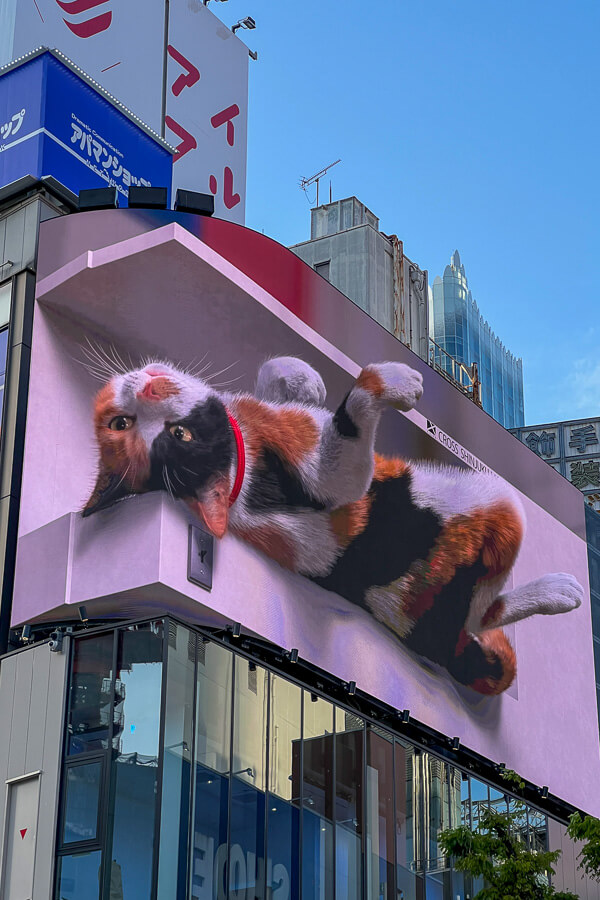
Asakusa, Senso-ji and Tokyo Skytree
In the morning, make your way to the traditional Asakusa district and one of Tokyo’s most famous temples, Senso-ji. As one of the main tourist areas in Tokyo, this area gets busy! So it’s a good activity to do earlier in the day, although many of the shops won’t open until 10am.
You’ll begin by stepping through the large Kaminarimon lantern gate, marking the entrance to Senso-ji temple and leading into Nakamise Shopping Street.

This bustling street is lined with numerous souvenir shops, food stalls and other treats. Sample local food while browsing the different shops, but please note that in Japan it is considered rude to walk and eat (you might see signs asking you to stand outside the food vendors to eat in many food markets around the country).
Continuing along the street, you’ll soon reach Senso-ji – Tokyo’s oldest Buddhist temple.
Open: Daily 6am – 5pm Entrance: Free
Explore Asakusa on an informative rickshaw tour . Pass temples and shrines, explore quirky neighbourhoods, venture through Sumida Park and traverse historic streets with a local guide.
If you’re interested in visiting a cat cafe, near Senso-ji you’ll find a great ethical option at Cat Cafe Asakusa Neko-en . Here, the cats are all rescues and available for adoption. Please re-consider visiting any other animal cafes, particularly exotic animal cafes such as owl cafes or hedgehog cafes – these aren’t ethical or sustainable places.
After exploring the temple grounds, you can head to the Tokyo Skytree . Until the opening of Shibuya Sky, Tokyo Skytree was the most popular observation deck in Tokyo!
Standing at 634 metres tall, it is Tokyo and Japan’s tallest tower! It has the highest observation decks in Japan – the lower deck (Tembo Deck, 350 metres) and upper deck (Tembo Galleria, 450 metres). Unlike Shibuya Sky, both decks are enclosed and protected from inclement weather.
It is recommended to buy tickets in advance, to avoid long queues for tickets (particularly on weekends).You can buy a ticket just for the lower Tembo Deck, or a combined ticket for both the Tembo Deck and Tembo Galleria. Prices are cheaper for tickets bought before the day of visit. You can check prices and book here.
Open: Daily (opening times vary, usually from 10am – 9pm but check first) Entrance: Varies based on ticket type – official prices start from ¥1800 but you can usually get cheaper tickets during non-peak periods by booking in advance with Klook .
Akihabara
Akihabara is one of my favourite places in Tokyo. The minute I step out of the train station and onto the vibrant streets, surrounded by flashing neon billboards on every possible building surface, I always get the biggest buzz.
Akihabara Electric Town, or “Aki” as it is affectionately called, is famous for its electronic shops and pop culture fans. Here you will find all kinds of electronics and gadgets, Japanese pop culture anime including anime, manga, video games and toys, maid cafes and other themed restaurants as well as many video arcades and game centres.
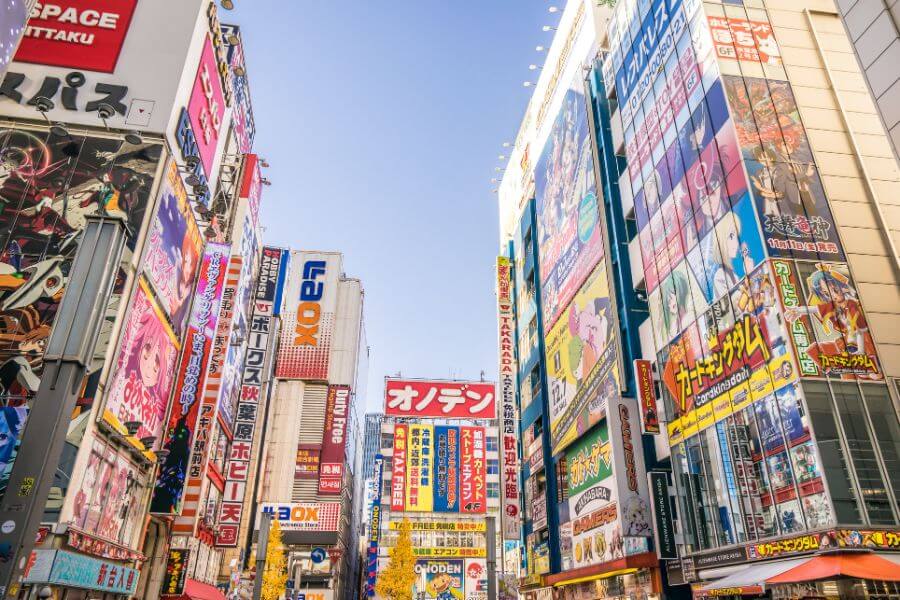
Spend most of your time here exploring the many, many stores. Some of my favourites include Mandarake, Super Potato and Book Off. Akihabara is also the place in Tokyo to visit a cosplay maid cafe. You can pre-book this experience here.
For a fun activity, zoom around the streets of Akihabara on this go-kart tour . 1 or 2-hour experiences are available, and you’ll need to bring an International driver’s licence.
Get more information on this highly-rated memorable experience .
For lunch, we decided to try the Akihabara location of Gyukatsu Motomura . This bustling restaurant was one of my favourites on our most recent trip. The concept here is beef katsu, but you cook it yourself on a stone plate to your liking. It comes as a set meal with rice, miso soup, cabbage and a few sauces, and it was the tastiest katsu I’ve EVER had!
We had to line up for nearly 30 minutes even at 2pm, but it was SO worth it!
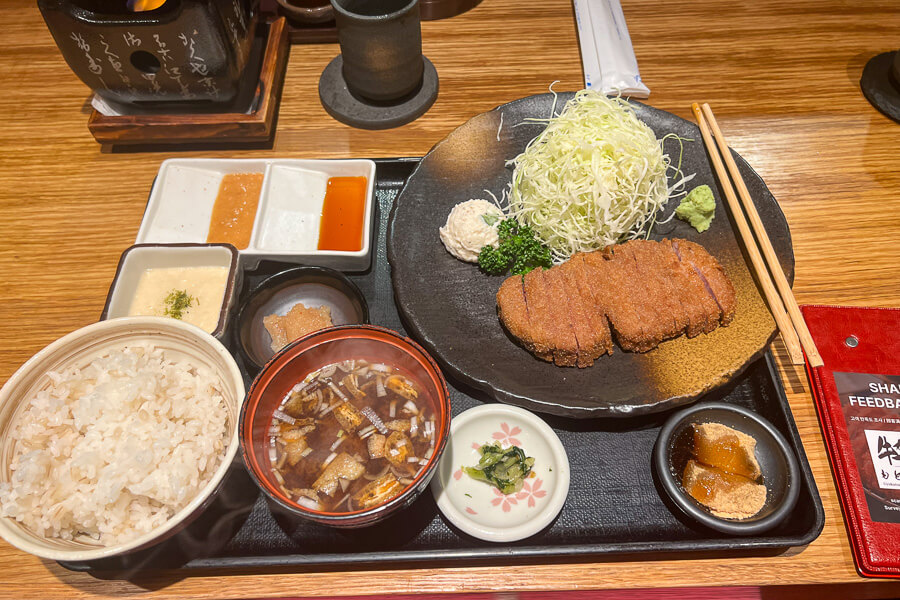
If you are looking for a nearby dinner spot, we had a great local izakaya experience at Darumasakaba in Kanda.
We were the only foreigners in this downstairs restaurant packed with locals, but the friendly owner found us a seat at the bar, and with his help and Google translate we worked our way through the menu in Japanese. One of those nights that was an experience we won’t forget anytime soon!
Bonus: Nezu Shrine
If you have daylight time remaining, a short train ride away will take you to Nezu Shrine . This is one of Tokyo’s underrated gems, off the beaten path for the majority of tourists when we last visited.
At Nezu shrine, you can wander through numerous orange torii gates leading to a small, tranquil shrine, reminiscent of the popular Fushimi Inari in Kyoto.
Open: Daily 5am – 6pm Entrance: Free
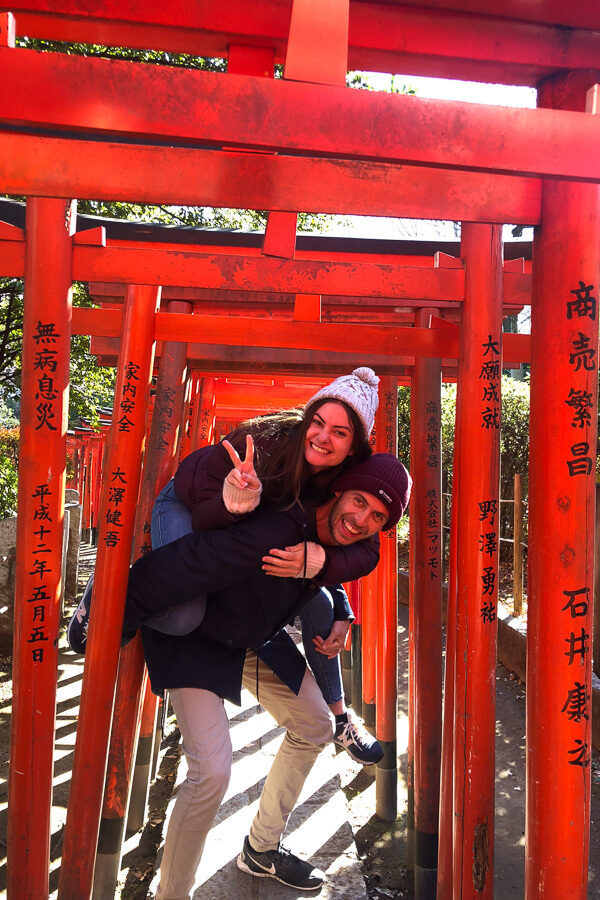
Day 4: Tsukiji Market, TeamLab Planets & Ginza
Tsukiji market.
A quintessential Tokyo experience I highly recommend is passing up on a hotel breakfast one morning in favour of a fresh sushi breakfast instead at Tsukiji Outer Market.
Tsukiji, the biggest fish market in the world, moved its wholesale operations to the new Toyosu Market in 2018. However, the iconic Tsukiji Outer Market, consisting of restaurants and small market stalls, remains in its original location in the Chuo City district.
Here you can sample some of the freshest sushi and seafood in the world for breakfast.
On my most recent visit in April 2023, we enjoyed fresh tuna and salmon donburi (rice bowl) at Tsukiji Donburi Ichiba . This tiny shop has counter seating for just 5 customers at a time, making it an intimate affair.
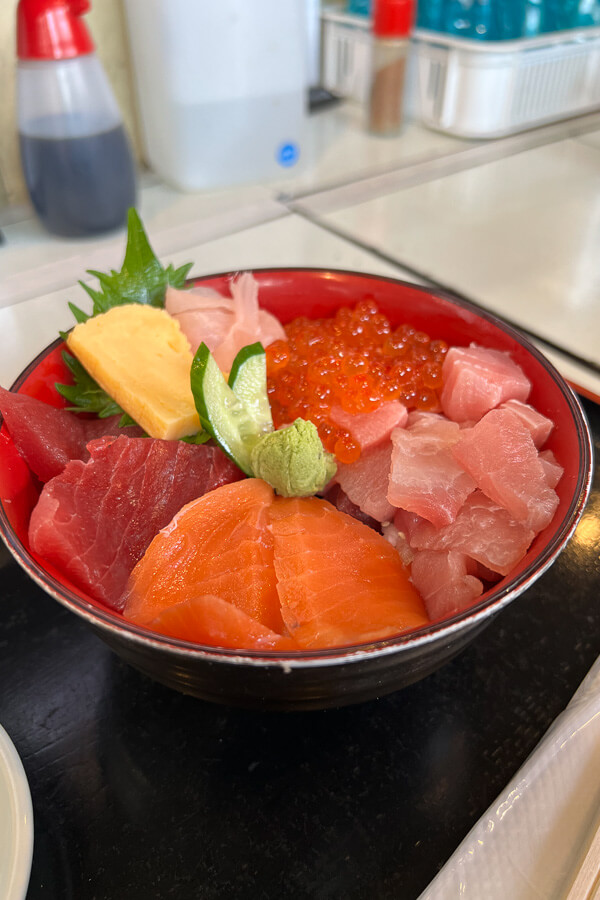
Popular sushi restaurants at Tsukiji Markets include Tsumugi, Tsukijiro, Motodane and Sushizanmai (a chain store across Tokyo, but this is their Main Branch). You’re also guaranteed to find a perpetual queue lining up outside Sushi Dai.
You can also try a variety of snacks from the various market stalls – we tried tomago (egg) on a stick, grilled unagi (eel), delightful strawberry mochi and my all-time favourite, delicious taiyaki (steaming hot custard-filled pastries in the shape of a fish) served by a lovely old lady at Tsukiji Sanokiya.
I’m drooling just thinking about those taiyaki – they were the best we had during our one month trip to Japan!
Wander the markets at your own pace, or join a local guide on a food tour .
TeamLab Planets
After eating way too many delicious things, we caught the bus a short ride down the road to TeamLab Planets. This was my second visit to a TeamLab exhibition, after visiting TeamLab Borderless a few years ago.
The TeamLab interactive displays are truly mesmerising and a work of art, so it’s highly worth visiting one of their displays.
At the time of writing in November 2023, TeamLab have exhibitions in Tokyo at TeamLab Planets and in Osaka at TeamLab Botanical Garden. In February 2024, TeamLab Borderless is due to reopen at a new location in Azabudai Hills.
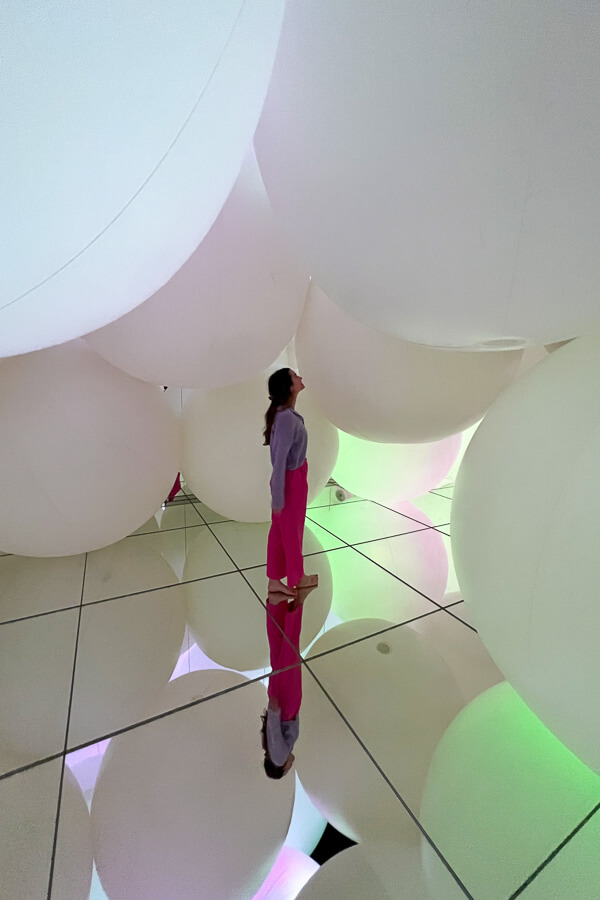
At TeamLab Planets , you walk through water, rooms full of sparkling floor-to-ceiling lights and giant colourful balls, and sit beneath a garden of flowers. It’s a surreal experience, and worth visiting at least one of the TeamLab exhibitions while in Japan.
You will need to book a specific time slot for your visit, and tickets sell out in advance – so make sure to book at least a few weeks ahead! I found it easier to book with GetYourGuide , as it was easier to select time slots, however, Klook also has tickets for sale.
Open: Daily 9am – 10pm Entrance: ¥3,800 – timed entry tickets need to be purchased in advance
Make your way to the high-end, glamorous shopping district of Ginza.
Considered the mecca of luxury shopping in Tokyo, we spent most of our time wandering around the posh streets and admiring the lavish store displays. Make sure to walk past the Bulgari flagship store to see the glittering serpent wrapped around the building.
Other fun things to do in Ginza include visiting the Art Aquarium Museum (a museum of goldfish!), visit UNIQLO’s biggest flagship shop or watch a kabuki play and the Kabukiza Theatre.
After window browsing or shopping up a storm, you can try Michelin Bib Gourmand rated tempura at Tempura Abe Honten – but be prepared to queue! Another recommended spot is Ginza Hanadaikon, which serves delicious wagyu beef.
Day 5: Hie Shrine, Imperial Palace, Tokyo Station & Ikebukuro
Start your day with a morning visit to Hie Shrine , another spot in Tokyo with the famed orange torii gates.
The entrance to Hie Shrine is impressive, with a large torii gate standing tall before the long flight of steps leading to the top of the hill. Here you will find the Hie-jinja shrine, a guardian shrine of the Imperial Palace (which you’ll also be visiting later today).
On the western entrance, you’ll find a tunnel of torii gates lining the steps leading to the back of the temple.
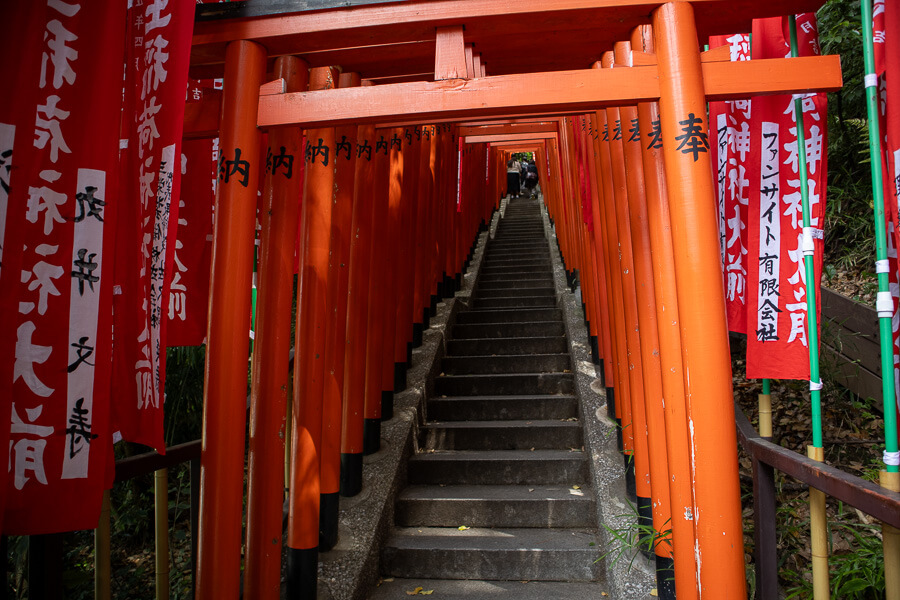
Imperial Palace Gardens
Hop on the Chiyoda line at nearby Kokkai-gijidomae Station and travel 3 stops to Nijubashimae Station. You’ll surface at the entrance of the Kokyo Gaien National Garden plaza and views of the Imperial Palace.
Located on the site of the former Edo Castle, the Imperial Palace is home to the Emperor of Japan. The palace is surrounded by impressive gardens, massive moats and towering stone walls.
The inner grounds and palace are closed to tourists, but you can explore the expansive and picturesque East Gardens for free most days of the week.
Open: Generally 9am-5pm but varies seasonally. Closed Mondays and Fridays. Check official opening times and dates here Entrance: Free
Tokyo Station
The next attraction on your Tokyo itinerary for today is the massive Tokyo Station . Much more than just a train station, Tokyo Station is a historic landmark and bustling hub of shops, restaurants and more.
Walk from the East Gardens to the Marunouchi Square entrance of the station. Admire the classical red-brick facade that has been carefully restored to its original state, standing out from its neighbours of modern skyscrapers.

Head underground and explore the maze-like streets below the station. Tokyo Station has unique themed sections. Make sure to visit Character Street, with shops selling Japanese anime goods, including a small Pokemon store.
Grab lunch from one of the many restaurants on Ramen Street, where you can find all kinds of ramen styles from across Japan.
Ikebukuro
Spend the rest of your day exploring Ikebukuro , which I best describe as a smaller but still vibrant version of Shinjuku. On our last two trips to Tokyo, we stayed in Ikebukuro at one of our favourite budget accommodations in Tokyo, Kimi Ryokan.
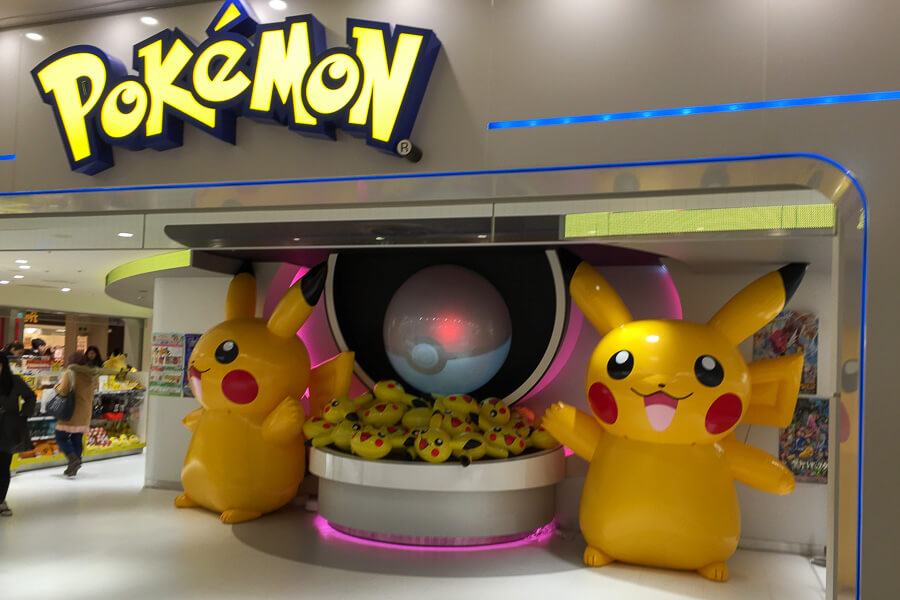
In Ikebukuro, you’ll find many electronic stores and department stores, some great coffee shops (like Mermaid Coffee Roasters) and brilliant ramen restaurants (hello, Kikanbos).
Head to Sunshine City Mall, home of the mega Pokemon Center, and the world’s largest gashapon (gacha gacha) capsule toy store at Gashapon Ikebukuro.
Day 6: Experience the Magic of Disneyland or DisneySea
Get ready for a magical day at Tokyo Disneyland ! This was the first Disney theme park outside of the United States when it opened in 1983. Today, Tokyo Disneyland has seven different themed worlds.
Tokyo Disneyland is easily accessed through public transport. Get off at JR Maihama Station on the JR Keiyo/Musashino Line and jump on the Disney-themed monorail to arrive at Tokyo Disneyland Station.
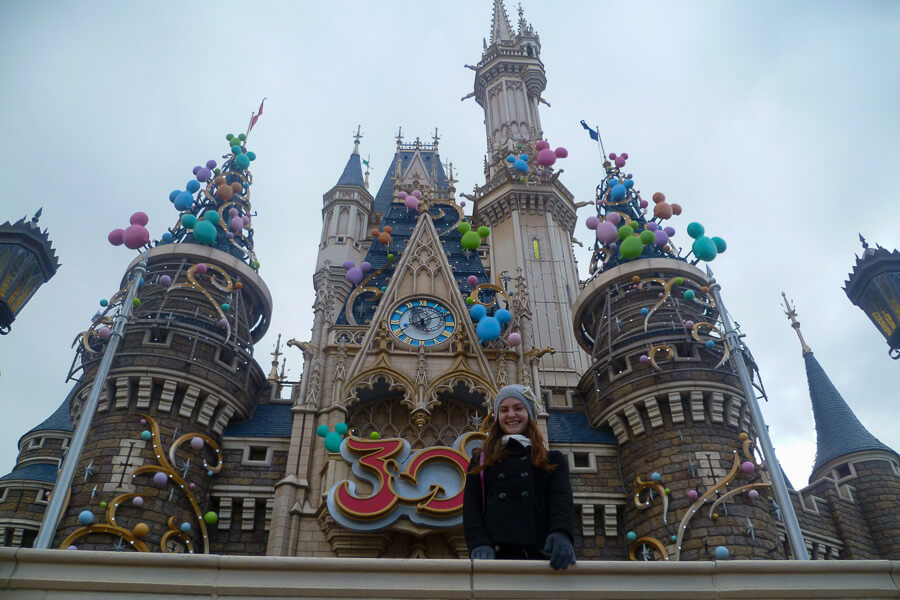
Tokyo is also home to the only DisneySea in the world!! On our second visit to Tokyo, we chose to spend the day at DisneySea after doing Disneyland on our first trip. DisneySea was spectacular, and many argue that its rides are better than Disneyland
I think if you haven’t been to Disneyland anywhere else before, you should stick with Disneyland Tokyo, otherwise seriously consider visiting DisneySea while in Tokyo as it is arguably the better theme park, and you can’t visit one anywhere else in the world!
- 1 Day Pass (Disneyland or DisneySea)
- 2 Day Pass (Disneyland, DisneySea or both)
Open: Daily, usually from 8am to 10pm Entrance: From ¥8,900
There are some incredible day trips from Tokyo that you should consider adding to your 7 days in Tokyo itinerary.
Hakone is a picturesque hot spring town that is a lovely day or overnight trip from Tokyo. It’s worth spending a night at a traditional ryokan if your schedule and budget permits, otherwise a day trip is a great way to soak in the incredible scenery and unique attractions in this mountainous area.
I visited Hakone on my very first trip to Japan in 2013. It is possible to do a self-guided tour of Hakone using the Hakone Freepass. We followed the popular Hakone Round Course itinerary which takes you through a loop of Hakone’s main attractions using a range of different modes of transport.
We caught the Hakone Ropeway where we crossed over the Owakudani Valley, famous for its volcanic activity and sulphur vents. You can even get views of Mt Fuji on a clear day! From here, you jump on a scenic boat cruise across Lake Ashi, where you’ll spot the large red torii gate of the Hakone Shrine on the lake’s edge.
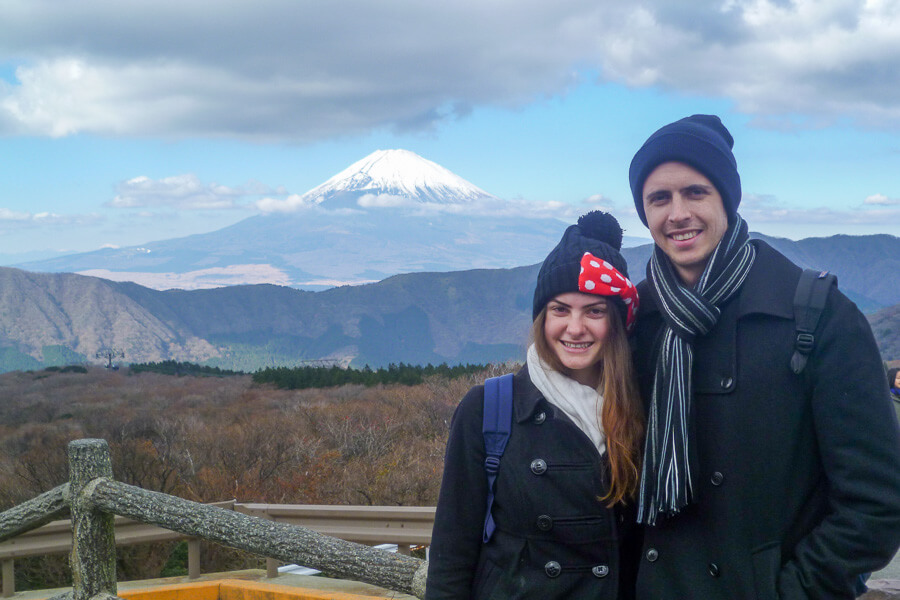
You can easily purchase a Hakone Freepass online which includes unlimited public transport (including the boat cruise across Lake Ashi). This 2-day pass is worthwhile even for a day trip if you are doing the full loop course in one day as a day trip from Tokyo.
If you prefer to join a guided tour with convenient bus transport included, consider this Hakone One Day Trip from Tokyo .
It includes a visit to the panoramic Mt Fuji Fifth Station, shopping at Gotemba Premium Outlets, riding the Hakone Ropeway, exploring the Owakudani Valley and a scenic cruise across Lake Ashi.
Lake Kawaguchi (Fuji Five Lakes area)
I recommend spending a few nights in Fuji Five Lakes if possible, otherwise to visit the best viewpoints of Mt Fuji , a day trip to Lake Kawaguchi is the way to go!
To visit Lake Kawaguchi on a day trip, joining an organised bus tour is the easiest and most convenient way to do so. Public transport in Lake Kawaguchi is limited and the main sights are spread across the town, making it hard to get to without your own transport in a day.
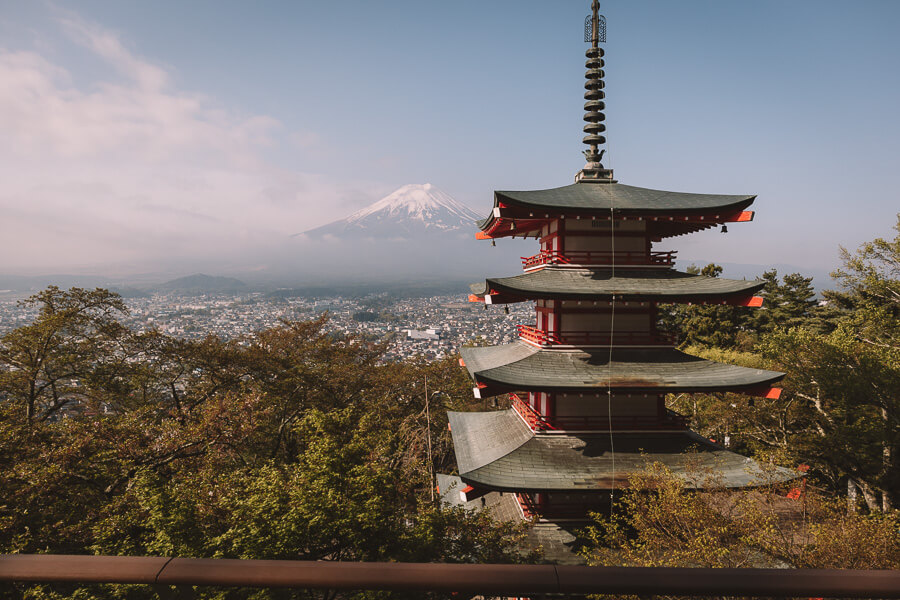
This tour takes you to the best Mt Fuji viewpoints in Kawaguchiko, including the beautiful Chureito Pagoda , Oishi Park and a visit to a traditional village on an easy and affordable day trip from Tokyo.
Another very popular Mt Fuji tour is the Mt Fuji Classic Route Day Tour .
This tour includes a stop at the Mt Fuji 5th Station, a visit to Oshino Hakkai, a series of pools thought to have been formed by erupting Mt Fuji and a shopping trip to Gotemba Premium Outlets, one of Japan’s largest outlets.
Final Thoughts – 7 Day Itinerary Tokyo
That wraps up this itinerary for Tokyo, 7 days of exploring the vibrant, cultural and quirky neighbourhoods that make up the sprawling metropolitan oasis that is uniquely Tokyo.
Whether it’s your first time exploring Tokyo, or even your fifth like me, this 7 days Tokyo itinerary will ensure there is never a dull moment!
If you have any questions about this 1 week in Tokyo itinerary, please feel free to include them in the comments below. Don’t forget to check out my other Japan guides to help plan your trip!
Plan your Japan adventures :
- 15 Things to Know Before Visiting Japan for the First Time
- 30 Unmissable Experiences for Your Japan Bucket List
- A Perfect 4 Weeks in Japan Itinerary: Ultimate Travel Guide
- How to Easily Visit the Chureito Pagoda from Tokyo
- An Exciting 4 Days in Osaka Itinerary for First-Timers
- 2 Days in Takayama: Discover Traditional Japan
- Koyasan Temple Stay: Essential Travel Guide & Tips
- Exploring Fuji Five Lakes: 3 Days in Kawaguchiko Guide
- 10 Most Mesmerising Views of Mt Fuji from Kawaguchuiko
- Cool Stuff to Buy in Japan: 20 Souvenirs Actually Worth Buying
TRAVEL PLANNING RESOURCES My tried and tested recommendations to make your next trip easier
🛡️ Travel Insurance: For my fellow Aussies, I use CoverMore for domestic and overseas travel insurance and they've been great to deal with. Travel with peace of mind knowing you're covered for unexpected events, ensuring a worry-free journey.
🌐 Stay Connected: After trying an eSim for the first time when travelling Japan & Europe for over 4 months in 2023, I'm officially converted! Thanks to Airalo , gone are the days of needing to physically swap plastic sim cards every time you enter a new country. Stay connected wherever you go by easily and affordably purchasing an eSim for all your travel destinations.
🚗 Easy Car Rental : Enjoy hassle-free car rentals on DiscoverCars with a wide range of options, competitive prices, and excellent customer service. I often find it's cheaper than booking direct, and I can compare a large range of suppliers to make sure I'm getting the best price.
💱 Access Local Currency: I've been using Wise in my business and on my travels to save on currency exchange and it's been a game changer! Wise provide a transparent and cost-effective way to access and manage local currency, with minimal fees and the best exchange rates compared to the traditional travel cards which sneakily charge extra fees and usually give you a poor exchange rate. Find out more here .
🏨 Accommodation: I book all my accommodation through booking.com . Discover their vast selection of accommodations worldwide, with great deals and flexible booking options. Plus, if you join their Genius Loyalty program, you get special benefits and discounts on selected stays.
🌟 Attractions & Tours: GetYourGuide is my preferred platform as they make it super easy to compare different tours, book experiences and get the best prices for tours across the world. I've downloaded their mobile app to have all my bookings in one place to easily pull up details when I've got multiple tours booked.
📸If you're wondering what I've used to capture the photos in this article, you can see what's in my camera bag here .
☕ Finally, if you found this free guide useful, you can buy me a coffee to say thanks :)
Just a quick note to let you know this post may contain affiliate links . At no extra cost to you, I receive a small commission on purchases made through these links. By doing so, you are supporting this blog and allowing me to continue providing you with free high-quality travel guides. Thank you!
2 thoughts on “A Fun 7 Day Tokyo Itinerary: Complete 1 Week in Tokyo Guide”
Hi, your post is very informative and I liked that you included some budget friendly options. We’re planning a 7 day trip to Tokyo in August for 3 people. I wanna ask how much is your recommended budget? Thanks in advance!
Hi Trixie! In April 2023, we averaged AUD $183 per person per day for our 4 weeks in Japan, including accommodation. You can see the detailed breakdown here: https://tessomewhere.com/4-weeks-in-japan-itinerary/#1_Month_in_Japan_Cost
If you are staying in Tokyo and not travelling to the cities, your cost might be a bit lower due not to catching the shinkansen. We tend to spend a lot on eating out too, and not as much on activities 🙂
Leave a Comment Cancel reply
Save my name, email, and website in this browser for the next time I comment.

7-day Tokyo itinerary – What to do in Tokyo, Japan for a week
Tokyo, Japan is probably one of the coolest places you’ll ever visit. It’s amazing, and it has it all. You can do crazy and quirky things here, you can spend days in Japanese gardens, you can go to karaoke or just visit museums. You’ll have so much to add to your 7-day Tokyo itinerary you’ll think a week in Japan’s capital city is not nearly enough.
Yes, it’s true guys, there might be affiliate links in this awesome, free post. This means that if you decide to buy something that you find here, and you use one of my links to do so, I will earn a small commission at no extra cost to you. I plan to use this money on ice cream, chocolate, and to travel more so I can write these useful guides for you. As an Amazon Associate, I earn from qualifying purchases.
Table of Contents
Tokyo is huge, it’s the most populated city in the world, and it has so many things to do you’ll be having quite some long days. This is why I would like to start with a few tips that will help you maximize your time and enjoy more of Tokyo in your limited time.
First off, you should choose a place to stay that is well located, meaning as close to the train station as possible. It is anyway located quite in the middle of the city, so it will provide you with a great location for both daily activities and day trips, thus making you waste less time on public transportation. Check out the options I have handpicked for you below.
If you’re planning to do some day trips or thinking of visiting Kyoto as well (which you absolutely should), the JR Pass might be a great investment for you. I have detailed in this post everything you need to know about the JR Pass, and you should decide if you need it before you get to Japan, as it’ll make your life so much easier.
The next tip I’d like to tell you is to be very aware of the weather. No matter when you’re going, the weather can ruin your day if you have planned a walk in the park, but you won’t care about it if you’re visiting museums anyway. Check it out and plan accordingly, especially when trying to see Mount Fuji, as it is known to hide on quite a few days over the year.
And the last tip, find a way to have internet while in Japan . Either you choose a pocket Wi-Fi or a SIM card, find a solution to this problem, as you’ll have trouble finding your way around if you don’t have internet. Offline maps can only take you so far, so keep this in mind when planning your trip.
You can check more tips and useful information in my post about preparing for your trip to Japan , which I suggest you read right after you finish this one. You will thank me later. Also, check out the helpful resources I have included in the links below. The Subway ticket might be very useful to you, and SIM cards are not bad to have either.
- Tokyo: Mobile WiFi Rental from Haneda Airport
- Tokyo: 24-hour, 48-hour, or 72-hour Subway Ticket
- Japan: SIM Card with Unlimited Data for 8, 16, or 31 Days
Also, check out the heaps of useful information at the end of this post. I didn’t want to add it at the beginning, as we ALL hate the story before the recipe the blogger needs to add to satisfy Google, but I consider this info to still be important enough to be included in the post.
Getting into Tokyo
Tokyo will be like a sensorial explosion right after you land. You’ll probably be very tired, and cranky and have not slept for what feels like a week. So keep this day simple and just do these few simple tasks after landing, and you’ll be ready for your one-week trip to Tokyo in no time.
- Get your JRPass , if you have ordered it. You don’t have to activate it now, you can just exchange it. It’s easier to find the JR office at the airport, so take this opportunity to not waste time later.
- Get your pocket wifi or SIM card from the airport. You don’t want to leave the airport without it.
- If you need it, take your suICa or ICoca card and put some money on it.
- from Narita airport, take the Narita Express to get to central Tokyo.
- from Haneda airport, take the monorail to Hamamatsucho and get to your hotel from there.
- Handle the jet lag. I mean it, you’re probably pumped with adrenaline, lack of sleep, and a huge jet lag. You need to shake it off quickly so you can be in the best shape for your week in Japan’s capital.

Getting around Tokyo
While you might be thinking “I’ll just walk everywhere.”, you have never been so wrong in your life if this is the case. Tokyo is huge, and walking everywhere will not only be exhausting but will also take you virtually anywhere, as you’ll spend all of your time just going from A to B.
The best option to get around Tokyo, from an environmental and budget perspective, is to use the excellent public transportation system. You should use the extensive web of trains, subways, and buses that are available, especially if you have the JR Pass , as some of these are owned by the same company, so you’ll have them included (especially the JR Yamanote that runs in circles, covering plenty of tourist attractions).
To get to learn more about using public transportation in Japan, check out my detailed posts about using public transportation in Japan , using a bullet train , or other means of transportation . You’ll get step-by-step descriptions on how to buy your Suica or metro card, how to know what you have to pay and make the payment, how to reserve tickets on a Shinkansen and so much more.
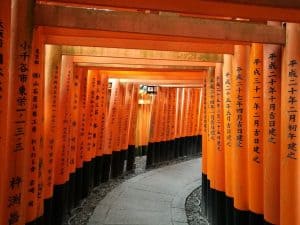
How to use the public transportation in Japan – everything you need to know

How to use a bus, tram or metro in Japan – a simple and helpful guide

How to use a train in Japan – a simple and helpful guide
Enjoy this day-by-day plan included in this map. You can see and save the map locally if you follow this link . You won’t be able to modify it, but you can make a copy and modify that for your needs. Then, just use it as it is when you get there. Convenient, right?
7 days in Tokyo itinerary – Day 1
OK so, are you ready for your week in Tokyo? I can answer this one for you, you are not ready for what it’s about to happen!
First, start with heading to the man-made island of Odaiba. Here, you must spend at least half a day at the Digital Art Museum , which is planned to move to another location in 2023. After you are amazed at this fantastic museum, you can check out a Statue of Liberty, the robot in front of the DiverCity Tokyo Plaza Mall and, I shit you not (you’ll see what I did here), the Unko Museum .
In the afternoon, choose one of these two very cool things to do in Tokyo: either Go-Kart dressed like Mario or visit Disneyland and Disneysea . You won’t regret it, no matter what you choose. If you have any time left, go and check out the Odaiba beach and maybe you can catch a glimpse of the Rainbow bridge.
Day 2 of your 7-day Tokyo itinerary
Start your second day in Tokyo with a very early visit to the Tsukiji Fish Market. You can visit on your own or as part of a tour, and you get to see the fish auction that happens first thing in the morning and you can try some delicious food for breakfast.
- Tokyo: Tsukiji Market Walking Tour & Rolled Sushi Class
- Tokyo: Tsukiji Outer Market Food and Drink Walking Tour
- Tokyo: Classic Tsukiji Food Tour
After the visit to the bustling farmer’s market, you’ll probably enjoy a nice walk in the Hamarikyu Gardens. And if you listen to my advice and visit Japan in November , you’ll get to see the gorgeous fall foliage that makes autumn the best season to visit Japan.
For an unusual activity, head over to the Kabuki-za Theatre to watch a classic Japanese play. You can visit yourself for a whole play, buy a ticket for just an act, or even enjoy a personal tour of the theater , and you’ll get to know this aspect of Japanese culture as well.
Later in the afternoon, head over to the teamLab Planets , another Digital Art Museum that you’ll fall in love with. This immersive experience will have you entering barefoot in the art form, and you’ll have all of your senses impressed by everything you feel. Spoiler alert: you need to wear trousers that you can roll up as you’ll get your feet wet.
And to finish this awesome day, go on a night out and party like it’s your last day on Earth. You can either go on a nightlife tour , enjoy a karaoke evening in any of the special bars or just head over to Roppongi for a party night like nowhere else.

One or two days Hiroshima itinerary – The complete self-guided tour
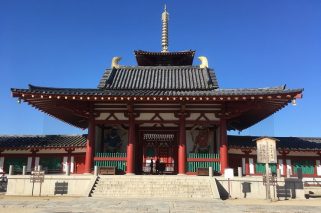
How to prepare for a trip to Japan – checklist included
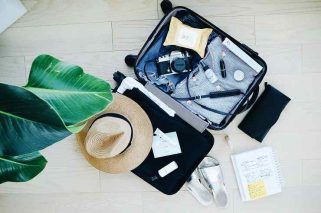
Packing list for 2 autumn weeks in Japan – What to pack for a fall trip to Japan (printable included)
Tokyo 7 days itinerary – day 3.
This will be your traditional Japan day, as you’ll probably want to keep a low profile if you have partied the night before as I kindly suggested. So, first thing, head over to the East Gardens of the Imperial Palace. You have to make a reservation here or you can decide to incorporate the whole day in a private tour that will cover everything for this day.
The other two places you need to visit on your third day in Tokyo are Hie Shrine and Yasukuni Shrine. Hie Shrine is where you must go if you’re not headed to Kyoto during your Japan trip, as it’s quite similar to the well-known Fushimi Inari Shrine you know from the Instagram stories you’ve seen. Yasukuni Shrine is a special place for the Japanese people as it commemorates Japan’s war dead, and a visit here will get you closer to knowing this amazing culture you have decided to know more about.
7 days itinerary for Tokyo – Day 4
Start your fourth day in Japan’s capital city by enjoying a sumo experience in Ryogoku Kokugikan. You can see the morning training, watch a tournament or even try on some moves if you feel comfortable enough.
This is also the day when you start just visiting Japan’s neighborhoods. You’ll start with the traditional neighborhood of Asakusa. You should get to know the rich history of the area and you’ll feel like in an old Japanese movie as you’ll be surrounded by temples, rickshaws, and kimono-wearing people. You must make even a quick visit to the colorful temple of Sensoji, which happens to be the oldest temple in the city.
- Asakusa: 1400-yea r history explor ation
- Asakusa: Cultural & Street Food Walking Tour
- Asakusa: Culture exploring bar visits after history tour
To finish off this full day, head over to the Tokyo Skytree and enjoy a great view of the city. The best view is of course provided by the tallest structure in Japan and the second tallest building in the world, and you get to see the ground that’s so far away by looking through the potentially frightening glass floor.
Day 5 – What to do in Tokyo in a week
You can start the fifth day of your Tokyo trip with a shopping session in Ginza. What to buy, you ask? Well, quite literally anything, Tokyo is a shopping heaven, and for good reason. Most people buy make-up and all kinds of skincare products, electronics, and anything with a blade: manicure sets, knives, cool multitools to have in your car just in case.
To relax a bit after your wild shopping experience, head over to a park or garden and enjoy a picnic. You can choose the Ueno Park, Rikugien garden, or even the Koishikawa Botanical Garden for this activity, and you’ll probably and understandably be tempted to not make a choice and go to all of them. Which does not sound that bad, doesn’t it?
Maybe you’ll think this is not such a good idea, but head over to the Yanaka Cemetery and enjoy the peaceful atmosphere you only get to feel in such a solemn place. Spectacular during sakura, the cherry blossom season, this park includes the tomb of the last Shogun and hosts quite a few kitties.
The last place to visit today will be Akihabara , the place where anime lovers, game fans, and pop culture enthusiasts meet to form a colorful and bustling neighborhood. You might feel this is not so different than the Digital Art Museums you have previously seen, this is how the electric views will make you feel here.

Japan in November – a guide to the best autumn destination
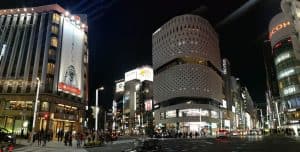
50+ things to know before traveling to Japan for the first time
One week in japan – day 6 in tokyo.
This day will start with a very relaxing stroll in the Shinjuku Gyoen National Garden. After this, head over to the Tokyo Toy Museum or the Samurai Museum and enjoy some cool Japanese cultural references. There are so many cool and quirky museums in Tokyo, it would be a shame not to try at least a few of them!
If you haven’t been to the Tokyo Skytree , you have to see the city from above at the Metropolitan Government Building. It’s not as fancy as Skytree as it doesn’t have glass floors and all that, but it’s a free option to see the views. I wouldn’t say no to that!
In the evening, see if you can go to the Robot restaurant and be amazed at the lights, the music, the show, and probably everything else. You usually have to book it in advance, but for now, it seems that it’s not available anymore. Rumors have it that the food is not that good though, but the show seems to be worth it anyway, so plan to eat before or after if you’re hangry (that’s not a typo haha).
Day 7 in Tokyo – The final day of a week’s itinerary
For your last day, you’ll have to keep it going with a morning visit to the historic Meiji Jingu Shrine in Shibuya, one of the major hubs in Tokyo, and home to the iconic Shibuya crossing. Probably one of the most crowded places in the world, this neighborhood has it all: financial district, shopping, restaurants, and pretty wild nightlife, if you believe the rumors.
To take a short break from all of that, head over to Yoyogi Park for one last stroll through the quiet parks and gardens of Japan. You are going to need it for what’s about to happen.
And last, but not least, Harajuku is the way to finish your 7 day Tokyo itinerary. The home of teenage subcultures, underground fashion scenes, and unexpected cafes, Harajuku is where the cool kids are going and you should too. Try a delicious meal consisting of crepes that you can find at every corner and finish your vacation with a bang. All this sugar is what will keep you going for a while.
Other activities you can try while in Tokyo
I know, this itinerary 7-day Tokyo itinerary is already quite full. But if you’re the sort of person that can cover more in a day than the rest of us, here are some cool tours and activities you can choose from. Hey, you might even decide to replace some of the things mentioned above to make the trip match your priorities, and that’s OK. In the end, this trip is about you!
The first three special tours I would like you to try are quite relevant to Japan. I honestly think you must try all of these activities so you can say “I was, indeed, in Japan”. These activities are: enjoying hot springs , witnessing a Japanese tea ceremony , and going sake tasting .
While visiting the neighborhoods I mentioned in the day-to-day plan, you can choose to do so on a guided tour. These are mostly provided by locals, sometimes even licensed guides, so I’m sure you’ll get to learn a lot of interesting stuff from them. You will also enjoy being able to ask questions and get off-the-beaten-track recommendations. Check some out below:
- Tokyo: Full-Day Private Tour with Nationally-Licensed Guide
- Shibuya & Harajuku: Hidden Gems & Highlights Private Tour
- Discover Shimokitazawa: Tokyo’s Bohemian Neighbourhood
- Tokyo: Mt. Fuji, Hakone, Lake Ashi Cruise and Bullet Train
If you are a big fan of Japanese food (I must admit I’m not, but I’m also the only person I know that’s not a fan so, I think I’m just picky), you will desperately try to eat everything while in Tokyo. Make your culinary dreams come true with a food tour of Tokyo, or choose a cooking class and impress the people back home. Choose what suits you best from the list below.
- Tokyo: Night Foodie Tour in Shinjuku
- Tokyo: Private Japanese Cooking Class with a Local Chef
- Tokyo: Best of Shibuya Food Tour
- Tokyo: Private Eat & Drink Like a Local Tour
- Tokyo: 3-Hour Food Tour of Shinbashi at Night
And if you, for some reason, love ramen, or at least find it quirky enough to be worth your time, you can go on a ramen-tasting tour. Yes, for real. Check out some tours below!
- Tokyo: Ramen Tasting Tour w ith 6 Mini Bowls of Ramen
- Exclusive Tokyo Ramen Kitchen Experience
How much money do you need for 7 days in Tokyo?
Well, as always when it comes to money, it depends. If you exclude air travel, your highest expense will be transportation, if you decide to buy the JR. This is an expense you only make if you intend to also make some day trips, or if you will also go to Kyoto or Osaka (something I fully recommend if you have more time in Japan). Otherwise, do not invest in the JR Pass. Yes, I do get paid if you buy it, but I also want you to buy it only if needed, so make a simulation here before you put your payment details.
The accommodation, as always, you usually get what you pay for. You’ll spend so little time at the hotel, you will probably care less about it than in other places. All of them are extremely clean and safe, so you don’t have to worry about this. I recommend Agoda more than Booking for all accommodation reservations in Asia. It simply provides more options and better prices. But, as always, don’t forget to compare the two: you might have some credit left in Booking that will make your overall price better.
Check out my recommendations at the beginning of the post, and you can even apply one of my money-saving tips (which scored us a room at a 4-star hotel in Kyoto , by the way): book a room in a hotel you’re comfortable in, but take it with free cancellation. One day before the free cancellation expires, check out the prices again. You might find some last-minute deals you can snatch, and you can cancel your previous room without issues.
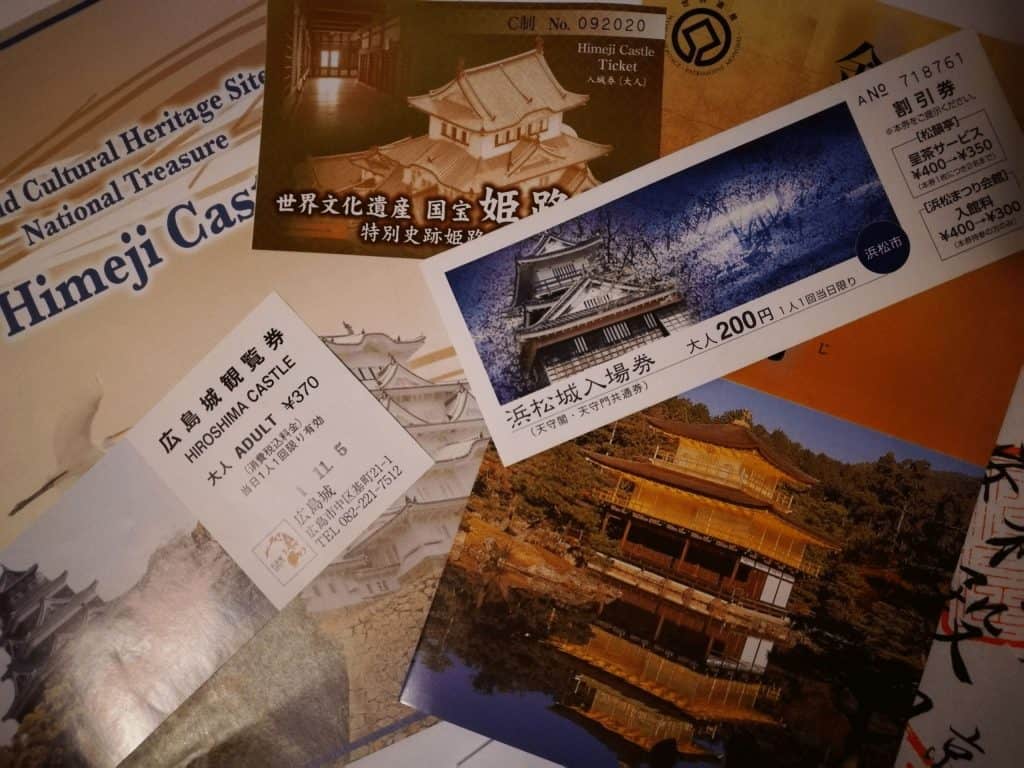
Food is extremely cheap if you don’t go overboard. We usually ate breakfast on the run, buying something from 7-11 every day, especially since we started our days at around 6 AM. Eating on high-speed trains is completely allowed (but not on other means of transportation), so we used this opportunity to eat on the go. After this, we only had one big meal after, usually for dinner, and snacked throughout the day. This not only allowed us to visit more but also kept our budget at a manageable level.
Activities are not that expensive, and some of them are even free, like parks and the Metropolitan Government Building. The most expensive ones, like the Digital Art Museum, I can honestly say were so worth it, I cannot even remember how expensive they were. To help you estimate your expenses, download my Entry fees PDF below, 2022 edition. It contains entry fees from other Japanese cities as well, so it might be handy for the rest of the trip as well (or maybe for a future trip?).
The form you have selected does not exist.
When is the best time to visit Tokyo?
The short answer would be tomorrow. The long answer would be: depends on your needs and situation. For example, in my opinion, early November is the absolute best time to visit Tokyo . It’s less crowded than April when the cherry blossom season is in full bloom (see what I did there?), has nice weather, offers plenty of beautiful scenery as the fall foliage is gorgeous everywhere and it hosts some cool shows and festivals. Read more about Japan in November in my post.
Of course, if you have always dreamt of seeing Japan during Sakura, I won’t be able to convince you otherwise. Keep in mind though that it’s the busiest tourist season, so you’ll encounter crowds everywhere and will pay more for airfare and accommodation.
The other two seasons might seem unconvincing but could be good options if you’re on a budget. Winter in Japan is quite mild, and you can enjoy winter activities if you’re traveling up north. There’s nothing like soaking in a hot spring after a day of hitting the slopes, is it?
The summer is also not so bad: while it is quite hot and humid, the most challenging problem is the higher chance of getting to meet a typhoon up close. This is especially problematic as flights are usually canceled, and if the damage is very bad, trains can be canceled as well. So you might be there for a week and do nothing, or even have your inbound or outbound flight canceled.
Day trips from Tokyo
If you have more days to spend in the area, or you decide to spend the full week just in Tokyo is a bit too much, you can choose to go on a few day trips from Tokyo. The most famous options are the following:
- Hakone – especially if you’re not going to spend a night here in a ryokan, you should visit Hakone for plenty of reasons, seeing Mount Fuji being just one of them;
- Nikko – the Shrines and Temples of Nikko are on UNESCO’s World Heritage List , and they look beautiful in autumn;
- Fuji Five Lakes – there are plenty of opportunities here for photographs, but you can also enjoy hot springs, temples and shrines, hiking, and even a museum dedicated to worshiping and climbing Mount Fuji.
- Yokohama – the old and new combined can be seen here, as this former small fishing village was one of the first to open to foreign trade;
- Kamakura – you can visit plenty of temples and shrines here, including a huge Buddha statue, but you can also head to the beach if you feel you can enjoy a few hours of just hearing the waves;
- Mito – for a beautiful natural landscape, including one of the three best landscape gardens in Japan (Kairakuen Garden);
- Nagano – you can do almost everything here, from visiting temples to enjoying hot springs to going skiing, and I’m not even over yet: you can also see snow monkeys here if the weather is cold enough for them to want to bathe in a hot spring;
- Matsumoto – you can visit the Matsumoto castle, one of the very few original ones, and even a wasabi farm if you feel brave enough.
- From Tokyo: Mt. Fuji Full-Day Sightseeing Trip
- From Tokyo: Kamakura and Enoshima 1-Day Bus Tour
- From Tokyo: UNESCO Shrine and Nikko Scenic Spots Bus Tour
7-day Tokyo itinerary – The takeaway
Phew, this was a long one. I hope you have managed to prepare your week’s itinerary for the Capital city of Japan and that you have got at least a few helpful ideas for your trip. I’m sure now you know what to do in Tokyo, Japan for a week, and some other useful information to plan your trip. Until next time, I wish you “Happy travels!”
2 thoughts on “7-day Tokyo itinerary – What to do in Tokyo, Japan for a week”
- Pingback: 25+ myths about Japan (and whether they're true or not)
- Pingback: Onsens in Japan - Rules, tips and everything you need to enjoy a hot spring in Japan
Leave a Comment Cancel reply
Save my name, email, and website in this browser for the next time I comment.

- January 4, 2020
- Travel Japan
With the neon lights, busy streets and quirky culture, creating a Tokyo 7 day itinerary for travel can be a little tricky.
You have one week in Tokyo, but there’s so much to see and do – how do you choose to spend your time?
With a population of 38 million, Japan’s capital city is the largest in the world (by population). There are almost as many things to do in Tokyo with 7 days – that’s where this post comes in.
Follow this week itinerary for Tokyo and you’ll zoom the chaotic streets in a go-kart, learn the ancient history of Edo and see some amazing city-scape skylines (night time is unreal).
Before we get into it, this Tokyo travel itinerary – who is it for?
Who is this travel Tokyo 7 day itinerary for?
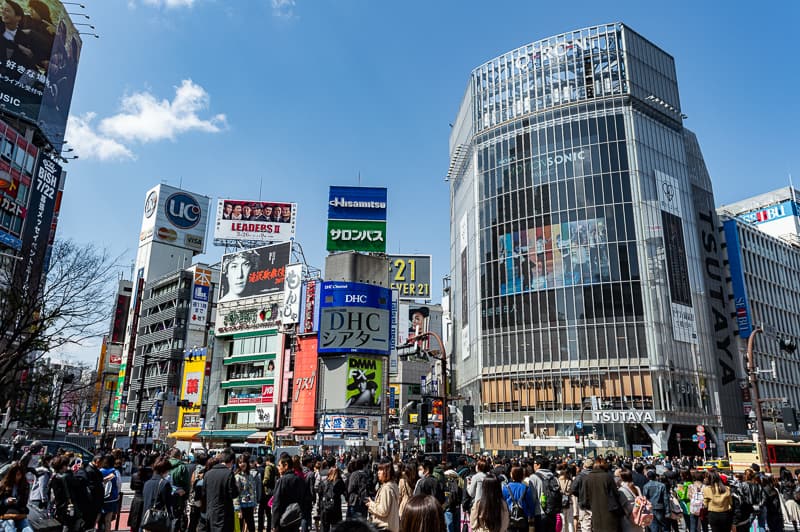
There are countless ways to spend a week in Tokyo. This itinerary of Japan’s capital runs through quite a lot – you’ll be busy soaking in the sights and eating delicious food – all while being on a budget.
Horizon Unknown is all about budget-minded, responsible travel that gives travelers a rich experience.
So if that sounds like you, let’s get going with 7 days in Tokyo!
Getting to Tokyo from the airport (Narita and Haneda)
99% of international travelers to Tokyo will come through one of two international airports that service this busy city – Haneda and Nartia.
While both airports fly international routes, they are in different parts of the city. It’s a 77km (48 mile)drive between the airport and takes about an hour. So knowing which Tokyo airport you fly in to will be super important.
Narita airport to Tokyo city
Narita airport is located 71km away from downtown Tokyo, which makes the journey a little longer. There are multiple ways to get into Tokyo from Narita airport.
Train – The train from Narita to Tokyo is operated by Keisei Skyliner, costs 2,370¥ ($22 USD), and takes around 45 minutes to arrive at Keisei Ueno Station in Tokyo. You can book your ticket easily and ahead of time at the link above.
If you’re thinking about catching lots of trains in Japan, you could save a lot of money through the Japan Rail Pass.
Narita Shuttle Bus is another option, that costs 3,900¥ ($36 USD).
If you’re thinking about catching a taxi from Narita airport into Tokyo, think again. The cost is said to average around $200-300 USD! That’s 20,000+ ¥.
Haneda airport to Tokyo city
Haneda airport is much closer to Tokyo – you’re looking around 26km to downtown, and this can take about half an hour. Some of the routes require multiple train connections, depending where in the city you want to get to.
Haneda airport is serviced by the Keikyu Airport Line and the journey takes around 20 minutes from Shinagawa Station, 410 Yen (¥).
Foreword on Tokyo 7 day itinerary

Please note: Some links below are affiliate links. I earn a small amount through certain purchases you make, this does not increase the cost for you and helps support this site.
Depending on how long you have in Tokyo and how energetic you’re feeling, the first and final day of 7 in Tokyo will be a slower one – I know that jetlag can be a pain!
Feel free to juggle any sights or activities from day to day, or skip/add places to visit in Tokyo. Just let me know how you found it all in the comments below.
If you’re nervous about your upcoming trip – read up on culture shock in Japan and how to adapt to these different cultures.
With that said, let’s get into 7 days in Tokyo itinerary!
First day in Tokyo
I know when I flew into Tokyo, it was around lunchtime and I just got off a long flight. Even though I wanted to see more in my first day in Tokyo, jetlag got the better of me.
That’s why the first day in Tokyo of 7 is relaxed and pretty short – remember, you can always add things from the “extra things to do in Tokyo” near the bottom of this post.
Tokyo Tower
First up, one of Tokyo’s most visited icons, the Tokyo Tower. It’s a popular attraction in Tokyo, so if you’d like to not wait in line to get up to the observation decks, begin this 7 days in Tokyo itinerary at opening time if you can – 9am!
Standing at 330meters tall, this tower is modeled from Paris’ Effiel Tower in France. The bright colors of white and orange are for air safety regulations.
Directly beneath the tower are not only the elevators to the observation decks, but coffee shops and museums are also the 4 story building. Tokyo Tower is open from 9am to 11pm, 7 days a week and costs
You can book your Tokyo Tower ticket online to save the lines.
Mari-kart through the streets of Tokyo
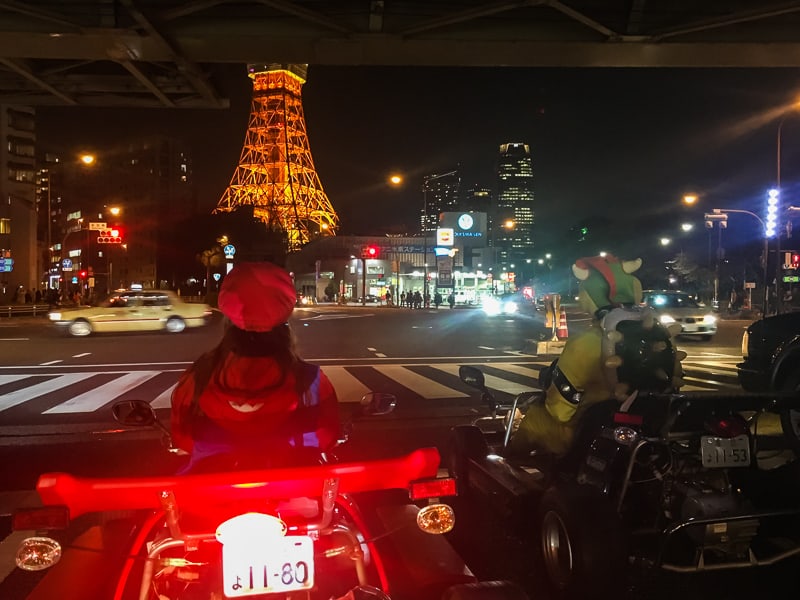
If you want a super unique and fun thing to do with 7 days in Tokyo, don’t miss out on Mari-Car!
Inspired by the video game Mario Kart, you take to the streets of Tokyo in a go-kart. That’s right, you can drive in Tokyo on a go-kart. And it is every bit as exciting as it sounds.
You’ll want to get in touch with Mari-Kart and book a spot early as it does sell out, or you can book online . There are multiple tracks to choose from depending exactly when you want/can zoom around the busy streets.
If you can, driving at night is an unforgettable experience. On some tracks, you’ll visit the Tokyo Tower, which is shining a bright orange hue every night.
If you can’t miss out on one thing in Tokyo, its Mario Kart! You’ll even get to dress up as your favorite character as you explore the city.
Second day in Tokyo
Tour tokyo’s imperial palace.
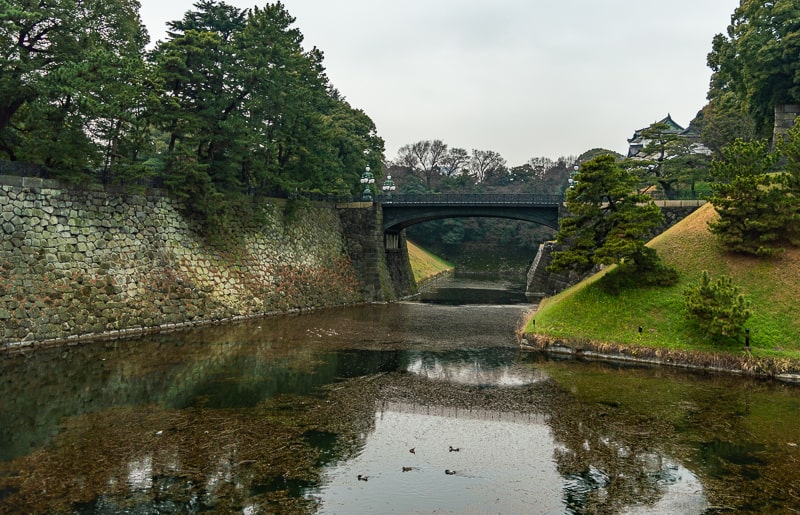
The second day of 7 in Tokyo begins at the Imperial Palace – a short 10-minute walk from Tokyo Station.
Covering 3.3 square kilometers (1.3 sq miles), the Imperial Palace of Tokyo is full of history and cultural significance just waiting to be discovered.
Inside the complex are tours of the main areas, available for free, as well as a number of hanami – cherry blossom viewing spots.
Edo Castle, with the remains inside of the complex walls, is one of the most significant buildings in all of Japan. Built in 1457, Edo Castle (or Chiyoda Castle) became the military headquarters of the Tokugawa Shogunate.
Tokyo’s Imperial Palace is both a beautiful and culturally significant to the history of Japan – plus if you’re in cherry blossom season (end of March to start of April) you’re in for a special sight.
You can book a wide range of Tokyo Imperial Palace Tours when you’re planning your adventure.
Nihombashi Tourist Information Center
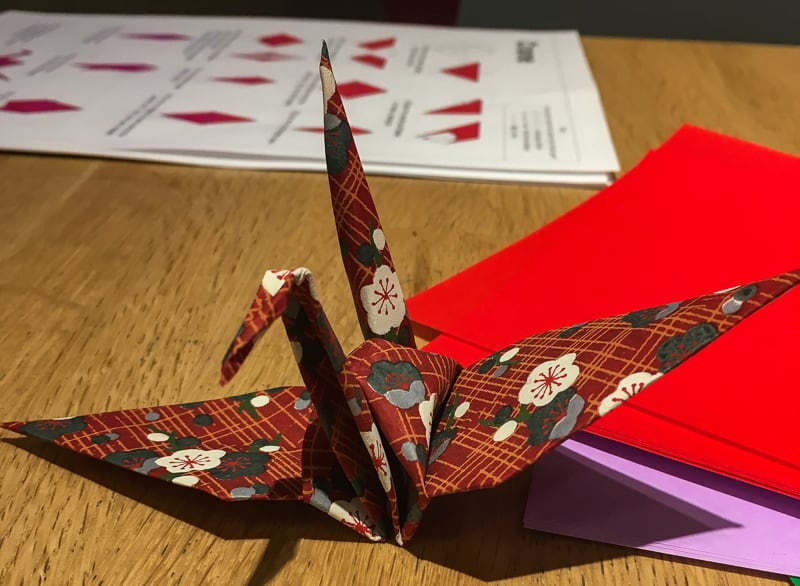
The Nihombashi Tourist Information Center isn’t a stop you’re likely to see on mmany7 days in Tokyo itineraries, but its one of my favorite stops in the city.
While they do offer maps and information about the surrounding area, this isn’t you’re average information Center.
The Nihombashi Tourist Information Center offers a range of tours and activities. I took a small origami lesson for 500 Yen here and learned how to create 3 pieces of origami, including a crane, samurai helmet or kabuto and a kimono.
You can try kimono’s on here or have a tea ceremony. There are plenty of things to do at Nihombashi Tourist Information Center.
Ozu-washi Paper Factory
Another lesser-known activity in Tokyo but memorable none the less – it is a little different. Ozu-washi Paper Factory creates mino-washi paper. Good origami paper and those sheets of paper across doors in some Japanese houses are all forms of mino-washi paper.
Here you can learn about the in-depth process of creating high standard mino-washi paper, and even create a sheet of your own!
Nihombashi Tourist Information Center also booked this tour and was another 500 Yen, per person.
Third day in Tokyo
Samurai museum.

Today begins a little later as this museum opens at 10:30am, but is well worth the visit.
If you’re looking to learn about the history of samurai that has shaped much of Japan, the samurai museum in Tokyo is a perfect stop.
From artwork to swords and even guns, armor and the stories behind it all, the samurai museum gives a history lesson inside the 7-day itinerary of Tokyo.
Included in your entrance fee of 1,500 Yen is a tour guide, performance by a trained samurai actor and so much information about the history of samurai, Tokyo and Japan in general.
It’s a great place to start your 3 rd of 7 days in Tokyo.
Kabuki Performance
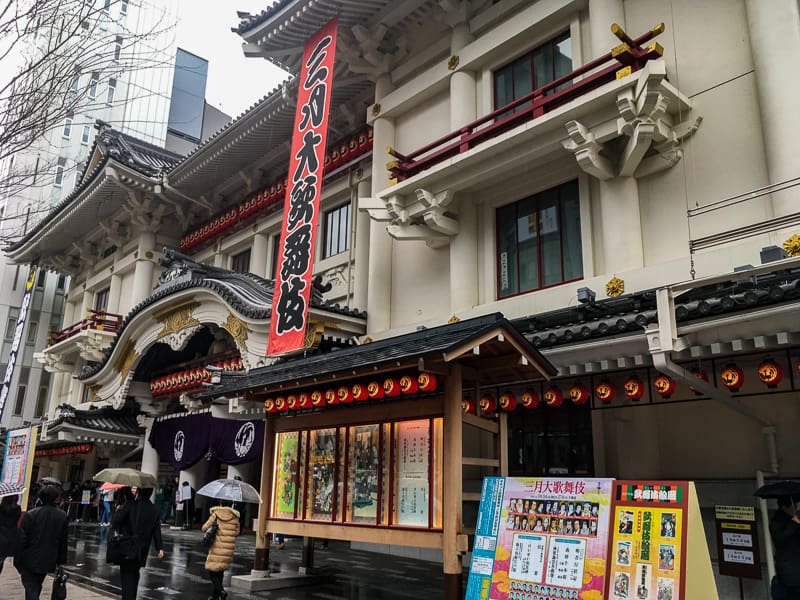
Kabuki is a popular style of theater in Japan and you can get easy and cheap Kabukiza Theater tickets in Tokyo.
There are a number of vendors and vending machines selling tickets throughout the building. Your cheapest option for Kabuki theatre in Tokyo is a single session in the standing section. There’s no need to reserve tickets beforehand, but keep in mind, things still may sell out in peak times.
Depending how many acts you’d like to watch, performances of this one-of-kind quirky, Japanese drama can last hours. Or you can just stay for the single act, lasting around 40minutes, to 1 hour – and standing for an hour straight was enough for me.
You can get more expensive seating arrangements and restaurants are located inside the theatre for lunch.
Tokyo Metropolitan Government Building
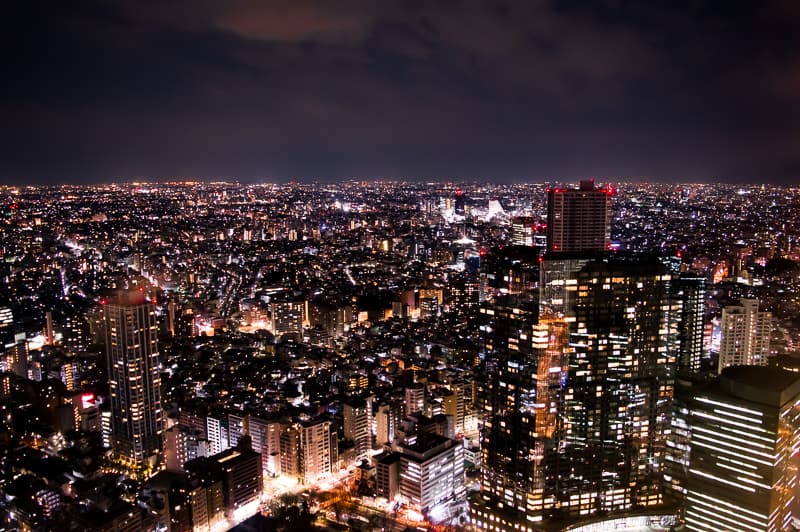
One of the best viewpoints in Tokyo. The Tokyo Metropolitan Government Building is free to enter and gives a stunning cityscape view of the city as it stretches off into the horizon.
Not only are the two observation decks free to enter, the observation decks at 202 meters high, alternate between the north and south observatory on a daily basis.
I highly recommend visiting the Tokyo Metropolitan Government Building at night – the night time view, with seemingly neverending glistening lights is mesmerizing. Tokyo is huge!
A Side tip, if the weather is nice and the sun is shining, it’s possible to see Mount Fuji off in the distance!
Fourth day in Tokyo
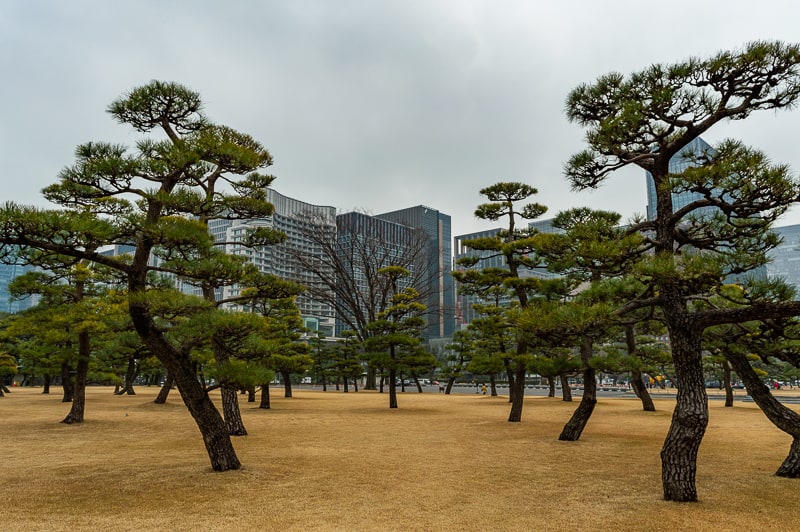
Sensoji Temple
Sensoji Temple, or Asakusa Kannon Temple, is one of Tokyo’s most visited Buddhist sights.
Building of Sensoji Temple was completed in 645, making it the oldest temple in the entire city. That may explain why a classic symbol of Tokyo is the front gate, Kaminarimon Gate, or Thunder Gate, of the Sensoji Temple Complex.
Leading to the second gate, known as Hozomon Gate, is lined with shops along the 200 meter stretch of path. Just beyond is Asakusa Shrine, the main building, and an ornate 5-story pagoda.
From Tokyo Station, take the JR Yamanote Line to Kanda Station. You can get there early, as the temple grounds are always open, and the main hall is open from 6am to 5pm. There is no admission fee to enter Sensoji Temple.
Sumida Park – Cherry Blossoms
Sumida Park is a popular stretch of green and trees inside Tokyo – especially if you’re visiting in Tokyo’s cherry blossom window – cherry blossoms are in full bloom (known as mankai) around April 2 nd , but can be seen a week either side of that.
If you’re visiting Tokyo for cherry blossom season, known as hanami, you’re in for a beautiful sight. But plan and book ahead – as this is a very busy time throughout Tokyo.
No matter the time of visiting, Sumida Park is an easy and enjoyable walk right along the Sumida River. The park is a short 5-minute walk from Asakusa Station.
The good part is, you’re close to the last stop for the day – Tokyo Skytree.
Tokyo Skytree
The world’s tallest tower and second tallest building stands at 634m high. This broadcasting tower doubles as an observation deck and restaurant.
Visiting the observation decks in the Tokyo Skytree is another great way to get an Aerial view of Tokyo.
- The first observation deck is situated at 335m high and costs 2060 Yen to visit.
- 100 meters higher (450m) is the second observation deck and costs an extra 1030 Yen.
If you don’t want to wait in the line, you can buy your tickets online to the Tokyo Skytree.
Fifth day in Tokyo
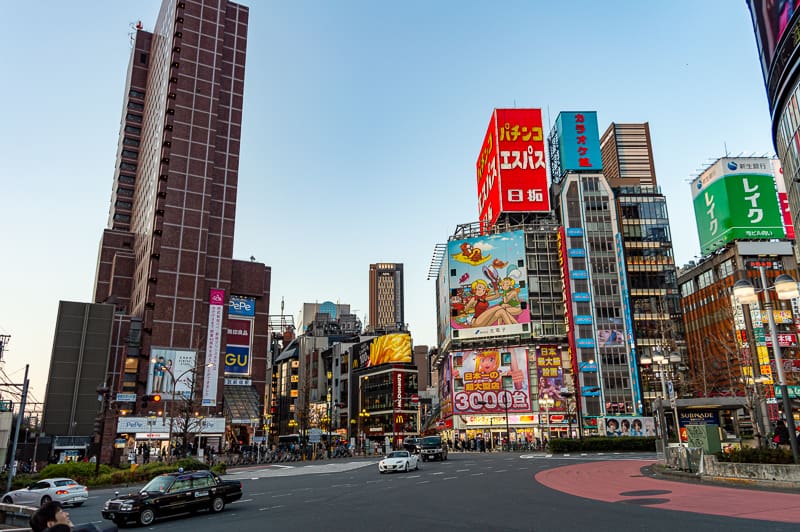
Hamarikyu Gardens
Just across the road from Tokyo Train Station sits Hamarikyu Gardens. Being right on the waterfront it’s a scenic walk with waterways and lush greenery.
In the 1uth century, a Shogun Villa was built and is a peaceful walk with ponds. It’s easy to feel outside one of the busiest city’s on the planet walking around the tranquil setting.
while children are free, entrance fee for adults is around $5 USD, but it is worth it to unwind it from the busy streets of Tokyo.
Taiko Drumming Lesson
Taiko drumming is a Japanese style of drumming and it’s one of those experiences that you’ll never forget – especially if you’re the butt of the jokes on your lack of rhythm like I was (they were light-hearted jokes at least).
If you’re looking for the best Taiko Drumming experience in Tokyo, you need to head to E-Hougaku Studio .
This is more of a local Taiko Drumming studio in Tokyo, where regular classes happen and the students are from around the suburban area near Tokyo – and of all ages, from children to seniors.
The people made there were welcoming and genuine. It made it really easy to learn, even if my rhythm let me down most of the time.
Cat café – Calico
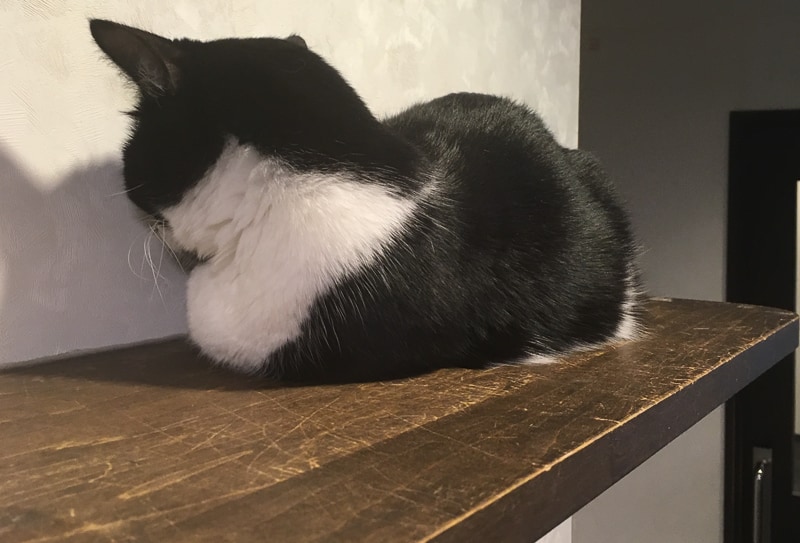
Animal cafes in Tokyo are immensely popular. There is a café with so many different animals, but the cat café seems to be the most popular – as there are plenty of them.
One thing I was concerned about is the treatment of the cats in these cafes. From my experience, these cats did what cats regularly do, sleep. While a few were awake and wondering, none seemed too active and enjoying their day time cat nap. While you are able to fee some cats if you wish, be careful as a colorful scarf can mean dietary restrictions due to health issues.
Calico Cat Café is in Shinjuku and opens from 10am to 10pm, with a small café providing drinks.
Sixth day in Tokyo
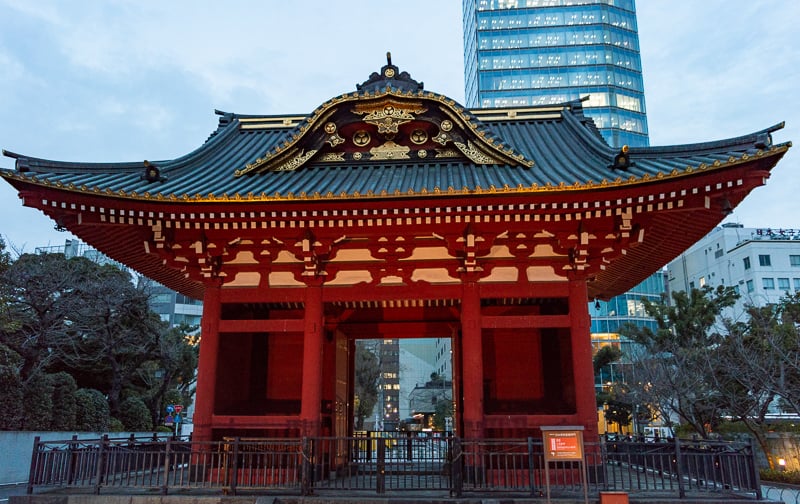
Michelin Star Ramen Tsuta
Time for one of my personal favorite things about Japan – ramen. Yeah, first thing in the morning can be little different, but if you want to try Tsuta ramen, the very first Michelin Star ramen restaurant in the world, you need to get here early.
While they open their doors at 8am, you’ll need to get here a little earlier, as the line up can begin as early as 7am. You’ll hand over 1000 Yen and be given a time slot to return later in the day. It’s not the easiest bowl of ramen you’ll have, but it is well worth the effort.
For around 1200 Yen, you’ll be served Tsuta Ramen’s signature dish. Tsuta ramen is made with all fresh ingredients and limits its daily serving size to around 70 bowls a day – so that’s not many available spots at the 9 people bar-style seating – that’s why getting to Tsuta early is necessary!
Ueno Park is a popular place to visit in Tokyo for a number of reasons. Multiple museums, including Tokyo National Museum and the National Science Museum, are within its grounds. There are also over 1000 cherry blossom trees that create a memorable sight for around 2 weeks a year inside this public park.
There are a few temples inside Ueno Park, including Kaneji Temple, formerly one of the wealthiest temples during the Edo Period.
The easiest way to get to Ueno Park is by metro. Head to Ueno Station and take “Park Exit” and you’re right there. The park closes its doors at 11pm at night and is free to enter.
Koishikawa Botanical Garden
This lesser-visited botanical garden in Tokyo is home to thousands of species of plants and trees – including a number of different cherry blossom trees. Making this a great, but rather less popular spot for hanami, or cherry blossom viewing.
This beautiful Tokyo botanical gardens are owned by Tokyo University, and is a short 15-minute walk from either Myogadani Station or Hakusan Station, on the Marunouchi Subway Line and the Mita Subway Line respectively.
Edo-Tokyo Museum
This unmistakable building in the Ryogoku District houses a lot of information about the past and present of Tokyo.
You’ll find plenty of historical and cultural information on how Edo, and now Tokyo came to be. Through various displays, there is a wide range of topics to learn about, from politics to architecture and everywhere in between.
Known as Edo until 1869, Tokyo is undoubtedly full of history, both ancient and modern. You can get a free guided tour of the Edo-Tokyo museum from a volunteer from 10am to 3pm and opens its doors from 9:30am to 5:30pm with admission costing 600 Yen. You can reach the Edo-Tokyo Museum by a 5-minute walk from Ryogoku Station.
Seventh day in Tokyo
Explore harajuku.
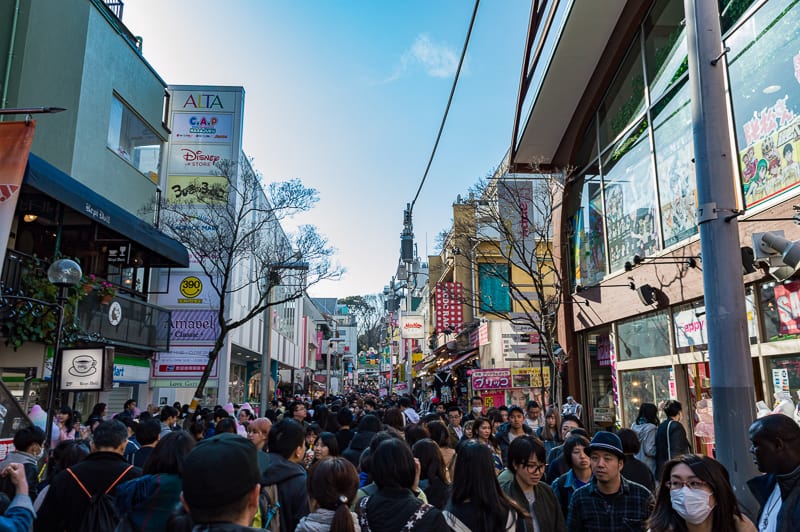
The suburb of Harajuku in Tokyo is super popular for a number of reasons – quirky cosplay and unique shopping down Takeshita Street, Street art bursting with color and is widely known for its youth culture and fashion.
Along with boutique and vintage shops, unique bars are dotted around the streets of Harajuku. This popular district in Shibuya is lined with places of interest you would struggle to find similar places in Tokyo, let alone the rest of the world – it is truly one of a kind.
The next attraction in this Tokyo 7 day itinerary is just a stone’s throw away.
Meiji Jingu Shrine and Yoyogi Park

Dedicated to Emperor Meiji, Meiji Jingu Shrine was completed in 1920. Meiji Jingu Shrine is one of Japan’s most popular shrines in the entire country – with the first few days of the new year seeing around 3 million visitors!
The shrines main complex of buildings is marked by a giant wooden torii gate and surrounded by thousands of trees making up Yoyogi Park.
Around Meiji Jingu Shrine lies Yoyoji Park – with the shrines located inside the park grounds itself. While the shrine itself is free to enter, the inner gardens cost 500 Yen – you can visit from sunrise to sunset. The easiest access point is the busy Harajuku Station – it’s basically in the Yoyogi Park grounds.
Shinjuku Gyoen National Garden
Shinjuku Gyoen National Garden is one of Tokyo’s most visited parks – especially during the springtime when more than 400 cherry blossom trees bloom.
With the origins of the park dating back to 1603, it was converted into the botanical gardens you see today almost exactly 3 centuries later when the complex transferred to the Imperial Family of Japan.
Shinjuku Gyoen National Garden reopened in 1949 after it was severely damaged during the Second World War.
Admission to Shinjuku Gyoen National Garden is 500 Yen, and opens from 9am to 5:30 – 7pm (depending on what time of the year you’re visiting).
Extra things to do in Tokyo with 7 days

If you have a little more than 7 days in Tokyo, you might want a few extra things to do. You can swap the sights and activities below for many things in this 7 days in Tokyo itinerary.
Pachinko slot machines
This is an activity that isn’t for everyone, but I had a fun time nonetheless.
Pachinko is a sort of slot machine. They are commonly in a sort of pachinko hall and sometimes have hundreds to thousands of machines. You pay a little money and get a bucket of tiny steel balls (similar to ball bearings). You throw them into the top of the machine and the ball bounce off things inside the machine.
The downside, these places are incredibly noisy and smoking is allowed indoors (at least the one I visited). The noise is constant from the huge popularity of the game, and the smoke can be quite thick.
Still, pachinko is an option to add to your week itinerary of Tokyo if you’re looking for something more.
Tokyo Pokemon Megastore
I get it, Pokemon isn’t everyone’s cup of tea. But I still had a lot of fun – even though there were a lot of new generations of catchable monster that I had never heard of.
Apart from plush dolls, backpacks, pencils and plenty of other items to remember your visit, you can also battle through an interactive game – and get your Pokemon printed on a plastic disk to keep and battle with next time.
Experience Geisha in Tokyo
Looking for an extra dose of Japanese culture in Tokyo? A Geisha Performance might be exactly what you’re after.
These professional Japanese performers are skilled in dance and singing while playing some traditional games along the way. A night of entertainment with a Geisha can easily run into the hundreds of dollars, after all, they are well trained in many arts.
During my time in Japan, finding a Geisha performance wasn’t too easy (at least one I could afford), but there are ways to book online before you even get to Japan – and come highly recommended.
Where to stay in Tokyo on a budget
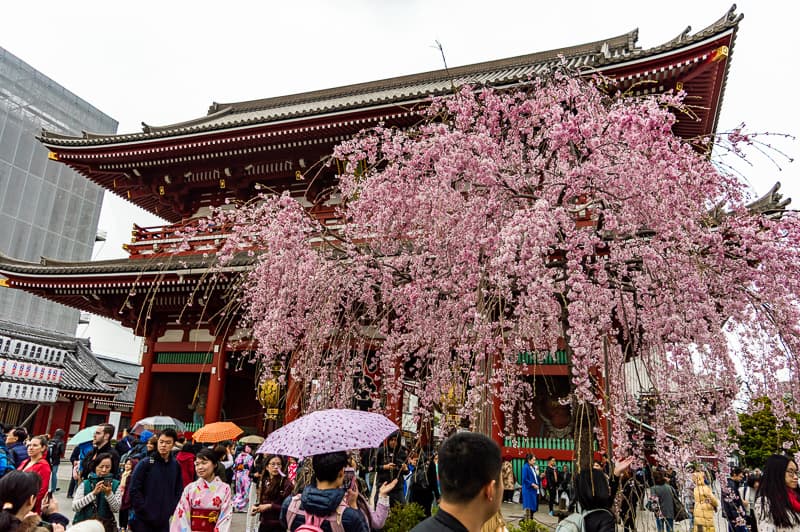
There are plenty of budget accommodations within Tokyo, from hostels dormitories to cheap hotels. You don’t have to search hard at all, and don’t need to sacrifice safety or comfort for a cheap night stay in Tokyo.
I hopped to and from Tokyo 3 times in my 3 months in Japan and stayed in a different place each time.
Japanize Guest House
From 2,600 Yen/$24 USD – 8.5/10
A short walk from Bakurocho Station, Japanize Guest House is a quiet, comfortable and clean hostel near downtown Tokyo. Many places of interest in this 7 day itinerary of Tokyo are within close distance – the Edo-Tokyo Museum is one stop from this hostel.
Citan Hostel
From 3,200 Yen/$30 USD – 8.8/10
Citan Hostel is just down the road from the above guest house, but is also a highly rated, pretty affordable hostel room in Tokyo.
If you’re looking for a more private setting, Citan Hostel in Tokyo offers a number of different private rooms. Citan Hostel is attached with a café and a great place for a non-binding machine coffee.
Sogihostel Beehive
From 1,220 Yen/$11 USD – 7.2/10
There is a couple of very good reasons why Sogihostel Beehive has made it into the Tokyo 7 day itinerary.
- It is one of, if not the cheapest, highly rated hostels in Tokyo
- If you’re going to wake up early to visit Tsuta Ramen, this is the closest hostel – easily within walking distance.
Summary of Tokyo 7 day itinerary
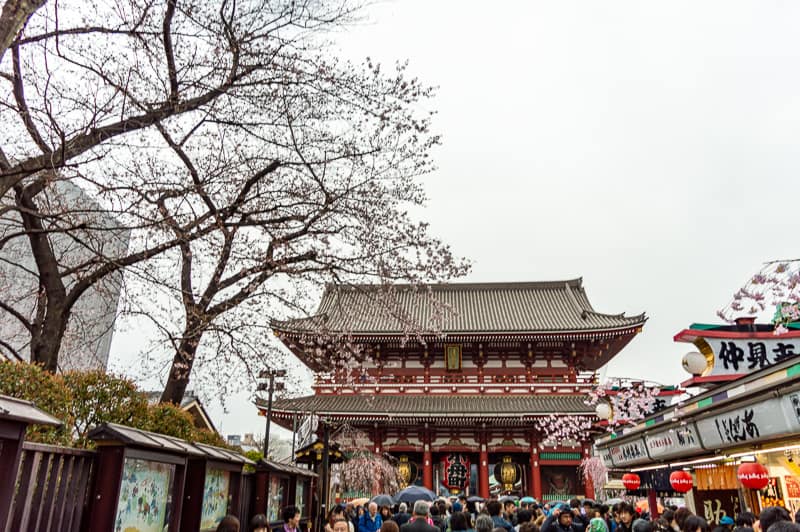
7 days in Tokyo will never be enough to cover this vast, ancient and often quirky city in Japan. There is just too much to see, do, eat and drink in the busy, bustling streets of one of the world’s largest citys.
There is always going to be something better, or more unique to add to a Tokyo itinerary of 7 days, so I’d love to hear your thoughts.
What is this Tokyo 7 day itinerary missing? What should be cut or replaced?
After 7 days in Tokyo itinerary – what now?
- Get more travel tips by following Horizon Unknown by regular emails – plus get a free travel checklist!
- Share this seven day Tokyo itinerary on social media – help people find great things to do in Tokyo!
- Read this post again later and/or offline by downloading the PDF version of 7 days in Tokyo guide – just click the big orange button below!
Thanks for reading!
Happy and safe travels,
Ben – Horizon Unknown

Leave a Reply Cancel reply
Your email address will not be published. Required fields are marked *
This site uses Akismet to reduce spam. Learn how your comment data is processed .

BEST Tokyo itinerary 7 days suggestions for Tokyo + surroundings
By: Author Sylvia
Posted on Last updated: January 28, 2023
Are you looking for the best 7-day Tokyo itinerary for your trip to Japan? Then we have the must-see attractions and the must-know information for you.
There is a really good chance that this post contains affiliate links. If you click one of them, we may receive a small commission (for which we are deeply grateful) at no extra cost to you.
Table of Contents
Insider tip: Is this your first Japan trip and are you feeling a bit overwhelmed about planning this trip, what to see, and what to do in Japan? Check out our Japan travel planner. This document will help you plan your trip smoothly.

Tokyo Essentials
- We have always found the best flights to Tokyo or Osaka on Momondo . You also have Skyscanner and recently WayAway , a new and promising travel aggregator, has popped up. It may be worthwhile to compare these three sites.
- Don’t lose time upon arrival at the airport and order your Japan travel SIM or portable WiFi device in advance so that it’s ready and waiting for you at the airport when you arrive.
- We’ve got you covered if you’re wondering how to use public transport in Tokyo.
- If you are traveling around Japan, having a Japan Rail Pass is often the cheapest way to travel around.
- Discover the best area to stay in Tokyo. Or have a look at these cool hotels in Tokyo if you are looking for a special place to stay while you are in Tokyo.
- Ryokans with private onsen in Tokyo .
- Best Ryokans in Tokyo
- If you prefer staying in an onsen hotel in Tokyo, click here.
- We created an overview of the best Airbnb in Tokyo for those who prefer staying in a rental property. Are you traveling with your family or a bigger group? Here is an overview of the best family Airbnbs in Tokyo.
- Check out our ultimate Japan travel guide where you can find all our Japan articles.
- Be sure to become a member of our Japan Travel Planning and Tips Facebook group. The purpose of this group is to help you plan an amazing vacation to Japan. You can ask questions and exchange tips with fellow travelers.

7-day Tokyo itinerary
Below we share a few sample itineraries that give you an idea of what you can do and see when you have 7 days in Tokyo.
Option 1: Spend 7 days in Tokyo
7 days might sound like a lot for Tokyo but it really is not.
You can easily spend 7 exciting days in the capital. If that sounds like a plan to you, then we know exactly what to do.
Wondering what to do in Tokyo for 7 days? Check out this complete one-week in Tokyo itinerary.
Tokyo itinerary
You may already have come across our Tokyo 5-day itinerary .
This is an excellent start to your stay in Tokyo. With so much packed into these first 5 days, you can already check off several highlights of the capital.
But don’t worry, there’s still more than enough to do. Here we will focus on the last two days of your Tokyo 7-day trip.
Tip: Bear in mind that this article provides popular suggestions for first-time visitors to Tokyo. There are literally too many places to mention in one article. Therefore, don’t be afraid to walk off the beaten path and explore a bit. Japan is a very safe country and you never know what you might find around the next corner.

We start our day by heading to the district of Kuramae where you find the Kuramae Shrine just west of the Sumida River.
Kuramae Shrine
This shrine dates from 1694.
Whether it’s for rakugo performances (the traditional Japanese art of storytelling) or just to admire the historical beauty of the shrine, the Kuramae Shrine is one of the most beloved shrines in all of Japan.
It is a wonderful place for self-reflection, quiet scenery, and learning about Japanese history.
The Kuramae area is not very large but has a strong history in Tokyo.
Want to take some unique pictures at the Kuramae Shrine?
Dress up in a colorful Kimono and take some unique and memorable shots to take home. There are tons of kimono rental shops in neighboring Asakusa. The area has around sixty kimono shops that you can explore.
Remember that kimonos are often very expensive, so being able to spend the day in one while getting pictures is a real treat.
Most shops will allow you to choose your favorite colors and designs and you usually can rent the kimono for the day.
Some have more extravagant offers that include a hair-styling, makeup, and sometimes even a photo shoot by a professional photographer.
If you have the time you can wander around the Asakusa area to compare the prices but it’s also possible to arrange your Kimono rental in advance online .
Check prices and availability: Kimono rental
How to get there
Take the train to the Kuramae station.
The station is served by the Toei subway line. You can use both the Asakusa line and the Oedo line.
Learn more about navigating Tokyo’s public transport here.
After our visit to the shrine, we move south toward our next destination.
Take some time to admire or have some lunch at Kuramae Park on your way to the Kuramae Bridge.
Crossing the Kuramae Bridge will also provide an amazing view of the Sumida River and Tokyo.

Japanese Sword Museum
Looking to immerse yourself in Japanese history?
Check out the Japanese Sword Museum collection just across the Kuramae Bridge.
The museum has three floors of historical swords made by some of the finest sword makers in the country.
Once you’ve crossed the bridge make a right. The museum is on your left after the first block.
There are a few options when it comes to getting to the museum.
by train: To access the Japanese Sword Museum by JR, take the Sobu line and get off at the west exit of Ryogoku Station. The museum is about a seven-minute walk from there.
by bus: If you are taking a bus, get off at “Kyu Yasudateien-Doaikinenbyoin” and walk for about one minute.
Both of these options are very close to the museum.
Entrance fee: only 1000 yen per adult (about $10) for admission.

Go watch a sumo competition
The wondrous sword museum is located not far from the Ryogoku Kokugikan Stadium.
This stadium is considered the country’s holy center when it comes to sumo wrestling, Japan’s national sport.
It has been a traditional sport since the early 17th century and is pretty synonymous with Japan.
The Ryogoku Kokugikan is the home of sumo and provides some of the finest displays of sumo wrestlers.
Built-in 1985 it can seat over 10,000 visitors.
The sumo season happens three times a year in January, May, and September.
At those times the Ryogoku Kokugikan is host to national sumo tournaments and brings back the traditional atmosphere of early Japan.
Each tournament lasts for 15 days, meaning if you are in town during a tournament, there should be tickets available.
When and where to buy tickets :
Tickets for grand tournaments go on sale at least a month in advance and you can buy them online.
Keep in mind that sumo tickets are not cheap and if you don’t want to end up in nosebleed seats you might need to dig deep in your pocket, but if you can swing it, you won’t want to miss watching sumo in the Ryogoku Kokugikan.
If you will not be traveling to Japan while there is a professional tournament, some sumo stables (houses where wrestlers train and live together) allow visits to view their morning practice sessions.
How to get there?
This is an easy destination to reach, especially if you are using the JR line. JR has a station right at the entrance of the stadium, the Ryoguku station.
You can also get there with the Oedo subway line. The station is also named after the stadium, it is also really close by, but requires a slightly longer walk.

Edo-Tokyo Museum
History buffs shouldn’t miss this museum which often tops the list of Japan’s best museums.
The best thing about this museum is that it is very educational but you don’t get the feeling that there is an information overload.
That is achieved by loads of interactive displays, a few stunning real-size replicas of old buildings, and several other huge models.
Yet, this is not your traditional museum. The information is shared in an entertaining way that keeps both young and old engaged.
Despite its name, the museum also has exhibits about Japan’s more recent history such as the World War.
For the best experience, we recommend exploring the museum with one of the free tour guides. They’re waiting at the entrance and they will be happy to guide you around. Allow at least 2 hours but it is even better to spend 4 hours in this excellent museum.
The museum is right next to the stadium. Take the JR or Oedo line to the Ryoguku station.

Day 7: Odaiba and the Rainbow Bridge
The last day of this Tokyo itinerary starts with a trip to the Odaiba district.
Back in the 1990s, this land was taken back from the depths of the Pacific Ocean and became home to huge entertainment. And we mean huge!
The Gundam Statue
The Gundam statue is a giant statue outside of the DiverCity Tokyo Plaza mall.
It stands at an impressive 59 feet high (18 meters).
Based on the popular manga and anime series, this Gundam emits light, moves its head, opens its chest, and sprays mist from it.
If you make it there between 5-11 pm, the entire Gundam robot is even illuminated.
Seeing it after dark definitely adds the extra wow factor. An added advantage is that the statue is located next to a huge shopping center, with not only shops but also restaurants where you can have dinner.
In order to get to the Gundam Statue, take the train to the Odaibakaihinkoen Station on the Yurikamome Line or Tokyo Teleport Station on the Rinkai Line. From there, it is very close by.

Rainbow Bridge
The Rainbow Bridge is a suspension bridge that crosses Tokyo Bay. It stretches from the Odaiba waterfront all the way to Shibaura Pier.
The supporting towers are white to complement the gleaming white towers of Tokyo’s skyline. A walk across the bridge is an ideal way to see the more scenic side of Tokyo.
As long as you are there between 9 am and 9 pm in summer, or 10 am and 6 pm in winter, you can utilize the walkways, which offer amazing views of Tokyo harbor and the Tokyo Tower.
If the weather is clear you can even see Mount Fuji from here.
Once the sun sets the bridge is lit in a variety of different colors.
If you are coming from DiverCity Tokyo Plaza, then you will be within walking distance of the Rainbow Bridge.
To get there by train you take the JR East train to Tamachi Station or the Yurikamome line to Shibaura-futo Station. Both stations are on the city side of the bridge.

Tokyo Tower
Tokyo Tower is another popular attraction in Tokyo.
This incredible red and white spire looks a lot like the Eiffel Tower of Paris.
The tower is mainly used as an antenna for radio and television broadcasting but it is also a popular tourist destination.
The tower houses 2 observation decks, one at 150 meters and the top deck at 250 meters. When you get to the top, it offers a wonderful view of Tokyo. Tokyo Tower is certainly one destination that you do not want to miss.
For the top deck you need to make an advance reservation and you will be assigned a dedicated timeslot. You can book your ticket below, make sure to choose the top deck tour package.
Check prices and availability: Tokyo Tower – Skip the line
If you are coming from Rainbow Bridge, take the Yurikamome line and transfer at Shiodome Station.
The transfer is about a four-minute walk over to the Oedo line, which will take you to Akabanebashi Station. Tokyo Tower is just a short ten-minute walk from the station.
You can also hop directly on the subway. Mita station is close to JR Tamachi station. Take the Mita Line for 3 stops to Onarimon Station. From there it is about a five-minute walk through Shiba Park.

Tokyo National Museum
The Tokyo National Museum is an art museum that sits very close to Ueno Park.
This beautiful museum is one of the oldest and most popular museums in all of Japan.
The gallery holds thousands of cultural properties and over fifty national treasures.
The main building of the gallery is called the Honkan, which displays Japanese art from pre-history all the way to the late 19th century.
The two-floored museum is a spectacle to look at both inside and out.
If you want to enjoy a piece of Japanese history a visit to the Tokyo National Museum should definitely be on your list.
Are you coming from Tokyo Tower? You can grab the Mita line at Onarimon Station and take that all the way to Hibiya Station.
Once there, transfer over to the JR’s Yamanote Station and take that train towards Ueno Station.
From Ueno Station, it is about a five-minute walk to the museum.

Baseball Game at the Tokyo Dome
A great way to end your 7-day Tokyo itinerary is to treat yourself to a baseball game at the Tokyo Dome.
I f you are visiting Japan between March and October this is a great place to visit.
The season will be in full swing with the Yomiuri Giant and the Yakult Swallows both playing in Tokyo.
The Giants play in the Tokyo Dome, which is located in the central part of Tokyo.
Ticket prices for baseball games are generally cheaper than in many other countries and should not be that hard to get online or at the park itself.
You can also buy tickets at convenience stores like Lawson.
Celebrate the end of your one week in Tokyo by checking out the exciting baseball games at Tokyo Dome.
To get to the Tokyo Dome, you need to take the JR Chuo line or the Mita line to Suidobashi station.
There are signs everywhere pointing you in the direction of the stadium and it is only about a ten-minute walk from either of the stations.
You start by crossing the bridge across the Kanda-gawa River, the Tokyo Dome main entrance is straight ahead.
If you are picking up your tickets at the stadium, look for Gate 22 as it has the ticket kiosk where you can get them.
Where to stay in Tokyo
Wondering where to stay in Tokyo while visiting Tokyo. We got you covered.
Shinjuku is one of the best districts to stay in Tokyo for first-time visitors.
In this lively district, you will find lots of shops and restaurants and excellent transportation options. Keep in mind that it’s always very busy and since it is so popular hotels tend to be a bit more expensive.
These hotels might be good options:
- Luxury: Park Hyatt Tokyo
- Premium Comfortable: Hilton Tokyo
- Comfortable: Hotel Gracery Shinjuku.
Here is more info about Shinjuku.
Tokyo station
If you are looking for a quieter neighborhood yet a central area with plenty of restaurants and bars, Tokyo station might be a good choice.
- Luxury: Shangri-La Hotel Tokyo
- Premium Comfortable : Ryumeikan Tokyo hotel
- Comfortable: Courtyard by Marriott Tokyo Station
For an overview of more great areas and hotels in Tokyo, check out this post.
Here are our other Tokyo posts that might be helpful for you Tokyo vacation:
- Cool hotels in Tokyo
- Best places to visit in Tokyo
- What is Tokyo famous for
- Best Airbnb in Tokyo
- Best Airbnbs in Tokyo for families
- Best sakura spots in Tokyo

Option 2: Use Tokyo as your base and make some day trips
Not only does Tokyo have a lot to offer, but there are also many attractions that are available for day trips that are just outside of the city limits.
Tokyo can feel a bit cramped and loud to some tourists. You can use one of these day trips to split up your stay, it can be a welcome relief from the hectic city life.
Best of all is that Japan is an easy country to get around as there are so many trains offering fast connections to just about all the places that you can imagine, including all the destinations that we list here.
Have a look at these options when considering a day trip from Tokyo.

Kamakura is one of the most popular day trips from Tokyo.
It provides a small taste of traditional Kyoto as it has many temples and shrines.
Some of these temples and shrines are surrounded by gorgeous bamboo forests.
You can also gawk and stare at the marvel of the Great Daibutsu, which is a 93-ton Amida Buddha that has been created over 500 years ago.
For a long time, this giant Buddha was only out-sized by a similar Buddha statue in Nara.
Today it’s the 7th largest Buddha in Japan but it still is impressive nevertheless.
Kamakura also has great shopping options like Komachi Street which is located in central Kamakura. The street is lined by souvenir shops, restaurants, and is a paradise for lovers of local products.
There are also beaches available at Yuigahama and Zaimokuza, which are the two most popular destinations for people looking to swim, surf, or just relax.
How do I get there?
Depending on where you are coming from in Tokyo, it will take roughly an hour to get to Kamakura and it will cost about 500-900 yen each way.
The JR Shonan Shinjuku line will take you down there or you can take the Toyoko line and change at the Yokohama Station to the JR Yokosuka line, which will take you the rest of the way to Kamakura.
Wondering if a Japan Rail Pass is worth it? Read here our comprehensive post.
Once in Kamakura, there is a travel pass that you can buy to explore the region.
Rides on the Enoshima Electric Railway and five different local buses are covered by the pass. (always for the sections throughout the city)
This is a great way to travel if you are just taking a day trip and the cost is only 900 yen for adults and cheaper for children.
If you’re also visiting Hakone, you can opt for this comprehensive pass that covers public transportation in both regions, including free entry to several attractions, for 3 days.
Check prices and availability: Hakone Kamakura 3 Day Ticket Pass

Nikko also makes a great day trip from Tokyo. The star attraction of Nikko is the Toshogu Shrine .
This shrine dates back to the Edo period when it started as a relatively plain mausoleum for Tokugawa Leyasu. Only much later, the third shogun decided to enlarge it and transformed it into the richly decorated complex that you can see today.
The rich opulence of the shrine is what makes it so popular.
It is the only Shrine in Japan that is so extravagantly decorated.
Another reason to visit Nikko is the Nikko National Park, one of Japan’s most beautiful parks.
The park is a popular tourist destination and can be visited year-round.
During spring and summer hikers come to explore the idyllic lakes, gorges, and waterfalls.
Autumn is a popular season because of the colorful fall foliage and in winter there is the atmospheric Kamakura festival.
The JR Tohoku Shinkansen is the fastest option to reach Nikko.
The train departs at Tokyo station or Ueno station and takes you to Utsunomiya where you change to the JR Nikko line.
The journey takes about one hour and a half and is fully covered by the JR Pass.
A cheaper option is the limited express train that leaves from Shinjuku station.

Mount Fuji and Fuji-Q Highland Amusement Park
Mount Fuji is an incredible sight and if you have a chance to visit it, you should take it.
There are a lot of day tours available to Mount Fuji and if you need help comparing the various options, check out this helpful link. If you prefer a private Mt Fuji tour, click here.
If you are planning to climb Mount Fuji ( which is possible from early July to early September), please understand that it takes a long time to reach the top, and the day trips available will only take you so far.
Fuji-Q Highland
Because of Mount Fuji’s grandiose stature, many people overlook the fact that there is a massive amusement park very close to Mount Fuji.
That place is Fuji-Q Highland. If you’re into a fast-paced, fun-filled day trip from Tokyo, you can make it to Fuji-Q in around two hours.
This amusement park takes its thrill rides very seriously resulting in top-tier amusement for thrill seekers. From the Panic Clock to the Red Drop Tower to Fujiyama: The King of Coasters!
There are also 3D shooting rides, high lookout towers, a haunted house, a walkthrough AI fortress capture game, and a number of rides that will appeal to the whole family, including the little ones.
Fuji-Q is a great day trip that can be made from Tokyo very easily and it is guaranteed to be a great time for both young and old.
The best way to get to Fuji-Q from Tokyo is by taking a bus.
It leaves from the Tokyo Station Yaesu South Exit and will get you there in a couple of hours.
It is the best kind of door-to-door service.
You can also get on a bus from the Shinjuku Station. From Tokyo Station, take the Chuo line over to JR Shinjuku Station and find the expressway bus terminal.
The cost of the bus is usually between 1000-2000 yen.
It is recommended to go early as the amusement park is only open for a limited time and closes by 6 pm.
Check prices and availability: Fuji-Q Highland enty ticket

Option 3: Spend 5 days in Tokyo and 2 days in Osaka
You can use our 4-day our 5-day Tokyo itinerary to plan your first days in Tokyo.
You can even throw in some of the sights we mentioned above to get the ultimate Tokyo itinerary.
Then, after a thrilling first 5 days in the capital, we travel on to Osaka.
Japan is not a very big country. It’s pretty much the same size as California, and thanks to the ultra-fast Shinkansen, it doesn’t take long to get from one city to another, or even to the other side of the country.
Tokyo Travel Tips
Tokyo is full of interesting and unique ways to learn about Japan and its culture, as well as fun experiences to have regardless of your interests.
Tokyo itineraries
For more details about some of these locations as well as some further suggestions, see our Tokyo itinerary posts:
- 4 days in Tokyo
5 days in Tokyo
- 7 days in Tokyo
Shinjuku is a great place to stay for first-timers.
- Luxury Hotel: Park Hyatt Tokyo
- Premium Comfortable Hotel: Hilton Tokyo
- Comfortable Hotel: Hotel Gracery Shinjuku
Here is an overview of the best areas to stay in Tokyo.
If you prefer staying in an Airbnb or vacation rental, check out these posts:
- Best Airbnb in Tokyo for families
If you are looking for something special, check out this list of cool hotels in Tokyo.
For those that prefer staying in a ryokan with a private onsen in Tokyo, check out this post.
Public Transport in Tokyo
Looking for the best way to travel around Tokyo? Check out this post in which we share the different possibilities.
Wondering what else Tokyo is famous for, click here.

Osaka is a very popular stop for many people and has the same big city vibes that Tokyo has, but different and unique in its own way.
From Osaka Castle to the aquarium, museums, gardens, and delicious foods, Osaka is the third largest city in the country and has a wonderful atmosphere for you to explore.
If you are looking to spend some time outside of Tokyo, take a look at this 2-day Osaka itinerary .
This 2-day itinerary covers many of the highlights and gives a really good experience of the culture of the city.
On top of that, you can experience Osaka’s amazing nightlife if you spend 2 days in the city.
There is so much to see as Osaka is a very walkable city and has lots of shopping areas and food for you to try.
If you have only 1 day in Osaka, our 1-day itinerary will bring you to many highlights in 1 day.
The easiest and best way to travel to Osaka from Tokyo is by taking the Shinkansen, or bullet train.
This is an amazing method of travel as it is a smooth and comfortable experience while the train is traveling at an incredible 186 mph. A ticket will run around $130, but it is totally worth it.
There is nothing like watching the scenery pass you by at that incredible speed as you enjoy the 1 ½ hour ride from Tokyo to Osaka.
There are longer and cheaper rides to Osaka, but the shinkansen bullet train is something that has to be experienced.

Option 4: 5 days in Tokyo and 2 days in Kyoto
Just like you can go to Osaka for 2 days, you can also visit Kyoto for 2 days.
Kyoto with its thousands of temples is probably the more popular of the two.
If it’s culture you’re looking for then Kyoto is your go-to place but if you want to discover the crazy side of the country then you should opt for Osaka.
You can use our 4-day our 5-day Tokyo itinerary to plan your first days in Tokyo. You can even throw in some of the sights we mentioned above to get the ultimate Tokyo itinerary.
Next we head to Kyoto.

Kyoto has a very different atmosphere than Tokyo, as there are far fewer people who live there.
It is the largest cultural center of Japan, as it used to be the capital before the mid-19 th century. There are countless temples, shrines, onsen, trails, and experiences to be had in Kyoto.
Where Tokyo and Osaka have more of a big city feel, Kyoto is more about the things that make Japan special.
It is highly suggested to plan at least two days for a trip to Kyoto. Here’s a helpful article covering many of the things you can see in Kyoto in just two days.
Kyoto is expecting tourists and prepares many packages for people with limited time.
These packages encompass the Japanese culture so well and give each person a memorable experience.
There are tea ceremonies that are guided by tea masters like this one. Private tours that run for about 4-6 hours are always available as well. This is one of the most popular guided tours in Kyoto .
Furthermore, the nightlife is more serene with places like Pontocho Alley, the Kamogama River, and the Chion-in Temple. Some of these places are experienced best at night.
There are also guided tours available at night like this night walk in Gion . This tour is your best chance to see a real Geisha.
You can take a look at this article for a more detailed list of things to do in Kyoto at night.
Much like Osaka, there are many local trains that will take you from Tokyo to Kyoto eventually.
However, the aforementioned shinkansen also runs through Kyoto, so there is still that highly suggested option if you are coming from Tokyo.
You could fly there from Tokyo’s airports, but it usually is cheaper to take the trains, and riding the shinkansen is also a much more enjoyable experience.

Option 5: 5 days in Tokyo and 2 days and Disneyland and Disney Sea
Here as well you can use our 4-day and 5-day Tokyo itinerary to plan your first days.
Once you’ve seen the capital get ready for 2 fun-filled days of ultimate entertainment.

Disneyland and Disney Sea
Another extremely popular excursion for people visiting Tokyo is going to Tokyo Disneyland and Disney Sea.
Both are located next to each other in the area of Urayasu, Chiba, which is about 30-45 minutes or so away from Tokyo.
Tokyo Disneyland
Tokyo Disneyland is the ultimate experience.
There are tons of attractions, parades, shops, and restaurants for the whole family to enjoy and all with the lovable Disney characters greeting people throughout the park.
Disneyland is one of those places where everyone becomes a kid again and Tokyo’s version of it has everything you’d expect from a Disneyland.
The park opens at 9am and there will no doubt be a lot of people there.
It is important to properly warn you that Disney is incredibly popular in Japan, more than you might expect. Tokyo Disneyland is also a popular spot for dating, so there is no doubt that the park will be packed, especially if you are going in the warmer months. Much like Fuji-Q, you would be wise to get to the park as early as possible because the park will fill up quickly.
Disney Sea is the sister theme park to Tokyo Disneyland and is located right next to it. It is an exciting theme park with more of a nautical style to it.
There are many award-winning attractions and a spectacular evening show.
With more attractions aimed at an adult audience, it offers an incredible experience for your entire family.
If you have been to a Disneyland Park before, and you have to choose one park, make it Disney Sea. If you allow 2 days, you can visit both parks.
In any case, we can highly recommend a trip to Disney. Disney Sea had many attractions we hadn’t seen in other parks and we loved how the Japanese were completely drawn into the Disney magic.
Taking the JR Keiyo line to Maihama Station will get you to both Tokyo Disneyland and Disney Sea. This generally takes less than 25 minutes and is a very cheap option. Tickets are usually $1-3 and the train runs fairly regularly.
There is also a bus service that will take you there, but it does take a bit longer. The slight advantage of the bus is that it would be much more comfortable than the train, but considering the ease of the trip, either option is fine.
Book your tickets here and skip the line: Disney tickets

Traveling in Tokyo can be very confusing and overwhelming.
This is due to the fact that Tokyo is a megalopolis and home to almost 40 million people.
The truth of the matter is that a seven-day Tokyo trip itinerary may not be enough time to see everything there is to offer in Tokyo.
Tokyo is so vast and wonderful that you may want to plan for a longer stay in Japan, especially if you want to visit other parts of the country.
This might be a little bit more costly, but you will certainly get a much more full understanding of Japanese culture.
Best time to travel to Japan
If you are in the planning stages of your trip, the best time to come to Japan would be between April to August.
It really depends on what you are hoping to see.
Coming in April will guarantee beautiful cherry blossom views all over Japan, while Tokyo in the warm summer months have many festivals and events.
Read more about the best travel time here.
Let’s talk budget. One of the most expensive parts of this trip will be the airplane ticket.
Once that is settled, you will need to think about lodging, food, transportation, sightseeing, and anything else you want to spend your money on.
Budgeting for one week in Tokyo is going to be a bit pricey.
Remember, Tokyo is listed as one of the most expensive cities on the planet.
The more money you are able to put away for this trip, the more you will be able to experience it.
A 7-day Tokyo itinerary will cover a lot of ground in the city in terms of events and sightseeing.
Food will also be available pretty much everywhere.
Tokyo is also a mecca of style and fashion with clothing shops all over.
See here for an in-depth look at budget for food, accommodation, and transport .
Don’t forget about getting around Tokyo.
One of the great aspects of Japan is that there are always public transportation options available when moving around the country.
There are local trains that take you around Tokyo for cheap. There are also other trains that take you out of the city, like the impressive Shinkansen, or bullet train.
For more information about how to get around using Tokyo’s public transportation, check out this guide on getting around Tokyo.
It is ok to feel a bit intimidated by the sheer scope of Tokyo and everything within it.
But don’t worry, if you ever get lost, walk into any of the thousands of convenience stores and ask for help. Japanese people are very friendly and will do their best to help you along the way.
Convenience stores often have maps to show you, even if you do not speak Japanese.
With so much to see in Tokyo and the surrounding area, the more time you can dedicate to the area, the more you will be able to experience it. Have a great trip.
Join our Adventure: Get all our travel inspiration and guides

7 Day Tokyo Itinerary – An Epic Week for First Time Travellers

Tokyo, Japan’s dynamic capital, is a mesmerizing blend of ancient tradition and cutting-edge modernity, making it an irresistible destination for first-time travellers. Its vibrant neighbourhoods offer a kaleidoscope of experiences, from bustling streets lined with neon-lit skyscrapers to serene temples nestled among cherry blossom trees.
We were lucky enough to spend 2 weeks in Japan visiting my husband’s Japanese family over the New Year period in Osaka , and we struggled to fit everything in, even with a 7 day Tokyo itinerary.
There is so much to see and do in a city with a rich cultural heritage, world-class cuisine and an endless array of attractions. Tokyo definitely promises to be an unforgettable adventure for visitors eager to explore its unique blend of past and present. It is a trip we will never forget!
From iconic landmarks like the historic Senso-ji Temple in Asakusa to the bustling shopping districts of Shibuya and Shinjuku, Tokyo’s allure lies in its ability to enchant and captivate travellers from around the globe. Whether it’s indulging in delectable street food, immersing oneself in the city’s vibrant pop culture scene, or simply soaking in the breathtaking views from the Tokyo Skytree, there’s no shortage of experiences waiting to be discovered in this dynamic metropolis.

My Tips for First Time Visitors

Packing for a trip to Tokyo requires careful consideration of essentials to ensure a comfortable and enjoyable experience in this vibrant metropolis. Here is an overview of the research we did before going and what we packed:
Clothing: Tokyo experiences distinct seasons, so pack accordingly. In spring (March to May), temperatures are mild, and cherry blossoms bloom, so lightweight layers and a jacket are ideal. Summers (June to August) are hot and humid, so light, breathable clothing is essential. Autumn (September to November) brings cooler temperatures and colourful foliage, requiring light layers. Winters (December to February) are chilly, so pack warm clothing, including a heavy coat, gloves, and a hat.
Footwear: Comfortable walking shoes are a must, as Tokyo is a pedestrian-friendly city with extensive public transportation. Choose shoes suitable for walking long distances and navigating various terrains, from bustling city streets to traditional temples and gardens. I took my trainers and some boots, but never took my trainers off!
Electronics: Don’t forget to pack essential electronics such as a universal adapter, smartphone, camera, and portable charger. Tokyo is a tech-savvy city with free Wi-Fi available in many public areas, so staying connected is convenient. Don’t worry about getting another SIM or extortionate roaming charges, you can rent a portable WiFi router whilst there.

Travel Documents: Ensure you have all necessary travel documents, including your passport, visa (if required), travel insurance, flight tickets, and hotel reservations. Keep these documents organized and easily accessible throughout your trip.
Cash and Cards: While credit and debit cards are widely accepted in Tokyo, it’s advisable to carry some cash for small purchases and transactions at local establishments. Japan is still largely a cash-based society, especially in smaller shops and restaurants. We found ourselves short numerous times when we couldn’t use our bank cards, especially on the trains.
You will find that vending machines are everywhere in Japan, down back street alleys and on busy crossings. Here you will be able to buy drinks including soft drinks and water, but these are coin-operated. I’m still not 100% sure about this, we spent most of the day telling our Cola-addicted Son he couldn’t have another can!
Travel Accessories: Consider packing travel accessories such as a lightweight daypack, a reusable water bottle, a travel umbrella, and a foldable tote bag for shopping. These items will come in handy for exploring Tokyo’s bustling neighbourhoods and markets.
Convenience Stores: As with most big cities, there was a convenience store (mainly the 7-ELEVEN’s) on every corner. In fact, this is where we spent a lot of time getting our kids food, from noodle cups to Onigiri (rice balls), to our absolute favourites – Pocky !
Rubbish Bins: There are no rubbish bins on the streets, due to a deadly Sarin gas terror attack in 1995. Japanese people take their rubbish home with them, which actually results in tidier and rubbish-free streets!
Hygiene: Carry a small towel with you. Most stations and tourist areas have hand drying, but you might be caught out. I noticed several Japanese women carrying small hand towels to dry their hands, I think this is such a good idea!
Be Courteous: Embrace the courteous and respectful demeanour of the locals. They like rules and regulations, queue for everything from trains to tourist sites, and keep themselves to themselves. However, they are extremely helpful and the customer service was the best I’ve ever experienced.
Removing shoes before entering someone’s home, traditional ryokan (inns), temples, and certain restaurants are customary in Japan. Look for designated areas to leave your shoes and always ensure your socks are clean. Additionally, slippers may be provided for indoor use, so be mindful of switching between indoor and outdoor footwear accordingly.
Tokyo is a densely populated city, and maintaining a quiet and considerate demeanour in public spaces is highly valued. Avoid loud conversations, disruptive behaviour, or speaking loudly on public transportation. Additionally, refrain from eating or drinking while walking, as it is considered impolite.
Getting Around Tokyo

Tokyo boasts a comprehensive and efficient transportation network that makes navigating the city convenient and accessible for both locals and visitors.
How to Get to Tokyo from Narita Airport
Getting to Tokyo from Narita Airport, one of the main international gateways to the city, offers several transportation options to suit different preferences and budgets.
Narita Express (N’EX)
The Narita Express, or N’EX, is a popular and convenient train service operated by JR East that connects Narita Airport with major stations in central Tokyo, including Tokyo, Shinagawa, Shibuya, Shinjuku, and Ikebukuro. N’EX trains are comfortable and equipped with spacious seating, luggage racks, and onboard amenities such as restrooms and vending machines.
The journey from Narita Airport to Tokyo Station takes approximately 60-70 minutes, depending on the specific destination. It offers reserved and non-reserved seating options, with discounted round-trip tickets available for foreign tourists.
Keisei Skyliner
The Keisei Skyliner is a rapid train service operated by Keisei Electric Railway that provides direct access from Narita Airport to central Tokyo, specifically Nippori Station and Ueno Station. The Skyliner offers a fast and comfortable journey, completing the trip from Narita Airport to Nippori Station in approximately 36 minutes and to Ueno Station in around 41 minutes.
Trains are equipped with spacious seating, luggage storage areas, and free Wi-Fi onboard. The Skyliner offers both reserved and non-reserved seating options, with discounted tickets available for round-trip journeys.
Airport Limousine Bus
Airport Limousine Bus services operate between Narita Airport and various locations in central Tokyo, including major hotels, train stations, and popular districts such as Shinjuku, Shibuya, and Ikebukuro. The bus journey offers a convenient option for travellers with luggage, as buses typically feature ample storage space for suitcases and other belongings.
This is the option we decided to take when we went to Tokyo. It was cheap, easy to find and we got a good view of Tokyo as we drove into the city, even if we were heavily jetlagged! The buses operate on fixed schedules, with departures available throughout the day and evening.
Tickets can be purchased at Narita Airport’s arrival terminals or in advance online, and discounts are often available for round-trip tickets or groups.
Taxis are available outside Narita Airport’s arrival terminals and provide a door-to-door transportation option to various destinations in Tokyo. While taxis offer flexibility in terms of destination and departure times, they tend to be more expensive than other transportation options, especially for longer journeys to central Tokyo.
How to Get to Tokyo from Haneda Airport
Getting to Tokyo from Haneda Airport, located closer to central Tokyo than Narita Airport, provides travellers with convenient transportation options to reach the city centre.
Tokyo Monorail
The Tokyo Monorail offers a direct and efficient transportation option from Haneda Airport to central Tokyo, with stations including Hamamatsucho and Tokyo Teleport (Odaiba area). The monorail provides a comfortable journey, offering panoramic views of Tokyo Bay and the city skyline along the way.
From Hamamatsucho Station, travellers can easily transfer to other JR lines or the Tokyo Metro to reach their final destinations within the city. The Tokyo Monorail operates frequent services throughout the day, with trains running approximately every 4-10 minutes depending on the time of day.
Keikyu Line
The Keikyu Line connects Haneda Airport with various stations in central Tokyo and beyond, including Shinagawa, Asakusa, and Yokohama. The Keikyu Line offers both local and express train services, providing travelers with flexibility in terms of travel time and convenience.
Depending on the specific destination, travel times from Haneda Airport to central Tokyo stations range from approximately 15 to 30 minutes.
Again, you can get the Airport Limousine Bus services from Haneda Airport to various locations in central Tokyo, including major hotels, train stations, and popular districts such as Shibuya, Shinjuku, and Ginza. Tickets can be purchased at Haneda Airport’s arrival terminals or in advance online, and discounts are often available for round-trip tickets or groups.
How to Get Around Tokyo

Tokyo boasts a comprehensive and efficient transportation network that makes navigating the city convenient and accessible for both locals and visitors. It is one of the best transport systems I have ever used; efficient, clean, always on time and frequent.
We contemplated getting a hire car when we visited Japan, as we were visiting Tokyo , Osaka, Himeji and Hiroshima, but after reading several articles and speaking to family in Japan, we realised we wouldn’t need a car!
Subway (Tokyo Metro and Toei Subway):
- Tokyo Metro and Toei Subway together operate an extensive network of subway lines covering virtually every corner of the city.
- The subway is fast, punctual, and often the most efficient way to travel between neighbourhoods and attractions.
- Fares are calculated based on distance travelled, with ticket prices ranging from 170 to 310 yen for a single journey. We used the Tokyo Metro Map extensively when we were there.
- Passes such as the Tokyo Subway Ticket or Tokyo Metro 24-Hour Ticket offer unlimited rides on Tokyo Metro and Toei Subway lines for a fixed duration, providing cost-effective options for tourists. We opted for the three-day subway pass which offered unlimited journeys on Tokyo Metro and Toei and are available for foreign visitors only.
Trains (JR East and Private Railways):
- Japan Railways (JR) operates several train lines in Tokyo, including the Yamanote Line, which loops around central Tokyo and stops at major hubs like Shibuya, Shinjuku, and Tokyo Station.
- Private railway companies such as Keikyu, Keio, Seibu, and Tobu also operate numerous train lines connecting Tokyo with its suburbs and neighbouring prefectures.
- Trains are a convenient option for longer journeys or travel outside central Tokyo, offering comfortable seating and frequent departures. However, with all the different lines needing different tickets, we often found it confusing and found ourselves paying extra at the gate as we didn’t have the right ticket!
Taxis are readily available throughout Tokyo, but they tend to be more expensive than public transportation. The transport system in Tokyo is so good, I don’t think you will find yourself needing a taxi whilst you are there.
They are a convenient option for short trips, late-night travel when trains are less frequent, or navigating areas not easily accessible by public transit.
Where to Stay in Tokyo

Tokyo is a sprawling metropolis comprised of diverse neighbourhoods, each offering a unique atmosphere, culture, and attractions. We opted to stay in Shinjuku; mainly because it was central, easy to get to and had easy access to many tourist areas and sights.

Known for its energetic and youthful vibe, Shibuya is one of Tokyo’s busiest and most iconic neighbourhoods. It is famous for the Shibuya Crossing and is home to lots of trendy fashion boutiques, department stores, and a vibrant nightlife scene.
Budget: Look at capsule hotels such as Nadeshiko Hotel Shibuya (for women) and The Millenials Shibuya
Mid-Range: These hotels cater for business and tourists alike. Try Tokyu Stay Shibuya and Sakura Fleur Aoyama
Luxury: Shibuya boasts several upscale hotels providing lavish accommodations including the Cerulean Tower Hotel and the Trunk Hotel

Shinjuku is Tokyo’s bustling business and entertainment district, characterized by its towering skyscrapers and vibrant streets. It offers a diverse range of experiences, from upscale shopping and dining in the west side to the lively nightlife of Kabukicho in the east.
Shinjuku Gyoen National Garden provides a serene escape from the urban hustle and bustle, especially during cherry blossom season. However, due to the sheer amount of people that visit this park in the blossom season, you will need to book!
Budget: Again, capsule hotels are a great way to stay in Tokyo. Try Capsule Hotel Anshin Oyado or Premier Hotel Cabin Shinjuku
Mid-Range: If you fancy going slightly upmarket and enjoying your hotel stay as much as the trip itself, try Yuen Shinjuku Onsen Ryokan or Hundred Stay Tokyo Shinjuku
Luxury: As we went to Tokyo over the New Year, we wanted to splurge on our hotel and stayed at Hotel Century Southern Tower and I can highly recommend it. It had superb views from our room on the 35th floor, the rooms were clean and modern and the location was perfect.

Asakusa is a historic district known for its traditional charm and cultural landmarks. Home to Senso-ji Temple, Tokyo’s oldest and most famous Buddhist temple, and Nakamise Shopping Street, lined with traditional shops and street food stalls.
Budget: There are plenty to choose from in Asakusa, the Richmond Hotel Asakusa and Asakusa Central Hotel are in great locations and a few minutes walk from the station.
Mid-Range: Again, if you want to go a little better than budget, Asakusa has a huge range of hotels to choose from. Kaminarimon Ryokan is wonderfully Japanese and stayme THE HOTEL Asakusa Riverside has amazing views.
Luxury: Fancy splurging? Mimaru Tokyo Asakusa Station is, as the name suggests, right next to the station and as an apartment hotel, makes you feel right at home.

Also known as Electric Town, is Tokyo’s hub for anime, manga, and electronics. It has countless shops selling anime merchandise, video games, gadgets, and electronics, making it a paradise for tech enthusiasts and pop culture fans and very much reminded me of London’s Soho (and not always child-friendly!).
Budget: Remm Akihabara comes highly recommended, mainly due to its price, location and friendly service. The rooms are small, but this is quite common in Tokyo hotels and obviously, the cheaper your hotel, the smaller your room space!
Mid-Range: hotel MONday Premium UenoOkachimachi is also highly recommended due to its location with great views.
Luxury: Although not strictly in Akihabara, The Four Seasons Hotel Tokyo at Otemachi is just up the road and in a fantastic location. Next time we travel to Tokyo, this is where I will stay!

Ginza is Tokyo’s upscale shopping and entertainment district, known for its luxury boutiques, department stores, and fine dining establishments. It features wide boulevards, high-end designer stores, art galleries, and theatres, creating an atmosphere of sophistication and elegance.
Ginza’s iconic landmarks include the Wako Building, Kabuki-za Theater, and the famous Sukiyabashi Jiro sushi restaurant.
Budget: Daiwa Roynet Hotel Ginza Premier is perfect if you just want to drop your bag and run. We stayed at a Daiwa Roynet Hotel in Osaka and although the rooms were cramped, the hotel was modern and perfect for our stay.
Mid-Range: If you are looking for a hotel with a bit more room, Solaria nishitetsu hotel Ginza does just that. It is situated in a great location, but a little off the beaten track so it isn’t too noisy.
Luxury: If you are staying in Ginza because of the luxury shopping and fine dining, then you probably want to stay in a luxury hotel, and the Imperial Hotel Tokyo will do just that. It has rave reviews on all the booking sites and is in the most amazing location.
Complete 7 Day Tokyo Itinerary

Now that you’ve chosen your hotel, you know what to pack and how to get around, how do you fit everything that Tokyo has to offer into 7 days? I guess it is all down to you and your family’s preferences.
We travelled with our kids, who are 8 and 10 years old, so we had to include activities for them. There are many things I would have liked to do, but couldn’t because, as my daughter said whilst in Tokyo, “Oh mum, not another castle!?!”
However, we did create an itinerary and stuck to it, so here’s a suggested 7 day Tokyo itinerary for you. As we flew from London, the first day for us in Tokyo was spent travelling, booking into the hotel and then crashing out! We did want to explore straight away but jetlag got us!
Day 1: Shibuya and Harajuku

Start your day by visiting Yoyogi Park and visit the Meiji Shrine . Both of these are in the Shibuya district and are surrounded by trees and nature. It is a wonderful way to start your visit to Tokyo, take a leisurely stroll through the peaceful grounds and observe traditional rituals.
Adjacent to Meiji Shrine, Yoyogi Park offers a picturesque setting for outdoor activities. Rent a bicycle or enjoy a picnic beneath cherry blossom trees (in season) while soaking in the tranquil atmosphere.

Once you have visited the park, head to Takeshita Street , Harajuku’s famous pedestrian shopping street known for its quirky fashion boutiques, street food stalls, and colourful storefronts. Explore the vibrant atmosphere and indulge in tasty snacks like crepes and cotton candy.
Takeshita Street gets extremely busy, so be prepared. It is also quite commercial, so I didn’t feel like we got a “real” Japanese experience there. However, it is still worth a visit! We preferred to visit the surrounding lanes and alleys of Harajuku, visiting the pop-up stores and finding off-the-beaten-track cafes and dessert shops.

You can easily walk to Shibuya from Harajuku, so we decided to head to Cat Street for dinner. Here you can find plenty of restaurants offering Tonkatsu, Ramen and our favourite, Gyoza. Harajuku is also famous for crepes as they are fun, colourful and very social media friendly! We visited Santa Monica Crepes, but again, the queues were huge and we had to wait for 30 minutes. Worth it? I don’t think so…

Once we had eaten, we headed to the world-famous Shibuya Crossing . This is one of the busiest pedestrian intersections in the world and it was fascinating taking in the sight of crowds crossing from all directions as the traffic lights change. I felt like it was a busy intersection because everyone was told to visit it because it’s a busy intersection! Haha. It seemed like everyone was there, with their phones, capturing it for social media, and not there because they needed to be.
We also paid homage to Japan’s most loyal dog at the Hachiko Statue, located near Shibuya Station’s Hachiko Exit. Here, you can learn about the heartwarming story of Hachiko’s unwavering loyalty to his owner.

One thing we would have liked to do was visit Shibuya Sky , but unfortunately couldn’t get tickets, so I would highly recommend booking before you go. Rising 229 metres tall and overlooking Shibuya scramble crossing, the observatory is the perfect way to see one of Tokyo’s most famous sights.
Finally, spend the evening shopping in Shibuya’s diverse retail landscape. Explore department stores like Shibuya 109 for the latest fashion trends, Tokyu Hands for unique goods, and Loft for stationery and lifestyle products. You can also experience Shibuya’s nightlife by dining in Dogenzaka Street or Love Hotel Hill area. These districts offer a variety of dining options, from cosy izakayas to international cuisine.
Day 2: Shinjuku

Visit Shinjuku Gyoen National Garden: Start your day with a visit to another park, the Shinjuku Gyoen, one of Tokyo’s largest and most beautiful parks. Enjoy a leisurely stroll through meticulously landscaped gardens, serene ponds, and lush greenery. Unfortunately, it was shut when we visited, but this would have been high on my list if it was open!
The gardens are split into 3 distinct sections – the Japanese Traditional Garden, the French Formal Garden and the English Landscape Garden. Here you can take in the seasonal blooms, from cherry blossoms in spring to colourful foliage in autumn.
From the serene park, head into the bustling area of Shinjuku itself. When I was researching where to visit to get panoramic views of Tokyo, the Tokyo Metropolitan Government Building was mentioned several times. For a start, it’s free! It also gives you uninterrupted views of the Tokyo Tower, Skytree and Shinjuku Gyoen Garden.

Shinjuku is also famous for dining, shopping and nightlife. In the afternoon, explore Shinjuku’s vast array of department stores, including Isetan, Takashimaya, and Odakyu Department Store. It is also home to the Kabukicho area, one of the largest adult-only entertainment areas in Asia. It has huge 3D billboards, neon lights and the famous Godzilla statue on the Toho Cinema building.

In the evening, wander through Golden Gai , a historic area of narrow alleys lined with tiny bars and eateries. Experience the unique atmosphere of this nightlife district, known for its eclectic mix of themed bars, jazz clubs, and izakayas.

We grabbed some Gyoze in Omoide Yokocho , also known as Memory Lane or Piss Alley! You can sample yakitori (grilled chicken skewers), yakisoba (fried noodles), and other local delicacies at one of the many eateries nestled in this nostalgic alleyway.
Day 3: Asakusa, Akihabara and Skytree

Begin your day with a visit to Senso-ji Temple , Tokyo’s oldest and most famous temple located in Asakusa. You can explore the impressive main hall, the iconic Kaminarimon Gate, and Nakamise Shopping Street, lined with traditional shops selling souvenirs, snacks, and crafts. This street dates back several centuries, and you will be able to find souvenirs such as Daruma dolls, Kimonos and fans.
Next, head to Asakusa for lunch, where you can choose from local favourites such as tempura, sushi, soba noodles or tonkatsu (breaded pork cutlet). Places like Ramen Yoroiya, Sometaro and Yoshikami all come highly recommended.

After lunch, head to Akihabara , Tokyo’s mecca for anime, manga, and electronics. Explore the vibrant streets lined with anime shops, electronics stores, and themed cafes. Here you can visit famous landmarks such as Akihabara Radio Kaikan, Mandarake Complex, and the AKB48 Theater.

Although Akihabara is always high on the list to visit when going to Tokyo, we actually found that we only needed about an hour there. The kids were not impressed with the arcades, most of which just featured grabber machines and they much preferred the Cat Cafe !

Once we had visited Akihabara, we headed to Tokyo Skytree . This is one of the tallest towers in the world and a symbol of Tokyo’s modern skyline. We booked in advance, you can either go to Tembo Deck at 350m and the Tembo Galleria at 450m.

Personally, I don’t think you need to pay extra to go to the Tembo Galleria as you get a great view from the Deck. We went at sunset and we couldn’t get near a window in the Tembo Galleria as it was so packed.
It was also very hot and my daughter didn’t really enjoy it! I think, if you want to see the Tokyo Skyline, don’t pay the money and go to the Tokyo Metropolitan Towers for free.

Attached to the Tokyo Skytre is the huge Solamachi complex offering a variety of dining options and shopping. Here you can buy anything from colourful ice creams to Harry Potter merchandise!
Day 4: Central Tokyo, Imperial Palace and Ueno

Start your day with a visit to the Imperial Palace and its beautiful East Gardens. Explore the historic grounds, bridges, and moats surrounding the palace, as well as the meticulously landscaped gardens with seasonal flowers and foliage. The Palace itself is not open to the public, but the grounds are well worth a visit.

After the Imperial Palace, head to Tokyo Station , a historic landmark and transportation hub in Central Tokyo. Marvel at the station’s impressive architecture, including its red-brick facade and domed roof, and explore the shops, restaurants, and galleries inside.
After all that walking, it’s time to enjoy lunch in the upscale Marunouchi district, located near Tokyo Station. Here you can choose from a variety of dining options, including Japanese cuisine, international fare, and gourmet cafes, while admiring the district’s elegant streetscape and modern architecture.

If you have the time, head to Ginza and Chuo Dori for a spot of shopping in its boutiques, department stores and flagship stores of international brands. However, if you have kids (who notoriously do not like to be dragged around the shops) then I would highly recommend going to Ueno Park and the Zoo.

Ueno Park is one of Tokyo’s largest and most popular parks. You can visit attractions within the park such as Ueno Zoo, home to pandas and other exotic animals, and the Tokyo National Museum, which houses an extensive collection of Japanese art and artefacts. The Zoo is next to the huge Shinobazu Pond and Bentendo Temple , all of which we found by accident! This was one of our favourite days in Tokyo.

After the Zoo, the kids were shattered so we headed to a 7-ELEVEN for some cup noodles and home! However, you can wrap up your day with dinner in Ueno, where you’ll find a variety of dining options ranging from casual izakayas and traditional Japanese restaurants to international cuisine.
The area around Ueno Station and Ameya-Yokocho, a bustling market street known for its food stalls and shops selling fresh produce, seafood, and souvenirs, are great for exploring.
Day 5: Tokyo Disneyland

Probably something you want to skip if you don’t have kids, or maybe you’re a big kid yourself! However, it cost us only £180 for 4 of us to spend the day there so it would have been rude not to.
Some of the main attractions include:
- Main Street, U.S.A.: the iconic entrance to Tokyo Disneyland. Marvel at the charming architecture, shops, and nostalgic atmosphere as you make your way towards Cinderella Castle.
- Cinderella Castle: the centrepiece of Tokyo Disneyland. Capture photos, enjoy the view, and perhaps even catch a performance or parade near the castle stage.
- Adventureland: embark on thrilling adventures. Explore attractions like Pirates of the Caribbean, Jungle Cruise, and the Enchanted Tiki Room. Don’t miss the chance to take a leisurely stroll through the lush landscapes and themed environments.
- Westernland: Next, venture into Westernland, inspired by the American Old West. Ride the thrilling Big Thunder Mountain roller coaster, take a scenic riverboat cruise on the Mark Twain Riverboat, and enjoy classic attractions like the Country Bear Theater.
- Fantasyland: Experience timeless attractions such as It’s a Small World, Peter Pan’s Flight, and Pooh’s Hunny Hunt. Be sure to explore the whimsical surroundings and take in the magical atmosphere.
- ToonTown: Explore the colourful and whimsical world of ToonTown, home to beloved Disney characters. Visit Mickey’s House and Minnie’s House for meet-and-greet opportunities, enjoy interactive play areas, and take a spin on Roger Rabbit’s Car Toon Spin.
- Tomorrowland: Experience high-speed thrills on attractions like Space Mountain and Star Tours: The Adventures Continue. Explore futuristic environments, interact with robots, and enjoy entertainment offerings like the Star Wars: Galaxy’s Edge area.
- Parades and Shows: As the day transitions into the evening, make time to catch one of Tokyo Disneyland’s spectacular parades or nighttime shows. Depending on the schedule, you might enjoy the Tokyo Disneyland Electrical Parade Dreamlights, Fantasmic!, or other seasonal offerings.

I’ll be honest with you, I am not a fan of Disneyland and we only went because my 10-year-old daughter wanted to. We managed 5 rides and around 4 hours of queueing (even with a few fast passes!!), it was cold and damp and I would much prefer to spend my day elsewhere (looking at castles and away from the hideous over-commercialism of it all).
If you want to read more about it, head to our Tokyo Disneyland blog .
Day 6: Day Trip to Mount Fuji

For travellers seeking adventure and breathtaking natural beauty, a day trip to Mount Fuji from Tokyo offers an unforgettable experience. Located approximately 100 kilometres southwest of Tokyo, Mount Fuji is Japan’s tallest peak and an iconic symbol of the country’s landscape.
This is something we didn’t do whilst there due to time constraints, but it is at the top of the list when we go back.

One of the best ways to do this is to opt for a guided tour or utilize Japan’s efficient public transportation system to reach the Fuji Five Lakes region , which offers some of the best views of the majestic mountain. Direct highway buses operate from various locations in Tokyo, such as Shinjuku or Tokyo Station, to the Fuji Five Lakes area or the Fuji Subaru Line 5th Station. These buses offer convenience and direct routes to Mount Fuji.
Lake Kawaguchi or Lake Yamanaka are popular, with stunning vistas of the snow-capped peak which is reflected in the lakes.
Alternatively, venture to one of the region’s cultural sites, such as the Chureito Pagoda . Perched on a hillside overlooking the town of Fujiyoshida, the pagoda offers a classic view of Mount Fuji framed by cherry blossoms in spring or vibrant foliage in autumn.
Day 7: Odaiba, TeamLab Planets, Tokyo Tower & Tsukiji Fish Market

Odaiba was a really good day out for us as a family, with plenty to see and do. We started by visiting Tokyo Joypolis , an indoor amusement park with a mix of virtual reality (VR) attractions, 3D simulation rides, a small roller coaster, arcade games, and interactive experiences. It is operated by SEGA and you could spend the whole day here, all for under £100 ($125) for a family of 4!

One of the top attractions in Odaiba is TeamLab Planets . Again, we were unable to go as we visited in the New Year period and it was extremely busy, so we needed to buy tickets in advance. TeamLab Planets is an immersive digital art exhibition where you can walk through rooms filled with floating flowers to wading through a giant digital waterfall!

Odaiba is also home to Aqua City, a huge shopping and dining complex right next to the river. We had crepes from the food hall and then went for a walk along the waterfront, taking in the views of Tokyo Bay and the iconic landmarks such as the Rainbow Bridge and the Statue of Liberty replica .

Heading back over the bay, finish your week itinerary by visiting the Tsukiji Fish Market and Tokyo Tower. Tsukiji Fish Market is one of the world’s largest and most renowned fish markets. Here you can stroll through the bustling market alleys, marvelling at the wide variety of fresh seafood, produce, and culinary delights on display. Don’t miss the outer market, where you can sample sushi, sashimi, and street food snacks.

Tokyo Tower stands tall as one of the most iconic landmarks in Tokyo, Japan. Inspired by the Eiffel Tower in Paris, this towering structure soars over the cityscape, its distinctive orange-and-white lattice design dominating the skyline. It was built in 1958 and rises to 333 metres, offering panoramic views of Tokyo and Mount Fuji from the observation deck.

I think the best time to visit this tower is at night when it is illuminated by colourful nights. You don’t necessarily have to go to the observation deck if you have already visited the Skytree or the Tokyo Metropolitan Towers, but it is definitely worth a visit.
More Things to Add to Your 7 Day Tokyo Itinerary

Cultural Experiences
- Participate in a traditional tea ceremony to learn about the art of Japanese tea preparation and etiquette.
- Attend a traditional kabuki performance at a theatre in Tokyo to experience Japan’s classical performing arts.
Shopping Destinations:
- Discover the trendy neighbourhood of Shimokitazawa, renowned for its vintage clothing stores, independent boutiques, and hip cafes.
- Explore Nakano Broadway, a shopping complex filled with anime, manga, and collectables, perfect for pop culture enthusiasts.

Museums and Art Galleries:
- Explore the Tokyo National Museum in Ueno Park, home to a vast collection of Japanese art, artefacts, and cultural exhibits.
- Visit the Mori Art Museum in Roppongi Hills for contemporary art exhibitions and installations showcasing both local and international artists.
Relaxation and Wellness:
- Unwind with a visit to an onsen (hot spring) resort in Hakone or Atami, offering rejuvenating baths and stunning views of Mount Fuji.
- Enjoy a traditional Japanese-style massage or spa treatment at a Ryokan (traditional inn) or wellness centre in Tokyo for ultimate relaxation.
Useful Resources for First Timers

For first-time travellers to Tokyo, having access to useful resources can greatly enhance the planning and execution of your trip. Here are some resources to do more research:
Travel Guides and Websites:
- Utilize comprehensive travel guides and websites dedicated to Tokyo, such as Lonely Planet, Japan Guide, and Time Out Tokyo. These resources provide detailed information on attractions, dining, accommodations, transportation, and insider tips for navigating the city.
Tokyo Metro and Subway Maps:
- Download or obtain physical copies of Tokyo’s metro and subway maps to navigate the extensive public transportation system efficiently. Apps like Tokyo Subway Navigation and Hyperdia can help plan routes and provide real-time updates on train schedules and fares.
Japan Rail Pass:
- Consider purchasing a Japan Rail Pass (JR Pass) if planning to travel beyond Tokyo to other cities in Japan. The JR Pass offers unlimited travel on Japan Railways (JR) trains, including Shinkansen (bullet trains), for a fixed duration and can be a cost-effective option for exploring the country.

Local Events and Festivals:
- Check local event calendars and festival schedules to coincide your visit with cultural celebrations, seasonal events, and traditional festivals happening in Tokyo. Participating in such events offers unique insights into Japanese culture and local traditions.
Final Thoughts on Tokyo

As you prepare for your adventure in Tokyo, keep in mind that this bustling metropolis offers an endless array of experiences waiting to be discovered. From the tranquil gardens of the Imperial Palace to the vibrant streets of Shibuya, each day presents new opportunities for exploration and cultural immersion.
I hope you have enjoyed this Tokyo 7 day itinerary and will find it useful if you are visiting this amazing city. We loved our time here and will definitely head back! It is impossible to fit everything in over a week, so we still have so much to see and do.
Is a 7 day Tokyo itinerary enough?
While Tokyo is a vast and dynamic city with endless attractions, a well-planned 7-day itinerary allows visitors to experience the highlights of the city and immerse themselves in its culture, history, and cuisine.
How should I prioritize attractions and activities in Tokyo for a 7-day visit?
Prioritize attractions based on personal interests, such as cultural landmarks, shopping districts, dining experiences, and outdoor activities. Consider grouping nearby attractions to maximize time and minimize travel between locations.
Are there any day trips or excursions recommended from Tokyo within a 7-day itinerary?
Yes, consider day trips to nearby destinations such as Nikko, Kamakura, Hakone, or Yokohama to experience historical sites, natural beauty, hot springs, and more. Plan day trips based on individual preferences and available time.
How should I budget for a 7-day trip to Tokyo?
Budget considerations should include accommodations, transportation, dining, attractions, and souvenirs. Research average costs for each category and allocate funds accordingly to ensure a comfortable and enjoyable trip.

Similar Posts

A Weekend Family Break in a Beautiful Lyme Regis Holiday Cottage, Dorset

A Luxury Family 1-Night Stay at the Landmark Hotel, London

The Imposing Arundel Castle – An English man’s home is always a Castle

Exploring the Stunning North Norfolk Coast in a Weekend

The Savoy Grill by Gordon Ramsay – Dreaded Rebrand or Gentle Refinement?

Things to Do in York for Free – A Weekend Break in This Beautiful City
Leave a reply cancel reply.
Your email address will not be published. Required fields are marked *
Save my name, email, and website in this browser for the next time I comment.
Tokyo in 7 Days: The Ultimate Itinerary for First-Timers
BY Pelago by Singapore Airlines
11 MAR 24 . 6 MIN READ . GUIDES
Must-Visit Places in Tokyo for First-Timers
Are you planning for the best 7-day Tokyo itinerary for an epic vacation to Japan? If so, you’re in the right place.
In this guide, we’ll discuss the best places to visit in Tokyo in a week and the ideal durations to stay at each location, whether you are travelling solo or with family.
That said, it’s time to explore our recommended 7-day Tokyo itinerary through the list below. Trust us, you’ll have the best time of your life!
Day 1: Explore Shinjuku Day 2: Visit Meiji Shrine, Harajuku & Shibuya Day 3: A Magical Day Out in Tokyo Disneyland Day 4: Visit Ueno, Ameya Yokocho, Asakusa, and Tokyo Skytree Day 5: Day Trip from Tokyo to Mt. Fuji Day 6: Have Fun at DisneySea Day 7: Tokyo To Osaka Road Trip
1. Day 1: Explore Shinjuku
Izakaya food tour in shinjuku, tokyo.
Alright, let’s kick off your Tokyo adventure with a bang on Day 1!
First stop: Shinjuku, the bustling heart of the city. Here’s the game plan: you’re going to dive into the enchanting Shinjuku Gyoen National Garden as your first port of call.
View this post on Instagram A post shared by Raphaël Spezzotto-Simacourbe (@rsimacourbe)
It’s not your average park, mind you. This place is like a natural oasis right in the middle of Tokyo, something of a rarity.
Picture this: Japanese, English, and French gardens, all beautifully manicured and surrounded by a whopping 20,000 trees. Talk about escaping the hustle and bustle of it all.
Now, for to spend the afternoon, swing by the Tokyo Metropolitan Government Building for some killer city views.
View this post on Instagram A post shared by Tiffany (@tiphnie)
If you’re lucky and the weather’s on your side, you might just catch a glimpse of the majestic Mount Fuji. And hey, why not pop over to the Hanazono Shrine while you’re at it too.
View this post on Instagram A post shared by Lisa (@lisainjapan)
You can jot down your deepest desires on a wooden board there. Who knows, maybe the universe will grant your wishes.
And since you’re in Shinjuku, how about some dinner with a view? Head over to Kabukicho, the neon-lit district of Tokyo, and find an izakaya .
View this post on Instagram A post shared by ᴅɪxᴏɴ ᴋᴡᴀɴ / ᴋᴋʟ (@dixonkwan)
Picture this: you’re chowing down on delicious Japanese food while gazing out at the mesmerising sea of neon lights. That would make a perfect start to your Tokyo trip.
3. Day 3: A Magical Day Out in Tokyo Disneyland
Get ready for the Disney magic, folks, because Day 3 is all about Tokyo Disneyland – a must-visit for any Japan newbie!
View this post on Instagram A post shared by 책육아하는 유주엄마 ⸝⸝ (@yoonemy_)
This place is an absolute gem, and no Tokyo itinerary is worth its salt without a stop here.
So, for your third day in Tokyo, explore seven different themed lands, meet up with your favourite Disney characters, try as many rides as possible, watch multiple shows, and click tons of pictures for a memorable day out at Disneyland.
Opening Hours: Open daily, 8am to 10pm
Tip: Book the tickets in advance to skip queues and dive straight into the magic!
4. Day 4: Visit Ueno, Ameya Yokocho, Asakusa, and Tokyo Skytree
Tokyo skytree observation deck.
Day 4 in Tokyo is a splendid mix of tradition and scenic beauty. Your first stop is Ueno Park, a slice of pure natural beauty.
If you’re lucky enough to be here in spring, you’ll be treated to a jaw-dropping display of cherry blossoms . It’s like stepping into a dream!
View this post on Instagram A post shared by xinxinmei (@jxinxinmei)
Next up, go off to the Kiyomizu Kannon-do Temple – an ancient gem dating all the way back to 1631.
This place is not just a temple; it’s a masterpiece in itself. And guess what? It’s one of Tokyo’s oldest temples, so you’re basically stepping back in time.
Now, prepare those taste buds because it’s time to dive into Ameya Yokocho – a treasure trove of local goodies. You name it, they’ve got it, from snazzy clothes to cosmetics and the most delectable ramen and ice creams. Don’t forget to snag some fresh produce, spices, and all sorts of mouthwatering dried foods while you’re at it.
View this post on Instagram A post shared by ライアン 存在 (@ryanexists)
In the afternoon, hit up Asakusa, the mecca of traditional Tokyo.
Here, you’ll get a real taste of old-school Tokyo vibes: Sensoji Temple, Asakusa Denboin-Dori, Nakamise Shopping Street, Shin-Nakamise Shopping Street, and the Asakusa Culture Tourist Information Center.
View this post on Instagram A post shared by (ヤナ)yanasnap Tokyo 📸 (@yanasnap)
Each one of these places is like a time machine, taking you on a journey to Tokyo’s rich past.
Now, here’s the cherry on top of the day: a visit to the Tokyo Skytree for a sunset that’ll steal your heart. The Tembo Deck and Tembo Galleria are the stars of the show here. Get ready to be dazzled by the views as day turns into night.
View this post on Instagram A post shared by Michelle Coral (@shelski98)
5. Day 5: Day Trip from Tokyo to Mt. Fuji
Mount fuji and hakone day tour from tokyo.
Day 5 is perfect if you’re a nature lover. By now, you’ve already familiarised yourself with the city, so it’s time to take a trip out of it. Next, a day tour of the legendary Mount Fuji!
This towering icon is Japan’s pride and joy, and trust us, its scenic beauty is next level.
View this post on Instagram A post shared by Dash Living Japan (@dashliving.jp)
But first, head up and bliss out to hot springs 2,300 meters above sea level in Hakone.
Other pit stops you won’t want to miss include Lake Kawaguchiko and Oshino Hakkai, both part of the Fuji Five Lake (富士五湖, Fujigoko) region.
View this post on Instagram A post shared by k i k i \富士山への愛が止まらない/ (@kiki_fujisan)
And for all you thrill-seekers, the Komagatake Ropeway is a must-go. It’s your golden ticket to capturing Mount Fuji’s magnificence from above in Hakone National Park.
6. Day 6: Have Fun at DisneySea
Tokyo disneysea tickets 1-day pass.
Day 6 is for you to fulfil your childhood dreams at Tokyo DisneySea ! This place is pure magic, especially if you’ve got kiddos in tow, but trust us, the fun isn’t just for them, obviously.
We’re talking thrilling roller coasters and a whole buffet of rides that cater to every taste.
View this post on Instagram A post shared by 赵征洋 (@_inflatablez_)
Now, let’s talk about the themed areas. You’ve got the Mediterranean Harbor, the Mysterious Island, Mermaid Lagoon, Arabian Coast, Lost River Delta, Port Discovery, and the American Waterfront. Each one is like stepping into a different world, and trust us, you won’t want to leave.
And here’s where it gets even better – spectacular shows that’ll leave you in awe, unique attractions that’ll make you scream with delight, shopping that’ll drain your wallet (in a good way!), and dining options that’ll satisfy your taste buds like nothing else.
Address: Tokyo DisneySea, 1-13 Maihama, Urayasu, Chiba 279-8511, Japan ( Map )
Opening Hours: Open daily, 9am to 10pm
7. Day 7: Tokyo To Osaka Road Trip
Umeda sky building & kuchu teien observatory ticket in osaka.
Get ready, road trippers, because Day 7 and the final leg of your Tokyo trip is all about hitting the highway. One great idea is to take a day trip from Tokyo to Osaka.
First stop the Osaka Castle. This place is like a historical time capsule, and the architecture alone is jaw-dropping. We’re talking about a real-life castle, folks!

Next on the hit list is Shin-Sekai – a neighbourhood that’s a blast from the past. It’s a fascinating blend of old-school vibes and modern coolness.
And then, prepare to have your mind blown by the Umeda Sky Building . This skyscraper is not just any skyscraper; it’s like something out of a sci-fi movie. The views from the top are out of this world!
View this post on Instagram A post shared by KOSUKE (@kosuke_pht)
View this post on Instagram A post shared by 김효천 (@hyo1000e)
Get ready to savour kushikatsu (those fried skewers are to die for), and trust us; you can’t leave without trying takoyaki (octopus fritters). Wash it all down with some ice-cold draught beer or rice wine, and you’re good to go.
Tip: Don’t forget to try Okonomiyaki, the street food dish Osaka is known for. You can easily find it at Mizuno — a 60-year-old, family-operated gem that stands out from the rest with timeless flavours and uniqueness.
Other Cool Activity Recommendations for an Epic Tokyo Trip:
8. unleash your inner ninja and samura, musashi clan elite ninja and samurai experience.
Unleash your inner ninja in Tokyo! Don an authentic ninja-gi outfit and dive into your ninja training. Master ancient skills such as meditation, Kuja-Kiri, and Embu.
Discover ninja weapons like blowguns and shurikens. Learn five techniques, including stealth steps and bokken sword skills. Lastly, wrap it up with a ninja photoshoot to strike your best pose.
9. Stuff Yourself Silly at Tsujiki Outer Market
Tokyo foodrink tour: tsukiji market and asakusa.
Experience Tokyo’s dynamic food scene on an exciting food and drink tour! Start by exploring the bustling Tsukiji Market, where fresh produce and seafood come to life.
Then, take a guided walk through the historic Asakusa area, immersing yourself in Japanese culture. Your knowledgeable guide will share fascinating insights about local traditions and customs.
10. Experience Tokyo Skytree's Observation Deck & Tembo Galleria
Tokyo skytree observation deck and tembo galleria combo.
The iconic Tokyo Skytree stands tall as Japan’s highest structure. Don’t miss its breathtaking Observation Deck that grants stunning city views.
Explore the lower deck at 350 meters, with wide windows, eateries, and shops. Head onto the Tembo Galleria, a spiral glass-and-steel ramp offering unparalleled 450-metre-high views.
11. Expert-led Sake Tasting With a Shinjuku Sommelier
Sake tasting with a sommelier in shinjuku, tokyo.
Indulge in a 2-hour sake-tasting session with a certified sake sommelier in Shinjuku’s Nishi Ogikubo. You’ll learn brewing techniques, its history, and its many varieties.
Taste six premium brands, create a personalised tasting chart, and pair your sake with local snacks, at one of Tokyo’s best sake tasting experiences .
12. Gain New Insights Through at teamLab Planets Tokyo
Japan teamlab planets tokyo tickets (direct entry).
At teamLab Planets Tokyo , feel the art with your whole body through the “Body Immersive” experience. Explore the exhibition areas of the museum with creative artworks, wade through water installations, and get mesmerised by the visual extravaganza around you.
Commonly Asked Questions
How much does it cost to eat in tokyo.
The cost of eating in Tokyo depends on the restaurant, the location, and eating preferences. Local eateries or street food stalls can cost around ¥500 to ¥1,500 (approximately $5 to $15), while fine dining places charge upwards of ¥10,000 (approximately $100) or more per person.
Where can I find a variety of street food all in one place in Tokyo?
In Tokyo, one of the best places to experience a variety of street food all in one place is at Ameya-Yokocho Market. You’ll find street stalls that sell everything from takoyaki and okonomiyaki to yakisoba and korokke .
Is travelling in Tokyo safe at night?
Tokyo is generally considered a safe city to travel at night. However, avoid showing off expensive items like jewellery or electronics.
What are the cultural etiquettes one should follow?
Remove your shoes when entering someone’s home or certain traditional places. When dining, it’s polite to say “ itadakimasu ” before eating and “ gochisousama deshita ” after finishing. Also, avoid talking loudly on public transportation and avoid eating while walking.
What’s the best time to visit Tokyo?
The best time to visit Tokyo depends on what you want to experience, as each season has its charm and uniqueness. Consider your preferences for weather, festivals, and activities when planning your trip.
You might also like
15 best places to hike in singapore to escape the city.
11 APR 24 . 4 MIN READ . GUIDES
9 Best Halal Cafes in Singapore You Must Try At Least Once
How you can navigate bangkok's bts skytrain like a pro, ultimate guide to solo travel in bali for female adventurers.

Planning Your Perfect 7 Day Itinerary in Tokyo
If you plan a trip to Tokyo, you’re in for a fantastic time! This vibrant city has something for everyone; with some planning, you can make the most of your visit.
Below we’ve put together a seven-day itinerary that will take you to all the best spots in Tokyo.
We’ve covered you, from historical temples and bustling markets to trendy neighborhoods and nightlife hotspots!
So whether you’re a first-time visitor or have been to Tokyo, check out our guide and plan your perfect trip today.
As an Amazon Associate and Booking affiliate, LoveForTraveling.com earns from qualifying purchases. We may receive a commission for purchases made via our links.
Day 1: Arrival in Tokyo
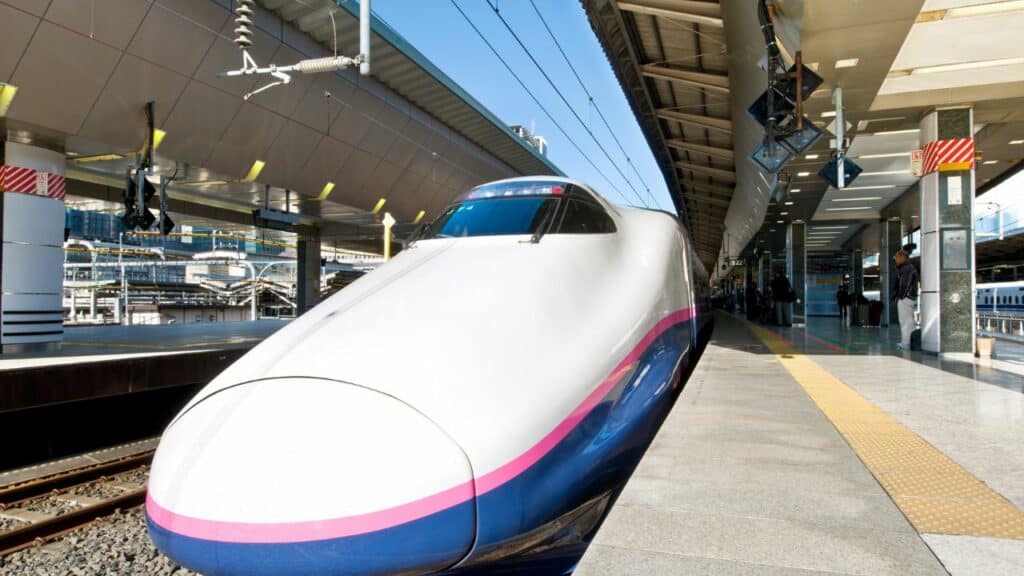
Welcome to Tokyo, one of the world’s most exciting and vibrant cities! After a long flight, you’ll be glad that many transportation options are available to get you from the airport to your hotel.
The Narita Express train is a popular choice and takes about an hour to reach central Tokyo, or you could opt for a private airport transfer service tailored to your specific needs.
Once you’ve settled into your hotel, it’s time to explore the local area. A great way to get a feel for the city is to visit a nearby park or shrine or try local street food.
Check out our recommendations for some of the best restaurants in Tokyo, whatever your budget. And remember to enjoy the incredible nightlife Tokyo has on offer!
Day 2: Tokyo Metropolitan Government Building and Shibuya
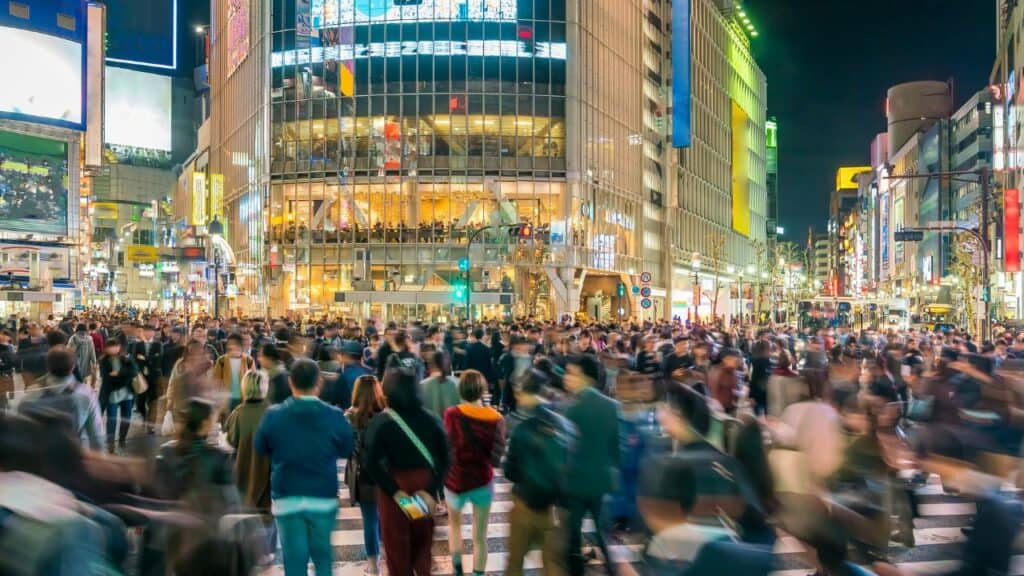
Today, you’ll explore the Tokyo Metropolitan Government Building and the neighborhood of Shibuya.
The Tokyo Metropolitan Government Building is a skyscraper located in Shinjuku and is the headquarters of the Tokyo Metropolitan Government. It offers free observation decks on the 45th floor, providing incredible Tokyo views.
Shibuya is a busy and trendy Tokyo district best known for its scramble crossing , shopping districts, department stores, and specialty shops.
Be sure to wander the streets and check out all the unique finds Shibuya offers.
In addition, there are plenty of great dining options in Shibuya, such as sushi restaurants or trendy cafés.
Roppongi is an excellent option for evening entertainment and offers a variety of rooftop bars and live music performances.
Day 3: Kamakura and Enoshima Island
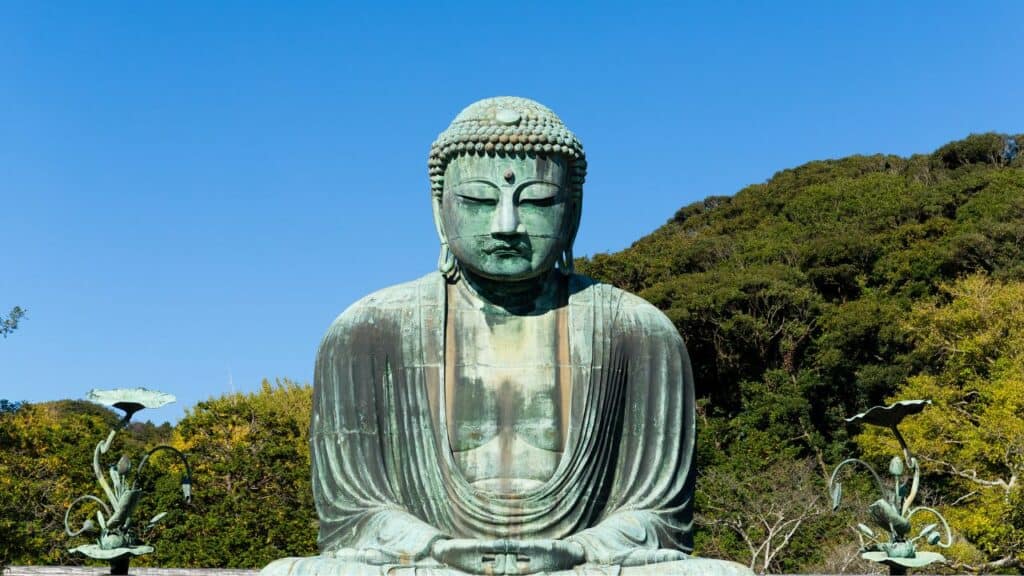
Today, you’ll explore the historic town of Kamakura and the beautiful Enoshima Island.
Located less than an hour from Tokyo , Kamakura is a charming coastal town home to some of Japan’s most famous Buddhist temples.
The Great Buddha at Kotoku-in Temple and the Hasedera Temple are worth a visit, but there’s much more to see in Kamakura than just temples!
For example, Kamakura is also home to several stunning beaches and resorts. If you’re looking for some relaxation and stunning coastal views, spending the afternoon at Enoshima Island is a must.
Enoshima is easily accessible by train from Tokyo and is home to some excellent seafood restaurants and a lovely beach.
Try local dishes while you’re there; you won’t be disappointed!
Day 4: Asakusa and a traditional Japanese garden
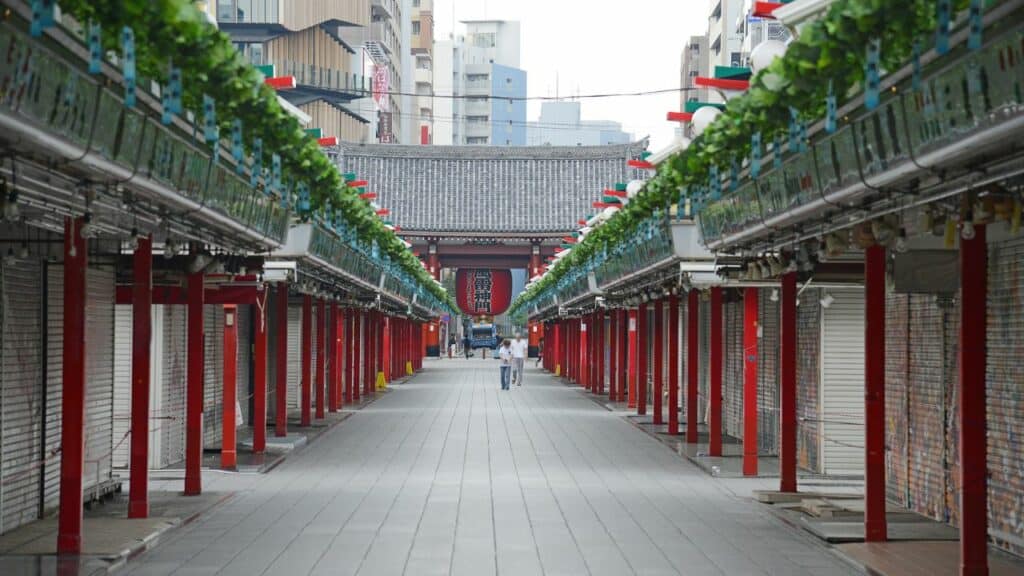
On Day 4 of your Tokyo itinerary, start by exploring the historic Senso-ji Temple in Asakusa.
A must-see for any visit to Tokyo, the temple is open all year round for visitors.
Once you take in the fantastic view of the main gate and pagoda, head to the Nakamise shopping street for a massive selection of traditional Japanese souvenirs and local snacks.
Whether you’re looking for a special omiyage (gift) or want a deeper insight into Japanese culture, this is the place for you!
After shopping and sightseeing, why not visit one of Tokyo’s traditional Japanese gardens?
The Kyu Yasuda Garden, within walking distance from Asakusa, opens at 9 am and has an admission fee of 600 yen per person.
This gorgeous garden full of lush greenery and trickling streams is worth visiting!
Finally, remember to grab lunch or dinner as you explore this neighborhood.
Whether it’s a traditional Japanese restaurant or a small food stand offering local street food, there are plenty of delicious options in Asakusa to please any palate.
By visiting Asakusa & Akihabara on Day 4, you’ll get a laid-back and traditional experience that will make your 7-day Tokyo itinerary memorable!
Day 5: Meiji Shrine and Harajuku
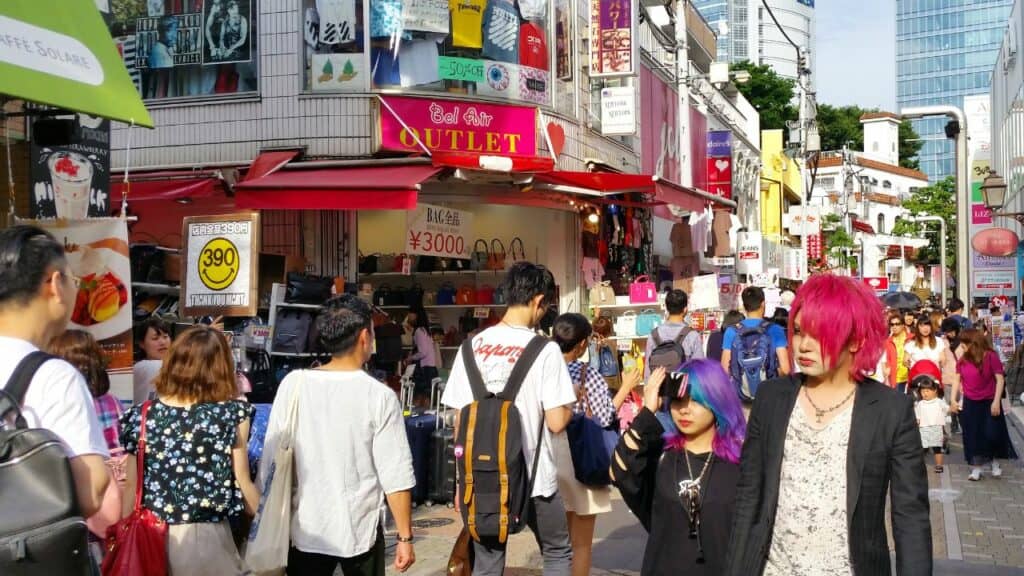
On day five of your trip to Tokyo, spend the morning exploring the iconic Meiji Shrine .
Located in Meiji Jingu Gaien Park, this Shinto Shrine was built in 1920 and is dedicated to Emperor Meiji and his wife, Empress Shoken.
The garden boasts around 100,000 trees, a spring-fed pond, and a picturesque bridge, making it the perfect place for an afternoon stroll.
Check their opening hours, as they may vary depending on the season. Entrance to the grounds is free, but there is an admission fee for entry into the shrine.
Once you’ve had your fill of ancient culture and spirituality, head over to Harajuku and explore Omotesando Street , Nezu Museum, and Shibuya.
Browse the trendy shops along Omotesando Street or enjoy coffee at its charming cafes. If you want something more upscale, try some fancy cocktails at one of Harajuku’s trendiest bars!
Why not check out an izakaya (a Japanese version of a pub) in Shinjuku for dinner?
Enjoy some traditional Japanese dishes accompanied by sake or beer; it will surely be a delicious experience!
Day 6: Tokyo National Museum and Ueno Park
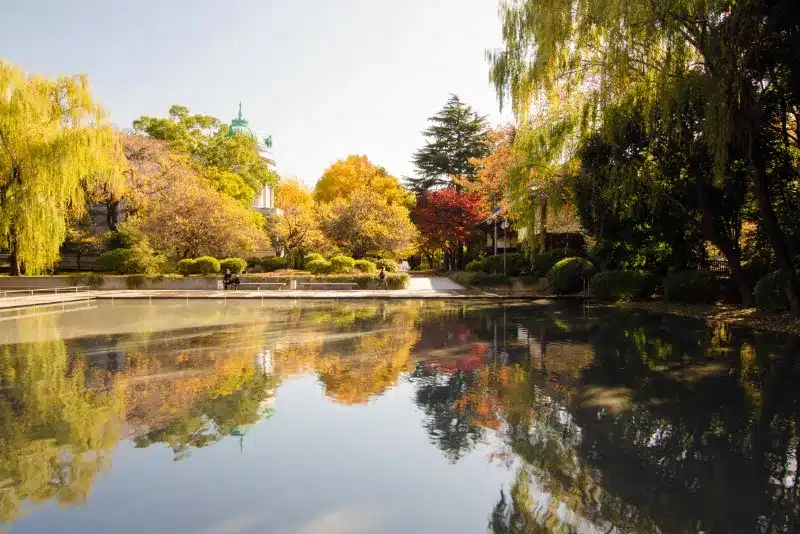
You’ll be ready to explore the vast and vibrant Ueno Park on your sixth day.
Located in the Taito ward of Tokyo, it is the city’s largest park and has a rich history of culture and entertainment.
As well as an abundance of trees, shrubs, and flowers, Ueno Park also houses several museums, such as the Tokyo Metropolitan Art Museum and the National Museum of Nature and Science.
The Tokyo National Museum, located close to Ueno Park, is one of the oldest museums in Japan, with a collection spanning over a thousand years.
Once you’re done touring Ueno Park museums during the day, stick around for evening entertainment, such as a kabuki play or geisha dance. Both activities are quintessential Tokyoesque experiences offering insight into Japanese culture.
2koto Sanso is one of the most popular venues for traditional theater performances.
For ticket purchase options, please refer to their website or purchase directly at their box office.
In your seven-day itinerary in Tokyo exploration, you have covered two additional wards beyond Shinjuku: Taito, where Ueno Park is located, and Chiyoda , home to the Tokyo National Museum.
With just one more day left before returning home, you can wrap up your tour with further details on costs, things to do, where to stay, and your next destination by referring back to this guide!
Day 7: Odaiba and return home
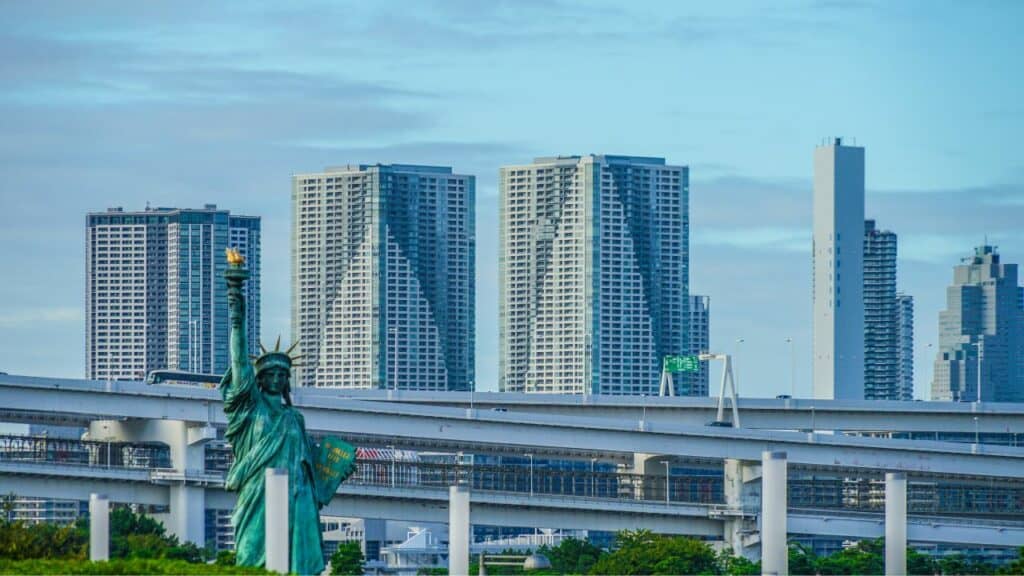
For your seventh and final day in Tokyo, take a trip to Odaiba , the futuristic island district of Tokyo Bay.
You’ll find the Tokyo International Exhibition Center and plenty of shops, restaurants, and entertainment options here.
You can even glimpse the iconic Rainbow Bridge, which connects the island to mainland Tokyo.
For those looking for something a little further afield, there’s an abundance of other attractions in Odaiba.
The observation deck at the Fuji TV building, a replica of the Statue of Liberty, and the National Museum of Emerging Science & Innovation (Miraikan).
When it’s time to say goodbye to Tokyo, there are several options for getting to Narita Airport.
You can take the Narita Express train from Tokyo Station, book a private airport transfer service, or grab a taxi outside your hotel.
Whichever method you choose, leave plenty of time before your flight!
Are seven days too long in Tokyo?
You may be wondering if seven days is too long in Tokyo.
On the contrary, there may need to be more time to explore the city and all its wonders! Seven days might be your best bet unless you plan to rush through your trip.
If you have a whole week, we recommend sticking to the core of Tokyo Ginza ; Roppongi, Shibuya, and Shinjuku are some places you should visit.
Check out our suggested seven-day Tokyo itinerary for ideas on where to find attractions in each area.
But don’t worry if you don’t have time for every spot; there’s always something else or other cool places to visit in Tokyo !
What should I avoid in Tokyo?
As you plan your perfect 7-day itinerary in Tokyo, there are vital things to remember.
First of all, avoid stopping on escalators marked for walking! This is a serious faux pas in Japan and can result in some very unfriendly stares.
If this is your first time visiting Tokyo, I suggest dedicating Day 1 to traveling and exploring the Roppongi area.
Make stops at iconic places such as Senso-ji Temple, Ueno Park, and Takeshita Street, giving you an authentic feel for the city.
When visiting Tokyo’s various attractions and destinations, respect the local culture and customs by dressing modestly, being mindful of noise levels, and respecting the people around you. Enjoy your trip!
Which is better, Tokyo or Osaka?
Tokyo or Osaka? Good question! Both cities offer a uniquely Japanese experience, but which should you visit first?
Tokyo or Osaka are possible points of arrival in Japan, depending on your flight availability.
However, Osaka might be the better choice if you want to visit more attractions in one day.
Osaka is great for day trips with its central location and quick access to nearby cities and attractions.
Even with a suggested 7-day itinerary that includes Tokyo, Kyoto , and Osaka , you can easily cover both on your trip.
However, if it’s the hustle and bustle of Tokyo that you’re after, then, by all means, head there first! Whichever city you decide to visit first, you won’t regret it!
Best Time to Visit Tokyo
The most important question when planning your trip to Tokyo is when to go.
The best times to visit are generally fall and spring, when temperatures are bearable, and you can enjoy the incredible views and vibrant colors of the changing season.
Remember that some attractions can get extremely crowded during peak seasons, so consider visiting on a weekday early or late.
When it comes to sights in Tokyo, you’ve got quite a bit of ground to cover!
Be sure to estimate the time you want to spend at each moment. For example, a visit to Meiji Shrine should take around two hours.
Other attractions might take longer or shorter depending on how much exploring you want to do.
Tokyo is a city that offers something for everyone. Whether you’re looking for trendy neighborhoods, beautiful temples, delicious food, or lively nightlife , you can find it all in Tokyo.
With so much to see and do, it can be tough to plan your trip. That’s why we’ve put together this 7-day itinerary to help make your travel planning easier.
This itinerary includes some of the best things to see and do in Tokyo and can be easily adjusted to fit your preferences.
We recommend starting with day one and working your way through the list, but you can also mix and match depending on what you want to see and do. Enjoy your time in Tokyo!
I'm Alex Deidda, the founder of LoveForTraveling.com. I've lived in various countries, embracing their cultures and wonders. My passion for exploration led to the creation of my website, offering tips, recommendations, and personal travel stories. Follow LoveForTraveling.com for all your travel needs and join me in discovering the world.
Similar Posts
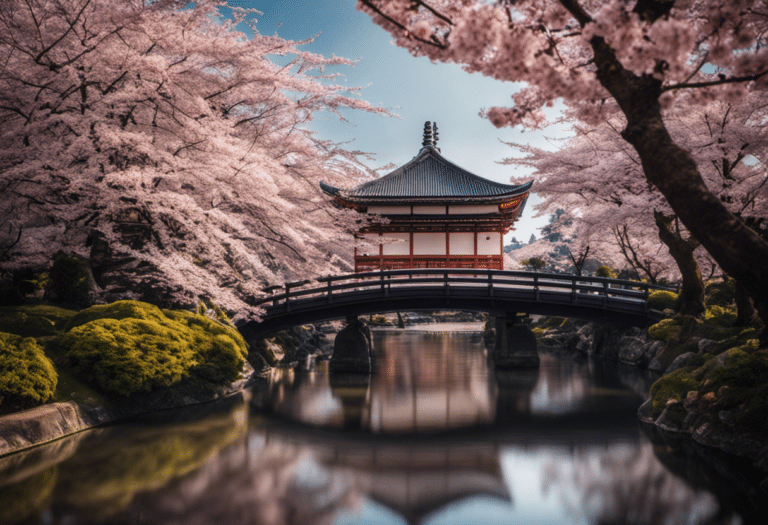
Top 10 Unique Temples in Japan
We’ve found the top 10 unique Japanese temple experiences just for you! Did you know that Japan is home to over 80,000 temples? Get ready to uncover the sacred as we take you on a…
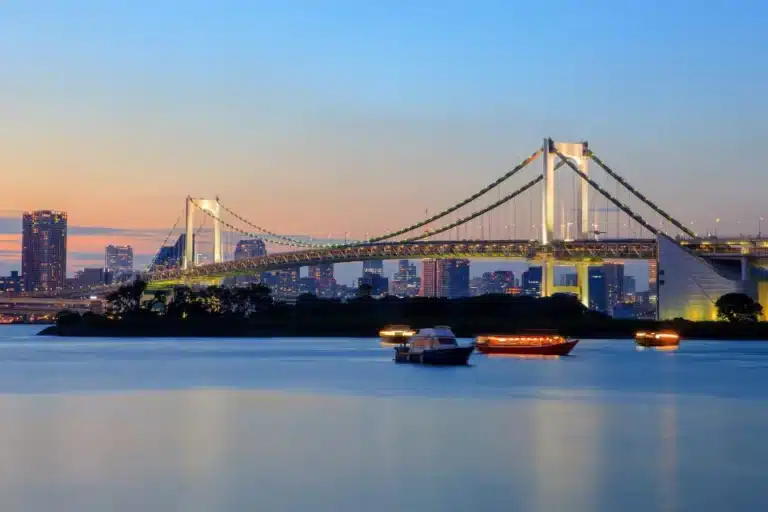
7 Cities Near Tokyo To Visit For A Weekend Getaway
Are you looking for a weekend getaway to experience a unique culture and escape the hustle and bustle of Tokyo? You don’t have to look far; Japan offers a variety of cities near Tokyo that…

Top 10 Best Onsen in Japan 2023
Onsens are natural hot springs found throughout Japan, with thousands of locations offering the perfect setting for relaxation and rejuvenation. These hot springs are heated by geothermal energy and often contain minerals that can provide…
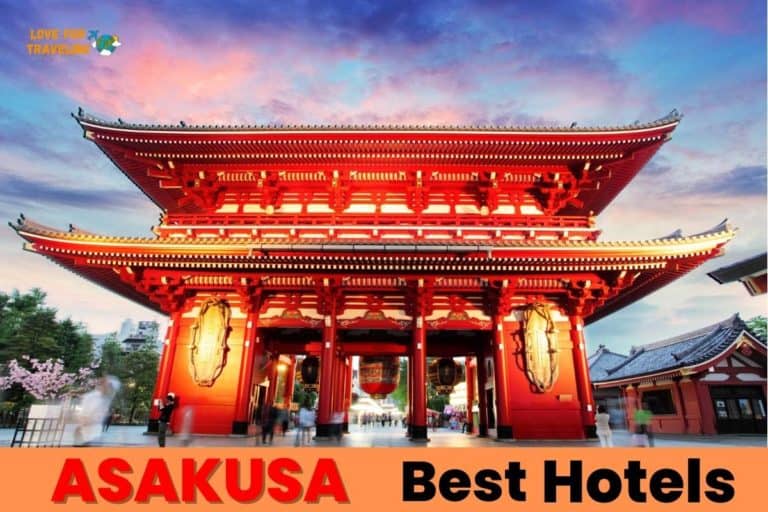
The 10 Best Hotels in Asakusa (For 2023)
Asakusa is a fascinating district in Tokyo that offers a unique blend of old and new. The traditional craft shops and street-food stalls along Nakamise Street give the area an antique feel. At the same…
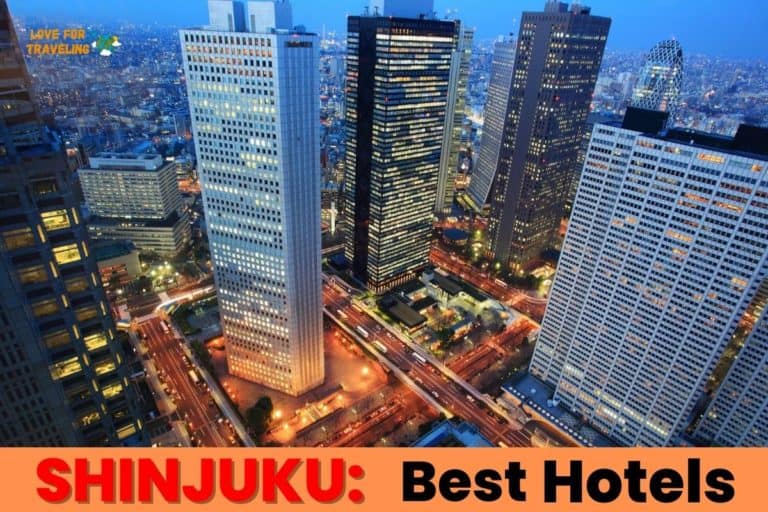
The 10 Best Hotels in Shinjuku (For 2023)
The district of Shinjuku in Tokyo is lively and vibrant, home to a diverse range of attractions. East Shinjuku is known for its busy nightlife, with many clubs, bars, and karaoke rooms. In contrast, the…
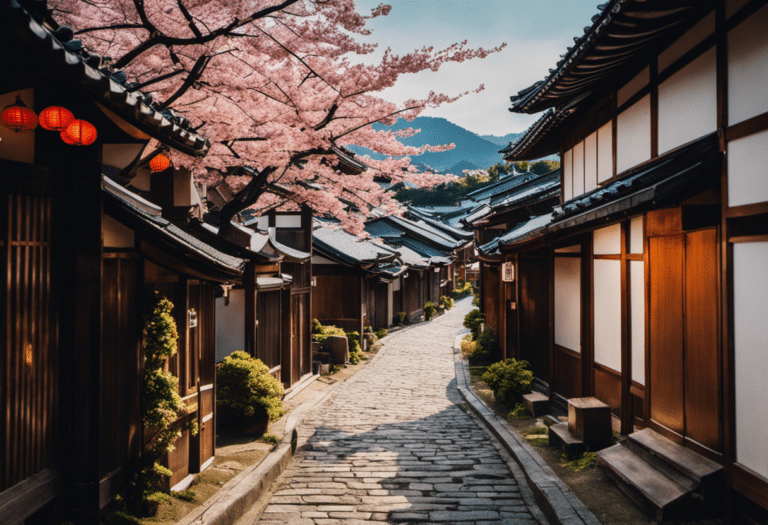
Best Small Towns in Japan: Top 10 Charming Little Villages
Are you ready to embark on a journey through the enchanting small towns of Japan? Get ready to be captivated by the hidden gems that await you in these charming little villages. Immerse yourself in…
Leave a Reply Cancel reply
You must be logged in to post a comment.
7 perfect days in Tokyo

Tokyo conjures up so many contrasting images: the spiritual alongside the quirky, the quiet of the temples and the chaos of the subway, the neon and the nature.
With 23 municipalities and another 39 smaller towns within its borders—plus flowing rivers, expansive parks, and the highest number of Michelin-starred restaurants in the world—you could spend a decade exploring Tokyo and continue to find new things to love. But even within a span of seven days, you're guaranteed to fill your suitcase with a lifetime of unforgettable experiences.
To help make the most of a week here, we’ve organized your days by location and theme. We also combed through Tripadvisor reviews and ratings to make sure that your trip is as memorable as the city itself.
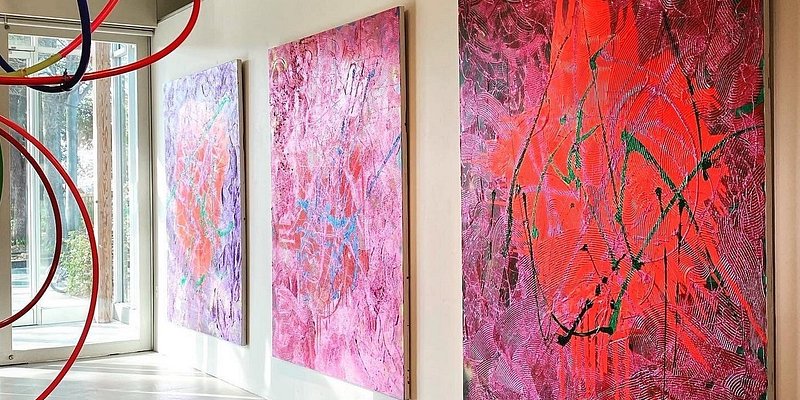
MORNING: Parks and culture
Start with a quiet breakfast at a Japanese kissaten (an old-school coffee house). Kissatens typically serve creamy egg sandwiches accompanied by warm soups—the perfect pick-me-up for your day ahead. At Kabaya Coffee in the Yanaka area, you’ll be seated on tatami mats. There might be a wait (attesting to its popularity), so a tip: Arrive early (it opens at 8am and is closed Mondays). Finish your meal with a subtly sweet, buttery cake and a cup of latte.
Next, head toward Ueno Park , which is the site of five major museums: Tokyo Metropolitan Art Museum (modern art from Japan), Tokyo National Museum (the country’s oldest museum with the world’s most comprehensive collection of Japanese art), Ueno Royal Museum (collections from the royal family), the 150-year-old National Museum of Nature and Science (a treat for adults and kids alike), and the National Museum of Western Art (check out the pre-18th century paintings). But you’ll probably only have time for one, so my pick is the Tokyo National Museum: It’s huge, but you can take in the highlights in an hour and get a good overview of Japanese history, culture and religion.
Travelers say: “A gem of a museum and a fantastic way to start your trip through Japan in order to understand the history better. Really well curated, well translated into English and a great journey through time!”—@ BestRegardsFromFar
AFTERNOON: The spiritual side of Tokyo
Continue the walk east toward Asakusa for lunch at Ramen Yoroiya (get it topped with a soft-boiled egg, which takes ramen to a whole new level). Next up is Tokyo’s oldest temple, Sensoji . The outer gate, Kaminarimon (Thunder Gate), is a symbol of the largesse of the Buddhist temple itself, which was built for the goddess Kannon. The stretch between Kaminarimon and the main temple is a shopping street where you can pick up affordable Japanese art and souvenirs or try on a yukata or kimono and get photographed by the main temple. Even though the temple and the courtyard are always filled with tourists and locals, it never feels crowded.
Continue the spiritual experience with a tea ceremony at Jidaiya , not far from Kaminarimon. Take the experience to the next level with a 50-minute session that includes dressing up in a kimono (reservations are a good idea).
Hop on the Tobu Skytree Line or Asakusa line of the subway, and get off one stop later—or walk a mile—to reach the Tokyo Skytree . Going all the way up to the top gives you a panoramic view of the city (book tickets in advance). There are also restaurants and cafes on various floors, including a post office, in case you want to send out a memorable postcard from the clouds.
ASAKUSA TOUR OPTIONS
- On this family food tour of Asakusa , you’ll follow an expert guide through the hidden alleys and backstreets of this vibrant district. Stop for samples of Japanese delicacies like melon bread and matcha tea and cp off the culinary journey with a lunch of southern Japanese cuisine.
- Experience Asakusa’s captivating blend of tradition and modernity on this Rickshaw Tour . Journey past cherry trees, skyscrapers, and cultural gems like Ushijima Shrine and immerse yourself in the neighborhood’s rich history.
- Unearth Asakusa’s secrets on the half-day Asakusa Cultural Walk & Matcha Making Tour . Stroll along the bustling shopping street, ride in a rickshaw, savor traditional snacks, and learn to make okonomiyaki (a Japanese pancake) at a traditional restaurant.
EVENING: Cocktails in the clouds
Watch the sunset while enjoying exquisite Japanese whiskey at Top of Tree , which has stunning views of the skyline and Tokyo Skytree itself. Stroll back to Sensoji temple to get a glimpse of the majestic wooden structure in the quiet of the night. Finish your day at Yoshinoya with a donburi (rice bowl dish), the perfect comfort food. It’s served with a bowl of miso soup and green tea and comes in two flavors—pork and kimchi or beef and egg.
After dinner, head to Ninja Bar to sample a selection of sake or my favorite drink, umeshu (plum liquor), best had on-the-rocks. If you’re still hungry, you can order yakitori (grilled chicken on skewers) or karaage (fried chicken).
Worthy detours along the way
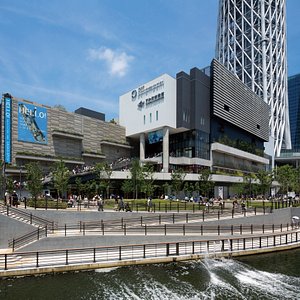
MORNING: The quirky side of Tokyo
Start the day with a coffee and a toasted ham-and-cheese sandwich at the Shin Ochanomizu branch of Caffe Veloce , a local chain that’s the Starbucks of Japan. Walk east, for a little less than a mile, to get the best gear to document your travel moments at Yodobashi Camera in Akihabara (it’s also got tons of gaming and electronic gadgets). You could easily spend three hours exploring. If manga is your thing, then Mandarake is your mecca—it’s touted as the largest manga and anime store in the world. Here you can buy discounted and vintage items related to manga, anime, and gaming.
AKIHABARA TOUR OPTIONS
- Akihabara, Tokyo’s “Electric Town,” beckons anime lovers, but newcomers may feel overwhelmed. The Akihabara Private Anime & Gaming Food Tour Tailored To Your Taste removes the guesswork, leading you to the best stores, cafés, and more.
- Whether you’re an anime and gaming enthusiast or simply curious about Japanese pop culture, this three-hour guided walking tour is your ticket. You’ll visit retro video game stores, maid cafes, photo booths, and more.
- Roam Akihabara like your favorite anime character on the Go-Kart Street Tour Adventure with Guide . With a guide leading the way, you’ll explore iconic sites, from Rainbow Bridge to the Imperial Palace.
AFTERNOON: Owls and art
For a bowl of ginger-flavored ramen with char-siu (stewed pork belly), it’s worth your time to line up at Aoshima Shokudo . You’ll find an even richer bowl at Gottsu Akihabara , where the soy sauce ramen is laden with pork back fat. (Vegetarians might prefer the miso ramen with a heavy dose of vegetables.)
Here’s a pick-me-up that’s not just caffeinated: Akiba Fukurou , where owls peer at you while you sip a latte (you’re welcome to gently pet them and take photos—just no flash). If you like cosplay, the nearby Mitsubado Cosplay Shop is not to be missed: You can find a wide variety of wigs, maid outfits, and Naruto costumes at low prices.
Head to Akihabara subway station and take either the Hibiya Line or Chiyoda Line to get to Roppongi , the neighborhood that’s classy, flashy, and surrounded with art. Spend the afternoon at the Mori Art Museum , which sits atop the 52nd and 53rd floors of the Roppongi Hills Mori Tower. The ticket opens the door to the latest in contemporary art—from Carmen Herrera to Ai Weiwei—alongside a breathtaking panoramic view of the city skyline.
Travelers say: “Amazing one of a kind experience meeting the beautiful owls! Staff are very knowledgeable on each owl’s personality. They cater to their needs so they can safely be handled. Highly recommend!”—@ jennyy0ung
EVENING: Dinner and glitz
Glizy Roppongi is the place for dinner. Savor falafel and crispy vegan karaage (fried chicken) with a Mediterranean twist at Falafel Brothers . It’s a guilt-free dinner at Zero Per Cent , where the food is gluten-free and vegan and the artisanal cocktails are alcohol-free (reservations are required). The slick R2 Supperclub has become the go-to hub for international expats looking for an evening with a DJ, cocktails, and impressive bar bites: fried scallops with lime, smoked salmon rolls. Or for a more adventurous experience, head to Tantra , which calls itself an “artistic lounge,” with a geisha performance, burlesque, fire shows, exotic dancing, and more. Tantra also offers couples’ plan, which includes a private performance and a bottle of free champagne.
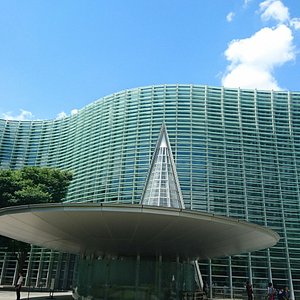
MORNING: The quiet before the cute
Start your day at the busiest subway station in the world: Shinjuku . This centrally-located hub connects to 13 different routes and has several entry and exit points (warning—a rendezvous with friends at any of these points is bound to cause chaos). Exit from the station’s eastern side, and head to Egg-Slut for fluffy eggs, brioche buns, and juicy meat patties.
A mile southeast is the city’s spiritual power spot: Meiji Jingu forest and shrine. As you enter through Meiji Jingu’s massive wooden torii (gate), the energy shifts and your pace slows down. The vast forested area, complete with wide walking paths and birdsong, leads to a huge stack of sake barrels gifted to the emperor. Locals often come here for traditional weddings or for a moment of quiet after work.
Travelers say: “Meiji Jingu is a tranquil oasis in bustling Tokyo. I highly recommend arriving early to savor its serene beauty without the crowds. This historical shrine offers a peaceful retreat to disconnect from city life. The towering Torii gate and lush forested pathways create a unique atmosphere, making it a must-visit destination for those seeking a taste of Japan's rich cultural heritage.”—@ carloscharmy
AFTERNOON: Youth culture in Harajuku
Harajuku’s main thoroughfare is Takeshita Street , and it is a loud contrast to the serenity of the forest. This youth-focused street is a mecca for the kawaii (cute) aesthetic. Check out the Purikura No Mecca selfie photo booths, complete with spaces to touch-up your makeup. If you’re not there with a group, it’s perfectly acceptable to snap photos with a gang of people you don’t know. Amp up the cuteness at Cat Cafe Mocha , where cats are the boss; for a small fee you get unlimited non-alcoholic drinks and can play with the kittens. For the ultimate splurge lunch, treat yourself to the famed wagyu beef at Gyukatsu Motomura Harajuku .
FOOD TOUR OPTIONS
- On Arigato Japan’s Kawaii Food Tour of Harajuku Tokyo , you’ll dive into kawaii (cute) culture and sample creative pastries, colorful candy, and local treats in a fun small group.
- Embark on a Best of Shibuya Food Tour for a taste of Tokyo’s street food scene. Devour okonomiyaki (savory pancakes), sample sushi, and visit an underground food market.
- For a true taste of Japanese culture, the Tsukiji and Asakusa Food and Drink Cultural Walking Tour combines a flavorful journey through two iconic Tokyo food areas: the legendary Tsukiji Market and Asakusa.
EVENING: The new red light district
Kabukicho is Tokyo’s red-light district (and you can check out the host and hostess bars, if that’s your thing). Enjoy a steak bento box with the theatrics of an imagined future at the Robot Restaurant (make sure you buy tickets in advance). Or go on a pub crawl in Golden Gai Kabukicho , where tiny bars seating only about five or six people line a narrow alley called the yokocho. The best way to experience the Golden Gai is on a guided tour, but even if you don’t speak Japanese and go on your own, it’s a fun night out. Best photo op in the area: the massive Godzilla looming over Shinjuku’s billboards and neon lights.

MORNING: Imperial life
The Imperial Palace is where the Edo castle once stood: It became the permanent home of the imperial family in 1869, and continues to be their residence. While only the East Gardens are open to the public (except on Mondays), it is a breathtaking experience of landscaping and small ponds. Locals make the most of the nearly four-mile perimeter of the palace as a running route.
If you’re in Tokyo when the flowers of the spring sakura (cherry blossoms) are blooming, you’ll want to experience the royal waterway on the Chidori-ga-fuchi Moat , the northwest arc of the Imperial Palace. The boat ride is akin to floating through a tunnel of white and pink blooms; when the ephemeral sakura petals begin to fall, the moat resembles a carpet of pink.
Travelers say: “My friend and I spent a wonderful few hours walking around the outer perimeter and the inside palace gardens. Access is free. Imposing walls, most and guard gates provide insights into historical context of this palace and its surroundings in the heart of central Tokyo. Multiple photo ops. Also an excellent venue for jogging around the outer perimeter, approx 3-5 miles depending on the route you choose.”—@ fwaffarn
AFTERNOON: Sushi, shopping, and zen
East of the Imperial Palace is the Tokyo Railway Station , and on its eastern side, you’ll find sushi restaurants suitable for all wallets. Go for kaisendon (a bowl of rice heaped with a mind-blowing variety of sashimi) at Sushi Aoyogi or try the dishes arriving at your table on a conveyor belt at Sushiro Yurakucho .
Adjoining the Yurackucho station is the Mitsuo Aida Museum , which is dedicated to the calligraphic and poetic works of Mitsuo Aida, a.k.a. the poet of Zen, and worth a peek (even if you don’t speak the language).
From there, head to Tokyo’s swankiest area: Ginza . Behind the glitzy main street are older streets where prominent people live. Do like the locals do with a session of Genbura (which translates as “loitering in Ginza”), checking out the storefronts, which are nothing short of an open-air art museum. Refuel with drip coffee at Flor de Cafe Ki No Hana , which gained fame when John Lennon and Yoko Ono visited back in 1979.
OFF-THE-BEATEN-PATH TOUR OPTIONS
- Discover Tokyo's tranquil old quarter on this Yanaka Walking Tour . Visit traditional wooden houses turned cafes, explore Nezu Shrine’s red Torii gates, and stroll through quaint backstreets and local markets.
- You’ll learn about culture and history while uncovering a handful of secret izakayas on this Hidden Local Bar tour.
EVENING: Views and food
The Marunouchi Kitte Building across the street from Tokyo Station is a skyscraper with global offices, designer shopping, and some of the best restaurants in town. If you are in the mood for something other than Japanese food, head to Mucho Modern Mexicano and order the Cajun chicken and shrimp jambalaya. Cantinetta Buzz is a delicious bet for a fusion of Italian and Japanese dishes and a great wine collection. Following dinner, head back to the Imperial Palace for a quiet walk.
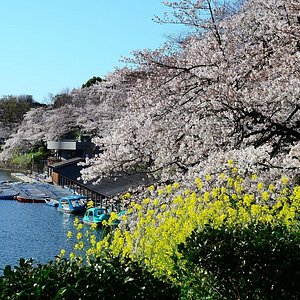
MORNING: Museum morning
Today’s the day to explore some of Tokyo’s quirky little museums. Start off in Sumida in northeast Tokyo with a baguette at Doutor Coffee , a chain where all the locals go. Train buffs will love the nearby Tobu Museum , which is dedicated to the railways (you can even “drive” a simulated subway). An 11-minute taxi ride away is the Sumida Hokusai Museum , which was created to memorialize the famed artist Katsushika Hokusai, best known for his woodblock piece, The Great Wave . The building itself is an architectural marvel, with walkways bisecting the space in two directions.
Next, take a detour a bit south of Sumida to the Bank of Japan Currency Museum in Nihonbashi. This fascinating museum dives deep into the history of Japanese currency—of all things—with displays of money dating back to the 8th century, including the oban, one of the world’s largest ever coins.
Travelers say: “Such a nice place to explore the Train history of Japan, you can chill in shinkansen or first-class carriage. The museum is a bit pricy for tourists, cost us about 1300Y, but we spent a whole afternoon there. They have amazing place for kids to assembly the rail tracks. Super creative and well-invested museum.”—@ Tatanyya
AFTERNOON: Italian eats and music
For lunch, check out the Sumida location of Saizeriya , one of the best Italian restaurants in Tokyo. Go for the doria, a heartwarming combo of rice and meat with a thick layer of cheese. Finish it off with a plate of tiramisu.
Nearby is the Miyamoto-Unosuke Drum Museum , located above a music shop. This small museum celebrates the taiko drum that is used during festivals and rocks to the beat of a drumming aficionado.
After, head to Kappabashi , a half-mile shopping street lined with wholesale kitchen goods stores. You’ll find a wide range of knives and those paper lanterns that hang outside every izakaya. But what you’re really here for are the kitschy plastic food displays that restaurants use to depict their dishes—they’re a fun souvenir.
CULTURAL TOUR OPTIONS
- Immerse yourself in Japanese culture on this private tour in a local’s home in just four hours: Experience origami, calligraphy, udon-making, and more.
- Dive into the enchanting world of Studio Ghibli with the Tokyo Studio Ghibli Museum and Ghibli Film Appreciation Tour . Learn its history on the journey to Mitaka, then explore the Ghibli Museum at your own pace. Skip long lines with included entrance fees and savor a delicious lunch as a bonus.
- Dive into Japanese culture through the art of pottery with this class led by skilled sensei (teacher) right in the heart of Tokyo.
EVENING: Brazilian food and karaoke
Japan has a close relationship with Brazil, which you can experience at Que Bom! , a restaurant in Nishiasakusa (Western Asakusa) known for its BBQ and Brazilian music. Finish off the long day with some much-needed relaxing the Japanese way: at a karaoke bar like Big Echo , a 10-minute walk away.

MORNING: Forest bathing
Shinrin-yoku (which literally translates as “forest bathing”) is a good way to soothe your senses in Tokyo. Take a hike up Mount Takao , which has trails to suit varying levels. Onigiri (a stuffed rice ball covered with a sheet of seaweed) is the perfect grab-and-go breakfast for a hiking day; have one at Togoshiya Shibuya Dogenzaka near Shibuya station or at Honnoriya Tokyo Honten within Tokyo Station. At both places, the onigiri comes with a bowl of miso soup, if you choose to sit down. If you want to eat like a local, hop inside any convenience store and grab a cheap onigiri to go. Just don’t eat while walking: It’s frowned upon in Japan.
To get to Mount Takao, head to Shinjuku and grab the Keio Line; a 50-minute ride brings you to Takaosanguchi station, which is the starting point of the hike. From here, you can choose between any of the six trails that take you to the top of the mountain; the shortest is trail number 1, which is 90 minutes to the summit. You can get there faster on the chairlift , which will take you halfway up. The views of the city are stunning, and if you’re here in autumn, the foliage is a real treat.
Travelers say: “Climbed Mt Takao in August when it was hot as hell but still had a fantastic time. Many interesting things to see on the way up, and the summit doesn't disappoint either. There's plenty of trails to try out, and honestly I enjoyed taking the more intrepid ones on the way back. Be aware that the cable car only takes cash, and the dude manning it laughed at us when we didn't have cash (it started pouring rain), in hindsight fair enough it was pretty funny.”—@ Andy T
AFTERNOON: Temples and shrines
There are several temples along the hike up Mount Takao; on a clear day, Mount Fuji is visible from the summit. Treat yourself to pizza at Mt. Takao Beer Mount . There are also several mom-and-pop shops at the summit selling ramen and dango, a traditional sweet made of glutinous rice flour.
The hike down is just as fascinating—through a dense thicket of forest and indigenous trees with large canopies and winding roots. You can also visit one of the many shrines and temples along the way and make a wish with the offering of the five-yen coin. Mount Takao is a popular getaway for Tokyo locals, but it never gets overwhelming: The mountain has space for all.
NATURAL TOUR OPTIONS
- On the Full Day Hiking Tour at Mt. Takao including Hot Spring , you’ll explore the Takao 599 Museum to uncover the mountain’s nature and wildlife, hike to the summit for a chance to spot Mt. Fuji, and descend to a rejuvenating onsen for a hot spring soak.
- Handpick your favorite gardens and other iconic Tokyo sites for a tailored experience with the Tokyo Japanese Garden Lover's Private Tour . Some highlights to choose from include the Imperial Palace, Shinjuku Gyoen, Meiji Jingu Shrine, Koishikawa Korakuen, Hama Rikyu Gardens, and Yoyogi Park.
- Explore Tokyo’s natural side at a leisurely pace on the Small Group Cycling Tour in Tokyo . Visit landmarks like Meiji-Jingu Shrine and the Imperial Palace while your guide reveals the city’s rich history and culture.
EVENING: A nighttime soak
Before you head back to the city, have a big bowl of soba (buckwheat) noodles at Takahashiya at the bottom of Mount Takao, near Takaosanguchi station. On a hot day, go for the cold soba served with soy sauce, tempura, and a side of sauteed vegetables.
Here’s a refreshing way to end a sweaty and strenuous day: with an onsen session at Keio Takaosan Onsen Gokurakuyu near Takaosanguchi. Just be sure to follow the rules: Onsens like this have laws of decorum like covering up tattoos and scrubbing down before you get in the water. Don’t worry if you haven’t packed towels and soap; these are provided at the reception for a small fee. After your soak, grab a pint of beer and a plate of yakiniku (grilled meat) and enjoy it while lounging on a tatami mat.

MORNING: France by way of Tokyo
Japan has fascination with France, which you can experience in Kagurazaka , the French quarter of Tokyo. Start with a pan au chocolat or one of the exquisite pastries at Aux Merveilleux de Fred Kagurazaka . Or head to Copain for the lightest and fluffiest cream puffs.
Walk a mile west—for a moment, you might even forget that you are in Tokyo—to reach the Kusama Yayoi Museum , which is as small and mighty as the artist herself. It is a psychedelic experience to be surrounded by a multitude of Yayoi’s dots.Ever heard of Japan’s foremost modern novelist, Natsume Sosek, whose satire “I Am Cat” was written at the beginning of the 20th century? If so, you’ll love the nearby Natsume Soseki Memorial Museum , which is dedicated to him. If not, stroll back to Kagurazaka’s main street and wander into the side alleys of this neighborhood that was once frequented by geishas.
Travelers say: “We were fortunate enough to find an airbnb apartment in this neighborhood and we enjoyed it so much. This is reminiscent of St Germain in Paris (Japanese style of course) with all the small alleyway, full of restaurants on every level of the buildings. So many choices. We spent 10 glorious days and did not feel like going anywhere else as there is so much to discover.”—@ JPSalik
AFTERNOON: A food neighborhood
The cobblestone alleyways of Kagurazaka are home to more than 250 restaurants and cafes; you’d never experience them all in a lifetime. Head to Kyorakutei , where you can eat—and get an education in—soba (buckwheat noodles). Another great option: Kagurazaka Oishimbo , which serves traditional Japanese dishes like grilled mackerel and seafood kaiseki
Complete the culinary experience at Rakuzan , where you can buy a variety of ceramic matcha sets. The shop assistants are more than happy to explain the different grades of hojicha (roasted green tea) and the way of stirring it with the bamboo whisks to brew the perfect cup of matcha. If you have time, check out the Printing Museum just a mile away, which is dedicated to the art of printing, with artifacts ranging from ancient Assyrian and Egyptian stamps and stone tablets, to wood carvings and copper plate engravings.
TOUR OPTIONS BEYOND TOKYO
- On the Mt Fuji and Hakone 1-Day Bus Tour return by Bullet Train , you’ll break free from Tokyo on a day filled with natural wonders. Explore Mt. Fuji's 5th Station. Feel the power of volcanic activity at Owakudani Valley. Ride a sky gondola, cruise Lake Ashi, uncover the secrets of Ninja trick houses, and see the iconic Hakone Shrine, all before returning to Tokyo on the bullet train.
- The UNESCO World Heritage Site at Nikko is an unmissable destination and you can check it out on this Full Day Bus Tour . Stops include the Toshogu Shrine complex, one of the best preserved (and most colorful) ancient shrines in Japan and the spectacular Kegon Falls.
- With the Tokyo Countryside Tour , you’ll leave the city behind on a small-group tour to explore a forgotten, bucolic wonderland featuring mountains, waterfalls, temples, and shrines.
EVENING: The grand finale
As twilight makes its way through the slopes of Kagurazaka, head to the Akagi Shrine not far from Kagurazaka subway station. It is quite a sight to see the evening lamps illuminate the wooden facade, with the Tokyo skyline in the distance.
The perfect way to end a glorious journey through Tokyo? A sushi meal at Kagurazaka’s bustling Teshigoto Seigetsu , which serves fresh fish and sake sourced from different parts of Japan. For a calmer way to spend your last night, head to the open-air Canal Cafe down the hill from Kagurazaka’s main street and dine on wood-fired pizza and fresh tarts. As the Tokyo Metro Namboku Line glides into Iidabashi station, parallel to the canal, and the lights from skyscrapers shimmer on the water, it’s a lovely way to reflect on all things that make Tokyo such a global city.
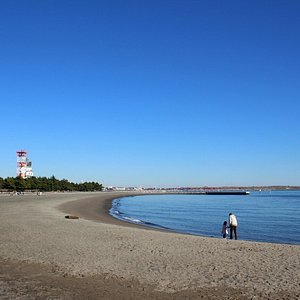
Know Before You Go
Tokyo has its charm in all seasons, but the best times to go are in spring (February and March) when the flowers of the plum and cherry blossoms are in various stages of bloom, and autumn (September and October) when the city turns golden under the shade of the yellowing ginkgo leaves. At both these times, the weather is pleasant with a cozy nip in the evening air. The winter has its own appeals, with snow-covered vistas.
The best days to visit Tokyo are generally Tuesday through Thursday. These midweek days offer a perfect balance between smaller crowds and more accessible reservations at popular attractions and restaurants. In Tokyo, most museums and attractions are open throughout the week, including weekends. However, some smaller or specialized museums may have irregular closure days, often on Mondays or specific weekdays.
In Tokyo, business hours vary, but a typical pattern is as follows: Shops usually open around 10 a.m. and close by 8 p.m. Restaurants are open for lunch from 11:30 a.m. to 2 p.m., and dinner service starts around 6 p.m. and goes until 10 p.m. Museums often open from 9 a.m. to 5 p.m., while bars and nightlife spots come alive after 8 p.m., staying open until the wee hours (just be careful to not miss the last subway or bus).
Shinjuku: This bustling district is home to luxury options like the Park Hyatt Tokyo , made famous by the movie Lost in Translation , offering stunning city views. The Keio Plaza Hotel is also a fantastic choice for its central location and family-friendly amenities.
Ginza: For a taste of high-end shopping and dining, consider The Tokyo Station Hotel , housed in the iconic Tokyo Station, or The Peninsula Tokyo for its elegant atmosphere, or the Muji hotel for a stylish budget stay.
Asakusa: Experience Tokyo’s traditional side at Ryokan Asakusa Shigetsu , offering authentic Japanese hospitality near Senso-ji Temple. The Gate Hotel Asakusa Kaminarimon combines contemporary comfort with easy access to cultural attractions.
Shibuya: The Shibuya Excel Hotel Tokyu provides modern luxury with stunning views of Shibuya Crossing, while the Trunk Hotel offers a prime location and a cool setting for exploring the trendy neighborhood.
Roppongi: Discover nightlife and entertainment at The Ritz-Carlton, Tokyo , with panoramic city vistas. Roppongi Hotel S is another stylish option known for its art-inspired design.
Public transportation: To make commuting much easier, buy a tourist Suica card that enables you to travel across Tokyo’s vast subway system. You can refill it at any of the stations. And if you miss the last subway train, fret not: head to a karaoke bar for a few hours, where you can get free access to the non-alcoholic drinks bar. Finish off the night with the Beatles’ “Hey Jude” and hop onto the first subway station as the sun slowly rises. A tip: Don’t forget to carry along a blank notebook when you travel by Toyo’s vast subway network. Most stations have a stamp by the ticket counter, so that you can fill your notebook—a fun souvenir.
By taxi: Getting around Tokyo by taxi is convenient but relatively more expensive than other options: For instance, a short one-mile ride costs an eye-watering $15. Taxis are widely available throughout the city. Simply hail one from the street. Taxis charge based on distance and wait time, with a base fare displayed on the meter. Communication may require basic Japanese or digital assistance. Another thing to know: The door will open automatically, so you don’t need to touch the handle. Always wear your seatbelt, and remember that tipping is not customary.
By rideshare: Uber and similar local ridesharing options are available in Tokyo. Download the respective app, set your pickup location, and a driver will arrive promptly. It's a convenient alternative to taxis, especially when language barriers might be a concern.
Airport transfers: For hassle-free airport transfers in Tokyo, two main options are available. Narita International Airport connects to the city via Narita Express trains , reaching major stations. There is also a bus from the station that is far cheaper and takes you to the Tokyo station. Alternatively, Haneda Airport offers convenient access through Tokyo Monorail and Keikyu Line trains, ensuring a swift commute to the city center. Airport limousine buses provide another comfortable choice, with routes covering popular areas and hotels. You can also take a taxi.
Many of Tokyo’s smaller restaurants do not accept digital money, so it is important to always carry cash. However, most ATMs are not operational at all hours, especially the ones outside the tourist hubs.
Wifi: If you don’t want to pay for international roaming charges on your phone, be aware that public wifi is limited across Tokyo (though hotels and convenience stores like Family Mart, 7-11, and Lawsons usually offer free wifi). It’s also a good idea to buy a pocket wifi modem.
Communicating: Ensure that you have Google Translate app downloaded on your phone; it’s a great way to translate key phrases. One of the best words to know is “sumimasen,” which means “excuse me” and can be used to get someone’s attention—almost everyone in Tokyo is eager to help foreigners.

The perfect 7 day Tokyo itinerary (2024)
Tokyo may be one of the most densely packed cities in the world but it’s also one of the most dynamic. This city – awash with ancient shrines, flashing neon and pink cherry blossoms – is unashamedly busy.
But it’s also incredibly efficient.
Nowhere else in the world will you find a city this big and with this many people that runs so smoothly and safely. What this means as a visitor is that despite its huge size, Tokyo is actually very easy to explore.
We spent one week in the Japanese capital and, thanks to our local friends who guided us on the best places to visit and the best thing to see and do, we arrived with the perfect 7 day Tokyo itinerary ready to hit the ground running.
This post tells you all you need to know about spending one week in Tokyo: What to see, how to organise your days, how to get around, where to stay and more. This post has more detailed ideas on visiting Tokyo with kids and, once you’ve explore the capital, consider heading to Sapporo and exploring beautiful Hokkaido too.
Disclosure: This post may contain affiliate links. I have been or could be if you click on a link in this post compensated via a cash payment, gift or something else of value for writing this post. See our full disclosure policy for more details.

Getting around Tokyo
Table of Contents
The first thing you need to understand about Tokyo is that there is not one clearly marked city centre. Rather, the capital is made up of 14 urban neighbourhoods that feel more like city centres in their own right. Each one is distinct in identity and character from the rainbow-bright, capital of all things cool and kawaii , Harajuku and the buzzy pop culture paradise of Akihabara to the chichi retail Mecca of Ginza .
When planning your 7-day Tokyo itinerary, it pays to think ahead and be aware of where sights are located so that you only stick to one or two neighbourhoods at a time.

Transport from Narita Airport
Narita International Airport is Tokyo’s main airport for international flights and departures. The city’s other hub, Haneda Airport , serves as a domestic hub.
Located about 60 kilometres east of central Tokyo, there are various options for travelling from Narita Airport into the city centre including train, bus and taxi.
The fastest way to get from Narita Airport to Tokyo city is on public transportation, in particular by train . Both Japan Rail East (JR East) and Keisei Electric Railway offer services from the airport with trains leaving from both Narita Airport Terminals 1 and 2.
The Narita Express (also known as the N’EX) is run by JR East and takes just 53 minutes to reach Tokyo Station . It also stops at Shibuya station (1hr 15 mins) and Shinjuku Station (1hr 25 minutes).
Run by the Keisei Electric Railway , the Skyliner runs from Narita Airport to Nippori Station in 36 mins and Ueno Station in only 41 mins. Ueno Station links to Tokyo Metro’s Ginza line and Hibiya Line. It also links to Tori’s Oedo Line. The JR Ueno Station is a short walk away.
Local trains also run from the airport into central Tokyo. These are slower and can get very crowded during rush hour.
The Airport Limousine Bus runs from all terminals at Narita Airport into central Tokyo with stops at many of the city’s major hotels (including the Disney Resorts if you are visiting Tokyo Disneyland).
Multiple buses run every hour and take around 1 hour and 30 minutes to reach most central hotels (traffic depending). Not surprisingly for Japan, the buses are squeaky clean, very comfortable and come with free Wi-Fi.
There is usually a saving if you book your bus tickets in advance online.
Regardless of when your plane lands at Narita Airport, taxis are available . They are not cheap, however (particularly if you get caught in traffic) and there is a surcharge for rides after 10pm.

Transport in Tokyo
Public transport is a great way to get around Tokyo. The subway in particular is fast, efficient and relatively straightforward to navigate even for first-time visitors. The many Tokyo neighbourhoods are very walkable once you arrive.
If you are spending one week in Tokyo then it’s a good idea to purchase a three-day subway pass (24, 48 and 72 hour metro passes are available). These passes, which offer unlimited rides on Tokyo Metro and Toei Subway lines , are available for foreign visitors only and can be picked up at specific metro stations or at one of the designated arrival airports in Japan.
You can also buy single journey tickets at any metro station.
An alternative is to pick up an IC transport card , Pasmo and Suica are the two main cards used in Tokyo. These reloadable cards can be used on trains and buses as well as certain store and restaurants. You can buy one from train station kiosks and ticket machines (you will need to put down a refundable ¥500 deposit).
The Tokyo Metro Map is very helpful for finding your way around.
Cabs are plentiful and – compared to London at least – reasonably priced. They are also incredibly clean and the drivers very polite.

Tips for visiting Tokyo
Before you pack your bags, there are a few things worth knowing to make sure that your trip to Tokyo goes as smoothly as possible.
Cash is king : Make sure you always have cash on you . For such a technologically sophisticated country, Japan is still surprisingly reliant on good old fashioned hard currency.
Public rubbish bins are scarce : Following a domestic terror attack in 1995 that involved deadly sarin gas, the government removed public bins to prevent scenarios where dangerous items could be placed in public trash cans. This means that there are very few rubbish bins around. Bring a plastic bag with you to store your trash until you get back to your hotel or apartment.
Vending machines are ubiquitous in Japan and you’ll find a drinks vending machine on almost every street corner selling everything from bottles of water and cans of soda to hot coffee and tea. You’ll need coins to operate them.

Tax-examption shopping is available in some stores and for some purchases. Currently, the 10 per cent consumption tax is waived at the point of purchase (rather than having to file for a tax refund at the airport as in many other countries). You will need to have your passport with you to take advantage of the deal.
Be aware, however, that the government might be changing the system in 2024 as apparently this system is increasingly being abused. It may well change so that tourists pay the full amount in shops and then claim for tax refunds later.
Wi-Fi in Tokyo is not always accessible. Many public networks require you to enter a Japanese phone number or address. That said, I found that I could always connect whenever I found a Starbucks (incidentally, Starbucks coffee shops in Japan are a much more enjoyable experience than elsewhere!).
If you want to ensure that you can always get online then purchase a temporary SIM card or rent a pocket WIFI device at the airport.
Convenience Stores are plentiful and the best place to pick up a snack. We spent a lot of time in 7-ELEVEN stores during our time in Japan, often stopping in to pick up an Onigiri (triangle-shaped Japanese rice balls with fillings) or two for lunch. The other snack that you must buy here are the chocolate-covered almonds that are superb.

Where to stay in Tokyo
The following are some of our top recommended mid-range hotels in Tokyo. If travelling as a family then take a look at this post on the best hotels in Tokyo for families .
Muji Hotel Ginza
The first Muji hotel in Japan is located in Tokyo’s Ginza district, right where the world’s biggest Muji store is located. The 79 handsome rooms are compact but very comfortable and there are rooms that sleep up to four people. They are also great value for central Tokyo.
Mustard hotel Shimokitazawa
The centrally located Mustard hotel Shimokitazawa has 60 simple but stylish rooms starting from about £130 / night. Rom types include bunkbeds (15sqm), accessible rooms and Deluxe Rooms with a private terrace. All rooms come with a record player.
Toggle Hotel
With a bright yellow exterior and even brighter interiors, it’s hard to miss the Toggle Hotel . This cheery hotel is a great place to stay with a range of rainbow-coloured rooms (the largest sleep four people) to choose from. There’s also a cafe on site plus laundry and wifi.
Nohga Hotel
There are two branches of this well-priced arty hotel in Tokyo, one in Ueno and one in Akihabra . Both branches showcase local design, contemporary craftsmanship and artwork including in the rooms that feature homewares created in collaboration with local artists. A partnership with local company TokyoBike means that you can get out and explore the area on two wheels.
Hotel MONday Premium Toyosu
This is the perfect place to stay if you want to be first in line for teamLab Planets. Featuring a range of rooms, a generous Japanese-style breakfast buffet and a free shuttle bus that runs between the hotel and Toyosu Station the 4-star Hotel MONday is well-priced and very comfortable.
The above map has more options for hotels in Tokyo.

7 Day Tokyo Itinerary
The following itinerary is the one that we followed for our one week in Tokyo ; this guide worked really well for us on our first trip to the city and allowed us to see both the main Tokyo sights as well as some lesser known attractions .
This is, however, just a suggested itinerary and you may choose to move things around based on the time you have available and your interests, or add in additional sights and attractions. For example, we did not visit Tokyo Disneyland or Tokyo DisneySea but you may choose to include them in your Tokyo trip.

Day 1 – Arrival day
It’s highly likely that you will experience jet-lag wherever you are travelling from, the trick is to try and minimise the effects and / or just push on through! Ideally you can catch an overnight flight , sleep on the plane and arrive ready to explore. Alternatively, try and catch a flight that arrives into Tokyo in the early evening so that you can have dinner and go to bed.
We didn’t do either of these and ended up on a day flight from London to Tokyo , arriving bright and early and with a long day ahead of us to try and stay awake. In order to keep everyone up for as long as possible we spent most of the first day out and about walking . It was a full day and we were exhausted by the end of it, but it was the best way to deal with the time difference.
Aoyama Cemetery
This famous cemetery was located near to where we were staying so it made sense to start our trip here. Located in Aoyama neighbourhood, this cemetery opened in 1874 and was Tokyo’s first public cemetery. It’s the final resting place for many of Tokyo’s most notable residents and, during the Meiji period, was where many foreigners were buried. The cemetery is also where you’ll find Hachikō’s Grave , the famous Akita dog long admired in Japanese popular culture.
If you visiting during Cherry Blossom season then Aoyama Cemetery is a good place to wander among the pale pink blooms.
How to get here: Nogizaka Station on the Tokyo Metro Chiyoda Line
Harajuku and Takeshita Street
Nothing says Welcome to Tokyo quite like a walk along Takeshita Street . This busy, narrow lane is lined with shops selling wonderfully outlandish fashion , colourful street food creations, cute animal cafes and stores selling enormous plushes by Sanrio, the company behind Hello Kitty.
If you’re feeling low on sugar then stop for a Harajuku-style pancake (traditional French crepe are rolled into a cone and stuffed with ice cream, cream and fruit) or supersized rainbow fairy (candy) floss .
Admittedly, if it’s your first time in Tokyo and you are feeling a little jet lagged then Harajuku can be a little overwhelming but it’s a fascinating way to immerse yourself completely into Japanese culture from day one of your trip. One option is to do as we did and spend just an hour or so here and then return again later during your time in Tokyo.
How to get here: Take the Chiyoda Line from Nogizaka Station to Meiji-Jingumae ‘Harajuku’ Station

Yoyogi Park and Meiji Jingu Shrine
Not far from Takeshita Street is Yoyogi Park , one of the largest parks in Tokyo and a refreshingly green oasis in the middle of the city. If you visit on a Sunday then keep an eye out for the rockabilly dancers . Dressed in leather jackets, tight jeans and with slicked-back hair, these rockers dance enthusiastically to 1950s classics every Sunday.
Adjacent to Yoyogi Park is the Meiji Jingu Shrine , dedicated to the deified spirts of Emperor Meiji , the first emperor of modern Japan. He came to power at the end of the Edo period. Entry into the shrine grounds is via a massive torii gate (these gates represent the border between the secular world and the sacred world in Shinto Buddhism) and along a forested path before you reach the main complex.
The Meiji Shrine is a remarkably peaceful spot, thanks to the 100,000 trees that make up the Meiji Jingu forest. The trees were planted when the shrine was being built and were donated from regions across Japan. A colourful wall of painted sake barrels also stand on the road leading to the shrine entrance.
How to get here: Walk from Takeshita Street.
Dinner at Gonpachi, the “Kill Bill” restaurant
If you are still standing heading to Gonpachi, otherwise known as the Kill Bill Restaurant . Located in Minato City , this izakaya was the inspiration for the House of the Blue Leaves in Quentin Tarantino’s 2004 film Kill Bill – Tarantino had a replica built on a soundstage in a Beijing studio.
You don’t need to have seen the movie to enjoy dinner here (although it’s fun to see where The Bride (played by Uma Thurman) battled it out with the Crazy 88 (led by Lucy Liu), the food is very good and they often have traditional Taiko drumming shows as well.
How to get here: 1-chōme-13-11 Nishiazabu, Minato City, Tokyo 106-0031

Day 2 – Ginza and The Imperial Palace
The imperial palace.
The primary residence of Japan’s Imperial family , the Imperial Palace sits on the site of an old Edo Castle , surrounded by moats, imposing dry stone walls, parks and gardens. It’s located in the centre of Tokyo, a short walk from Tokyo Station and Ginza.
Because the Imperial family still live here, the palace itself is not open to visitors but you can join guided tours of the palace grounds . These take just over an hour and are take place daily in both Japanese and English. It’s best to reserve in advance although same-day registrations can apparently be make at the Kikyomon Gate.
Every year on January 2 (New Year) and February 23 (the Emperor’s Birthday) visitors are welcome to enter the inner palace grounds and see members of the Imperial Family appear on a balcony.
How to get here: The Imperial Palace is located in Tokyo’s Chiyoda ward, just a ten-minute walk from the JR Tokyo Station.
The upmarket neighbourhood of Ginza might not house any of the big hitter sights but it’s well with a visit to oggle at the incredible storefronts if nothing else.
We visited the Art Aquarium Museum here (one of the best things to do in Tokyo with kids), a wonderfully quirky and uniquely Japanese experience. Located on the 8th and 9th floors of the Ginza Mitsukoshi New Building , this art museum is dedicated to living goldfish and houses a number of rooms each one home to a different exhibition involving dozens of different types of goldfish that are displayed in glass vessels of varying shapes and sizes.
Also in Ginza is a Nissan showroom , which might seem like an unusual thing to do until you realise that this car showroom is also home to the Nissan Japan Caf e where you can have your picture printed on your cup of coffee!
The flagship Muji store is located in Ginza as is Itoya, a beautiful stationery store with 12 floors of pens, paints, paper, paper cutting and much more.
The Kabuki Theatre , home to the highly stylised traditional Japanese art, can also be found in Ginza. Full Kabuki dramas can last up to several hours but if you’re keen to get an “only in Japan” theatre fix then you can opt to just watch one act.
Check the Kabukiza English web page to make sure that there’s a show on when you’re in town and then head to the theatre itself where you can buy one-act tickets on the door.
How to get here: Ginza is walkable from the Imperial Palace
Sumo Stables
An alternative for Day 2 during your one week in Tokyo is to visit a Sumo Stable . Sumo is the national sport of Japan and its roots can be traced back to the 8th century. In Tokyo, it was in and around the Ryogoku area , to the east of the city, that the first organised sumo competitions started.
Today you can see sumo wrestlers in action either at on one of the city’s Sumo Stables (called heya in Japanese) where the big guys follow a stick training regime or at one of the six Sumo Grand Tournaments that are held each year. Of these, only three are held in Tokyo (at the Ryōgoku Kokugikan Sumo Hall just outside Ryogoku JR station) and the other three are hosted in Osaka, Nagoya and Fukuoka.
Given the scarcity of actual sumo matches you will have better luck visiting a sumo stable…if the wrestlers are not away competing elsewhere. One of the easiest ways to organise a visit is via a tour operator who will also explain the history and traditions behind sumo wrestling.
If you have time, stop by the Ryogoku Sumo Museum , inside the Ryōgoku Kokugikan Sumo Hall , which displays rotating memorabilia and artefacts relating to the history of sumo. They also display the Banzuke , the official rankings of sumo wrestlers today.
Dinner at Uoshin
Located in Roppongi, this seafood izakaya is popular with locals and expats alike but not often visited by tourists. It’s well worth visiting, however, as this two-floor low-key restaurant serves delicious dishes including an excellent cabbage salad with bonito (dry fish), melt-in-your-mouth sashimi, grilled scallops and much more.
How to get here: 9-chōme-6-32 Akasaka, Minato City, Tokyo 107-0052

Day 3 – Akihabara, Senso-Ji Temple, Ueno Park and Tokyo Skytree
Today is a quintessential Tokyo day combining old and new starting in Akihabara. Also known as Electric Town , this buzzy neighbourhood is pop culture paradise and almost guarantees a great time.
The streets are lined with department stores selling electronics (hence the nickname), shops with floors stacked high with manga comics , stores selling collectable anime figures and much more.
Start your Akihabara adventure at Radio Kaikan , 10 floors of anime figures, video games, manga stickers, trading cards, games, and more. Then head to Super Potato , a narrow building where a dozen old-school video game machines sit on the top floor.
Taino Station is home to five floors of arcade games starting with the hugely popular “crane games” on the ground floor. The other floors house a range of electronic games including dancing games on the top floor. Make sure to have lots of change.
How to get here: Akihabara Station is linked with the JR Yamanote Line, the Chuo-Sobu Line, the Keihin-Tohoku Line, the Tsukuba Express line, and the Tokyo Metro Hibiya subway line.
Senso-Ji Temple
Take the metro to Sensoji Temple , the oldest Buddhist temple in the capital and one of the busiest. It was originally founded in 628 but was destroyed during World War Two so what you see today was constructed after the war.
Not only is the temple busy but the surrounding areas is too, in particular Nakamise shopping street , which runs for 250 metres on the main approach to the temple grounds. This main street is lined on both sides with shops selling crafts and souvenirs as well as restaurants and cafes.
How to get here: Take the Ginza Line from Suehirocho Station to Asakusa Station
If you have time, it’s worth the 15 minute metro ride from Senso-Ji to Ueno Park , one of Japan’s five oldest public parks that opened to the public in 1873. It’s where you’ll find a number of Tokyo’s museums including the Tokyo National Museum and the Tokyo Metropolitan Art Museum.
How to get here: Take the Ginza line from Asakusa Station to Ueno Station
Neju Shrine
Located on the other side of Ueno Park is Neju Shrine , one of the oldest Shinto shrines in Tokyo. If you visit Japan in late April to May then make sure you add this small but beautiful shrine to your itinerary because the gardens are simply beautiful . Filled with some 50 species of azaleas , the gardens burst into bloom during the spring months, blanketing the grounds in pinks, purples and blues .
Tokyo Skytree
As dusk falls head to Tokyo Skytree where you can get a glimpse of how big Tokyo really is ; stand on the observation deck for bird’s-eye view of this sprawling city – on. clear day you can see Mount Fuji in the distance.
Standing 634m tall, Tokyo Skytree is almost twice the height of Tokyo Tower , which stands at just 333 metres high. When it was first built it was the world’s second tallest structure after the Burj Khalifa in Dubai but has since been overtaken by a number of buildings. It’s still the tallest building in Tokyo.
One of the best times to visit is as evening is falling when you can see the neon lights of Tokyo spring to life . The tower itself is covered in colourful LED lights that change colours.
The Sky Tree is also home to shops and restaurants and you can easily spend hours exploring the craft shops, theme stores and myriad restaurants.
How to get here: From Ueno Station take the Ginza Line to Asakusa Station and then change from the Tobu Skytree Line.

Day 4 – teamLab Borderless, Miraikan, Gundam Robot Transformer and the Poop Museum
Day four involves three different museums so you may want to save one for another day. They are all very different, however, and well worth adding to your one week in Tokyo itinerary. All of these sights are located on the manmade island of Odaiba in Tokyo Bay.
t eamLab Borderless
Make sure to book your tickets for teamLab Borderless well in advance of your arrival in Tokyo, this is one of the city’s most popular museums and is booked up weeks, if not months, ahead.
The brainchild of digital art group teamLab , this digital wonderland is a highly immersive experience where you wander around the four different exhibition spaces barefoot. Altogether there are seven different, large-scale body immersive artworks that you’re invited to touch, feel, listen to and even smell.
One room is filled with LED lights that you can control through an app on your phone, another is packed with giant colourful light spheres and still another boats enormous digital flower projections .
It’s a wonderful, whimsical world and one that you must visit during your time in Tokyo.
How to get here: Shin-Toyosu Station is one minute away. Toyosu Station, Shijoumae Station and Toyosu Market are also nearby.
Miraikan – National Museum of Emerging Science and Innovation
Another contender for best museum in Tokyo is Miraikan , which explores our relationship to science, nature and technology across three different zones.
Wander through the International Space Station (ISS), create your own future, discover your earth and much more as you wander among the highly interactive areas. What a lot of people come to the science museum for, however, are the robots .
Miraikan’s original robot, Asimo , the humanoid from Honda, has retired but there are several other robots to meet including Paro the robotic pet harp seal . This adorable – and incredible realistic – animal robot was original developed as a therapy pet alternative.
How to get here: Walk from teamLab Borderless (15 minutes)

Gundam Robot Transformer
Located a short walk from Miraikan outside the DiverCity Mall is the Unicorn Gundam , a 19.7-metres tall replica of the RX-0 Unicorn Gundam from the popular 1970s anime series Mobile Suit Gundam .
Not only does this life-size Japanese Gundam robot look impressive but it actually transforms , its frame expanding and a unicorn horn protruding from its head. The transformation usually takes place four times a day.
How to get here: Walk from Miraikan (7 minutes)
The Tokyo Poop Museum
One of Tokyo’s quirkier museums is the wonderfully weird Poop Museum , officially known as the Unko Museum . This rainbow-coloured space is located in the DiverCity Mall and is dedicated to the kawaii (cute) poop emoji with poo themed games and plenty of photo opportunities. You’ll even sit on a Crayola-coloured plastic toilet at one point!
It sounds bizarre, and it is, but there’s no denying that it’s a unique experience!
How to get here: Walk from the Gundam Robot Transformer

Day 5 – Tsukiji Fish Market and Shibuya
You may choose to add a trip to Harajuku on to this day if you didn’t visit on day one (or you felt like you didn’t have enough time). Takeshita Street is not far from Shibuya and you can easily visit them both in the afternoon.
Tsukiji Fish Market
Set the alarm and get an early start at the famed Tsukiji Fish Market . The ‘inner market’, the wholesale fish market famous for its early morning tuna auction has moved to the Toyosu neighbourhood but the ‘outer market’, lined with shops and restaurants is still in its original location .
You can easily spend several hours wandering the narrow lanes of this popular spot , ogling and the hundreds of different seafoods for sale and sampling scoops of weird and wonderful ice cream flavours .
Don’t miss the Tako Senbei stall where giant rice crackers are made using shrimp or octopus at high heat and high pressure. Be prepared to wait, however, as this is one of the most popular stalls in the market.
How to get here: The Tsukiji Market is near the Tsukijishijō Station on the Toei Ōedo Line and Tsukiji Station on the Tokyo Metro Hibiya Line.
Captured on countless music videos, movies, animations, and Instagram posts, the Shibuya Crossing (also known as the Shibuya Scramble) is one of the world’s busiest pedestrian crossings . As many as 2,500 people make their way across this busy intersection at any one time and experiencing it for yourself is a quintessential Japanese experience.
Don’t forget to say hello to the small statue of Hachikō once you’ve made it safely across the intersection.
Located on the 6th floor of the nearby Parco building in Shibuya are the Nintendo and Pokemon Stores . The Nintendo store is one of only two official Nintendo stores in the world and stocks games, clothes, watches, stationery and more alongside life-sized statues of favourite characters including Link (from Zelda) and Princess Peach (from the Mario Bros. games).
Opposite the Nintendo store is the Pokemon Store , home to row upon row of plushies, collector’s cards, bags, figurines, clothes, and much more. There is also a Pokemon Cafe in Tokyo but, not suprisingly, it gets very busy so you will need to book in advance.
How to get here: Take the Hibiya Line from Tsukiji Station to Ginza Station and change for the Ginza Line to Shibuya Station.

Day 6 – Day trip to Hakone
It’s well worth taking a day trip out west to Hakone , famous for its views of Mount Fuji . It’s easily reached by train or you can hire a car, which gives you some flexibility for touring around the Hakone region.
Highlights include the Hakone Ropeway over the sulphurous vapours of the Owakudani Valley and the region’s famous black eggs that have been cooked in the hot spring pools, their shells blackened by the sulphur. There’s also a viewing platform where you can snap photos of majestic Mt. Fuji.
One of our favourite things to do in Hakone was our visit to the Hakone Open Air Museum , home to 120 pieces of artwork an sculptures including works by Picasso and Henry Moore. Don’t miss the incredible crochet play ‘sculptures’ by the artist Toshiko Horiuchi MacAdam.
How to get there: An Express train runs between Shinjuku and Hakone-Yumoto. If you purchase the Hakone Free Pass this covers the return train journey along with transport on the bus, the Hakone Ropeway, the Hakone Tozan train and the pirate ship on Lake Ashi while you are in Hakone.
You can also book a day trip to Hakone and have someone look after all the travel details for you.

Day 7 – Day trip to see the Snow Monkeys
Take a day trip out to Nagano (where the 18th Olympic Winter Games were held in 1998) and see the prefectures’ most famous residents, the Snow Monkeys . This group of Japanese macaque live in the Jigokudani Monkey Park (also known as the Snow Monkey Park) in Joshinetsu Kogen National park.
Also in the park is an old inn that was first established in 1864. Apparently, the monkeys would sometimes play in the inn’s onsens so the park officials built them their own.
It’s a short walk from where the bus stops up to the hot springs where the macaques like to hang out , playing and swimming in the water whatever the weather.
The easiest way to visit the Snow Monkeys is as part of a tour. Typically these tours will stop at an additional couple of locations including Zenko-ji, a religious site known for its enormous Buddhist statues.
Book your tour here

Day 7 Alternative – Studio Ghibli Museum
If you have even just a passing interest in Studio Ghibli films and animations then you simply must visit the magical world of Hayao Miyazaki . The museum was designed by Miyazaki himself and is much like stepping into one of his films.
There’s no set route, rather visitors are invited to wander at will around this colourful imaginary world set within what feels like a large country house. There’s a room dedicated to the history of anime , another that resembles Miyazaki’s own studio and another that’s home to the Cat Bus from My Neighbour Totoro complete with soot sprites.
Located on the rooftop is a life-size statue of a robot from the final episode of Lupin III and Castle in the Sky.
Tickets to the Ghibli Museum are not expensive but because of the museum’s popularity, must be booked well in advance. One option is book them here .
Dedicated Ghibli fans will also want to factor in a trip to Shiro-hige’s Cream Puff Factory , in Setagaya that makes sweets (cream puff, cookies, cakes, etc) with the shape of Totoro.

The best time to visit Tokyo
Spring and autumn tend to be the best time to visit Tokyo when the weather is mild and sunny. However these also tend to be the busiest times.
Summer months are particularly hot, humid and sticky with greater chances of rainfall.
If you’re looking to save money, then the winter months between mid-January and March are a good option. Visitors numbers are fewer and hotel prices cheaper.
Cherry blossom season is one of the most popular times to visit Japan and mid-April tends to be the peak month for Tokyo (the season depends on where you are travelling in Japan, the south of the country sees blossoms bloom earlier).
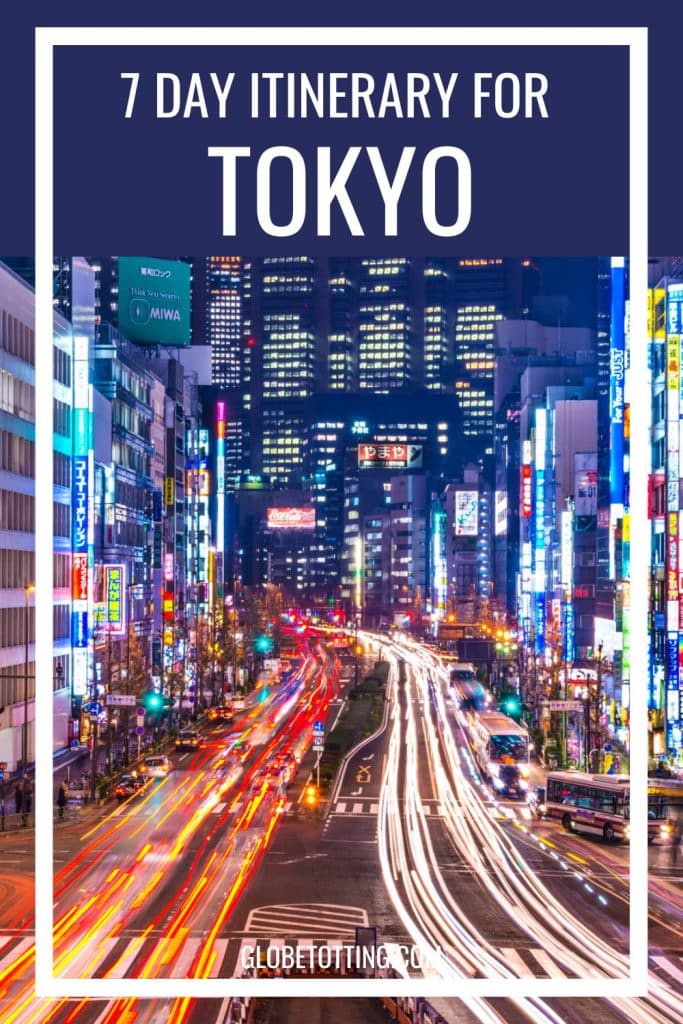
Share this post:
About the author.
Katja Gaskell

7 Day Tokyo Itinerary + Day Trip Ideas
Heading to Tokyo, Japan soon? Trying to figure out what to do there? Tokyo has LOTS of things to see and do, so much so that it can often be hard trying to figure out how to see all the best parts of the city with a limited amount of time. If you’re trying to figure out how to spend your time there, check out this 7 day Tokyo itinerary as well as some possible day trips from Tokyo!
Disclaimer: This post contains affiliate links. Find more information about affiliate links on our policy page .
- Before You Go
- Day 1 – Harajuku and Ikebukuro
- Day 2 – Shinjuku
- Day 3 – Shibuya
- Day 4 – Chuo and Asakusa
- Day 5 – Bunkyo
- Day 6 – Disney
- Day 7 – Akihabara and Ueno
Other Things to Do in Tokyo
Day trips from tokyo, getting around tokyo, where to stay in tokyo, what to budget for tokyo, before you begin.
If this is your first time traveling to Japan, I highly recommend doing some research into the country’s transportation system, customs, etc. I believe you’ll find it much easier to put together a Tokyo itinerary if you sort of know what you are getting yourself into.
Language Barrier
For the most part, you could probably survive in Japan without actually knowing any Japanese. Most of the signs have English translations, and many of the train stations have announcements in English as well as Japanese. As for people who speak English… it can be a hit or miss. I had scenarios where I ran into store attendants who spoke perfect English, and others who spoke little to none.
Regardless, I always think it’s a good idea to learn at least a few words in the local language before traveling. Not only does it make the trip less stressful, but I’ve found that locals are much more appreciative and open when they can see you’ve made an effort to understand them and learn their language and customs. This list of survival Japanese phrases can help you get started.
Navigating the Train System
If you come from a metropolitan area that has a well-developed subway or train system, you will probably be able to pick up Japan’s train system pretty easily. However, if you’re from a more rural area where you typically drive or maybe take the bus, Japan’s train system may be more than just a little intimidating. Getting familiar with the train system before you go will definitely make navigating it once you arrive in Japan much easier.
You may also want to look into the Japan Rail Pass and the Tokyo Subway ticket . Depending on how much you plan on doing in Tokyo and the rest of Japan, one or both of these may save you some money on transportation. I also advise getting an IC Card (Pasmo , Suica, ICOCA, etc), a reloadable card used for public transportation. Having one will make riding the train much easier instead of trying to purchase individual tickets each time you want to ride the train.
Best Apps to Download Before You Go
You know what else would make your trip to Tokyo a lot less stressful? Some hand-dandy apps on your phone! Check out this list of Japan travel apps to find helpful apps for getting directions, finding places to eat, and more.
Tokyo 2020 Olympics
Lastly, if you didn’t know this already, Tokyo is hosting the Summer Olympics in 2020. It’s definitely a once in a lifetime experience that you shouldn’t miss out on. Check out my book Tokyo 2020 Olympics For Dummies for details on how to plan your trip to the Olympics!
Tokyo 7 Day Itinerary

Tokyo Itinerary: Day 1 – Harajuku and Ikebukuro
Harajuku neighborhood.
Harajuku is well known for its street fashion and art and an icon of Japanese pop culture. Nothing says “Welcome to Japan!” more than the creative shops and streets filled with people wearing unique clothing, which is why it marks the start of this 7 day Tokyo itinerary. Here, you’ll be able to see fashion trends from super girly and pink to punk goth.
In my opinion, I thought the shops along the main street, Takeshita-dori or Takeshita Street, were a little expensive, but you can find some good deals if you look hard enough. There are also some used clothing stores in the area too. My personal favorite was Closet Child, a used clothing store in the punk and grunge scene. Plus, since Harajuku is such a popular tourist destination, many of the shop keepers speak at least some English, which makes the whole experience a little bit smoother.
Unfortunately, most of the shops don’t allow you to take photos, but most of the people walking along the street are happy to pose for photos and show off.
If possible, I recommend stopping by Harajuku on the weekend in order to get the full experience. Many of the people who get all dressed up are teenagers and young adults who would likely be at school or work during the weekday.
While you are there, it’s also worth checking out the various sweets shops sort of intermingled with the boutiques. In particular, look out for Harajuku’s infamous crepes, one of the best desserts in Tokyo !
Shopping in Ikebukuro
Ikebukuro isn’t as popular of a tourist destination as some of the other districts in Tokyo, but that doesn’t mean it’s not worth visiting. I studied abroad at Rikkyo University in Ikebukuro, so much of my spare time was usually spent hanging around in Sunshine City.
Since I was mostly in Ikebukuro for school, it’s not surprising that I frequently visited bookstores like Junkudo and Book-Off . Even if you’re not in Japan for school, these book stores are still worth a visit, especially if you’re interested in learning Japanese.
On one of the top floors of Junkudo, you can find several Japanese language learning text books for much cheaper than if you were to buy them outside of the country. If you are looking to buy some books to help you with reading Japanese (or if you just want Japanese versions of your favorite manga), I suggest heading over to Book-Off. It was probably one of my favorite stores in Japan because they sell used books that are in almost mint condition for super cheap.
If you’re looking to watch a Japanese movie, you can head over to Cinema Sunshine Ikebukuro. Just beware, that the Japanese movies won’t have English subtitles. The American movies (for example I saw Superman vs Batman here) will be in English with Japanese subtitles.
Tokyu Hands is a good general store that sells all sorts of different goods, from knicknacks, to household items, to pet supplies. Not only is it a great place to get some really unique office supplies such as cute erasers and erasable markers, but it’s also a great place to get small souvenirs for friends and family back home.
Across the street from Tokyu Hands is SEGA Ikebukuro Gigo, which has several floors worth of games ranging from crane games, to classic card games, to picture booths. It’s the ultimate arcade room!
If you are a fan of Pokemon, you’ll definitely want to stop by the Pokemon Center. There are several Pokemon Centers across Japan, but the largest is located in Ikebukuro. It’s even called Pokemon Center Mega Tokyo. When I went, they had large statues of Lucario and Mewtwo’s mega evolutions. Personally, I thought it was super cool (I’m a geek, I know). The only downside is that a lot of the merchandise is focused around the more popular Pokemon. If your favorite Pokemon isn’t very popular, chances are you’ll have a hard time finding anything.

Entertainment at Round One
If books, shopping, and movies aren’t your style, I recommend spending the afternoon at Round One Entertainment. Similar to SEGA Ikebukuro Giga, it has several floors dedicated to arcade games. However, the upper floors have bowling lanes and karaoke rooms. It’s easy to spend several hours here.
They have some of the popular arcade games such as air hockey (although it adds a little twist by randomly shooting little colored pucks onto the field throughout the game), but also has other arcade games unique to Japan like Taiko no Tatsujin (a drum rhythm game based off the Japanese Taiko drum). Even if you don’t play any of the arcade games, it can be fun just to people watch. Some of the people are scary good at the games like Taiko no Tatsujin, which makes for a pretty good show.
My friends versus frequent Taiko no Tatsujin players:
Bowling in Japan is just like bowling everywhere else. However, Round One occasionally has events like the Moonlight Strike Game that puts a slight twist on normal bowling. The only other thing that was slightly different for me was renting shoes. In America, the bowling shoes are often kept behind the main counter, but here they were kept in vending machines. There was a different vending machine for each of the shoe sizes and you just pressed a button to get the shoes. You’ll also probably have to convert your normal shoe size to Japanese shoe sizes (in centimeters).
I recommend getting your photo taken in a Japanese photo booth (purikura) at least once during your trip to Japan, whether you do it at Round One or another entertainment center. Unlike some traditional photo booths, you can add all sorts of text, stickers, backgrounds and filters. Plus, they make for great souvenirs.
Once you’ve had your fill of bowling and arcade games, you can end with some karaoke. It’s quite different from karaoke in the United States, and personally I think it’s much more enjoyable. In the United States, if you mention karaoke, people will likely think of getting on a small stage at a bar and singing in front of the other bar attendees. Due to the fact that you’d be singing in front of other people, many shy away from karaoke. However, in Japan, most modern karaoke venues (like Round One) have multiple private rooms for rent at affordable prices. This way, the only people you are singing in front of are the friends or family who go with you.
Tokyo Itinerary: Day 2 – Shinjuku
Shinjuku gyoen.
Shinjuku Garden, also called Shinjuku Gyoen, costs ¥200 (about $2 USD) to enter, but considering how awesome the place is, ¥200 is pretty cheap. It easily topped my list of best parks and gardens in Tokyo . I happened to be there during cherry blossom season , so the trees were a pretty pink color and the pathways were lined with fallen cherry blossom petals. However, even if you don’t go during cherry blossom season, the garden is still incredible.
Hanazono Jinja
Hanazono Jinja stands out from some of the shrines and temples on this 7 day Tokyo itinerary due to its bright orange color. It’s a relatively small temple complex, but unique due to the way it seems to be hidden within the city. You round a building corner and then BAM! You’re standing in front of a sacred shrine.
Tower Records
If you are interested in Japanese music like J-Pop, J-Rock, and more, Tower Records is the place to go. You’ve probably heard of Tower Records since they’re actually a retail chain found around the world, but at their Japanese locations you can find all sorts of Japanese CDs, records, promotional materials, and more.
Tokyo Metropolitan Government Building
The Tokyo Metropolitan Government Offices are a good place to visit if you’re interested in getting pictures of the city skyline for FREE. It’s not nearly as tall as Tokyo Skytree (which is on day 4 of this itinerary), but it’s good if you’re looking to get some pictures of the skyline without paying an arm and a leg. Unfortunately it was pretty cloudy when I went, but even if you don’t have the best weather when you go, it’s easy to swing by here again because it’s free. You can come as often as you want until you get that perfect picture. Plus, the architecture of the government buildings and the other buildings nearby are quite impressive.
Tokyo Itinerary: Day 3 – Shibuya
Meiji jingu.
Not only is Meiji Jingu considered one of the top attractions in the Shibuya district, it’s also a nice way to get away from the hustle and bustle of the city for a while. The shrine, which is dedicated to the spirits of Emporer Meiji and his wife, is located within an expansive park. Getting to the shrines involves walking along stone pathways through several trees, which makes it easy to forget that the city is just on the other side. Once you reach the shrine, you can get English versions of omikuji (Japanese fortune telling strips) and ema, a votive tablet where you write down your prayers and gratitude.
Yoyogi Park
Right next door to Meiji Jingu is Yoyogi Park. Thanks to its many pathways and open fields, it’s a great place to take a stroll or have a picnic with friends and family. It’s also a popular viewing spot during cherry blossom season and is easily one of the most instagrammable places is Tokyo .
Don Quijote
Don Quijote, or “donki,” is a popular chain discount store with locations all over Japan. Here you can find everything from sweets, to souvenirs, to cosmetics, to everyday goods such as luggage. If you’re looking for souvenirs from Japan, this is a great place to start.
Shibuya 109
If you are looking for a “mall” like shopping area, Shibuya 109, also caled ichi-maru-kyu or just maru-kyu, is a great place to start. It consists of several floors full of various women’s clothing retail stores that sell all sorts of clothing, shoes, accessories, and more. Personally, I’m not crazy into fashion, so I felt like a lot of the clothing was pretty expensive, but to somebody who is more into fashion, price may not be as much of a concern.
Hachiko Statue
This statue may not seem like much, but it represents a well-known story in Japan. According to the story, Hachiko was a dog that accompanied his master on his way to work and would patiently wait at the station for his return. Even after his master’s death, he would continue to wait for his master at the station every day until he too passed away ten years later.
Shibuya Crossing
Considered one of the busiest intersections in the world, Shibuya Crossing (also called the Shibuya Scramble), is a must see for any Tokyo itinerary. You can be one of the several people walking through the intersection, or you can get a top down view of the scramble from some of the nearby stores. To see it at its busiest, I suggest going on a weekday evening when workers and students are heading home for the day.
Tokyo Itinerary: Day 4 – Chuo and Asakusa
Imperial palace.
The Imperial Palace is the home of the Imperial Family and was previously the home of the shogunate (feudal military commanders and officials that governed Japan). Unfortunately the palace itself and most of the grounds are not open to visitors. However, the Imperial Palace East Gardens are open to the public year-round, and the inner grounds are open to the public on December 23rd and January 2nd. Guided tours of the grounds are also available in Japanese and English through the Imperial Household Agency.
Hama Rikyu Gardens
Originally serving as the home of a feudal lord, Hama Rikyu Gardens was turned into a strolling garden as part of the imperial palace before it was eventually opened up to the public. Here you can stroll along its many paths or enjoy the view from the teahouse on the edge of the water.
Himiko and Hotaluna Boats
Want to take a ride on a futuristic boat? You can do just that! The Himiko and Hotaruna boats were designed by famous anime and manga creator Leiji Matsumoto. During the ride, you can enjoy scenic views of the area as well as anime-like commentary (unfortunately it’s in Japanese and they don’t have an English translation). If you head to the Hanode Pier (right by Hama Rikyu Gardens) and catch the Hotaluna boat up to Asaka. It’s definitely a way more unique experience than catching the train up to Asaka.
When you first arrive at Senso-ji, you will find yourself at Kaminarimon, a massive gate that serves as the entrance to the shrine, and beyond that you’ll find Hozomon, the “Treasure House Gate.” At the main hall, you can try omikuji (similar to Meiji Shrine earlier in this Tokyo itinerary), “purify yourself” by washing your hands in the nearby fountain with the ladle, as well as cover yourself in the smoke of the incense, which is believed to have a healing effect.
Asakusa Shrine
Asakusa Shrine is located right next door and honors the three men who built Senso-ji. Along with praying, you can also pick up some omamori, or lucky charms. They have ones designed for general blessings or specific ones such as passing exams in school, succeeding in business, or protection of health. Personally, I picked up the kotsu-anzen omamori, which is supposed to provide protection for travelers.
Nakamise-dori
Just in front of Senso-ji is Nakamise-dori, a popular shopping street. Here you can try all sorts of traditional Japanese food as well as lots of cool souvenirs based off of Japanese culture and history. For example, you can find fans, wall scrolls, clothing, chopsticks, and more. Personally, I thought the souvenirs were a little expensive (I could probably find them cheaper elsewhere), but nowhere else will you find such a great selection of souvenirs in one location, so the convenience might be worth it. Plus, many of the shopkeepers speak at least some English.
Tokyo Skytree
At 2,080 feet (634 meters), Tokyo Skytree is the tallest tower in the world. It has two different observatories, one on the 445th floor and one on the 450th floor. If you’re looking for a place to get a fantastic view of the city, this would be it. I recommend going just before sunset and then hanging around to evening. This way you can see the city during the day, but also when it is all lit up at night.
Order tickets in advance for Tokyo Skytree through Klook or Get Your Guide .
Tokyo Itinerary: Day 5 – Bunkyo
Chinzan-so garden is actually the backyard of Hotel Chinzanso, which they opened up for the public. Unlike some other parks and gardens in Japan, there weren’t too many wide open spaces or fields, save for the pond in the center. Within the grounds you can also find a sacred tree which is 500 years old!
Higo Hosokawa Garden (Shin-Edogawa Garden)
Right across the street from Chinzan-so is Higo Hosokawa Garden (previously called Shin-Edogawa Garden). Like many other Japanese gardens, a pond serves as the focal point, and other dirt paths lead you around the rest of the garden. Up some stone steps, you can even get a good vantage point of the entire garden.
Koishikawa Korakuen
This park is a great place for heron viewing, so it’s not uncommon to see photographers camped out along the sides of the path. In the pond, you can also find some large koi fish and a turtle or two bathing in the sun. It also has a pond frequently filled with beautiful water lilies.
Rikugien is quite large in comparison to some of the other parks and gardens in Tokyo, and is often considered one of Tokyo’s most beautiful landscape gardens. It’s a great place to take a stroll, and with enough wandering, you’ll eventually come upon a high point where you can get a good view of the park below as well as the city in the background. It makes for a fantastic view, especially in the fall.
Origami Kaikan
Origami, the art of paper folding, is a popular part of Japanese culture. At Origami Kaikan, you can see several displays of various origami creations such as dinosaurs, animals, and even dragons. Some were so complex, it was hard to believe they were made from just paper. On the third floor they have a shop where you can buy different types of origami paper as well as instructional books. You can even take lessons, some of which are offered in multiple languages.
Tokyo Tower
The third and last observatory on this 7 day Tokyo itinerary is Tokyo Tower. The views aren’t as spectacular as Tokyo Skytree, and it’s not free like the metropolitan government building. However, it’s still a very iconic structure, most known for its own orange color (which is lit up at night). If you don’t want to take the elevator, you can climb 600 steps to the first observatory floor and get some fun facts along the way. When I went, the first floor observatory had a live show and was covered in blue lights. I had to go up to the second floor observatory to get good pictures since the blue lights on the first floor kept giving a reflection on the glass. However, if you are looking for just a place to hang out in the evening, the first floor observatory is a great place to have an evening of fun surrounded by beautiful scenery!
Order tickets in advance for Tokyo Tower through Klook or Get Your Guide .
Tokyo Itinerary: Day 6 – Disney
Tokyo disneysea.
Tokyo DisneySea is a must for any Tokyo itinerary, and will definitely take a full day to enjoy in its entirety. The park is divided into seven different “ports” and was inspired by the various myths and legends of the sea. Here you can check out attractions such as 20,000 Leagues Under the Sea, meet Disney characters, and watch their spectacular night show. You can find out more what it’s like to spend a day at Tokyo DisneySea .
Order tickets in advance for Tokyo DisneySea through Klook or Get Your Guide .
Tokyo Itinerary: Day 7 – Akihabara and Ueno
2k540 aki-oka artisan.
This is a great place to check out all sorts of handmade crafts and items. Because it’s all handmade, it’s a little expensive, but is all fantastic quality. Here, you can find all sorts of leather items, woodcraft, ceramics and more. In this area is also Aki-Oki Caravane, which is a good place to grab a bite to eat.
This place is for all the anime fans. You can find all sorts of keychains, clothing, décor, figurines and more from some of the most popular anime.
Akihabara Radio Kaikan
If Animate wasn’t enough, head to Akihabara Radio Kaikan, which has ten floors full of anime and pop culture related products.
Ueno Park is a large and spacious park located in central Tokyo. Like Yoyogi Park, it has a lot of spacious fields that make for a good place to have a picnic or throw a baseball around. It’s home to various museums and is also a popular spot for cherry blossom viewing.
Ameya Yokocho (Ameyoko)
Ameya Yokocho, often shortened to just Ameyoko, is a street lined with all sorts of shops, from general goods to souvenirs, to food. It’s probably most well-known for its candy sweets. Since most of the stalls are open, you can even watch them make much of the food. One of the shop keepers gave me a demonstration on how they made their special honey and peanut cookies. I’ll admit that the texture was a little strange because the outside is really stringy, but it was actually pretty good!
There are so many other things to do in Tokyo. If you have more time in Tokyo, or want to may substitute out something from my above mentioned 7 day Tokyo itinerary, check out these other things to do in Tokyo!
- Character-Themed Cafe
- Afternoon Tea at Luxury Hotel Shangri-La Tokyo
- Maid or Butler Cafe
- Ghibli Museum and Tokyo Open Air Architectural Museum
- Tsukiji Fish Market
- MANGEKYO Revolutionary New Drumming Entertainment
- Street Go Karting
- Traditional Towel Dyeing
- Japanese Tea Ceremony
- Robot Restaurant
- Oedo-Onsen-Monogatari
There are A LOT of great places just outside of Tokyo that are also worth visiting. It just depends on how you want to spend your time in Japan. If you’re looking to get out of the city for a day or two, check out these day trips from Tokyo!
Personally, I consider Nikko a “little Kyoto.” Similar to Kyoto, it’s full of history and culture, and is probably most well known for its many shrines and temples. Plus, it has a beautiful red bridge that I would often see pictured in train station advertisements. Check out the full Nikko guide to see all it has to offer.
Hakone is most well known for its natural onsen, or hot springs. Onsen are a very big part of Japanese culture, so hakone is definitely a great place to visit if you’re looking to get the onsen experience. You could also considering checking out Hakone Kowakien Yunessun , which is famous for its wine and green tea filled onsen.
As the previous seat of the shogunate (feudal military commanders and officials that governed Japan), Kamakura is a city rich in history. Among its many culturally important sights, probably one of the most famous is the Great Buddha (Daibutsu), the second tallest buddha statue in Japan (the first being in Nara).
Yokohama is the second largest city in Japan and is also home to Japan’s largest Chinatown. Other worthwhile attractions include a ramen and cup noodles museum as well as Cosmo Clock 21, a large ferris wheel location within Cosmo World Amusement Park. If you go at the right time, you might event catch the Pikachu Outbreak Festival !
Albeit a little far for a day trip from Tokyo, the Sendai and Matsushima area was probably one of my favorite Tokyo getaways. It’s not as popular of a tourist destination, so I felt like I got to experience true Japan life. Plus, most of the destinations I visited had little to no crowds. You can check out a full list of things to do in and around Sendai . You might also consider stopping at the Miyagi Zao Fox Village on your way there or on your way back.
Kawaguchiko and Mt. Fuji
Kawaguchiko is the second largest of the Fuji Five lakes, and is a great place to get some good views of Mount Fuji . Probably one of the most famous locations is Chureito-pagoda. Chances are, many of the famous pictures of Japan that you’ve seen were taken from this spot. There are also some other worthwhile sightseeing spots in the area such as Music Forest and Fuji Q Highland.
The easiest way to get around Tokyo is by train and subway. Some of these are owned and operated by the Japan Railway Company (JR) while others are privately owned. Probably the most useful for tourists is the JR Yamanote, which runs in a circle between many of the major Tokyo districts, including Akihabara, Ikebukuro, Harajuku, Shinjuku, and Shibuya.
I lived in a city called Asakadai in the Saitama prefecture when I studied abroad in Japan . While I think it’s a great area, it doesn’t really offer to many places for short-term visitors to stay.
For this Tokyo itinerary, I recommend staying in the Shinjuku area , as that will likely put you close to most of the destinations you’ll be visiting. Plus, Shinjuku station is also a hub for the Shinkansen (or bullet train), if you plan on heading to places like Osaka or Kyoto . Alternatively, you could also stay near Tokyo station , since that is also a major Shinkansen hub.
If you’re looking for a unique experience, you could always try staying in a cube or capsule hotel . However, make sure to do some research in advance, as many capsule hotels are men only (I learned this the hard way when I showed up!). Tokyo also has some great hostels , if that is more your style.
Tokyo and Japan as a whole has a bit of a reputation for being expensive, but honestly, I’m not entirely sure why. In comparison to some of the cities I’ve visited in the United States, I thought it was relatively cheap.
Accommodations
If you are traveling by yourself, you could try staying a capsule hotel. They’re definitely one of the cheapest options for accommodation and are great if you just need a place to sleep at night, but they don’t provide much in terms of amenities. Hostels are also great budget options with a little more comfort and flexibility.
Prices for hotels can vary significantly depending on what type of hotel you stay in and what time of the year you visit. However, I typically found 3-star hotels to be approximately $70 USD to $130 USD.
Transportation
This is one of those things that can quickly add up. A ride on the JR Yamanote Line, one of the most popular train lines in the Tokyo area, cost ¥250 or approximately $2.50 USD. It may not seem like much, but you’ll likely be riding the train a handful of times a day.
As mentioned a few times in this 7 day Tokyo itinerary, there are a couple of different things you can use to help save costs on transportation. The first is the Japan Rail Pass , which allows you to ride any train operated by the Japan Railway (JR) company an unlimited number of times for a set price. However, due to the steep upfront cost of the Japan Rail Pass, most times its only worth it if you plan on doing extensive travel outside the city. The other main option is the Tokyo Subway ticket . Similar to the JR Pass, it will let you ride the Tokyo Subway system as much as your want for the duration of the pass.
Food in Tokyo can be as expensive or cheap as you want. I typically found most ramen shops to offer bowls of ramen from ¥700 to ¥1000, which is approximately $7 USD to $10 USD. However, if you want to go to some of the fancy sushi restaurants, you’ll be looking at closer to $30 USD to $50 USD for a meal.
Like other items in your Tokyo budget, how much you spend on activities is entirely up to you. There are lots of things to do in Tokyo that are completely free. However, there are also activities such as Tokyo SkyTree that can cost ¥3,400 (approximately $34 USD).
Final Thoughts
What do you think of this 7 day Tokyo itinerary? Did you find it useful? Is there anything else you think should be added to this itinerary? Let me know in the comments below!
Liked this article? Pin it to Pinterest!
1 thought on “7 day tokyo itinerary + day trip ideas”.
I would dig Ikebukuro Kiyoko for the specific reason that it is not as visited by as many tourists. Works for me! These off the path spots are why I travel. You get to see more how locals live and less and less of shops geared toward visitors. I enjoy some Western creature comforts but prefer to see through the eyes of a local, and how they live. Rocking post buddy!
Leave a Comment Cancel Reply
Your email address will not be published. Required fields are marked *
Save my name, email, and website in this browser for the next time I comment.
This site uses Akismet to reduce spam. Learn how your comment data is processed .
Join my monthly email! Sign up

Your Ultimate 7-Day Tokyo Itinerary for 2024
A week might not seem long enough to see a city as interesting, diverse and distinctive as Tokyo, but you can actually fit a lot in. That’s why I’ve designed the ultimate 7-day Tokyo itinerary to help you make the most of the city in just one week.
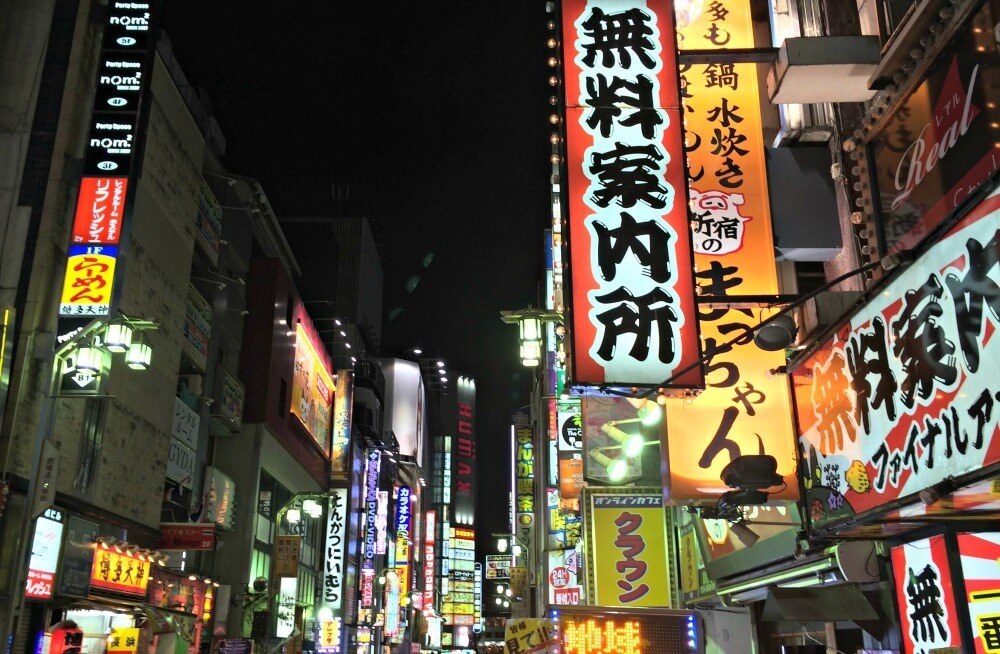
Tokyo, the dazzling capital city of Japan, promises an unforgettable experience. It’s truly a city that is unlike anywhere else you’ll have travelled to. It’s known for huge temples, palaces and theatres, as well as skyscrapers, amazing food, great nightlife and so much more.
So while there is so much to see and do in Tokyo, having a rough plan can help ensure you see all the important parts – especially if you’re only there for a week. This 7-day Tokyo itinerary helps you squeeze in as much of the must-sees and dos as possible, but also giving you time to act spontaneously too.
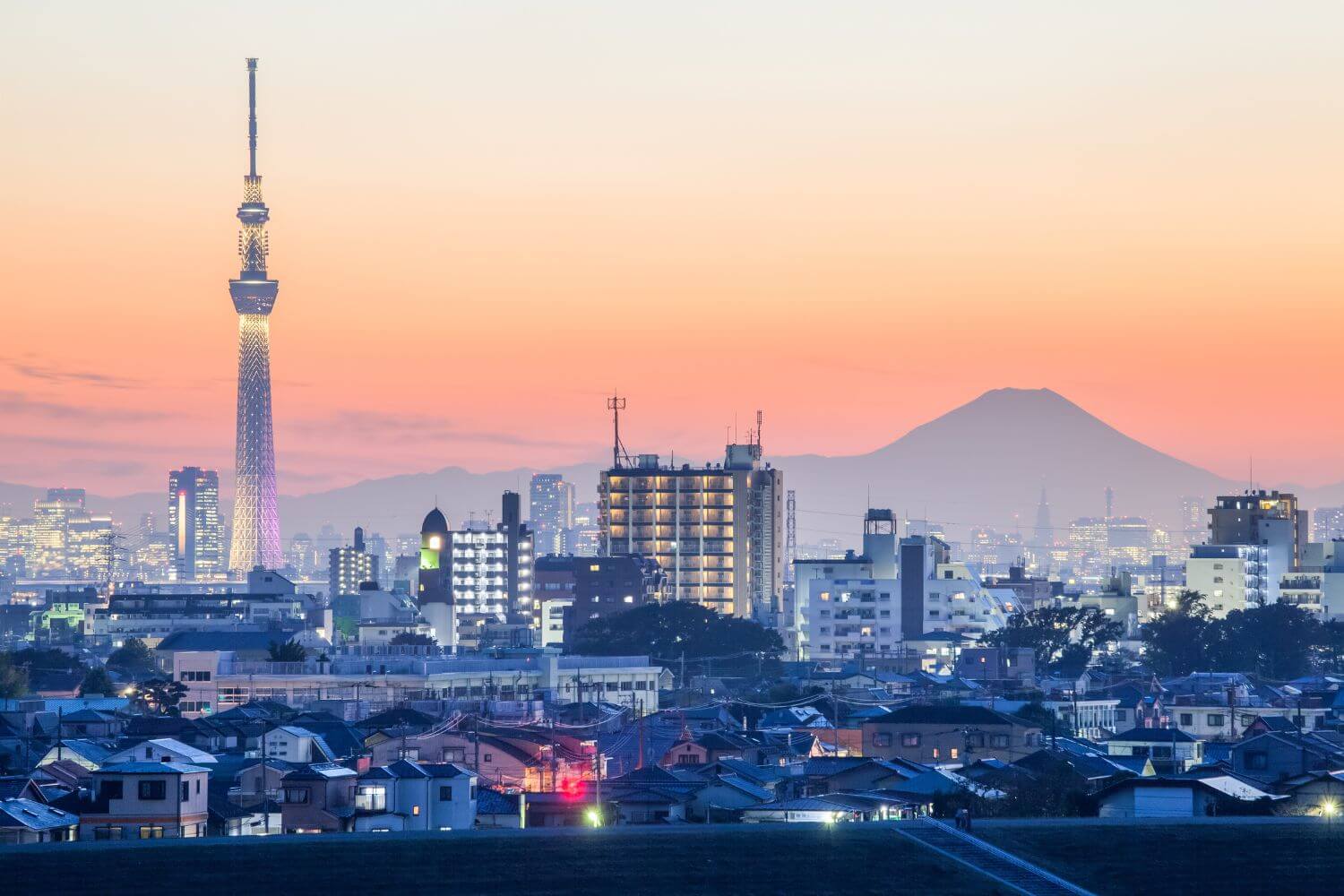
Even if you don’t follow the Tokyo week itinerary completely, it can help give you some ideas and inspiration for a fun and full trip. Find a mix of unique activities and sights as well as some popular ones that are tourist favourites for a reason. Together they provide the perfect blend for the ultimate 7-day itinerary in Tokyo.
How to spend a week in Tokyo
From visiting impressive shrines and temples to wandering around iconic neighbourhoods, this 7-day Tokyo itinerary has it all.
Day 1: Arrival and visit a local shrine or temple
The big day has arrived, your dreams of flying into the land of the rising sun is here and it is all happening so fast. After you make it through security and collect your luggage the first thing to do is head to the hotel.

Once you’ve settled in (and maybe slept if you’ve arrived late at night), the first thing to do is head out to see a local shrine or temple.
There are so many shrines and temples to see in Tokyo, but some of the most popular ones are Sengakuji Temple, featuring a zen school and famous graveyard, Kanda Myojin Shrine, which is the places to pray for good luck, marriage and wealth, and Tomioka Hachiman Shrine , the largest Hachimangu shrine in the city where the samurai prayed.
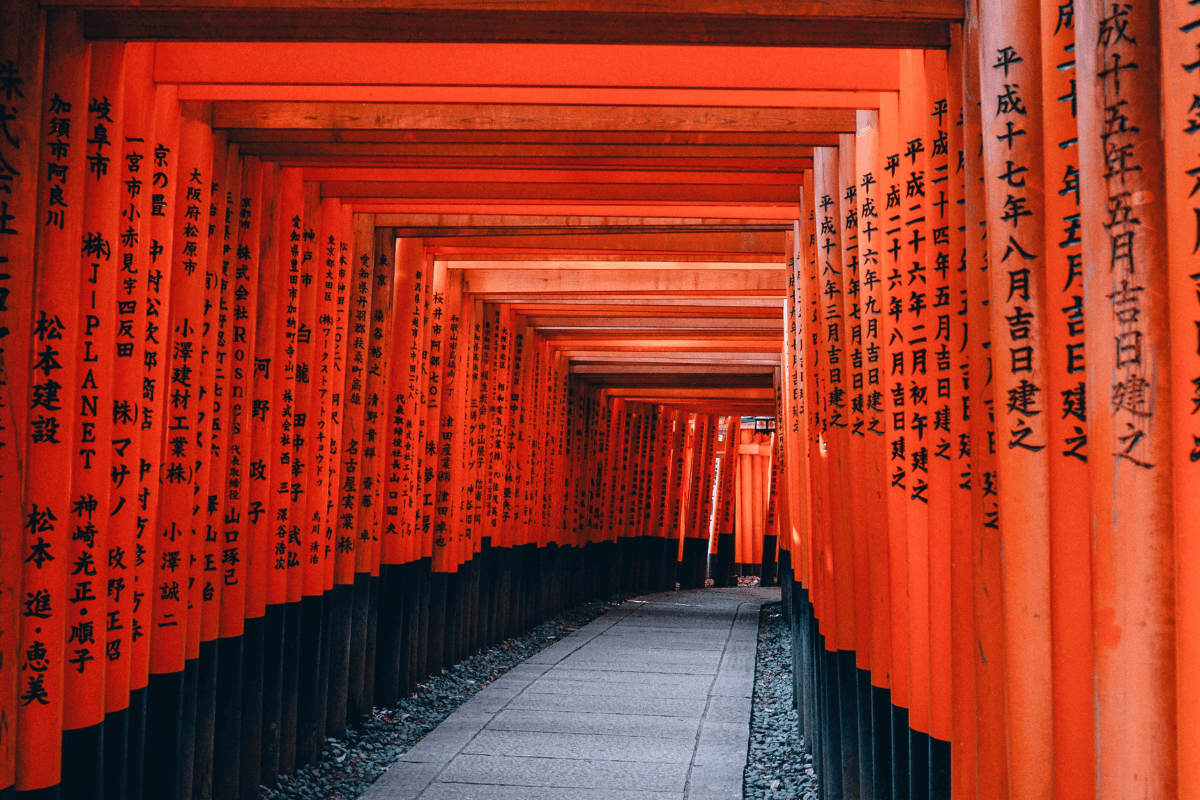
Places of worship, the Shinto and the Buddhist religion is intertwined so deeply in the vines of Japanese culture that a trip to this country will feel incomplete without checking out at least one. And for your first day, you could take it easy and just head to a local one (there are lots dotted around throughout Tokyo).
Shrines are associated with the Shinto religion and can usually be identified with its iconic Torii gates. On the other hand, temples are typically associated with Buddhism and often feature Buddha statues. You’ll notice this if you head to Senso-ji in Tokyo, but that will appear further on down the line in this 7-day Tokyo itinerary as it’s a must-see!
Day 2: Get your game on at Akihabara
In a country that is home to major pieces of pop culture such as anime and video games, Akihabara is the epicentre of all these things and more. As soon as you enter this district you’ll be met with soaring buildings, exhibiting banners and advertisements for all things otaku. Flashing lights and wacky noises will attack your senses from every direction as arcades and game stores line the streets. There are countless stores here that sell all your favourite anime figures, so whether it is a gift for a friend or yourself, this is the place to be. This is a great place to pick up those Japanese souvenirs to take home.
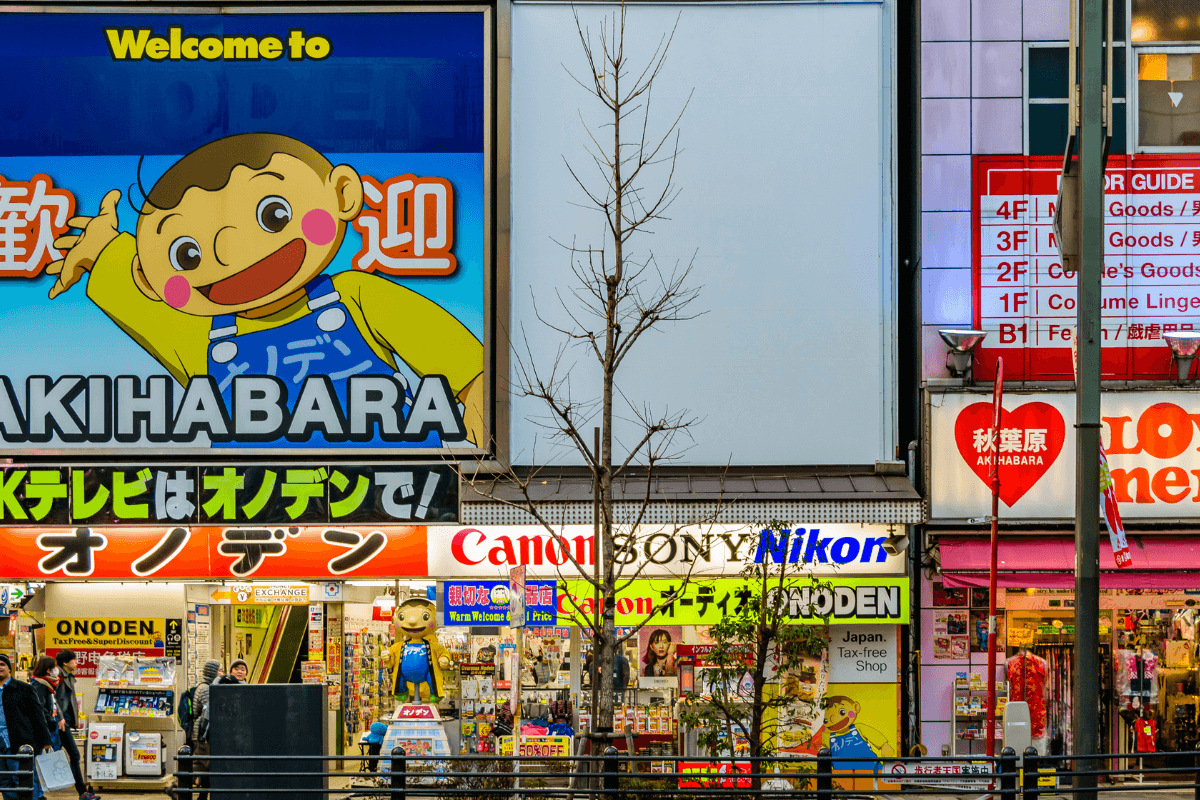
And if you really love old-school anime, then check out The Super Potato store . It’s a retro game store that carry not only older games for consoles like the Nintendo Entertainment System and the Atari, but they have the actual consoles too.
The great thing about the culture in Japan where people generally look after their belongings even after so many years, is that these consoles are mostly in very good condition. With how good some of them can be it will almost feel as if they are still being manufactured today.
You’ll end up spending hours popping in and out of stores, meandering between the streets and making tough decisions on what to buy that you could easily spend a full day here.
It’s also important in this 7-day Tokyo itinerary to get some downtime. So here you could visit the nearby Ueno Park where you can relax (and potentially admire all the stuff you just purchased).
READ MORE: The Best 3-Week Itinerary for Japan
Day 3: Visit Senso-ji, the oldest temple in Tokyo
After a day filled with pop culture, it is time to take things back again and head towards the historic Senso-ji Temple in . As mentioned earlier, this is the temple to go to in Tokyo. Over 1350 years old, Senso-ji is the oldest temple in Tokyo and is one of the most important too.
It’s dedicated to Kannon Bosatsu, the benevolent deity of compassion. Legend has it that two brothers retrieved a statue of Kannon from the Sumida River in 628. Despite multiple attempts to return it to the river, the statue mysteriously kept reappearing to them. Recognising the significance of this divine event, a shrine was constructed in the nearby area to enshrine this statue and facilitate worship.
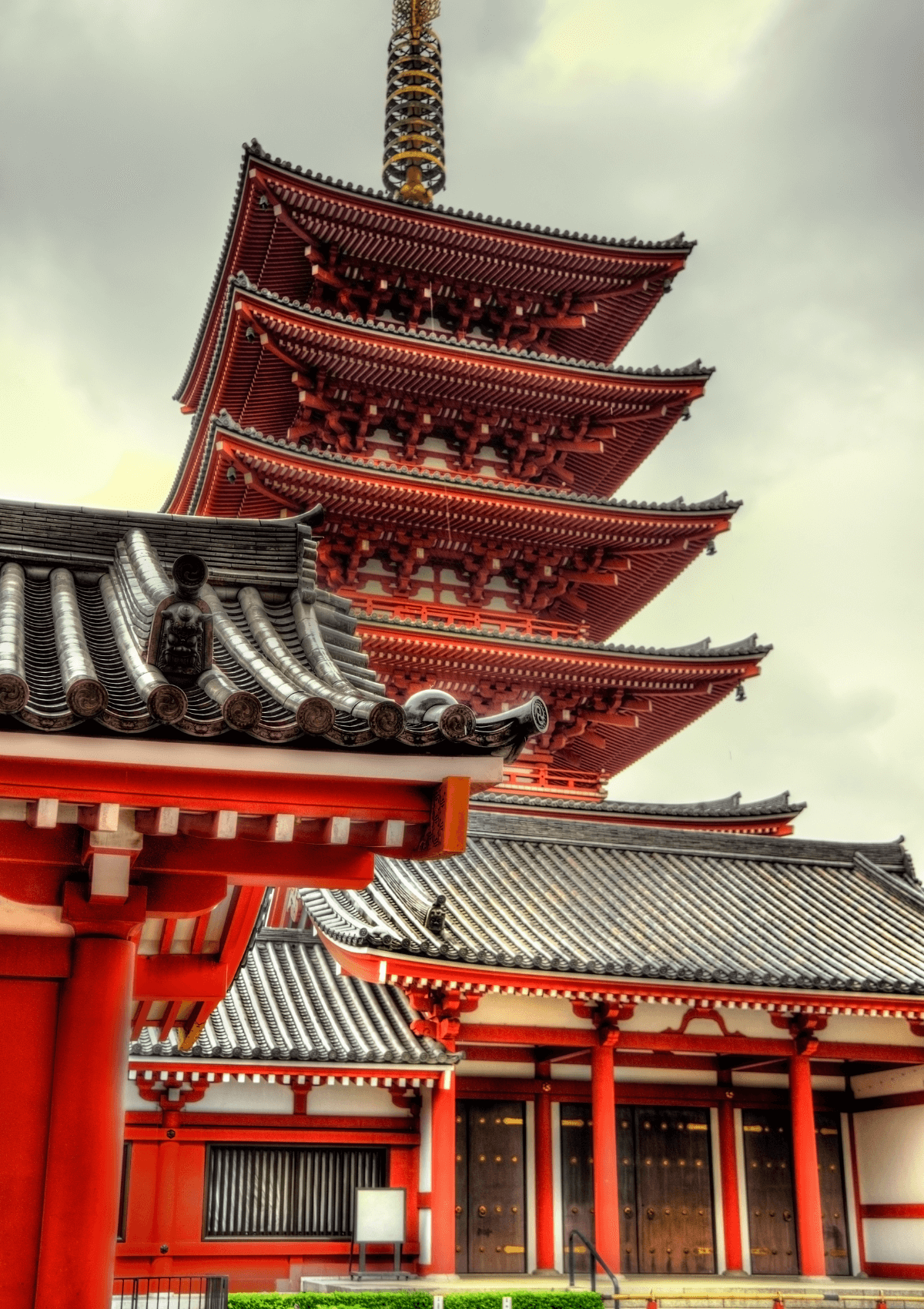
When you get to Senso-ji, stroll up the path slowly making your way towards the main building where you will be stunned with exquisite details and architecture. It can be quite crowded, given that 30 million of people flock here every year making it one of the most popular spiritual places in the world, it’s definitely still worth a visit at least once in your lifetime.
You can then enjoy the variety of shops on the 200-metre street in front. It’s a great place to buy anything from souvenirs to traditional food. Or head to the nearby Asakusa Shrine for more on your 7 days itinerary in Tokyo.
Day 4: Visit the modern neighbourhood of Shibuya
Very much a contrast to the previous day, Shibuya is the epitome of the modernisation that Tokyo is so well-known for internationally. As you walk through this area you will see high-end brand stores like Gucci, Louis Vuitton and Prada boasting large real estate and very much presenting exactly what sort of area this is.
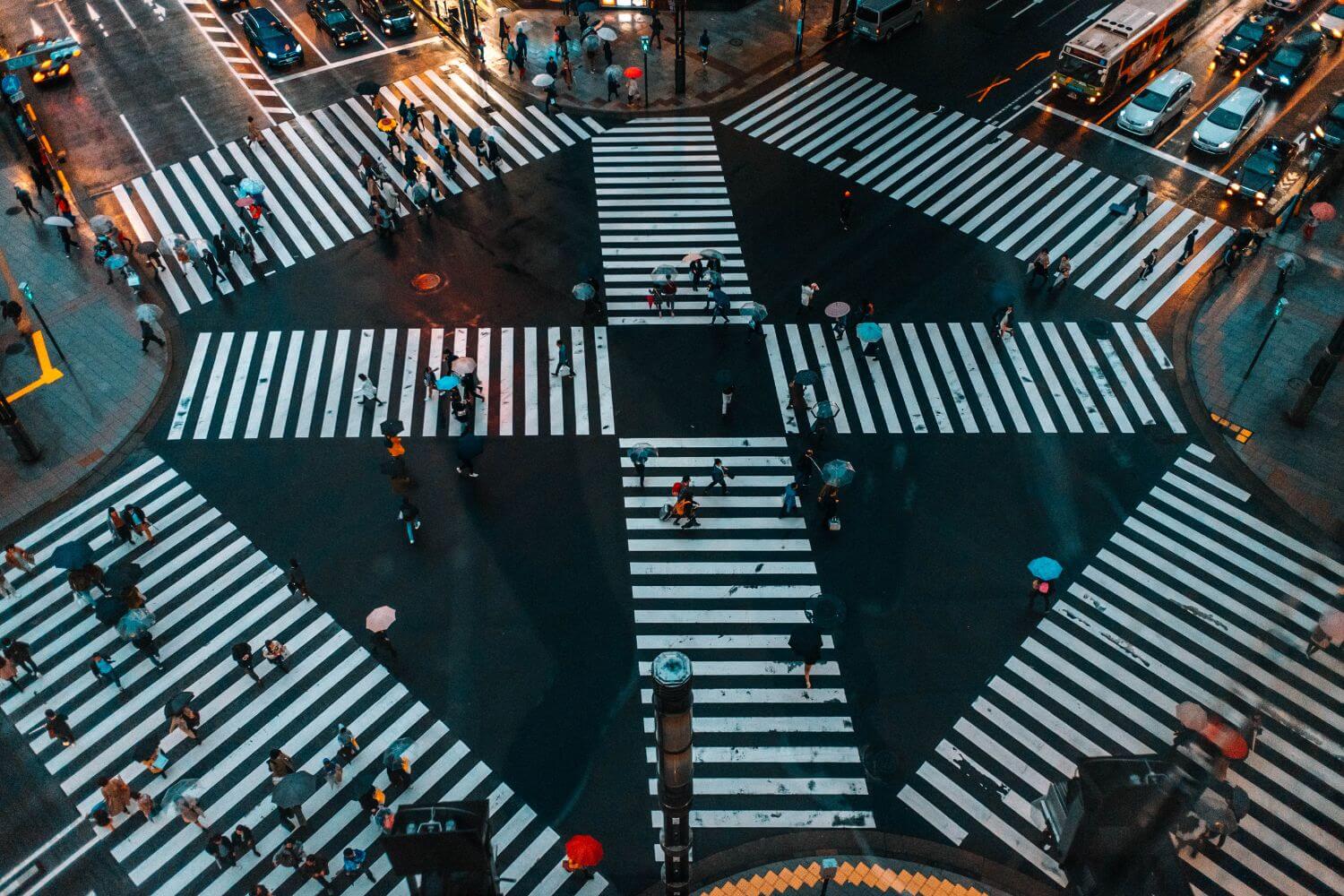
Right in the heart of it all you will find the cute little statue of the dog Hachiko, that tragically waited by the station for its owner to come home every day. Right beside it is the insane Shibuya Crossing too where you can witness thousands of people walk on the busiest pedestrian crossing in the world. You can also watch the crossing from above at Starbucks.
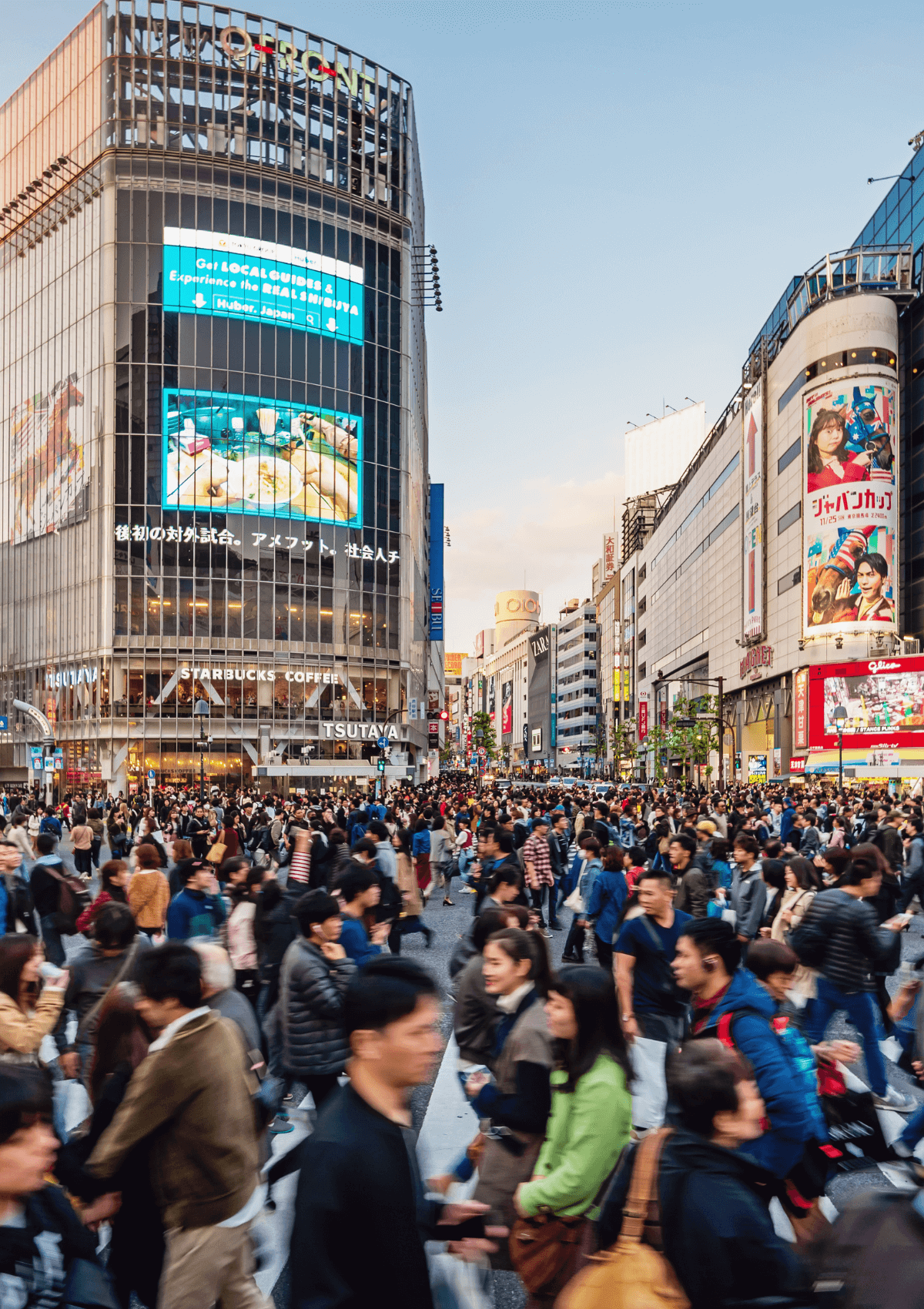
If you like art, Shibuya is a great place to visit. For contemporary art, head to the Diesel Art Gallery or the museum/theatre/cinema complex Bunkamura. Alternatively, go to the eighth floor of the shopping complex Shibuya Hikarie, which also features several gallery and event spaces dedicated to contemporary Japanese art.
In Shibuya, the crowds of people here are insane so lets hope you are not too claustrophobic. It’s one of the many things to expect on the streets of Tokyo . It’s such a drastic change to historic temples, but it’s important to include modern areas in your 7-day Tokyo itinerary if you really want to see everything the city is about.
Day 5: Relax at Tokyo’s Rikugien Gardens
While shrines and temples are synonymous with Japan’s culture, one aspect that gets overlooked more often than not are the beautiful gardens. Greenery and being in touch with nature is an important part of Japanese life and even in a concrete metropolis like Tokyo, you will still find many parks and gardens where there are often quite large.
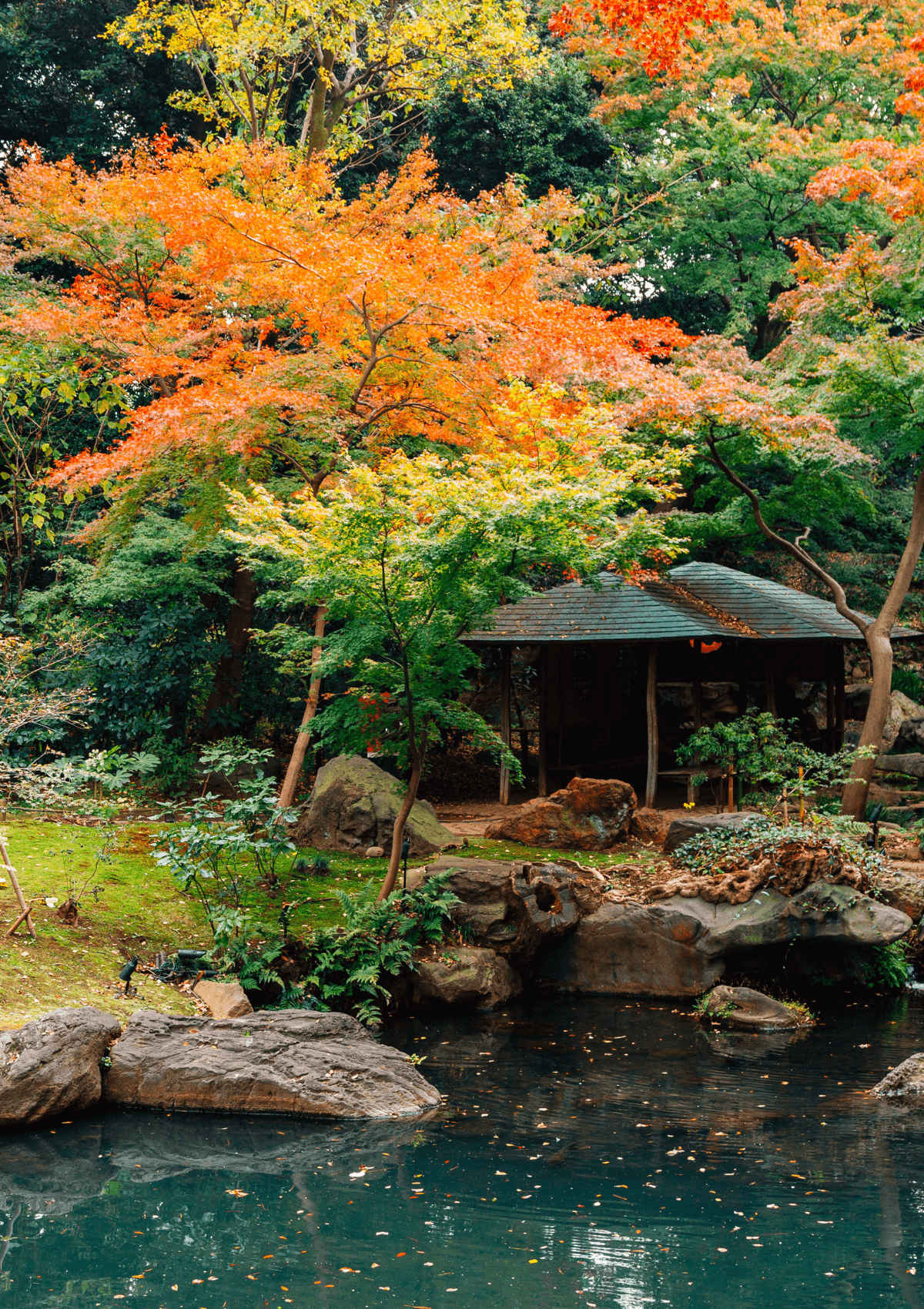
An example of one of these is Rikugien Gardens. Found in the Bunkyo Ward, this peaceful garden is a great place to visit all year round. Magnificent in spring with its weeping cherry blossom trees in full force, there is even an illumination event at night that accentuates its beauty further in the dark. Another popular time to visit is in autumn, where the trees become naturally coloured in fiery tones where this also has an illumination event at night.
For anyone visiting Tokyo in autumn, a bonus place to check out is the Jingu Gaien Ginkgo Avenue. As the name already suggests, this is a avenue lined with huge Ginkgo trees on either side that are a magical yellow and orange hue in autumn.
Ginkgo leaves play a role in Japanese culture where they are admired for their lovely fan-like shape and appear in artworks of all types and forms. It is used as a symbol of longevity due to the thousands of years a Ginkgo tree can last until, so this place becomes the perfect place for the most Japanese autumn you can imagine.
Day 6: Embrace calmness at the Meiji Jingu
Another day, another shrine. Winding down to the final full day of the 7-day Tokyo itinerary, a trip to the Meiji Jingu shrine to peacefully look back at your trip with fond memories is an ideal way to prepare for the potential heartbreak when stepping on the plane departing the country.
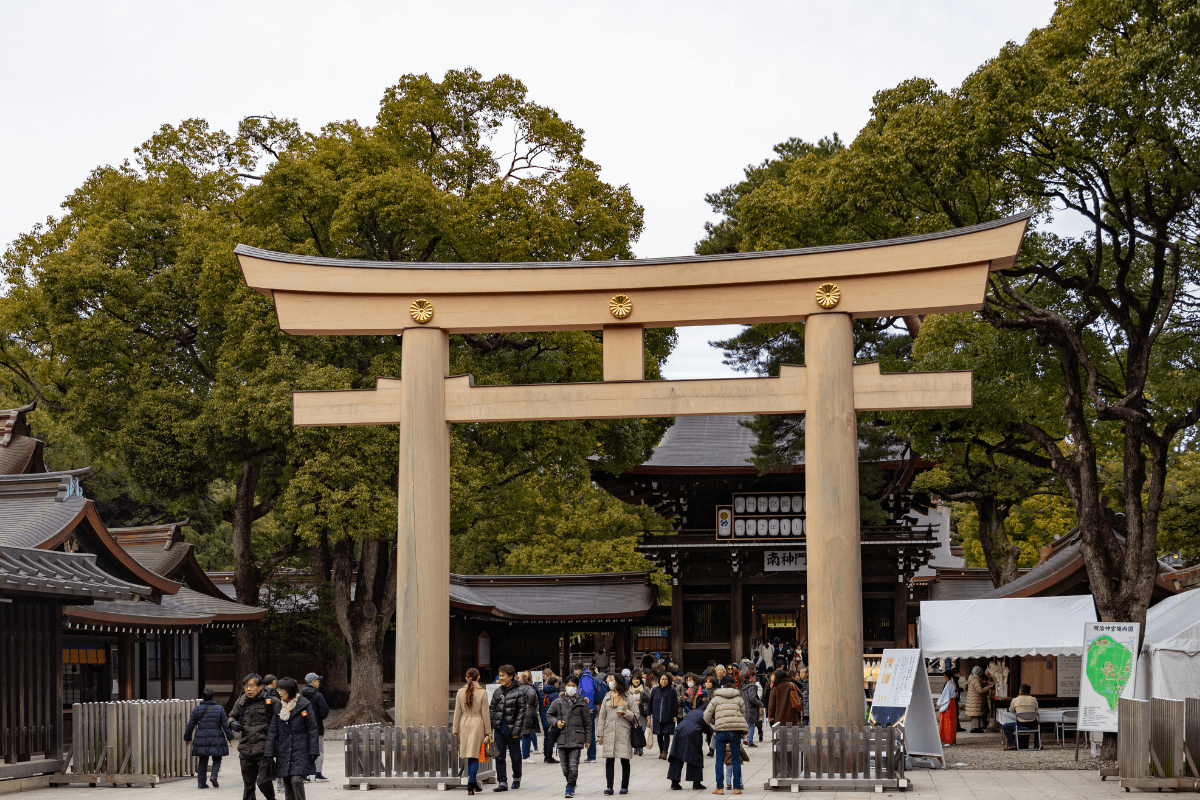
When you first enter the grounds there’s quite a long path up to the main area of the shrine. Surrounded by lofty thick trees that canopy the sunlight every so often, birds chirp in the distance as you really start to feel one with nature. There is just something special about the calmness of the air here as you walk along this path, gazing at the greenery, allowing your mind and soul to relax that brings pure serenity.
Once you reach the main square you will notice the balanced mix of traditional architectural designs with that of the modern. It is obvious to see that renovations here were not done to keep the original historic look intact but to give it the necessary improvements that It requires. This makes Meiji Jingu slightly unique as it is as if you are in this strange limbo zone where the past and present meet.
Day 7: Shop for souvenirs at Don Quijote
Even though the harsh reality has hit that it will now be time to say goodbye to Japan, you can’t leave without getting some essential souvenirs for your friends, loved ones and yourself of course! If you’re not sure what to buy – here are the best souvenirs from Japan to take home .
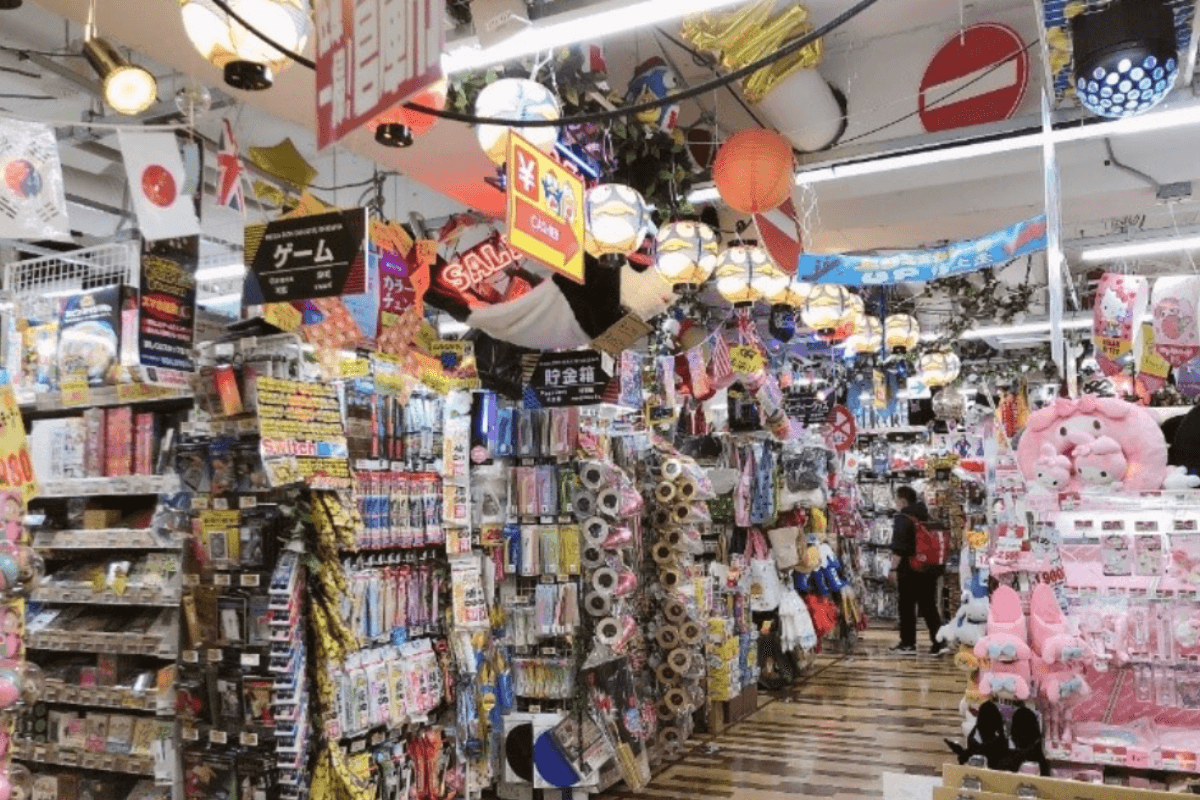
Don Quijote is a store you probably have seen a few times during your travels around Tokyo as it is characterised with a blue penguin that can be seen all over the stores signs and walls. This is a discount store that sells practically everything. And it means everything .
From snacks, clothes, suitcases, shoes, toys, makeup and more, you will be able to do all your souvenir shopping in one place right here. The standout section has got to be the snack aisles where you can find some of the most unique and interesting ones that you will not usually be able to find in any regular stores. They even sell large bulk packs of some of the more popular snacks, so you will be able to bring a whole supply of it home as long as you have the trunk space.
After all that is done and you have comfortably boarded the plane, there will be nothing else to do but to sit and reminisce all the fun you have had on this trip. You will already start planning your next trip back to Japan in your head, but hopefully with a longer stay and visits outside of Tokyo next time!
If you need more inspiration for your trip, I’ve got a list of 52 coolest things to do in Tokyo.
Tips on how to make the most of your week in Tokyo
Although a week is a good amount of time, a bit of planning will help you get the most out of the 7 days in Tokyo. Some other tips include purchasing the Tokyo Pass , which can save you money on various attractions, and the Suica Card or Pasmo card , which are prepaid cards used for buses, trains, and even some store purchases. They’re available at subway stations and airports.
You should also look into getting a rail pass for Japan to save money if you’re travelling around a lot.
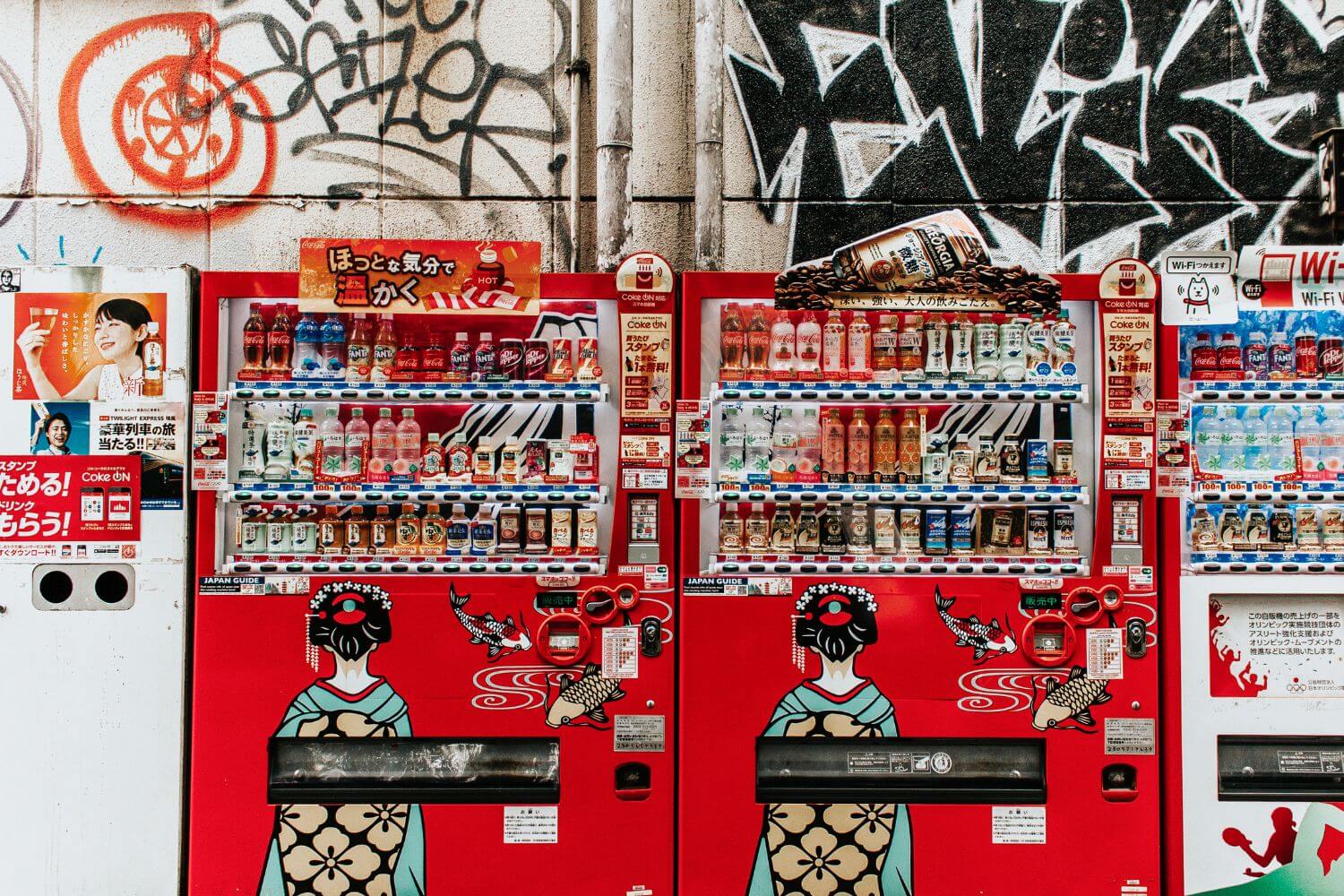
If possible, opt for flights to Haneda Airport (HND) over Narita (NRT). Haneda is closer to the city and can save you both time and money on transportation on your 7 days itinerary in Tokyo.
Other tips related to cultural etiquette include familiarising yourself with Japanese customs like removing shoes before entering certain spaces, bowing as a greeting, and understanding that tipping isn’t customary.
And finally, download Tokyo Google Maps for easier navigation. Also, apps like Tokyo Metro and Tokyo Subway can help in navigating the city’s metro system.
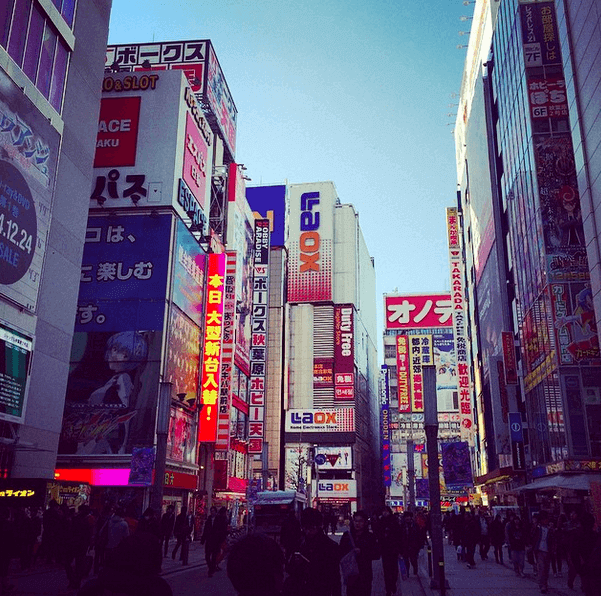
A 7-day Tokyo itinerary at a glance
- Day 1 – Arrival and visiting a local shrine or temple
- Day 2 – Get your game on at Akihabara
- Day 3 – Visit Senso-ji, the oldest temple in Tokyo
- Day 4 – Visit the modern neighbourhood of Shibuya
- Day 5 – Relax at Tokyo’s Rikugien Gardens
- Day 6 – Embrace calmness at the Meiji Jingu
- Day 7 – Shop for souvenirs at Don Quijote
More things to do in Tokyo in 7 days
If you’ve still got time for more activities in Tokyo in 7 days, here are a few more things you could add into your week’s itinerary:
Tokyo Disneyland
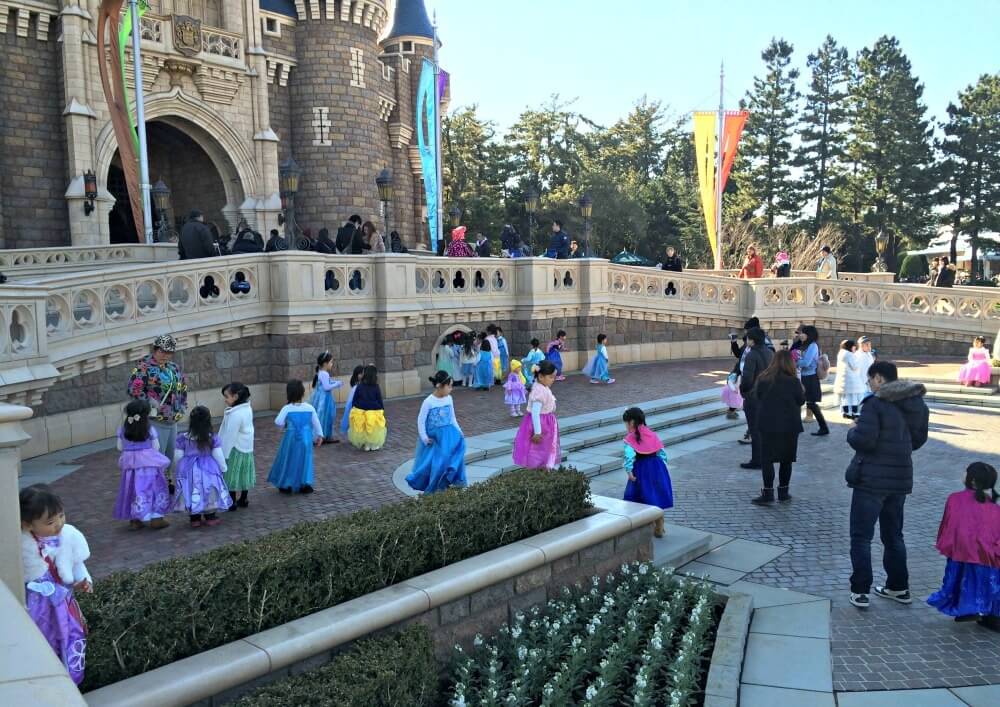
A day trip to Tokyo Disneyland is a great idea. It’s only about a 15-minute journey from Tokyo Station on public transportation. I loved, loved my day trip at Tokyo Disneyland – you should definitely try to include a trip in your Tokyo week itinerary.
Tokyo Skytree
Imagine soaring 634 meters high, taking in breathtaking views of Tokyo’s vibrant cityscape. You can enjoy panoramic scenes, futuristic architecture, and a city buzzing with life. It’s not just an observation deck; it’s a whole fun experience.
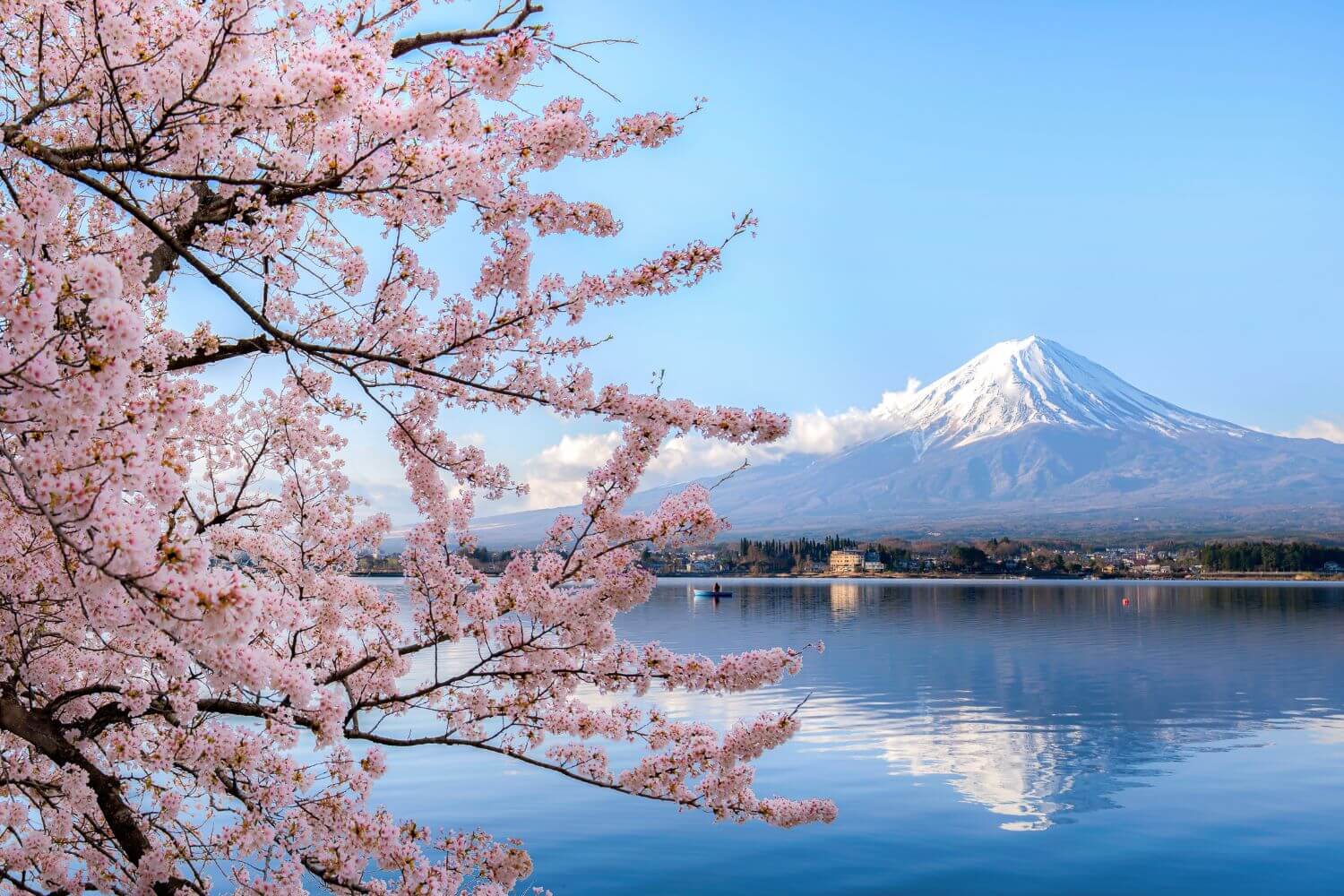
Mount Fuji is the icon of Tokyo, and one I’ve unfortunately not yet climbed. It’s easy to see on the Tokyo skyline though! If you have time, and energy, you can join a tour to climb up to the top in your 7 day Japan itinerary.
Tsukiji fish market
If you want to know where much of the sushi across Tokyo comes from, then visit the Tsukiji fish market. You’ll have to get here early to see all the action, but it’ll be well worth a trip. Just make sure it’s open for the season you’re there.
Food in Tokyo
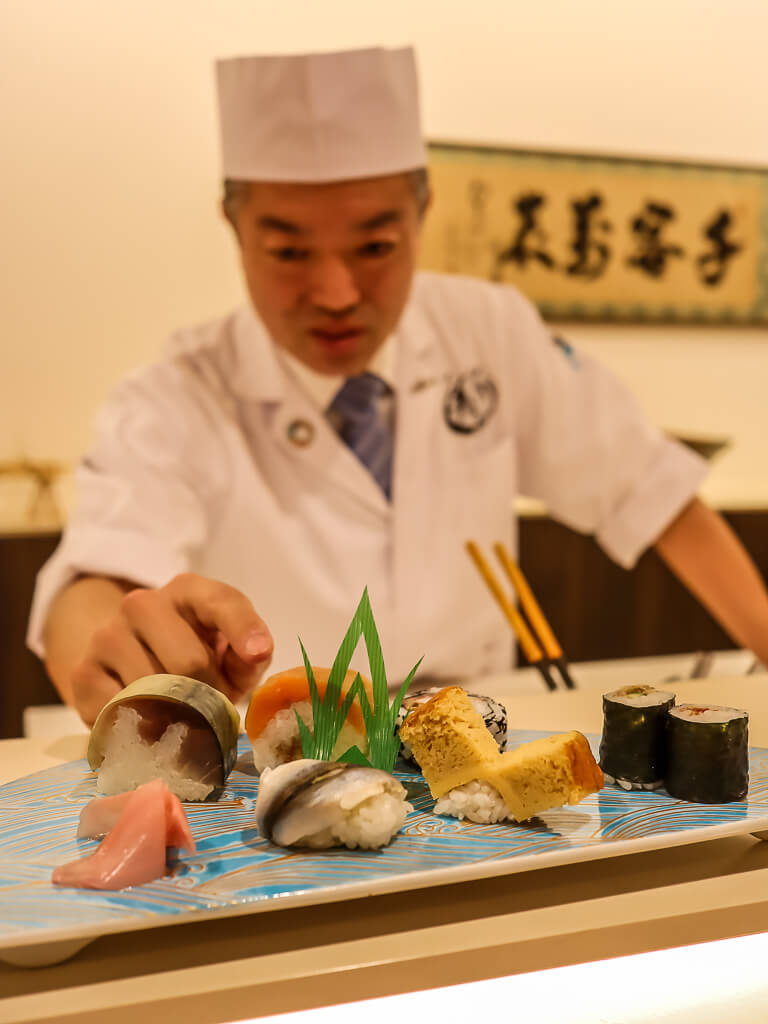
Obviously the food in Japan is one of the main draws, right? But it could also work out to be one of the most expensive things too. I’d recommend you make the most of the convenience stores in Japan – you can pick up all kinds of tasty food, very cheap. I really liked their tuna sandwiches with the crusts cut off, they were pretty special.
How expensive is Tokyo for a week?
I honestly haven’t found Tokyo to be that expensive at all. You can get a sushi feast for less than a fiver, one way on the metro is around £1 depending on where you’re going and I’ve paid an average of £15 a night for a mixture of accommodation.
I absolutely loved Tokyo. I’d recommend it to anyone, which is why I want to put your mind at rest about this rumoured ‘expensive Tokyo’ I’ve been told to expect. I kept a diary of all my Tokyo expenses for the first week I was there – here it is broken down into categories.
Cost of food in Tokyo
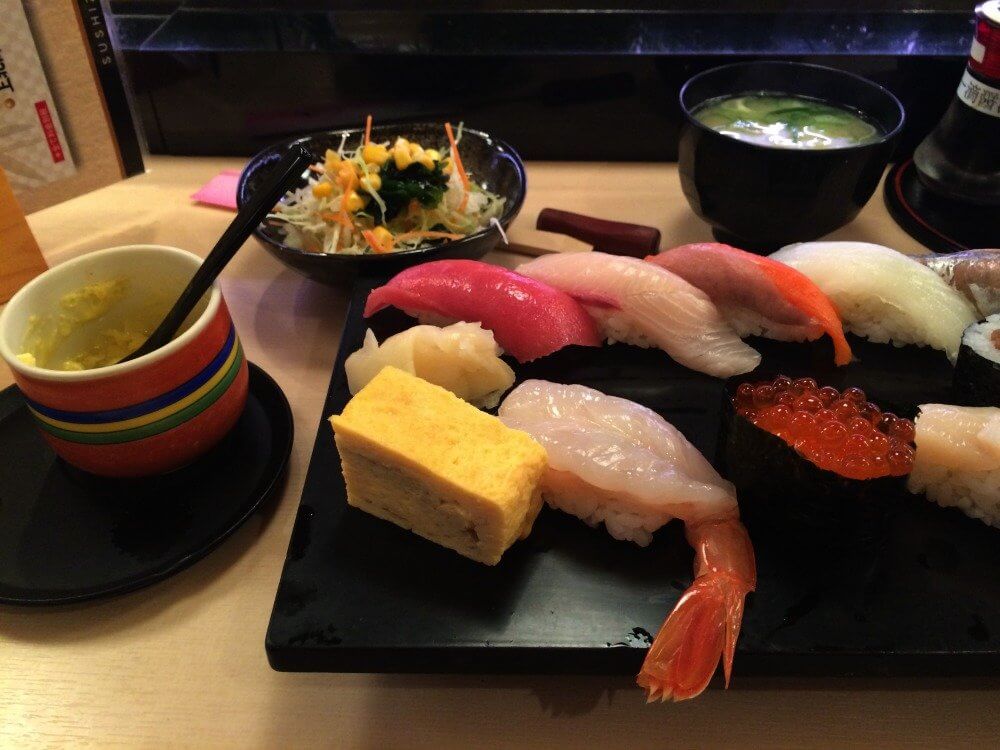
- Piece of sushi from 7/11 shop or similar = 100¥ | 55p
- Sushi feast (see above) at an average restaurant = 550¥ | £3.09
- Cashew nuts = 170¥ | 96p
- Ramen lunch with oolong tea = 1000¥ | £5.50
- Frozen yogurt with 4 toppings = 640¥ | £3.59
- Big sushi lunch deal in Ginza = 970¥ | £5.45
- Things out the breakfast machine = 320¥ | £1.79
- French toast ice cream and coffee = 1380¥ | £7.76
- Sushi dinner in Shinjinku = 850¥ | £4.77
- Disgusting noodle breakfast = 604¥ | £3.39
- Sweet potato cake and coffee = 650¥ | £3.65
- Hot dog and breakfast smoothie = 450¥ | £2.53
- Kebab and oolong tea at Jojola in Harajuku = 600¥ | £3.37
- Pik n mix sweets = 500¥ | £2.81
- Katsu curry = 650¥ | £3.65
- Hungover junk food at 7/11 = 800¥ | £4.49
- Sushi in Ryogoku = 950¥ | £5.34
- Dinner at the Robot Restaurant = 1000¥ | £5.62
Cost of transport in Tokyo
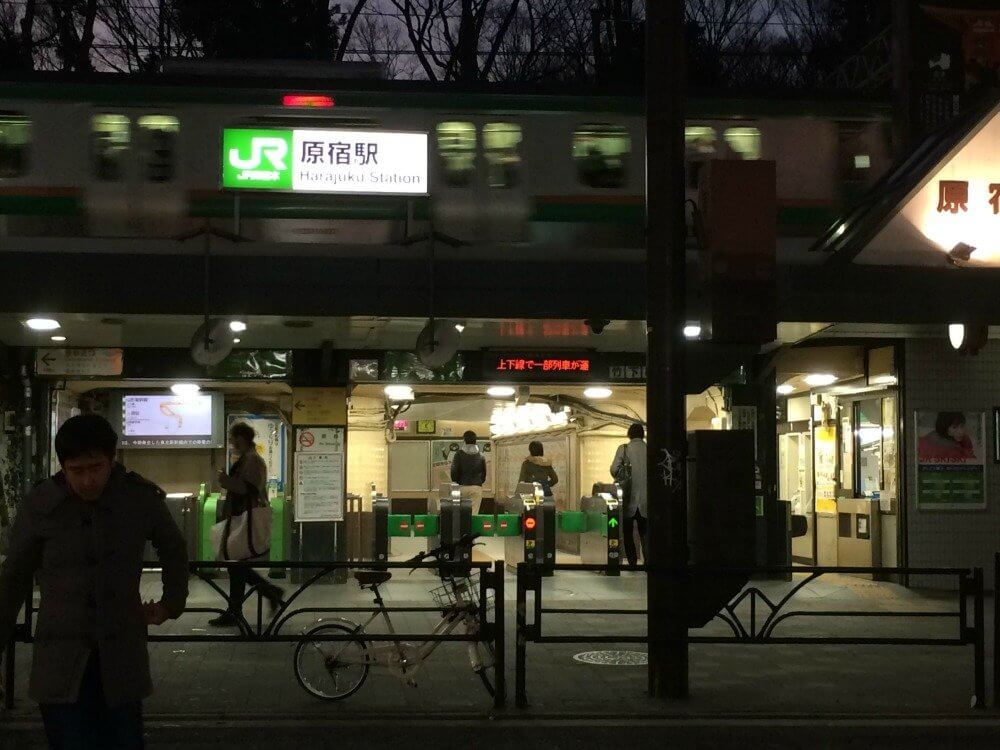
- Train from the Narita Airport to Asakusa = 1100¥ | £6.13
- Metro from Akihabara to Ueno = 140¥ | 77p
- Metro from Karamae to Odaiba = 380¥ | £2.12
- Metro from Odaiba to Ginza = 380¥ | £2.12
- Metro from Ginza to Asakusa = 200¥ | £1.11
- Metro from Asakusa to Shinjuku = 320¥ | £1.78
- Metro from Shinjuku to Ebisu = 320¥ | £1.78
- Metro from Harajuku to shinjuku = 160¥ | 89p
- Metro from Ueno to Ryogoku = 220¥ | £1.23
Cost of drink in Tokyo
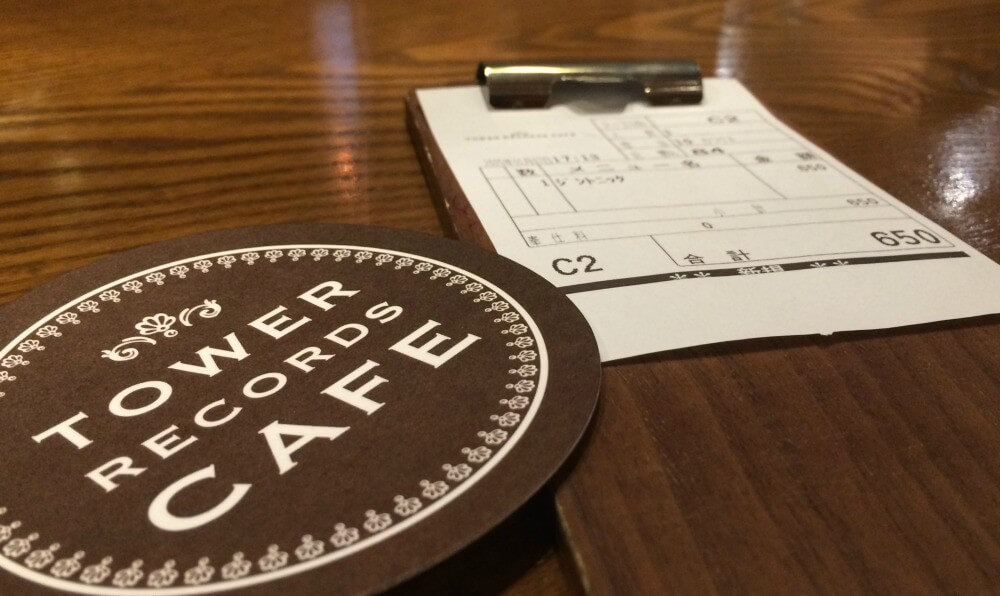
- Water at the airport = 110¥ | 61p
- Coffee at Excelsior Café in Akihabara = 350¥ | £1.95
- Orange juice at Time Out cafe = 500¥ | £2.78
- Gin and tonic at Tower Records Cafe = 650¥ | £3.62
- Brown stone cocktail and beef jerky at Brooklyn Parlour = 1500¥ | £8.35
- Drinks on pub crawl = 500¥ each x2 | £5.50
- Golden Gai beer, sake and meat stick = 1000¥ | £5.50
- Other bar = 500¥ each | £2.78
- Coffee at Mercedes Benz connection = 410¥ | £2.28
Cost of accommodation in Tokyo
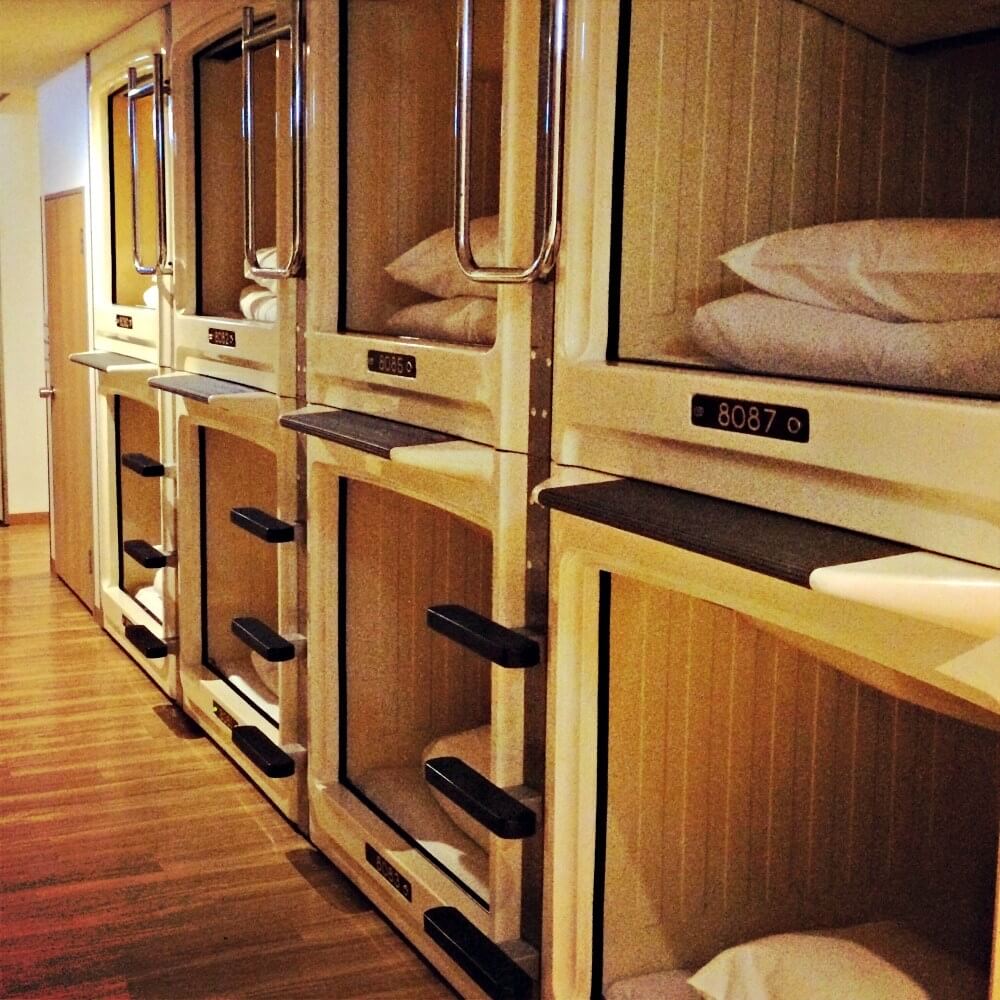
- 3 x a 10-bed dorm at World Ryokan in Asakusa 2200¥ x 3 | £12.25 x 3 = £36.75
- 2 x Capsule hotel 4500¥ x 2 | £25.04 x 2 = £50.08
- 3 x a 4-bed dorm at Anne Hostel in Ryogku 2500¥ | £13.91 x 3 = £41.73
I’d recommend all the places above. All were in a great location and had great facilities. I moved from the first one because it wasn’t very sociable, and I wanted to try the Capsule Hotel. I’d definitely recommend Anne Hostel over the other one though – more space, better bathrooms and a lot warmer!
Cost of activities in Tokyo
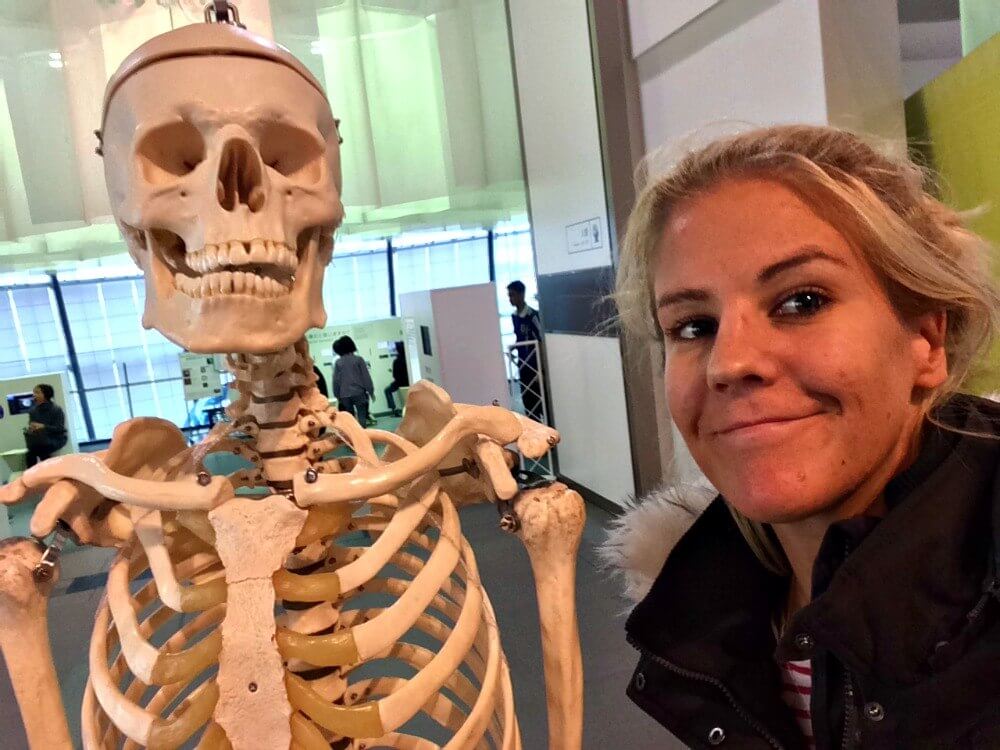
- Visit the Sensoji Temple = free
- Fortune at the Sensoji Temple = 100¥ | 55p
- Maid Café = 1900¥ | £10.31
- WiPremium Wi-Fi for a week = 2000¥ | £11.20
- Science Museum (pic above) = 640¥ | £3.56
- Ticket for Asgeir at Liquid Room = 5800¥ | £32.27
- Park entrance = 200¥ | £1.10
- Ueno park zoo and monorail = 750¥ | £4.17
- Pub crawl entrance = 1500¥ | £8.35
- Entrance to Richie Hawtin at Womb = 2000¥ | £11.20
- Pirukura = 400¥ | £2.23
- Sumo wrestling tickets = 2200¥ | £12.24
- Disneyland = 6400¥ | £35.61
So, my grand total for the cost of a week in Tokyo – including all food, drink, accommodation, transport and activities – was 86,400Y / £483.84.
Is 7 days enough in Tokyo?
Seven days in Tokyo can provide you with a good amount of time to visit most of the city’s main attractions. If you plan it well, you’ll also be able to fit in times to relax in parks and gardens as well as explore different neighbourhoods.
Is Tokyo an expensive city to visit?
Tokyo is often considered one of the world’s more expensive cities. However, costs can vary depending on factors such as your travel plans, budget size, and intended activities. One way to cut costs is to opt for the Tokyo Pass – if you’re planning to visit a lot of attractions at least. Additionally, when considering flight fares and accommodation, costs are typically at their most affordable between December and early March, excluding the New Year period when many businesses shut down.
What is the best month to visit Tokyo Japan?
Tokyo experiences four distinct seasons, each offering a different experience for travellers. Spring (March to May) is one of the most popular times to visit due to the cherry blossom season, which usually starts in the last week of March and lasts until the first week of April. Summer can be hot and humid, making it potentially uncomfortable for some visitors, but it remains a popular time for tourism, especially due to school holidays abroad. On the other hand, winter offers a colder climate with sunny days and is the cheapest time for tourism, excluding the New Year period. The city also has an autumn season, which makes the gardens and parks particularly beautiful.
Related Posts:
- The Cheapest Way to Travel from Tokyo to Osaka
- What it’s Like to Stay at a Capsule Hotel in Tokyo
- 21 Best Japanese Souvenirs to Celebrate Your Trip
- 11 Most Unique Places to Visit in Vietnam
- My Tips for Travelling Vietnam Solo
- The Perfect Japan 3 Week Itinerary: What You Need to Know
Hi, I'm Vicky! I wrote this. You can find me on all the social media @VickyFlipFlop. I love a bit of adventure, will try anything once, and have a strong passion for the local food and drink, whatever it may be. I'm here to help inspire you to travel to places a little out of your comfort zone, or at least to explore the usual destinations in a different way. Stay, have a look around, and if you have any questions – let me know below.
Leave a Reply Cancel reply
Your email address will not be published. Required fields are marked *
Sign me up for the newsletter!
7 days, 6 nights
The following is a suggested itinerary for first time travelers to Japan who spend 7 days and 6 nights in Japan, and arrive/depart from Tokyo 's Narita Airport .
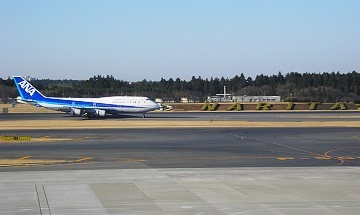
Day 1 - Arrive at Narita Airport
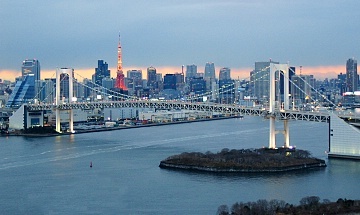
Day 2 - Tokyo
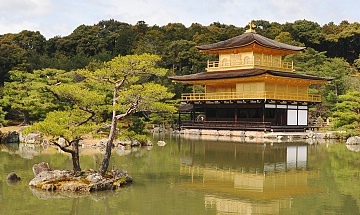
Day 3 - Tokyo to Kyoto
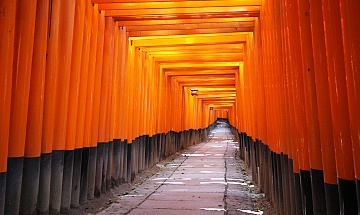
Day 4-5 - Kyoto
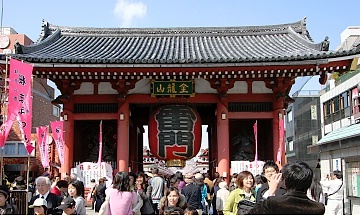
Day 6 - Kyoto to Tokyo
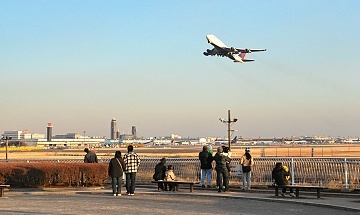
Day 7 - Depart from Narita Airport
Regular train tickets will be considerably cheaper than a Japan Rail Pass for this itinerary. Below are some sample budgets for the itinerary, excluding airfare. Find out more about the sample budgets and about the current yen exchange rates .
Questions? Ask in our forum .

One Week in Tokyo: The Ultimate Bucket List & 7 Day Itinerary
City Travel , Japan

This post is your one week in Tokyo bucket list with travel tips. Tokyo is anything but short on fun. You can spend a lifetime here visiting a new place every day and still never see it all. Let that be a hint.
This past summer I got to check off Tokyo from my bucket list. A city I dreamt about visiting for as long as I can remember. It was also my first time in Asia, so you can imagine my excitement. I didn’t want to waste any time exploring the city. After one week I left with great memories, learning lessons and a strong desire to return asap.
I’ve made this guide to show you my daily itinerary for 7 days, as well as, tips I’ve picked up along the way. It’s a great read to get you started in the planning process. Enjoy!
Psst. . . Looking for more guides around Japan? Check out my other posts.
How Much Spending Money for 2 Weeks in Japan? A Budget-Friendly Guide
- Top Things to do in Kobe: Japan’s Most Underrated City
Tokyo Disneysea vs Disneyland

Just another Instagrammer in Tokyo. But in my defense, the crosswalk was talking forever. How else is a girl with a camera supposed to kill time?
Know Before You Go: 7 Tips for Visiting Tokyo
These are tips I gathered from trial and error or trial and success I shall say.
1) Transportation doesn’t have to be expensive
There are two airports in Tokyo, Narita and Haneda. Both are far from the city center where many visitors stay. Taxis are incredibly expensive. For the same travel time but half the price, purchase a ticket after you land for the Limousine bus.
We booked our drop off location at the nearest metro station to our Airbnb and walked from there. The next morning we went back to the metro station and purchased our Suica Cards.
Suica Cards are the way to go for metro transportation around Tokyo. They work across all lines and can be purchased online for pickup on Klook or at a metro kiosk. You will be required to leave a 500 YEN deposit which is refundable when you return your Suica card.
From there you can upload however much you want. For the week that I was there, I spent around 6500 YEN ($60) on metro rides.
If you’re going out at night consider staying near clubs and bars because the metros close at 11 pm. If not, you risk a long walk home or a pricey taxi fare. Taxis are so expensive many locals will stay up all night until the subway lines reopen.
2) Sounds APPetizing
Download these apps to navigate the metros.
Tokyo Metro
Tokyo subway.
Unlike most other major cities, Tokyo’s metro lines are owned by three different companies, which makes getting around very confusing. T heir tracks never cross so you have to pay attention to the detail.
Our first day was the worst. Luckily, a nice man who spoke English helped us. We also downloaded the apps which I mentioned above and it was (mostly) smooth sailing from there.
3) Forget about SIM cards
Pocket WiFi is cheaper and the way to go. Don’t know what pocket wifi is? It’s the greatest thing ever. A small device you carry around that grants you unlimited data on multiple devices.
We rented our pocket WIFI from Japan Wireless . It was $75 for 2 weeks ($5.35/day). Verizon Wireless was going to charge me $10/ day for one device. No thank you. As for SIM cards, they are for only one device which could be shared via hotspot but pocket WiFi will give you further range.
PRO TIP: Order it online before you leave so that it’s ready from pickup at the airport.
4) No cash = problems
Japan is a cash-heavy economy. With so many small businesses unwilling to pay the credit card fees, they operate solely on cash.
If you plan to get off the beaten path or shop markets you need cash. I brought $500 worth of YEN in cash for two weeks.
5) This is how you use the toilet
Apparently squatting on top of the toilet seat in an issue because you will see a “do not do this” sign in every stall. I have never thought to do this, but if you have, please don’t.
All the bathrooms sound like a rainforest – that is the noise option found conveniently in your stall. If you have a shy bladder just know you can always turn on the rain noise from your toilet seat touchpad.
Sometimes the touchpad is on the wall and sometimes it’s adjacent to the seat.
If all else fails
You can always do as the westerners do and use the flush knob.
Unlike many European cities, public toilets are everywhere in Tokyo and free. I never ran into a problem of needing to pay to use. The public restrooms are actually quite nice, even at the metro stations. I brought toilet seat covers just to be safe but never needed them.
6) Passport tax break
We came across a few stores that offer to remove taxes upon showing your passport. This could come in handy if you’re shopping for souvenirs. Many stores will have a sign out front indicating the tax break.

If you plan to do any driving tours or rent a car you will need your International Driving Permit before you leave.
7) Get Your International Drivers Permit
There is one thing worth doing in Tokyo which I mention later that requires you to possess an international driver’s permit. You will need to get this before you leave for your trip. You can get it from a A A A office for $20.
Here’s how to apply:
1. Fill out the paperwork found on AAA
2. Get two passport photos (I got mine from Costco)
3. Bring a valid driver’s license
4. Go to a local AAA branch with all required documents and pay the $20
Should I stay in Shibuya or Shinjuku?
Given all the amazing neighborhoods, travelers are still very likely to book accommodation in Shibuya or Shinjuku. Both have tons of shopping, nightlife, and attractions, so my answer to you is book whatever hotel is within your budget and near a metro line. If that happens to be in Shibuya great. If that’s Shinjuku, also great.
Might I suggest a few hotels?
Hotel Tsubaki Kinshicho (love hotel) offers couples a relaxing space in the Sumida Ward District. If you’re interested in temples you will be near plenty. You’re also only a 4-minute walk to Kinshicho Station.
Hotel D-Wave Shinjuku (love hotel) is located in the heart of Shinjuku. Only a quarter-mile walk to Golden Gai and steps away from shopping and more.
Imperial Hotel (art nouveau) is a luxury hotel in Chiyoda City next to the Imperial Palace and several metro lines.
The Nine Hours Hotel (capsule hotel) for the budget-conscious traveler who is looking for a unique stay for less. The hotel itself is nicely decorated and a short walk to Asakusa station.
Keio Plaza Hotel (art nouveau)
JR Kyushu Hotel Blossom Shinjuku (luxury hotel) offers guests luxury in the heart of Shinjuku. You’re only a 3-minute walk from JR Shinjuku Station.
YOU MIGHT ALSO LIKE: Where Should I Stay in Singapore? Best Hotels for Tourists

Welcome to another world. Also known as Shinjuku.
One Week in Tokyo Itinerary
I now present my Tokyo bucket list – a mishmash of non-touristy and popular things you absolutely cannot miss despite the risk of being in a heavy tourist area.
To be honest, there are so many people living in Tokyo. It’s the most densely populated city in-the-world so the chances of you finding a spot that isn’t crowded are slim to none. I wouldn’t be worried about finding yourself in touristy areas for the sake of crowds because everywhere is crowded.
Tokyo is massive (no surprise there) so I found it helpful to explore 1-2 neighborhoods per day – leaving an extra day or two to revisit places if needed.
Knowing where is where will greatly help you navigate the city, so I’ve broken down this itinerary by neighborhoods along with points of interest in each.
The Exhausting Arrival Day
I recommend arriving at night and going straight to bed to help reset you to the new time zone. This is one way to combat jet lag . After a long flight you will inevitably be exhausted, so might as well arrive at a bedtime hour. This will help you be ready for the next day.

Those first-day feelings. When you stop and take a picture every 3 seconds because it all looks, unlike anything you have ever seen.
Another way to overcome jet lag is to wake up and fast until lunch. That said, you can start your morning with a nice workout, followed by a trip to the metro station to get your Suica card.
Explore Shinjuku
Tokyo Government Building has a free observation deck for you to come and enjoy your first views of Tokyo.
Visit the Takashimaya department store at Takashimaya Times Square. My favorite part is located in the food court. A massive floor with all kinds of goodies from artisanal bread, ice cream, chocolates, and more!
Drinks at Old Blind Cat . An old school dive bar with delicious cocktails. One of my girlfriends who is from Tokyo told me about this place so of course, I had to trust her recommendation. It’s exactly what you imagine a dive bar to be only way better drinks. If you love Old Fashions as much as I do, then it’s worth a quick visit.
ADDRESS: Japan, 〒160-0022 Tokyo, Shinjuku City, Shinjuku, 3

Dinner at Alice’s Fantasy Restaurant . I have been wanting to visit this restaurant since the early days of Pinterest. I kid you not, I saved a pin from this place years ago. Like when you could scroll to the end of your Pinterest feed. Early adopter heyyy.
This restaurant takes you on a larger than life adventure to the Queen of Hearts domain. Giant card troops and red heart-shaped tables transport you to a magical world. The servers are all dressed adorably like Alice.
ADDRESS: Japan, 〒160-0021 Tokyo, Shinjuku City, Kabukicho, 1 Chome−6−2 T-wing ビル B2
Golden Gai for a night out with the locals. There are over 270 of these tiny bars across a few rows known as Golden Gai. Most places will require a minimum drink spend so chose wisely.
Go to late-night Karaoke and sing with a live band at Pub Karaoke Studio Himawari .
ADDRESS: Miyata Bldg. 5F-B, 1-4-12 Kabuki-cho, Shinjuku, Tokyo ( Next to Shinjuku ward office, located on the fifth floor of Miyata building)
You might also like the famous Robot Caf e . I never got a solid review from people so decided to skip it. It’s expensive, the food menu looks awful, and I still don’t know what it’s about. I’m still mentioning it because I can’t truly knock something I haven’t tried.

Tokyo Disney marks my fourth park. You can imagine my excitement. A rainbow shirt purchase was 100% necessary. The writing says, “happy as a rainbow”. which was totally accurate.
The next two days will be spent at the happiest place on earth or at least one of them, Tokyo Disneyland and Disneysea . You want to purchase your tickets in advance online. The ticket lines get crazy and will waste so much time. We got 2 two day pass for $244.
Below are some purchase options from Get Your Guide. I use them for everything! I also wrote a separate post showing the differences between Tokyo Disneysea and Disneyland with a video!
YOU MIGHT ALSO LIKE: What to Wear to Disneyland if You’re A Rose Gold Loving Princess

Teamlab Borderless is an interactive art experience. There are no words to describe how magnificent this place is.
Get an early start to your day at Teamlab Borderless . They open at 10 am. I recommend getting there about 15 minutes before they open so you can be the first person in. It will get super busy, so if you want to enjoy the rooms without waiting in lines, go early.
Teamlab Borderless will take you a couple of hours to experience it all after which you can get lunch nearby for head to Shibuya station.

Mirrors, mirrors, around the walls. Who is the fairest of them all? My boyfriend for capturing this moment.
Explore Shibuya
Shibuya is known for cutting edge clothing stores, a wide array of dining options, and vibrant nightlife.
Shibuya is also home to the busiest crosswalk in the world. People from around the world come to both view the madness and join in with fellow pedestrians as they scramble from one side to the other.

The Shibuya scramble from Starbucks.
One of the best places to view Shibuya crossing is the nearby Starbucks. Once you exit Shibuya station you will see the Starbucks sign. You can’t miss it.
This Starbucks also happens to be one of the busiest ones in the world. Coincidence? I think not. We got lucky and found a couple leaving as we were coming in, but if you find yourself without a view, head to one of these nearby and equally great viewpoints:
Mag’s Park at the Magnet by Shibuya 109 . You do have to pay an entrance fee to enter this open-air observation deck. Hours of operation are daily between 11 am – 11 pm.
L’occitane cafe on the 2nd or 3rd floor will offer great views of the crosswalk. if you’re hungry it might be worth it to have your lunch here while enjoying the views., shibuya station has decent views. it would be so much better if the glass didn’t have a design on them..

The main gate marks the entrance to the sacred grounds.
Find peace at Meiji Shrine – a dedication to the deity of Emperor Meiji. He was the first Emporer to modernize and westernize Japan to join with major world powers.
Once you pass the main gate (shown above), you will have a decent walk to the Meiji Shrine with stop-offs along the way. There are a lot of things to see here which require admissions. The Meiji Shrine, however, is free to enter.
P.S. You are not permitted to bring food in.
Grab a drink at Tight . Tight is a tiny bar in the Shibuya drinking alley that fits maybe 5 people comfortably. It’s hard to find if you’re not paying attention. They have a tiny sign outside.
Its small size is not the only thing that makes Tight unique. They also infuse their own liquor in-house such as peach brandy and lemon gin to use in their delicious cocktails. Overall, it was a great atmosphere with great concoctions.
ADDRESS: 1 Chome-25-10 , Shibuya, Tokyo Prefecture

Having fun twirling around Takeshita Dori in my Lolita dress from To Alice.
Explore Harajuku
Harajuku is located between Shibuya and Shinjuku. Takeshita Dori is the famous shopping street here and center to all things Kawaii meaning “cute”.
You cannot walk down this street and not feel joy with the amount of adorable pink things inside every store. One of the best stores is To Alice ; A Lolita fashion store. That’s where I bought the dress you see in the picture above. Worth every cent.

Meet Harry the Hedgehog. He has sass and loves to nap in the palm of your hands.
The Hedgehog Cafe is less of a cafe and more so an animal store where potential buyers can pay to play with the hedgehogs for an hour. They do encourage you to adopt one at the end of your visit.
Get dessert before dinner at Dobutsuen The Zoo Ice Cream Shop . Not only is the ice cream adorable, but it was also one of the best we had during our whole trip to Japan. So good!

The price of each place is determined by color and design. Be sure to look at your menu before picking up from the conveyor belt.
Conveyer belt Sushi for dinner is a must. Price is determined by color and design of the plate so if you’re not paying attention you might be picking up a plate costing 500 Yen. A full meal for one person plus beer and tip cost $25.
If you don’t see what you’re looking for on the conveyor belt, just ask the cook to make it for you. The menus list a few order phrases for non-Japanese speaking guests.
YOU MIGHT ALSO LIKE: 3 Days in Bangkok: Thailand’s City of Angels
Start your morning with a little thrill at Street Kart Tokyo Bay BBQ . Dress up as your favorite Disney, Superhero or Anime character and hit the road in, you guessed it, a go-kart. It was awesome!
This is the time for you to whip our your international driving permit and passport. After, you will watch a short safety video then hit the road.
Make sure you say hi to Aydan. He was our awesome tour guide who comforted me when I got nervous about driving on the busy streets of Tokyo in a go-kart.

What I love most about Tokyo are all the lights. It’s the ultimate urban metropolis.
Explore Akihabara
Akihabara is known as the anime district. It’s home to tons of arcades and shops with all kinds of anime goods; SEGA being the most popular one.
While you’re walking in awe, stop in a few retail shops to discover what’s inside. We ended up in a retro card exchange shop with expensive AF Pokemon trading cards.
Of course, we had to experience the SEGA arcades . This is not what you imagine an arcade to be. Some floors are only claw machines while others are sit down games; I can’t even begin to explain it.
Hitachino Brewing Lab is a local craft beer bar worth stopping by.
ADDRESS: Japan, 〒101-0041 Tokyo, Chiyoda City, Kanda Sudacho, 1 Chome−25-4

Only smiles at the Senso-Ji shrine.
Explore Asakusa
Asakusa is home to Senso-Ji Shrine – Tokyo’s oldest temple. It’s a large ground with lots of activities for cost. We paid to shake out our fortune from a box and bought burners to toss into some spiritual bowl. Honestly, it was all a smokey blur but fun to say the least.
You do need to remember that this is a sacred place so be respectful of the people who come to worship. If the signs say no photography then respect their wishes.
We got lucky and caught a wedding ceremony. That was really cool to witness for a brief moment. Maybe the same will happen to you.
You will break for lunch at Nakamise Shopping Street . This is a wonderful market with a mix of food and goods.

Tokyo Dome City is home to amusement rides, shopping, dining, and event arena.
The final day. By this time, you will be a little worried you didn’t see everything and that’s because you didn’t. Tokyo is just too big to see it all. I felt the same way but had to check myself and realize I still saw a lot and for that I was grateful.
To end your journey with some adventure and cheer, head to Tokyo Dome Cit y for thrills and meals.
Tokyo Dome City is an entertainment complex; home to amusement rides, dining, shopping, arcades, and a concert hall where you might catch a K-Pop concert. It was a great ending to a perfect week.
YOU MIGHT ALSO LIKE: One Week in Singapore: Massive Bucket List & Travel Tips

Green tea soft serve ice cream from Nakamise Market.
How much does it cost to visit Tokyo for a week?
Tokyo is known to be very expensive. It’s not a lie. Because of this, we watched our pennies when it came to food and drinks. We didn’t drink much alcohol and shopped at local grocery stores where we bought water, snacks and the occasional lunch or late-night snack.
Here is how much I spent over one week in Tokyo:
Accommodation $884
Airbnb: $884, transportation $128, airport transfer $8, suica card $120, food & drink $230, attractions & shopping $345, senso-ji activities: $2, arcade games: $8, rides at tokyo dome: $5, street kart tip: $5, disneyland: $103, shopping in harajuku $162, teamlab borderless $60.
Total cost for 1-week in Tokyo for two people: $1,579. This does not include international flights or pocket wifi which is included in my total cost for 2-weeks in Japan.
YOU MIGHT ALSO LIKE: How Much Spending Money for Japan for 2-Weeks? (A Budget-Friendly Guide)

Kawaii fashion comes in two forms. The colorful and the gothic. Special thanks to these people for allowing me to snap a photo of them.
Tokyo Packing List
For once, I am going to suggest you do all your shopping in Tokyo. There are way too many places to not take advantage of. Closet makeover? Everything you need will be there. Even Q-tips are cheaper than in the USA.
If you have specific brands you cannot live without, then bring them. That or risk it in the off chance you will find it there for less. I found my favorite face wash in the world in Tokyo for half the price in the USA.

RECAP: One Week in Tokyo Bucket List
Walk around shinjuku admiring the views, free observation deck at tokyo government building, drinks at old blind cat, dinner at alice’s fantasy restaurant, night out in golden gai, karaoke at studio himawari, disneyland & disneysea, experience the art at teamlab borderless, drinks at tight in shibuya, witness shibuya crossing, play with adorable hedgehogs at hedgehog cafe, go shopping on takeshita-dori in harajuku, monster cafe, dobutsuen the zoo ice cream shop, meiji shrine, conveyor belt sushi, street kart tokyo, walk the street of akihabara, grab a local craft beer at hitachino brewing lab, play inside the sega arcades, senso-ji shrine, nakamise shopping street, tokyo dome city.

Tokyo transported me into another world. As a westerner, it was the most incredible city I’ve ever been to. If you ever get the chance to go, which I hope is soon, you will love it.
- Cost of 2-weeks in Japan
- Tokyo Disneysea vs Disneyland
Are you ready for your week in Tokyo or what? Share your thoughts in the comments below!
This post contains affiliate links. I earn a small commission (at no cost to you) when you purchase through these links, which helps me keep my lights on and order pizza from Dominos! I am extremely grateful. Thank you.
[mailmunch-form id="694818"]
Did you find this post helpful? Let others know and PIN!

Submit a Comment Cancel reply
Your email address will not be published. Required fields are marked *
This site uses Akismet to reduce spam. Learn how your comment data is processed .

Welcome to my world of fun!
I’m Allison, a born and raised Vegas girl on the endless pursuit of epic adventures. I created Seeking Neverland as a way to help grown-ups see the world and live a fun and fulfilled life! Read my full story here
Latest Videos
[instagram-feed num=6 cols=2]
Follow Seeking Neverland on Pinterest
- Skip to primary navigation
- Skip to main content
- Skip to primary sidebar
Travel Blog, Itineraries & Guides, Hotel Reviews
The Perfect Tokyo Itinerary With Must-Sees & Unique Attractions (2024 Updated Travel Guide)
March 11, 2024 by Bino 10 Comments
Tokyo is now one of the most popular destinations in East Asia, especially for Asian travelers. The capital of Japan has benefited in no small part by the weaker Yen and previous moves by the government to ease visa restrictions from visitors of nearby countries. With a population of 13 million people, the metropolis offers a great juxtaposition of the exotic and ultramodern. This is a city of maid cafes, of restaurants run by ninjas and where you can hire professional cuddlers to hug you for a small fee. At the other end of the scale, some parts of the city offer a peek into a more traditional side of Japan.
If you are also heading west, check out this recommended itinerary for Osaka and Kyoto full of lesser-known attractions.
I have visited Tokyo for eight times now and I always end up discovering a lot of new things to do in the city with each visit. Like the previous itineraries I’ve made, here are some suggestions on things to do in Tokyo and I have segregated the activities for first-timers, shopaholics and people seeking for something more unique.
Tokyo Itinerary
This itinerary presents the quintessential sights of Tokyo, perfect for first timers or those who prefer to obtain an overview of this humongous city.
Table of Contents
Day 1 – Asakusa, Tokyo Sky Tree, Ueno and Shibuya
A taste of traditional tokyo in asakusa.
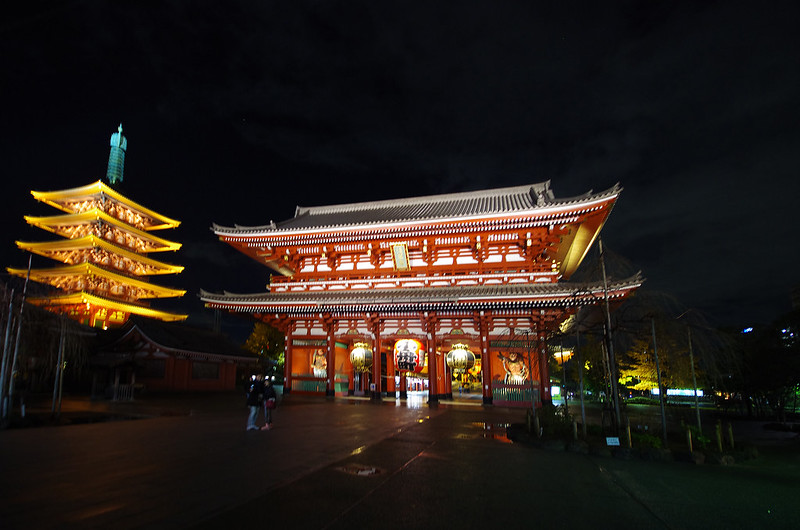
sensoji temple
Alight at Asakusa Station. Start early and beat the crowds by visiting one of Tokyo’s most atmospheric neighborhoods – Asakusa. While here, don’t miss the Sensoji Temple (they open at 6am from April to November / 6:30am from October to March) which dates back from the year 645.
To reach the temple, you go in via an iconic gate called Kaminarimon which is recognized as the symbol of the city. You also pass by a series of shops in a street called Nakamise . It’s full of interesting traditional handicrafts and food that you can easily spend hours here just browsing through the goods. You can also join a guided tour around Asakusa all while dressed up in a traditional kimono .

tonkatsu hasegawa
If you happen to be here during lunch time, check out Asakusa Sushi Ken (Asakusa 2, Chome 11-4) for some fresh and authentic sushi and delightful tempura. This is also a halal-certified restaurant. Alternatively, you can also make the short hop to the other side of the river to Ryogoku for Tonkatsu Hasegawa (3 Chome-24-1 Ryogoku), a popular restaurant known for their thick and juicy pork cutlets.
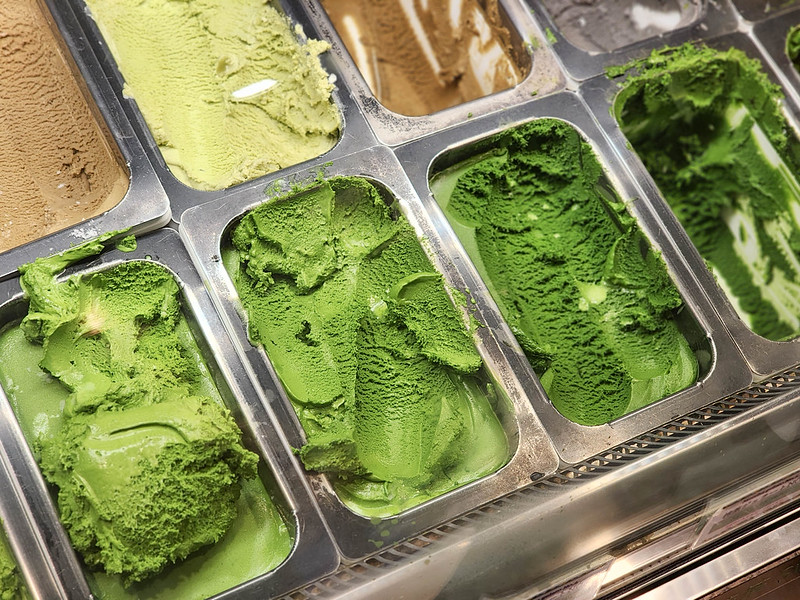
matcha ice cream in suzukien
If you are a matcha lover, Suzukien (3 Chome 4-3 Asakusa) is well-known for their matcha ice cream which come in 7 different versions depending on intensity, from weak to super strong. I went for the 5th one in terms of intensity and was already pretty buzzed after gulping down a scoop! Be prepared to queue.
Tip: For more traditional / old style areas in Tokyo, you can check out my guide on 3 traditional areas in Tokyo – Asakusa, Yanaka and Kagurazaka
Tokyo Skytree
tokyo skytree as seen from asakusa
Since you’re already in Asakusa, the Tokyo Skytree is just a few stations away (or a short 20-minute walk). While it is an amazing structure – it is Japan’s tallest after all – I personally find the views too high to properly appreciate the city panorama. Alternatively, you can find some good viewing decks from which to see the tower instead. I stayed at The Gate Hotel by Hulic Asakusa Kaminarimon which has a rooftop bar that has excellent views of the Tokyo Skytree .
Museum Hopping in Ueno Park
From Asakusa, it’s a quick train ride to Ueno Station. While Tokyo has several parks, Ueno Park is different in the sense that the public grounds also contain several museums including the Tokyo National Museum, National Museum for Western Art, Tokyo Metropolitan Art Museum and National Science Museum. You can easily spend an entire afternoon here if you are a museum buff
Witness the World’s Busiest Crossing in Shibuya
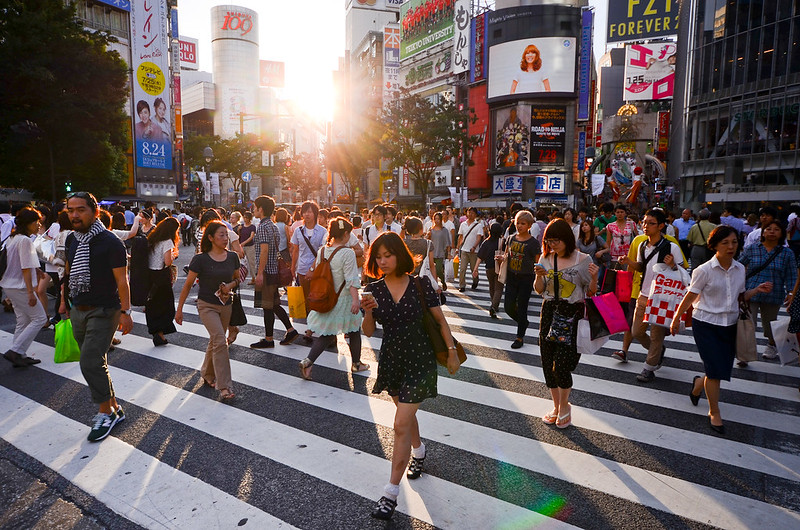
shibuya by candida.performa
From Ueno, you can easily take the Ginza line down to Shibuya Station. My favorite place to visit in Tokyo at night, Shibuya is perhaps one of the busiest crossings you’ll ever come to see anywhere in the world. The place is full of neon lights even at night and is a hub for youngsters. Don’t miss the statue of Hachiko while you are here. Shibuya is also the place to do a bit of shopping.

shibuya sky
If you prefer to do something new since your last visit, the Shibuya Sky which opened in late 2019 boasts of a 360 degree open air observation deck. This differs from the other observation decks in Tokyo as the others are mostly indoors. There are plenty of photo-worthy spots at the observation deck, including at one of the pointed corners which gives off a feeling of floating on air. There is usually a snaking queue of visitors waiting to have their photos taken at this spot, but it usually clears in about 20 minutes.
Tip: If you are looking to visit Shibuya Sky, the best time to come is during sunset. This is also the most popular time. Tickets are timed and if you are looking to secure a sunset spot, you’ll need to book tickets around a month in advance .
Day 2 – Ginza, Imperial Palace, Roppongi
Shopping in ginza.
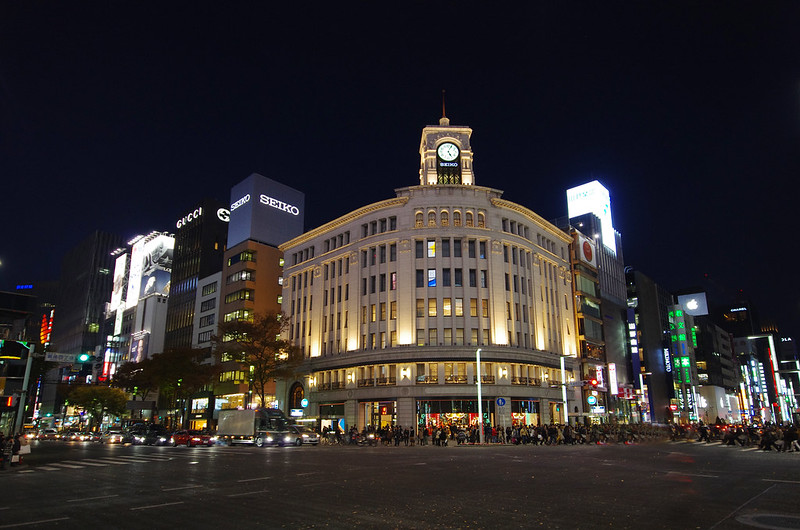
Take a stroll down the Ginza . This is historically Tokyo’s main shopping street. However, it is no longer the most high-end – Omotesando now lays claim to that. You can find a lot of well-known brands here including the largest Uniqlo store in the world. Opposite that is the high-end shopping mall, Ginza Six , which boasts of a sleek interior and plenty of specialty stores. If you visit during the weekends, you will fine Ginza to be a huge pedestrian-only zone.
If you are craving for ramen, Ginza Kagari (6 Chome-4-12 Ginza) often has a snaking queue of people coming here to try their signature chicken broth ramen which is brimming with collagen.
Tokyo International Forum

tokyo international forum
From the Ginza, it is a reasonable walk to the Imperial Palace area but first stop by the architecturally impressive Tokyo International Forum for a look-see. Make sure to drop by the upper floors to check out the astounding curves built with steel and glass.
Imperial Palace Grounds

seimon ishibashi bridge by ray
The Imperial Palace grounds is another 5 to 10 minute walk away. The area is extensive but is mostly closed to the public except during certain holidays and upon booking of a private tour with the Imperial Household Agency. Nonetheless, the moat around the palace is quite a popular tourist attraction. You can catch glimpses of a few imperial buildings while walking around it
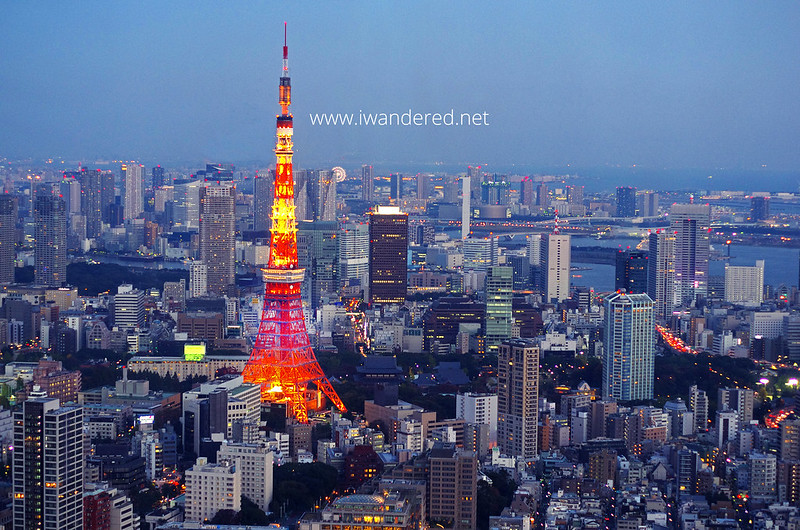
view of tokyo tower
One of my favorite places for panoramic views of the city is the Tokyo City View at the top of Mori Tower in Roppongi Hills. It is by no means the tallest observation deck in the city but you get to see a better view with some iconic buildings such as the Tokyo Tower and parts of the bay. You can book here to get a discount on the entrance fee.
Roppongi is also a buzzing nightlife district and highly popular with expats and tourists. There are plenty of foreigner-friendly bars and restaurants, including some with Michelin stars. If you ever get tired of Japanese cuisine (I can’t imagine anyone would), Roppongi is your best bet in finding restaurants catering to western or fusion cuisine
Day 3 – Harajuku, Omotesando and Shinjuku
Harajuku’s street culture.
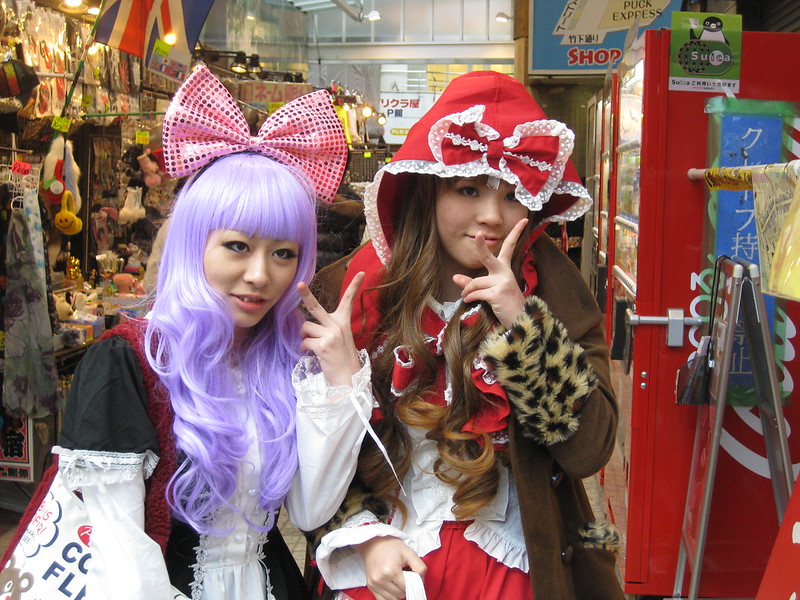
harajuku by flyingpurplemonkeys
Start the day at Harajuku which is known as a center of youth culture in Tokyo. If you are there during a weekend, you may find places such as Yoyogi Park filled with artists, musicians and cosplayers in fancy costumes.

meiji shrine
After having your fill gawking at the people, you can head to Meiji Shrine which is dedicated to the spirits of the former Emperor Meiji and his wife. The vast 70 hectare of forested land in the middle of the city is a breath of fresh air. Smelling the pine-scented vegetation, you’ll soon forget you’re in Tokyo.
Living the High Life in Omotesando

lobster roll from luke’s lobster omotesando
Tokyo’s most high-end shopping street, Omotesando , is just a short walk away from Harajuku. While most of the stores here sell things that are out of most people’s budgets, it is still a great place for people watching. There are also plenty of cafes around the area. If you are looking for a caffeine fix, backstreet cafes such as Lattest Omotesando are your best bets. Luke’s Lobster also has a branch in Omotesando It is frequented by locals and tourists alike. Be prepared to queue.
Shinjuku’s Nightlife

kabukicho in shinjuku
If you still haven’t had enough of Tokyo’s nightlife, it’s worthwhile to check out Shinjuku which offers a peek into what locals do after dark. You’ll find a mix between hole-in-the-wall bars, watering holes serving craft beer and whisky as well as live music venues. Areas to check out include Golden Gai and Omoide Yokocho , both near Shinjuku station.
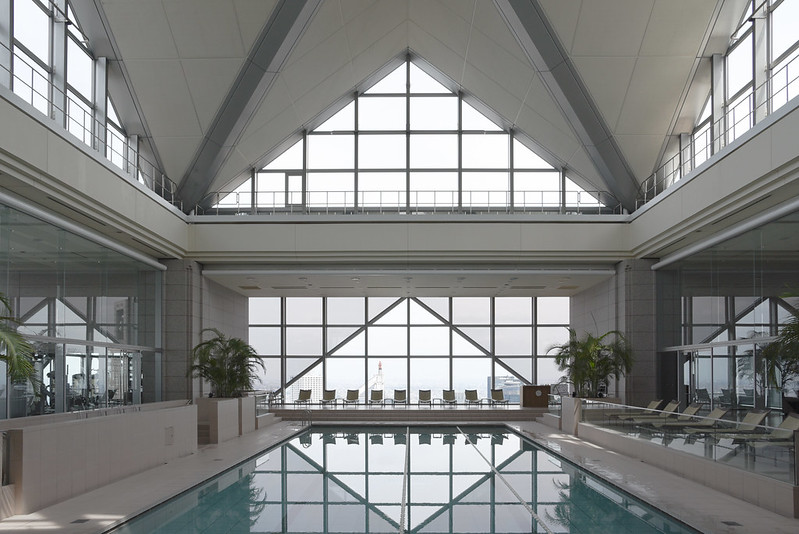
the iconic park hyatt tokyo – the “lost in translation” hotel
If you are a fan of the movie “Lost in Translation,” you’ll be pleased to note that the iconic Park Hyatt Tokyo is located well within Shinjuku. The rooms are of course, open to guests only, but you can relive scenes from the film at the New York Bar where Bill Murray’s character had chilled out in the film

shinjuku gyoen
If you manage to finish the other sights early and decide to head to Shinjuku before it gets dark, it’s worthwhile to check out Shinjuku Gyoen , one of the largest public parks in the inner wards of Tokyo. The park is one of the best places in Tokyo to see autumn colors in late November/early December and cherry blossoms in April
Tokyo For Shopaholics (and Hipsters)
Aside from the activities suggested above, you can add the following into your itinerary for a more well-rounded shopping experience in Tokyo

- One station away from Shibuya is Ebisu which offers a cool alternative to the traditional nightlife spots of Shinjuku or Roppongi. The establishments here are decidedly quirkier and less serious.
- Daikanyama and Nakameguro (again, near Shibuya) are also fun neighborhoods to explore with lots of boutiques housing independent labels. You’ll find bookstores sitting alongside clothing stores. Bakeshops and cafes also abound. If you are looking for Tokyo’s equivalent to a hipster neighborhood, these places are the best fit.
- Another interesting neighborhood to check out is Shimokitazawa which is filled with plenty of young and trendy shops, specialty boutiques and of course, lots of hipsters. Unlike the adjacent neighborhoods of Ebisu / Daikanyama and Nakameguro, Shimokitazawa is farther out (west of Shibuya).
- If you are looking to buy electronics, Akihabara offers all sorts of gadgets imaginable at relatively lower prices. Before buying, make sure that you can configure the product settings into your local language.
Unique Things to Do in Tokyo
The city is known for offering a lot of eccentric services that cater to just about any interest group. In case you’ve been to Tokyo so many times that you’re looking for something different, here are some unusual things to do in the city that you can add to your itinerary

robot restaurant in tokyo – one of the quirkiest things to do in the city (now closed)
- If you’ve been longing for intimacy but haven’t found anyone to express it with, Tokyo has what is called a cuddle cafe which allows clients to cuddle, hug or sleep together (in a non-sexual way) with another person for at least 20 minutes. One of the most popular of such cuddle cafes is Soine-ya ( KN Building 3F, 2-11 Sakumacho, Akihabara, Chiyoda-ku, Tokyo 101-0025)
- In a place that’s known for cosplay, the concept of a maid cafe would perhaps be not that surprising. Walk into one of these establishments and find yourself being served by young girls dressed as personal servants. With unmistakably cute and high-pitched voices, they’ll attend to your every need. Maidreamin which has 4 locations in Tokyo (Akihabara, Shijuku, Ikebukuro and Shibuya – book discounted tickets here ) allows its customers to immerse in this make believe world, even if for just a few hours.
- It may sound kitschy to some but Ninja Cafe and Bar allows you to dine in a medieval-looking venue, get a quick training on the way of a ninja and even walk around the surrounding neighborhood in a ninja outfit.
- Relive the 80s at the 8bit Cafe where fully functioning gaming consoles from the Nintendo Family Computer days are available for guest use. Play a game of Pac-man while having cocktails named after video game characters
- Go on a real-life Mario Cart ride (complete with costume) through the streets of Tokyo. Each ride takes about an hour and goes through some Tokyo tourist attractions. Do note that an international drivers’ license is required. You can book here for discounted tickets.
- I’m not totally sure why anyone would want to come ogle at parasites but for something truly offbeat, you can check out the Meguro Parasitological Museum which contains over 60,000 parasite samples
- The lack of space in Tokyo has made capsule hotels a popular concept. It’s not exactly the most luxurious accommodation option out there but you can consider staying in one for the novelty of it. You can compare for the best prices in booking capsule hotels here
Other Tips for Tokyo
- Travel Insurance: Japan is quite expensive overall and this is one of the countries where getting travel insurance is most worthwhile. If you reside in Singapore, check out Starr Travelead , one of the cheapest travel insurance. They have a promotion that comes with S$10 cash rebate that helps to offset the insurance cost.
- Electric Adapters: Japan uses Type A or B outlets for electricity so make sure you have the right adapters for your devices.
- Credit Card Usage: Even in an ultramodern city such as Tokyo, you’d be surprised to find that many establishments still don’t accept credit cards. Japan is still a predominantly cash society so it’s useful to bring the cash you need for your trip. Major hotels and department stores do of course accept credit cards but many smaller restaurants and independent stores don’t.
- Best time to visit Tokyo: While sakura season in April is undoubtedly the time to visit Tokyo to see it at its “prettiest,” this is also the most crowded time with hotels charging a premium in what is already a relatively expensive city. Other good times to visit Tokyo include late-April to May when it is still cool but you’ll find the tourist scene quieter as most would have just left after the cherry blossoms wither. Hotel prices are also cheaper at this time. Another good period to visit Tokyo is from mid-November to 1st week December. This is autumn season when the leaves change color. This is an alternative period to visit if prices during sakura season are too prohibitive.
- Where to buy sim cards: To keep up with your mobile internet needs, it may be wise to purchase a local sim card. While you can easily buy one when you arrive, purchasing a sim card in advance allows you to get a slight discount on the price. You can buy one here .
- Venturing out of Tokyo: If you are planning to visit other cities during your Japan trip such as Osaka, Kyoto, Nagano, etc; you may want to purchase a JR Pass or one of the regional passes instead. The JR Pass gives you unlimited rides on JR trains, shinkansen and the JR Line in Tokyo for a period of as little as 5-days. You can purchase the JR Pass here to obtain instant confirmation.
Getting From Narita Airport to Tokyo
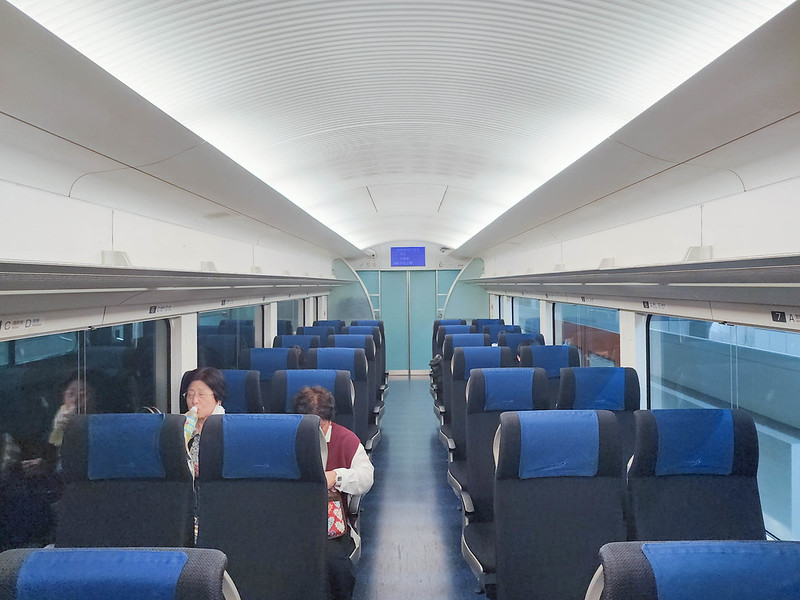
keisei skyliner from narita to tokyo ueno
Narita Airport, the main airport serving Tokyo (the other one being Haneda Airport) is located some 70 km away from town. A taxi ride takes more than an hour and can easily cost almost US$300. To get to the city quick and comfortably, take either:
- the airport limousine bus which stops in several downtown Tokyo hotels including Westin, Marriott, Aman, Shangri-la, Hoshinoya, Park Hyatt, etc and takes about 2 hours
- the Keisei Skyliner which takes you from the airport to the city in around 41 minutes. It makes 2 stops in the city, at Ueno or Nippori stations.
Getting From Haneda Airport to Tokyo
Haneda Airport is much nearer to Tokyo than Narita Airport but taking a taxi is still expensive and could set you back by almost US$100. Other quick and efficient ways to get to the city include the following:
- The Tokyo Monorail can get you from Haneda Airport to Hamamatsucho Station in as little as 13 minutes. From Hamamatsucho Station, you can easily connect to the JR lines or other subway lines to get you to your destination in Tokyo. Service on the Tokyo Monorail starts at 5AM and stops at around 11:30PM.
- The Asakusa Line of the Tokyo Subway connects to the Keikyu Airport Line for trips to Haneda Airport without having to change trains.
- If you are carrying heavy luggage, the airport limousine bus may be a better alternative as the route stops in several well-known hotels throughout the city. Do note journey times may be a bit longer but at least you won’t have to navigate Tokyo’s train network with your bags!
- You can also book private car transfers from the airport to anywhere in Tokyo. These private cars can accommodate up to 9 people inside the car so depending on the size of your group, it may actually be more efficient and economical to book this than taking public transport.
Getting Around Tokyo
Tokyo’s subway system is vast and local trains / subways can take you to almost any point of interest within the city. Taxis are also plentiful but I don’t recommend these as they are very expensive. For subways / local trains, you can either buy single tickets or a pass valid for a couple of days. I recommend buying a subway pass if you foresee yourself taking the subway at least 4 times each day. If you are in Tokyo for sightseeing, this condition is easily met. The subway passes come in 24, 48 and 72 hour variants.
Where to Stay in Tokyo
Budget – Rooms at Richmond Asakusa are quite modest but are among the most decently priced for a conveniently located 3-star hotel in Tokyo. The hotel is near Sensoji Temple with plenty of food options nearby. If you prefer to stay in the heart of Tokyo’s shopping area, the Sunroute Hotel Ginza is located mere steps from the renowned shopping street.
Midrange – I’ve stayed in a number of hotels in Tokyo but one I can recommend is The Gate Hotel by Hulic in Asakusa near the Sensoji Temple. Although styled as a boutique / 4 star hotel, I thought the offerings were quite luxe at a relatively more affordable price compared to other Tokyo digs. I still have fond memories of the freshly squeezed orange juice in the morning. Alternatively, the Daiwa Roynet Ginza Hotel is conveniently located if you wish to be situated near the prime shopping district.
Luxury – The iconic Park Hyatt Tokyo in Shinjuku is the cream of the crop where Tokyo hotels are concerned. It is worth staying here even for just one night like I did especially if you are a fan of the film, “Lost in Translation” which stars Bill Murray and Scarlet Johanssen.
For other Tokyo hotels, you can check out HERE .
You May Also Like

Let me know your thoughts by leaving a comment below. Alternatively, you can also email me at b i n o (at) iwandered.net. You can follow I Wander on Facebook , Telegram , or Instagram . Also, if you liked this article, please feel free to SHARE or RETWEET
More Posts - Website
Reader Interactions
Older posts.
February 7, 2017 at 12:04 pm
Thanks for this comprehensive post, very useful for my upcoming trip to Tokyo in April. Have pinned this on a shareable Google Map. If you’re interested to feature it in this post, I’ll be happy to share the link with you!
For reference: belaroundtheworld.com/how-to-create-your-own-map-itinerary-with-google-maps/
From a fellow travel blogger, Isabel belaroundtheworld.com
February 7, 2017 at 1:14 pm
Hi Isabel, thanks for writing in! Sure would love to feature your map here.
March 7, 2017 at 2:31 pm
I want to meet you personally Mr. Bino 🙂
April 19, 2017 at 7:52 pm
Good evening Mr. Bino .Thanks a lot for your useful tips and guide. That would be my guide for my Japan itinerary. I would like to ask more, we would be travelling dec 3-6 in Tokyo, considering the season, could you pls help me plan a really pleasant and enjoyable itinerary.. Much appreciation in advance.. Thanks.
April 19, 2017 at 11:21 pm
Hi Elsa, thanks for dropping by. The itinerary I suggested above is applicable for all seasons. Hope you enjoy your trip!
September 13, 2017 at 4:25 am
My wife and l (both 70+) are going on a organised 11 day tour in late March 2018 of Japan which uses Shinkansen (Bullet Trains) and buses. The tour starts in Tokyo (only 1 day) and finishes in Osaka, and we’d like to return to Tokyo to see more for 3 more days, then fly back to New Zealand. We haven’t as yet organised any tickets to get back to Tokyo (Ginza / Tokyo Station area) from Osaka. 1) Should we purchase a 7 day Rail Pass, or just a One way ticket, or fly ? 2) If we purchase a 7 day Rail Pass can we use it on the Tokyo subway, plus get to Narite Airport when we leave ?
September 14, 2017 at 2:02 pm
#1 – you did not mention how many train trips you are supposed to be taking. If it’s just Tokyo – Osaka one-way then it does not make sense to get the rail pass. #2 – Yes, the rail pass can be used for the JR line in Tokyo.
September 24, 2017 at 10:41 am
Hi there, I’m just wondering is there any public bath spots in Tokyo, like in Korea? (the sauna place, where people can have sauna, shower and rest for a while)
July 6, 2018 at 2:07 pm
Hi Bino thanks for your posts – we are hoping to do a January trip to Tokyo Kyoto in 2019 and wondering whether you would have any different itineraries for winter in these cities – also any tips in terms of temperatures and getting around if it snows etc etc Thanks
July 9, 2018 at 3:33 pm
Hi Jacqueline, my itinerary applies to all seasons. 🙂
Leave a Reply Cancel reply
Your email address will not be published. Required fields are marked *
Save my name, email, and website in this browser for the next time I comment.
Notify me of follow-up comments by email.
Notify me of new posts by email.
- South Africa
- Afghanistan
- North Korea
- Adventure + Outdoors
- Amusement Parks
- Backpacking Trips
- Boating + Cruises
- Budget Travel
- Bus + Train Travel
- Coasts + Islands
- Country Trips
- Fall Vacations
- Family Vacations
- Green Travel
- Heritage + History
- Honeymoons + Romance
- Inspiration + Guide
- Landmarks + Attractions
- LGBT Travel
- Markets + Bazaars
- National Parks + Reserves
- Nature + Wildlife
- Parks + Gardens
- Pets + Animals
- Photography
- Airlines + Airports
- Budgeting + Currency
- Business Travel
- Celebrity Travel
- Customs + Immigration
- Deals + Rewards
- Family Travel
- Hotels + Resorts
- Luggage + Packing Tips
- Offbeat News
- Photography Tips
- Responsible Travel
- Solo Travel
- Tech + Gear
- Travel Etiquette
- Travel Warnings
- Bars + Clubs
- Celebrity Chefs
- Restaurants + Cafés
- Wine + Vineyards
- Beach Hotels
- Boutique Hotels
- Hotel Openings
- Hotel Reviews
- Luxury Hotels
- Mountain + Ski Resorts
- Spa Resorts
- Vacation Rentals
- Asia Cruises
- European Cruises
- Festivals + Events
- Museums + Galleries
- Style + Design
- Travel’s Best
- Hotel with Agoda.com
- Hotel with Booking.com

Where to go in Kunming? — 15+ top Kunming attractions &…

Must eat in Georgetown — 10+ famous, must-eat & best street…

Must eat in Melaka — 10+ famous Malacca street food &…
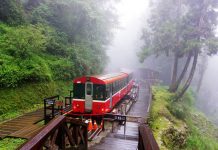
What to do in Alishan? — 5 top attractions & best…
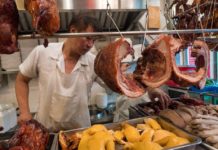
Hong Kong food culture — Hong Kong cuisine tells the historical…

All about tips in Nepal — How much to tip in…

Cambodia travel tips — 15+ what to know & things to…

When is the best time to visit Kyoto? — The best,…
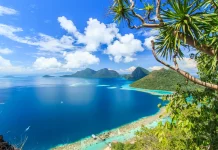
When is the best time to visit Malaysia? — The best,…

Hong Kong Soya sauce Chicken Rice and Noodles — The first…

Top hotels in Siem Reap — 8+ best places to stay…

Top hotels in shanghai — 15+ best hotels in Shanghai

Top hotels in Malacca — 10+ good & best hotels in…

Top places to stay in Bali — Top 10 best areas…

10 must-know things for your best first time European river cruise

Top 3 best luxury cruises in Halong Bay, Vietnam

Cherry blossom festival Korea 2024 — Top 5 cherry blossom festivals…

- Ghibli museum blog — The fullest Ghibli museum guide for first-timers

Kyoto festival — Top 10 best events & most famous festivals…

National Palace Museum Taipei blog — What to see in National…

Japanese waterfall — Top 10 most beautiful waterfalls in Japan in…

19+ most beautiful towns in Europe every tourist need to visit…

Georgia travel photos — 20+ captivating photos show Georgia is heaven…

Explore Damnoen Floating Market — The oldest floating market of Thailand

Visiting Fenghuang Ancient Town — One of the most charming ancient…

Mekong Delta travel blog — Beyond rivers of Southwestern Vietnam

14 reasons why you should travel when you are young

Shigaraki Tanuki – An animal symbol of good luck in Japan

Living in the charms of cave houses in Andalucia, Southern Spain

20+ jaw-dropping tiny homes around the world
Tokyo itinerary 7 days — how to spend 7 days in tokyo & what to do in tokyo for 7 days.
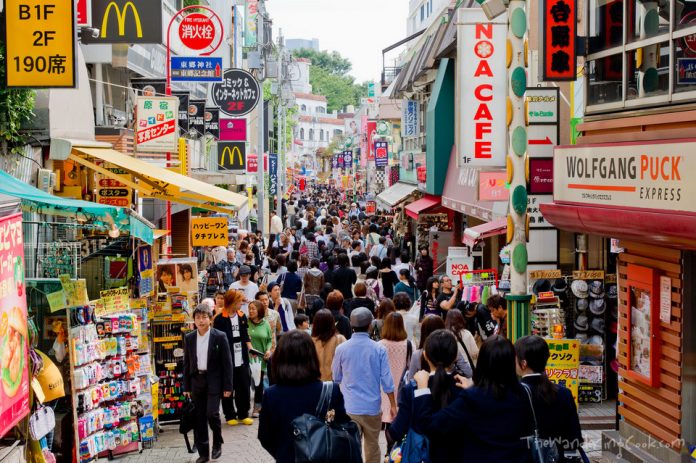
Tokyo is a wonderful and very addictive city. There are countless interesting and great things in Tokyo that you should experience from famous scenic spots, historical temples, shrines to signature Japanese culinary culture. Take a full week to fully appreciate the beauty of this city. We hope the itinerary below will be a perfect suggestion to help you enjoy 7 memorial days in this bustling mega city of Tokyo!
Tokyo best parks — 10+ best & most beautiful parks in tokyo
- Cherry blossom Tokyo 2024 forecast — 14 best places to see cherry blossoms in Tokyo
- Ikebukuro blog — 7+ best places to go & top fun things to do in Ikebukuro
- Tokyo best temples & shrines — 7 most famous, beautiful shrines & best temples in Tokyo
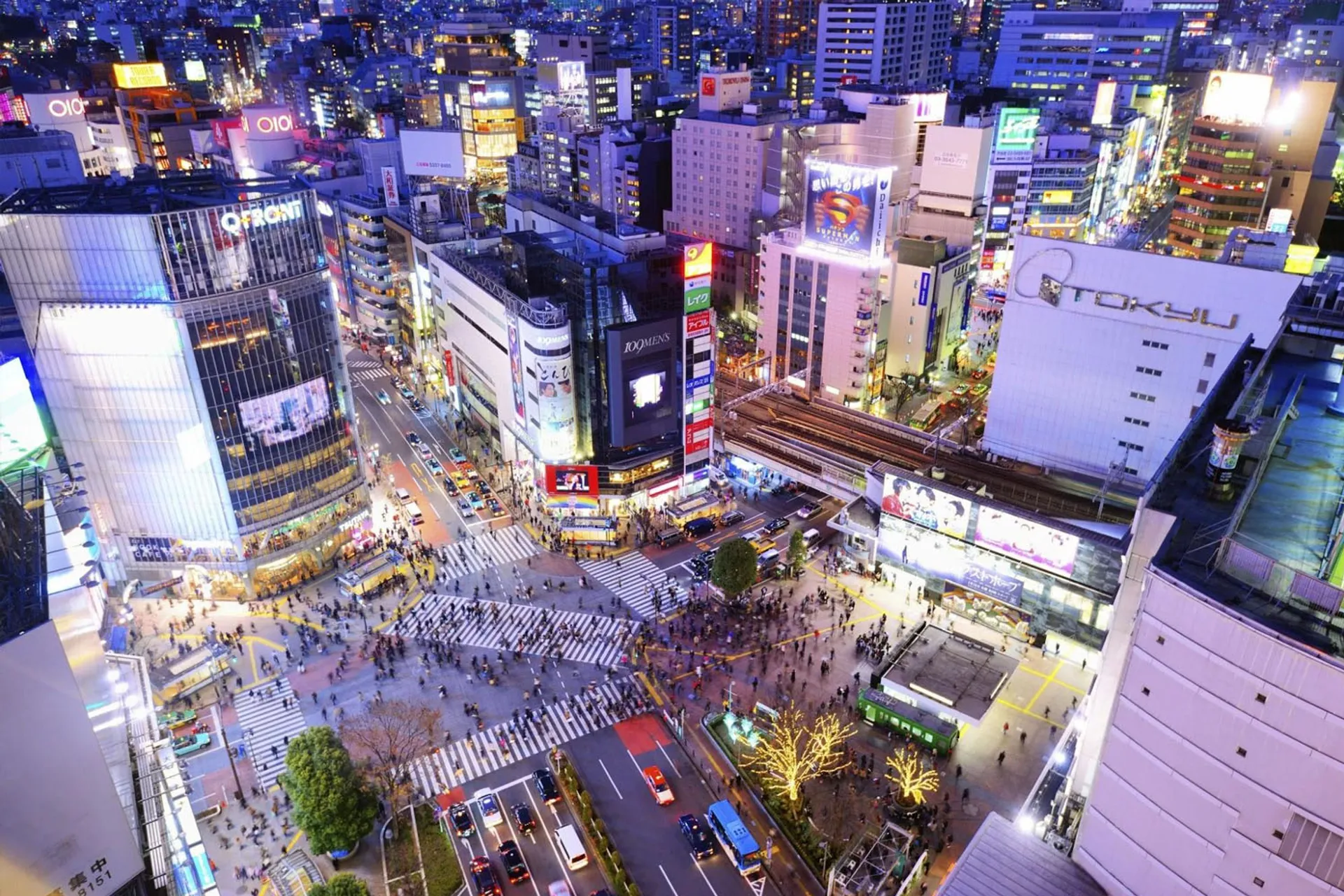
How many days in Tokyo is enough, how many days should you spend in Tokyo? It depends on your time, a 3 or 5 days itinerary is also relatively enough. But if you want to discover deeper a little, 7 days is needed. So, what to do in Tokyo for 7 days? Let’s check out our suggested Tokyo itinerary 7 days blog on how to spend 7 days in Tokyo (seven days in Tokyo, Tokyo itinerary 1 week, Tokyo travel itinerary 7 days, 7 days in Tokyo budget) on a budget to help you discover the capital city of Japan as well as the world’s cuisine of the world!
Day 1: Shibuya, Harajuku & Meiji Shrine (#tokyo itinerary 7 days)
Where to stay in tokyo: shibuya.
Choosing a good hotel to stay in Tokyo is a dilemma, in a extremely large city like Tokyo, you have many options, but most importantly, the place must be convenient for travel, so that you can easily explore the the most prominent places of the city.
If you are flying from Hanoi to Tokyo, the best areas to stay in Tokyo include: Shinjuku, Ginza and Shibuya. Other convenient places are Marunouchi, Roppongi, Nihombashi, Shinagawa, Hamamatsucho, Shiodome and Asakusa.
We chose Shibuya Excel Hotel Tokyu ( Agoda , Booking ), a hotel in Shibuya district. Shibuya is a great central district in Tokyo and mainly attracts young people, where it is a popular shopping and entertainment spot. Bustling, vibrant major intersections, fashion stores, countless restaurants and bars with vibrant nightlife for you to explore.
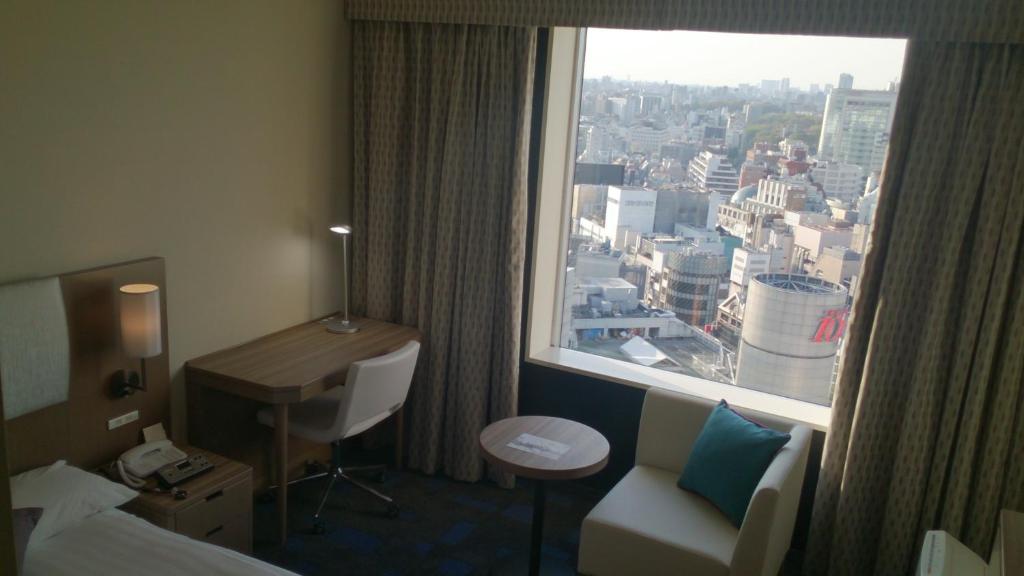
Omotesando & Harajuku Avenue
After checking-in and resting at the hotel, we walked along Omotesando Avenue, admiring the architecture of top designers along the avenue. On Omotesando, there are many fashion boutiques, first of all, Omotesando Hills is a large-scale business establishment, in addition, there are many Japanese, Western, and Chinese cuisine restaurants along with Beauty Salon, Nail salon, grocery stores, entertainment venues like Live House. You should visit Oriental Bazar located on the avenue, a shop that offers high-end goods and souvenirs from Japan that are strange and unique.

On the way to Meiji Shrine, you will pass through the famous Harajuku neighborhood with colorful fashion shops on both sides of the road. Crepes are a feature here, so you should try a super sweet crepe from one of the dozens of crepe shops in the area.

Meiji Shrine & Yoyogi Park
Begin your exploration of Japanese culture and history with a visit to the sacred Meiji Shrine (Address: 1-1 Yoyogikamizonocho, Shibuya City, Tokyo 151-8557, Japan/Hours: 5:40AM–4:40PM). It is a Shinto shrine dedicated to the divine spirits of Emperor Meiji and his wife, Empress Shōken. Its long walkways and quaint atmosphere through centuries-old trees make it one of the most visited shrines in Tokyo.
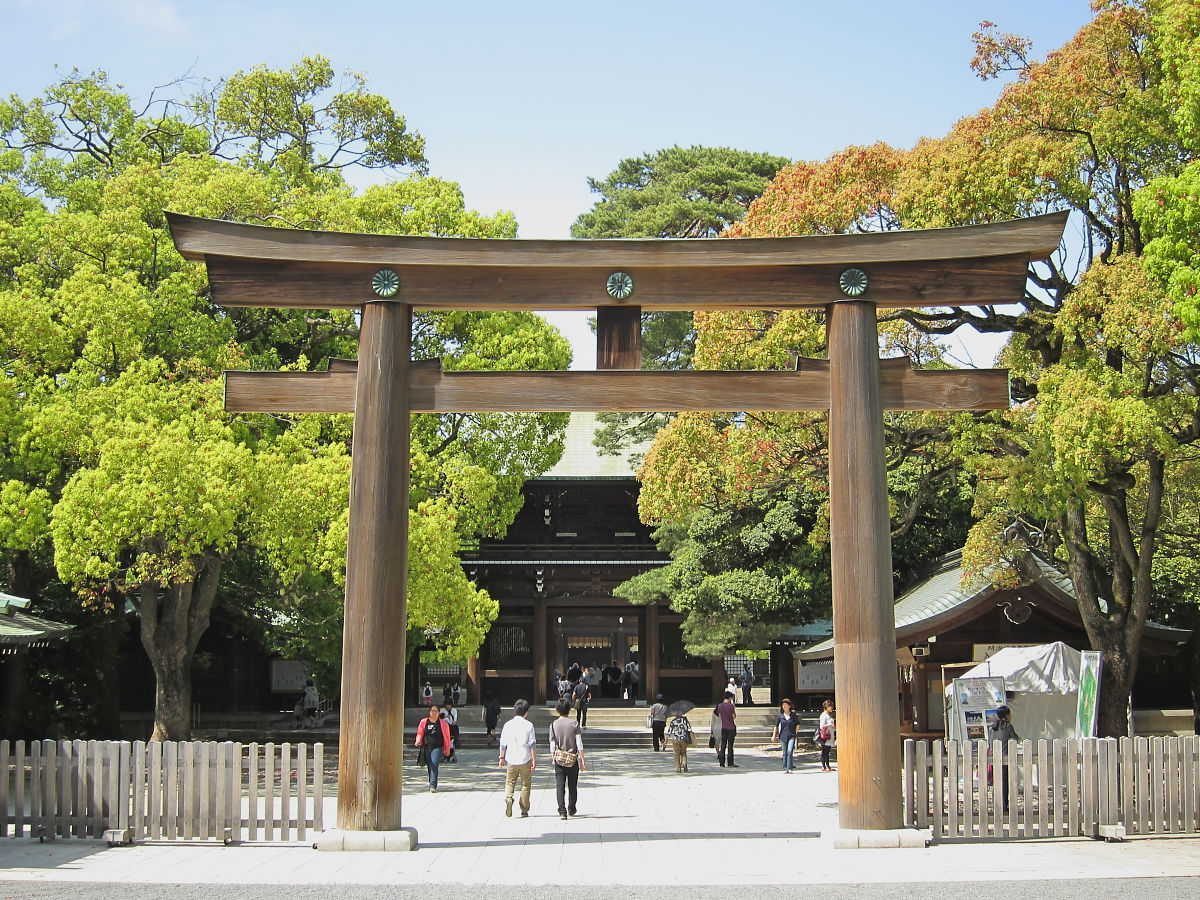
We spent the rest of the day strolling in the nearby Yoyogi Park (Address: 2-1 Yoyogikamizonocho, Shibuya City, Tokyo 151-0052, Japan/Hours: Open 24 hours). Fortunately, when we came here, the weekly Yoyogi Flea Market was taking place, which was quite unique and interesting.
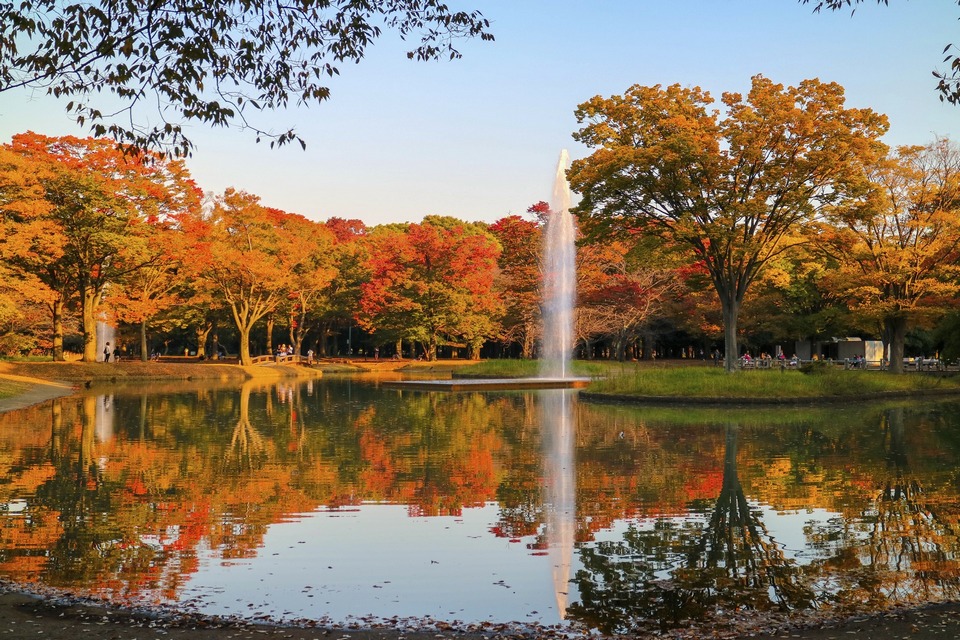
Day 2: Shinjuku, Minami-Aoyama & Nishiazabu (#tokyo itinerary 7 days)
Tokyo metropolitan government building.
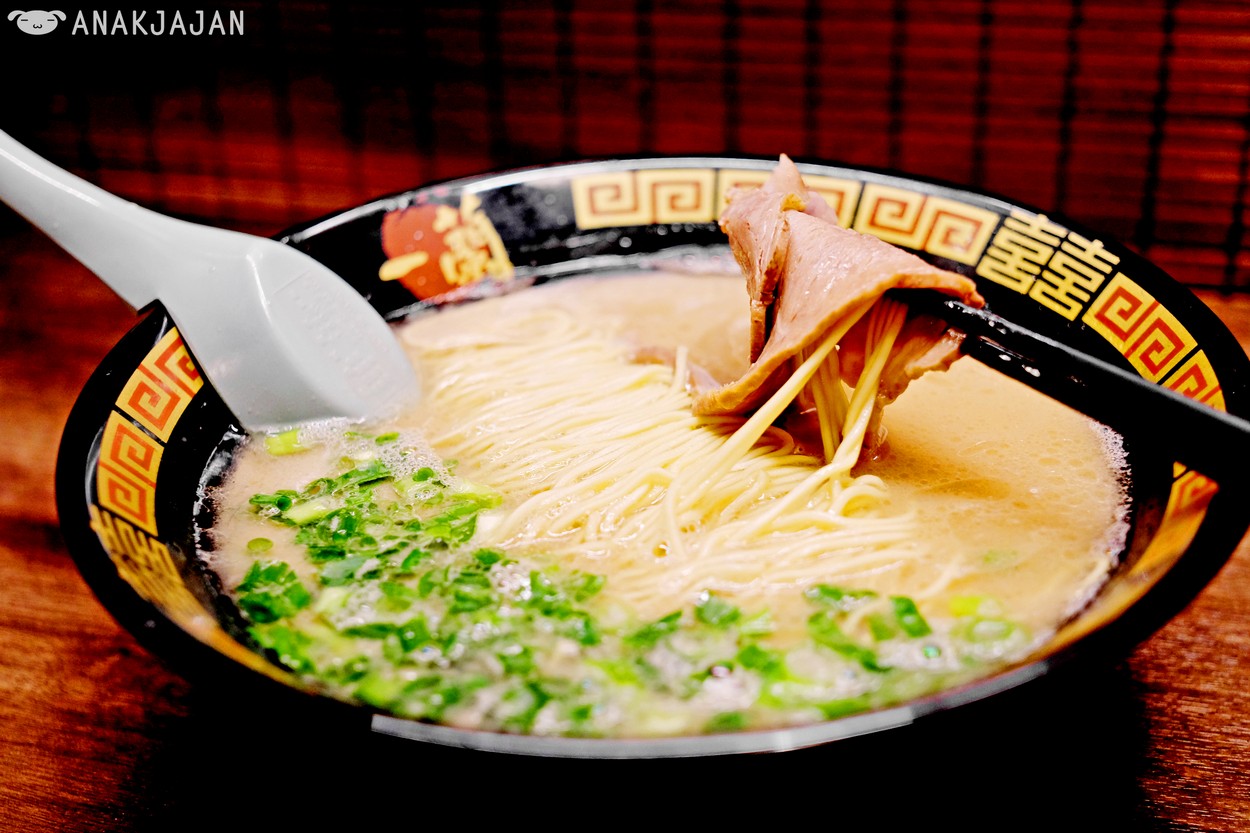
In the morning, after enjoying a large, filling bowl of ramen for breakfast at Ichiran Shibuya restaurant, we headed to Shinjuku to visit the free Observation Deck atop the Tokyo Government Building. From here you can see an impressive view of the vast and endless city of Tokyo.
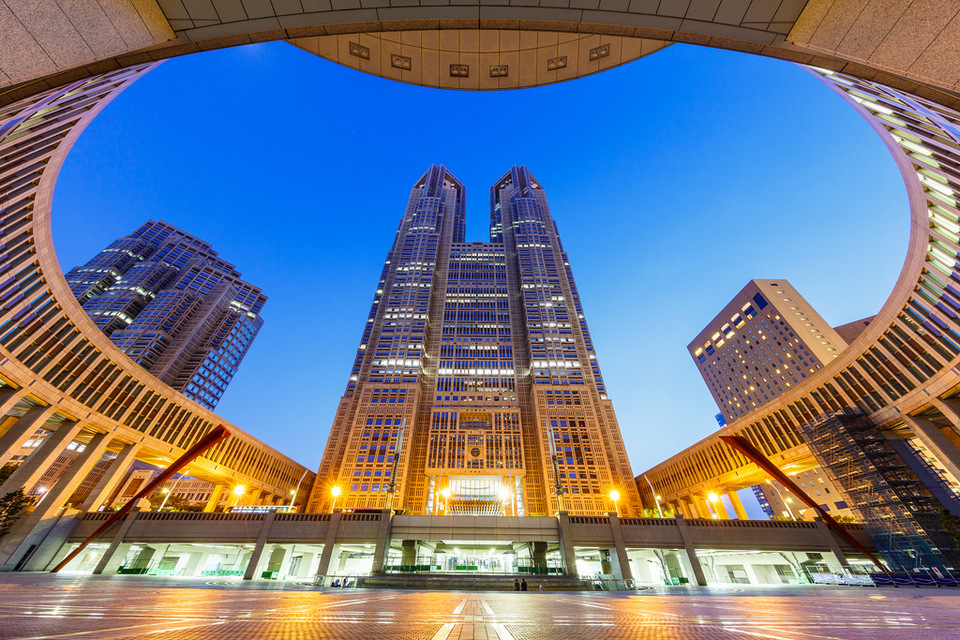
Address: 2 Chome-8-1 Nishishinjuku, Shinjuku City, Tokyo 163-8001, Japan Hours: 8:30AM–5PM/Saturday; Sunday: Closed
Minami Aoyama (#tokyo itinerary 7 days)
In the afternoon we went to the wealthy Minami Aoyama neighborhood, commonly known as Tokyo’s West Village. Like Nishiazabu, Minami Aoyama is relatively peaceful, devoid of tourists and full of fashion boutiques, restaurants and cafes lining its charming streets.

You should go for tea at Aoyama Flower Market TEA HOUSE (Address: 5 Chome-4-41 Minamiaoyama, Minato City, Tokyo 107-0062, Japan/Hours: 8AM–7PM), a beautiful greenhouse and flower cafe. The entire cafe space is decorated with colorful seasonal flowers. Aoyama Flower Market Tea House serves a variety of teas and herbs such as rosemary, mint and pineapple mint, as well as delicious dishes and desserts such as parfait and French toast. This is a perfect place to relax for flower lovers that makes you feel like you are lost in a fairy tale world full of flowers.
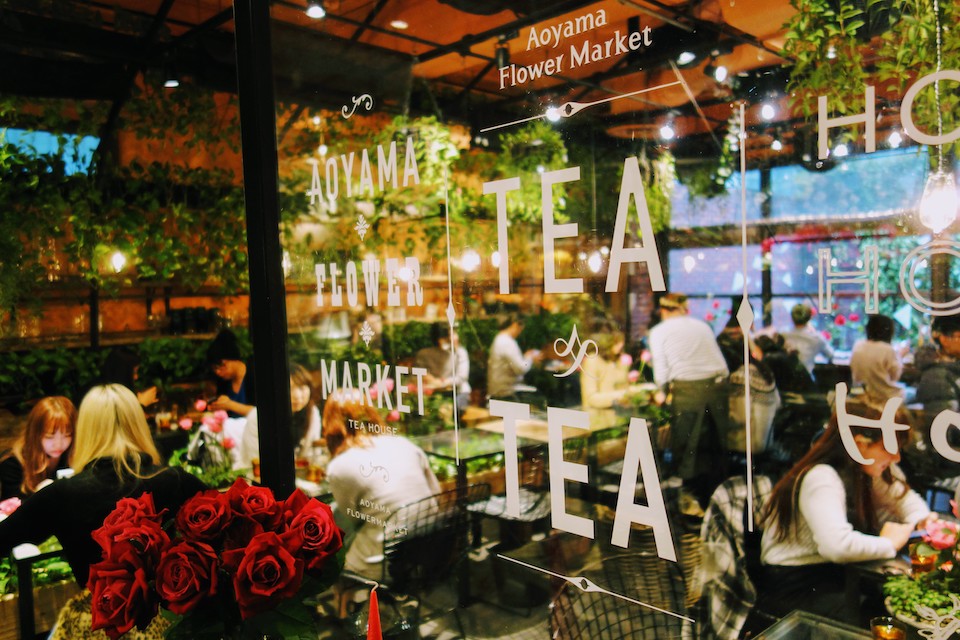
Dinner and drinks
If you have been to Japan, you should explore the typical local cuisine. Tokyo can be considered the world’s cuisine capital, you have a lot of restaurants to choose from sushi, Kobe beef, ramen, udon,… at the best restaurants. And we decided to choose a sushi restaurant right in Shibuya, Sushi no Midori restaurant (Address: 1-12-3 Dogenzaka Shibuya Mark City East 4F, Shibuya 150-0043 Tokyo Prefecture/Hours: 11AM–3PM, 5–10PM/Saturday; Sunday: 11AM–10PM) located along the food street in Mark City.

You can also choose some other restaurants such as Edo Sushi Tokyo Ten, located in the super mall complex Shibuya Stream, or Katsu Midori Seibu Shibuya or Genki Sushi.
Upon entering the restaurant we were seated right at the counter, the area has some great seats giving us a perfect view of the four chefs crafting their sushi creations. After looking at the menu, we ordered Upper Sushi-Assortment and Soup. They first brought us a bowl of ‘Miso Soup’ with green tea. When the main meal is ready, it is presented on a wooden plate, atop a large leaf where each piece of sushi is creatively placed as if it were a work of art.

The sushi rice is nicely seasoned and smooth while the fish is fresh and delicious. The fatty tuna portion is very impressive, the fat melts in the mouth and disappears quickly. The seafood here is very fresh, meticulously processed to create delectable sushi pieces. At the end of the meal new cups of green tea are served, replace the original cups, providing a natural sweetness after-dinner.
If you don’t want to go back to your hotel to rest after a long day, you can visit some of the roadside bars to have a few cocktails, relax with soft music or enjoy some of their desserts.
Day 3: Yanaka Ginza and Ueno (#7 days in tokyo)
Starting our third day with a fragrant cup of coffee after a breakfast of toast at a small cafe, we decided to visit Northern Tokyo with its historic Yanaka neighborhood, Ueno park and the magnificent Senso-Ji temple.
Yanaka Ginza
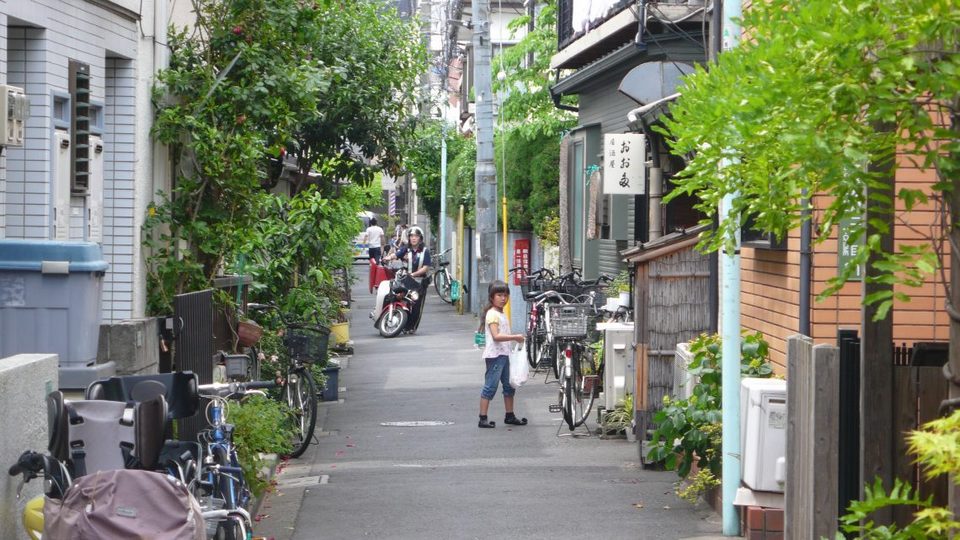
Yanaka Ginza is one of the best shopping streets in Tokyo, with its old town and numerous shops large and small. You can wander through the streets to shop, eat, this is definitely a great place to buy unique, traditional souvenirs and try local dishes, especially street food.
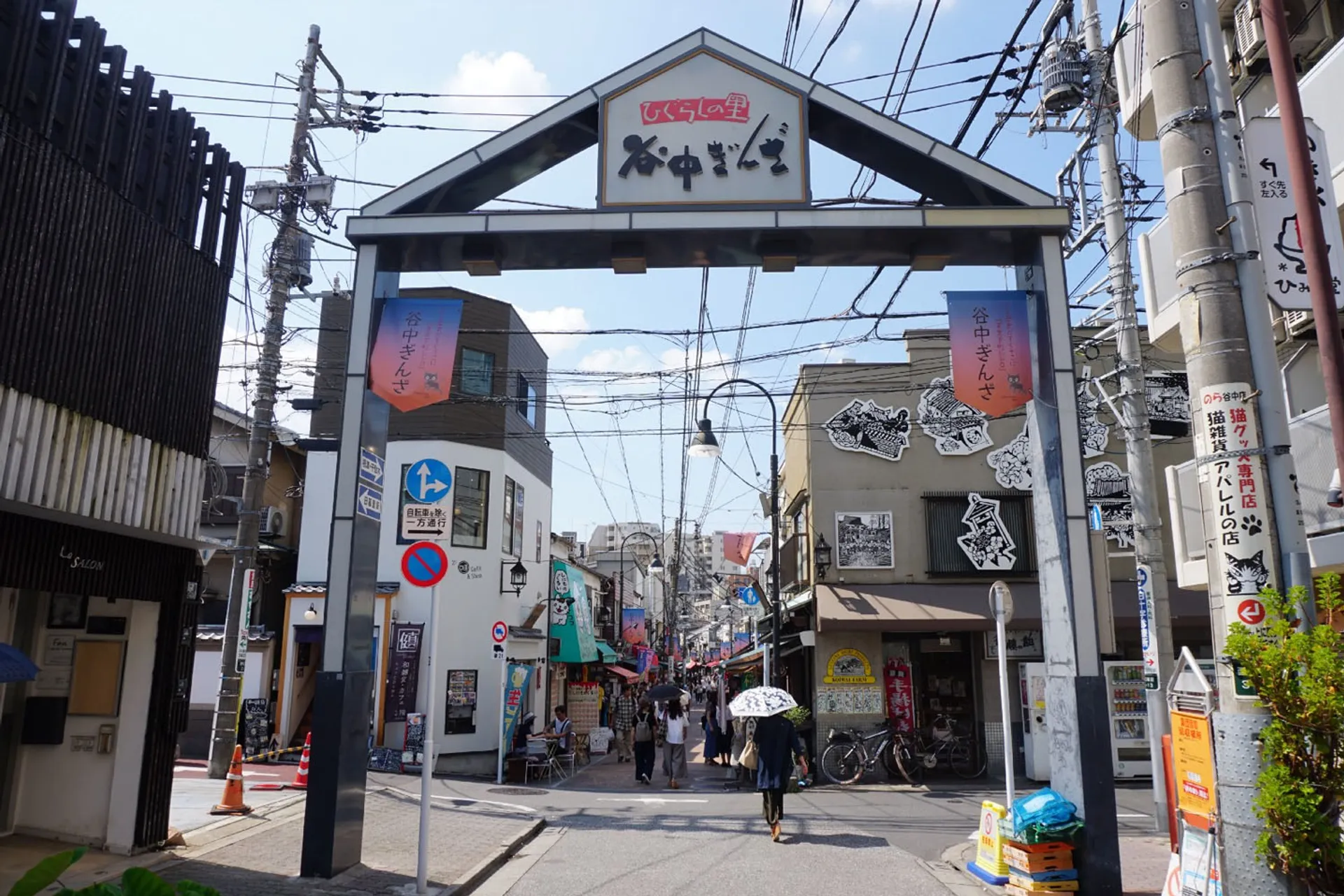
Ueno Park (#7 days in tokyo)
Near Yanaka is Ueno Park, another giant park in Tokyo. We walked around the park and came to the big lake inside the park. To our surprise, the lake was vast and barely visible under a thick layer of giant lilies!
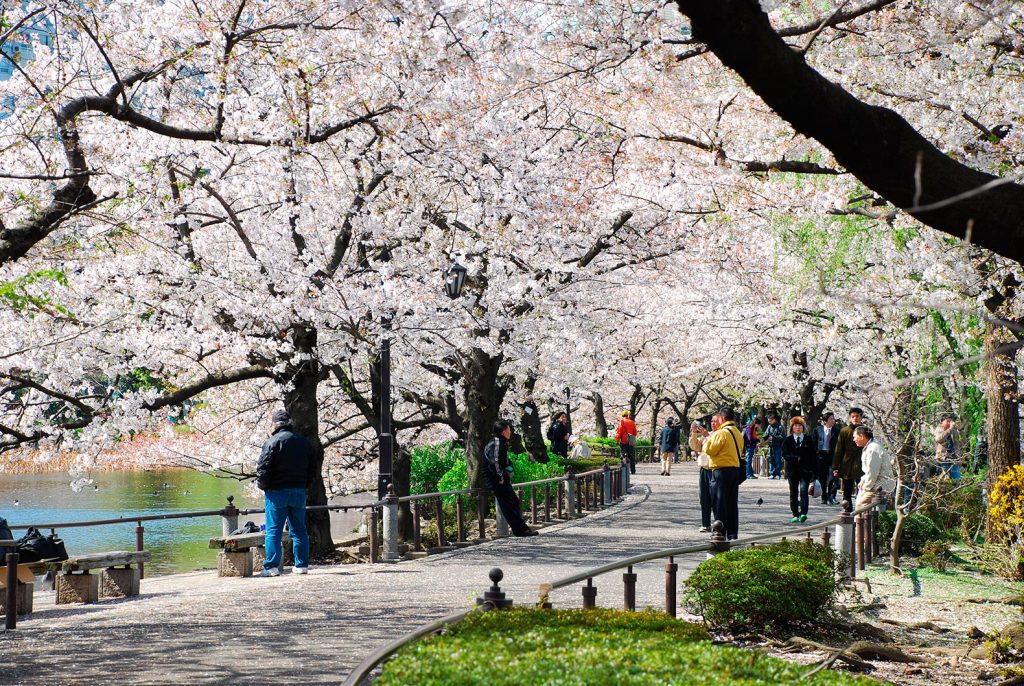
Address: Uenokoen, Taito City, Tokyo 110-0007, Japan Hours: 5AM–11PM
Ueno Street
At the other end of the park is the neighborhood of Ueno. Here you will find the famous Japanese soft drink vending machine, Calpis. There are vending machines everywhere in Tokyo and most of the soft drinks have special flavors that you can hardly taste in other countries, don’t wait but choose a drink you like right away!
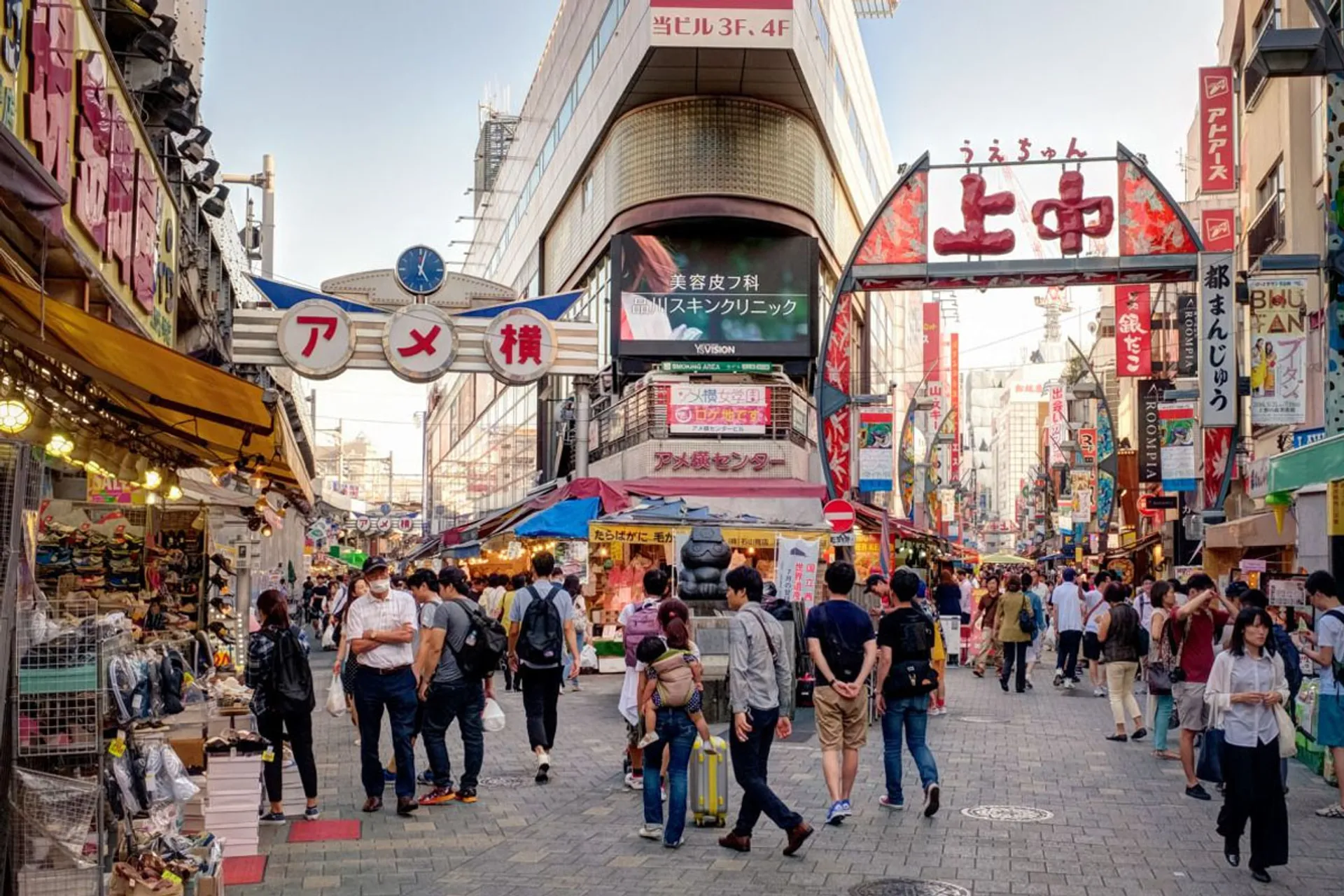
In Ueno, each block specializes selling in different things. We first passed a street full of shops selling all kinds of worship items. Then we saw the famous cooking area, which sells appliances, cooking utensils and plastic figurines of dishes that restaurants often use to present to diners.

We stopped by Sometarō, an Okonomiyaki restaurant where you can cook your own okonomiyaki at your table (help is available). Okonomiyaki is a Japanese dish a bit like an omelette, with pork, cabbage and a special okonomiyaki sauce. It is delicious and quite easy to make yourself. You are definitely to have an enjoyable dinner here.
Address: 2 Chome-2-2 Nishiasakusa, Taito City, Tokyo 111-0035, Japan Hours: 12–2:45PM, 5:30–8:15PM/Tuesday, Wednesday: Closed
Senso-Ji Temple
After dinner, we visited the magnificent Senso-Ji temple. This is Tokyo’s oldest and most important temple, built in 645. Although destroyed during World War II, it was later restored.

Senso-Ji is surrounded by the bustling Nakamise Dori Market, and the surrounding streets are filled with yakitori and izakaya shops and stalls. Many Japanese people visit the shrine and pay their respects. This is the place where the development of Edo culture was concentrated, and even now it still retains the ancient atmosphere of the Edo period. At the Kaminarimon gate at the entrance to Senso-ji Temple, there is a giant lantern hanging in the middle of the gate, which is famous all over the world. The official name of this gate is Fujin Raijin mon (Gate of Thunder God and Wind God), on the right is a statue of the God of Wind, on the left is a statue of the God of Thunder. It is the landmark of Asakusa and also a popular photo spot.
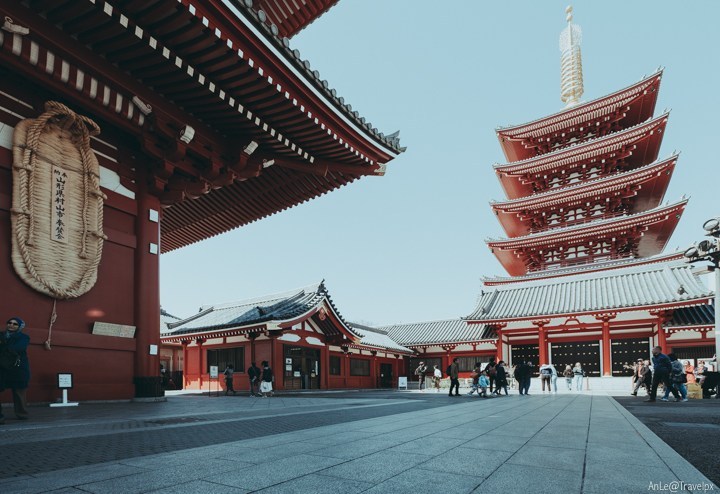
Day 4: Mount Fuji & Hakone (#seven days in tokyo)
Fuji mountain.
Referring to Japan, you will immediately think of the majestic peak of Mount Fuji covered with white snow, right? Mount Fuji is only 2 hours from Tokyo so a day trip there is perfectly suitable. If you’re inexperienced, book a day tour on the Klook to Mount Fuji and the area around Hakone.
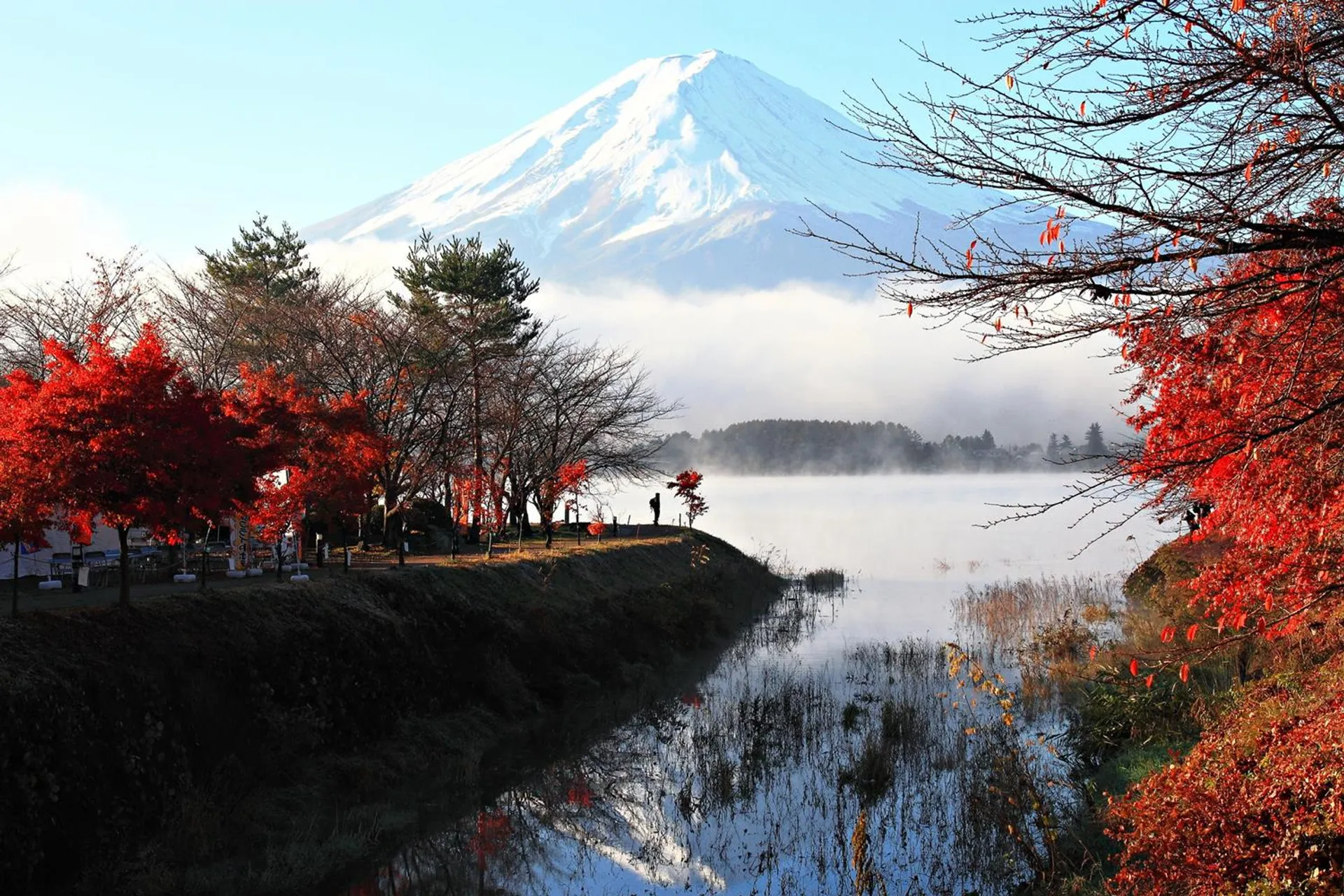
On the way to Mount Fuji, the guide was very enthusiastic to introduce us to the history of Tokyo. It’s a bit pity that there are no stops to take panoramic photos of this famous and beautiful mountain. If you have more time, you should carefully choose a special tour to a place where you can stop and see this famous Mt Fuji.
There are ten stops on the way up to Mt. Fuji and we drove to the fifth station, the mountain is very high, if you want to go all 10 stations it can take a whole day. It was autumn, you will admire the brilliant yellow, orange and red foliage of the forest, each red leaf blowing in the wind, the clear blue sky on the mountain top, the fresh and relaxing air, everything is absolutely wonderful.
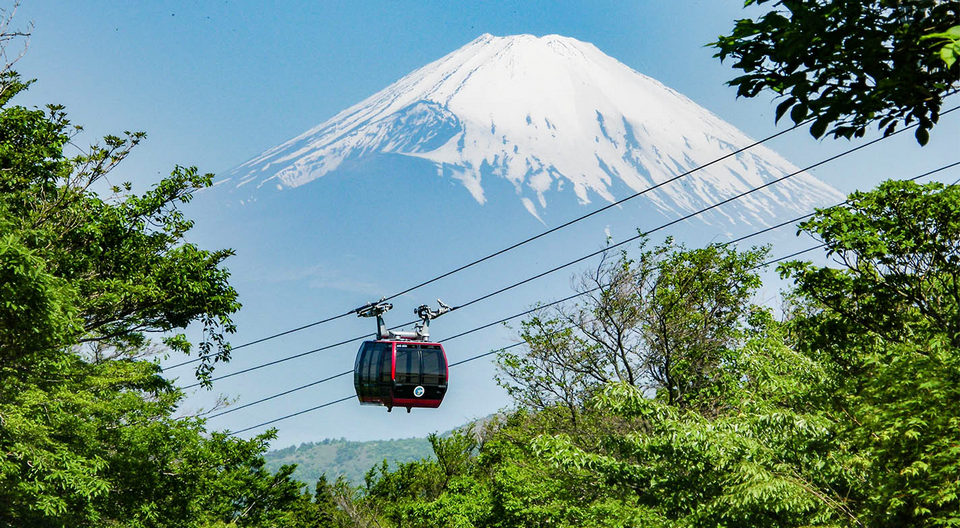
There is a gift shop at the fifth stop, which is crowded and full of small souvenirs about the character of Mount Fuji, perfect for keeping as a souvenir of this trip.
Lake Ashi, Hakone (#seven days in tokyo)
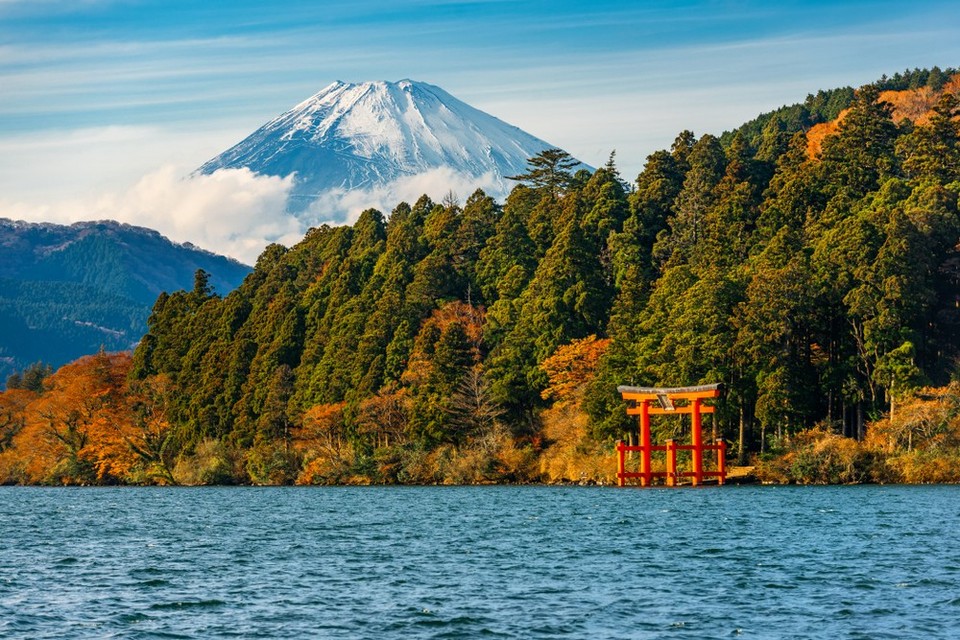
After going down from the mountain, we went to visit Lake Ashi in the Hakone area. The lake is quite large, clear blue ripples. Crossing Lake Ashi will arrive at the cable car station to the top of Mount Hakone. Halfway up the mountain, we were covered in clouds and fog. When we reached the station at the top of the mountain, fog and clouds surrounded us like you were walking on clouds.
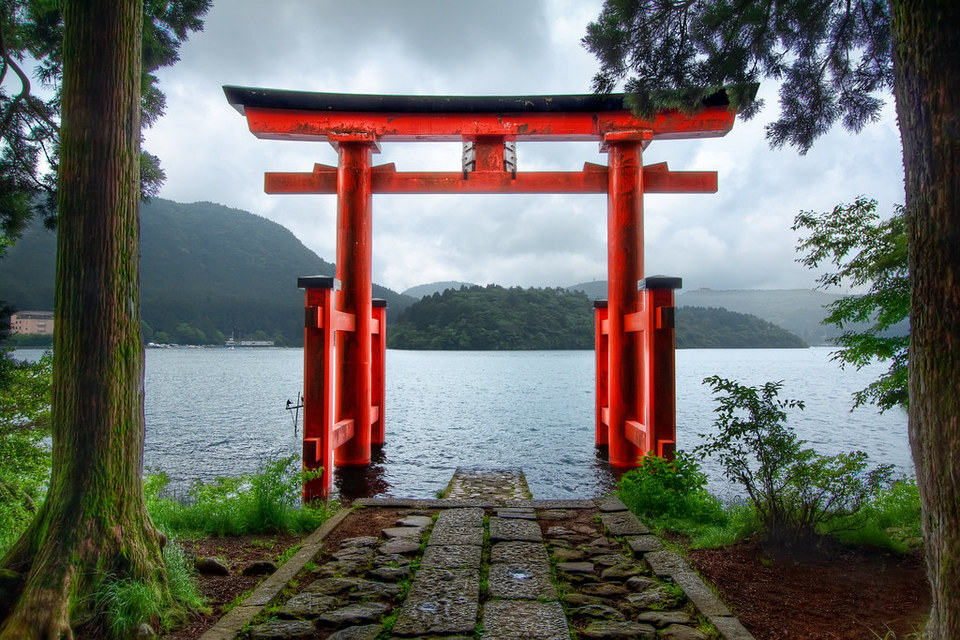
Dinner in Ginza

At the end of the day, we took the bullet train back to Tokyo and stopped at Ginza station for dinner there. Ginza is Tokyo’s most upscale neighborhood with high-rise buildings, luxury department stores, and lots of delicious restaurants. We ate fried dumplings (gyoza) at Gyoza Hohei. Gyoza Hohei sells only two types of Gyoza: garlic and leek filling and ginger served with miso sauce. The dumplings are just the size of a bite, the thin, crispy crust is full of vegetables and the mild sweetness goes well with both standard sauces as well as miso sauces for a great taste. You can order additional clam soups, stir-fried meat and bean sprouts in miso sauce and rice balls and some drinks at the restaurant.
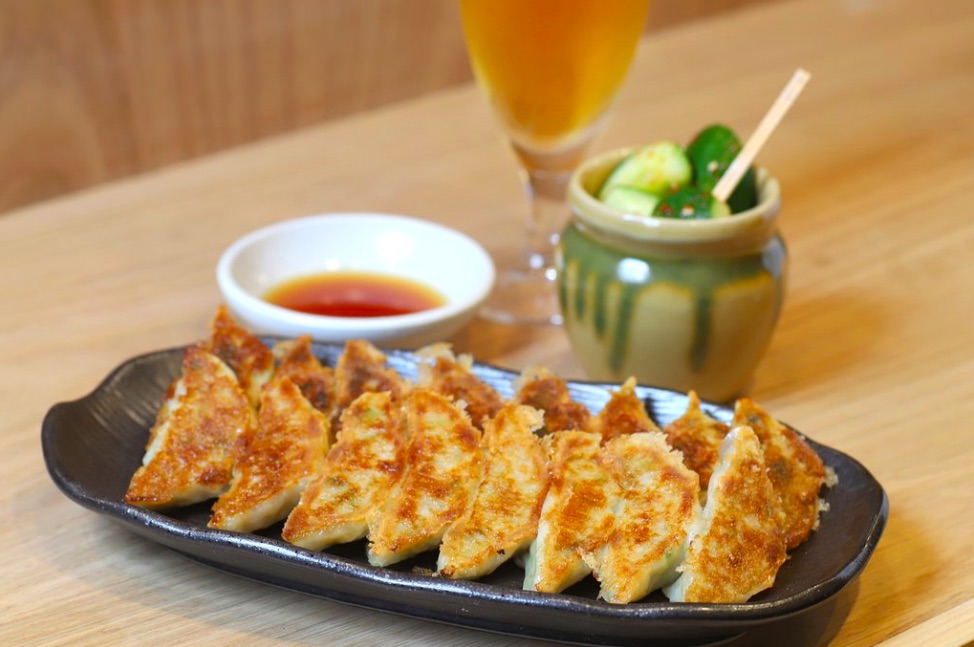
Address: 8-7-9, Ginza, Chuo 104-0061 Tokyo Prefecture Hours: 5PM–1AM/Saturday: 12–3PM, 4–10PM/Sunday: Closed
Day 5: Imperial Palace & Tokyo Tower (#what to do in tokyo for 7 days)
Imperial palace.
On the fifth day we visited the Imperial Palace, the residence of the Emperor of Japan. The Imperial Palace grounds are as large as a park, located in the Chiyoda district of Tokyo, close to Tokyo train station, and contain many buildings including the main palace, the imperial family’s private homes, museums, and administrative offices. The palace was built in the Edo period, surrounded by ancient city walls and deep moats, the Imperial Palace exudes a solemn atmosphere, in contrast to the noisy and bustling life outside.
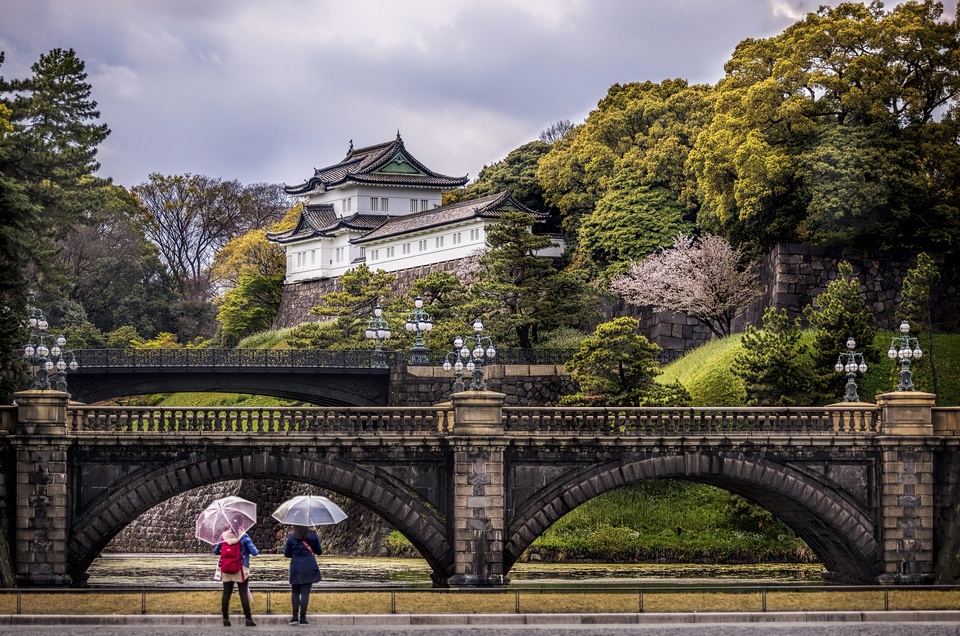
The Imperial Palace is only open to visitors twice a year, on January 2 to welcome the New Year and on the Emperor’s Birthday, at which time the Emperor of Japan will appear on the balcony to receive congratulations from the public.
Address: 1-1 Chiyoda, Chiyoda City, Tokyo 100-8111, Japan Hours: 9–11:15AM, 1:30–2:45PM/Monday; Sunday: Closed
Tokyo Tower (#what to do in tokyo for 7 days)
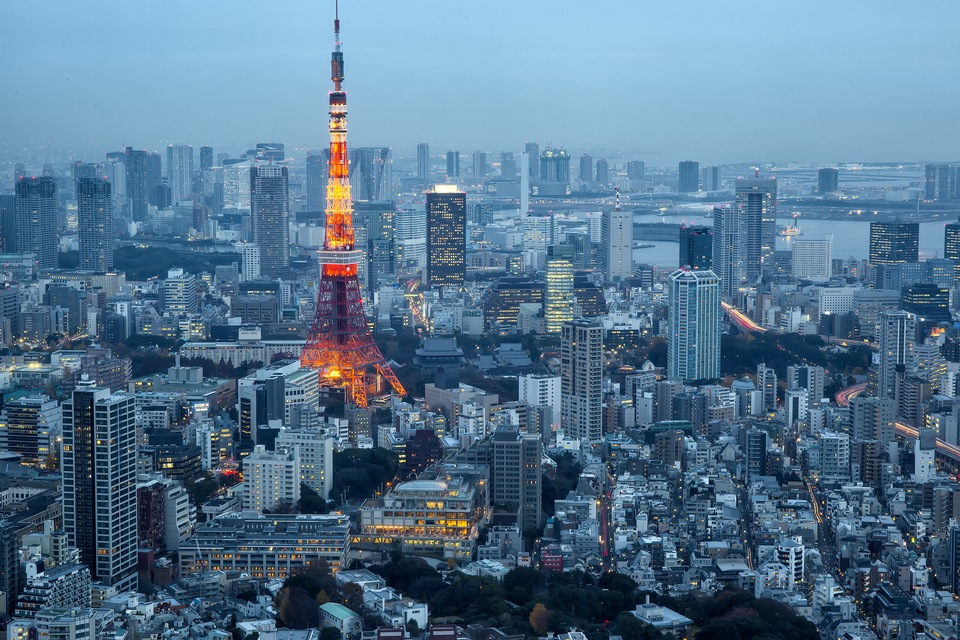
That evening, we visited Tokyo Tower – the proud symbol of the capital of the land of the rising sun. Dubbed the Eiffel Tower of Asia – Tokyo Tower in Japan is one of the tallest steel-structured towers in the world, where you can admire the whole sunrise city in a complete and splendid way. This communication and observation tower is located in the Shiba-koen area of Minato district and has a height of 332.9 meters. Every night the tower is shimmeringly lit. The lights are divided into Landmark Light – which glows towards Tokyo Tower and Diamond Vale – which glows from Tokyo Tower.
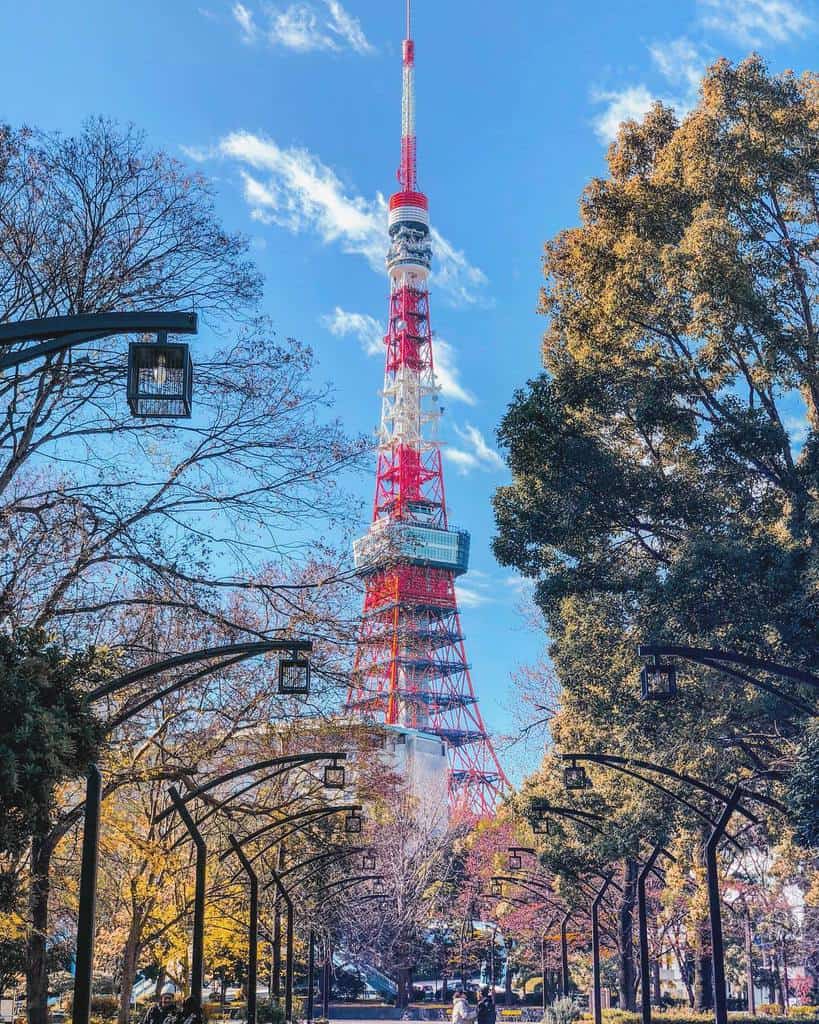
There are 3 observatories in Tokyo Tower. The large observatory on the first floor, located at an altitude of 145m, visitors can relax at the cafe “Café La Tour” while admiring the scenery. The large observatory on the 2nd floor at a height of 150m, there are many shops selling products of “Noppon Brothers”, the mascot of Tokyo Tower, there is also an observation board, there is Tower Daijingu Shrine which is very sacred in praying about love and exams. There is a special private observatory at an altitude of 250 meters, which can be accessed by purchasing a ticket at the large observatory on the 2nd floor. At this observation deck, you can zoom in to see the surrounding skyscrapers. If you come here during the day on a clear day, you can see the Tokyo Skytree and Mount Fuji in the distance.
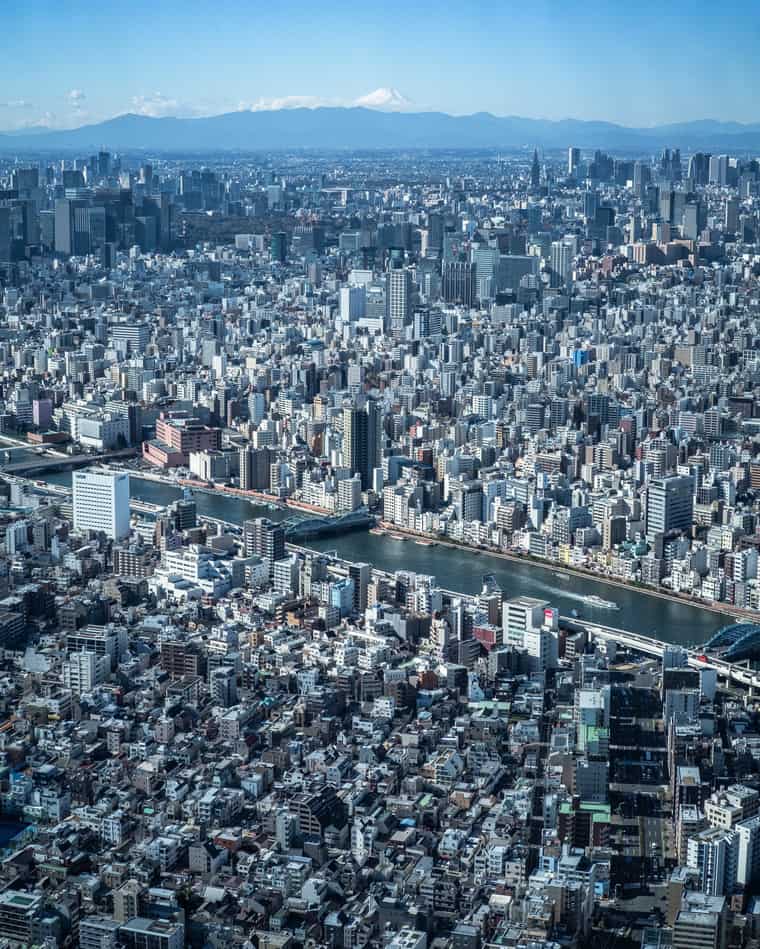
Beneath the Tokyo Tower is a four-story building called FootTown that houses museums, eateries and shops. The first floor includes the Aquarium, a “Tower Restaurant” with a capacity of 400 guests, a convenience store and a souvenir shop. The 2nd floor is the food and shopping area. The third floor is always the area that attracts the most visitors with a museum displaying Guinness World Records and a wax statue of famous celebrities and famous art stars with life-size displays. The fourth floor and the rooftop of the building are quite special psychedelic art exhibitions.
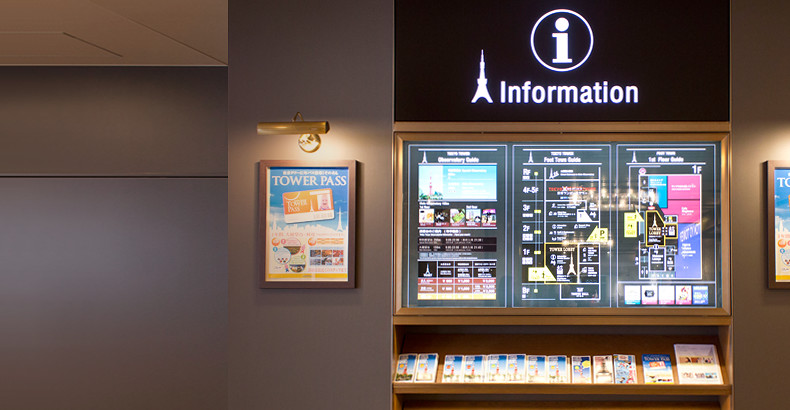
Address: 4 Chome-2-8 Shibakoen, Minato City, Tokyo 105-0011, Japan Hours: 9AM–10:30PM
Day 6: Toyosu Fish Market and Old Tsukiji Fish Market and Hamarikyu Park (#tokyo itinerary 1 week)
Toyosu fish market.
Toyosu Fish Market is the largest and busiest fish market in the world, famous for its early morning tuna auction. If you want to see and participate in the auction, you may need to arrive at 3 am to queue. However it was too early to wake up and catch the bus to the market so we skipped it.
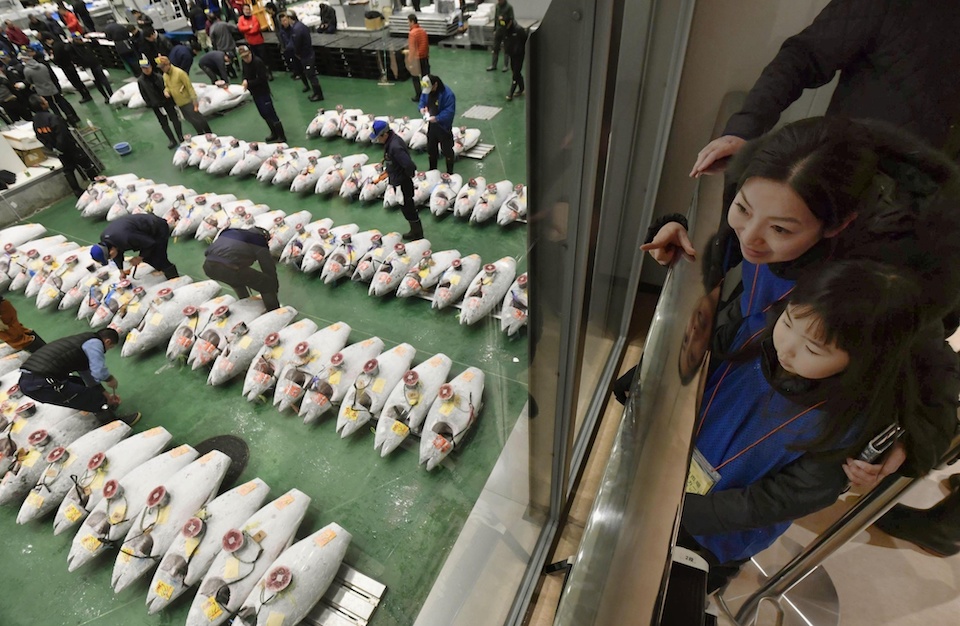
Toyosu Market Address: 6 Chome-6-1 Toyosu, Koto City, Tokyo 135-0061, Japan Hours: 5AM–3PM/Wednesday; Sunday: Closed
If traveling by train, you can use the Toei Oedo Line, stop at Tsukiji Ichiba Station, or take the Tokyo Metro Hibiya Line, stop at Tsukiji Station and walk to the market. The restaurants here are delicious with freshly caught seafood, so be sure to stop by a Sushi or Kaisendon to try it out. However, there are still many other delicious dishes for people who can’t eat raw fish. In Teishoku restaurants, there are many cooked dishes such as grilled fish, braised fish… or Ramen, Gyudon, chicken shops.

Although the old market with tuna auctions moved to the new market Toyosu but the old Tsukiji outer market still full of seafood restaurants at an affordable price. Tsukiji Fish Market has 2 areas, inside the market is an area for food and drink shops and to buy ingredients, outside the market is a place for visitors. Outside the market consists of small buildings with lots of retail shops and restaurants. Here you can find all kinds of food related goods, fresh seafood and wholesale products. Inside the market are large and small fish stalls, it also attracts tourists to visit, learn and exchange with fish experts right here to better understand fish species.
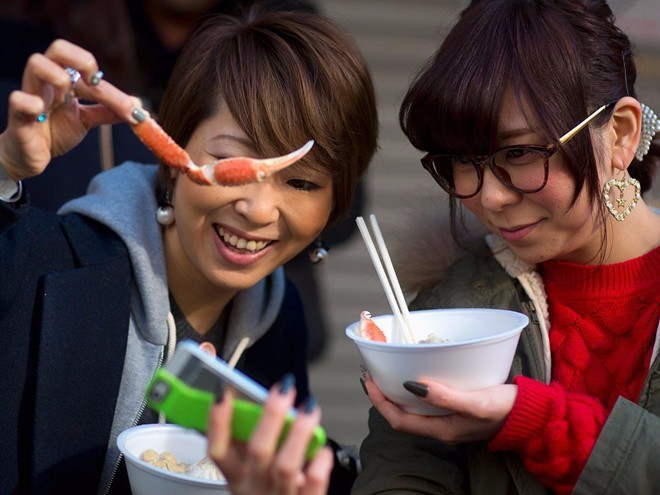
Tsukiji Outer Market Address: 4 Chome-16番2号 Tsukiji, Chuo City, Tokyo 104-0045, Japan Hours: 4AM–2PM/Wednesday; Sunday: 10AM–2PM
Hamarikyu Gardens – An oasis in the middle of the capital (#tokyo itinerary 1 week)
After enjoying a leisurely stroll around Tsukiji, you can simply stop by the park and take a walk. A 7-minute walk from Tsukiji fish market is Hama-rikyu Park, which was originally the residence of the shogun, the palace of the royal family. Here you can relax drinking green tea, eat sweets at the tea room and see the beauty of trees and lakes that you would never have thought possible in the heart of Tokyo.
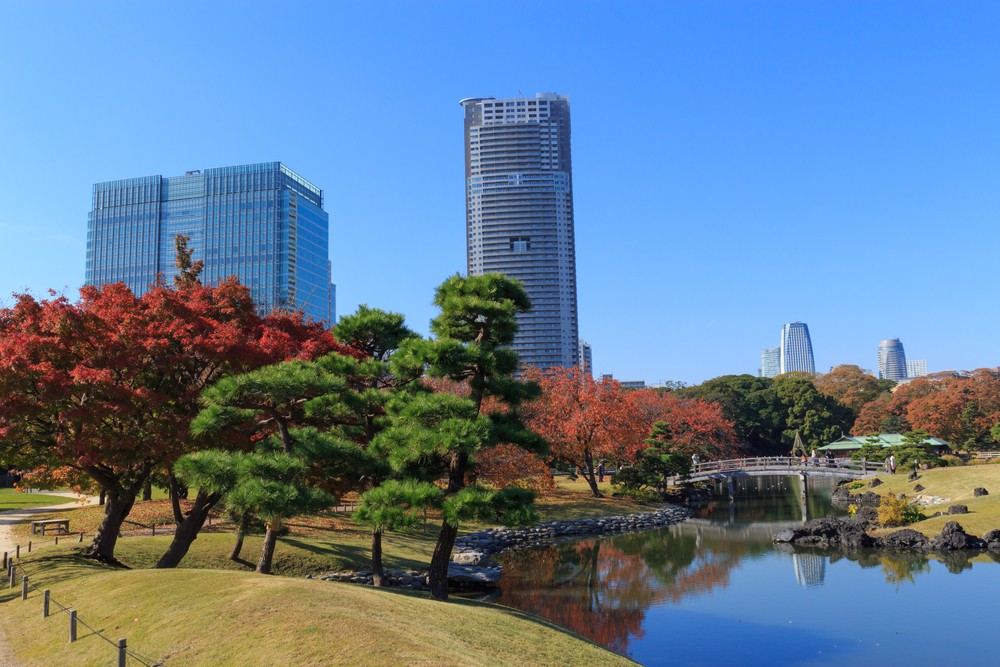
Address: 1-1 Hamarikyuteien, Chuo City, Tokyo 104-0046, Japan Hours: 9AM–5PM
Dinner at Tempura Kurokawa (#tokyo itinerary 7 days blog)
Tsukiji is not only famous for its fish market but also has many delicious restaurants to choose from. Sushi Dai, Tempura Kurokawa, Tsukiji Yabu Soba, Edomae Sushi Takewaka are some of the popular restaurants here.
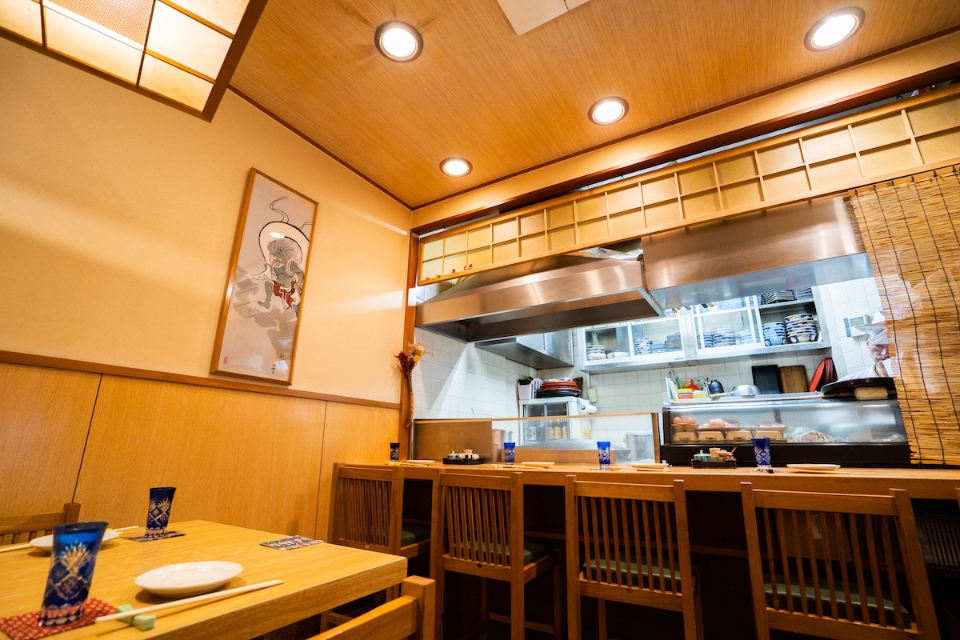
We had dinner at Tempura Kurokawa just a 7 minute walk from Tsukiji station. Tempura Kurokawa offers a traditional Japanese atmosphere. The restaurant is quite small and you can sit at the counter so you can clearly see the chef in the open kitchen preparing the food and enjoying the hot tempura, the batter is delicious and crispy without being too thick. The seafood is freshly caught every day and changes seasonally. Try the kakiage, the restaurant’s top dish with juicy sakura shrimp and scallops over a bowl of hot steamed rice. The scallops are deep fried and fast so they still retain a very sweet taste. Another specialty is Jyo Tendon. It has two shrimps, conger eel, scallops. The crust is very crispy and fragrant with sesame oil, the sauce is not too sweet to eat with rice. Order an extra bowl of miso soup and pickled vegetables and start enjoying this delicious dinner.
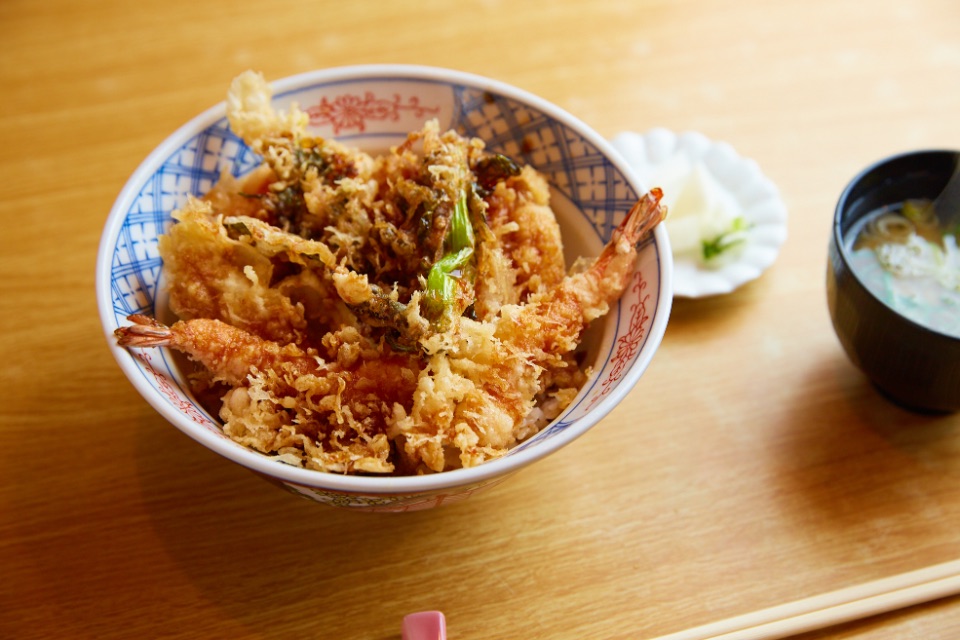
Address: 1-1 Hamarikyuteien, Chuo City, Tokyo 104-0046, Japan Hours: 9AM–1:30PM/Sunday: Closed
Day 7: Saya-no-Yudokoro and goodbye to Tokyo (#tokyo itinerary 7 days blog)
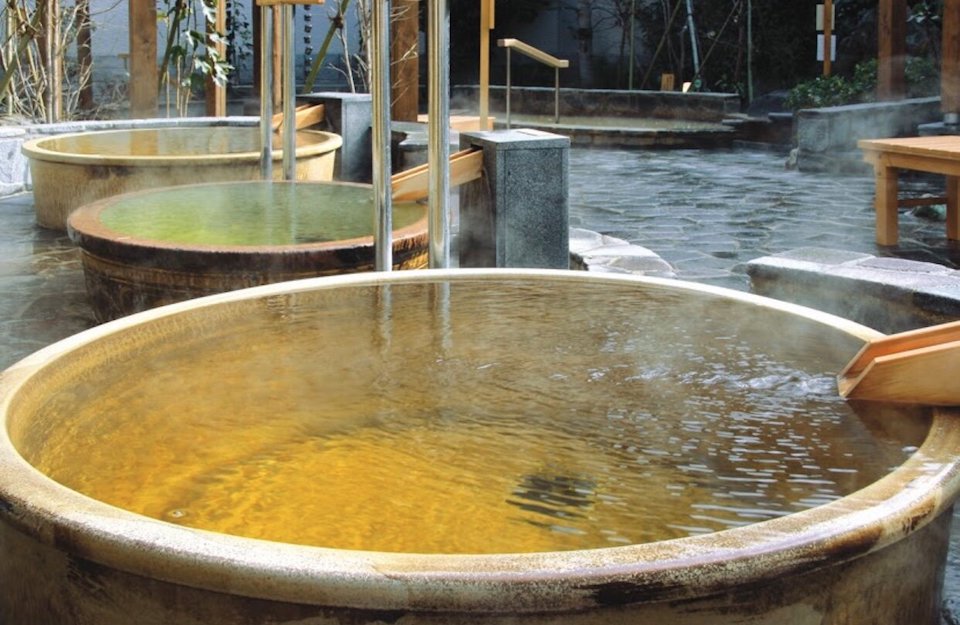
The last day, we decided to relax at Saya-no-Yudokoro, a traditional Japanese onsen (hot spring). The natural hot spring draws its water from 500 meters underground, such a natural hot spring is hard to find in Tokyo. In addition to outdoor hot springs or hot tubs, you can choose from unique baths such as an electric bath, a tachi-yu (bathing while standing up), or a ne-yu (bathing while lying down) bath. There is also a steam room, a sauna, a stone sauna, with aromatherapy and massages. After you’ve soaked and relaxed, forgetting all your worries, you can stroll the laid-back cobbled streets of Jiyugaoka and hipster, the glitzy Koenji neighborhood to cap off your weeklong journey to Tokyo.
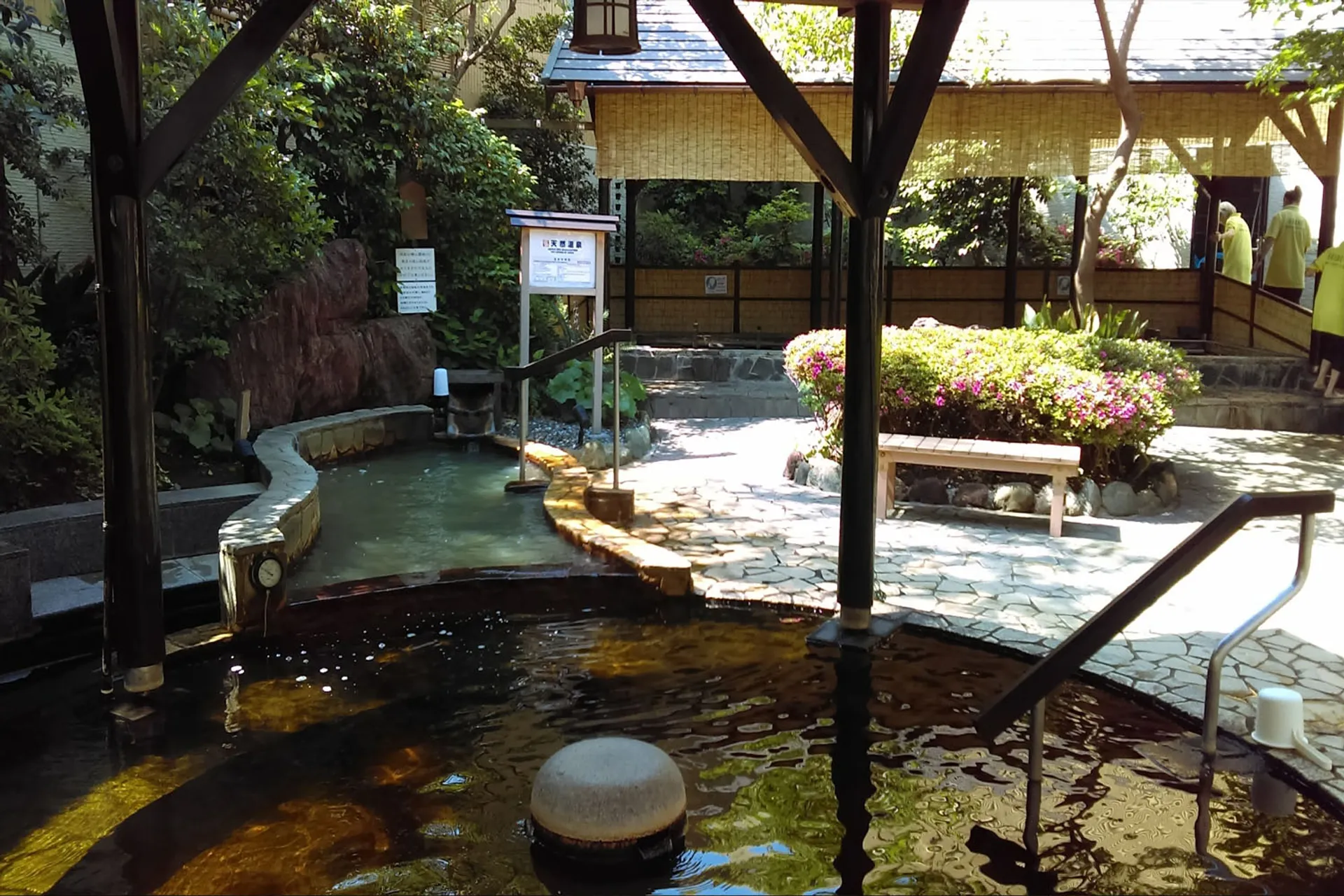
We had a wonderful week in Tokyo to discover the beauty of this city and Japan. This place is really great with the famous Mount Fuji, the view of the whole city from the Tokyo Tower, bustling streets, ancient temples, shopping malls and countless restaurants with exquisite cuisine of Japan. Although there are still many places to go and explore in Tokyo, we have to return. If possible I would really like to come back to Japan and visit other cities and rural areas of Japan to enjoy and discover more about the country, its people and its diverse culture. Sunrise.
Have you ever visited Tokyo? If not, that’s really a pity. A week of travel here will surely bring you great experiences and memorable memories. What are you waiting for, plan to come to Japan right away and pack your bags!
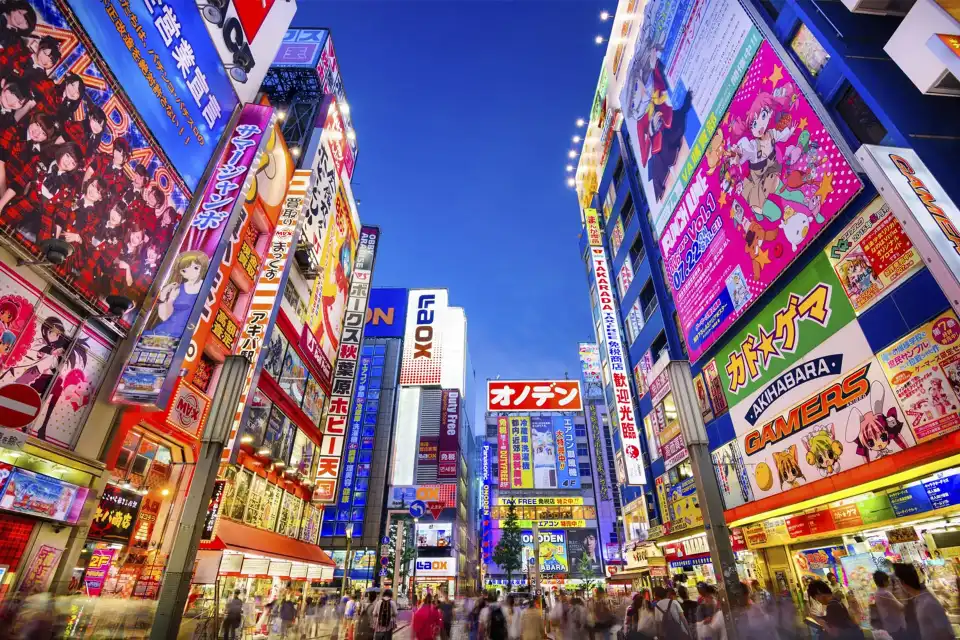
Some best day tours, trips, activities and transfer services, tickets in, to and from Tokyo you can refer to
- Private Narita International Airport Transfers (NRT) for Tokyo 23 Wards, Hakone, or Karuizawa
- Private Haneda International Airport Transfers (HND) for Tokyo 23 Wards, Hakone, or Karuizawa
- Airport Limousine Bus Transfers from/to Narita and Haneda International Airport (Free Wifi Onboard)
- Tokyo Amazing Sightseeing Bus Day Tour
- Tokyo Highlights Private Day Tour
- Nikko Day Tour from Tokyo
- Mt Fuji & Hakone Day Tour: Lake Ashi & Ropeway Day Trip from Tokyo
- Nikko Cultural Day Tour from Tokyo
- Tokyo Subway Ticket (24, 48, or 72 Hours)
- Tokyo Skyliner and Tokyo Subway Ticket
- Shuttle Bus Transfers (One Way/Round Trip) from Shinjuku/Ikebukuro to Tokyo Disneyland or Tokyo DisneySea
- Tokyo Disney Resort Park Ticket
- Klook Pass Greater Tokyo
- SHIBUYA SKY Ticket
- Warner Bros. Studio Tour Tokyo – The Making of Harry Potter Ticket
- Skyliner Narita Airport Express Ticket
- TeamLab Planets Ticket
- TOKYO SKYTREE® Ticket
- Limousine Bus Narita or Haneda Airport to Tokyo
- Skyliner Narita Airport Express With Tokyo Subway Ticket
- JR Tokyo Wide Pass
- Sky Hop-on and Hop-off Bus Pass
- 4G Prepaid Sim Card (JP Airports Pick Up) for Japan
- 4G WiFi (BKK and DMK Airport Pick Up) for Japan (Unlimited Data)
- JR Pass for Whole Japan (7, 14, or 21 Days)
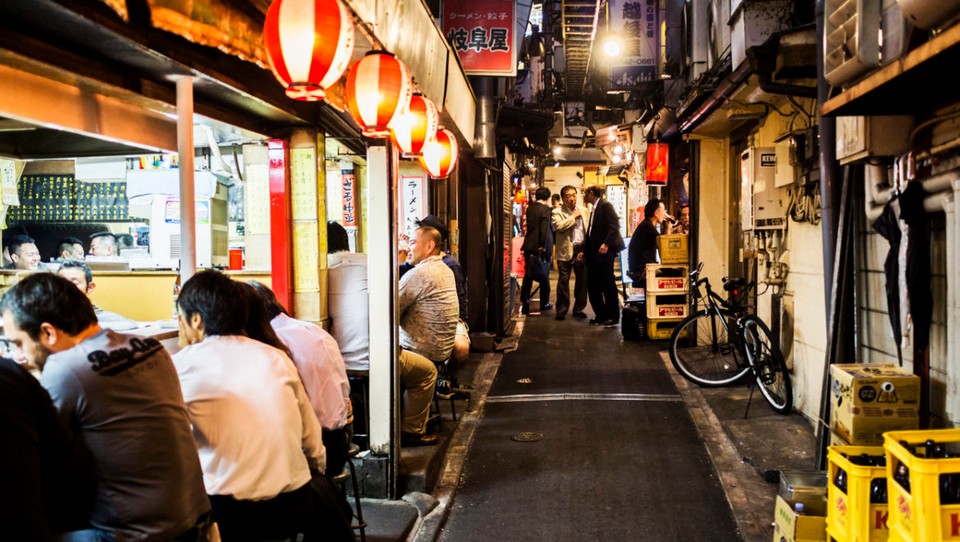
Looking for best autumn spots in Japan? Read here . And Kyoto here . And top things to do in Tokyo: Tours, activities, attractions and other things? Read more: Tokyo travel blog — The fullest Tokyo city guide for a budget trip for the first time visiting Tokyo, Japan .
Related articles
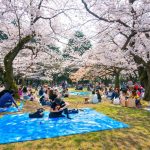
RELATED ARTICLES MORE FROM AUTHOR
Where to go in kunming — 15+ top kunming attractions & best places to visit in kunming, must eat in melaka — 10+ famous malacca street food & must try food in melaka, what to do in alishan — 5 top attractions & best things to do in alishan, taiwan, hong kong food culture — hong kong cuisine tells the historical story of the whole land.

Melaka food blog — Experience Melaka delicacies, arrived at by Trishaw

Where to eat in Hakodate? — 5+ best food & best places to eat in Hakodate city, Hokkaido
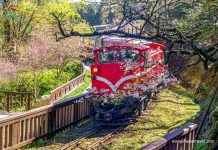
Alishan travel blog — The fullest Alishan travel guide for first-timers
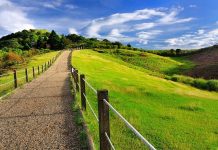
Gingtiangang Grassland Yangmingshan — The ultimate guide on how to go & top things to do
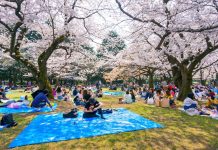
EDITOR PICKS

What to eat in Chongqing? — 14+ most famous, best food...

Where to go in Kunming? — 15+ top Kunming attractions &...

Must eat in Georgetown — 10+ famous, must-eat & best street...
Popular posts.

What to buy in USA? — 17+ must buy in USA...

Must buy souvenir in Taiwan — Top 17+ most famous, cheap...

Must buy in Korea — Top 23 cheap, famous & best...
Popular category.
- Inspiration + Guide 1453
- Trip Inspiration 469
- Thailand 209
- Food + Drink 207
- Coasts + Islands 193
- South Korea 168
- Vietnam 166
- Travel Photos 144
- Work for Us
- Terms & Conditions
- Privacy Policy
7 days in Tokyo - What to do, where to go, itinerary ideas and more
By gowithguide travel specialist: kenzia v..
Things To Do
/filters:quality(80)/fit-in/1024x1024/gowithguide/posts/4882/129811.png@avif)
You would want to experience the most out of Tokyo during your short visit to Tokyo, right? Doesn’t matter how long or short it is. So, if you’re lucky enough to have 7 days to spend in Tokyo, and looking for ideas of what to do and where to go, I’ve got you covered.
You don’t have to look anywhere else for things to do or where to go in Tokyo. By the time you've finished reading this article, you will have figured it all out.
I’m going to share with you some ideas of things to do and places to go during your 7-day trip in Tokyo, some itinerary ideas, ways to make your trip more interesting, and more recommendation. So, read on!
Tokyo, one of the world’s greatest cities, is a sprawling city filled with endless incredible attractions and sights. Each of them has a unique character and appeal, attracting travelers from all over the world.
There’s nowhere else quite like Tokyo. A place where the lively and modern side meets the serene and traditional side. Tokyo has everything, temples and shrines, nightlife, street food to fancy dining, flea market to high-end shopping, bustling-crowded area to quiet-suburban area, nature, anime, arcade games, themed cafés, parks and so many more.
7 days in Tokyo - too long, too short, or just right?
Even if you lived in Tokyo for a year, it would be impossible to experience all of Tokyo. So, I think it’s more of a personal preference, however long and short is enough to travel around Tokyo. It’s impossible to get bored in Tokyo with all the choices of things you can do and places you can go.
You can do a lot of things in Tokyo for 7 days. You can visit a lot of the major places, maybe even off-the-beaten-path spots (I’ll tell you a bit later on in this article how to find them), do some touristy things, experience the cultural experiences, and more. So, I’d say that it’s never too long to stay in Tokyo (unless it’s visa issues) but 7 days in Tokyo is definitely not too short to experience it.
Things to do in Tokyo
Here are some ideas of things you can do in Tokyo other than visiting the major spots in Tokyo.
Unique Experiences
- Visit the many themed cafés like Robot Restaurant , Vampire café, Monster café, maid café, owl café and so many more.
- Go go-karting around Tokyo .
- Watch sumo tournaments or sumo practice . Which you can learn how through by clicking here .
- Participate in a Japanese tea ceremony .
- See cosplay (at Harajuku) or even cosplay your own (buy costumes at Akihabara)!
Food-related
- Eat good food. Everywhere in Tokyo, literally everywhere (ramen, takoyaki, sushi, Kobe beef, anything you like!)
- Go to the convenience stores and buy some of the interesting food, snacks, and drinks.
- Try Izakayas.
- Visit Tsukiji Market to eat the freshest sushi in Japan.
- Have a picnic and enjoy the beautiful nature in some of the parks in Tokyo, such as Shinjuku Gyoen National Park and Ueno Park. Especially if it’s cherry blossom season or autumn!
- Leisurely stroll to the many different museums in Tokyo, like the Mori Art Museum, Samurai Museum, Ghibli Museum and so many more interesting ones.
- Enjoy the city view from Tokyo Skytree and Tokyo Metropolitan Government Building.
- Take baths in the Onsens in Tokyo.
Other options
- Shop high-end things in Ginza or Omotesando, and also kawaii stuff in Takeshita Street.
- Go to Tokyo Disneyland and Tokyo Disney Sea.
- Do a little people-watching (not in a creepy way) at the Shibuya Crossing.
- Play an arcade game or try Pachinko.
And so much more. The list of things you can do in Tokyo is endless.
Where to go in Tokyo?
I’ll list some popular areas in Tokyo and some of the major spots or related stuff in that area that you can check out and go.
There are still so many places like temples, parks, and other places to go in Tokyo, which you can click here to check out.
Itinerary ideas for 7-day Tokyo trip
To make your trip a great one, you would need a great itinerary as well.
If you are looking for 7-day Tokyo itinerary, you can check this Tokyo 3-day itinerary for first-timers and follow this for the first 3 days. For the next 4 days, you can freely stroll around Tokyo to possibly discover lesser-known places, or plan an itinerary on your own, or follow these itinerary suggestions:
Travel plan for first timers in Tokyo - packed with the major destinations that represent Tokyo.
Tokyo 1 day itinerary (Imperial Palace, Ginza, Skytree) - a great itinerary that includes the popular spots of authentic Tokyo and popular shopping district Ginza.
Tokyo Rainy 1 day itinerary - You can’t always expect to have sunny weather during your Tokyo trip, so just in case it rains, you can follow this itinerary.
Easier way for your 7-day travel in Tokyo
If you don’t feel like following some random itinerary on the internet that may or may not include your interest, or making a great one your own, you can always make your travel so much easier!
Hire a private guide!
Advantages of hiring a private guide →
- You don’t have to make an itinerary yourself or follow some random itinerary that may or may not include your interests.
- You can have a great and hassle-free Tokyo experience.
- Furthermore, you can have itineraries tailor-made just for you to match your preferences and interests.
- An enhanced and more interesting trip.
- Extra safety.
- A deeper understanding of the places and culture in Tokyo.
- So many more .
Like I said above, I’ll tell you how you can discover off-the-beaten-track spots in Tokyo. One way to discover them is through hiring a private guide. They are highly knowledgeable about things in Tokyo and have discovered so many places equally beautiful and interesting as the major ones, but are not packed with tourists. They can bring you to experience Tokyo from another angle.
You won't have to worry about direction, transportation, language difficulty or other issues if you have private guides by your side. You can get their suggestions of where are the best places to go, the best restaurants to eat at, and ways to make the most out of your trip. They can tell you many different interesting things to do, and you won’t ever get bored. Hiring a guide can make your trip more interesting and memorable.
Recommended tour guides
There are many websites where you can hire tour guides, but you never know what you are getting into, whether the guides are quality guides or not. Or whether the website is trustworthy or not.
That’s why I’m recommending you GoWithGuide . The website offers many qualified tour guides options in Tokyo and other areas of Japan, from which you can choose according to your needs and preferences.
Through the website, you can watch the guides’ personalized videos, read the reviews of each guide, check their availability and service cost to help you find the right guide.
Wait, there's more:
The website also has many different private tour options in many different areas of Tokyo, which you can check out by clicking here , and also different cultural experiences like Japanese tea ceremony, sumo practice watching, samurai experience, and more. You can check them out by clicking here .
Where to hire a private guide for your Tokyo trip?
You don’t have to look very hard to find a great private guide for you. Here is a list of great tour guides in Tokyo . And if you are looking for guides in other areas of Japan, you may want to click here.
You can choose private tours with customizable itineraries. Here is a list of my recommended private tours in Tokyo and other areas of Japan .
Another thing!
If you think that joining a private tour or hiring a private guide is the best option for you, you can still make your trip in Tokyo easier. You can rent a private charter van or car (depending on the size of your group) to charter you around in Tokyo. Click here to check the many options of private chartered cars in Tokyo . So convenient!
I hope this article helps provide information on what you can do in Tokyo, where to go in Tokyo with itinerary suggestions, another way to make your 7 days in Tokyo more interesting and easier, and other suggestions. I hope you have a great time in Tokyo!
Popular Tokyo Tour Guides
/filters:quality(80)/fit-in/480x480/gowithguide/profiles/577/7897.jpg@avif)
I have been working as a journalist for 37 years in Kyodo News Service, Japan’s most prestigious news agency. From 1989-1991, I was dispatched to Cyprus, Nicosia and working as a Middle East correspondent. I covered the Gulf War during the time. I worked at Kyodo’s New York bureau from 1994-97 covering the Wall Street and the United Nations. Although I am still working as a journalist here in Japan, I would love to have an opportunity to introduce my country to people from abroad as a tour guide. I will show you the best of Tokyo and other noted palce Including Kyoto.
/filters:quality(80)/fit-in/480x480/gowithguide/profiles/51380/14260cbf-b369-4242-ae3f-723aad3c5cf0.png@avif)
My name is Grant I lived more than 10 years in Japan. I graduated University and translation school in Tokyo. I am fluent in Japanese. I have a degree in Asian studies and have expert-level knowledge of Japanese culture and history. I have memorized the JR rail system across all of Japan, I use the same train timetable calculators as the station staff, and I have experience using bullet train passes that are exclusive to foreign visitors. I can optimally navigate the Tokyo underground and maximize value from a Tokyo metro pass and also understand Tokyo above ground which will allow for seamless transitions between different metro stations and landmarks with minimal backtracking. My tour fee is 20,000yen for 1-6hours (135.28USD) 30,000yen for 7-9hours (202.93USD) 40,000yen for 9-12hours (270.57USD) I have half-day tours listed at 20,000 yen (135.28USD) at the moment but you can combine them or do a custom tour for roughly up to 9 hours for 30,000 yen (202.93USD). The time transiting to and from your hotel for pick up or drop off within Tokyo 23wards does not count towards an increase in the price.
/filters:quality(80)/fit-in/480x480/gowithguide/profiles/21103/73478.jpg@avif)
I live in Yokohama, Kanagawa prefecture. I have a license to teach in high schools and was admitted to the degree of Master of Arts in Teaching English as a Second Language in the University of Birmingham. Until 2015 I had been teaching English at public high schools in Kanagawa for 37 years. During that time, I had some experience of guiding students from overseas through sister-school relationship around Tokyo and Kanagawa. Therefore, I had good command of English with the TOEIC score of 935. As for a tour guide experience I earned the certificate of National Government Licensed Guide-Interpreter in English and since then I have guided tourists to the popular sites around Tokyo, Yokohama, Kamakura and Yokosuka. My guiding focuses on introducing not only Japanese historical and cultural backgrounds but also giving tourists some tips to travel Japan only by themselves, such as how to use trains and subways, find good restaurants, reserve tickets, buy survenier, and speak basic Japanese. In addition, my tour includes opportunities to experience Japanese culture like Zen meditation, ninja performance, visiting anime's location sites based on tourists' request. Besides, by means of my hobbies of writing English Haiku and Waka (traditional Japanese poems) and performing Rakugo (traditional Japanese funny story telling) in English, I can surely entertain tourists during the tour. My moto as a tour guide is let the tourists have a once-in-a-lifetime experience in Japan with my profound, intelligible and interestiog guiding.
/filters:quality(80)/fit-in/480x480/gowithguide/profiles/7030/291e1e6c-72f0-488b-90d5-64bb8c0ce291.png@avif)
I’m so excited to have a chance to show you around my favorite spots in Kanagawa prefecture. I was born in Kanagawa. I spent my whole school life, including university, here in Kanagawa. I worked as a high school English teacher here for 40 years. I love Kanagawa so much. We have many interesting tourist spots, like Hakone, Kamakura, Enoshima and Yokohama. I got my tour guide license in English in 2009. I am still an English teacher. To give an interesting and impressive lesson to young high school students, I’ve learnt and gathered many kinds of information. I also have a license to teach social studies, so I have a wide range of knowledge about Japanese culture and history. I’m sure to provide you an interesting tour.
Plan your trip to tokyo.
Chat with a local tour guide who can help organize your trip.
Related Blogs

10 Best Places for Pokémon Go in Tokyo
Tokyo, Japan
⭐⭐⭐⭐⭐ Come & enjoy the beauty of Japan with our highly rated Japan private tours. LAST UPDATED: October 15, 2022 TLDR: The 10 best places for P...
/filters:quality(80)/fit-in/480x480/gowithguide/profiles/2204/43560.jpg@avif)
Tokyo's Top 10 Sites for Anime and Manga Lovers
Tokyo, and in particular akihabara, has a plethora of museums, shops, cafes, and other sites targeted towards anime and manga lovers. as such, tokyo ....
/filters:quality(80)/fit-in/480x480/gowithguide/profiles/77/536.png@avif)
10 Best Onsen (Hot Springs) Around Tokyo
⭐⭐⭐⭐⭐ come & enjoy the beauty of japan with our highly rated japan private tours. last updated: october 15, 2022what is an "onsen"an "onsen" (温泉) is ....

10 Must-Go Shopping Destinations in Shibuya
Shibuya is a popular shopping district within tokyo where you can find a variety of places for entertainment and recreation such as shopping malls, re....
/filters:quality(80)/fit-in/480x480/gowithguide/profiles/349/4365.jpg@avif)
Follow us on social media
7 Day Japan Itinerary: 2024 Guide For First-Timers
Looking for the perfect 7 Day Japan Itinerary 2024? This is the only guide you’ll need!
From the ancient temples and shrines of Kyoto to the modern cityscapes of Tokyo and Osaka, Japan is teeming with both old and new.
Whether you’re looking for a diverse range of amazing food, beautiful scenery, or unique cultural experiences, every region in this breathtaking country has something different to offer!
Japan is one of my absolute favorite countries to visit, and definitely the kind of place you could spend months exploring.
But don’t worry – if you only have a short time frame to visit, seeing Japan in a week is totally possible!
In this best 7 day Japan itinerary, you will find my recommendations for the top locations to visit, how to get around, where to stay, and much more.
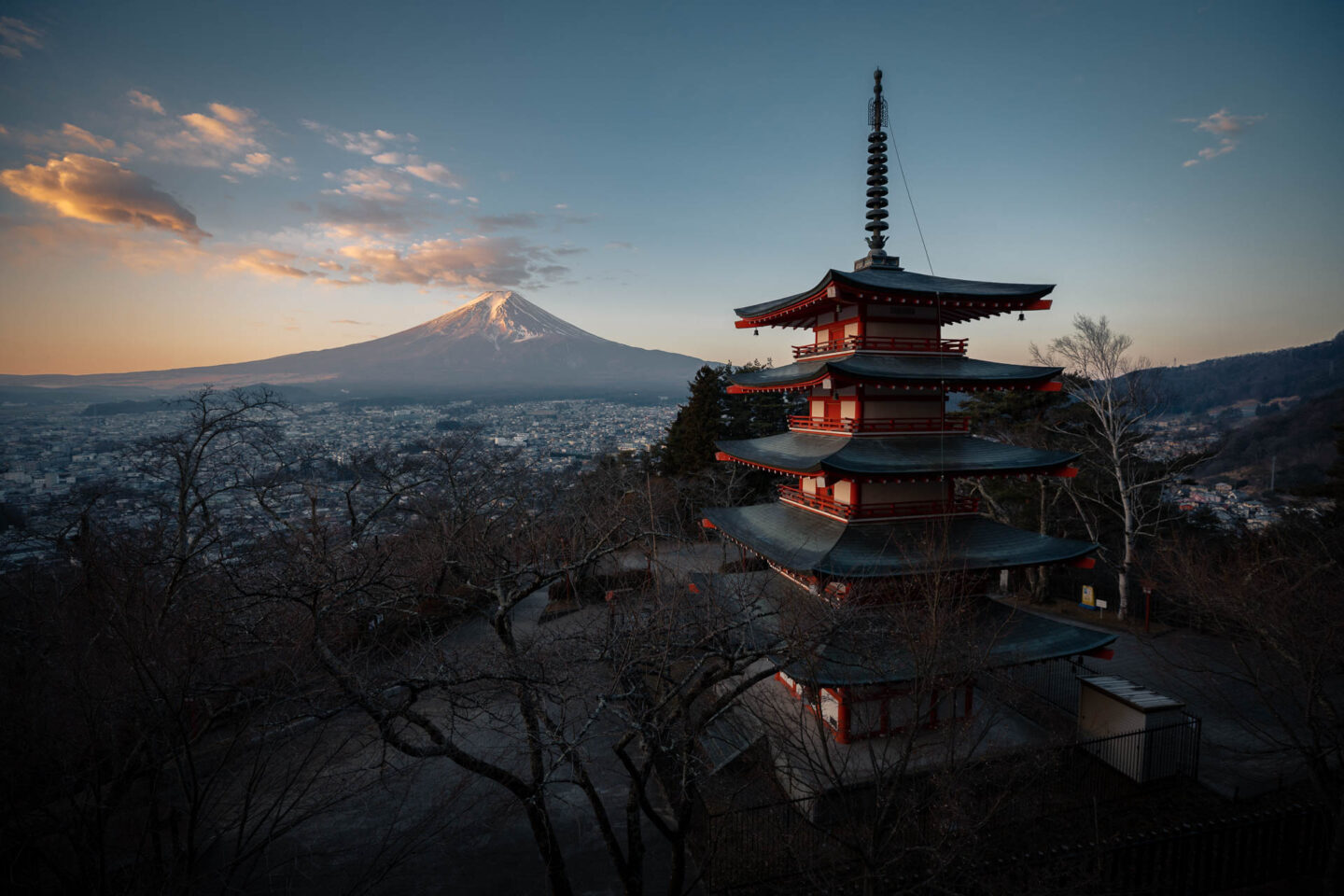
Table of Contents
OVERVIEW – 7 DAY JAPAN ITINERARY
To get the most out of your 1 week in Japan, here is an overview of my recommended route to take:
- Day 1: Tokyo to Kyoto
- Day 2: Kyoto
- Day 3: Kyoto to Nara
- Day 4: Kyoto to Osaka
- Day 5: Osaka
- Day 6: Osaka to Hiroshima
- Day 7: Hiroshima to Fuji to Tokyo
HOW TO GET AROUND – 7 DAYS IN JAPAN
The easiest and most convenient way to discover Japan is with a 7 Day Japan Rail Pass that is valid for use on the vast majority of railways and local buses operated by JR (Japan Rail) throughout the country.
Choose between an Ordinary Pass, or the Green Class Pass if you’re looking to travel in more comfort with reclining seats, a footrest, extra leg space, and a travel magazine.
The Japan Rail Pass is definitely the best ticket to have when planning your Japan itinerary 7 days budget!
Travel Japan with the JR Pass!
Get a 7-day, 14-day, or 21-day JR Pass for your trip to Japan and enjoy unlimited travel on JR services!
The JR Pass is valid on the Shinkansen (bullet train), Limited Express, Local Trains, and JR Buses.
WHERE TO BUY YOUR JR PASS?
You can purchase a JR Pass online through an official Japan Rail Pass reseller such as Klook .
I recommend buying your pass prior to arriving – not only is it cheaper online than buying in Japan itself but it will allow you to jump right into your trip!
When you purchase your JR Pass , a voucher will be mailed to your home address within a couple of days (or delivered to your hotel in Japan, if you choose).
At the Travel Service Center, the process is very simple. You exchange this voucher and show your passport and visa.
( Note: When you land in Japan, you’ll automatically get a tourist visa in your passport at immigration. For the majority of nationalities, the visa is free if you’re in Japan for less than 90 days. )
Then, after specifying the date you’d like your pass to start and reserving your seat for the first leg of the trip, you’ll receive your pass and be ready to begin your 7 days in Japan!
Read More: JR Pass – A Complete Guide On How It Works
7 DAY JAPAN ITINERARY
Now that we’ve covered some logistics on how to get around Japan, let’s get to the fun stuff – a Japan day-to-day itinerary!
So, without further ado here is a complete 7 day itinerary for Japan!
DAY 1: TOKYO TO KYOTO
The first of your Japan itinerary for 7 days will be about getting from Tokyo to Kyoto, and that is pretty simple from Tokyo Station.
Note that, if you get to Tokyo late at night, I recommend staying near Tokyo Station so you’re ready to go early in the morning after.
HOW TO GET FROM TOKYO TO KYOTO
If you’re arriving at Narita Airport, I recommend getting the 1300¥ ($9 USD) bus direct from the airport to Tokyo Station.
It only takes around 70 minutes, and offers great views as you approach and become engulfed by Tokyo city!
Once you get to Tokyo Station, follow the signs to the Marunouchi North Gate exit, and there you’ll find the JR East Travel Service Center.
This is where you will trade your JR pass voucher for your actual JR Rail Pass.
From there, head to the JR Tokaido Shinkansen Line at Tokyo Station. Look for screens that show the name and departure time of your Shinkansen (this info is also on your reserved seat ticket), and you’ll be able to find the right platform and car number.
The trip to Kyoto takes about 3 hours on the bullet train, so if you leave in the early morning you can be there by around 11 am.
If the weather is clear, you might even sneak a view of Fuji on the way down, so keep a lookout on the right-hand side of the train!
In case you need to stay in Tokyo for the night, I recommend a hotel near Tokyo Station, and the one below is an excellent option.
The BEST Hotel in Tokyo
Need a place to stay? Hotel Metropolitan Tokyo Marunouchi is conveniently located near Tokyo Station.
Whether you’re here to explore the sights or relax in comfort, Hotel Metropolitan offers the best of both worlds.
BEST THINGS TO DO IN KYOTO
The best tourist attractions you should check out when visiting Kyoto are the ones below.
Kyoto National Museum
For your first stop in Kyoto, I recommend briefly checking out the Kyoto National Museum.
With a wide range of exhibits showing off ancient Japanese culture and hosting many famous names in Japanese art, you’ll definitely be able to marvel at and learn something new about Kyoto’s rich history.
The entry price for adults is 700¥, and you can pay extra for exclusive seasonal exhibitions.
How to get there:
Kyoto City Bus 100 or 206 from Kyoto Station to Sanjusangendo-mae bus stop, or via a 10-minute walk from Shichijo Station on the Keihan line.
Kinkaku-ji Temple
Next on your 7 days itinerary in Japan, I highly suggest paying a visit to Kinkaku-ji Temple in Kyoto’s northwest, where you’ll find the famous Golden Pavilion, located on a small lake in the middle of a serene garden.
The building dates back to 1397, and was once the holiday retreat villa for a prominent Japanese Shogun!
You can expect to spend about an hour exploring the temple and its surrounding gardens. Opening hours are from 9 am – 5 pm and the ticket price is 500¥.
Kyoto City Bus 205 from Kyoto Station to Kinkakuji-michi bus stop, Kyoto City Bus 59 from Sanjo-Keihan to the Kinkakuji-mae stop, or taxi directly to Kinkaku-ji Temple.
Ditch Your Backpack, Get a Suitcase!
The Nomatic Check-In is the only luggage you’ll need with 90L capacity for those extended trips.
It’s sleek, it’s durable, and it will save your shoulders from pain by not having to carry any weight.
Ryoan-ji Temple
Finally, from Kinkaku-ji temple it is a 20-minute walk or 5-minute bus ride to Ryoan-ji Temple – the site of Japan’s most famous rock garden, attracting hundreds of visitors every day.
Meditating with the view of this immaculately well-kept Cultural World Heritage site is a perfect way to end the first day of your itinerary!
DAY 2: KYOTO
Day 2 is all about visiting other tourist spots in Kyoto, from the Arashiyama Bamboo Forest to the Tori gates of Fushimi Inari and more.
Arashiyama Bamboo Forest
Begin the second day of your 7 day itinerary Japan at the world-famous Arashiyama Bamboo Forest.
A trip to Japan wouldn’t be complete without having visited Arashiyama!
Kyoto’s bamboo forest is one of the most photographed attractions in the city and experiencing it through your own eyes is even better than any picture you would have seen of this place!
There is one main path leading through the Kyoto bamboo grove and when you enter the parallel tunnel of bamboo trees, you’ll feel like you’ve just entered another realm.
The nature that surrounds Arashiyama is absolutely breathtaking and chances are you’ll spot a few monkeys in the area too, so keep your eyes peeled.
A personal recommendation – make sure to come just after sunrise as photos will look even more stunning and you’ll avoid the group tours.
Talking about group tours, in case you don’t feel comfortable visiting by yourself, consider this Early Bird Tour that includes a visit to the Bamboo Forest.
The Arashiyama Bamboo Forest entrance fee is free of charge and the opening hours are Monday to Sunday from 5:30 am – 11:30 pm.
Find your way to Saga Arashiyama Station on the JR Sagano line using the JR Pass and it’s a short 10-minute walk from here.
BEST KYOTO BAMBOO FOREST TOUR
A must-do when visiting Kyoto is joining a Kyoto Early Bird Tour !
It includes a professional guide, a tour of the Bamboo Forest, and a visit to Kinkakuji Temple!
Fushimi Inari
Next up on this Japan itinerary is a journey through the world-famous Tori gates of Fushimi Inari.
This must-see shrine consists of a pathway lined with over 10,000 Tori gates that extend 4 km up to the very top of Mount Inari.
It takes about two hours to walk to the top and back down, however, you can turn back whenever you want!
Along the pathway, you will also see many stone foxes, symbolizing the messenger of Inari – the god of rice… and business!
The Fushimi Inari Shrine is free to enter and is open 24 hours a day, 7 days a week.
JR Nara Line from Kyoto railway station using the JR Pass , two stops to JR Inari station.
Maiko Theater
One of the most exclusive experiences in Kyoto is meeting a traditional Geisha performer.
Geisha are highly skilled entertainers who appear at high-end dinners, private parties, and special events to add a special touch to the proceedings and are rarely seen in public.
Many foreigners tend to run around the red light district areas to try to get a glimpse of a Geisha girl or pay large sums to have a private performance.
Luckily, for travelers on a budget, there are some cheap options to get a taste of what a Geisha show is like!
I personally recommend Maiko Theater. While training to become a Geisha between the ages of 15 and 20, these girls are known as ‘Maiko’, and this theatre gives you the rare opportunity to get to see one of them close up!
It is relatively inexpensive (5500¥ for their basic show, including a special dance and Q&A session), and you can take as many photos of (and with) her as you like!
Bus from Kyoto Station to Kawaramachi Gojo bus stop, then walk for 2 minutes, or 3 minutes walk east from Keihan Shimizu Gojo station (exit 4).
Kiyomizu-Dera
Next on this 7 days Japan itinerary, head to Kiyomizu-michi street and follow it uphill until you reach the popular Kiyomizu-dera (Water) Temple.
The walk leading up to the temple is almost as exciting as the temple visit, with many traditional buildings, shops, and restaurants.
The temple is built into the side of the mountain, and from the huge verandah, you can see spectacular views of the hillside and the entire city.
Below the Kiyomizu-Dera temple, you can find the reason why people make pilgrimages here from around Japan and the world – the Otowa Waterfall.
The waters are divided into three streams, and visitors use long poles with cups attached to drink from the streams.
Each stream has a different meaning and benefit – long life and health, success in school/career, and love. However, you can only drink from one… so choose carefully!
From Kiyomizu-dera, you can meander down the iconic Sannenzaka alleyway.
This historical, stone-paved street is lined with many traditional Japanese buildings, shops, cafes, and inns, and is also surrounded by several famous landmarks such as Yasaka Shrine, Maruyama Park, Yasaka Pagoda, and Kodaiji Zen Temple.
Once you reach the bottom of the hill, you’ve basically arrived at Gion, home to various red-light districts where you might be lucky enough to spot a Geisha! My favorite is Hanamikoji Street.
I recommend timing your arrival here for around 5:30 pm, as this is when the Geishas start leaving their homes to go to work (…and avoid the paparazzi of foreigners while doing so!)
Be careful though, you can be fined for taking photos of them, as it is considered highly disrespectful.
Put the cameras down for this one, and enjoy the chance to see one in the moment!
MORE THINGS TO DO IN KYOTO
If you want to see more attractions in Kyoto, be sure to check out my other travel guide which includes 25 AMAZING things to do in Kyoto!
Read More: Kyoto Travel Guide – 25 AMAZING Things To Do
Where to stay in kyoto.
Kyoto has hundreds of accommodation options to choose from, so I have narrowed it down to a few of the best places to stay in Kyoto to suit the needs of luxury travelers, budget backpackers, and everyone in between.
See the list of accommodations below that I personally recommend in Kyoto for your 7 day itinerary Japan.
LUXURY: HOTEL GRANVIA KYOTO
MID RANGE: TUNE STAY KYOTO
BUDGET: LEN KYOTO HOSTEL
TRADITIONAL RYOKAN
If you’re looking for an authentic experience to add to your Japan 7 day itinerary, I highly recommend staying at a traditional Ryokan (Japanese-style inn) during your stay.
My personal favorite is Kyoto Ryokan Kinoe which is conveniently located in central Kyoto just 5 minutes walk from Gion.
This cozy Ryokan offers spacious tatami mat rooms, 24-hour baths, and multi-course meals served for breakfast and dinner.
Staying here will make you feel like you’re a traveler back in Edo-era Japan!
For More Options In Kyoto, Search On Booking.com
Day 3: kyoto to nara.
A day trip to Nara is an absolute must on your 7-day Japan itinerary and it’s best visited during your stay in Kyoto.
Once an ancient capital of Japan, Nara is home to some of the country’s most important cultural places, including the world’s largest wooden structure and the well-known Nara Deer Park.
HOW TO GET FROM KYOTO TO NARA
Using your JR Pass , take the JR Nara line from Kyoto Station to JR Nara Station. Local lines run about three times an hour, and the journey takes about 70 minutes.
BEST THINGS TO DO IN NARA
Below are some of the best things to do in Nara when visiting from Kyoto.
Todai-ji Temple
Todai-ji is the architectural highlight of this one-day Nara trip. Housing the world’s largest Daibutsu (bronze Buddha statue), this Great Buddha Hall is the world’s largest wooden structure.
As you approach Todai-ji, you can see the famous Nara deer chilling freely around the temple grounds.
It’s 800¥ to enter, and you can pay extra to visit the attached museum too.
Bus from JR Nara station to Todai-ji Daibutsuden station, then a 5-10 minute walk to the main temple.
The BEST Affordable Camera For Travel
If you’re on the hunt for a professional camera for traveling, check out the Canon G7 X Mark II .
This tiny camera fits in your pocket, captures high-quality photos and videos, and has Wi-Fi so you can instantly transfer to your phone!
Nara Deer Park
From Todai-ji, it’s a short work to Nara Deer Park.
This place is full of the city’s iconic animal residents, and they aren’t afraid to say hello! You can even bow to them, and they will bow back!
You’ll see numerous street vendors selling senbei crackers that you can feed them.
But beware, as soon as a deer sees you holding one in your hand, it won’t stop following until it gets its cracker!
DAY 4: KYOTO TO OSAKA
Day 4 is all about Osaka, and you’ll easily get there from Kyoto. Let me elaborate below as well as some must-see attractions.
HOW TO GET FROM KYOTO TO OSAKA
The best way to get to Osaka station, once again using your JR Pass , is on the Special Rapid Service on the JR Kyoto Line.
The Special Rapid Train will get you to Osaka Station in 28 minutes. Trains depart from platforms 4 and 5 at Kyoto Station.
BEST THINGS TO DO IN OSAKA
Once in Osaka, you have to check out some of the best places in town, but first, head to America Town and Universal Studios after that.
Amerika-mura (America Town)
For your first stop on your Osaka itinerary , I seriously recommend spending time in Amerika-mura – an American-inspired district filled with vintage shops, record stores, and Western foods with a Japanese twist.
The now-thriving neighborhood was once filled with empty warehouses and parking lots, but all changed in 1969 when a hip cafe opened, attracting young people and artists from around the region.
Nowadays, it’s still a vibrant hub, and has some of the most eccentric and punk fashion anywhere in Japan!
Universal Studios
If you’re into theme parks, then put Universal Studios Japan (USJ) on your 7 days in Japan itinerary!
This huge park is Osaka’s equivalent of Tokyo Disneyland and offers a world of pop culture, family-friendly rides, and an ever-changing calendar of seasonal events.
A 1-day studio pass starts at¥8,600.
From Osaka Station, you can take a direct train and be there in just 12 minutes!
DAY 5: OSAKA
On your Japan itinerary, you’ll want to stay 2 days in Osaka, and after visiting Universal Studios on the first day, here are other attractions to see.
Osaka Castle
On the morning of day 5, I definitely recommend checking out Osaka Castle, one of Japan’s most recognized monuments.
Built by General Hideyoshi Toyotomi in 1583 as a display of power after unifying Japan, the castle grounds cover around 15 acres!
The surrounding park itself is also a famous spot for the Hanami ( Cherry Blossom ) season.
It’s definitely a worthwhile visit on any Japan itinerary! You will get to learn about not only this amazing monument but the incredible history of the region too.
Osaka Castle is open from 9 am to 5 pm every day and admission is 600¥.
Dotonbori & Shinsaibashi
Located just a short 10-minute walk away from B&S Eco Cube , Dotonbori is affectionately known as the “Kitchen of Japan”, or the heart and soul of Osaka – famous for its dining, entertainment, and nightlife.
A trip to Osaka is never complete without visiting Dotonbori!
The food options at Dotonbori are endless. Be it street snacks, fast meals, or exquisite dining, there is always something to satisfy every palate.
Most of the restaurants are open till the wee hours, offering high-quality food that will never disappoint. Make sure to try Takoyaki (grilled octopus), the local specialty!
Shinsaibashi is the largest, oldest, and busiest shopping district in Osaka. Shinsaibashi-Suji is at the center of Shinsaibashi, a covered shopping arcade located north of Dotonbori and connected by the Ebisu bridge under the Glico running man billboard.
WHERE TO STAY IN OSAKA
Osaka has hundreds of accommodation options to choose from, so I have narrowed it down to a few of the best places to stay in Osaka to suit the needs of luxury travelers, budget backpackers, and everyone in between.
See the list of accommodations below that I personally recommend in Osaka for your Japan in 7 days itinerary.
LUXURY: OSAKA MARRIOTT MIYAKO HOTEL
MID RANGE: HOTEL ELCIENT OSAKA
BUDGET: IMANO OSAKA SHINSAIBASHI HOSTEL
For More Options In Osaka, Search On Booking.com
Day 6: osaka to hiroshima.
On the second last day of your Japan itinerary, the adventure continues from Osaka to Hiroshima.
Sadly, Hiroshima is best known as the location of the world’s first nuclear bombing.
Its most poignant sites are the Genbaku Atomic Dome, Hiroshima Peace Park, and Hiroshima Peace Memorial Museum.
I believe visiting Hiroshima and learning about its history should be a core part of anyone’s 7 day trip to Japan.
HOW TO GET FROM OSAKA TO HIROSHIMA
To get to Hiroshima, you need to first go to Shin-Osaka Station where the bullet train platforms are located, which is a short 3-minute train ride from Osaka Station via the JR Tokaido-Sanyo line.
From Shin-Osaka , you can take a bullet train on the Sanyo Shinkansen Line from Hiroshima Station, which takes 1 hour and 32 minutes on the Sakura , or 2 hours and 13 minutes on the Hikari .
THINGS TO DO IN HIROSHIMA
Hiroshima has endless things to do, especially on the historical side, and here are some of the best ones you should see.
Atomic Bomb Dome
The Atomic Bomb Dome is an impressive and somber sight.
Known before the bombing as the Prefectural Industrial Promotion Hall, it was one of the only buildings to survive the explosion and was preserved as a symbol of the bombing of Hiroshima.
Walking around this building can be a little bit eerie, and really makes you reflect on the destruction that war causes and how lucky we are to live in a mostly war-free world!
Tram from Hiroshima Station to Atomic Bomb Dome station, a flat rate of 180¥.
Peace Park & Hiroshima Museum
If you cross the river from the Atomic Bomb Dome, you enter the beautiful Peace Park. The key site here is the Cenotaph, which frames the ‘eternal flame’ of Hiroshima.
It is said that this flame will be burning until all nuclear bombs are eradicated. Unfortunately, I think that this flame is going to be burning for a long time!
The Atomic Bomb Dome, Peace Park, and Cenotaph are all free to visit and are simply must-see on your Japan tour itinerary 7 days.
For an entry price of 200¥, you can also visit the newly renovated Hiroshima Museum, which gives a very graphic and tragic historical account of the bombing and its lasting effects on Japan and the world.
Miyajima Island
To finish off your day in Hiroshima, I recommend a visit to Miyajima Island.
Miyajima’s top attraction is the bright red shrine gate of Itsukushima-jinja which stands out in the sea and appears to be floating at high tide.
This spot is ranked as one of the three best views in Japan.
Trains depart from Hiroshima Station every 15 minutes for the 26-minute ride to Miyajimaguchi (JR Sanyo line), from where it is a 2-minute walk to the ferry bound for Miyajima.
You can ride on the JR Ferry for free with your JR Pass , it will take you 10 minutes to reach Miyajima.
WHERE TO STAY IN HIROSHIMA
Hiroshima has hundreds of accommodation options to choose from, so I have narrowed it down to a few of the best places to stay in Hiroshima to suit the needs of luxury travelers, budget backpackers, and everyone in between.
See the list of accommodations below that I personally recommend in Hiroshima for your Japan in 7 days itinerary.
LUXURY: SHERATON GRAND HOTEL
MID RANGE: WE BASE HIROSHIMA
BUDGET: HOSTEL MALLIKA
For More Options In Hiroshima, Search On Booking.com
Day 7: hiroshima to fuji to tokyo.
The last leg of this 7 day Japan itinerary is a little long but definitely worth it for the chance to see Mt. Fuji at the end!
HOW TO GET FROM HIROSHIMA TO FUJI
I highly advise you to wake up quite early on this last day!
From Hiroshima Station, get on the Sakura Shinkansen to Shin-Kobe, and then transfer to the Hikari Shinkansen and ride it all the way to Shin-Yokohama. You will arrive at around 12:40 pm.
From Shin-Yokohama, there are still a few more trains to catch.
First, you take the JR Yokohama Line Rapid until Hachioji, which takes around 40 minutes. From there, take the JR Chuo Special Rapid Service for Takao, which takes around 7 minutes.
Then, a 43-minute ride on the JR Chuo line until Otsuki station, where you can ride the Fuji View Express.
Fortunately, up until here, you can use your JR Pass , but as Fuji View Express is a private rail company, you can only get separate tickets or use your Suica card.
If you have any luggage, I recommend storing it at a locker at Takao station, as this is where you will come back to in order to return to Tokyo.
Locker prices are generally around 500-700¥ for a whole day, depending on if you are storing a backpack or suitcase.
Ride on the Fuji View Express until Shimoyoshida station. If all goes well, you should get in there by around 3:30 pm.
Take Your Photos & Videos To New Heights!
The DJI Mini 3 Pro is the most affordable, user-friendly drone camera suitable for all levels!
This travel-sized drone captures 4K/60fps video, 48MP photo, and has 34 minutes flight time.
Chureito Pagoda
From Shimoyoshida, you have a 20-minute walk up to the Chureito Pagoda.
The Chureito Pagoda, also called the Chastain Tower and officially named the Fujiyoshida Cenotaph Monument, is a shrine located in the Fuji Five Lakes region at Mount Fuji’s northern base.
Chureito Pagoda has five stories; it is situated on a mountainside overlooking Fuji Yoshida City, with Mount Fuji itself visible in the distance.
This is one of the absolute best locations to get a shot of Fuji if she’s not being shy and hiding behind the clouds!
The locals say that the best time to visit for a full view is in the cold months of January and February, as that is when it is least cloudy.
The Chureito Pagoda is free to enter and it’s open 24 hours a day, so you can even stay to watch the sunset over this breathtaking mountain (depending on the time of year!)
I think it’s safe to say that Chureito Pagoda is an incredible sight to witness at the end of your 7 days in Japan.
HOW TO GET FROM MOUNT FUJI TO TOKYO
To get back to Tokyo, take the Fuji View Express back to Otsuki, then get on the local line bound for Takao.
From there, you can pick up your bags, and get on a rapid service bound for Shinjuku, which takes around 40-50 minutes.
Alternatively, you can get a bus from Kawaguchiko station (4 stops from Shimoyoshida station on the Fuji View line) directly to Shinjuku.
However, I recommend getting the most out of your last few hours with your JR Rail Pass , and taking the trains!
If you have more time available, why not plan a Japan itinerary 7 days with Disneyland.
BEST TOURS IN TOKYO
Where to stay in tokyo.
Tokyo has hundreds of accommodation options to choose from, so I have narrowed it down to a few of the best places to stay in Tokyo to suit the needs of luxury travelers, budget backpackers, and everyone in between.
See the list of accommodations below that I personally recommend in Tokyo for your Japan trip itinerary 7 days.
LUXURY: THE AOYAMA GRAND HOTEL
MID RANGE: AKASAKA EXCEL HOTEL
BUDGET: UNPLAN SHINJUKU
For More Options, See My Guide On The Best Places To Stay In Tokyo
Things to know before you go.
The currency in Japan is Yen (¥) and the exchange rate is approximately $1 USD = 149 ¥.
There are plenty of ATMs in Japan located in most convenient stores, in front of banks, inside hotels, etc. where you can easily withdraw cash to have with you during your 7 days in Japan.
That being said, you’ll want to get ready for the Japan itinerary 7 days budget and expenses, and getting a Wise card is an excellent option.
Need A Travel Money Card?
Wise offers multi-currency cards that can be used worldwide and you’ll save $ on transaction fees.
Get a Wise card today for FREE!
Most Japanese people can speak English, so if you are ever lost or need help with something you will be able to converse in English.
Also, all the signs at the airports, train stations, and shopping malls are written in both Japanese and English.
Before preparing. an itinerary Japan 7 days, I recommend purchasing an eSIM so you have access to the internet throughout your trip.
Forget plastic SIM Cards… Get an eSIM!
Say hello to eSIM – a virtual SIM card pre-loaded with mobile data so you can get online and stay connected around the world.
OneSimCard is the best eSIM for travel, with low-cost data packages available in 150+ countries.
Simply buy online, install it on your smartphone, and you’re good to go!
BEST TIME TO VISIT JAPAN
The best time to visit Japan depends on what you plan to do.
I personally prefer the spring and summer months in Japan (April – September) when temperatures are warm and the landscapes are vividly green.
However, visiting Japan in winter (December – March) is absolutely magical because the landscapes are completely covered in glistening white snow.
Visiting Japan in winter also means you have to opportunity to go skiing and snowboarding in Japan’s alpine regions like Hakuba .
VISA FOR JAPAN
Japan is visa-free for travelers from over 65 countries, and you can stay in Japan for up to 90 days on a tourist visa. Plenty of time for a sample itinerary for Japan visa 2024.
Click Here to see the full list of nationalities that are eligible for the free 90-day tourist visa.
You don’t need to apply online for this as you will be granted a 90-day tourist visa at the airport when you arrive.
MAP OF JAPAN
Click here or on the image below for an interactive map of Japan.
WHAT TO PACK FOR JAPAN
When planning a 7 days itinerary Japan, here is a list of items I highly recommend bringing with you.
Must-Have Travel Essentials
Hidden money wallet.
Keep your cash and other valuables safe with this anti-theft hidden money wallet!
Reusable Water Bottle
The GRAYL GeoPress is the best reusable bottle that allows you to purify water from anywhere!
Travel Backpack
The Nomatic Travel Backpack has 20+ innovative features, perfect for everyday use!
Quick-Dry Travel Towel
The most compact, lightweight, and quick-dry towel for traveling!
Portable PowerBank
Keep your phone, laptop, and accessories charged while you’re on the go with the Anker PowerBank!
More Japan Travel Guides
Click the button below to view all articles related to Japan!
FINAL THOUGHTS – JAPAN ITINERARY 7 DAYS
After seven eventful days of exploring Japan, this Japan 2024 itinerary by far exceeded my expectations!
With many fun activities to do and attractions to see, Japan is definitely worth adding to your bucket list. I guarantee you won’t regret it!
If you have any questions at all about this Japan 7 day itinerary, please leave me a comment below this post and I will get back to you as soon as I can.
For a quicker response, be sure to join Jonny Melon’s Travel Tribe on Facebook and post your questions or recommendations to our awesome community.
TRAVEL RESOURCES FOR YOUR NEXT TRIP
Whether you’re a seasoned traveler or it’s your first trip overseas, here are some useful travel resources to help you kick-start your next adventure!
Search and book accommodation worldwide.
Compare and book cheap flights to anywhere.
Find tickets, tours, and experiences around the world.
Book buses, trains, and transfers online in advance.
Search all rental cars in your next destination.
Need travel insurance for your next trip?
THANKS FOR READING
Hey friend, thanks for reading this guide!
Please know this post may contain affiliate links. When making a purchase through one of my links, I earn a small kickback at no extra cost to you and it’s a big help to keep the site up and running. Rest assured, I only promote products and services that I personally use and recommend.
Click here to find out how you can support the site organically .
Many thanks!
PIN IT FOR LATER
13 thoughts on “7 Day Japan Itinerary: 2024 Guide For First-Timers”
Love this 7 day itinerary. Planning to visit Japan this August with my husband and two teens. I would love to follow your proposed itinerary but a bit confused where to stay. Is it advisable to stay only in Kyoto in this 7 day itinerary of yours or would you advise as to stay to other accommodation each day?
Thanks and Kind REgards, Joan
Hi Joan, thanks for the positive feedback, glad you found my japan itinerary useful. I have suggested accommodations to stay in each location on this itinerary not just kyoto. you’ll find hotel recommendations in osaka, hiroshima, and tokyo. hope this helps and enjoy your trip!
Hey Jonny! I have two more questions:
1) I’m thinking about cutting out the activities on Day 4 so I can check out Kobe too! If I did this, how would you re-arrange the itinerary so it’s the most convenient for travel? Would you just insert Kobe to Day 4 or insert it the day before Hiroshima since it’s closer via location?
2) Also, would you spend a night in Kobe or just a day trip and sleep back in Osaka since it’s not far?
Much appreciated!
I would suggest stopping into Kobe on the way down to Hiroshima for a day trip, or half-day trip, makes more sense in terms of the location between Osaka and Hiroshima. Otherwise, yes, on day 4 you could skip activities and head to Kobe for the day, perhaps even stay the night, and then head to Hiroshima afterward. I hope that helps in some way!
Thanks again Melon! If you’re ever in South Korea hit me up and I can show you around. Gyeongju is known as the “culture capital”, it’s a beautiful place 🙂
A pleasure! South Korea is high on my list, I may take you up on that offer haha! Much appreciated and let me know if there’s anything else I can assist with for your Japan trip!
Sick! I should be here until March 2023, but who knows maybe I’ll stay for a 4th year too haha. Actually, yes, I did have something else:
1) On Day 3, since I’ll go to Nara, would you recommend staying the night instead of heading back to Kyoto? OR does that make the trip to Osaka the next day more difficult from Nara perhaps? OR is there not much to do in Nara at night maybe? What are your thoughts?
Your itinerary looks amazing it’s a big help! I have a question. I’m living in South Korea. On Day 7, would it be best to go all the way back to Tokyo, or is it easier to fly back to South Korea from Fukuoka? On the map, it looks much closer, and there’s a railway all the way there too. What do you think is best??
Hey Marco, you’re most welcome, glad you found this 7 day Japan itinerary useful! It’s not necessary to go all the way back to Tokyo and you could instead depart from Fukuoka. Hope this helps and enjoy your trip!
Thanks again, it really is helpful to me. Your story sounds epic, you’ll inspire others to travel for sure! I decided to fly in and out of Osaka and cut out Tokyo altogether for simplicity. My friend recommended the Kansai Thru Pass instead of the JR Rail as a budget-friendly alternative since I’ll be in the Kansai region for the majority of the trip. I’ll use a few of your affiliate links too so you can get paid for your efforts 🙂 Respect!
Amazing mate, you’re welcome!! Many thanks for using the aff links, it all helps to keep me going!
Very helpful indeed! Help us a lot with a very detailed itinerary. Kudos!
Do you have the updated it Itinerary for 2023? We will be going this last week of April last week. Very concerned with the pricing & places to stay.
Hey Paul, thanks for reading, and glad you found this japan itinerary useful! This is the most up to date itinerary for this year. Japan is generally an expensive country year-round and April is the high season because of the cherry blossoms season. Please let me know if there’s anything else I can help you with. Enjoy 🙂
Leave a comment Cancel reply
Notify me of follow-up comments via e-mail.
Work with us
Support the site
Plan Your Trip
Travel guides
Destinations
Hotel guides
Find best tours
Travel Gear
Travel resources
How to start a blog
Photography guides
Follow On Socials
© 2024 Jonny Melon Adventure Travel Blog. All rights reserved.
Privacy Policy | Terms | Sitemap

The PERFECT 5 Days in Tokyo Itinerary
P ack your bags because we’re heading to Tokyo, Japan! Get ready for a memorable journey with this 5 days in Tokyo itinerary where we’ll explore the city’s cultural wonders, technological advancements, and delicious food.
From the colorful shopping and Anime hub that is Akihabara to the cultural richness of Ueno, this 5 day Tokyo itinerary takes you to quirky themed cafes and hidden gems like Ameyoko.
This Tokyo, Japan travel guide will help you plan the perfect 5 days in Tokyo and includes some of the best things to do to give you a taste of Japan’s capital.
Expect insights on navigating public transport, indulging in local food, and finding those off-the-beaten-path gems that make Tokyo truly special.
Let’s dive into an epic 5 days in Tokyo!
5 Days in Tokyo Summary
Before we dive into the nitty gritty this is a sneak peek into what to expect on this 5 days in Tokyo itinerary.
Day 1: Arrive at Narita International Airport
Day 2: explore shinjuku .
- Day 3: Visit Shibuya and Harajuku
Day 4: Visit Ueno Park and Museums
Day 5: explore akihabara and ameyoko .
Japan is one of the best places in Asia for a family vacation . If you have more time and want to explore beyond Tokyo, why not travel to other Japanese cities such as Osaka or Kyoto ?
Both cities are worth exploring. Osaka is the best city in the country to explore Japan’s street food culture. While you’ll want to give yourself at least 3 days in Kyoto – the cultural capital of Japan. From both Osaka and Kyoto, it is an easy day trip to Nara, Japan , as well, where thousands of tame deer roam freely in the streets alongside locals and tourists.
Even better, why not travel to other countries near Japan such as South Korea or Taiwan that offer a well-rounded trip in Asia?
Anyway, let’s get into the details of your 5 days in Tokyo trip including the best attractions, where to eat, and how to get around.
On day 1 of your 5 day Tokyo itinerary, you’re touching down in Tokyo! Get ready for a warm Tokyo welcome as you step off the plane onto Japanese soil.
Depending on where you’re coming from you will arrive at Narita International Airport or Haneda International Airport..
For those landing at Narita, getting to the city center is pretty straightforward.
Hop on the Narita Express Train and the Shinkansen train (included with the Japan Rail Pass – also known as the JR Pass), or opt for a limousine bus or private transfer . The trip will take around 1 hour and 30 minutes.
Once there, navigate to your hotel via the subway or treat yourself to the convenience of a taxi.
If Haneda is your entry point, the Monorail (a sweet JR Pass perk), a laid-back limousine bus , or a quick taxi ride are your options. A major plus of arriving at Haneda is its close proximity to the city, taking only 30 minutes by taxi or around an hour by train
Once you’ve checked into your hotel, it’s time to unwind Japanese style.
Kick back, relax, and savor the local flavors of Japan at a nearby restaurant– perhaps paired with a refreshing Japanese brew.
If you’re a first time visitor to Japan, don’t over-schedule your first day. Use this day to adjust to the time change, familiarize yourself with your surroundings and for the family to overcome jet lag .
RESERVE YOUR JAPAN RAIL PASS HERE
Rise and shine, today is your first full day in Tokyo!
Start your day at the popular Shinjuku 3D Billboard featuring the adorable Calico Cat. located opposite the Shinjuku Station’s east exit. It’s the perfect Instagrammable moment to kick off day 2 in Tokyo.
Spend some time wandering through the shops in Shinjuku, whether you’re just a window shopper or on the hunt for some new pieces to add to your wardrobe.
Next, take a breath of fresh air at the Shinjuku Gyoen National Garden , a quiet escape from the heart of the bustling city. You can buy an audio guide to enhance your visit and learn more about the history and culture hidden in the garden.
When it approaches lunch, venture into the lively streets of Shin Okubo for a taste of some Korean street food. Don’t forget to explore the K-pop stores sprinkled along the way. A visit to this Koreatown gives you a good glimpse into Seoul and how it differs from Tokyo .
Afternoon
During the afternoon, feel the adrenaline rush as you take the streets in a street racer with a go-kart adventure through Shibuya or Shinjuku. It’s like a real-world Mario Kart experience! You’ll need an international driver’s license for this adventure.
Also, if visiting Tokyo with kids , this fun adventure is, unfortunately, not suitable for those under 18 .
So, if traveling with children, spend your afternoon exploring the Odaiba District – home to the Rainbow Bridge, one of the world’s largest Ferris Wheels, and lots of fun kid-friendly attractions including Small World Tokyo Miniature Museum , the National Museum of Emerging Science, LegoLand Discovery Center .
As the sun sets, it’s time to experience Tokyo’s epic nightlife.
Begin your adventure in Shinjuku’s Golden Gai, a maze of narrow alleys boasting tiny bars, cheap food stalls, and eateries. It’s the ideal starting point for a DIY bar crawl or food tour . Start your evening with a Japanese brew and a few appetizers.
Continue your journey to Omoide Yokocho , where you can enjoy a delicious bowl of ramen or yakitori from one of the charming, traditional eateries.
If you’re up for it, cap off your night in Kabukicho, Tokyo’s lively entertainment and nightlife district.
You can take a ramen making class or catch a show. Whether you’re drawn to karaoke joints, themed bars and restaurants, arcades, or captivating performances, Kabukicho has it all.
I highly recommend checking out Kabukicho Tower , a new entertainment hall with arcade games, bars, restaurants and even a virtual DJ!
Day 3: Dive into Shibuya and Harajuku
Next up, set your sights on the lively districts of Shibuya and Harajuku.
Start your day at the iconic Shibuya Crossing , a sight featured in many movies and now your chance to be part of the action. Known as the busiest crosswalk in the world, navigate the famous Shibuya scramble crossing amid a sea of people, to get your first taste of Shibuya’s energy.
While in the area, elevate your experience at Shibuya Sky rooftop . You can take a guided Shibuya walking tour or simply explore the area on your own.
Make sure to book your tickets at least a day in advance as they sell out fast and whilst it is on the pricier side, the views of Tokyo are worth every yen!
For lunch, head to Ichiran Ramen , known for its individual booths and signature tonkatsu broth. And be prepared to wait in line for 10-15 minutes, this place is very popular and for good reason!
After lunch, you can either walk or hop on the Yamanote Line to head to Takeshita Street in Harajuku, the epicenter of fashion and trends. Known as the “Teen Holy Land” in Japan, adults and children alike will love all the shops selling Kawaii products and cute desserts.
Wander through the unique boutiques, people watch and don’t miss out on the heavenly crepes offered by the street vendors.
Coffee enthusiasts, make a pit stop at Cafe Reissue for an Instagram-worthy experience. Sip on 3D latte art that is almost too cute to consume. This is a great time to take a “ Crazy Cute Harajuku Food Tour ”.
As the day turns into night, consider delving into Shibuya’s nightlife scene. With countless bars, clubs, and late-night dining options to choose from, Shibuya at night is a whole new experience.
Whether you’re into intimate restaurants, bars, bustling entertainment venues, or late-night eats, Shibuya has it all.
As an alternative, head to Tokyo Tower for sweeping views of the city at night.
Day 4 of this 5 day Tokyo travel itinerary promises a fantastic blend of nature, culture, and immersive experiences.
Kickstart your day with a walk through Ueno Park in the heart of the city. If you’re visiting in spring, the cherry blossoms that Japan is famous for will be in full bloom. Cherry blossom season in Japan typically peaks in late March or early April.
Explore the numerous temples and shrines tucked away within the park, with the iconic Benten-do Temple on the island in Shinobazu Pond being an absolute must-see.
Whether you’re in the mood for tempura, ramen, or a bento box, Ueno has a plethora of small restaurants and street vendors to satisfy your Japanese food cravings.
Next, delve into Japan’s rich cultural heritage at the Tokyo National Museum , located within the expanse of Ueno Park. The museum houses a range of art, artifacts, and historical items, offering a glimpse into Japan’s history.
You can also head to the famous Senso-ji Temple in the nearby Asakusa district. Senso-ji is home to a five-story pagoda, as well as a bustling market just inside the temple’s outer gates.
Tonight, prepare for an unforgettable experience at TeamLab Planets , an immersive digital art installation that pushes the boundaries of creativity and technology.
Book your evening spot in advance for a mind-blowing sensory journey that seamlessly combines the digital realm with artistic brilliance.
Keep in mind that TeamLab Planets is a unique experience that comes with a price tag and it’s also not the easiest to get to from the city center.
Plan your journey accordingly, as it involves navigating multiple subway lines. Or if you have the funds you can hop in a taxi for a 20-30-minute ride to the museum.
On your final day on your 5 days in Tokyo itinerary, take to the streets of Akihabara and the bustling market scene of Ameyoko. It’s the perfect way to wrap up your Tokyo travels with a fusion of tech wonders, anime culture, and traditional markets.
Jumpstart your day with a quick and convenient ride on the Yamanote Line to Akihabara Station, also known as Electric Town.
Here, you’ll dive into a realm where technology, anime, and pop culture collide. Stroll through the lively streets to explore the captivating world of electronic stores, manga shops, and anime merchandise.
Anime is just one of the reasons you’ll love visiting Japan with kids . Even if you’re not an anime aficionado, the vibrant culture of Akihabara is an experience in itself.
For a unique bite to eat, explore one of Akihabara’s quirky-themed cafes. From maid cafes to Gundam-themed restaurants to owl cafes , there’s a quirky spot that can add a touch of whimsy to your morning.
After soaking in the tech wonders of Akihabara, decide whether to hop back on the Yamanote Line or take a leisurely 1-2 km walk to Ameyoko . This bustling market street offers everything from fresh seafood and street food to clothing, shoes, and electronics.
It’s the ideal place to snag those last-minute souvenirs, grab some lunch and savor the vibrant market atmosphere of Japan.
As an alternative , you could head in the opposite direction to see the famous Tokyo Imperial Palace and the Tsukiji Outer Market .
The Tsukiji Fish Market was once a place where you could watch a live fish auction, however, the auction has moved to the outskirts of the city, but you can still visit the outer market where vendors sell fresh-off-the-boat sushi and seafood.
As the day comes to a close, make your way back to Ueno for a farewell dinner. The area is home to a myriad of restaurants and eateries from authentic Japanese to international cuisine. Walk through the area until you find a spot you like to stop for dinner.
Or if you’re feeling weary from the whirlwind of the past few days, consider a cozy takeaway or a quick bite from a convenience store to savor in the comfort of your accommodation.
Whether you choose to dine in style or opt for a more relaxed evening, take a moment to reflect on the incredible 5 days in Tokyo you’ve just had!
Where To Stay In Tokyo
So where should your home base be for tackling this 5 days in Tokyo itinerary?
Look no further than the heart of Shinjuku. This neighborhood is a living testament to the city’s dynamic spirit, offering busy streets, plenty of restaurants and cafes, neon-lit nightlife, and a range of accommodations catering to every budget.
And here’s the beauty – the well-connected Shinjuku Station transforms exploration into a seamless journey, opening doors to Tokyo’s diverse wonders and beyond.
Budget: Unplan Shinjuku
For those mindful of their budget, Unplan Shinjuku is a savvy option in Tokyo.
Unplan has a clean, modern design with both shared and private rooms. There are also plenty of communal spaces so you can hang out with other travelers. Plus there is an onsite restaurant and shisha bar.
By staying at Unplan Shinjuku your Tokyo adventure just got more affordable, fun and stylish!
Luxury: Park Hyatt Hotel
For the ultimate luxury stay, there’s truly nothing that compares to Park Hyatt Tokyo .
Boasting iconic skyline views, impeccable service, and lavish amenities, this hotel exudes sophistication and relaxation in every detail.
A stay at the Park Hyatt Tokyo is synonymous with stepping into a world of indulgence, making it my top recommendation for those in search of the crème de la crème in Shinjuku accommodations.
And let’s not forget about the rooftop bar, offering some of the most breathtaking views you’ll find in the city. So if you have the funds, elevate your Tokyo experience with the pinnacle of luxury at Park Hyatt Tokyo!
FAQs: 5 Days in Tokyo
Moving onto some commonly asked questions about spending 5 days in Tokyo.
Are 5 days enough for Tokyo?
Absolutely! While Tokyo is a big city with endless things to do, you can pack a whole lot into 5 days in Tokyo – or even 4 days if you are limited on time.
From the tech haven of Akihabara to the scenery of Ueno Park, each day brings new adventures. Just pace yourself (the city is pretty full on), embrace the local culture, and of course, eat loads of Japanese food!
Of course, if you have even longer, you can take a day trip to Hakone or Jigokudani Monkey Park, one of the most beautiful winter wonderlands in the world .
Should I go to Osaka or Tokyo?
Ah, the classic Japan dilemma! Visiting Osaka or Tokyo.
Both cities offer distinct experiences. Tokyo is a dynamic city of fashion, dining and tech while Osaka charms with its street food and vibrant nightlife.
In the end, it really depends on your preferences. If you love the fast-paced city scene with loads of tech and diverse neighborhoods, Tokyo’s your go-to. If you’re a foodie seeking a more relaxed and authentic vibe, Osaka might be better for you.
Better yet, why not both? The Shinkansen (bullet train) can zip you between them in a few hours. Plus, the more time you spend in Japan, the more you will appreciate the country’s beautiful culture and all the unique Japanese habits and customs .
How do I get from Tokyo to Mount Fuji?
Ah, the majestic Mount Fuji!
If you’re wanting to visit the iconic view from Tokyo, you’ve got a few options. You can take a bus from Tokyo to the Fuji Five Lakes area, which takes around 2 hours.
Alternatively, hop on a train to Kawaguchiko Station. From there, buses can take you to various viewpoints. This is another two-hour journey, but the breathtaking sight of Fuji is well worth it!
CHECK OUT OUR HAKONE DAY TRIP ITINERARY THAT OFFERS BEAUTIFUL VIEWS OF MOUNT FUJI
The Wrap-Up: 5 Days in Tokyo
And there you have it, the perfect 5 days in Tokyo!
From the anime of Akihabara to the fashion in Harajuku, we’ve covered it all in this 5 day itinerary. The ramen, the quirky cafes, the parks, the nightlife and the markets.
And thanks to the city’s excellent transport and connectivity, jam-packing your 5-day itinerary with attractions and various neighborhoods is a breeze.
Until next time, arigato and sayonara.
Like it? Pin this 5 day Tokyo itinerary to save it for later!
Do you have a question or comment about any of the things to do on this 5 day itinerary for Tokyo? We’d love to hear from you! Leave your thoughts in the comments below.
Did you know…
When you make a purchase or book hotels, tours, or other travel services, through our links, we receive a small commission, at no extra cost to you. We only EVER recommend service providers, websites, or products we personally use when booking our own travels. Your support enables us to keep producing helpful travel content. Thank you!
- Book a HOTEL
- Book a RENTAL CAR
- Purchase TRAVEL INSURANCE
- Book guided tours or excursions at GET YOUR GUIDE or VIATOR
- Book a DESTINATION PHOTOGRAPHER
- Buy TRAVEL GEAR on Amazon
- Buy a PRIORITY PASS MEMBERSHIP for airport lounge access
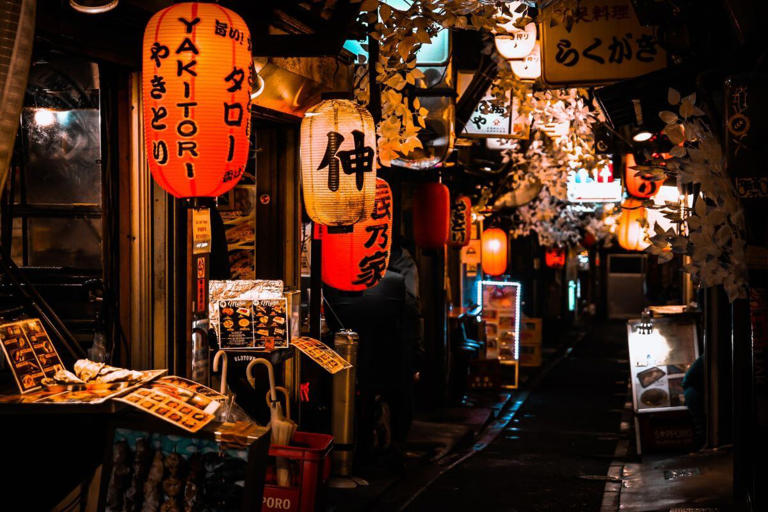
Train strikes in April and May 2024: Full list of dates and lines affected
Overtime bans, an action short of a strike, also mean some services may not be running or may be reduced as drivers refuse to work their rest days.
Thursday 11 April 2024 08:46, UK

Drivers at 16 rail companies have started a fresh wave of strikes, plus overtime bans, causing disruption to the rail network.
Update: All rail strikes have now concluded, and the Tube strikes that were due to take place in May have been called off.
The strikes are part of a long-running dispute over pay and will take place across April and May.
Tube strikes planned for April and May have been called off.
In an "entirely separate dispute", ASLEF members will also strike and refuse to do overtime at LNER on specific dates in April "because of the company's failure to adhere to the agreed bargaining machinery", the union said.
LNER's alleged failure to adhere to bargaining machinery refers to it using managers to drive trains on strike days.
People are advised to check before they travel.
Here's what's happening when:
Rail strike dates
Friday 5 April
Strikes will affect Avanti West Coast, East Midlands Railway, West Midlands Trains, and CrossCountry.
Saturday 6 April
Strikes will affect Chiltern, GWR, LNER, Northern, and TransPennine Trains.
Monday 8 April
Strikes will affect Greater Anglia, c2c, GTR Great Northern Thameslink, Southeastern, Southern/Gatwick Express, South Western Railway main line and depot drivers, and SWR Island Line.
Overtime ban dates
Thursday 4 April
Tuesday 9 April
People are advised to check before they travel, as some areas may have no service.
LNER action dates
Members will strike on Saturday 20 April and refuse to work non-contractual overtime from Friday 19 to Sunday 21 April .
Why are the strikes happening?
ASLEF says the LNER strikes are because of "the company's persistent failure to comply with existing agreements".
Nigel Roebuck, an ASLEF organiser in the northeast, said the operator had been trying to get "every driver manager and driver instructor to work on strike days".
A spokesperson said: "LNER has used managers - paid £500 a shift - to drive trains on strike days and, after the expiry of the last non-contractual overtime agreement, on most days of the week now.
"There is no agreement in place for management to drive services on mainline infrastructure.
"It results in branch line services - such as Lincoln, Skipton, and Harrogate - being cancelled because of a lack of route knowledge and means virtually no driver training is being done."

Keep up with all the latest news from the UK and around the world by following Sky News
Mick Whelan, ASLEF general secretary, said of the rail strikes : "Last month, when we announced renewed mandates for industrial action, because under the Tories' draconian anti-union laws we have to ballot our members every six months, we called on the train companies, and the government, to come to the table for meaningful talks to negotiate a new pay deal for train drivers who have not had an increase in salary since 2019.
"Our members voted overwhelmingly - yet again - for strike action."
Be the first to get Breaking News
Install the Sky News app for free

A Rail Delivery Group spokesperson said: "Nobody wins when industrial action impacts people's lives and livelihoods, and we will work hard to minimise any disruption to our passengers.
"We want to resolve this dispute, but the ASLEF leadership need to recognise that hard-pressed taxpayers are continuing to contribute an extra £54m a week just to keep services running post-COVID.
"We continue to seek an agreement with the ASLEF leadership and remain open to talks to find a solution to this dispute."
When the strikes on the London Underground were announced, Finn Brennan, ASLEF's full-time organiser on the network, said in a statement: "ASLEF Tube train drivers will strike in April and May in a long-running dispute over London Underground's failure to give assurances that changes to our members' terms and conditions will not be imposed without agreement and that all existing agreements will be honoured.
"Despite a previous commitment to withdraw plans for massive changes to drivers' working conditions, London Underground management has established a full-time team of managers preparing to impose their plans.
Sadiq Khan said they had been called off after "talking and engaging with transport staff and trade unions rather than working against them".
Related Topics
- London Underground
- Rail strikes
Watch CBS News
Biden is canceling $7.4 billion in student debt for 277,000 borrowers. Here's who is eligible.
By Aimee Picchi
Edited By Alain Sherter
April 12, 2024 / 8:28 AM EDT / CBS News
The Biden administration on Friday said it's canceling $7.4 billion in student debt for 277,000 borrowers, with the recipients scheduled to receive emails today to alert them to their loan discharges.
The latest effort extends the debt relief provider under President Joe Biden after the Supreme Court last year blocked his administration's plan for broad-based student loan forgiveness. With the latest batch of loan cancellations, the White House said it has forgiven about $153 billion in debt for 4.3 million student borrowers.
Biden, who had made student loan relief a major campaign pledge, is tackling an issue that affects about 43 million Americans with a combined $1.7 trillion in student debt. It's a burden that some borrowers and their advocates say has harmed their ability to save for a home or achieve financial milestones, an issue that was echoed by Education Secretary Miguel Cardona in a conference call with reporters.
"I talked to a teacher in New York this week who took out a loan for $30,000," Cardona said Friday, "and after over a decade of paying and being a teacher the debt was $60,000, and she was saying that the interest was so high that the payments that she was making wasn't even touching her principal."
He added, "We are fixing a broken system. We're relentless and taking steps to transform a broken system into one that works people across the country."
Here's what to know about who is eligible for the latest round of forgiveness.
Who qualifies for the student loan forgiveness?
Three groups of people qualify under the latest round of debt relief, the White House said.
- $3.6 billion for 206,800 borrowers enrolled in the SAVE plan.
About $3.6 billion will be forgiven for nearly 207,000 borrowers enrolled in the Saving on a Valuable Education (SAVE) plan, an income-driven repayment program, or IDR, that the Biden administration created last year.
The White House said borrowers who are getting their debt discharged under SAVE had taken out smaller loans for their college studies. The plan allows people to receive forgiveness after they made at least 10 years of payments if they originally took out $12,000 or less in loans to pay for college; borrowers with larger loans are eligible after 20 or 25 years of repayment, depending on what types of loans they have.
"You sacrifice and you've saved for a decade or more to make your student loan payments, and you originally borrowed $12,000 or less, you're going to see relief," Cardona told reporters. "An overwhelming number of those who qualify for SAVE were eligible for Pell grants and come from low- and middle-income communities."
- $3.5 billion for 65,700 borrowers in income-repayment plans.
These borrowers will receive forgiveness through "administrative adjustments" to repayment plans where loan servicers had made it tougher for some borrowers to qualify for relief.
"These are people who paid for a long time but were being deprived of relief because of administrative and servicing failures," Cardona said. "These people met the contract of their loan" and will receive forgiveness.
- $300 million for 4,600 borrowers through Public Service Loan Forgiveness (PSLF).
The PSLF program is designed to help public servants like teachers and government employees achieve debt forgiveness after 10 years of repayment. It's a program that started in 2007 but had been plagued with complex rules that effectively hampered people from getting their debt discharged, with only 7,000 receiving loan forgiveness prior to the Biden administration.
With the latest round of discharges, the Biden administration has forgiven $62.8 billion in loans for 876,000 borrowers through PSLF.
Are there legal challenges to Biden's debt forgiveness plans?
In two separate lawsuits, Republican attorneys general in 18 states are pushing to have the SAVE plan tossed and to halt any further student debt cancellation. They say the SAVE plan oversteps Biden's authority and makes it harder for states to recruit employees. They also contend the plan undermines a separate cancellation program that encourages careers in public service.
It's unclear what the suits could mean for loans that have already been canceled. A court document filed by Kansas' attorney general says it's "unrealistic to think that any loan forgiveness that occurs during this litigation will ever be clawed back."
—With reporting by the Associated Press.
- Biden Administration
- Student Loan
Aimee Picchi is the associate managing editor for CBS MoneyWatch, where she covers business and personal finance. She previously worked at Bloomberg News and has written for national news outlets including USA Today and Consumer Reports.
More from CBS News
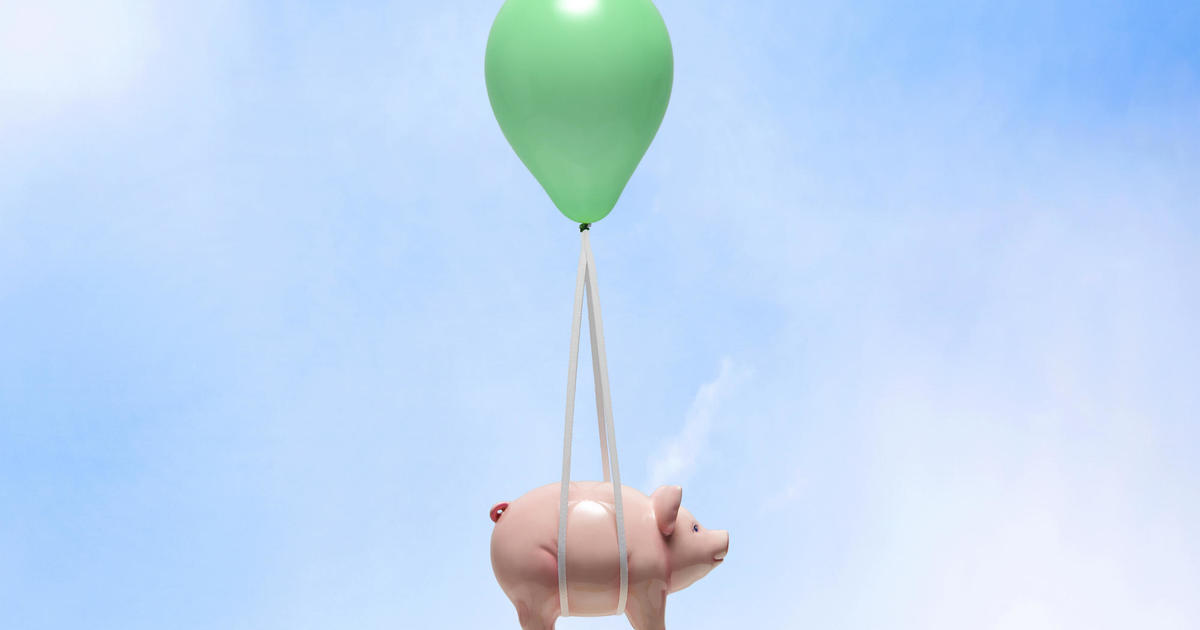
Inflation's rising. Here's how debt relief can help.

Feds rush to open probe of Ford recall prompted by possible engine fires
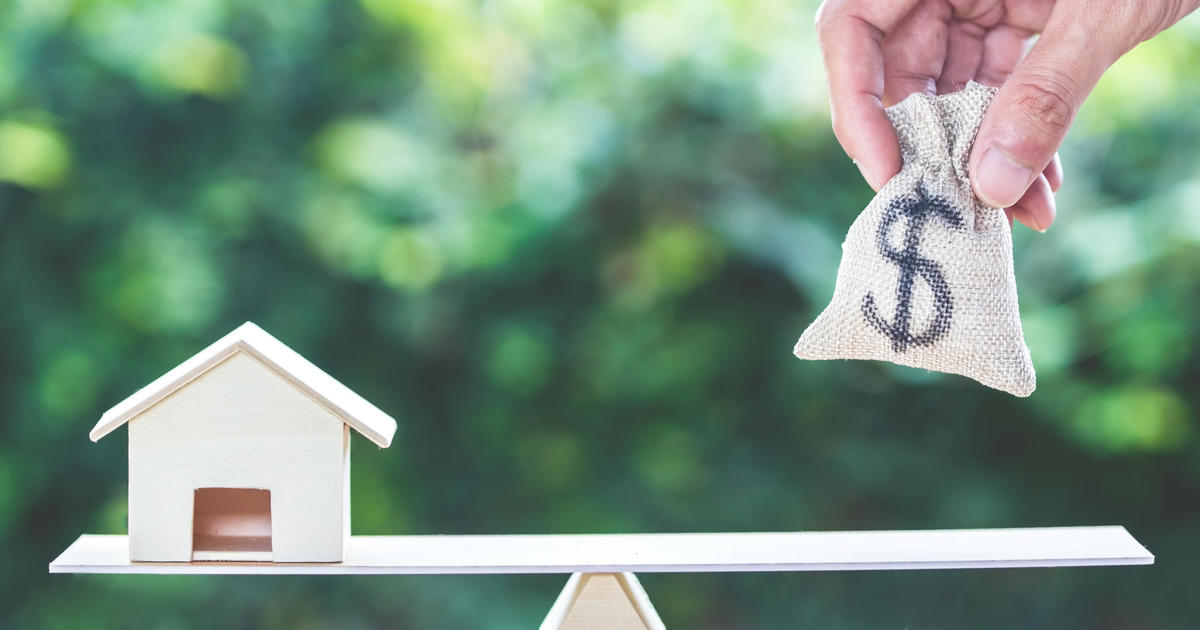
Consolidating debt with home equity: Pros and cons to consider

Why home equity may be the best borrowing option right now
- Skip to main content
- Keyboard shortcuts for audio player

Solar eclipse 2024: Follow the path of totality
Thinking of taking a last-minute drive to see the eclipse here's what to know.

Geoff Brumfiel

RV traffic sits at a standstill along a two-lane road near Madras, Ore., a few days before the 2017 total solar eclipse. Experts say traffic could be heavy, but eclipse watchers shouldn't necessarily be deterred. AFP Contributor/AFP via Getty Images hide caption
RV traffic sits at a standstill along a two-lane road near Madras, Ore., a few days before the 2017 total solar eclipse. Experts say traffic could be heavy, but eclipse watchers shouldn't necessarily be deterred.
NASA says that roughly 31.6 million people live in the path of this year's total solar eclipse, and a little under half of the U.S. population lives within 200 miles driving distance of the path of totality .
That could mean many millions of Americans will hit the road to get a better view on April 8. If you're still pondering whether or not you want to make the journey, here's what to consider.
Have some destinations in mind, and check the weather and cloud cover forecasts in advance
It's a good idea to scout out one or more locations within driving distance, so that you have some flexibility if traffic or weather is threatening your plans, says Jonathan Upchurch, a professor emeritus of civil engineering at Arizona State University who has studied travel around solar eclipses.
There are several interactive tools that show the path of totality, including Eclipse2024.org and the National Solar Observatory . You can use them to figure out what sites might work best for you.
In terms of weather, check not just the weather forecast, but also the cloud cover forecast. Some websites, such as Windy.com will predict cloud cover ahead of time, giving you a sense of whether you'll actually be able to see the eclipse in all its glory.

Everything you need to know about solar eclipse glasses before April 8
During the total solar eclipse in 2017, Upchurch says he chose to go to Idaho "because there were some great chances of having sunny skies, and I had the opportunity to be nimble and relocate if I wanted to."
Before driving into the path of totality, make sure your gas tank is full and that you've got everything you need
During the last total solar eclipse in 2017, it's estimated some 5 million people took to the roads, and those numbers will potentially be much higher this year.
Given all that, Upchurch says it's important to make sure you're taking what you need into the path of totality. You should make sure your car is gassed or charged up, and that you have plenty of snacks and water with you in case you get stranded for a while, especially when trying to leave.

Solar Eclipse 2024: Totality stretches from Texas to Maine
Simple tips to safely photograph the eclipse with your cellphone.
Also don't forget to bring eclipse glasses, which must be worn anytime you're looking at the sun, except for the few minutes when it is completely blocked by the moon.
Some state emergency planners also recommend bringing a paper map or road atlas in case cellular networks become overloaded with visitors seeking directions from their phones.

Don't forget your eclipse glasses everyone! Erika Goldring/FilmMagic hide caption
Don't forget your eclipse glasses everyone!
Arrive early and stay late
Once you figure out where you're going to watch the eclipse, and you've got your supplies, try to get there early. Although traffic is likely to be heavier than normal on the morning of eclipse day, it still should be possible to reach many destinations without too much hassle, says Upchurch.
"Leaving is definitely going to be more of a problem," he says. As the eclipse concludes, people will take to the roads all at once to try and get home as fast as they can. In 2017, that led to traffic jams that lasted many hours in some areas. If possible, Upchurch says, people should stay put for a while to try and avoid the worst of the post-eclipse rush, which in 2017 stretched even into the following day in some parts of the country.

Here's what time the eclipse will be visible in your region
And one more thing: If you do find yourself on the move near the time of the eclipse, state officials stress that you should not simply pull over to the side of the road or highway you're driving on. It's important to be parked legally and safely at the moment of totality.
If you're already in the path of totality: Relax and enjoy!
Several major metropolitan areas including Dallas, Indianapolis, Cleveland and Buffalo are already inside the path of totality, so there's no need to seek a better view, Upchurch says. You'll probably have the most fun simply staying where you are.

Shots - Health News
Watching a solar eclipse without the right filters can cause eye damage. here's why.
If you're on the edge of the path of totality, however, you might consider making a short trip to get closer to the center of the eclipse's path.
"If you're within about 40 miles of the center line, you'll have two-and-a-half minutes or more" of complete totality, Upchurch says. It's up to you to decide whether it's worth making the trip to a more central location.
Despite studying the potential hassles of traveling extensively, Upchurch says he's still looking forward to seeing the 2024 eclipse, which he plans to watch from Texas.
"Totality is absolutely spectacular," he says. "If you have a chance to witness it, I would do it."
- 2024 solar eclipse
- eclipse 2024
- 2024 eclipse
- Traffic patterns
- total eclipse
We've detected unusual activity from your computer network
To continue, please click the box below to let us know you're not a robot.
Why did this happen?
Please make sure your browser supports JavaScript and cookies and that you are not blocking them from loading. For more information you can review our Terms of Service and Cookie Policy .
For inquiries related to this message please contact our support team and provide the reference ID below.

IMAGES
VIDEO
COMMENTS
Embark on an unforgettable 7-day Tokyo itinerary as you uncover the dazzling gems of Japan's iconic capital city. Having extensively explored Tokyo for months, I've crafted the ultimate Tokyo itinerary to help you tailor your journey to perfection.Tokyo, a city that tops many travellers' must-visit lists, offers a stunning blend of rich history, vibrant culture, and mouthwatering cuisine.
Day 2: Meiji Shrine, Harajuku and Shibuya. Day 3: Tokyo Disneyland. Day 4: Ueno, Ameya Yokocho, Asakusa, and Tokyo Skytree. Day 5: Take a Day Trip to Mt Fuji from Tokyo. Day 6: DisneySea. Day 7: Tokyo Metropolitan Government Building and Odaiba. Tokyo Itinerary 7 Days Map. The Most Efficient Way to Travel Around Tokyo.
Day 1: Odaiba and Shinjuku. A man made island in Tokyo Bay, Odaiba is a shopping and entertainment mecca which is best known for its incredible Digital Art Museum, TeamLab borderless. Shinjuku is Tokyo's hub for eating, drinking, entertainment and shopping and is home to towering skyscrapers and neon lights.
Quick Overview: Itinerary for Tokyo 7 Days. Tokyo is a sprawling metropolis that covers over 2,000 square kilometres. This itinerary has been designed to cover specific sections of the city and groups attractions on each day to reduce travel time and backtracking. Here's a summary breakdown of this Tokyo Itinerary: Day 1: Harajuku and Shibuya
Getting around Tokyo. 7 days in Tokyo itinerary - Day 1. Day 2 of your 7-day Tokyo itinerary. Tokyo 7 days itinerary - Day 3. 7 days itinerary for Tokyo - Day 4. Day 5 - What to do in Tokyo in a week. One week in Japan - Day 6 in Tokyo. Day 7 in Tokyo - The final day of a week's itinerary. Other activities you can try while in Tokyo.
Visiting the Imperial Palace with this 7 days in Japan itinerary. The second day of 7 in Tokyo begins at the Imperial Palace - a short 10-minute walk from Tokyo Station. Covering 3.3 square kilometers (1.3 sq miles), the Imperial Palace of Tokyo is full of history and cultural significance just waiting to be discovered.
Tokyo Travel Tips. Tokyo is full of interesting and unique ways to learn about Japan and its culture, as well as fun experiences to have regardless of your interests. Tokyo itineraries. For more details about some of these locations as well as some further suggestions, see our Tokyo itinerary posts: 4 days in Tokyo; 5 days in Tokyo; 7 days in Tokyo
Day 3: Asakusa, Akihabara and Skytree. Day 4: Central Tokyo, Imperial Palace and Ueno. Day 5: Tokyo Disneyland. Day 6: Day Trip to Mount Fuji. Day 7: Odaiba, TeamLab Planets, Tokyo Tower & Tsukiji Fish Market. More Things to Add to Your 7 Day Tokyo Itinerary. Cultural Experiences.
That said, it's time to explore our recommended 7-day Tokyo itinerary through the list below. Trust us, you'll have the best time of your life! Day 1: Explore Shinjuku. Day 2: Visit Meiji Shrine, Harajuku & Shibuya. Day 3: A Magical Day Out in Tokyo Disneyland. Day 4: Visit Ueno, Ameya Yokocho, Asakusa, and Tokyo Skytree.
Day. Itinerary. 1. Arrival in Tokyo, explore the local area, enjoy the nightlife. 2. Visit Tokyo Metropolitan Government Building and Shibuya neighborhood, enjoy evening entertainment in Roppongi. 3. Explore Kamakura and Enoshima Island. 4.
7 perfect days in Tokyo. Tokyo conjures up so many contrasting images: the spiritual alongside the quirky, the quiet of the temples and the chaos of the subway, the neon and the nature. With 23 municipalities and another 39 smaller towns within its borders—plus flowing rivers, expansive parks, and the highest number of Michelin-starred ...
Shibuya. Day 6 - Day trip to Hakone. Day 7 - Day trip to see the Snow Monkeys. Day 7 Alternative - Studio Ghibli Museum. The best time to visit Tokyo. Share this post: The first thing you need to understand about Tokyo is that there is not one clearly marked city centre.
Find more information about affiliate links on our policy page. Jump To: Before You Go. Tokyo 7 Day Itinerary. Day 1 - Harajuku and Ikebukuro. Day 2 - Shinjuku. Day 3 - Shibuya. Day 4 - Chuo and Asakusa. Day 5 - Bunkyo.
A 7-day Tokyo itinerary at a glance. Day 1 - Arrival and visiting a local shrine or temple. Day 2 - Get your game on at Akihabara. Day 3 - Visit Senso-ji, the oldest temple in Tokyo. Day 4 - Visit the modern neighbourhood of Shibuya. Day 5 - Relax at Tokyo's Rikugien Gardens.
Work with meContact me. The only 7-day Tokyo itinerary you need! The Japanese capital is one of the world's biggest and busiest cities in the world. The city perfectly blends history with modernism. From grand temples, and Zen gardens to the busy Shibuya crossing to futuristic skyscrapers, Tokyo has it all.
Day 7 - Depart from Narita Airport. Depart Japan from Narita Airport. Regular train tickets will be considerably cheaper than a Japan Rail Pass for this itinerary. Below are some sample budgets for the itinerary, excluding airfare. Find out more about the sample budgets and about the current yen exchange rates.
Tokyo Itinerary 7 Days This Tokyo itinerary should be perfect for travelers who will be in Tokyo for 7 days. For 3 days, 4 days, 5 days or 6 days trip, just cherry-pick on what you want to do from this 7 day Tokyo itinerary. I was fortunate enough to visit Tokyo 5 times on 5 separate trips, during spring, early summer and autumn. Each season is beautiful but my favorite is spring time. I was ...
1) Transportation doesn't have to be expensive. There are two airports in Tokyo, Narita and Haneda. Both are far from the city center where many visitors stay. Taxis are incredibly expensive. For the same travel time but half the price, purchase a ticket after you land for the Limousine bus.
Tokyo itinerary for first timers, travel guide and blog, shopping itinerary for Tokyo and unusual things to see and do for regulars. ... a organised 11 day tour in late March 2018 of Japan which uses Shinkansen (Bullet Trains) and buses. The tour starts in Tokyo (only 1 day) and finishes in Osaka, and we'd like to return to Tokyo to see more ...
Giant Torri gate at Hakone shinto shrine | tokyo travel itinerary 7 days Dinner in Ginza | tokyo travel itinerary 7 days. At the end of the day, we took the bullet train back to Tokyo and stopped at Ginza station for dinner there. Ginza is Tokyo's most upscale neighborhood with high-rise buildings, luxury department stores, and lots of ...
Itinerary ideas for 7-day Tokyo trip. To make your trip a great one, you would need a great itinerary as well. If you are looking for 7-day Tokyo itinerary, you can check this Tokyo 3-day itinerary for first-timers and follow this for the first 3 days. For the next 4 days, you can freely stroll around Tokyo to possibly discover lesser-known ...
Join us on a journey to explore the vibrant city of Tokyo in 2023! In this travel vlog, we'll show you everything you need to know about Japan hotels, Japane...
OVERVIEW - 7 DAY JAPAN ITINERARY. To get the most out of your 1 week in Japan, here is an overview of my recommended route to take: Day 1: Tokyo to Kyoto. Day 2: Kyoto. Day 3: Kyoto to Nara. Day 4: Kyoto to Osaka. Day 5: Osaka. Day 6: Osaka to Hiroshima. Day 7: Hiroshima to Fuji to Tokyo.
Day 4 of this 5 day Tokyo travel itinerary promises a fantastic blend of nature, culture, and immersive experiences. Morning. Kickstart your day with a walk through Ueno Park in the heart of the city.
A spokesperson said: "LNER has used managers - paid £500 a shift - to drive trains on strike days and, after the expiry of the last non-contractual overtime agreement, on most days of the week now.
The Biden administration on Friday said it's canceling $7.4 billion in student debt for 277,000 borrowers, with the recipients scheduled to receive emails today to alert them to their loan discharges.
Try Premium free for 7 days. Learn More. Advertisement. Watch Fireball Streak Across New Jersey Sky. April 11, 2024. ... Travel. Now Playing. Fireball Blazes Across East Coast Skies 00:30.
Israel-Hamas War Day 189 | A Number of Countries Warn Citizens Against Travel to Israel Amid Regional Tensions. Apr 12, 2024 Updated: 05:17 p.m. IST. Share in Twitter. ... WSJ: Israel preparing for direct Iranian attack in next 48 hours Multiple countries issue travel warnings for Israel over escalation fears Spain PM: 'Clear signs' Europe ...
NASA says that roughly 31.6 million people live in the path of this year's total solar eclipse, and a little under half of the U.S. population lives within 200 miles driving distance of the path ...
Cape Town, South Africa's tourism hub, and the surrounding Western Cape province have been battered by torrential rains, howling winds and bush fires that caused extensive damage to buildings ...